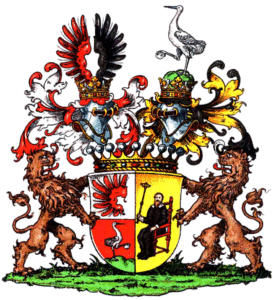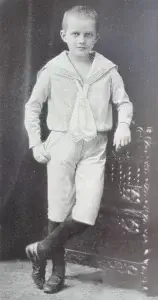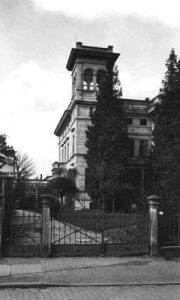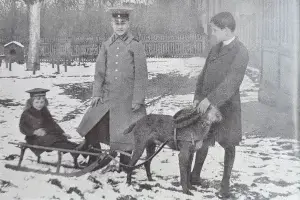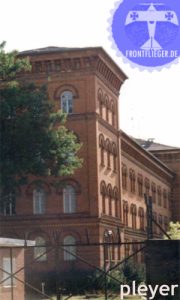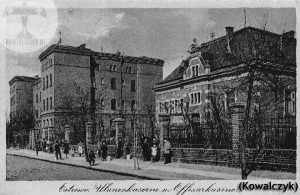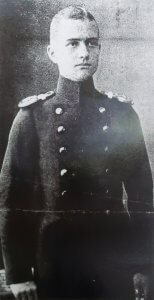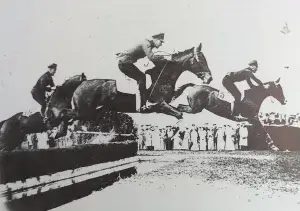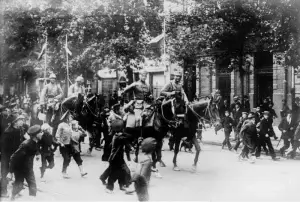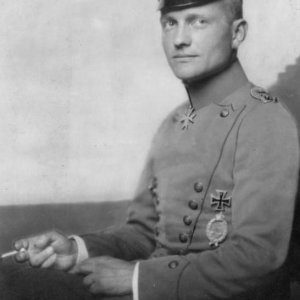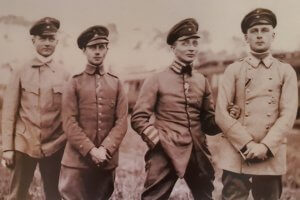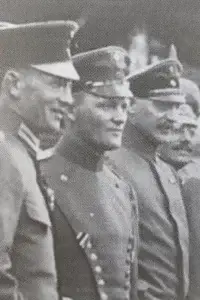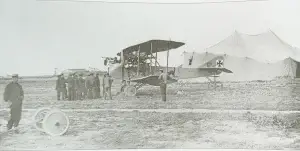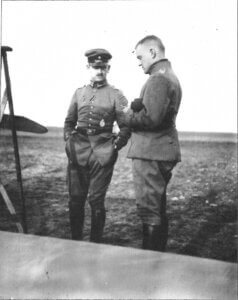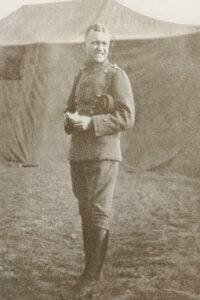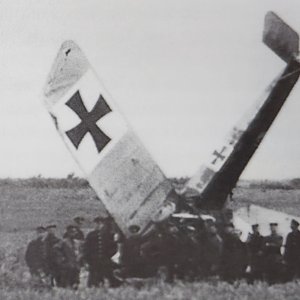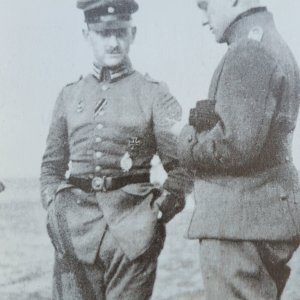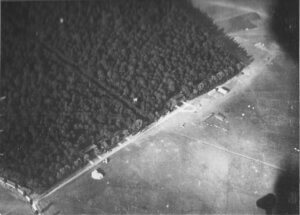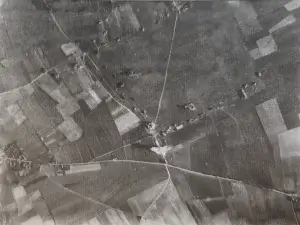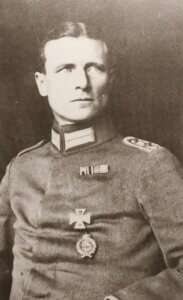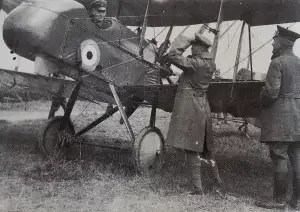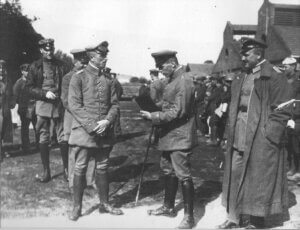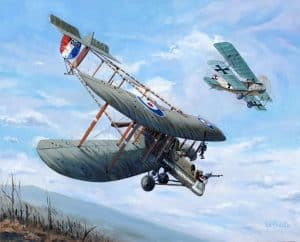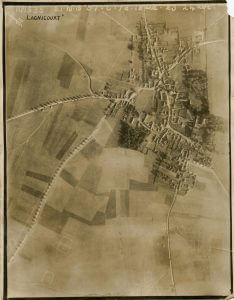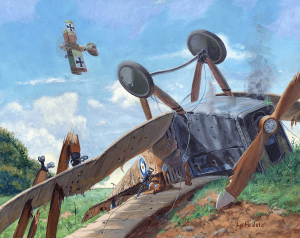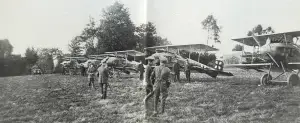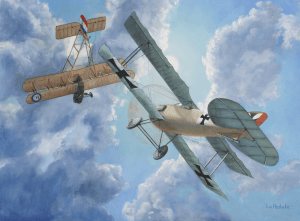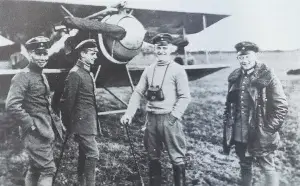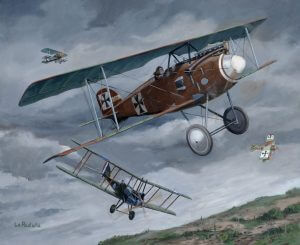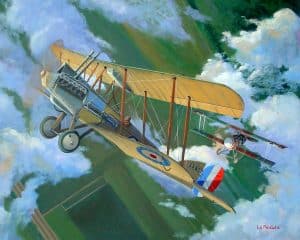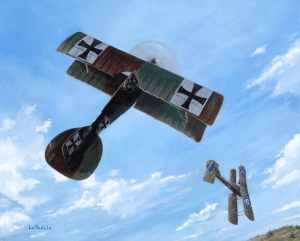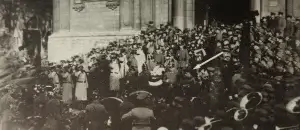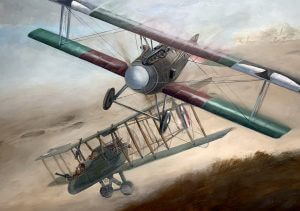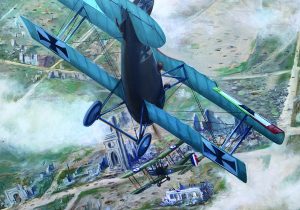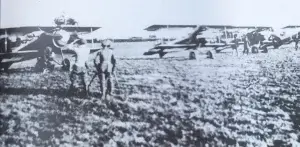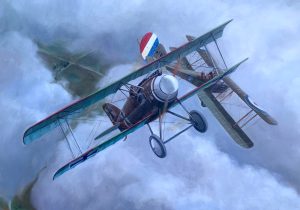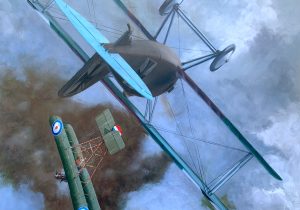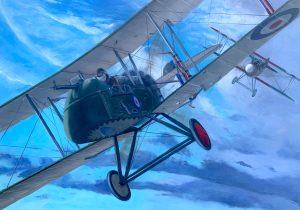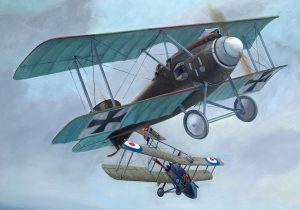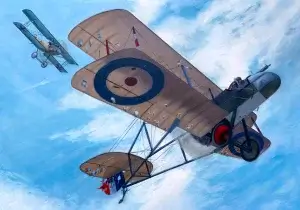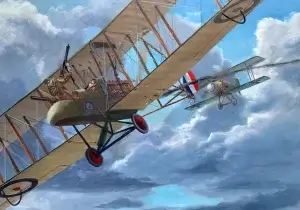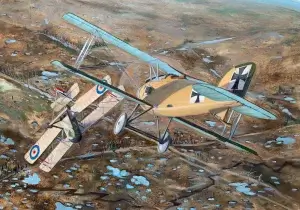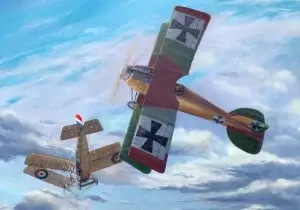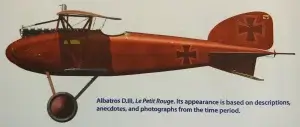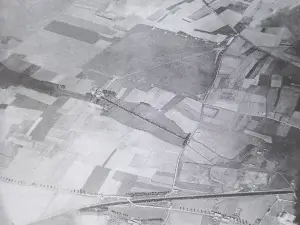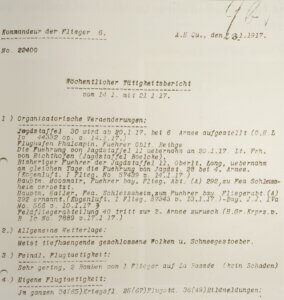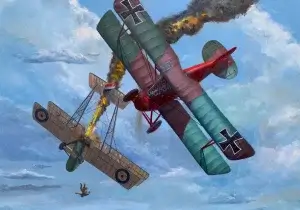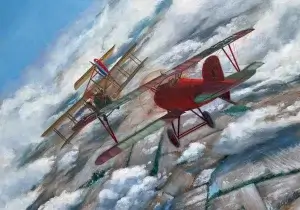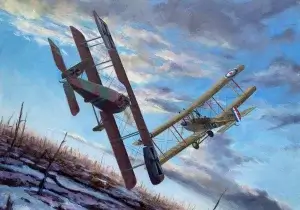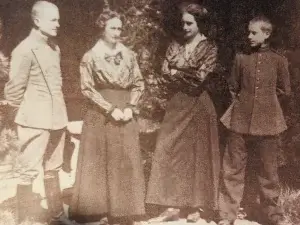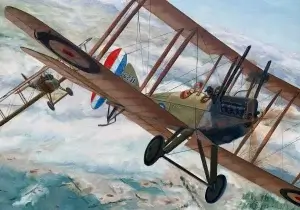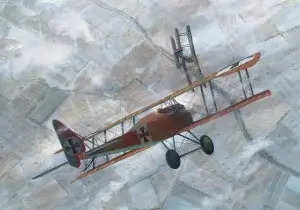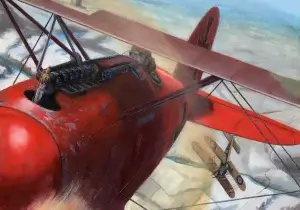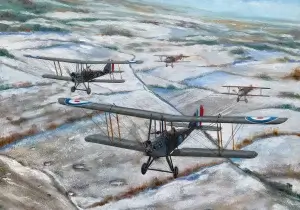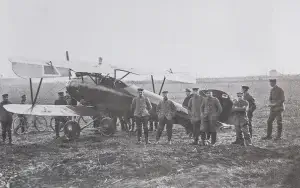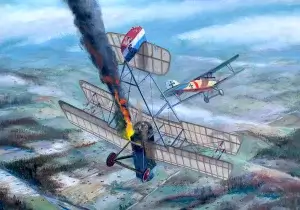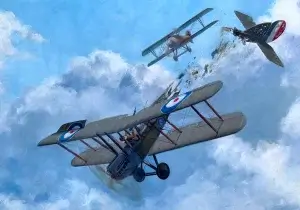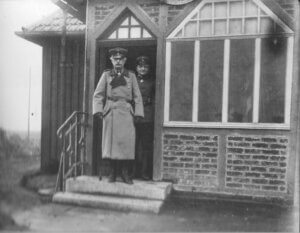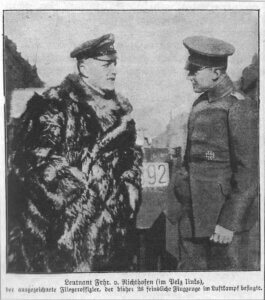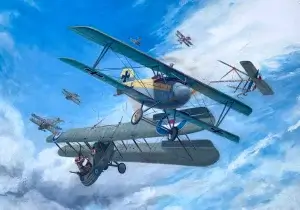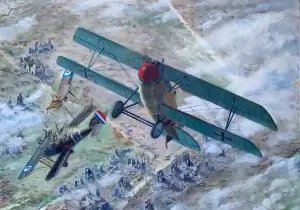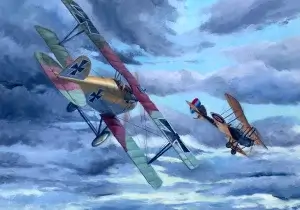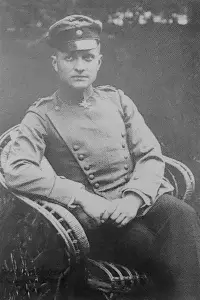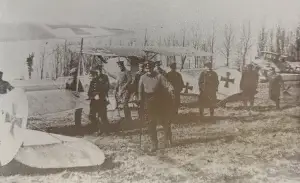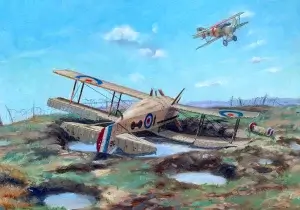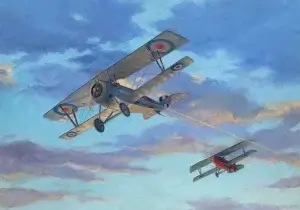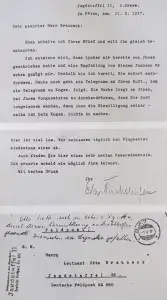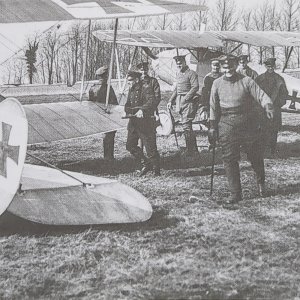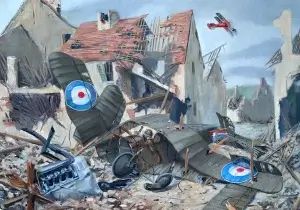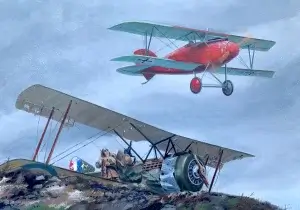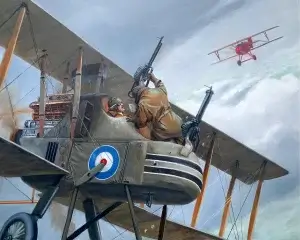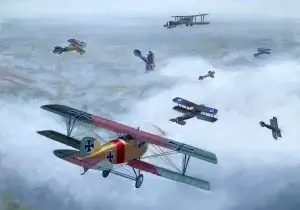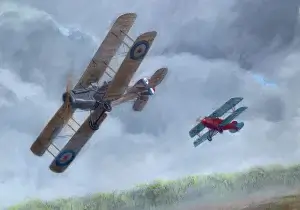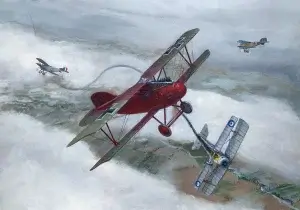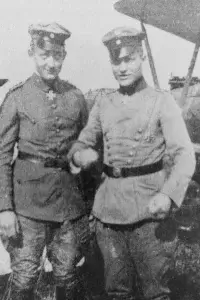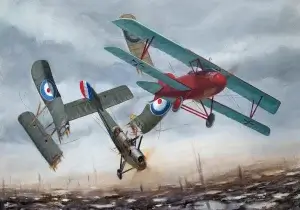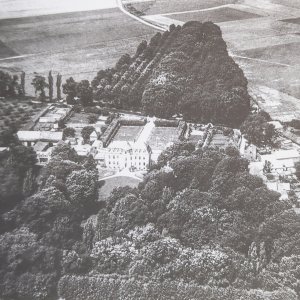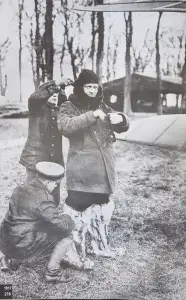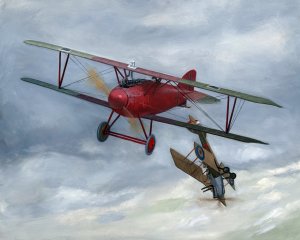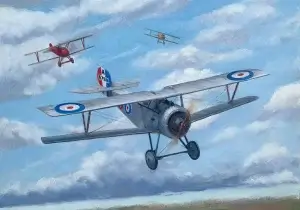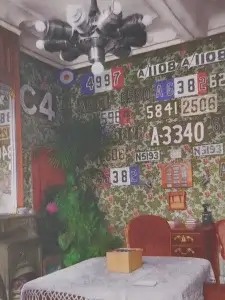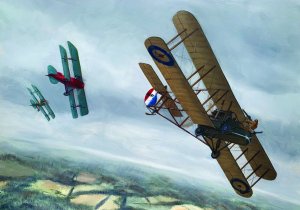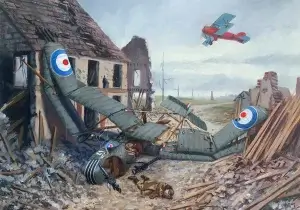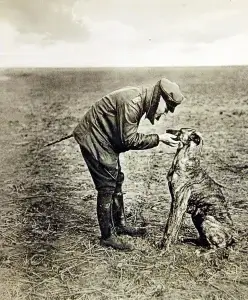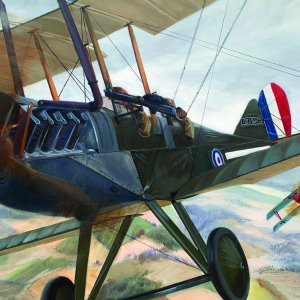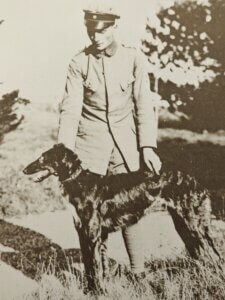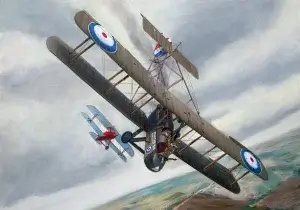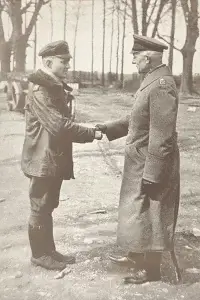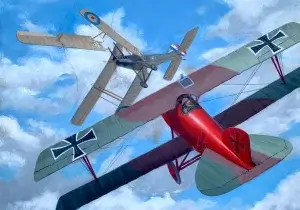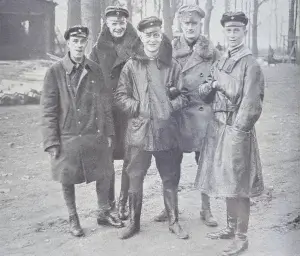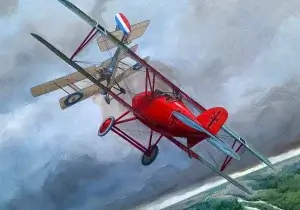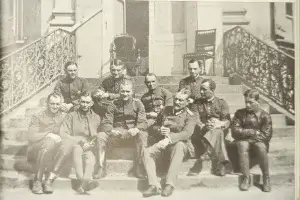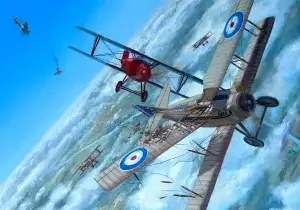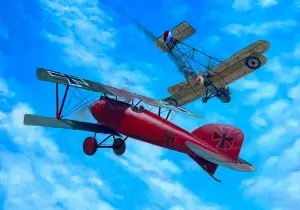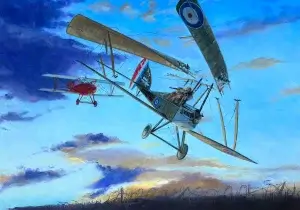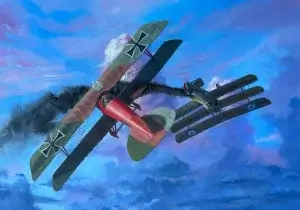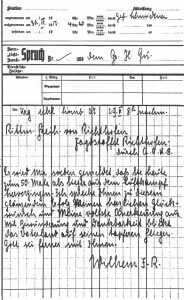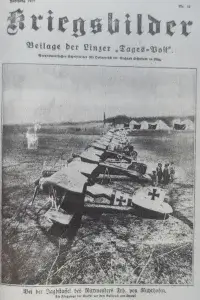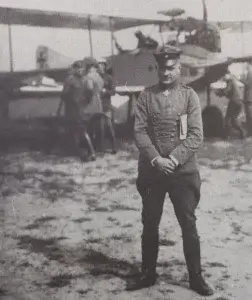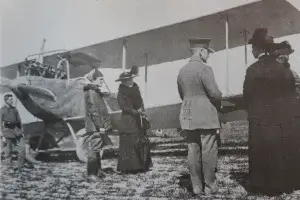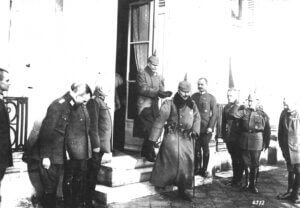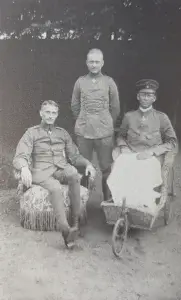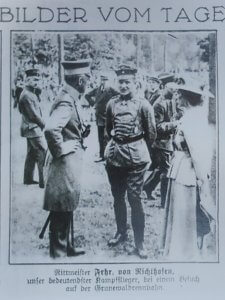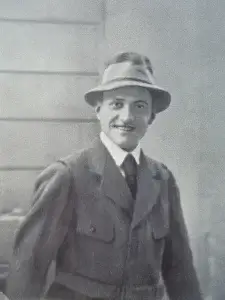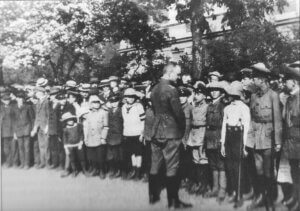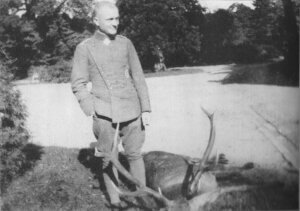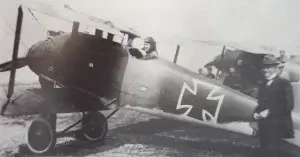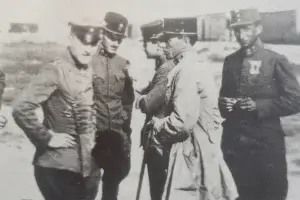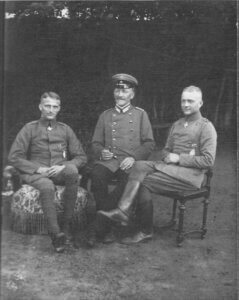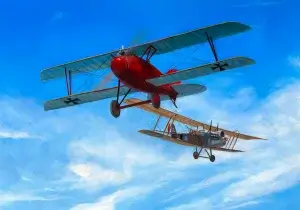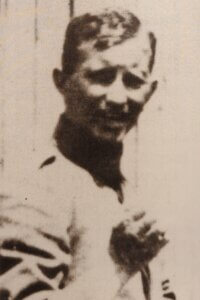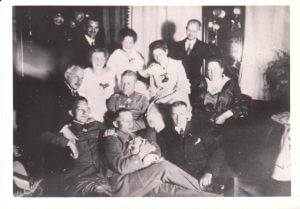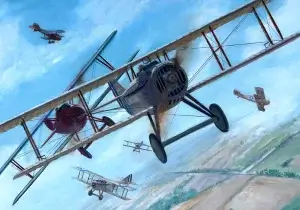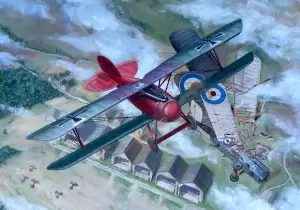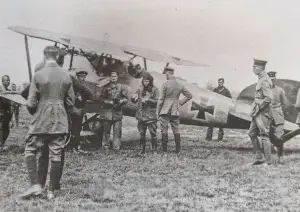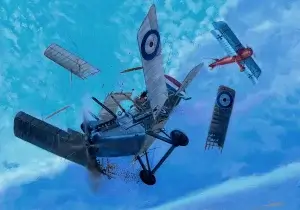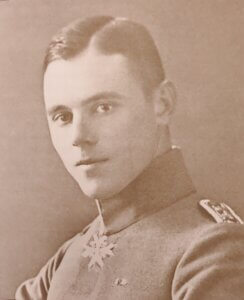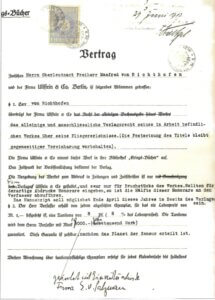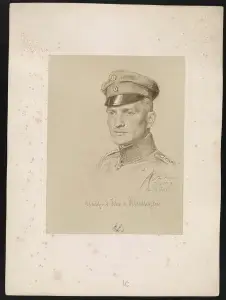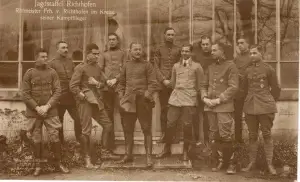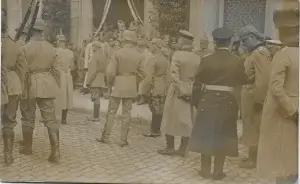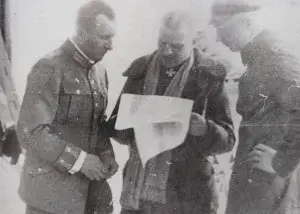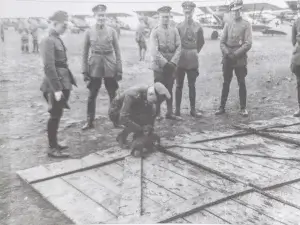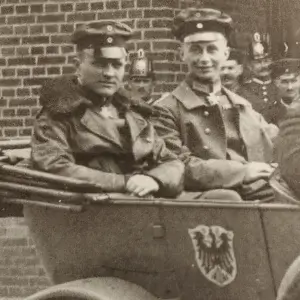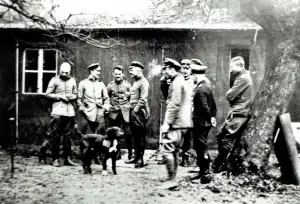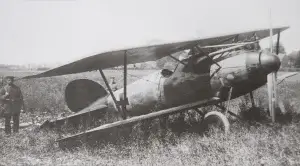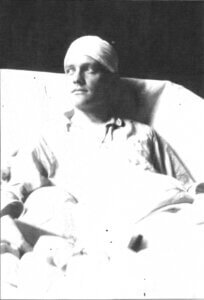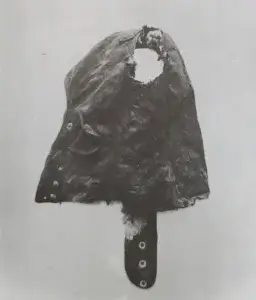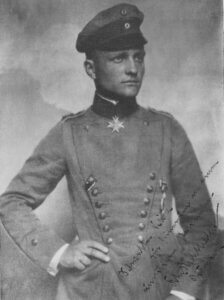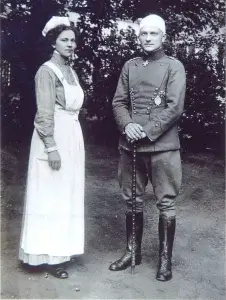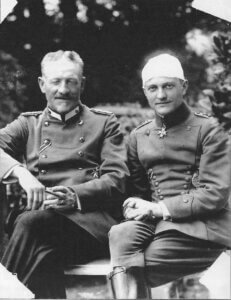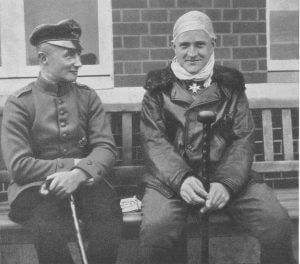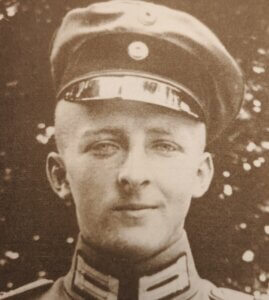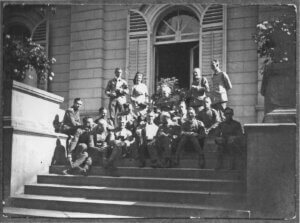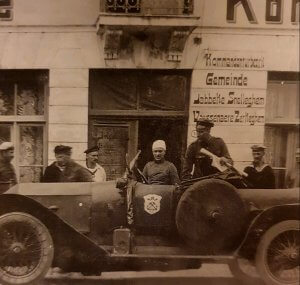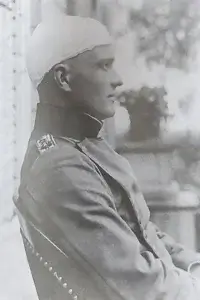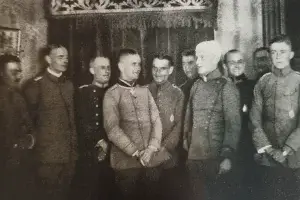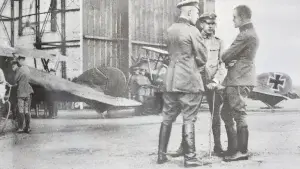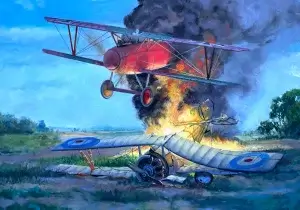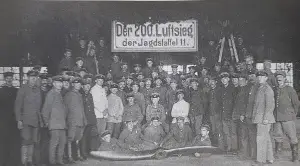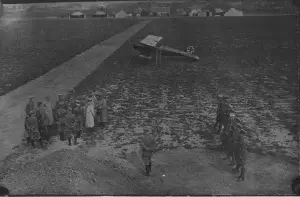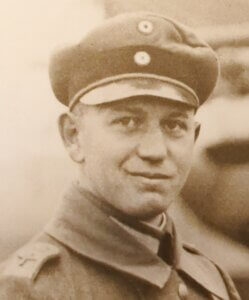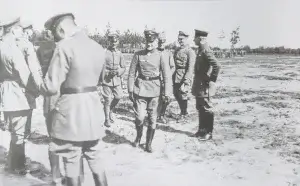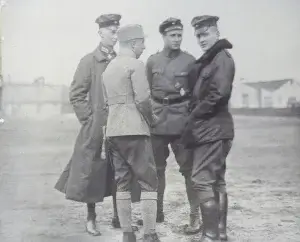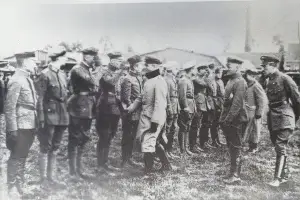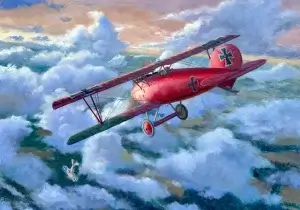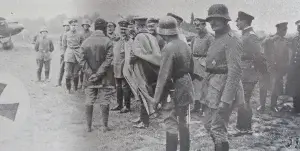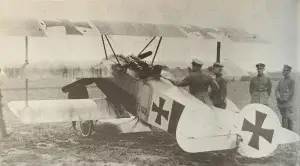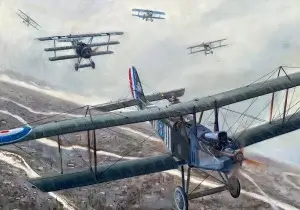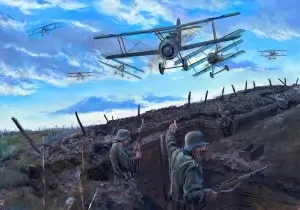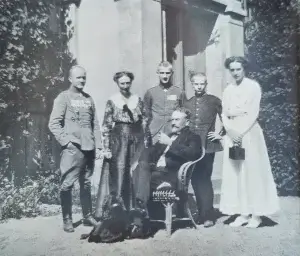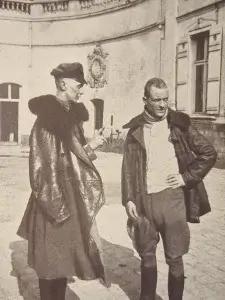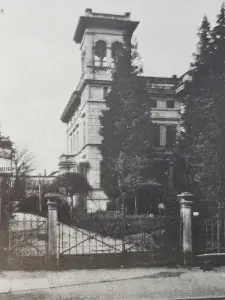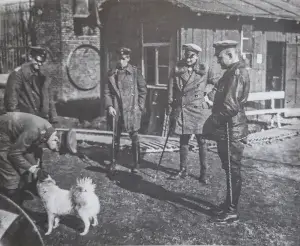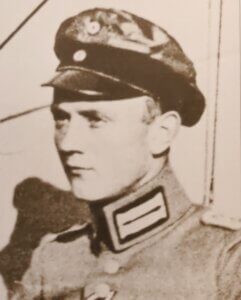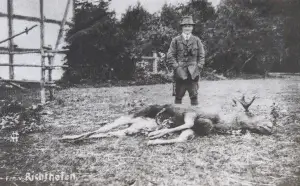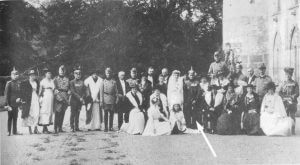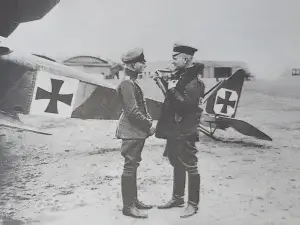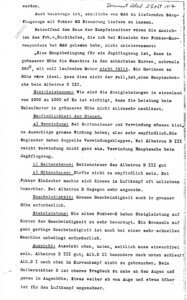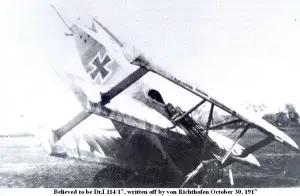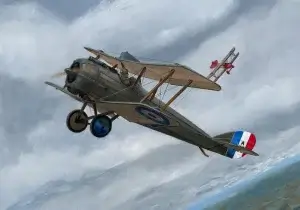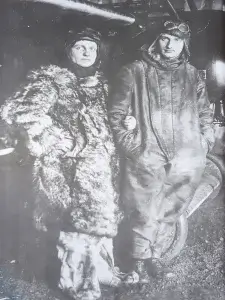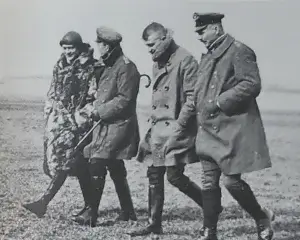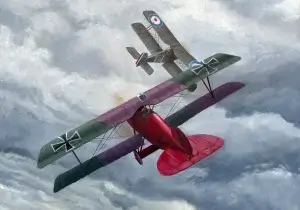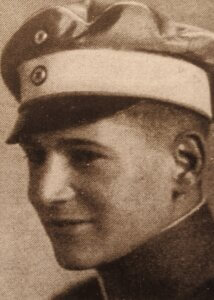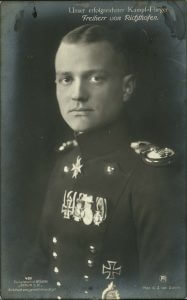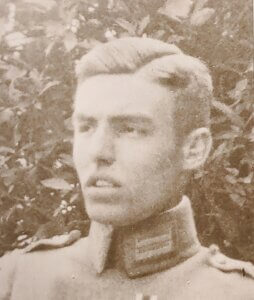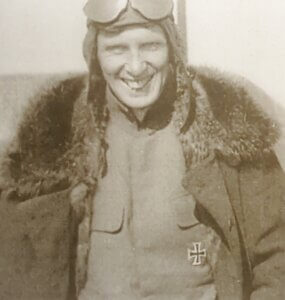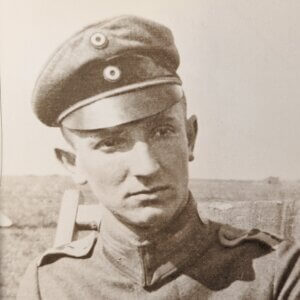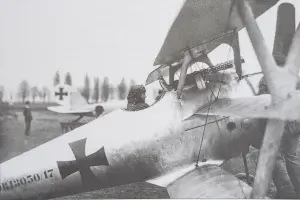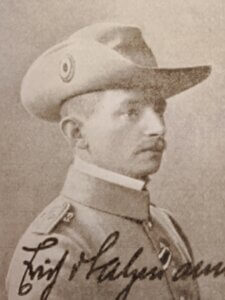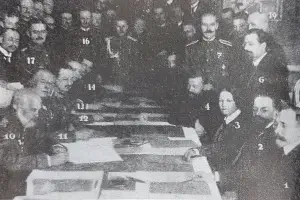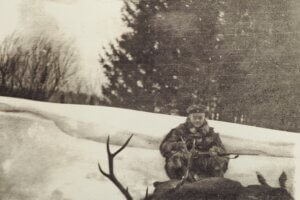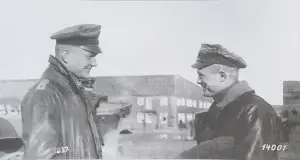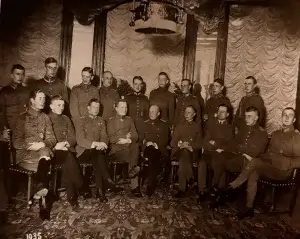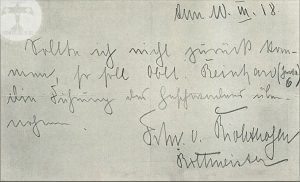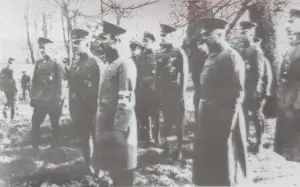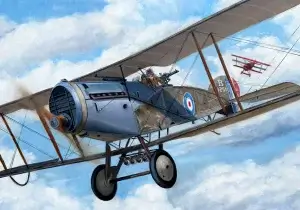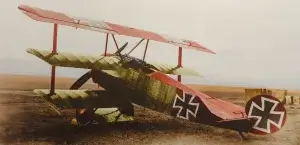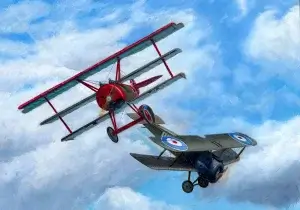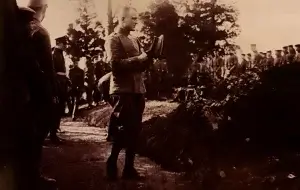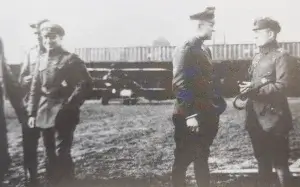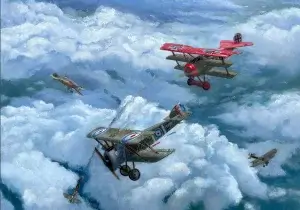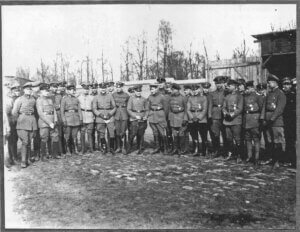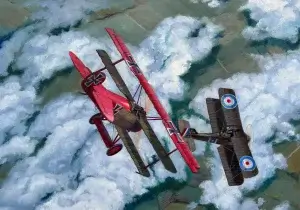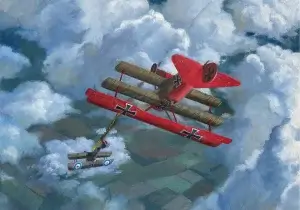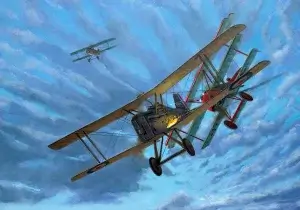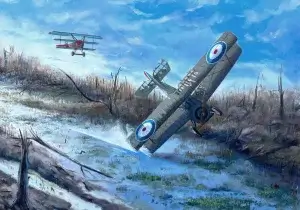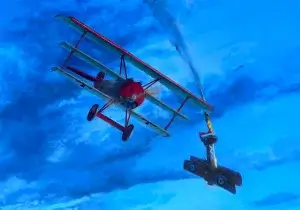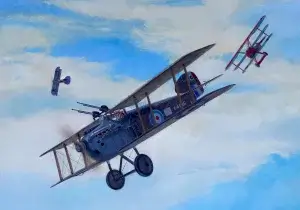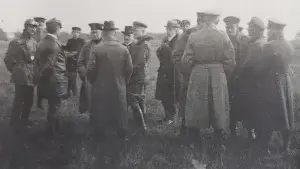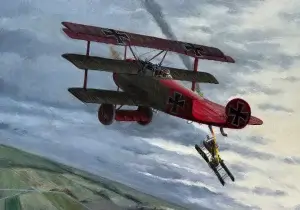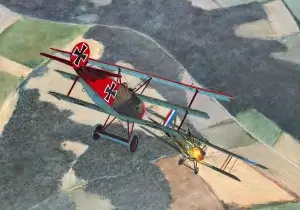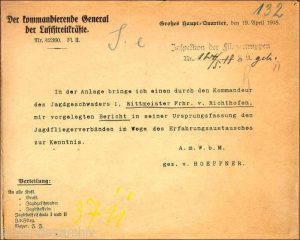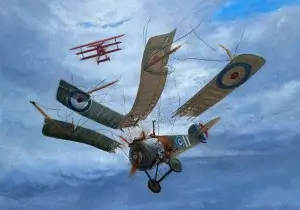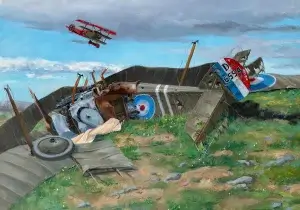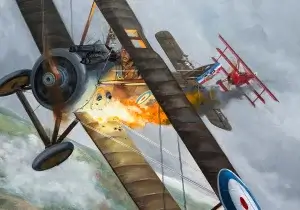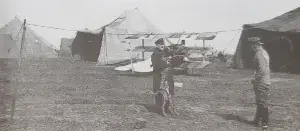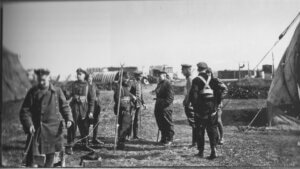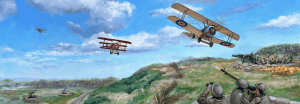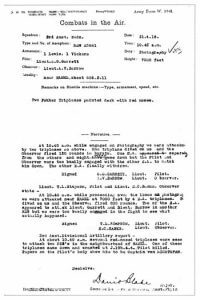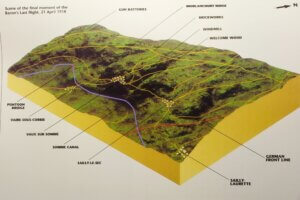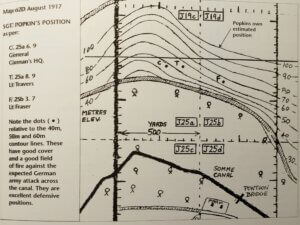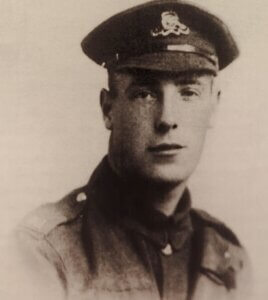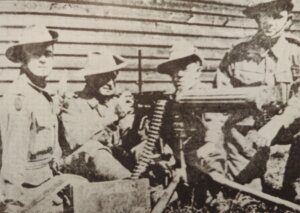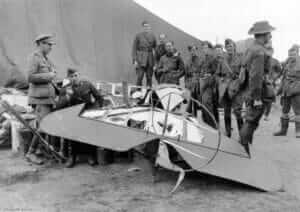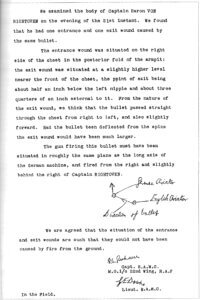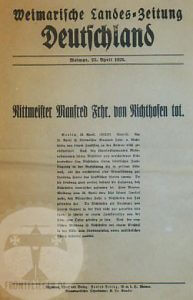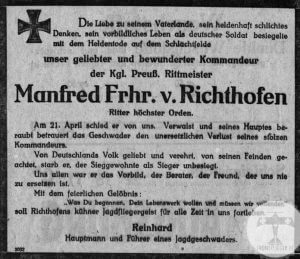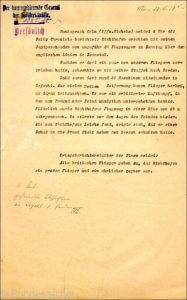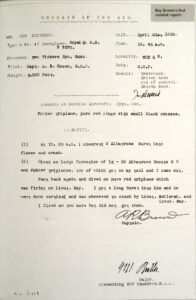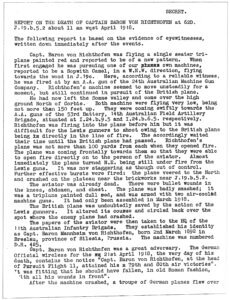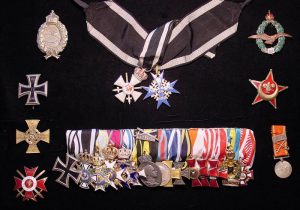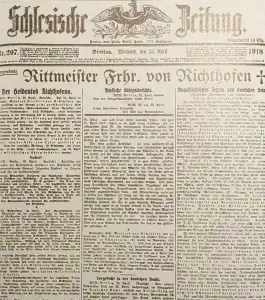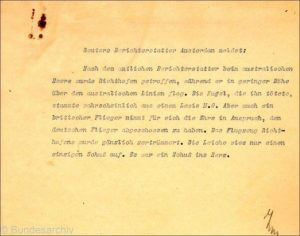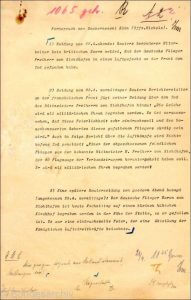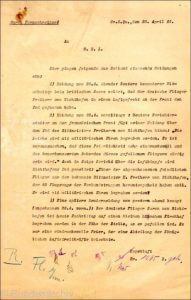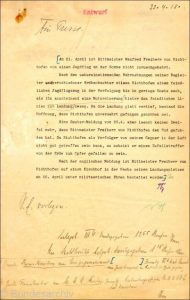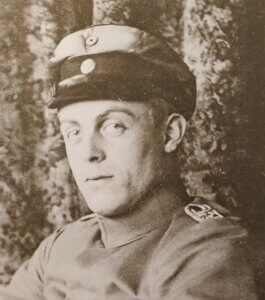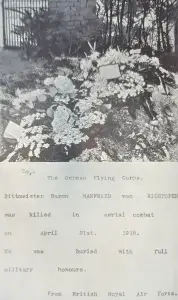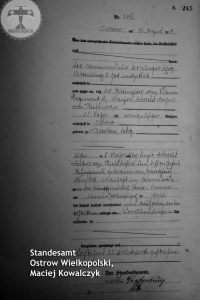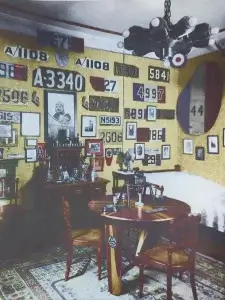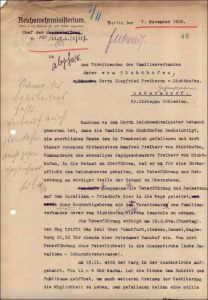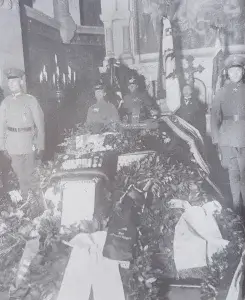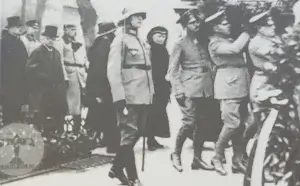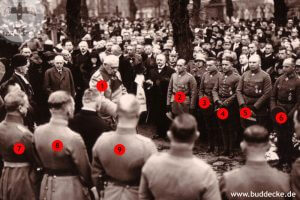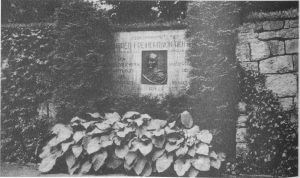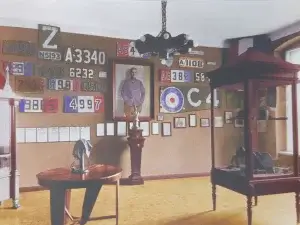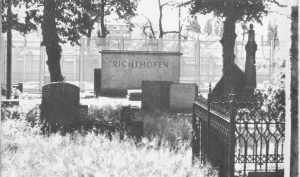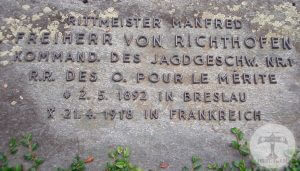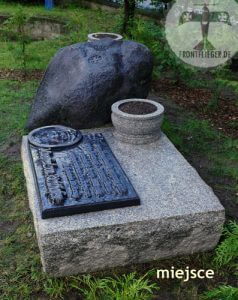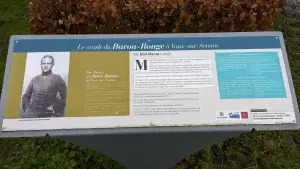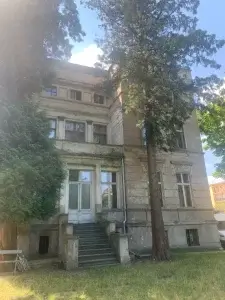MvR born

Der rote Kampfflieger von Rittmeister Manfred Freiherrn von Richthofen, 1917, 351.000 - 400.000, Verlag Ullstein & Co, Berlin-Wien p. 10
‘Now about my youth. The old man was in Breslau with the Leibkürasseren 1 when I was born on 2 May 1892. We lived in Kleinburg.’
Manfred von Richthofen, two years old

Die Erinnerungen der Mutter des roten Kampffliegers Kunigunde Freifrau von Richthofen. Im Verlag Ullstein - Berlin, 1937. p. 8
“This picture shows Manfred von Richthofen as a child, about two or three years old.”
Manfred von Richthofen is seven years old

Die Erinnerungen der Mutter des roten Kampffliegers Kunigunde Freifrau von Richthofen. Im Verlag Ullstein - Berlin, 1937. p. 8
“This picture shows Manfred von Richthofen as a child, around the age of seven. He is wearing a sailor suit, which was very fashionable at the time.”
MvR eight years old

Der rote Kampfflieger von Rittmeister Manfred Freiherrn von Richthofen, 1933, Eingeleitet und ergänzt von Bolko Freiherr von Richthofen, mit einem Vorwort von Generalfeldmarschall Hermann Göring, Verlag Ullstein & Co, Berlin p.
“When he was eight years old, he climbed the largest apple trees on the estate, which hardly anyone else could reach. But then he didn’t let himself down from the trunk, but from the outside on the branches, grasping them with the greatest dexterity. My parents often watched him do this, but never had the feeling that anything could happen to him, so sure were all his movements. My mother was never at all anxious with us boys. She was of the opinion that children could only be really skilful and able to cope with all dangers if they were given every conceivable physical freedom of movement. Only then would they be able to judge as accurately as possible what they could trust themselves to do. Of course, this has not always been without incident, but nothing more serious has ever happened.”
I did that myself

Der rote Kampfflieger von Rittmeister Manfred Freiherrn von Richthofen, 1933, Eingeleitet und ergänzt von Bolko Freiherr von Richthofen, mit einem Vorwort von Generalfeldmarschall Hermann Göring, Verlag Ullstein & Co, Berlin p.
“Because from the earliest days of his youth, Manfred had already shown samples of unusual energy. As an eight-year-old boy, my parents were expecting him one day from the railway in Wroclaw. He was to return from a long stay in the country with two large suitcases. The boy was sent to the railway station to be picked up and returned alone. Manfred was nowhere to be found. What had happened? There was no telephone back then. The excitement grew. While my parents were still discussing it, the doorbell rang and Manfred was standing safely at the door with both suitcases. ‘You must have taken a taxi?’. ‘No, I didn’t have any money.’ ‘Who carried the suitcases for you?’ ‘I did that myself.’
My parents were speechless and incredulous, because the suitcases were so heavy that Manfred would have had trouble lifting just one. But then they got the answer. ‘I was already able to lift one, I always carried it a bit and looked after the other one in the meantime, then I picked up the second one, and that’s how I gradually got there, unfortunately it took a bit of time.’
And all this with such natural calm and confidence that even then my parents could confidently leave Manfred to look after himself on the whole.”
Mrs. von Richthofen on child development

The Red Knight of Germany, the story of Baron von Richthofen, Floyd Gibbons, 1927, 1959 Bantam Books p. 7
“An easily terrified mother is a great obstacle to the physical development of children,’ Mrs von Richthofen said. ‘When Manfred was a little boy, I believe many of my friends considered me rather a careless mother because I did not forbid the two boys to engage in some of the feats they liked, but I was then, and am still, convinced children can only become agile if they are allowed such freedom as will enable them to judge what they can safely demand of their bodies.”
The family has to sell Schloss Romberg due to financial troubles.
MvR's early years

Der rote Kampfflieger von Rittmeister Manfred Freiherrn von Richthofen, 1917, 351.000 - 400.000, Verlag Ullstein & Co, Berlin-Wien p. 10
“I had private lessons until I was nine years old.”
MvR moves to Swidnica

Der rote Kampfflieger von Rittmeister Manfred Freiherrn von Richthofen, 1917, 351.000 - 400.000, Verlag Ullstein & Co, Berlin-Wien p. 10
“then a year of school in Schweidnitz”,
A child of Schweidnitz

Der rote Kampfflieger von Rittmeister Manfred Freiherrn von Richthofen, 1917, 351.000 - 400.000, Verlag Ullstein & Co, Berlin-Wien p. 10
‘I later became a cadet in Wahlstatt. But the people of Schweidnitz regard me as a child of Schweidnitz. The cadet corps prepared me for my current profession and I then joined the 1st Uhlan Regiment.’
MvR joins military cadets in Wahlstatt

Der rote Kampfflieger von Rittmeister Manfred Freiherrn von Richthofen, 1917, 351.000 - 400.000, Verlag Ullstein & Co, Berlin-Wien p. 12
‘I joined the cadet corps as a young sixth-former. I wasn’t overly keen on being a cadet, but it was my father’s wish and so I wasn’t asked for much. The strict discipline and order was particularly difficult for such a young badger. I wasn’t particularly keen on lessons. I was never a great lumen. I always did as much as I needed to in order to be promoted, but I didn’t think I could do any more and I would have considered it nerdy if I had done better than ‘sufficient’ in class. The natural consequence of this was that my teachers didn’t hold me in high esteem. On the other hand, I liked sports: Gymnastics, playing football, etc., immensely. I don’t think there was a single wave I couldn’t do on the gymnastics bar. I was soon awarded several prizes by my commander. All the breakneck moves impressed me enormously. For example, one fine day I crawled up the famous church tower of Wahlstatt on the lightning conductor with my friend Frankenberg and tied a handkerchief to the top. I still remember exactly how difficult it was to get past the gutters. When I visited my little brother once, about ten years later, I could still see my handkerchief hanging at the top. My friend Frankenberg was the first victim of the war that I ever saw.’
At that time he wanted to be a great cavalry general

Der rote Kampfflieger von Rittmeister Manfred Freiherrn von Richthofen, 1933, Eingeleitet und ergänzt von Bolko Freiherr von Richthofen, mit einem Vorwort von Generalfeldmarschall Hermann Göring, Verlag Ullstein & Co, Berlin p.
“That’s how Manfred got through his time as a cadet, even though this type of education and youthful treatment didn’t suit him too well. But he gritted his teeth and never complained during all the holidays he spent at his parents’ house. However, he told me, his younger brother, on several occasions: ‘If you can, do without the pleasure, it’s not nice in the pub either, but it’s still better.’ Manfred had decided very early on that he wanted to be an officer, and he had probably always been determined to achieve extraordinary things in the career he had chosen. At that time, however, he was thinking of becoming a great cavalry general. Little did he realise that he would become the first not on terra firma, but in the skies.”
‘Captain Freiherr von Richthofen has not returned.’ So reports the army bulletin, succinctly and bluntly. So it has happened after all! What no one dared to think about has come to pass, what every German felt with quiet trepidation when Richthofen’s aerial victories reached the eerie height of eighty. The greatest flying ace of the World War died undefeated, a glorious death for the Kaiser and the Fatherland. An unspeakable pain pierces the hearts of our people at the loss of this bravest of the brave. As a true soldier, he rests in foreign soil where he fell. We were not granted the privilege of firing three volleys of honour over his grave. When I see the mighty towers of the venerable monastery church of Wahlstatt glimmering in the distance today, old, long-forgotten images come to mind. Richthofen and I wore the king’s uniform at the same time and were cadets at Wahlstatt. I had just joined the corps, a cheeky ten-year-old boy. Manfred Richthofen was several grades above me, and as a puny newbie, as the cadets called the newcomers, I would hardly have come into closer contact with him. But it did happen once – in a rather rough manner, which is now a fond memory for me. My room elder was a close friend of Richthofen’s, and he often sat in our room in the evenings. However, this friendship was clouded for some reason, so that both had pax ex, as we called it. Our room elder now tried to annoy Richthofen at every opportunity. Carnival had arrived, and the parcels from home with the eagerly awaited pancakes had arrived. The senior member of our room had had a huge jumping jack sent to him in the form of a life-size Negro, which aroused our greatest astonishment, for there were no carnival jokes or masquerades. But we soon guessed what was going on. One of us was supposed to secretly hang the Negro on Richthofen’s locker door. My blood was boiling at the time, and I was looking for an opportunity to distinguish myself. The bright red, grinning mouth of the negro, which stretched from ear to ear, was intended to provoke Richthofen – that was the main point! Manfred Richthofen had a full, strong mouth, which our dormitory leader always teased him about. We were sitting down to supper, so I sneaked out of the dining room as quickly as possible. I scurried across the company quarters with the negro I had fetched to the room where Richthofen was lying. Soon the snarling black man was dangling from the cupboard door, Richthofen’s nameplate emblazoned above his woolly head like an explanation. But the consequences were inevitable. Richthofen guessed where the negro had come from and also found out who had brought him. And then in the evening, I can still see it today, the door opened. Richthofen stood in the room, his steel-blue eyes, which meant nothing good for me at the time, searching the room. Now he had spotted me. The next moment he was standing in front of me – there was a crash on the left, a crash on the right – and then, as calmly as he had come, he left the room amid the respectful silence of his comrades. It is a strange memory! – That was the hand that later held the controls so firmly and sent eighty enemies to their deaths!”
Knee injury in the cadet corps

Der rote Kampfflieger von Rittmeister Manfred Freiherrn von Richthofen, 1933, Eingeleitet und ergänzt von Bolko Freiherr von Richthofen, mit einem Vorwort von Generalfeldmarschall Hermann Göring, Verlag Ullstein & Co, Berlin p.
“Manfred only caused my parents serious concern once. He had suffered a serious knee injury in the cadet corps. A piece of cartilage in his knee had torn loose during a fall squat without assistance. This piece occasionally became wedged between the kneecap, causing the leg to fold to one side without any willpower. Massages and all kinds of cures didn’t help; years and days went by and the leg wouldn’t get better. When my parents were once again discussing what to do, and my mother in particular was very depressed, Manfred wanted to comfort her and said: ‘If I can no longer walk on my legs, I’ll walk on my hands!’. And like a completely healthy person, he stretched both legs into the air and walked around the room on his hands. In the end, however, the decision was made to operate. Fortunately, this was successful and restored him to full health within a few weeks.”
Birthday of Kaiser Wilhelm II

Die Erinnerungen der Mutter des roten Kampffliegers Kunigunde Freifrau von Richthofen. Im Verlag Ullstein - Berlin, 1937. p. 52
“Twelve years ago, Manfred had travelled this route and I had visited him many times. I really liked the spirit of the school. The boys had to study hard, but they looked healthy because they did gymnastics diligently (Manfred’s strong side). When he was still a toddler, it was no trouble at all for him to shoot rumps from a standing position, and he never needed his hands to do so, but placed them tightly against the seam of the yard. He had a wonderfully skilful body by nature. Once, when he was eight years old, he had to take apples from an old, hard-to-reach fruit tree. He scrambled up like a little man of the woods and didn’t come down the trunk afterwards, no, that way was too boring for him; instead he let himself down on the outside of the branches, swinging and grabbing from branch to branch with lightning-like speed. These gymnastic skills stood him in good stead at the cadet school. He was honoured several times. There was also a lot of fun for us adults here in Wahlstatt. Once I went along to an imperial birthday party. Beforehand, Manfred had explained the following to me with a serious face: ‘You know, Mum, the cadets like to dance with every lady who still looks a bit young and pretty…only with the old and ugly mothers – the officers dance with them.’ Intimidated by these unsuccessful but life-knowledgeable openings, I asked my cadet son what I should wear to make myself desirable. ‘Well, a really light-coloured dress with a pretty flower on the belt.’ I took this to heart and was curious to see whether the gentlemen cadets would also like me. But – I was lucky, they danced with me first and not the officers. As a thank you, we then let our young cavaliers indulge in pancakes. What were the giant snuffles of these fragrant bales back then? That was something for Manfred – his favourite pastry; he was very reluctant to eat meat, preferring bread and cake instead.”
Manfred was extremely truthful

Der rote Kampfflieger von Rittmeister Manfred Freiherrn von Richthofen, 1933, Eingeleitet und ergänzt von Bolko Freiherr von Richthofen, mit einem Vorwort von Generalfeldmarschall Hermann Göring, Verlag Ullstein & Co, Berlin p. 21
“Manfred was extremely truthful. Even today, my mother cannot praise the extent to which my parents could always rely on him. He gave precise and clear answers to every question, regardless of what the consequences might be for him. As a twelve-year-old boy, he was once unable to curb his passion for hunting on his grandmother’s estate. When he couldn’t find any wild ducks on the Weistritz, he shot some tame ones, which were then missing from his grandmother’s duck pen. Manfred was put under strict interrogation, but it only lasted half a minute. It didn’t occur to him to deny or even gloss over what he had done. And the good grandmother gladly forgave her grandson, who could not lie. Manfred’s first ‘hunting trophies’, three drake feathers, still hang in his parlour in Schweidnitz today. Visitors will not be able to look at them without emotion. Manfred’s mother summarised these feelings and this conviction of Manfred’s nature in the short words: ‘He stood firm, wherever he was placed.’ This belief in his own ability, coupled with inner nobility and self-evident modesty, enabled my brother, I believe, to be a real leader. His Uhlans, when he was a lieutenant, and later all his subordinates in the Richthofen fighter squadron could trust him implicitly. He did not flatter them, but he protected them and kept his word, and serving under him was made easier by the cheerfulness and cheerfulness, indeed often by the exuberance with which he showed himself equal to even the most difficult tasks. For in one thing he was a perhaps unparalleled example to all who had to follow him in war: in the bravery of his spirit, in the absolute lack of any fear, indeed in the complete impossibility of being able to imagine any process or impending event that could be associated with any feeling of fear for him.”
The manor house is haunted

Der rote Kampfflieger von Rittmeister Manfred Freiherrn von Richthofen, 1933, Eingeleitet und ergänzt von Bolko Freiherr von Richthofen, mit einem Vorwort von Generalfeldmarschall Hermann Göring, Verlag Ullstein & Co, Berlin p. 23
“He didn’t underestimate the danger, but it didn’t play a role in his life. That was the case from an early age. The girls claimed that the manor house was haunted. A servant had once hanged himself on the floor upstairs and it had been haunted ever since, so they said in the servants’ parlour. Thirteen-year-old Manfred wanted to experience this haunting. He asked to be shown the exact spot on the floor where the accident had happened and had his bed carried to the spot to sleep. My mother knew Manfred’s fearlessness, but she decided to put him to the test. She crept upstairs with my sister and gradually began to roll chestnuts along the floor. At first Manfred slept soundly. But the thumping increased. Then he suddenly woke up, jumped up, grabbed a truncheon and lunged at the troublemakers. My mum had to switch on the light quickly, otherwise she would have had a bad time. But there was no sign of fear in Manfred. And that didn’t change until his last flight, from which he was never to return alive to his squadron and his own.”
MvR joins military cadets in Lichterfelde

Der rote Kampfflieger von Rittmeister Manfred Freiherrn von Richthofen, 1917, 351.000 - 400.000, Verlag Ullstein & Co, Berlin-Wien p. 13
‘I liked it a lot better in Lichterfelde. I was no longer so cut off from the world and began to live a little more as a person. My favourite memories from Lichterfelde are the big corso games, where I fought a lot with and against Prince Friedrich Karl. The prince won many a first prize back then. In races, football matches, etc. against me, who had not trained my body to such perfection as he had.’
hunting trophy

Richthofen, der beste Jagdflieger des großen Krieges, Italiaander, A. Weichert Verlag, Berlin, 1938 p. 132
“It is hereby certified that His Royal Prussian Cadet Manfred Freiherr von Richthofen, in the presence of over 100 witnesses, most of whom are of impeccable character, shot and killed 20 hares and 1 pheasant (male) with his own hands today on the Jordansmühl field. The accuracy of this statement is certified by (many names follow).”
MvR joins Ulanen-Regiment „Kaiser Alexander III. von Rußland“ (Westpreußisches) Nr. 1

Der rote Kampfflieger von Rittmeister Manfred Freiherrn von Richthofen, 1917, 351.000 - 400.000, Verlag Ullstein & Co, Berlin-Wien p. 14
‘Of course, I could hardly wait to join the army. That’s why I went to the front after my midshipman’s examination and joined the Uhlan Regiment No. 1 ‘Kaiser Alexander III’. I had chosen this regiment; it was in my beloved Silesia and I had some friends and relatives there who strongly recommended it to me, and I really enjoyed serving with my regiment. It’s the best thing for a young soldier to be a ‘cavalryman’. I can’t really say much about my time at war school. It reminded me too much of the cadet corps and, as a result, I don’t have very fond memories of it. I did experience one funny thing. One of my war school teachers bought himself a really nice fat mare. The only flaw was that she was a bit old. He bought her for fifteen years. She had slightly thick legs. But otherwise she jumped excellently. I rode her a lot. She went under the name ‘Biffy’.’
MvR on the hunt

Die Erinnerungen der Mutter des roten Kampffliegers Kunigunde Freifrau von Richthofen. Im Verlag Ullstein - Berlin, 1937. p. 130
‘A memory came back to me. Even when Manfred was attending war college in Gdansk, he had hunted in East Prussia, and something happened at that time that got me excited. In the evening, his gamekeeper had shown him the hunting ground where he was to shoot a buck the next morning. Should he be given a hunter with him? No, thanks, he – Manfred – would find the stalking path on his own. The next morning is pitch dark. Manfred misses the direction in the darkness. He has completely lost his way in the large forest. Finally he arrives at a farmstead that lies alone in the forest. Here he has to ask for directions. The inhabitants are still fast asleep, no smoke curls over the moss-covered roof. Manfred knocks on a window, the dogs bark. Suddenly a gate opens and at the same moment two shots ring out. The coarse shot rattles in his ears. He had been mistaken for a burglar. Fortunately, the mistake was soon cleared up. The strange hunter was kindly shown the way and the buck was there for breakfast.’
Biffy

Der rote Kampfflieger von Rittmeister Manfred Freiherrn von Richthofen, 1917, 351.000 - 400.000, Verlag Ullstein & Co, Berlin-Wien p. 14
‘About a year later at the regiment, my Rittmeister v. Tr., who was very fond of sport, told me that he had bought a very chunky jumper. We were all very excited about the ‘chunky jumper’, who bore the rare name ‘Biffy’. I no longer thought about my war school teacher’s old mare. One fine day the wonder animal arrived, and now imagine the astonishment that good old ‘Biffy’ found herself back in Tr’s stable at the age of eight. She had changed hands several times in the meantime and her price had risen considerably. My war school teacher had bought her for fifteen hundred marks, and v. Tr. had bought her after a year as an eight-year-old for three thousand five hundred marks. She didn’t win any more jumping competitions, but she found a buyer again – and was killed right at the beginning of the war.’
“MvR appointed Leutnant and in the 3rd squadron in Ostrowo”
First period as an officer

Der rote Kampfflieger von Rittmeister Manfred Freiherrn von Richthofen, 1917, 351.000 - 400.000, Verlag Ullstein & Co, Berlin-Wien p. 16
‘I finally got the epaulettes. It was about the proudest feeling I’ve ever had to be called ‘Mr Lieutenant’ all at once. My father bought me a very beautiful mare called ‘Santuzza’. She was a marvellous animal and indestructible. Walked like a lamb in front of the train. I gradually discovered that she had great jumping ability. I immediately decided to make a show jumper out of this good mare. She jumped marvellously. I jumped a paddock trick of one metre sixty centimetres with her myself. I found a great deal of support and understanding from my mate von Wedel, who had won many a nice prize with his chargen horse ‘Fandango’. So we both trained for a show jumping competition and a cross-country ride in Breslau. ‘Fandango’ did brilliantly, ‘Santuzza’ tried hard and also did well. I had the prospect of doing something with her. The day before she was loaded, I couldn’t resist taking her over all the obstacles in our jumping garden again. We slipped and slid. Santuzza’ bruised her shoulder a little and I banged my collarbone. I also demanded speed from my good fat mare ‘Santuzza’ in training and was very surprised when von Wedel’s thoroughbred beat her. Another time I was lucky enough to ride a very nice chestnut at the Olympics in Wroclaw. The cross-country started and my gelding was still alive and kicking in the second third, so I had a chance of success. Then came the last obstacle. I could see from a distance that this must be something very special, as a huge amount of people had gathered there. I thought to myself: ‘Take courage, things will go wrong!’ and came hurtling up the embankment, on which stood a paddock trick. The crowd kept waving at me to stop riding so fast, but I couldn’t see or hear anything. My chestnut takes the paddock trick at the top of the dam and, to my utter amazement, it goes into the Weistritz on the other side. Before I knew it, the animal jumped down the slope in one giant leap and horse and rider disappeared into the water. Of course we went ‘overhead’. ‘Felix’ came out on this side and Manfred on the other. When they weighed me back at the end of the cross-country ride, they were astonished to see that I hadn’t lost the usual two pounds, but had gained ten pounds. Thank goodness you couldn’t tell that I was soaking wet. I also had a very good Charger and this unfortunate animal had to do everything. Running races, cross-country riding, jumping competitions, walking in front of the train, in short, there was no exercise in which the good animal was not trained. That was my well-behaved ‘Blume’. I had very nice successes on her. My last was in the Kaiserpreis-Ritt in 1913, when I was the only one to complete the cross-country course without making a mistake. One thing happened to me that won’t be repeated so easily. I galloped over a heath and was suddenly upside down. The horse had stepped into a hole in the harness and I had broken my collarbone in the fall. I’d ridden another seventy kilometres, hadn’t made a mistake and had kept time.’
Passion for equestrian sports

Der rote Kampfflieger von Rittmeister Manfred Freiherrn von Richthofen, 1933, Eingeleitet und ergänzt von Bolko Freiherr von Richthofen, mit einem Vorwort von Generalfeldmarschall Hermann Göring, Verlag Ullstein & Co, Berlin p.
“When Manfred was commissioned as a junior officer in the Ulan Regiment No. 1, Emperor Alexander III, he became even more passionate about equestrian sports than before. After he had received his officer’s licence, our father bought him a very beautiful mare. Manfred often praised this horse to me as a true marvel and indestructible. She walked like a lamb in front of his train and jumped at least one metre sixty.”
MvR participates in a horse race.

Manfred von Richthofen, The man and the aircraft he flew, David Baker, 1990, Outline Press p. 10
“On becoming a Lieutenant in 1912, Manfred’s father gave him a fine mare which he called Santuzza. The life of a young officer in a regiment of Uhlans reqired him to excel on horseback and von Richthofen actively participated in jumps and races, gaining several prizes but collecting a broken collar bone in the Kaiser Prize Race of 1913.”
Kaiserpreisritt

Der rote Kampfflieger von Rittmeister Manfred Freiherrn von Richthofen, 1933, Eingeleitet und ergänzt von Bolko Freiherr von Richthofen, mit einem Vorwort von Generalfeldmarschall Hermann Göring, Verlag Ullstein & Co, Berlin p.
“Manfred has won many great prizes in show jumping competitions and cross-country rides. Most recently in the Kaiserpreisritt in 1913.”
No racing, instead war

Der rote Kampfflieger von Rittmeister Manfred Freiherrn von Richthofen, 1933, Eingeleitet und ergänzt von Bolko Freiherr von Richthofen, mit einem Vorwort von Generalfeldmarschall Hermann Göring, Verlag Ullstein & Co, Berlin p.
“His ambition was to ride in big races in Breslau and in the capital of the Reich. For this purpose he had acquired a thoroughbred named Antithesis. But on the same day that the first race was to be run with his horse, he rode it across the Russian border. He would certainly have ridden many a horse to victory in many a race.”
War outbreak and journey from Zoppot to Schweidnitz.

Die Erinnerungen der Mutter des roten Kampffliegers Kunigunde Freifrau von Richthofen. Im Verlag Ullstein - Berlin, 1937. p. 7
“It was a summer’s day, as beautiful as it could be. The strong sun lay over the water. From the terrace of the beach hotel, over the burning red geraniums, we looked out over the deep blue sea. Our eyes followed the sailors gliding past like white shadows. The wind carried the sounds of the spa band. We had become very silent. I found myself in a strangely oppressive mood, as if on the border between dream and reality. Certainly, there were the slender figures of the two war pupils before me, their boyish, tanned faces under their paler foreheads, in which early masculinity already lay – there was Ilse’s bright, blooming appearance in summery white; but also her hearty, always laughing cheerfulness had fallen silent – there on the chair, which was pulled close to the table, sat Bolko, the youngest, and had the use of the fact that we adults did not eat from the cake and the pie. I took in this picture and looked again at the water, over which the narrow sails swayed, and into the glass of the sky and thought that it could not be that this picture was deceptive and that it would dissolve into nothing before what was now coming, before the Great Unknown, which, no one knew how, announced itself through everyone’s mouth: War…! Gottfried, the nephew, looked straight ahead, cool and matter-of-fact, as if he were at roll call. He said quite unexpectedly: ‘You have to take two pairs of woollen stockings with you’, and he named this and that exactly according to the regulations, which was part of the equipment when a young soldier goes into the field. This childlike soldierly fervour made me smile at all the conflicting feelings. I tried to read my son’s expression, but Lothar turned his narrow face with the very dark brows that had grown together over his nose. He didn’t want to speak now, only his bronze-coloured eyes occasionally flashed with the strong excitement that was working in him. Certainly his whole being, which otherwise seemed to be made for the joy of life, was seized. But he looked away, he didn’t want me to see what he was feeling and thinking. Only Bolko – blond, rosy-cheeked, childhood in a white sailor suit – continued to feast on the delicacies that this hour had given him, in which the Great Unknown stripped us of all the pleasure and carelessness that had gone before…Should we leave? Some bathers had already left Sopot – in an unnecessary hurry, it seemed. We also had to make a decision, I felt. If only someone could guess now! ‘You should ask Manfred.’ Lothar had said it. And he was certainly right. I saw the calm, almost indifferent face of my eldest in front of me. I could feel the certainty that emanated from him. I remembered how much I had felt the need to discuss all matters of importance with him, and how he always knew how to say and advise on the essentials, even in difficult matters, with a rationality that was hardly in keeping with his youth. ‘Why don’t you telegraph him?’ Lothar was right, especially as Manfred was with the detached squadron on the border, in Ostrowo, and was most likely to have wind of what was happening. I wrote a few words on a piece of paper and handed over the telegram for promotion. The two young soldiers exchanged a glance and stood up at the same time. The hour of separation had come. We went out onto the seafront. Many people were there, and their countenances were changed. A feverish, highly tense expectation vibrated in them. Was it the great unknown? A deep humming, such as I had never heard before, went through everyone. The band beamed with patriotic songs. Again and again they were called upon to play them. It was hard to escape the atmosphere. We made it to the hotel with great difficulty. Manfred’s reply arrived: ‘Advise you to leave.’ Now everything was clear, we packed. The phone went off. Lothar’s voice answered from Gdansk. And now this: ‘Farewell…goodbye…dear mum…’ These words resonated with me for a long time. On Friday, 31 July 1914, early in the morning, we travelled from Sopot to Silesia.”
Outbreak of war

Der rote Kampfflieger von Rittmeister Manfred Freiherrn von Richthofen, 1917, 351.000 - 400.000, Verlag Ullstein & Co, Berlin-Wien p. 19
‘There was nothing in all the newspapers but thick novels about the war. But we’d been used to the howls of war for a few months now. We had already packed our service cases so often that people were bored and no longer believed in war. But least of all did we believe in war, as we were the first on the frontier, the ‘eye of the army’, as my commanding officer had called us cavalry patrols at the time. On the eve of the increased readiness for war, we sat with the detached squadron, ten kilometres from the border, in our mess, ate oysters, drank champagne and played a little. We were very amused. As I said, nobody was thinking about war. Wedel’s mother had already made us a little suspicious a few days earlier; she had come from Pomerania to see her son again before the war. As she found us in a very pleasant mood and realised that we weren’t thinking about war, she couldn’t help but invite us to a decent breakfast. We were just enjoying ourselves when suddenly the door opened and Count Kospoth, the District Administrator of Öls, stood on the threshold. The count made an astonished face. We greeted the old acquaintance with a hello and he explained the purpose of his journey, namely that he wanted to see for himself at the border what was true about the rumours of the approaching world war. He quite rightly assumed that those on the border should know best. Now he was quite astonished at the picture of peace. Through him we learnt that all the bridges in Silesia were guarded and that they were already thinking of fortifying individual places. We quickly convinced him that war had been ruled out and continued our celebrations. The next day we moved into the field.’
War outbreak, the first days

Die Erinnerungen der Mutter des roten Kampffliegers Kunigunde Freifrau von Richthofen. Im Verlag Ullstein - Berlin, 1937. p. 9
“Thank God that this journey is behind us. The crowds at the station were life-threatening, the train unimaginably overcrowded. We jumped into the departing train with more desperation than courage – and, of course, illegally – and were so lucky to be taken along. Our triumph was complete when we finally managed to get three seats in the dining car. The train travelled very slowly, almost sluggishly. All the bridges were under military guard, the first vague hint of war. Wroclaw! From here on to Schweidnitz – without a ticket, without luggage. Exhausted, we arrived in front of our house. Outside, under the tall trees in front of the gate, my husband walked up to us with heavy steps. ‘We’re coming back – because there’s a war.’ ‘War?’ No, I didn’t believe in it. Who could take on such responsibility?”
He leaves the following lines to his parents and siblings:

Richthofen, der beste Jagdflieger des großen Krieges, Italiaander, A. Weichert Verlag, Berlin, 1938 p. 70
“Ostrowo, 2 August 1914. These are my last lines in great haste. My warmest greetings to you. Should we not meet again, please accept my heartfelt thanks for everything you have done for me. I have no debts, even a few hundred marks more, which I am taking with me. Your grateful and obedient son and brother Manfred embraces each and every one of you.”
War outbreak, the first days

Die Erinnerungen der Mutter des roten Kampffliegers Kunigunde Freifrau von Richthofen. Im Verlag Ullstein - Berlin, 1937. p. 9
“On 2 August, the mobilisation order was followed by the declaration of war. Lothar returned from the war college in Danzig to his regiment, the 4th Dragoons in Lüben. And Manfred? While the garrison here presented a feverishly moving picture in an unexpected abundance of people and thoughts were still buzzing about what would happen, he rode as a young Uhlan lieutenant against the enemy in the east. And under him walked ‘Antithesis’, the English thoroughbred that I had given to him, the well-travelled, passionate rider. On the same day that it was to carry him to victory on the racecourse in Poznan, it carried him across the border – on patrol against Russia.”
Crossing the border

Der rote Kampfflieger von Rittmeister Manfred Freiherrn von Richthofen, 1917, 351.000 - 400.000, Verlag Ullstein & Co, Berlin-Wien p. 21
‘We border cavalrymen were familiar with the word ‘war’. Everyone knew exactly what to do and what not to do. But no one had any real idea what would happen next. Every active soldier was happy to finally be able to show his personality and skills. We young cavalry lieutenants were probably given the most interesting tasks: reconnaissance, getting into the enemy’s rear, destroying important installations; all tasks that demanded a whole man. With my mission in my pocket, the importance of which I had been convinced of through long study for a year, I rode at twelve o’clock at night at the head of my patrol for the first time against the enemy, the border was a river, and I could expect to receive fire there for the first time. I was quite astonished how I was able to pass the bridge without incident. The next morning, without further incident, we reached the church tower of the village of Kielcze, which I knew well from riding along the border. Everything had passed off without me noticing an enemy, or rather without being noticed myself. How was I supposed to ensure that the villagers didn’t notice much? My first thought was to put the popes under lock and key. So we took the completely surprised and highly perplexed man out of his house. I locked him in the belfry of the church tower, removed the ladder and let him sit at the top. I assured him that if even the slightest hostile behaviour on the part of the population should make itself felt, he would immediately be a child of death. A sentry kept a lookout from the tower and watched the area. I had to send daily reports by patrol riders. My small group of dispatch riders soon dispersed, so that I finally had to take over the last dispatch ride as the messenger myself. Everything remained quiet until the fifth night. On this night, the sentry suddenly came running to me at the church tower – I had stabled my horses near it – and called out to me: ‘Cossacks are here!’. It was pitch dark, a bit rainy, no stars. You couldn’t see your hand in front of your eyes. We led the horses through a breach that had been cut through the churchyard wall as a precaution into the open field. There, because of the darkness, we were completely safe after fifty metres. I myself went with the sentry, carbine in hand, to the designated place where the Cossacks were supposed to be. I crept along the wall of the churchyard and came to the road. That made me feel a bit uneasy, because the whole village was swarming with Cossacks. I looked over the wall behind which the guys had their horses. Most of them had blinding lanterns and were behaving very carelessly and loudly. I estimated there were about twenty to thirty of them. One had done his time and gone to the priest, whom I had released from prison the day before. Treason, of course! it flashed through my brain. So be doubly careful. I couldn’t let it come to a fight, because I didn’t have more than two carbines at my disposal. So I played ‘cops and robbers’. After a few hours’ rest, the visitors rode off again. The next morning, however, I decided to make a small change of quarters. On the seventh day I was back in my garrison and everyone stared at me as if I were a ghost. This was not because of my unshaven face, but rather because rumours had spread that Wedel and I had fallen near Kalisch. People knew the exact time, place and circumstances so well that the rumour had already spread throughout Silesia. Even my mother had already received visits of condolence. The only thing missing was a death notice in the newspaper. A funny story happened at the same time. A horse doctor was ordered to requisition horses from a farmstead with ten Uhlans. It was about three kilometres away. He returned from his mission quite excited and reported the following: ‘I was riding across a stubble field where the dolls were standing, when suddenly I recognised enemy infantry some distance away. Without further ado I draw my sabre and shout to my Uhlans: ‘Lance down, charge, march, march, hurrah! The men are enjoying themselves and a wild rush across the stubble begins. But the enemy infantry turn out to be a pack of deer that I had misjudged in my short-sightedness.’ The capable gentleman suffered from his attack for a long time.’
War outbreak, the first days

Die Erinnerungen der Mutter des roten Kampffliegers Kunigunde Freifrau von Richthofen. Im Verlag Ullstein - Berlin, 1937. p. 10
“On 3 August we learned that the Uhlan Regiment 1 and the Infantry Regiment 155 had occupied Kalisch. The first battle – the first success. And: Manfred was there. A proud feeling, despite all the worries.”
MvR writes from Schelmce

Die Erinnerungen der Mutter des roten Kampffliegers Kunigunde Freifrau von Richthofen. Im Verlag Ullstein - Berlin, 1937. p. 11
“Manfred wrote from Schelmce, on the other side of the border. The letter was dated 5 August, the day when the church service brought us together on the little parade ground and I was worried about him. While we stood and sang, he probably wrote this greeting to home in some forest clearing south-west of Kalisch, with the distant rumble of the cannons, still tired from the night patrol, which is now his third. Only six men still belong to the small troop of horsemen that has closed in on the enemy. None of them are wounded yet, thank goodness. But things will probably change soon. When I receive this letter, Manfred writes, he may already be on his way to the west. Lothar also wrote a card from Traben about the journey there. We have never been able to say goodbye to either of our sons. That’s a little sad. But how many mothers will feel like that!”
MvR should be dead

Die Erinnerungen der Mutter des roten Kampffliegers Kunigunde Freifrau von Richthofen. Im Verlag Ullstein - Berlin, 1937. p. 10
“Today was a day that is still fresh in my mind, but which also moved me deeply. A field service was held for the entire garrison, the soldiers and their families on the small parade ground, which is so pleasantly lined with greenery on two sides, very close to our house. It was a great farewell in the face of the eternal, a togetherness that only fate can create, which must now be borne indissolubly by all. Even before the service began, England’s declaration of war on Germany had become known. There they stood now, our soldiers, who were our pride, like walls they stood on three sides of the square, on the still free flank the men and women in dark clothes, the parents, the sisters of our warriors, who would leave today in grey dress, tomorrow or the day after tomorrow. In the centre stood the field altar, with clergymen speaking, deep seriousness on all faces; one tried to remember this or that image that had become dear to one from happier days. Perhaps you would never see it again. The sky arched blue and cloudless over the solemn, beautiful picture, the light wind carried the humming of the church bells, we all sang ‘We come to pray…’ with great fervour. It was like a pledge, it shone through us all, and everyone felt: for the German people there is only victory – or doom. And now something happened to me that I couldn’t believe. Acquaintances who greeted us did so with such shy cordiality that I was finally taken aback. They asked about Manfred, again and again, with such strange sympathy. Had my son returned from the patrol battles on the other side of the border? ‘Yes, certainly…’ But why was everyone asking so strangely, my God. What had happened? My knees became weak, they pushed me a field chair and I had to sit down. Then I heard that Manfred was dead and that his friend Webel was also missing or killed. Fear tightened my heart, but only for a moment. A certainty, a confidence that was based on nothing but itself, told me: it can’t be, it’s all a mistake, he’s alive. And this trust in the inner voice had the effect that all anxiety fell away from me, that I soon became comforted, even cheerful…”
“Dear Mum!
How are you all doing in these turbulent times? You are certainly safest in Schweidnitz. I am now on my third night on patrol in Russia. There are no German troops ahead of me, so I am the furthest forward. One becomes brutalised in no time at all. I don’t mind that I haven’t taken off my clothes for four days and haven’t washed since the declaration of war. I sleep very little with my six men – under the open sky, of course. The nights are quite warm, but today, in the rain outside, it was less pleasant. There is little to eat; you have to fight to get anything. None of my men have been wounded yet. By the time you receive this letter, I may already be at the French border. The cannons have just thundered again from the direction of Kalisch, we’ll have to see what’s going on. Warm greetings to you all from nearby Russia
Yours, Manfred.”
Ilse's birthday

Die Erinnerungen der Mutter des roten Kampffliegers Kunigunde Freifrau von Richthofen. Im Verlag Ullstein - Berlin, 1937. p. 12
“Today was Ilse’s birthday. We didn’t celebrate it (who would have the sense for that now!). We used the day to sew the clothes she needs as a Red Cross carer. The formal dresses were packed in suitcases – they have no place at this time. Ilse is determined to help wherever she can, it’s in her active and happy nature. When things get serious and tough, we will need such companionable people. It’s really nice to see how much good will and willingness to act there is in our women. Everyone wants to contribute to the success of the great cause to the best of their ability. Many women and young girls go to all the military trains passing through the railway station to give the soldiers refreshments; rolls, sausages, cigarettes, malt beer and postcards are distributed. The last time I was at the railway station, the soldiers were already so full that they had to be literally forced to eat. There was only a constant demand for cigarettes and beer. One is downright grateful when the field grey expresses a wish that can be fulfilled. They should be aware that their homeland would like to do them all the good it can before they have to suffer the most terrible hardships. The garrison has now been stripped of its active troops. The 10th Grenadiers and the 42nd Artillery Regiment have also left. As they said, to the west. Nevertheless, the town presents an eventful and interesting picture. Instead of the usual taut, soldierly appearance, you can now see other faces, first individuals and then many, many others. The volunteers have appeared on the scene. I was very excited when I watched from the window as they marched through the streets singing; some of them still looked like boys to me, they hadn’t quite grown into their uniforms yet, they hadn’t been weaned from their parents’ house. But there was real enthusiasm in their eyes and in the way they marched singing, somewhat awkwardly but with great grit. – Our little servant Gustav Mohaupt also rushed to the flags and wrote how happy he was to have arrived with the hunters in Hirschberg. We live quietly and listen eagerly for any news from the theatre of war. The capture of Liège aroused great rejoicing. The newspapers caused an undoubted sensation with their reports that mysterious gold cars were on their way from France to Russia. This billion-dollar treasure on wheels slowly became a nuisance. Roads were closed, guards and firemen stopped every car. Here and there there were senseless and unfortunately not entirely bloodless bangs. It took tens of days for the psychosis to disappear. Instead, the bridge guards were increasingly nervous. Shots are heard almost every night. During the day, the most uncontrollable rumours run through the city. Yesterday, a pair of secret lovers, perhaps blinded by the bridge regulations, were the victims of the rules. ‘He’ got a good scare, ‘she’ a slight shot in the arm. Everything went off lightly. I received 700 marks from Manfred. He told me to keep it for him. He hadn’t left any debts behind him – he wrote – but had saved quite a bit. That’s just the way he is. His external and internal circumstances are always in such a state that he can give an account every hour. He is always clear, organised and ready.”
Towards Busendorf, Diedenhofen

Der rote Kampfflieger von Rittmeister Manfred Freiherrn von Richthofen, 1917, 351.000 - 400.000, Verlag Ullstein & Co, Berlin-Wien p. 25
‘To France. We were now loaded in my garrison town. Where to? – No idea whether west, east, south or north. There were a lot of rumours, but most of them were over. But in this case we probably had the right instinct: west. The four of us were allocated a second-class compartment. We had to stock up on provisions for a long train journey. Drinks were not missing, of course. But on the very first day we realised that a second-class compartment like that was pretty cramped for four young warriors, so we decided to spread out a bit more. I set up one half of a pack wagon as my living and sleeping quarters and had definitely done something good. I had air, light etc. I had procured straw from a station and the tent was covered on top of it. I slept as soundly in my sleeping car as if I were lying in my family bed in Ostrowo. The journey went on day and night, first through the whole of Silesia and Saxony, then more and more to the west. We seemed to be heading towards Metz; even the transport driver didn’t know where we were going. At every station, even where we didn’t stop, there was a sea of people who showered us with cheers and flowers. The German people were wildly enthusiastic about the war; you could tell. The Uhlans were particularly marvelled at. The platoon that had hurried through the station earlier must have spread the word that we had already been at the enemy – and we had only been at war for eight days – and my regiment had already been mentioned in the first army report: Uhlan Regiment 1 and Infantry Regiment 155 conquered Kalisch. So we were the celebrated heroes and felt like heroes. Wedel had found a Cossack sword and showed it to the astonished girls. It made a great impression. We claimed, of course, that there was blood on it, and made up a monstrous fairy tale about the peaceful sword of a gendarmerie chief. We were terribly exuberant. Until we were finally unloaded in Busendorf near Diedenhofen. Shortly before the train arrived, we stopped in a long tunnel. I have to say, it’s quite uncomfortable to stop suddenly in a tunnel in peacetime, but especially in wartime. Then an overconfident man took the liberty of joking and fired a shot. It didn’t take long before a wild shooting started in the tunnel. It is a miracle that nobody was injured. What caused it never came out.’
Through Luxemburg to Arlon

Der rote Kampfflieger von Rittmeister Manfred Freiherrn von Richthofen, 1917, 351.000 - 400.000, Verlag Ullstein & Co, Berlin-Wien p. 27
‘We unloaded in Busendorf. It was so hot that our horses threatened to fall over. For the next few days, we marched north towards Luxembourg. In the meantime, I had found out that my brother had ridden the same route with a cavalry division about eight days earlier. I was even able to track him again, but I didn’t see him until a year later. Nobody in Luxembourg knew how this little country behaved towards us. I still remember today how I saw a Luxembourg gendarme from afar, surrounded him with my patrol and wanted to capture him. He assured me that if I didn’t let him go immediately, he would complain to the German Emperor, which I realised and let the hero go. We passed through the city of Luxembourg and Esch and were now approaching the first fortified towns in Belgium. On the march there, our infantry, like our entire division in general, performed pure peacetime manoeuvres. We were terribly excited. But such a manoeuvre outpost picture was quite digestible from time to time. Otherwise we would definitely have gone over the top. Troops from various army corps were marching to the right and left, on every street, in front of and behind us. There was a feeling of chaos. Suddenly the confusion turned into a march that worked like a charm. I had no idea what our airmen were capable of back then. In any case, every airman gave me a tremendous dizziness. I couldn’t tell whether it was a German or an enemy plane, I didn’t even realise that the German planes carried crosses and the enemy planes carried circles. As a result, every aeroplane came under fire. The old pilots still talk today about how embarrassing it was for them to be shot at equally by friend and foe.’
Arlon

Der rote Kampfflieger von Rittmeister Manfred Freiherrn von Richthofen, 1917, 351.000 - 400.000, Verlag Ullstein & Co, Berlin-Wien p. 28
‘We marched and marched, the patrols far ahead, until one fine day we were at Arlon. I had a funny feeling as I crossed the border for the second time. I had already heard dark rumours of franchisers and the like. I had once been ordered to liaise with my cavalry division. I rode no less than one hundred and ten kilometres that day with my entire patrol. Not one horse was broken, a brilliant performance by my animals. In Arlon I climbed the church tower in accordance with the principles of peacetime tactics, but of course I saw nothing, because the evil enemy was still far away. People were still pretty harmless back then. For example, I had left my patrol outside the town and cycled through the town to the church tower all by myself. When I came back down, I was surrounded by a grumbling and muttering crowd of hostile-looking youths. My bike had been stolen, of course, and I now had to walk for half an hour. But I enjoyed it. I would have loved a little scuffle like that. I felt incredibly safe with my gun in my hand. As I learnt later, the inhabitants had behaved very riotously both against our cavalry a few days earlier and later against our military hospitals, and a whole lot of these gentlemen had had to be put up against the wall. I reached my destination in the afternoon and learnt there that my only cousin Richthofen had been killed three days earlier, in the very vicinity of Arlon. I stayed with the cavalry division for the rest of the day, took part in a blind alarm there and arrived at my regiment late at night. You experienced and saw more than the others, you’d been around the enemy before, you’d had to deal with the enemy, you’d seen the traces of war and were envied by everyone with a different weapon. It was too good, probably my best time in the whole war. I would like to take part in the beginning of the war again.’
Unfortunately, I rarely have time to write, and when I do, it is only briefly. Therefore, please do not be concerned if you do not hear from me for eight to fourteen days. I have not yet received a letter from you. I have experienced and seen a great deal. The war has already claimed the lives of many officers in our cavalry unit. The local residents are particularly hostile towards us. Wolfram was killed by them, and Lothar is also here in Belgium.
MvR writes from France

Die Erinnerungen der Mutter des roten Kampffliegers Kunigunde Freifrau von Richthofen. Im Verlag Ullstein - Berlin, 1937. p. 14
“Dear Mum, I received your last letter in Ostrowo dated 4 August. The field post doesn’t seem to be working very well. I write to you almost every day and always hope that the connection from me to you is better than the other way round. We Uhlans are unfortunately assigned to the infantry; I say unfortunately because Lothar has certainly already taken part in great cavalry battles, the likes of which we will hardly ever see. I am sent out on patrol a lot and am doing my best to come back with the Iron Cross. I think it will be another eight to fourteen days before we fight a big battle. “Antithesis is doing just great. He’s building out, ironclad, calm, jumping every Koppelrick and really doing everything as if he’s done nothing else so far, not getting leaner but fatter.‘’
How I first heard the bullets whistle on patrol

Der rote Kampfflieger von Rittmeister Manfred Freiherrn von Richthofen, 1917, 351.000 - 400.000, Verlag Ullstein & Co, Berlin-Wien p. 31
‘I had the task of determining how strong the occupation of a large forest near Virton might be. I rode out with fifteen Uhlans and realised that today would be the first clash with the enemy. My mission was not an easy one, for there can be an awful lot in a forest like this without you being able to see it. I came over a height. A few hundred paces in front of me lay a huge forest complex of many thousands of acres. It was a beautiful August morning. The forest was so peaceful and quiet that I could no longer feel any thoughts of war. Now the top was approaching the entrance to the forest. You couldn’t see anything suspicious through the glass, so you had to ride up and wait to see if you could catch fire. The spike disappeared into the forest path. I was next, with one of my most capable Uhlans riding beside me. At the entrance to the forest was a lonely ranger’s hut. We rode past it. All at once a shot was fired from a window of the house. Immediately afterwards [32]another. I recognised at once from the bang that it was not a rifle shot, but that it came from a shotgun. At the same time I saw some disorder in my patrol and immediately suspected an attack by Franktireurs. One thing was to get off the horses and surround the house. In a somewhat dark room I recognised four or five lads with hostile eyes. Of course, there was no shotgun in sight. My anger was great at that moment; but I had never killed a man in my life, so I must say I was extremely uncomfortable at the moment. Actually, I should have shot the Franktireur down like a piece of cattle. He had fired a load of shot into the belly of one of my horses and wounded one of my Uhlans in the hand. I shouted at the gang in my poor French and threatened to shoot them all down if the culprit didn’t come forward immediately. They realised that I was serious and that I would not hesitate to put my words into action. I can’t remember how it actually happened. In any case, the marksmen were suddenly out of the back door and had disappeared from the face of the earth. I shot after them without hitting them. Luckily I had surrounded the house so that they couldn’t actually slip away. [I immediately had the house searched for them, but found no more. If the guards behind the house hadn’t been paying attention, the whole place was empty. We found the shotgun standing by the window and had to take our revenge in another way. In five minutes the whole house was on fire. After this intermezzo, we moved on. I recognised from fresh horse tracks that strong enemy cavalry must have marched directly in front of us. I stopped with my patrol, cheered them on with a few words and had the feeling that I could absolutely rely on every one of my lads. Everyone, I knew, would stand their ground in the next few minutes. Of course, none of them thought of anything other than an attack. It must be in the blood of a Teuton to run over the enemy wherever you meet him, especially enemy cavalry, of course. I could already see an enemy squadron at the head of my pack and was drunk with joyful anticipation. My Uhlans’ eyes flashed. So we continued at a brisk trot along the fresh track. After an hour’s sharp ride through the most beautiful mountain gorge, the forest became a little lighter and we approached the exit. I realised that I would run into the enemy. So [34]be careful! with all the attacking courage that inspired me. To the right of the narrow path was a steep rock face many metres high. To my left was a narrow mountain stream, then a meadow fifty metres wide, bordered by barbed wire. All of a sudden the horse track stopped and disappeared over a bridge into the bushes. I stopped at the top, because the forest exit was blocked by a barricade in front of us. I immediately realised that I had been ambushed. I suddenly recognised movement in the bushes behind the meadow to my left and could make out dismounted enemy cavalry. I estimated their strength at a hundred rifles. There was nothing to be wanted here. Straight ahead the way was blocked by the barricade, to the right were the rock walls, to the left the meadow fenced in with wire prevented me from my plan, the attack. There was no time to dismount and attack the enemy with carbines. So there was nothing left to do but fall back. I could have trusted my good Uhlans to do anything, but not to run away from the enemy. – That was to spoil the fun for many, because a second later the first shot rang out, followed by a furious rapid fire from the forest over there. The distance was about fifty to a hundred metres. The men were [35]instructed that if I raised my hand they were to join me quickly. Now I knew we had to go back, so I raised my arm and waved to my men. They must have misunderstood. My patrol, which I had left behind, thought I was in danger and came rushing up in a wild caracho to chop me out. All this took place on a narrow forest track, so you can imagine the mess that happened. My two lead riders lost their horses because of the raging fire in the narrow ravine, where the sound of each shot was multiplied tenfold, and I only saw them take the barricade in one jump. I never heard from them again. They are certainly in captivity. I myself turned round and gave my good ‘Antithesis’ the spurs, probably for the first time in his life. It was only with great difficulty that I was able to tell my Uhlans, who came rushing towards me, not to come any further. Turn round and away! My lad rode beside me. Suddenly his horse fell, I jumped over it and other horses rolled around me. In short, it was a chaotic mess. All I could see of my lad was how he lay under the horse, apparently not wounded, but tied up by the horse lying on him. The enemy [36]had taken us brilliantly by surprise. He had probably been watching us from the start and, as the French are apt to ambush their enemy, he had tried it again in this case. I was delighted when, two days later, I suddenly saw my boy standing in front of me, albeit half barefoot, as he had left one boot under his horse. He told me how he had escaped: at least two squadrons of French cuirassiers had later come out of the forest to plunder the many fallen horses and brave Uhlans. He had immediately jumped up, climbed the rock face unwounded and collapsed in a bush fifty metres up, completely exhausted. About two hours later, after the enemy had returned to his ambush, he had been able to continue his escape. After a few days he came back to me. He could say little about the whereabouts of the other comrades.’
MvR writes his mother

Die Erinnerungen der Mutter des roten Kampffliegers Kunigunde Freifrau von Richthofen. Im Verlag Ullstein - Berlin, 1937. p. 14
“The Hirschberg fighters have suffered heavy losses, 300 men are said to be dead or wounded. Manfred reported. In the afternoon news came of a great battle between Metz and the Vosges, in which the troops of the Crown Prince of Bavaria had defeated the French. The fleeing enemy is being pursued relentlessly. There is great joy here. Everything rushed into the town. There was great life at the market, but no details were given. The post office was flying flags.”
First battle - first retreat

The Red Knight of Germany, the story of Baron von Richthofen, Floyd Gibbons, 1927, 1959 Bantam Books p. 15
“It was on August 21st, in the little Belgian village of Etalle, twenty miles from the frontier, that Richthofen received orders to make a mounted reconnaissance toward the south in the direction of a little town called Meix-devant-Virton. His duty it was to discover the strenght of French cavalry supposed to be occupying a large forest. With the war less than two weeks old, movement marked the efforts of the opposing forces to get into advantageous contact with one another.”
Patrol ride with Loen

Der rote Kampfflieger von Rittmeister Manfred Freiherrn von Richthofen, 1917, 351.000 - 400.000, Verlag Ullstein & Co, Berlin-Wien p. 37
‘The battle of Virton was underway. My comrade Loen and I once again had to patrol to find out where the enemy had gone. We rode after the enemy all day, finally reached him and were able to write a decent report. In the evening, the big question was: should we ride through the night to get back to our troops, or should we conserve our strength and rest up for the next day? That’s the beauty of leaving the cavalry patrol completely free to act. So we decided to stay with the enemy for the night and ride on the next morning. According to our strategic view, the enemy was on the march back, and we pressed on after him. As a result, we were able to spend the night in relative peace. Not far from the enemy was a marvellous monastery with large stables, so that we were able to quarter both Loen and my patrol. However, the enemy was still sitting so close by towards evening, as we were sheltering there, that he could have shot us through the windows with rifle bullets. [The monks were extremely kind. They gave us as much food and drink as we wanted, and we enjoyed it very much. The horses were unsaddled and were quite happy to get their eighty kilos of dead weight off their backs for the first time in three days and three nights. In other words, we settled in as if we were on manoeuvres and having dinner with a dear friend. Incidentally, three days later several of the hosts were hanging from the lamppost, as they had not been able to resist taking part in the war. But that evening they were really very kind. We crawled into our beds in our nightgowns, put up a post and let the good Lord be a good man. At night, someone suddenly opened the door and the guard’s voice rang out: ‘Lieutenant, the French are here.’ I was too sleepy to even answer. Loen felt the same way and only asked the witty question: ‘How many are there?’ The post’s reply, very excited: ‘We’ve already shot two dead; we can’t say how many because it’s pitch dark.’ I hear Loen reply sleepily: ‘So if more come, you’ll wake me up.’ Half a minute later, we continued snoring. [39]The next morning, the sun was already quite high when we woke up from our sound sleep. After a hearty breakfast, we set off again. In fact, the French had marched past our castle during the night, and our guards had made a fire attack on them during this time. But as it was pitch dark, no major battle had resulted. We soon continued along a lively valley. We rode over the old battlefield of our division and were astonished to see only French medics instead of our men. French soldiers could still be seen from time to time. But they made just as stupid faces as we did. Nobody had thought about shooting. We then made ourselves thin as quickly as possible, because we were so slow that instead of going forwards, we had concentrated a little backwards. Luckily the enemy had run off to the other side, otherwise I’d be a prisoner somewhere. We passed through the village of Robelmont, where we had last seen our infantry in position the day before. There we met a local resident and asked him about the whereabouts of our soldiers. He was very happy and assured me that the Germans were ‘partis’. [40]We turned a corner and witnessed the following strange sight. In front of us there was a swarm of red trousers – I estimated about fifty to a hundred – eagerly endeavouring to smash their rifles on a cornerstone. Next to them were six grenadiers who, as it turned out, had captured the brothers. We helped them to remove the Frenchmen and learnt from the six grenadiers that we had started a rearward movement during the night. I reached my regiment late in the afternoon and was quite satisfied with the last twenty-four hours.’
“Dear Mum!
I want to briefly describe to you what I have experienced here in the West. – Before the army’s deployment was complete, it was of course quite boring. We were unloaded northeast of Diedenhofen and marched through Luxembourg, crossing the Belgian border at Arlon.
In Etalle, about twenty kilometres west of Arlon, I was given the order on 13 August to reconnoitre in a southerly direction towards Meix-devant-Virton. In Etalle, about twenty kilometres west of Arlon, I was ordered on 13 August to reconnoitre southwards towards Meix-devant-Virton. As I reached the edge of the forest south of Etalle, I spotted a squadron of French cuirassiers. I only had ten men with me. After about half an hour, the enemy squadron disappeared, and I set off after them to find out where they had gone, ending up in a huge mountainous forest. I was just at the edge of the forest near Meix-devant-Virton.
To my right is a rock face, to my left a stream, behind it a meadow about fifty metres wide – then the edge of the forest. Suddenly, my vanguard stops. I gallop ahead to see what is going on. Just as I raise my telescope to my eyes, a volley of shots rings out from the edge of the forest about fifty metres away and from the front. I found myself facing about two hundred to two hundred and fifty carbines. I couldn’t go left or forward because the enemy was there – to the right was the steep rock face, so I had to go back. Yes, if only it had been that simple. The path was very narrow and led straight past the edge of the forest occupied by the enemy, but what could I do? There was no time to think, so I went back. I was the last one. Despite my previous prohibition, everyone else had gathered together and presented the French with a good target. Perhaps that is the reason why I escaped. I brought back only four men. This baptism of fire was less fun than I had imagined. In the evening, a few more people returned whose horses had died and who had managed to save themselves on foot. It is truly a miracle that nothing happened to me and my horse.
That same night, I was sent to Virton, but did not get there because Virton was occupied by the enemy. During the night, Division Commander von Below decided to attack the enemy at Virton and appeared with his vanguard Ul-R. 1 at the edge of the forest. The fog was so thick that you couldn’t see thirty paces ahead. One regiment after another emerged from the narrow forest paths, as if in a manoeuvre. Prince Oskar stood on a pile of stones and had his regiment, the 7th Grenadiers, march past him, looking each grenadier in the eye. It was a magnificent moment before the battle. Thus came the Battle of Virton, where the 9th Division fought against an enemy six times its size, held out for two days and finally won a brilliant victory. In this battle, Prince Oskar led his regiment at the forefront and remained unharmed. I spoke to him afterwards, just as he was being presented with the Iron Cross.”
MvR appointed Ordonnanzsofficier.

https://en.wikipedia.org/wiki/List_of_victories_of_Manfred_von_Richthofen p.
“On September 1, 1914, he was transferred as an intelligence officer to the 4th Army, which at that time was stationed in front of Verdun.”
MvR sends a card

Die Erinnerungen der Mutter des roten Kampffliegers Kunigunde Freifrau von Richthofen. Im Verlag Ullstein - Berlin, 1937. p. 17
“I received a card from Manfred. He is well and cheerful. I had to think about him a lot, but now I’m reassured and happy again. We had a war service in the church. It struck me how many people were already in mourning – and yet the war has only been going on for a few weeks. A serious and almost oppressive mood would not go away. When we came out of the church as darkness fell, we saw a newspaper with a big victory announcement. We all went to the newspaper, where the extra sheets were being distributed, still damp with pressure. Ten French army corps had been defeated by our crown prince’s army between Reims and Verdun. That was still a nice Sedan joy. We went home happier now. The victory of Colonel-General von Hindenburg in East Prussia also turned out to be a magnificent feat of arms. We read that 100,000 Russians were pushed into the Masurian Lakes, of which 70,000 men and 300 officers surrendered. The entire Russian northern army has been destroyed.”
“Thank you very much for your last two cards dated 21st and 24th. The post arrives very irregularly. I received the card dated 24th eight days before the other one. I also received several parcels of sweets. Thank you very much for those. A cavalry division has been outside Paris for about eight days. I almost believe that Lothar is lucky enough to be there. He will have experienced more than I have, since I am sitting here in front of Verdun. The Crown Prince’s army is closing in on Verdun from the north, and we have to wait until it surrenders. Verdun is not under siege, but only surrounded. The fortifications are too formidable and would therefore require enormous amounts of ammunition and human lives if one wanted to storm them. Possession of Verdun would not bring us any corresponding advantages. It is just a pity that we are tied up here and will probably end the war here. The battle for Verdun is very difficult and claims a number of lives every day. Yesterday, eight officers from the 7th Grenadiers were killed in an attack.”
MvR writes his mother

Die Erinnerungen der Mutter des roten Kampffliegers Kunigunde Freifrau von Richthofen. Im Verlag Ullstein - Berlin, 1937. p. 18
“We had news of both sons. Lothar is already on his way to Paris with the cavalry division. Manfred is outside Verdun. He’s already been through a lot. He only brought back four men from his baptism of fire – on a reconnaissance ride against the enemy entrenched in the forest. Now he has been entered for the Iron Cross. Lothar also wants to put his ambition into winning this honour. He has only received a single card from home. All our letters, our chocolates and packets of cigarettes have not arrived. How can that be? – But we have no reason to complain. Our sons have got through all the dangers safe and sound, and Lothar has just become a lieutenant. We read about it in the newspaper, which was a pleasant surprise – I received a card from Manfred’s landlady saying that his flat was being rented out elsewhere; I would like to come there soon to dispose of his things…”
“Dear Mum!
I have some good news to share with you. Last night, I received the Iron Cross. How are things in Lemberg? Here’s some advice: if the Russians come, bury everything you want to see again deep in the garden or somewhere else. What you leave behind, you will never see again. You are surprised that I am saving so much money, but after the war I will have to buy everything new. Everything I took with me is gone – lost, burned, torn to pieces by grenades, etc., including my saddle gear. If I should emerge from this war alive, I would be luckier than I am sensible.”
MvR writes his mother

Die Erinnerungen der Mutter des roten Kampffliegers Kunigunde Freifrau von Richthofen. Im Verlag Ullstein - Berlin, 1937. p. 21
“…The war has taken its toll on our sons. I have to thank God that they are still alive. Lothar was wounded on a patrol ride by Nebermann and Bordermann. His horse was badly wounded. Manfred’s entire equipment was torn to shreds by grenades, including his saddlery. He is now saving up – so he writes – to buy everything new after the war. Despite all my worries, I had to smile when I read it. ‘After the war’ – when will that be? But the remark about saving characterises him. He will never attach so much importance to a danger, however exciting, that he forgets his clear, purposeful actions.”
MvR received the Iron Cross

Die Erinnerungen der Mutter des roten Kampffliegers Kunigunde Freifrau von Richthofen. Im Verlag Ullstein - Berlin, 1937. p. 23
“…I have time to ponder, my thoughts always drift in the same direction, the mothers are always with their sons in the field in spirit. I can consider myself proud and happy. Both sons made it to this day safe and sound. A grenade burst on the saddle of Manfred’s horse when he happened to be dismounted on patrol. Nothing happened to him, only a splinter cut his cloak and the bottom of a bullet crushed Aunt Friedel’s beautiful gifts of love into a shapeless pulp. Now a new parcel is about to go out to him. By the way – how can you forget! – Manfred has been awarded the Iron Cross. We are all delighted about this honour…”
“Dear Mum!
The post is about to go out, so I wanted to quickly send you a greeting. I’ve had quite an eventful few days. I almost lost my life, but luck was on my side once again. I was on patrol and had just dismounted from my excellent Charger when a grenade landed about five steps away from me and exploded on my horse’s saddle. Three other horses were also killed. My saddle and everything I needed and had in my saddlebags was, of course, torn to pieces. A piece of shrapnel tore my cloak, but otherwise I was unharmed. I was reading a letter from Aunt Friedel; I hadn’t opened the accompanying package yet, but had put it in my saddlebag – it was crushed into a shapeless mass. I also had Antithesis with me; he got a small splinter in his back teeth – nothing serious.”
MvR almost killed by artillery fire

The Red Baron, The World War I Aces Series Number 1, William & Robert Haiber, 1992, Info Devel Press p. 17
“MvR almost killed by artillery fire; his horse is killed.”
“Dear Mum!
A car has just arrived here, loaded with the first parcels, including two from you to me. It’s the fur coat and a small parcel containing my gloves. The fur coat is magnificent and will be very useful on cold nights. Thank you very much for it. It was very nice that you were able to see Lothar in Posen again. The twenty-two hours of waiting at the station were less edifying, however. I can sympathise with you, as I spend twenty-four hours every other day waiting in the trenches – but for the French. We, the 1st Uhlans, unfortunately have no prospect of ever doing anything else in this war – unless the plague breaks out in Verdun. Lothar got the more interesting part. I really envy him. It’s now in Russia, exactly in the area where I rode my patrols for the first ten days of this war. I would have loved to earn the E. K. I., but I don’t have the opportunity to do so. I would have to run to Verdun disguised as a Frenchman and blow up a tank turret there.”
“Dear Mum!
We are now lying in shifts like the infantry in the trenches, with the French two thousand metres in front of us. It’s quite boring in the long run, because lying there quietly for twenty-four hours is no fun. Every now and then, the only change is a few grenades coming in, which is all I’ve experienced in the last four weeks. It’s a shame that we’re not involved in the big field battle. The situation in front of Verdun hasn’t changed by fifty metres in weeks. We’re lying in a burnt-out village. Wedel and I are living in a
house where you have to hold your nose. We rarely ride, almost never, because Antithesis is sick and my chestnut horse is dead; we run even less. In other words, we don’t get any exercise at all. We eat less well than we used to. As you know, everything sticks to me – so now I’m as fat as a barrel. If I were to ride races again, I would probably need a few courses of treatment before I could get back to my normal weight.”
MvR's mother picks up Manfred's things in Ostrowo

Die Erinnerungen der Mutter des roten Kampffliegers Kunigunde Freifrau von Richthofen. Im Verlag Ullstein - Berlin, 1937. p. 28
“Ilse drove home via Breslau at seven o’clock, I drove to Ostrowo, Manfred’s old garrison, to pick up his things. The journey was supposed to take two and a half hours, but it lasted six. The weather was glorious, in other years it was St Hubert’s Day. It was often freezing then, but today it was warm, sunny and delicious. When I arrived in Ostrowo, the railway station was packed with refugees. I was advised to move on immediately, as Skalmierzce had already been stripped of all its inhabitants and the order to clear the town could come at any moment in Ostrowo. But I didn’t want to abandon Manfred’s things and decided to go to his flat and take everything with me. Despite the terrible crowds at the railway station, Manfred’s landlady, a friendly elderly woman, found me. The flat was close to the station and we packed up together. A lieutenant billeted there joined us and helped with great enthusiasm. There was room for all his uniform items in the large suitcase – a house of suitcases – and in a box. I finished at three o’clock and was back at the railway station. You could hear the cannon thunder of the battle that was to take place near Kalisch…”
MvR writes his mother

Die Erinnerungen der Mutter des roten Kampffliegers Kunigunde Freifrau von Richthofen. Im Verlag Ullstein - Berlin, 1937. p. 31
“…Since Thursday there has been deep snow, it is freezing cold.Manfred writes very happily that he has received his fur. He has been fighting in trenches for weeks and is unhappy that things are not progressing at all. He is lying with his friend Webel in a half-burnt house. Antithesis is ill and his second horse, a chestnut, is dead. On the rest of the western front, little or nothing has changed for weeks. Gradually it becomes clear that the war will go on for a long time. I wonder if it will be over by Easter…”
MvR writes his mother

Die Erinnerungen der Mutter des roten Kampffliegers Kunigunde Freifrau von Richthofen. Im Verlag Ullstein - Berlin, 1937. p. 35
“…Manfred is still lying in the west, condemned to be stranded (which is very much against his nature). His thoughts are already on the approaching Christmas…”
Now I have been sitting in front of Verdun for three months

Ein Heldenleben, Ullstein & Co, 1920 p. 184
“Dear Mum!
I’ve been sitting in front of Verdun for three months now. Nothing changes here. Last night we were playing cards when another shell landed on the roof of the house next door. I’ve never jumped up from the table so quickly. Otherwise, we just lie in the trenches day after day. I’ve calculated that we’ll be relieved on the evening of 24 December, so I’ll be back on my stealth patrol of the enemy trenches on the night of 24 to 25 December. This is the first Christmas Eve I’m not spending at home with my parents. Hopefully it will be the only one I spend in enemy territory.”
Taube vs Nieuport

The Red Baron, The World War I Aces Series Number 1, William & Robert Haiber, 1992, Info Devel Press p. 19
“MvR watchs a Taube get shot down by a Nieuport over Verdun.”
‘Dear Mum!
I have already sent you a short message to let you know that I have joined the 18th Inf. I have become an orderly officer. Here one experiences a little more than in Bechamp with our regiment. In mobile warfare it would be the other way round, of course. So I’m quite happy with my post. The last few days have been quite busy up on the Cote. On the night of the 27th to the 28th we, Grenadier Reg. 7, took a trench from the French. In the night of the 29th to the 30th the French tried to take it back, but were brilliantly smeared. Thank God, the losses were relatively low. Every bloke here in the trenches is a hero, and as one poet rightly said: ‘There is not as much iron as you heroes are out there.’ Every single one deserves the iron; everyone who sees our good men fighting must say that. Farewell, best wishes to Papa, Ilse and ‘Germany’s future ’*.
*”His youngest brother Karl Bolko’
Boredom before Verdun

Der rote Kampfflieger von Rittmeister Manfred Freiherrn von Richthofen, 1917, 351.000 - 400.000, Verlag Ullstein & Co, Berlin-Wien p.
‘For such a restless spirit as I am, my work before Verdun could definitely be described as ‘boring’. At first I was in the trenches myself in a place where there was nothing going on; then I became an orderly officer and thought I would experience more. But then I cut my fingers badly. I was demoted from a fighter to a better stage pig. It wasn’t quite a stage yet, but the furthest I was allowed to venture was fifteen hundred metres behind the front line. There I sat underground for weeks in a bomb-proof, heated shelter. From time to time I was taken to the front. That was a huge physical effort. Because you walked uphill, downhill, up and down, through an infinite number of approach trenches and mud holes, until you finally arrived at the front where it was banging. Such a short visit to the fighting men always made me feel very stupid with my healthy bones. They started working underground back then. We didn’t even realise what it actually meant to build a tunnel [42] or to push forward a pillar. We knew the names from the fortification theory at war college, but that was pioneering work that another mortal wouldn’t have wanted to do. But up there on Combres Heights, everyone was busy digging. Everyone had a digging stick and a hoe and was making every effort to get as deep into the ground as possible. It was great fun to have the French only five paces in front of you in some places. You could hear the guy talking, you could see him smoking cigarettes, every now and then he threw a piece of paper over. You talked to them, but they still tried to annoy you in every possible way (hand grenades). Five hundred metres in front and five hundred metres behind the trenches, the dense forest of the Côte Lorraine was mown down by the endless number of rifle bullets and grenades that were constantly whizzing through the air. You wouldn’t believe that anyone could still be alive up ahead. The troops at the front didn’t even think it was as bad as the stage men. After such a walk, most of which took place in the very early hours of the morning, the more boring part of the day began for me again, namely playing telephone orderly. * [43]On my days off, I occupied myself with my favourite craft, hunting. The forest of La Chaussée offered me ample opportunity for this. I had spotted sows on my rides and was now busy tracking them down and stalking them at night. Beautiful full moon nights with snow came to my aid. With the help of my lad, I built raised hides at very specific crossings and climbed them at night. I spent many a night in the trees and was found as an icicle in the morning. But it was worth it. One sow was particularly interesting, she came swimming through the lake every night, broke into a potato field at a certain point and then swam back again. Of course, I was particularly keen to get to know this animal better. So, I set up on the shore of this lake. As arranged, the old aunt appeared at midnight to get her supper. I took a shot while she was still swimming in the lake, and the animal would almost have gone down the drain if I hadn’t been able to grab it at the last moment and hold it on a barrel. Another time I was riding with my chap in a very narrow lane when several wild boars crossed in front of me. I quickly got down, grabbed my chap’s carbine [44] and ran forward a few hundred paces. Sure enough, there came another chap, a mighty boar. I had never seen a boar before and was amazed at how huge this chap looked. Now it hangs here in my room as a trophy; it’s a nice memory.’
MvR appointed Ordonnanzsofficier of the 18th Infantry Brigade

Die Erinnerungen der Mutter des roten Kampffliegers Kunigunde Freifrau von Richthofen. Im Verlag Ullstein - Berlin, 1937. p. 42
“Life in our house has gone quiet. Manfred only briefly announced that he had become an orderly officer in the 18th Infantry Brigade.”
MvR writes his mother

Die Erinnerungen der Mutter des roten Kampffliegers Kunigunde Freifrau von Richthofen. Im Verlag Ullstein - Berlin, 1937. p. 44
‘Manfred writes under the immediate impression of a battle: ’Dear Mum! I am writing these lines to you during a terrible cannonade. I can see everything from my window. The French are attacking from a very commanding height. The whole mountain is one big cloud of smoke. Those poor blokes lying in the trenches! Yesterday we were called in to help, we had already marched there, but then we were no longer needed and came back at night. The French, the English and whatever else is hanging around on the Western Front are getting very cheeky again. They probably think now is the best time to attack us again because we have everything in the east. They’re right about that. But they always miscalculate by thinking that a German will run out of his position – like them. It’s in our blood: we stay where we’re put and let ourselves be beaten to death before we give way. – But unfortunately the Englishman has the same blood.‘’
“Dear Mum!
Now I finally have enough physical activity. All the days I don’t spend in the trenches, I spend hunting. I’m quite proud of my hunted prey, three wild boars. I’ll tell Dad the story of the hunt. Three days ago, I took part in a proper hunt for wild boars with thirty beaters and five shooters. I was the hunt leader. We flushed out eight in total, but all of them were shot past. We hunted from eight in the morning until seven in the evening with a half-hour break. I want to try again in three days, and in ten days it will be a full moon, so I’m definitely hoping for a boar.”
MvR writes his mother

Die Erinnerungen der Mutter des roten Kampffliegers Kunigunde Freifrau von Richthofen. Im Verlag Ullstein - Berlin, 1937. p. 46
“…Manfred witnesses the battles between Mass and Moselle. The gunfire rolled from early in the morning until late at night, the windows rattled incessantly; from the window of his house, which revealed the Hillek’s view through the skeleton of the rafters, he looked out over the Combres heights, which were overwhelmed by smoke and fire, an eerily beautiful picture.”
MvR writes his mother

Die Erinnerungen der Mutter des roten Kampffliegers Kunigunde Freifrau von Richthofen. Im Verlag Ullstein - Berlin, 1937. p. 48
“…Manfred asks about him in every letter, with great brotherly concern. Côtes, 27 March 1915: “Dear Mum! I have had no news of Lothar for a month. His K-D has been captured and has suffered great losses. Hugo Freier fell from the 4th Dragoons. He was a good friend of mine. We had been in the same class in the cadet corps from sexta onwards. It always happens that the nice people die and fall first. But “weeds don’t die”. After this saying you’re probably thinking, well, then Manfred is immortal. – I feel like that too, after everything I’ve experienced. So many decent people fell around me, only I was miraculously spared from the enemy bullets.‘…’
Who would have ever believed that a war could last so long

Ein Heldenleben, Ullstein & Co, 1920 p. 187
“Dear Mum!
Thank you very much for the lovely Easter eggs. We enjoyed them very much in the shelter amid the thunder of cannon fire. Things have been pretty lively here lately. The French are now trying to attack us, after having pretty much lost their hair in Champagne. The Woevre Plain, Combres Heights, Pont-a-Mousson are all here in our area. People here believe that Russia won’t last much longer. Unfortunately, I can’t visit you yet; war is not the time to go on holiday, the situation is too serious for that. Everyone believes we will win, but no one knows when. That’s why we have to persevere. Who would ever have believed that a war could last so long?”
Cheese and eggs

The Red Knight of Germany, the story of Baron von Richthofen, Floyd Gibbons, 1927, 1959 Bantam Books p. 21
“So it was that toward the 1st of May, he received instructions to prepare himself for another duty in the service of supply, still farther back from the front lines. Strong as army discipline was in him, he exploded, and the day after that the Commanding General of his Division received one of the shocks of his life when he read the following unmilitary communication from the restless Uhlan: “My Dear Excellency, I have not gone to war in order to collect cheese and eggs, but for another purpose.”
The rest of the letter was an official application for his transfer to the Flying Service. Richthofen’s constructive work in either the infantry, the signal service, or the supply department seems to have been on par with his failure as a cavalryman, and it is not recorded that his departure from the old services was accompanied by any great regret on the part of his superiors. His uncivil letter gained his end and his wish. At the end of May, 1915, he was transferred to the flying service and sent to Cologne for training.”
I'm going to the planes.

Die Erinnerungen der Mutter des roten Kampffliegers Kunigunde Freifrau von Richthofen. Im Verlag Ullstein - Berlin, 1937. p. 56
“On Friday, 21 May, at the crack of dawn, Manfred arrived in Schweidnitz, having telegraphed the day before. The garden gate was still closed. Suddenly he was standing in front of my bed, laughing and laughing. ‘How did you get in, Manfred?’ ‘Over the fence.’ We all got up as quickly as possible and gathered round breakfast. Manfred had grown a little wider, but looked fresh and energetic. The sun was shining, the birds in the wild vines, hedges and bushes were chirping in whole choirs. We went into the garden, sat under the old walnut trees, I never tired of listening to Manfred’s stories; I mentioned the many victories and that it must finally come to an end. Then Manfred said: ‘I don’t think we’re going to win this war.’ There was the sentence, spoken soberly and matter-of-factly, I don’t think I heard it right. And Manfred said again: ‘You have no idea how strong our opponents are.’ ‘But we always win.’ ‘Did you never hear about our retreat on the Marne?’ ‘No, we didn’t know anything about it.’ And Manfred concludes: ‘At best, it will be a draw.’ We talked about this and that, exchanged views and arguments; as always, I was surprised by his mature, sensible views, when Manfred unexpectedly said, stopping in front of me: ‘I’m going to the airmen.’ There was something very beautiful and happy in his voice when he said that, I didn’t understand anything about it, I couldn’t imagine much of it, but I knew that once he said something, it was already a fact in his mind, it was irrevocable. So I didn’t say anything against it – we were used to respecting Manfred despite his youth – but I listened with interest to what he had to say about his new weapon. When we stepped out of the garden and back into the house, I felt with certainty that a new and great task had taken root in him… Four days later Manfred left again…”
and so I joined the air force at the end of May 1915.

Der rote Kampfflieger von Rittmeister Manfred Freiherrn von Richthofen, 1917, 351.000 - 400.000, Verlag Ullstein & Co, Berlin-Wien p.
‘I’d been holding out like this for a few months, when one fine day there was some movement in our shop. We were planning a small offensive on our front. I was really pleased, because now the orderly had to come to his orderly! But cake! I was given something completely different, and that was the last straw. Now I wrote a request to my commanding general, and evil tongues claim that I said: ‘Dear Excellency, I didn’t go to war to collect cheese and eggs, but for a different purpose.’ At first they actually wanted to snap at me, but in the end they granted my request and I joined the air force at the end of May 1915. My greatest wish was fulfilled.’
‘On 30 May 1915, he began his training as an observer on a course at Flieger-Ersatzabteilung 7 in Cologne.’
I want to become a pilot

Der rote Kampfflieger von Rittmeister Manfred Freiherrn von Richthofen, 1933, Eingeleitet und ergänzt von Bolko Freiherr von Richthofen, mit einem Vorwort von Generalfeldmarschall Hermann Göring, Verlag Ullstein & Co, Berlin p. 21
“When he joined the air force in May 1915, he literally answered my question as to why he had decided to do so: ‘I don’t want to be just an observer, I want to be an aeroplane pilot and, if I succeed, the best of them all! And his blue eyes shone, bearing witness to the firmness of his resolve.”
The first time in the air!

Der rote Kampfflieger von Rittmeister Manfred Freiherrn von Richthofen, 1917, 351.000 - 400.000, Verlag Ullstein & Co, Berlin-Wien p.
‘The first time in the air! I was to fly for the first time at seven o’clock in the morning! I was in a somewhat understandable state of excitement, I couldn’t imagine anything at all. Everyone I asked told me something different. In the evening I went to bed earlier than usual so that I would be fresh for the big moment the next morning. We drove over to the airfield and I sat in an aeroplane for the first time. The propeller wind bothered me immensely. I was unable to communicate with the pilot. Everything flew away from me. If I took out a piece of paper, it disappeared. My crash helmet slipped, my scarf came off, my jacket wasn’t buttoned up tight enough, in short, it was miserable. I wasn’t even ready to take off when the pilot stepped on the gas and the plane started to roll. Faster and faster, faster and faster. I held on tightly. Suddenly the vibration stopped and the plane was in the air. The ground whizzed away beneath me. I had been told where to fly, i.e. where to direct my guide. We first flew straight ahead for a while, then my guide turned round, then round again, [46]to the right, then to the left, and I had lost my bearings over my own airport. I had no idea where I was any more! I gently began to take a look at the area below me. The people were tiny, the houses looked like something out of a children’s construction kit, everything was so cute and delicate. Cologne was in the background. Cologne Cathedral was a toy. It was a sublime feeling to float above everything. Who could do me any harm now? Nobody! I didn’t care that I no longer knew where I was, and I was very sad when my pilot said we had to land now. I would have preferred to fly again straight away. There was no question of me having any discomfort, as I would have had on an air swing, for example. The famous American swings are, by the way, disgusting to me. You feel unsafe in them, but in an aeroplane you have an absolute feeling of security. You sit very still in your seat. There is no chance of getting dizzy. There is no one who has ever felt dizzy in an aeroplane. But it’s a damned thrill to whizz through the air like that, especially afterwards, when it went down again, the aeroplane tilted forwards, the engine stopped running and suddenly a tremendous calmness set in. I held on tightly again and thought [47]of course: ‘Now you’re going to crash.’ But it all happened so naturally and naturally, including landing, touching the ground again, and everything was so easy that there was absolutely no feeling of fear. I was thrilled and could have sat in the plane all day. I counted the hours until the next take-off.’
“Dear Mum!
The days at home were very nice, but unfortunately too short. I was with Dad until eleven o’clock in the evening. He looks more youthful in his uniform than anyone else his age. When I look at his peers, I have to say that Dad looks exceptionally young. It was very nice in P. Unfortunately, I wasn’t there for a whole day, but I shot three bucks, one of which is abnormal; one antler is bent downwards.”
MvR arrives at Cologne

The Red Baron, The World War I Aces Series Number 1, William & Robert Haiber, 1992, Info Devel Press p. 28
“MvR reports to adjutant Hermann of FEA 7 at Cologne. He is assigned to Barracks 7 with 29 other gunner-observer trainees. CO is Hauptmann Radhoff.”
“Dear Mum!
I have finally arrived here. The 7th Air Force Replacement Unit has a huge apparatus for training us. There are thirty of us, all of whom are to be trained as observers. The best of us will then be selected and kept on. Under these circumstances, it is of course extremely difficult and quite doubtful whether I will be among those selected.”
“The 30-day course was completed by a subsequent 14-day course in Großenhain near Dresden, where the focus was on practice.”
Advanced training

Der rote Kampfflieger von Rittmeister Manfred Freiherrn von Richthofen, 1917, 351.000 - 400.000, Verlag Ullstein & Co, Berlin-Wien p. 48
“On June 10, 1915, I arrived in Großenhain to be sent to the front from there. Of course, I wanted to get out as quickly as possible because I was afraid I might be too late for the World War. Becoming a pilot would have taken three months. By then we could have had peace long ago, so it was out of the question.”
Advanced Training

The dramatic true story of the Red Baron, Wiliam E Burrows, 1972, Mayflower Books p. 58
“Richthofen worked hard at Cologne and was the first of the thirty to finish. Several did not qualify. On June 10, he was sent to the No. 6 Air Replacement Section at Grossenhain for two more weeks of training. The observation course would alter be expanded to twelve weeks, but in that first year of discovery that aerial observation was an important tool for the army, observers were scarce, and were cranked out as quickly as possible. Besides flying, Richthofen had classroom instruction in map reading, camouflage recognition, troop and artillery spotting, bomb dropping, use of compass and telescope, meteorology, and photography. He had to draw maps in flight of what he saw and have them finished and ready for use before the Albatros landed.”
MvR passes his physical

The Red Baron, The World War I Aces Series Number 1, William & Robert Haiber, 1992, Info Devel Press p. 28
“MvR takes and passes his flight physical by taking a ride in a 2-seater. Dr. Kahler passes him.”
MvR puts in request for fighter training.

The Red Baron, The World War I Aces Series Number 1, William & Robert Haiber, 1992, Info Devel Press p. 28
Observer at Mackensen

Der rote Kampfflieger von Rittmeister Manfred Freiherrn von Richthofen, 1917, 351.000 - 400.000, Verlag Ullstein & Co, Berlin-Wien p.
‘As an observer I might have been quite suitable in my capacity as a cavalryman; for after a fortnight I was sent out, to my great joy, to the only place where we still had a war of movement, namely Russia. Mackensen was just making his triumphal march. He had broken through at Gorlice, and I joined him as we took Rawa Ruska. One day in the army airfield, then I came to the famous Abt. 69, where I felt colossally stupid as a beginner. My guide was a ‘cannon’ – First Lieutenant Zeumer – who was already crooked and lame. Of the others, I’m the only one still alive today. This was actually my best time. It was very similar to the cavalry. Every day, in the mornings and afternoons, I was able to fly my reconnaissance. I brought home many a nice report.’
With Holck in Russia

Der rote Kampfflieger von Rittmeister Manfred Freiherrn von Richthofen, 1917, 351.000 - 400.000, Verlag Ullstein & Co, Berlin-Wien p.
‘In June, July and August 1915, I stayed with the flying unit that took part in Macken’s entire advance from Gorlice to Brest-Litovsk. I had come there as a very young observer and didn’t know the first thing about bells and whistles. As a cavalryman, my occupation was reconnaissance, so the current service was my speciality, and I really enjoyed the huge reconnaissance flights that we undertook almost every day. For the observer, it is important to find a sensible guide. Then one fine day I was told: ‘Count Holck is on his way to us.’ The thought immediately occurred to me: ‘This is the man you need.’ Holck didn’t turn up in a 60 P.S. Mercedes or a first-class sleeping car, as you might think, but on foot. After days of travelling by train, he had finally arrived in the Jaroslau area. He got off there, because it was another endless journey. He told his lad that he would like to follow with the luggage, he would go ahead. He set off, and after an hour’s walk he looked around, but no train was following him. So he walked and walked without being overtaken by his train until, after fifty kilometres, he finally arrived in Rawa Ruska, his destination, and twenty-four hours later the lad with the luggage appeared. But this was no unusual work for the sportsman. His body was so well trained that he didn’t mind walking fifty kilometres. Count Holck was not only a sportsman on the green grass, he apparently enjoyed flying just as much. He was a leader of rare ability, and above all, and this is the main thing, he was in a class of his own above the enemy. We flew many a beautiful reconnaissance flight, who knows how far, towards Russia. I never had a feeling of insecurity with the pilot, who was still so young, rather he gave me a foothold at critical moments. When I looked round and saw his determined face, I had as much courage as before.’
MvR writes his mother

Die Erinnerungen der Mutter des roten Kampffliegers Kunigunde Freifrau von Richthofen. Im Verlag Ullstein - Berlin, 1937. p. 59
“…The days were now nice and clear, we took courage again. Manfred successfully completed his course, flying suits him, suits his nature; even after his first flight he was so enthusiastic that he ‘would like to sit in the aeroplane all day’ and counted the hours until the next day. He was one of the first to be selected from the thirty course participants and is now, as I write this, already flying as an observer with the Imperial and Royal Southern Army. Southern Army. A few days ago I received a letter: 50 kilometres south of Cholm, 20th July 1915: “Dear Mum! Hopefully my messages will reach you again now. I am here with the Mackenzen Army, assigned to the Austrian 6th Corps. We are now in the middle of another full-scale war of movement. I fly over the enemy almost every day and bring reports. I also reported the retreat of the Russians three days ago. I really enjoy it, at least more than playing orderly officer. You only live in tents. Almost all the houses are burnt down, and the ones that are still standing are so lousy that nobody wants to go in. I am particularly pleased to be able to take part here, in the most important theatre of war. In all probability, the decision must and will be made here sooner or later. I have been working here for a fortnight. So my training has lasted just under four weeks. I am the first member of my course to join a field aviation unit.‘’
With Holck in Russia

Der rote Kampfflieger von Rittmeister Manfred Freiherrn von Richthofen, 1917, 351.000 - 400.000, Verlag Ullstein & Co, Berlin-Wien p.
‘My last flight with him almost went wrong. We didn’t actually have a specific mission to fly. But that’s the beauty of feeling completely free and being your own boss when you’re in the air. [51]We had an airport change ahead of us and didn’t know exactly which field was the right one. In order not to jeopardise our crate unnecessarily when we landed, we flew towards Brest-Litovsk. The Russians were in full retreat, everything was burning – – a gruesome and beautiful picture. We wanted to spot enemy columns and came over the burning town of Wiczniace. A huge cloud of smoke, which perhaps reached up to two thousand metres, prevented us from flying any further, as we were only flying at an altitude of fifteen hundred metres in order to see better. Holck thought for a moment. I asked him what he wanted to do and advised him to fly round it, which might have been a five-minute diversions. But Holck didn’t even think about it. On the contrary: the more the danger increased, the more appealing it was to him. So straight through! I also enjoyed being with such a dashing chap. But our carelessness was soon to cost us dearly, because as soon as the tail of the aircraft had disappeared into the cloud, I noticed a swaying in the plane. I could no longer see anything, the smoke was biting into my eyes, the air was much warmer and all I could see below me was a huge sea of fire. Suddenly the aeroplane lost its balance and plunged into the depths, [52]somersaulting. I quickly managed to grab hold of a strut to hold on, otherwise I would have been thrown out. The first thing I did was look at Holck’s face. I had already regained my courage, because his expression was one of iron confidence. The only thought I had was: it’s stupid to die a hero’s death in such an unnecessary way. Later I asked Holck what he had actually been thinking at the time. He said that he had never felt so disgusting. We plunged down to five hundred metres above the burning city. Whether it was my guide’s skill or providence, or perhaps both, we had suddenly dropped out of the cloud of smoke, the good Albatross recovered and flew straight ahead again as if nothing had happened. We had now had enough of our airport change and wanted to return to our lines as quickly as possible. We were still a long way over with the Russians and only five hundred metres above the ground. After about five minutes, Holck’s voice sounded behind me: ‘The engine is slowing down.’ I have to add that Holck didn’t have quite the same idea about an engine as he did about an ‘oat carburettor’, and I myself was completely blinkered. The only thing I knew was that if the engine failed, we would end up with the Russians. So we went from one danger to another. I convinced myself that the Russians were still marching briskly below us, which I could see clearly from a height of five hundred metres. Apart from that, I didn’t need to see anything, because the Russians were firing machine guns as if they were rotten. It sounded as if chestnuts were on fire. The engine soon stopped running altogether, it had taken a hit. We got lower and lower until we hovered just above a forest and finally landed in an abandoned artillery position, which I had reported as an occupied Russian artillery position the night before. I told Holck my suspicions. We jumped out of the box and tried to reach the nearby wood to defend ourselves. I had a pistol and six cartridges, Holck had nothing. When we reached the edge of the wood, we stopped and I could see a soldier running towards our plane through my glass. To my horror I realised that he was wearing a cap and not a spiked helmet. I thought that was a sure sign that it was a Russian. As the man came closer, Holck let out a [54]cry of joy, for it was a Prussian Guards grenadier. Our elite troops had once again stormed the position at dawn and broken through to the enemy battery positions. * I remember that Holck lost his little darling, a puppy, on this occasion. He took the little animal with him on every ascent, it lay quietly in its fur down in the bodywork. We still had it with us in the forest. Shortly afterwards, as we were talking to the guard grenadier, troops passed by. Then came staffs from the guard and Prince Eitel Friedrich with his adjutants and orderly officers. The prince gave us horses, so that we two cavalry pilots were once again sitting on real ‘oat engines’. Unfortunately, we lost the little dog as we rode on. It must have travelled with other troops. Late in the evening we finally returned to our airport in a Panjewagen. The plane was gone.’
Quick visit at home

Die Erinnerungen der Mutter des roten Kampffliegers Kunigunde Freifrau von Richthofen. Im Verlag Ullstein - Berlin, 1937. p. 63
“Manfred has been assigned to a giant aeroplane to Ostend. He’s really looking forward to it. The small flying fortress is supposed to be able to carry a huge amount of bombs. The crew consists of five to six men: two pilots, mechanics, a machine gunner and an observer. Manfred hopes to be deployed against England. On the 21st, just after my husband had arrived unexpectedly for a visit from Gnadenfrei, Manfred announced his arrival by telegraph. We picked him up from the railway at midnight; he was accompanied by his friend, the loyal Menzke, whom he had already had in his squadron in peacetime. Manfred was in great form, he was beaming and recounted experiences from the front, each more interesting than the last. We listened breathlessly, enthralled by the free, unfettered flying life in the East, patrolling the skies over many hundreds of kilometres, roaring over forests and wildernesses that had perhaps never heard the roar of an engine overhead. Manfred met marvellous people in the east near Rawa Ruska and made good friends. He learnt a lot from a Lieutenant Zeumer at the beginning, the two – teacher and student – became one heart and one soul, many times they flew endless routes, at night they camped out under blankets, but most often from their interesting flying tasks. In Ostend, Manfred will see his friend Zeumer again, Manfred tells us… It’s getting late, Menzke has made friends in the kitchen, you can hear his deliberate voice, which fits so well with his angular, loyal appearance, from the clatter of plates and glasses. I’m sure he also has grateful listeners. Manfred, the daring and popular man who had gained fame on all the racecourses before he set his heart on flying, tells us about Holk. Fate had brought the two together in the godforsaken East. One day the sinewy equestrian figure of Count Holk had appeared in Rawa Ruska, he had walked 50 kilometres from the last railway station, but it was as if he had just been out for a walk, he laughed and made witty remarks – the wiry sportsman didn’t mind such feats of strength, he really needed them. In this respect, too, he was a perfect match for Manfred, they flew together a lot (the former as ‘Franz’, the latter as ‘Emil’) and often got a bit colourful, it seems to me. Their equestrian blood simply ran wild. There were some dramatic moments. For all my amusement, I felt a little like the ‘Rider over Lake Constance’ when Manfred so lightly recounted how, while flying over a burning village with an unpronounceable name, they got caught in a huge column of smoke and suddenly – probably due to the reduced load-bearing capacity of the air – plunged downwards like a stone until Holk, who had been sitting at the controls with an iron and impassive face, managed to intercept the machine a few hundred metres above the ground and above the furiously firing Russian battalions. It was a narrow emergency landing, fortunately in a German position that had been reported as occupied by the enemy the day before. The wings were nicely punctured by hits, and the engine had also taken a beating. Half the night was spent talking and asking questions; we didn’t get much sleep this time. All kinds of images that Manfred’s story had conjured up went through my dreams. But I had now learnt to understand how flying can take hold of a young, daring person like Manfred and never let go. Manfred left far too quickly. He was in a hurry to get to his big fighter plane. Life here at home goes on as usual.”
Mail Pigeon Detachment

The dramatic true story of the Red Baron, Wiliam E Burrows, 1972, Mayflower Books p. 63
“He was to report to an airdrome at Ghistelles, a village near Ostend, Belgium, on August 21, for duty with the Mail Pigeon Detachment.”
”
An airfield was constructed between Snaaskerksestraat and Zomerloosstraat, close to Gistel station. A branch line from the Ostend-Torhout railway provided supplies.
In November 1914, the Brieftauben Abteilung Oostende was established in occupied Ostend, but under this cover name, which was actually Kampfgeschwader 1, the Germans carried out bombings. This happened, among other places, in January 1915 on Belgian positions in Dunkirk. Around the same period, Kagohl I left the airfield for Metz, but soon returned. On 22 July 1916, the I. Marine Feldflieger Abteilung was flown from Ostend/Mariakerke to Gistel. The unit carried out several bombings in March and April. In the summer of 1917, the unit moved to Vlissegem. It is very interesting to note that the very first bombing raid on London was planned from this airfield. This was actually the initiative of Flugmeister Wlather Ilges and Leutnant Paul Brandt, who flew to England that day in their LVG CII and dropped six ten-kilogram bombs over the British capital. They eventually had to make an emergency landing on the beach at Boulange and were taken prisoner. Brieftauben Abteilung B-type aircraft (including LVG CII) period July 1915, early 1916 converted to Kagohl 1 : 6 Staffeln, carried out bombings on Verdun with two-seaters.
The famous ace Manfred von Richthoven flew here as an observer. In 1916, Kagohl I flew with LVG CII and Rumpler CI. A remarkable fact is that on 28 November 1916, the crew of Leutnant Walter Ilges and Uffz Paul Brandt took off in an LVG for the first raid on London. They dropped six ten-kilogram bombs. The damage was minor and was located between Brompton Road and Victoria Station. The crew would pay dearly for their overconfidence. Over northern France, the LVG suffered engine failure and the crew had to make an emergency landing near Boulogne. Both pilots, who had carried out the first aerial bombardment of London, were taken prisoner of war.
Kagohl 3: 6 Staffeln (13 to 18), equipped with Gotha IV from March 1917, moved to Sint-Denijs-Westrem and Melle-Gontrode in April 1917 because they were too close to the front. Jasta 17: coming from St Quintin-le-Petit, 24 June 1917 – Wasquehal, 28 August 1917 Jasta 2: coming from Bissegem, 12 August 1917 – Jabbeke, 26 August 1917
Source: Deneckere Bernard, De luchtoorlog boven West-Vlaanderen (The Air War over West Flanders), Groeninghe, Kortrijk 1997″
Ostend Racing Pigeon Department.

Der rote Kampfflieger von Rittmeister Manfred Freiherrn von Richthofen, 1917, 351.000 - 400.000, Verlag Ullstein & Co, Berlin-Wien p.
‘Rußland-Ostende (From two-seater to large fighter aircraft) After our activities in Russia came to such a gentle halt, I was suddenly transferred to a large fighter aircraft, to the B. A. O. in Ostend (21 August 1915). There I met an old acquaintance, Zeumer, and I was also tempted by the name ‘large fighter aircraft’. I arrived in Ostend on 21 August 1915. My good friend Zeumer had picked me up at the railway station in Brussels. I actually had a very nice time, but there was little warlike about it, but it was indispensable as an apprenticeship to become a fighter pilot. We flew a lot, rarely had air battles and were never successful. On the other hand, life in general was very enjoyable. We had requisitioned a hotel on the beach at Ostend. We bathed every afternoon. Unfortunately, only soldiers were to be seen as spa guests. We sat on the terraces of Ostend, wrapped up in our colourful bathrobes, and drank our afternoon coffee. * Once again, as usual, we were sitting on the beach with our coffee. Suddenly a whistle blew, which meant that an English naval squadron had been reported. [Of course, we didn’t let such alarm messages disturb our cosiness and continued drinking. Then someone shouted: ‘There they are!’ and indeed we could see some smoking chimneys on the horizon, albeit not very clearly, and later also ships. We quickly grabbed our binoculars and started observing. We saw a considerable number of ships. What they were actually doing was unclear to us, but we were soon to be proved wrong. We climbed onto the roof to see more from up there. Suddenly there was a whistle, followed by a huge bang, and a shell hit the beach where we had just been in the water. I’ve never plunged into the Heldenkeller as quickly as I did at that moment. The English squadron fired at us perhaps three or four more times and then mainly targeted the Ostend harbour and railway station. Of course they didn’t hit anything. But they caused the good Belgians a lot of excitement. One shell went right into the centre of the beautiful palace hotel on Ostend beach. That was the only damage. Fortunately, it was English capital that they destroyed themselves. * In the evening we flew again. On one of our flights we had got very far out to sea [57] with our large fighter aeroplane. The thing had two engines, and we were mainly trying out a new control system that would enable us to fly straight ahead even with one engine. As we were quite far out, I saw a ship floating below us, not on the water, but – as it seemed to me – under the water. It’s quite peculiar: you can see down to the bottom of the sea from above when the sea is calm. Not forty kilometres deep, of course, but you can see through a few hundred metres of water. I wasn’t mistaken that the ship wasn’t floating above the water, but under it, and yet I could see it as if it were on top. I drew Zeumer’s attention to this and we went down a little deeper to get a closer look. I’m not enough of a naval man to be able to say straight away what it was, but I did realise that it was a submarine. But of what nationality? That’s another difficult question that I think only a naval man can answer – and not always. The colour is almost impossible to recognise. The flag even less so. Besides, a submarine doesn’t have anything like that. We had two bombs with us and I was very much in doubt: should I throw them or shouldn’t I? [58]The submarine hadn’t seen us because it was half under water. But we were able to fly over the thing quite calmly and we could have waited for the moment when it came up for air to lay our eggs. This is definitely a very critical point for our sister weapon. As we had been messing around with the guys down there for quite a while, I suddenly realised that water was gently coming out of one of our coolers. As ‘Franz’, this didn’t seem quite right to me and I drew my ‘Emil’s’ attention to it. He pulled a long face and made his way home. But we were an estimated twenty kilometres from the coast, and they wanted to have flown back first. The engine slowed down so gently and I was quietly preparing myself for a cold and damp bath. But lo and behold, it worked! The giant barge was easy to steer with one engine and the new rudder, and we reached the coast smoothly and were able to land very nicely in our nearby harbour. Man must be lucky. If we hadn’t tried out the new steering wheel that day, we would have sunk hopelessly.’
A Drop of Blood for the Fatherland

Der rote Kampfflieger von Rittmeister Manfred Freiherrn von Richthofen, 1917, 351.000 - 400.000, Verlag Ullstein & Co, Berlin-Wien p.
‘A drop of blood for the fatherland (Ostend) I was never actually wounded. I always took my head away at the decisive moment and pulled in my stomach. I was often amazed that they didn’t shoot me. Once a shot went through both my fur boots, another time through my scarf, another time on my arm through my fur and leather jacket, but it never touched me. Then one fine day we flew off in our fighter plane to give the British a bit of a treat with bombs, reached the target and the first bomb fell. It is of course very interesting to see how successful this bomb is. You always want to see at least the impact. However, my large fighter aircraft, which was quite suitable for towing bombs, had the stupid characteristic that it was difficult to see the impact of the dropped bomb, because the aircraft moved over the target after the drop and completely covered it with its wings. This always annoyed me because it was so little fun. When there’s a bang below and you can see the lovely grey-white cloud of the explosion [60] and it’s also close to the target, it’s a lot of fun. So I waved my good Zeumer in and actually wanted him to go aside with the carrying deck. I forgot that the infamous thing, my Äppelkahn, had two propellers turning to the right and left of my observer’s seat. I showed him the approximate impact of the bomb – and bang! I got one on the fingers. A little taken aback at first, I then realised that my little finger had been damaged. Zeumer hadn’t noticed anything. I was sick of throwing bombs, I quickly got rid of the last of my things and we made our way home. My love for large fighter planes, which was a bit weak anyway, had suffered badly from this bombing. I had to squat for eight days and was not allowed to fly. Now it’s just a blemish, but at least I can say with pride: ‘I have a war wound too.’’
My First Air Battle

Der rote Kampfflieger von Rittmeister Manfred Freiherrn von Richthofen, 1917, 351.000 - 400.000, Verlag Ullstein & Co, Berlin-Wien p.
‘Zeumer and I would have loved to have had a dogfight. Of course we flew our large fighter aircraft. The name of the barge alone gave us such courage that we thought it impossible that an opponent could escape us. We flew five to six hours a day without ever seeing an Englishman. One morning, already discouraged, we went hunting again. All of a sudden I spotted a Farman who was unabashedly flying his reconnaissance. My heart was pounding as Zeumer flew towards him. I was curious to see what was actually going to happen. I had never seen a dogfight and only had very dim ideas, just like you, my dear reader. Before I knew it, the Englishman and I had flown past each other. I had fired no more than four shots, while the Englishman suddenly sat behind us and shot up the whole place. I have to say that I didn’t feel in any danger because I couldn’t imagine what the end result of such a fight would look like. We turned round each other a few more times, until finally, to our great astonishment, the Englishman [62]turned round quite happily and flew on. I was very disappointed, and so was my guide. When we arrived home, we were both in a very bad mood. He reproached me for having shot badly, I reproached him for not getting me to shoot properly – in short, our aeroplane marriage, which was otherwise so flawless, had suddenly cracked. We looked at our box and realised that we actually had quite a decent number of hits in it. That same day we went on a second hunting flight, but it was just as unsuccessful. I was very sad, because I had imagined things to be very different in a fighter squadron. I always believed that if I ever got a shot, my brother would have to fall too. But I soon had to convince myself that an aeroplane like that can take an awful lot. Eventually I became convinced that I could shoot as much as I wanted and still never get one down. We had not lacked courage. Zeumer could fly like few others, and I was a pretty good shot. So we were faced with a conundrum. It wasn’t just me, but many others still feel the same way today. History really needs to be understood.’
MvR slightly wounded

Die Erinnerungen der Mutter des roten Kampffliegers Kunigunde Freifrau von Richthofen. Im Verlag Ullstein - Berlin, 1937. p. 67
“On 12 September, the postman brought a strange card from the field. It was written in clumsy handwriting. I studied it and learnt from it that Manfred’s hand was slightly wounded. As he couldn’t write himself, he instructed his boy Menzke to write a message to me, which the brave man did in a laconic, unadorned manner. – It wasn’t until a later, humorous report that I realised how the little mishap had happened. While dropping a bomb with Lieutenant Zeumer, Manfred was gesticulating too eagerly from his cloud seat – he probably wanted to alert his pilot to the bomb’s impact – when he got hit on the fingers by the propeller. He was very angry about his bad luck and mainly about the fact that he couldn’t take off for eight days.”
In the Battle of Champagne

Der rote Kampfflieger von Rittmeister Manfred Freiherrn von Richthofen, 1917, 351.000 - 400.000, Verlag Ullstein & Co, Berlin-Wien p. 63
‘The good time in Ostend was only very short, because the battle in Champagne soon broke out and we flew to this front to continue our work with the large fighter aircraft. We soon realised that although the Klamotte was a large aircraft, it was never a combat aircraft.’
In the Battle of Champagne

Der rote Kampfflieger von Rittmeister Manfred Freiherrn von Richthofen, 1917, 351.000 - 400.000, Verlag Ullstein & Co, Berlin-Wien p.
‘Once I flew with Osteroth, who had a slightly smaller aeroplane than the Äppelkahn (the large fighter plane). We met up with a Farman two-seater about five kilometres behind the front line. He let us approach calmly, and it was the first time I had seen an enemy up close in the air. Osteroth flew very skilfully alongside him so that I was able to take him under fire. The enemy probably hadn’t even noticed us, because I already had my first jam when he started firing again. After I had fired my cartridge box of a hundred rounds, I couldn’t believe my eyes as suddenly the enemy went down in strange spirals. I followed him with my eyes and patted Osteroth on the head. He fell, he fell, and indeed he fell into a large blasting funnel; you could see him standing [64]upside down in it, tail up. I noticed on the map that he was five kilometres behind the current front line. So we had shot him down on the other side. In those days, however, shots beyond the front line were not counted, otherwise I would have one more on my list today. But I was very proud of my success, and by the way, the main thing is when the guy is down, not that he’s counted as a kill.’
How I met Boelcke

Der rote Kampfflieger von Rittmeister Manfred Freiherrn von Richthofen, 1917, 351.000 - 400.000, Verlag Ullstein & Co, Berlin-Wien p.
‘Zeumer got himself a Fokker monoplane during this time, and I was able to watch as he sailed around the world alone. The Battle of Champagne was raging. The French airmen were making their presence felt. We were to be formed into a combat squadron and followed on 1 October 1915. A young, unassuming lieutenant sat at the next table in the dining car. There was no reason for him to stand out, but one fact was certain: he was the only one of us who had ever shot down an enemy aircraft, and not just one, but four. He was even named in the army report. He impressed me immensely because of his experience. No matter how hard I tried, I still hadn’t managed to bring one down, or at least none had been recognised. I would have loved to know how this Lieutenant Boelcke actually did it. So I asked him the question: ‘Tell me, how do you actually do it?’ He laughed very amusedly, but I was really serious when I asked. Then he replied: ‘Yes, Jesus, it’s very simple. I just fly up to it and aim well, then it just falls down.’ I [66]just shook my head and said that I would do the same, except that it wouldn’t fall with me. The difference was, however, that he flew Fokkers and I flew my large fighter aircraft. I made an effort to get to know this nice, modest man, who impressed me immensely. We often played cards together, went for walks and I asked him questions. I came to the conclusion: ‘You have to learn to fly a Fokker yourself, then maybe things will go better.’ My thoughts and endeavours were now focussed on learning to ‘fly the stick’ myself. After all, I had only ever been an observer. I soon had the opportunity to train on an old clog in Champagne. I did this with great enthusiasm and after twenty-five training flights I was about to fly solo.’
The first solo flight

Der rote Kampfflieger von Rittmeister Manfred Freiherrn von Richthofen, 1917, 351.000 - 400.000, Verlag Ullstein & Co, Berlin-Wien p.
‘There are some moments in life that cause a special thrill, such as the first solo flight. Zeumer, my teacher, said to me one evening: ‘So, now fly off on your own.’ I have to say that I would have liked to reply: ‘I’m too scared.’ But the defender of the fatherland should never use that word. So, for better or worse, I had to swallow my fear and sit down in the machine. He explained every move to me again in theory; I only listened with half an ear, because I was firmly convinced: You forget half of it. I taxied to take-off, stepped on the gas, the plane reached a certain speed and suddenly I couldn’t help but realise that I was actually flying. It wasn’t an anxious feeling after all, but a bold one. I didn’t care about anything now. No matter what happened, I wouldn’t have been frightened by anything. I made a huge left turn with contempt for death, switched off the accelerator at the precisely marked tree and waited for the things that were about to happen. Now came the hardest part, the landing. I remembered the necessary manoeuvres exactly. I copied them mechanically, but the machine reacted quite differently than usual when Zeumer was in it. I was thrown off balance, made a few wrong movements, stood on my head, and once again there was a ‘school machine’. I was very sad to see the damage, which fortunately was soon repaired, and I also had the ridicule on my side. Two days later, I returned to my aeroplane with a frenzied passion, and lo and behold, it worked wonderfully. After a fortnight I was able to take my first test. A Mr v. T. was the judge. I flew the prescribed figure eights and the landings I was ordered to do, after which I got out very proudly and then, to my great astonishment, heard that I had failed. I had no choice but to take my first test again later.’
“Dear Mum!
The new flying gloves have just arrived. You can hardly imagine how happy I was to receive them. Thank you very much indeed. As you know that I am very fond of change and variety, you will certainly not be surprised to hear that I intend to leave beautiful Champagne again in the near future. I have been assigned to a giant aircraft, but unfortunately it is not yet ready. Therefore, my pilot, Mr. v. Osteroth, and I will have to go to Berlin in the near future to familiarise ourselves with the giant craft. It is supposed to be able to carry almost as many bombs as a Zeppelin. Five to six men fly on it: a mechanic, a machine gunner, two pilots, and an observer. I am very excited about the craft. Hopefully we will see each other more often then. You wanted to come to Berlin now, didn’t you?”
From my training period in Döberitz

Der rote Kampfflieger von Rittmeister Manfred Freiherrn von Richthofen, 1917, 351.000 - 400.000, Verlag Ullstein & Co, Berlin-Wien p.
‘In order to pass my exams, however, I had to go to Berlin. I took the opportunity to fly a giant aircraft in Berlin as an observer and was ordered to Döberitz (15 November 1915). I was initially very interested in the giant aeroplane. But it’s funny, it was the giant thing that made me realise that only the smallest aircraft could be any good for my purposes as a fighter pilot. A big barge like that is too immobile to fight, and that’s the main thing for my business. The difference between a large fighter and a giant aeroplane is that the giant aeroplane is considerably larger and is used more for bombing and less for fighting. I did my tests in Döberitz, together with a dear person, Lieutenant v. Lyncker. We both got on well together and had the same passions and the same views on our future activities. Our goal was to fly Fokkers and join a fighter squadron in the West. A [70] year later, we managed to work together, albeit only for a short time, because my good friend was fatally shot on his third flight.’
Training

Die Erinnerungen der Mutter des roten Kampffliegers Kunigunde Freifrau von Richthofen. Im Verlag Ullstein - Berlin, 1937. p. 68
“His interest in flying has probably increased. At the same time, however, his passion for hunting has come to the fore. He has my husband’s marvellous eye and sure hand. Often – when Manfred was still almost a boy – the two of them went hunting in the Nonnebusch. Manfred was always there, the word “hunt” fascinated him; you could wake him up in the middle of the night. Only once, when my husband got him out of bed before dew and day, did he grumble a little: ‘Just wait, when my brats are ready, I’ll throw them out of the hatch so early.’ But then he jumped out of bed with both feet at the same time and the two hunters took off, this shooting skill was a common heritage of both my husband and my family. So I wasn’t surprised when Manfred wrote that he wanted to become a fighter pilot. But he needs a pilot’s licence for that. So he is now spending four to six weeks in Döberitz and is undergoing training. He wants to take his exams at Christmas.”
Outlandings

Der rote Kampfflieger von Rittmeister Manfred Freiherrn von Richthofen, 1917, 351.000 - 400.000, Verlag Ullstein & Co, Berlin-Wien p.
‘We often had fun times in Döberitz. For example, one of the conditions was: ‘Outlandings. On this occasion, I combined the necessary with the pleasant. I chose a familiar estate called Buchow as my landing site. I had been invited to go boar hunting there, but it didn’t go well with my work, because I wanted to fly on nice evenings and still pursue my passion for hunting. So I arranged my landing site so that I could easily reach my hunting grounds from there. I took a second pilot with me as an observer and sent him back in the evening. At night I landed on sows and was picked up again the next morning by this pilot. If I hadn’t been picked up, I would have been pretty much on dry land, as I would have had to walk about ten kilometres. So I needed a man to pick me up from my high seat in all weathers. It’s not everyone’s cup of tea not to take the weather into consideration, but I managed to find a man with a good mind. One morning, after I had spent the night outside again, a tremendous snowstorm began. You couldn’t see fifty metres. It was eight o’clock, the time the pilot was supposed to pick me up. I silently hoped he would leave it alone this time. But all of a sudden I heard a buzzing – I couldn’t see anything – five minutes later my beautiful bird lay slightly bent in front of me.’
Christmas 1915

Die Erinnerungen der Mutter des roten Kampffliegers Kunigunde Freifrau von Richthofen. Im Verlag Ullstein - Berlin, 1937. p. 68
“Fate has been kind to us. Our wishes have come true. We celebrate Christmas together and you could almost feel like you’ve been transported back to earlier, carefree times. Once again, I stood under the tree of lights with my four children. I sat down at the piano and played ‘Silent Night, Holy Night’. Manfred and Ilse sang along splendidly with their beautiful, clear voices. Lothar (completely unmusical and without a voice) kept his lips closed, but his eyes shone all the brighter. All three, including Bolko, were in uniform; Ilse in her nurse’s uniform… …Manfred could also be quite breezy, even exuberant; it was refreshing when he could laugh so boisterously at some funny story. I couldn’t help thinking of a breezy little incident that Menzke, the lad, had told me the last time he was here in the kitchen. Once, in peacetime, Manfred was annoyed that the gawkers stood in clumps at the barracks gate every day and made more or less meaningful comments about his efforts to train the recruits. For the next day he had provided Menzke with a good portion of firecrackers. Menzke had to pretend to be working at the barracks gate and, in a crouched position with his back to the spectators, set off the fireworks. Bangs and hops and screams all around. The frightened walkers tore out like sheepskin, running round each other. Market baskets of apples, cabbage and eggs rolled onto the pavement, the gawkers scattered, some cursing, some laughing. But it was the Uhlans who laughed the most, Manfred slapped his thigh and couldn’t stop laughing – until the squadron leader, who was laughing himself, forbade his inventive lieutenant such effective but all too original lessons once and for all. This boyish exuberance is always evident in Manfred, he is so unspent, but – it does not determine his nature, something else prevails in him: masculine drive, coupled with an iron will and an unswerving sense of purpose. I say purposefulness because I believe that he always had a clearly defined goal in mind that he wanted to and would achieve, regardless of the field. Manfred was by no means a daredevil. His way of life was to ‘weigh first – then dare’. With a clear head, a plan was conceived and recognised as the right one – but then nothing was able to put him off. He never lacked the courage and energy to realise his plans. He could also make a decision at lightning speed, he always knew immediately what he had to do. He never wavered in his opinion. Despite his youth, I also enjoyed discussing many things with him – as one usually does with the head of a family. Manfred saw amazingly clearly. He always gave the right advice with complete calm, which hardly seemed to match his age. It was wonderful to talk things through with him. When you heard his opinion, you could act on it with peace of mind. ‘Manfred is always right’ – that was also Lothar’s irrefutable opinion. No one could make him change his mind. It was Lothar’s gospel, his guidance in life. It was a matter of course for him that Manfred came first. He knew no envy, he rejoiced in it. He felt comfortable under and next to this brother, this was his place, this was where he wanted to be – and with a full, undivided heart. Lothar loved Manfred more than himself, and these are not empty words: if it came down to it, Lothar would have sacrificed his life for his brother’s without hesitation. Such a loyal friend was invaluable to Manfred – in a way, it was a reinforcement of his own ego. Lothar had calmness and contempt for death. He had unrivalled grit. In this respect, he was not one step behind Manfred. And who in the family didn’t love Lothar! He was touchingly patient with his father, who was hard of hearing; how he always knew how to make the little cadet brother happy! How loving he was towards his mother and sister! … This Christmas Eve, which I was able to spend with all my children and my husband under the tree of lights, made me grateful and happy.”
Third Exam

Der rote Kampfflieger von Rittmeister Manfred Freiherrn von Richthofen, 1917, 351.000 - 400.000, Verlag Ullstein & Co, Berlin-Wien p. 72
‘I took my third exam on Christmas Day 1915. I combined it with a flight to Schwerin to see the Fokker works. I took my mechanic with me as an observer and later flew with him from Berlin to Breslau, from Breslau to Schweidnitz, from Schweidnitz to Lüben, from Lüben to Berlin, stopping off everywhere, visiting friends and relatives. As an old observer, I didn’t find it difficult to orientate myself in the plane.’
Going to the Fokker plant

The Red Baron, The World War I Aces Series Number 1, William & Robert Haiber, 1992, Info Devel Press p. 38
“MvR takes four hour train ride to Fokker plant at Schwerin, north of Berlin.”
Visiting Fokker at Schwerin

The Red Baron, The World War I Aces Series Number 1, William & Robert Haiber, 1992, Info Devel Press p. 38
“Meets Anthony Fokker and is given a two-day tour of engine works.”
“Dear Mum!
Since I was in Schwerin for New Year’s, I haven’t flown once. Here in Berlin, it rains constantly, which means we can’t get anywhere. And I would love to be outside right now. I think there would be so much to experience…!”
Lightning visit to Schweidnitz

Die Erinnerungen der Mutter des roten Kampffliegers Kunigunde Freifrau von Richthofen. Im Verlag Ullstein - Berlin, 1937. p. 71
“The Christmas days lingered in me for a long time, and no sooner had I savoured them than a new joy came over us. It came from the air. On 1 February I had a call from Manfred that he was flying to Sweidnitz with Lothar the next day and would land on the small parade ground opposite our house. I quickly passed on the good news to Albrecht in Gnadenfrei; by eight o’clock the next morning my husband was already there. There was great excitement in the house, which reached its climax when Manfred phoned again to say that he would be landing at our house in an hour. We hurried to the small parade ground, which had already been cordoned off for military purposes; numerous acquaintances had gathered. Albrecht could hardly be stopped, he was determined to insist that a sheet be put up as a landing sign; it was only with difficulty that I was able to talk him out of it. This hour on the small parade ground had something special for me, as both brothers, who were so much one heart and one soul, were now to arrive in an aeroplane. We stared at the sky; we felt a slight headache and lost our sense of our surroundings. Then, at half past ten, Ilse called out – she has the same marvellous eyes as Manfred: ‘They’re coming…!’ – ‘Where?’ I saw nothing, the others saw nothing. Absolutely nothing. Finally, we spotted a tiny shimmering dot at an immense height. Joyful excitement seized the spectators, very soon the outline of the aeroplane emerged clearly, it grew visibly. The roar of the engine, which had initially been a faint hum, became a roar. Manfred landed with great safety and elegance. The aeroplane taxied out and came to a halt, everyone surrounded the biplane. Everyone wanted to talk to them, they were photographed and couldn’t resist the countless questions in which we mingled ours. It had taken them less than a quarter of an hour to get from Wroclaw. The few minutes between landings dwindled into just as many seconds, then the biplane taxied against the wind in short, hopping jumps, lifted off the ground and soon disappeared from our sight, just as it had arrived. What remained was a shimmering dot in the sky, nothing more than a spark sucked out by the winter sun. The rest of us went home in great and joyful excitement.”
8th Fighter Squadron of the 2nd Fighter Wing

Der rote Kampfflieger von Rittmeister Manfred Freiherrn von Richthofen, 1917, 351.000 - 400.000, Verlag Ullstein & Co, Berlin-Wien p. 76
‘A thunderstorm flight Our activities off Verdun in the summer of 1916 were disrupted by frequent thunderstorms. There is nothing more unpleasant for an aviator than having to fly through a thunderstorm. During the Battle of the Somme, for example, an entire English squadron landed behind our lines because it was caught in a thunderstorm. They were taken prisoner. I had never tried to fly through a thunderstorm before and couldn’t resist the urge to give it a go. There was a real thunderstorm atmosphere in the air all day. I had flown over from my airport in Mont to nearby Metz to do some things there. The following happened on my flight home: I was at the airfield in Metz and wanted to return to my airport. As I pulled my aircraft out of the hangar, the first signs of an approaching thunderstorm made themselves felt. The wind rippled the sand and a pitch-black wall was approaching from the north. Old, experienced pilots strongly advised me not to fly. But I had firmly promised to come, and it would have seemed scary if I had stayed away because of a stupid thunderstorm. So I stepped on the gas and gave it a go! It started raining right at the start. I had to throw away my glasses to be able to see anything at all. The bad thing was that I had to go over the Moselle mountains, through whose valleys the thunderstorm was roaring. I thought to myself: ‘Go ahead, it’ll work out,’ and got closer and closer to the black cloud that reached down to the ground. I flew as low as possible. Sometimes I had to skip over houses and rows of trees. I had long since lost track of where I was. The storm gripped my machine like a piece of paper and drove it ahead of me. My heart sank a little deeper. I could no longer land in the mountains, so I had to hang on. All around me it was black, below me the trees were bending in the storm. Suddenly there was a wooded height in front of me. I had to fly towards it, my good albatross made it and pulled me over it. I could only fly straight ahead; every obstacle that came my way had to be taken. It was a pure jumping competition over trees, villages, especially church towers and chimneys, as I could only fly five metres high at most to see anything at all in the black thundercloud. Lightning flashed all around me. I didn’t know at the time that lightning couldn’t strike the aircraft. I thought I was facing certain death, because the storm was bound to throw me into a village or a forest at the next opportunity. If the engine had stopped, I would have been finished. Suddenly I saw a bright spot on the horizon ahead of me. The storm stopped there; if I reached this point, I was saved. Gathering all the energy a young, reckless person can muster, I headed for it. Suddenly, as if torn away, I was out of the storm cloud, still flying in the pouring rain, but feeling safe. Still in the pouring rain, I landed in my home harbour, where everything was already waiting for me, as the news had already arrived from Metz that I had disappeared in a storm cloud heading there. Never again will I fly through a thunderstorm, unless my homeland demands it of me. Everything is beautiful in memory, so there were also beautiful moments that I would not want to miss in my life as an aviator.’
Pilot of a Big Fighter

Richthofen, The Red Knight of the Air, Vigilant, Reprint 1967 by Cedric Chivers Ltd, printed by Anton Hain KG in Germany p. 61
“The month of March brought release. He was appointed to Fighter Squadron No. 2 as a pilot. This was the second squadron of the Carrier Pigeons; its headquarters were at Metz, but it lived in a special train, complete with sleeping- and dining-cars for the officers and men. The quarters were somewhat narrow, but their inmates had a chance to make themselves comfortable because they were never parted from their belongings. There were, however, a number of dogs, pets of various pilots and observers, which roamed about the train on the chance of being able to nose their way into a sleeping-compartment and gnaw the owner’s boots. On joining Richthofen was warned that he left his footgear about at his own risk.
When he joined this squadron, he found the train more or less permanently anchored on a siding somewhere between Landres and Marville, in the Verdun area, so that he was quite close to his old friends, the Ostende Pigeons. His new messmates had done their best to make themselves at home in a desolate locality. They cleanded up an old, deserted public-house and turned it into a jolly mess, to which they transported the piano they always carried about with them.
But the best thing about this squadron was the fact that it was commanded by Wilhelm, the elder brother of the famous Oswald Boelcke. Oswald himself had returned to the neighbourhood after a spell of fighting at Douai, so that there was every chance of renewing acquaintance with him.
Richthofen felt pleased with life. Although flying a Big Fighter, he regarded himself as one stage farther on the way to his goal – the Fokker on which he had set his heart. He resolved to anticpate the final promotion. He wanted to fight as well as fly, and thought the combination could even be managed by the pilot of a Big Fighter.”
Josef Holzapfel

The Red Baron, a photographic album of the first world war's greatest ace, Manfred von Richthofen, Terry C Treadwell, Pen and Sword Books, 2021 p. 13
“Fortune smiled upon him when het met an infantryman/motor mechanic by the name of Josef Holzapfel, who was to remain as his trusted mechanic, alongside his orderly, Corporal Menzke, until that fateful day in April 1918.”
Holzapfel in the 1938 'Kölner Zeitung'

Royal Prussian Jagdstaffel 11 - Volume 1 - Bruno Schmäling - 2024 Aeronaut Books p. 85
“Josef Holzapfel in an interview in the ‘Kölner Zeitung’ of 22 April 1938: ‘The officers slept in railroad cars and the rest of us slept in tents near the airplanes. We had made ourselves quite comfortable, the main thing being that it wasn’t as hot as it was in the railroad cars. One day Richthofen came to us and asked whether he could sleep in our tent. He wanted to know if he wouldn’t be disturbing the others and if they might agree. Even though the others of course acted enthusiastically about it, Richthofen had the keen sense that the men wouldn’t feel as free in his presence as when they were alone.
This is what happened: one night the NCO on duty stumbled over the bracing rope in the dark and a puddle of water that had pooled in the bagged canvas spilled all over Richthofen, who had camped near the entrance. Wet as a cat, he called for his orderly, had his belongings brougth back to the railcar, and said, laughing: ‘These are OK guys, they got rid of me in a decent way.’
Holzapfel continued: ‘Don’t misunderstand this…he was ‘the Baron’ in our eyes, he was an officer, I the subordinate. But he didn’t act at all like that. He had a splendid way of dealing with us. And that’s what enabled us to perform at the highest level.”
Army report of April 26, 1916

Der rote Kampfflieger von Rittmeister Manfred Freiherrn von Richthofen, 1917, 351.000 - 400.000, Verlag Ullstein & Co, Berlin-Wien p.
‘In the army report of 26 April 1916 I am mentioned for the first time, if not personally, at least by one of my deeds. I had mounted a gun on top of my machine between the carrying decks in the style of the Nieuport and was very proud of this construction alone. People probably laughed at it a bit, because it looked very primitive. I swore by it, of course, and soon had the opportunity to put it to practical use. I met a Nieuport who was apparently also a [73]beginner, for he behaved terribly foolishly. I flew at him, whereupon he bolted. Apparently he had a jam. I didn’t feel like I was fighting, but rather: ‘What will happen now if you shoot at him?’ I fly over, for the first time at a very, very close range, press the button on the machine gun, a short series of well-aimed shots, my Nieuport rears up and rolls over. At first, my observer and I thought it was one of the many tricks that the French tend to pull on us. But this trick wouldn’t stop, it went lower and lower and lower; then my ‘Franz’ tapped me on the head and called out to me: ‘Congratulations, he’s falling!’ Indeed, it fell into a forest behind Fort Douaumont and disappeared between the trees. ‘You shot him down,’ I realised. But – beyond! I flew home and reported nothing more than: ‘A dogfight, a Nieuport shot down.’ The next day I read about my heroic deed in the army report. I wasn’t too proud of it, but this Nieuport doesn’t count as one of my fifty-two. * Army report of 26 April 1916 Two enemy aircraft were shot down in aerial combat over Fleury, south of Douaumont and west of it.’
“Dear Mum!
Just a quick note to share some good news: take a look at the army report from 26 April 1916! One of the planes my machine gun has on its conscience.”
Holck

Der rote Kampfflieger von Rittmeister Manfred Freiherrn von Richthofen, 1917, 351.000 - 400.000, Verlag Ullstein & Co, Berlin-Wien p. 74
“As a young pilot, I once flew over Fort Douaumont on a fighter flight, which was under heavy barrage. I saw a German Fokker attacking three Caudrons. Unfortunately for him, there was a very strong westerly wind. In other words, an unfavourable wind. In the course of the battle he was driven out over the town of Verdun. I pointed this out to my observer, who also said that he must be quite a dashing chap. We wondered whether it could be Boelcke and wanted to enquire about it later. But then, to my horror, I saw the attacker turn into a defender. The German was being pushed down more and more by the French, who had now increased their numbers to at least ten aircraft. I couldn’t come to his aid. I was too far away from the fighters and my heavy aeroplane couldn’t cope with the wind. The Fokker fought back desperately. The enemy had already pushed him down to at least six hundred metres. Then he was suddenly attacked again by one of his pursuers. He disappeared in a dive into a cumulus cloud. [75]I breathed a sigh of relief, because I thought that had saved him. When I got home I told him what I had seen and learnt that it was Holck, my old comrade-in-arms from the East, who had recently become a fighter pilot before Verdun. Count Holck had crashed vertically, shot through the head. It was very emotional for me, because he was not only a role model of bravery, he was also a personality like few others.”
Holck

Die Erinnerungen der Mutter des roten Kampffliegers Kunigunde Freifrau von Richthofen. Im Verlag Ullstein - Berlin, 1937. p. 74
“We were shocked to hear that Count Holk was no longer alive. …This air on horseback connected him closely with Manfred, who had already had some success as a racing rider before the war and was predicted to have a future in this field. Then the two of them had met in the East, forged an unattached flying life together, transferring the old bold equestrian spirit into the air. …I held Manfred’s letter in my hand for a long time. It left no doubt: Holk had fallen vertically from 3000 metres with head protection; …”
MvR flies to Holck's funeral

Richthofen, Beyond the legend of the Red Baron, Peter Kilduff, Arms and Armour, 1993 p. 45
“Richthofen flew to Sivry for the funeral [of Holck], just one of many such events, both modest and elaborate, that he would attend within the next two years.”
“Dear Mum!
Thank you very much for your birthday wishes. I had a very nice birthday here. In the morning, I had three very thrilling dogfights, and in the evening, I sat with Zeumer, my first pilot, until one o’clock in the morning, drinking May punch under a blossoming apple tree. I feel very comfortable in my new job as a fighter pilot; I don’t think any other position in the war could appeal to me more than this one. I fly a Fokker, which is the aircraft with which Boelcke and Immelmann have had their huge successes. I am very sorry about Holck’s death. I had visited him three days before he fell, and we had such a good time together. He told me about his capture in Montenegro. It is impossible to imagine that this man, who was bursting with health and strength, is now no more. I was an eyewitness to his last air battle. First he shot down a Frenchman in a squadron, then apparently had a jam and wanted to fly back over our line. Then a whole swarm of Frenchmen latched onto him. With a shot to the head, he plummeted from three thousand metres. – A beautiful death. – Holck with an arm or a leg would be unthinkable. Today I am flying to his funeral.”
Fighter pilot!

Richthofen, der beste Jagdflieger des großen Krieges, Italiaander, A. Weichert Verlag, Berlin, 1938 p. 87
‘As can be read in a letter dated 3 May 1916, he felt ‘very comfortable in his new occupation as a fighter pilot’ – ‘I believe that no other position in the war could appeal to me more than this one.’
The first time on a Fokker

Der rote Kampfflieger von Rittmeister Manfred Freiherrn von Richthofen, 1917, 351.000 - 400.000, Verlag Ullstein & Co, Berlin-Wien p. 79
“The first time on a Fokker From the beginning of my career as a pilot, I had only one ambition, and that was to be allowed to fly in a single-seater fighter aircraft. After much agonising with my commander, I managed to get permission to fly a Fokker. The engine turning round on itself was something completely new to me. Sitting alone in a small aeroplane like that was also alien to me. I owned this Fokker together with a friend who has now been dead for a long time. I flew it in the morning and he flew it in the afternoon. Each of us was afraid that the other might smash the aeroplane. On the second day we flew against the enemy. I hadn’t met a Frenchman in the morning, but in the afternoon it was the other one’s turn. He didn’t come back, no news, nothing. Late in the evening the infantry reported a dogfight between a Nieuport and a German Fokker, after which the German seemed to have landed on the other side of the Toten Mann. It could only be Reimann, because everyone else had returned. We were sorry for our bold comrade when suddenly, at night, we received a telephone message that a German aviation officer had suddenly appeared in the foremost [80]sapper head of the infantry position on the Toten Mann. He turned out to be Reimann. His engine had been shot to pieces, forcing him to make an emergency landing. He had been unable to reach our lines and had landed between the enemy and us. He quickly set fire to his aircraft and then hid a few hundred metres away in an explosive funnel. During the night he then appeared in our trenches as a sneak patrol. This was the first time our stock company ended: ‘The Fokker’. * After a few weeks we got a second one. This time I felt obliged to fly the good thing into the afterlife. It was perhaps my third flight on the small, fast aeroplane. The engine cut out on take-off. I had to descend, straight into a field of oats, and looking around, the proud, beautiful machine had become nothing more than an unrecognisable mass. Miraculously, nothing had happened to me.”
Manfred visits Lothar

Die Erinnerungen der Mutter des roten Kampffliegers Kunigunde Freifrau von Richthofen. Im Verlag Ullstein - Berlin, 1937. p. 76
“I am pleased that Manfred and Lothar see each other from time to time and stay in touch by phone. Lothar never forgets to tell me about such moments. Le Chatelet, 8 May 1916: “Manfred visited me for an hour. It was very nice to see each other again here in the field. A few days later he shot down a Frenchman. Unfortunately, I have not yet succeeded in doing so, although I have already had a few aerial battles behind me. Once I rescued one of our aeroplanes from the clutches of two Frenchmen. The observer, a Leutnant v. Schwerin from my squadron, was mortally wounded and could no longer defend himself. Unfortunately, he died afterwards. The guide was only slightly wounded. I see the drumfire at the Dead Man every other day.”
Lightning visit to Schweidnitz

Die Erinnerungen der Mutter des roten Kampffliegers Kunigunde Freifrau von Richthofen. Im Verlag Ullstein - Berlin, 1937. p. 74
“We utilised the milk in all its forms, but it was up to Manfred to find out the secret of its evaluation. It happened like this: We had been in Trebnig with my brother at Whitsun and had enjoyed the lushly standing seeds and the smooth bent; it was green and blooming like in the deepest peace. When we arrived back in Sweidnitz the next day, we found lovely field-grey quarters: Manfred was there for a short stay. Our Mr Pilot was in a splendid mood and did not grumble a bit that he had had to look after the house with the girls. In the meantime, he had been busy in a pleasant and quietly enjoyable agricultural way. During an inspection of the pantry and cellar he had hit upon the idea of churning the fat milk. Now he weighed a white lump in his hand, which he described as the finest sweet cream goat’s butter. He didn’t let up until we had tasted it. His blue eyes beamed as we labelled the slightly strong-tasting paste ‘simply excellent’. – He left again the next day.”
MvR trains on Fokker Eindecker

Richthofen, Beyond the legend of the Red Baron, Peter Kilduff, Arms and Armour, 1993 p. 45
“His Staffel leader, Victor Carganico, recalled: “At the time he came to my Staffel as a two-seater pilot, he was already urging that I send him for two or three days to the Heldenvater, the head of the Air Park in Montmédy, Keller, for single-seat fighter instruction. After his return, I place my own single-seater at his disposal, as, due to engine failure through no fault of his own, he had had to ‘set down’ near Verdun.””
A thunderstorm flight

Der rote Kampfflieger von Rittmeister Manfred Freiherrn von Richthofen, 1917, 351.000 - 400.000, Verlag Ullstein & Co, Berlin-Wien p. 76
“A thunderstorm flight Our activities off Verdun in the summer of 1916 were disrupted by frequent thunderstorms. There is nothing more unpleasant for an aviator than having to fly through a thunderstorm. During the Battle of the Somme, for example, an entire English squadron landed behind our lines because it was caught in a thunderstorm. They were taken prisoner. I had never tried to fly through a thunderstorm before and couldn’t resist the urge to give it a go. There was a real thunderstorm atmosphere in the air all day. I had flown over from my airport in Mont to nearby Metz to do some things there. The following happened on my flight home: I was at the airfield in Metz and wanted to return to my airport. As I pulled my aircraft out of the hangar, the first signs of an approaching thunderstorm made themselves felt. The wind rippled the sand and a pitch-black wall was approaching from the north. Old, experienced pilots strongly advised me not to fly. But I had firmly promised to come, and it would have seemed scary if I had stayed away because of a stupid thunderstorm [77]. So I stepped on the gas and gave it a go! It started raining right at the start. I had to throw away my glasses to be able to see anything at all. The bad thing was that I had to go over the Moselle mountains, through whose valleys a thunderstorm was roaring. I thought to myself: ‘Go ahead, it’ll work out,’ and got closer and closer to the black cloud that reached down to the ground. I flew as low as possible. Sometimes I had to skip over houses and rows of trees. I had long since lost track of where I was. The storm gripped my machine like a piece of paper and drove it forward. My heart sank a little deeper. I could no longer land in the mountains, so I had to hang on. All around me it was black, below me the trees were bending in the storm. Suddenly there was a wooded height in front of me. I had to fly towards it, my good albatross made it and pulled me over it. I could only fly straight ahead; every obstacle that came had to be taken. It was a pure jumping competition over trees, villages, especially church towers and chimneys, as I could only fly five metres high at most to see anything at all in the black thundercloud. Lightning flashed all around me. I didn’t know then that lightning couldn’t strike [78]the aeroplane. I thought I was facing certain death, because the storm was bound to throw me into a village or a forest at the next opportunity. If the engine had stopped, I would have been finished. Suddenly I saw a bright spot on the horizon ahead of me. The storm stopped there; if I reached this point, I was saved. Gathering all the energy a young, reckless person can muster, I headed for it. Suddenly, as if torn away, I was out of the storm cloud, still flying in the pouring rain, but feeling safe. Still in the pouring rain, I landed in my home harbour, where everything was already waiting for me, as the news had already arrived from Metz that I had disappeared in a storm cloud heading there. Never again will I fly through a thunderstorm, unless my homeland demands it of me. Everything is beautiful in memory, so there were also beautiful moments that I would not want to miss in my life as an aviator.”
Lothar reports on MvR

Die Erinnerungen der Mutter des roten Kampffliegers Kunigunde Freifrau von Richthofen. Im Verlag Ullstein - Berlin, 1937. p. 76
“24 June 1916 The last few days here have been very exhausting. I’ve often been in the air for ten hours, dropping bombs, etc. I’ve also been in a few dogfights – but unfortunately without success. We recently lost our very nice squadron leader, a Captain von Detten, in a ‘bomb’ film. Manfred is out flying Fokkers again…”
Immelmann

Die Erinnerungen der Mutter des roten Kampffliegers Kunigunde Freifrau von Richthofen. Im Verlag Ullstein - Berlin, 1937. p. 75
“Immelmann followed him a few weeks later. Crashed and dead. Incomprehensible. He lived among the people. …Manfred wrote: ‘In the long run, everyone believes it.’ …”
Zeumer

Die Erinnerungen der Mutter des roten Kampffliegers Kunigunde Freifrau von Richthofen. Im Verlag Ullstein - Berlin, 1937. p. 75
“Manfred often came together with Zeumer; it was a nice thought for me to know that the two old comrades-in-arms from the East, who were also close on a personal level, were together. Unfortunately, poor Z. had bad luck. He was shot down over Fort Vaux, but miraculously only slightly injured. Then it happened that the car crashed during transport and Z. broke his right thigh. Now his flying will probably be over and Manfred will lose one of his best comrades.”
Zeumer

Die Erinnerungen der Mutter des roten Kampffliegers Kunigunde Freifrau von Richthofen. Im Verlag Ullstein - Berlin, 1937. p. 107
‘I leaf through old letters from Manfred’s free, unattached flying days, when Georg Zeumer, friend and teacher, was still instructing him. I had often wondered what had become of him after he had the double misfortune of being shot down over Fort Vaux and breaking his thigh on the way home. The wounds healed badly, diabetes set in, his leg was shortened by nine centimetres and Georg could only walk with sticks. Nevertheless, he continued to fly with every fibre of his heart. And now – a few days ago – I heard that he had managed to return to the field, to the Boelcke fighter squadron, thanks in particular to Manfred’s mediation. There are not enough honourable words for such an attitude!’
A frustrated MvR writes home

Richthofen, Beyond the legend of the Red Baron, Peter Kilduff, Arms and Armour, 1993 p. 46
“A few days ago I nose-dived into the ground with my Fokker. Witnesses were more than a little astonished when, after quite some time, I crawled out of the heap of rubble totally unhurt. My good friend Zeumer has already gone one better. First he was shot down by the French and received only light grazing shots, three days later he broke his thigh under quite stupid circumstances. I am entertaining the thought of going to Bölcke and becoming his student. I always need a change. That would be something new again and would not hurt me.”
“Dear Mum!
What did you say about Immelmann’s death? In the long run, everyone believes in it – even Boelcke. The commander of Lothar’s fighter squadron also didn’t return from a bombing mission. The day before, the commander of my old K. G. 1, formerly B. A. O., was also shot down. He was Freiherr von Gerstorff, probably the most capable commander a fighter squadron ever had. I always liked him.”
Bombing flights in Russia

Der rote Kampfflieger von Rittmeister Manfred Freiherrn von Richthofen, 1917, 351.000 - 400.000, Verlag Ullstein & Co, Berlin-Wien p.
“Bombing flights in Russia. On the morning of 30 June we were suddenly told to load up. We didn’t know where we were going, but we had the right tip and were therefore not overly surprised when our commander surprised us with the news that we were going to Russia. We travelled all over Germany in our caravan train, consisting of dining and sleeping cars, and finally arrived in Kovel. There we stayed in our railway carriages. Of course, living in trains has a lot of advantages. You’re always ready to continue your journey and you always have the same accommodation. But in the Russian summer heat, a sleeping car is the most horrible thing there can be. That’s why I preferred to move to the nearby forest with two good friends, Gerstenberg and Scheele, where we pitched a tent and lived like gypsies. Those were good times. * In Russia, our fighter squadron dropped a lot of bombs. We kept ourselves busy annoying the Russians and laid our eggs on their most beautiful railway lines. On one of these days our whole squadron went out to bomb a very important railway station. It was called Manjewicze and was about thirty kilometres behind the front line, so not too far. The Russians had planned an attack and for this purpose the railway station was packed with trains. One train stood next to the other, a whole track was occupied by moving trains. You could see this very clearly from above; there was a transport train at every passing point. So it was a really worthwhile target for a bombing run. You can be enthusiastic about anything. That’s how I got enthusiastic about bombing for a while. I had a lot of fun paving over the brothers down there. I often went twice in one day. On this day we had set ourselves the target of Manjewicze. Each squadron headed for Russia as a unit. The planes were at the start, each pilot tried his engine again, because it is an embarrassing thing to make an emergency landing on the wrong party, especially in Russia. The Russians are crazy about aeroplanes. If he gets hold of one, he’s sure to kill him. That’s the only danger in Russia, because there are no enemy planes there, or hardly any at all. If one does come along, it will certainly have bad luck and be shot down. The balloon defence guns in Russia are sometimes quite good, but there are not enough of them. In any case, flying in the East is a recreation compared to the West. * The aircraft taxi heavily to the launch site. They are filled to their last load weight with bombs. I sometimes towed one hundred and fifty kilograms of bombs with a normal C-plane. I also had a heavy observer with me, which didn’t look like it was carrying any meat, and two machine guns ‘just in case’. I never got to try them out in Russia. It is a great pity that there is no Russian in my collection. Its cockade would certainly look very picturesque on the wall. A flight like that with a thick, heavily laden machine, especially in the Russian midday heat, is not to be taken lightly. The barges rock very unpleasantly. Of course they don’t fall down, the one hundred and fifty ‘horses’ make sure of that, but it’s not a pleasant feeling to have so much explosive charge and petrol with you. Finally you are in a calmer layer of air and gradually begin to enjoy the bombing flight. It’s nice to fly straight ahead, to have a specific target and a fixed mission. After dropping a bomb you have the feeling that you’ve achieved something, whereas sometimes on a fighter flight where you haven’t shot anyone down [84] you have to say to yourself: You could have done better. I really enjoyed dropping bombs. My observer had managed to fly over the target exactly vertically and, with the help of a telescopic sight, to catch the right moment to lay his egg. It is a beautiful flight to Manjewicze. I’ve done it several times. We passed over huge forest complexes, where the moose and lynx were certainly roaming. The villages also looked as if the foxes could say good night to each other. The only large village in the whole area was Manjewicze. There were countless tents pitched around the village and countless barracks at the railway station itself. We couldn’t recognise any red crosses. A squadron had been there before us. This could still be seen in individual smoking houses and barracks. They had not thrown badly. One exit of the station was obviously blocked by a hit. The locomotive was still steaming. Surely the drivers were somewhere in a shelter or something like that. On the other side, a locomotive was just pulling out at full speed. Of course, it was tempting to hit the thing. We flew at the thing and set a bomb a few hundred metres in front of it. The desired result was achieved, the locomotive stopped. We turn round and throw bomb after bomb, finely aimed through the telescopic sight, at the station. After all, we have time, nobody will bother us. An enemy airport is close by, but its pilots are nowhere to be seen. Defence guns only bang sporadically and in a completely different direction than we are flying. We save another bomb to use it to our advantage on the flight home. Then we see an enemy plane take off from his harbour. I wonder if he’s thinking of attacking us? I don’t think so. Rather, he is looking for safety in the air, because that is certainly the most convenient way to avoid personal danger to his life during bombing flights at airports. We make a few more detours and look for troop camps, because it’s great fun to worry the gentlemen down there with machine guns. Semi-savage tribes like the Asians are even more frightened than the educated English. It is particularly interesting to shoot at enemy cavalry. It causes tremendous unrest among the people. You suddenly see them dashing off in all directions. I wouldn’t like to be the squadron leader of a Cossack squadron that’s being machine-gunned [86] by airmen. Gradually we could see our lines again. Now it was time to get rid of our last bomb. We decided to bomb a tethered balloon, ‘the’ Russian tethered balloon. We were able to descend quite comfortably to a few hundred metres and throw a bomb at the captive balloon. At first it was pulled in with great haste, but as soon as the bomb had fallen, the pulling in stopped. I explained it to myself, not that I had hit it, but rather that the Russians had abandoned their hetman up there in the basket and had run away. We finally reached our front, our trenches, and when we got home we were a little surprised to find that we had been shot at from below, at least that’s what a hit in the wing showed. * On another occasion we were also in the same area and had been set up for an attack by the Russians, who intended to cross the Stochod. We arrived at the endangered spot, loaded with bombs and a lot of cartridges for the machine gun, and to our great surprise we saw how the Stochod was already being crossed by enemy cavalry. A single bridge served as a supply line. So it was clear: if you hit it, you could do the enemy a lot of damage. What’s more, large masses of troops were rolling across the narrow footbridge. We went down to the lowest possible height and could now clearly see that the enemy cavalry was marching across the crossing at great speed. The first bomb crashed not far from them, followed immediately by the second and third. A chaotic mess was created below. The bridge was not hit, but nevertheless the traffic had stopped completely and everything with legs had fled in all directions. The success was good, because there were only three bombs; the whole squadron followed. And so we were still able to achieve a lot. My observer shot firmly among the brothers with the machine gun and we had a lot of fun with it. Of course, I can’t say what our positive success was. The Russians didn’t tell me either. But I imagined that I had beaten off the Russian attack on my own. The Russian war chronicle will probably tell me after the war whether it’s true.”
Lothar reports on MvR

Die Erinnerungen der Mutter des roten Kampffliegers Kunigunde Freifrau von Richthofen. Im Verlag Ullstein - Berlin, 1937. p. 78
“Mercy Le Bas near Sandres, 5 July 1916 As you can see from the newspapers, it’s busy again here in the west. We’ve moved to the airport above, a little closer to Verdun – where Manfred was before. Now he’s in the east with the Bug Army.”
“Dear Mum!
A few days ago, I crashed my Fokker. The spectators were quite astonished when I crawled out of the wreckage completely unharmed after quite a while. My good friend Zeumer is already feeling a little better. First he was shot down by the French and only suffered a few minor grazes, then three days later he broke his thigh in a very silly accident. I am thinking of going to Boelcke and becoming his pupil. I always need a change. It would be something new and no deterioration for me.”
Bombs on La Brayelle

Inside the victories of Manfred von richthofen - Volume 1, James F. Miller, Aeronaut Books, 2016 p. 164
“This photograph shows a daylight bombing raid on La Brayelle by No,23 Squadron F.E.2bs on 13 August 1916. Bomb explosions (casting long shadows) can be seen amongst the landing area and structures in the middle of the photograph. (H. Kilmer) (picture source: Inside the victories of Manfred von richthofen – Volume 1, James F. Miller, Aeronaut Books, 2016)”
Lightning visit to Schweidnitz

Die Erinnerungen der Mutter des roten Kampffliegers Kunigunde Freifrau von Richthofen. Im Verlag Ullstein - Berlin, 1937. p. 79
“On 25 August, Manfred surprised us with his visit on his way from the east to the west. The combat squadron to which he belonged had made the railway stations and bridges on the Stochod unsafe for several months. He was tanned by the Russian sun, was in high spirits and talked animatedly while we sat in the garden under the large walnut trees. He knew how to describe things so vividly that you thought you were looking at the gripping scenes. ‘I liked throwing bombs,’ said Manfred. ‘You always feel like you’ve done something when you fly home.’ ‘But…?’ Manfred stands at the trunk of the walnut tree. There is something very joyful in his voice: ‘Now it’s off to fighter flying, Mum!’ And now I hear how Boelcke, the ‘great man’ with the Pour Le Mérite, appeared one day on the hot sandy airfield of Kowel and recruited him for the new fighter squadron that he was to put together on the Somme according to his own plan. The next day Albrecht and Manfred went hunting in the Nonnenbusch. They shot 15 chickens… …Something happens in the afternoon that I can’t come to terms with so quickly: a lady in deep mourning robes visits us….The lady has gone. We are alone. Manfred looks at me with wide eyes. ‘Mum,’ he says, ‘for once you won’t put yourself through such anguish for me, promise me that.’ Those were his words and I looked at him in astonishment. But Manfred immediately put his arm around me and laughed. A happy, carefree laugh. It chased away the gloomy thoughts.”
Bölcke asks MvR

Der rote Kampfflieger von Rittmeister Manfred Freiherrn von Richthofen, 1917, 351.000 - 400.000, Verlag Ullstein & Co, Berlin-Wien p. 88
“At last! The August sun was almost unbearable on the sandy airfield in Kowel. We were chatting with our comrades when one of them said: ‘Today the great Boelcke is coming to visit us, or rather his brother, in Kowel.’ In the evening the famous man appeared, greatly admired by us, and told us many interesting things about his journey to Turkey, from which he was just on his way back to report to the Grand Headquarters. He said that he was going to the Somme to continue his work there, and that he was also to raise a whole hunting squadron. For this purpose he could choose people from the air force who seemed suitable to him. I didn’t dare ask him to take me with him. Not because I was bored with our squadron – on the contrary, we made great and interesting flights and destroyed many a railway station with our bombs – but the thought of fighting on the Western Front again appealed to me. There’s nothing better for a young cavalry officer than to go hunting. Boelcke was due to leave again the next morning. Early in the morning there was a sudden knock at [89]my door, and the tall man with the Pour le mérite was standing in front of me. I didn’t quite know what he wanted from me. I knew him, as I have already mentioned, but it never occurred to me that he had come to me to ask me to become his pupil. I almost threw my arms around his neck when he asked me if I wanted to go to the Somme with him.”
Bölcke asks MvR to join Jasta 2 - Burrows' version

The dramatic true story of the Red Baron, Wiliam E Burrows, 1972, Mayflower Books p. 80
“One afternoon, Oswald Bölcke appeared. He was on his way back to Germany from a tour of air groups in Turkey. The trip had been arranged by the high command with the double purpose of giving Bölcke a rest after his nineteenth kill and showing the German and Turkish forces fighting the Arabs and the British on the Arabian Peninsula that they had not been forgotten because of the Fatherland’s two other fronts. Bölcke had shot down more airplanes than any other German, and was being touted by Berlin as the world’s greatest combat pilot. He told the awe-struck bomber pilots at dinner that night that he had just dropped in for a few hours to visit with his brother, Wilhelm, who happened to be the commander of Richthofen’s squadron. It was not quite true. The younger Bölcke had been ordered to start an elite mobile scout squadron to grapple with increasingly better and more determined British squadrons on the western front. He was looking for talent. Richthofen was one of the pilots sitting around the dining table who smiled at Bölcke whenever their eyes met. He remained in the group that followed the Bölcke brothers to a lounge after the meal, and listened attentively while Oswald described conditions in France and some of the outstanding Allied pilots the Germans were encountering there. When it was late, the officers of the 2nd Fighting Squadron left in ones and twos, taking respectful leave, as if they sensed they were at an audition, until the brothers were finally alone in a room full of cigarette smoke and empty glasses. Oswald explained to Wilhelm why he had come and added that, judging by what he had seen and heard that evening and previously, Richthofen wanted to become a scout pilot. He knew something of the Prussian’s background, of his wealthy family, and of his renowned passion for hunting and apparent indifference to women and alcohol. What about his temperament? Would he fit into a hunting squadron? Would he have the patience to stalk in the air the way he did on the ground, the obedience to follow instructions as quickly as was necessary in air-to-air fighting? Did he have the eyes and reflexes to be successfully aggressive? Wilhelm told Oswald that Richthofen had had a difficult start in flying, and although he still tended to be ham-fisted, he was working hard to become better. He knew almost nothing about how airplanes worked, or about their machine guns, and showed little inclination to learn. That trait would have to be watched, Wilhelm said, because it was the sure sign of a glory-seeker who did not feel he should be bothered with details. Details won battles, Wilhelm added, which Richthofen should have learned in school. But he was eager, and being hungry for fame – even too hungry – was not a bad thing if the fundamentals could be beaten into his thick skull before he got killed. If he lived through his first patrols, the older Bölcke advised the younger, he would probably make a good scout pilot. And there was one more, named Erwin Böhme, who was an old man of thirty-seven and an exceptionally skilled and courageous pilot. Why not take him, too, asked Wilhelm, and have an old tiger among the cubs. Early the next morning, Bölcke packed his bag and then went to Richthofen’s and Böhme’s quarters. He invited them to join a new group called ‘Jagdstaffel 2’ and if they accepted, to be at Lagnicourt, France, on or about September 1. Jagd is German for ‘hunting’. They accepted.”
How Bölcke asked MvR

Who killed the Red Baron? - PJ Carisella & James W Ryan, 1969, Purnell Book Services p. 40
“”Are you no longer interested, my young friend, in being a fighter pilot?”, Bölcke asked the incredulous Baron. “Yes, of course, sir” Manfred blurted out. Quickly recovering his usual poise, he waved the Saxon flier to a chair. “Please be seated, Herr Leutnant”.
In a few staccato sentences, Bölcke explained the reason for his visit. The Baron was well aware of the reason but listened politely and with the greatest interest. “Affairs are going badly for our airmen on the Somme Front. The enemy has seized control of the air. You know what that means. Their aircraft are directing artillery fire without interference. Their fighters are incessantly strafing our infantry. The effect on the morale of our men is abysmal. Our flying service is being derided. The front-line troops are saying: ‘May God punish England, our artillery, and our air force.’ And the infantry is asking: ‘Has anybody seen a German airman?’ I have been ordered to recruit a group of select fliers and form a crack squadron and drive the enemy from the air. How about you, Baron, would you like to join me on the Somme and see some real fighting?””
Leutnant Böhme recalls Bölcke asking MvR to join him

The Red Baron Combat Wing, Jagdgeschwader Richthofen in Battle, Peter Kilduff, 1997, Arms and armour press p. 44
“… In addition to myself, Bölcke has recruited from here a young Uhlan Leutnant von Richthofen, a splendid fellow, who has already proven himself at Verdun and here as a daring and reliable airman.”
Train ride to the west

Der rote Kampfflieger von Rittmeister Manfred Freiherrn von Richthofen, 1917, 351.000 - 400.000, Verlag Ullstein & Co, Berlin-Wien p.
“Three days later, I was on the train and travelling across Germany directly to the field of my new job. At last, my most fervent wish had been fulfilled, and now the best time of my life began. At the time, I didn’t dare hope that it would be so successful. As I was leaving, a good friend called out to me: ‘Don’t come back without the Pour le mérite!’
Jasta 2 collects its new Albatros fighters

Käte Oltersdorf and Manfred von Richthofen - Her 'restless' patient. - Lance Bronnenkant and Reinhard Schröder - 2025 Aeronaut Books p. 55
“This photo was likely taken on 16 September 1916 when Oswald Boelcke and some of his pilots from Jasta 2 went to Armee-Flug-Park 1 to collect their new Albatros fighters. Boelcke stands at center with a walking stick and facing him (with clasped hands) is Alfred Keller, the CO of AFP1, Richthofen is behind, and partially obscured by, Keller.”
Victory 01

Inside the victories of Manfred von richthofen - Volume 1, James F. Miller, Aeronaut Books, 2016 p. 21
“Combat Report: Vickers No. 7018, Motor No. 701, Machine guns Nos 17314n 10372, near Villers Plouich, 1100 hrs.
When patrol flying I detected shrapnel clouds in direction of Cambrai. I hurried forth and met a squad which I attacked shortly after 1100. I singled out the last machine and fired several times at closest range (ten metres). Suddenly the enemy propellor stood stock still. The machine went down gliding and I followed until I had killed the observer who had not stopped shooting until the last moment. Now my opponent went downwards in sharp curves. At approximately 1.200 metres a second German machine came along and attacked my victim right down to the ground and then landed next to the English plane. Weather: bright morning with clouds in the afternoon.
Witnesses: Capt. Boelcke from above and Capt. Gaede, Lieut. Pelser and other officers from below.
Pilot: N.C.O. Rees [sic], wounded, hospital at Cambrai.
Observer: Killed, buried by Jagdstaffel 4.”
Victory 01

Der rote Kampfflieger von Rittmeister Manfred Freiherrn von Richthofen, 1917, 351.000 - 400.000, Verlag Ullstein & Co, Berlin-Wien p.
“We all stood on the firing range, and one by one we fired our machine guns in the way that seemed most favourable to us. The day before we had received our new machines, and the next morning Boelcke wanted to fly with us. We were all beginners, none of us had had any success so far. So what Boelcke told us was gospel to us. In the last few days he had, as he put it, shot down at least one, sometimes two Englishmen for breakfast. The next morning, 17 September, was a wonderful day. We could expect a lot of flying from the English. Before we took off, Boelcke gave us some precise instructions, and for the first time we flew in a squadron under the leadership of the famous man in whom we blindly placed our trust. We had just arrived at the front when we recognised an enemy squadron flying in the direction of Cambrai above our lines at the blast points of our balloon defence cannons. Boelcke was of course the first to see it, because he could see more than other people. We soon grasped the situation and everyone endeavoured to stay close behind Boelcke. We all realised that we had to pass our first test under the eyes of our revered leader. We approached the squadron slowly, but it could no longer escape us. We were between the front and the enemy. If he wanted to go back, he had to pass us. We counted the enemy aircraft and realised that there were seven of them. We only had five. All the English were flying large, two-seater bombers. It was only a matter of seconds before we had to start. Boelcke was already damned close to the first one, but he wasn’t firing yet. I was the second, with my comrades close beside me. The Englishman flying closest to me was a large, dark-coloured barge. I didn’t think twice and took aim at him. He shot, I shot, and I missed, so did he. A fight began in which it was important for me to get behind the chap, as I could only shoot in my direction of flight. He didn’t need to, because his manoeuvrable machine gun reached in all directions. But he didn’t seem to be a beginner, because he knew exactly that his last hour had come the moment I managed to get behind him. At that time I didn’t have the conviction that ‘he must fall’, as I have now, but I was rather curious as to whether he would fall, and that is an essential difference. Once the first or even the second or third one lies, then a light goes on: ‘That’s how you have to do it.’ So my Englishman turned and turned, often crossing my sheaf. I didn’t think about the fact that there were other Englishmen in the squadron who could come to the aid of their beleaguered comrade. Just one thought: ‘He must fall, come what may!’ Finally, a favourable moment. The enemy seems to have lost me and flies straight ahead. In a fraction of a second I’m breathing down his neck with my good machine. A short burst from my machine gun. I was so close that I was afraid of ramming him. Then suddenly, I almost let out a whoop of joy, because my opponent’s propeller stopped turning. Hooray! Hit! The engine was shot to pieces and the enemy had to land with us, as it was impossible to reach his lines. I also realised from the swaying movements of the aircraft that something was not quite right with the pilot. The observer could no longer be seen either, his machine gun was sticking up in the air without any controls. So I had hit him and he must have been lying on the floor of his body. The Englishman landed somewhere right next to the airport of a squadron I knew. I was so excited that I couldn’t stop myself from landing and touched down at the unfamiliar airport, where I almost turned my plane upside down in my eagerness. The two aeroplanes, the Englishman’s and mine, were not very far apart. I ran straight there and saw a lot of soldiers streaming towards the enemy. Once there, I found that my assumption was correct. The engine was shot up and both occupants seriously injured. The observer died immediately, the leader on the transport to the nearby military hospital. I placed a stone on his beautiful grave in memory of my enemy who had fallen in honour. When I got home, Boelcke was already sitting at breakfast with the other comrades and was very surprised at what had taken me so long. I proudly reported for the first time: ‘Shot down an Englishman.’ Everyone immediately cheered, because I wasn’t the only one; apart from Boelcke, who, as usual, had his breakfast victory, every one of us beginners had been victorious in aerial combat for the first time. I would like to point out that since then no English squadron has dared to go as far as Cambrai as long as there was a Boelcke fighter squadron there.”
MvR writes his mother

Die Erinnerungen der Mutter des roten Kampffliegers Kunigunde Freifrau von Richthofen. Im Verlag Ullstein - Berlin, 1937. p. 81
“…Manfred hasn’t let us hear from him for a long time. Whenever the postman comes, you’re already at the window. There is fierce fighting on the Somme. In the air too; Boelcke’s star outshines everything. What a wonderful man he must be, and – Lanfred is at his side! 22 September 1916 A detailed letter from Manfred. Jagdstaffel II, 18 September 1916 “Dear Mum! You must have wondered why I haven’t written to you yet. But this is the first time I’ve sat at my desk and picked up a pen. Up to now I’ve been busy all the time. Lately I’ve been flying a temporary machine, which I couldn’t do much with and usually lost out in aerial combat. Yesterday, at last, the box intended for me arrived and, just think, as it flies in I see an English squadron on our side. – Fly there – and shoot one down. The occupants were an English officer and a non-commissioned officer. I was very proud of my flying in. Of course I was credited with the one I shot down. Boelcke is a mystery to everyone, he shoots one down almost every time he flies. I was in the air myself on his twenty-fourth, twenty-fifth, twenty-sixth and twenty-seventh and took part in the battle. The battle on the Somme is not what it seems to you at home. The enemy has been attacking with enormous superiority, especially in artillery, every day for four weeks. Always with fresh troops. Our people are doing brilliantly. In the next few days we will probably be allowed to move our airport a little further back. The whole thing has the look of a war of movement. You probably know that my friend Schweinichen has fallen. I was just going to visit him, as he was very close to me. He was killed the same day.” Hans von Schweinichen had been Manfred’s best friend from the cadet corps. They had gone through the classes in Wahlstatt and Lichterfelde side by side. At the blessing, they knelt together in front of the altar, and we parents also sat together at this ceremony. Manfred was given the beautiful saying: ‘It is God who works in you both to will and to do according to his good pleasure.’ Even in Lichterfelde, the two remained inseparable. Their Sunday holidays in Berlin were usually spent together. They stroll through the museums, lunchtime has long since passed, when Schweinichen says: ‘We want to eat now, I’m terribly hungry.’ – Manfred disagrees: ‘I have to see everything first.’ Hans grumbles a little and trots along again. After another hour he says again: ‘You, now I can’t stand it any longer, my stomach is growling terribly.’ Manfred replies: ‘Well, go and eat – but I want to stay here.’ They part amicably and only meet again at the ticket counter for the train to Lichterfelde. Then the two of them travel back to the asylum, very happy and content. There is no discord in this friendship, it would last forever…”
Bölcke's analysis of MvR's first victory

The dramatic true story of the Red Baron, Wiliam E Burrows, 1972, Mayflower Books p. 94
“Bölcke was not only the commander of Jasta 2, but also its mentor, so the battle was analyzed the next day, when the weather was too bad for patrols. He had stayed above the battle long enough to catch glimpses of what his men were doing, yet he had also found time to make his own kill, which, raked by bullets, crashed into an observation balloon while making a forced landing, and burst into flames. He explained to each of his cubs what they had done wrong and gave solutions. Richthofen described his fight to Bölcke, who listened silently and did not take his large contemplative eyes off the cub. An interrogation started. Did Richthofen carefully deliberate the circumstances before he went after the two-seater? Did he not, in fact, make a series of wild charges, instead of a controlled attack? Had he checked from time to time to see whether anyone was on his tail? Why had he made wide sweeps around his victim, thereby inviting an enemy to approach him unnoticed? Why, for that matter, had he stayed in the combat area so long, and, above all, why had he landed and wasted time and almost an airplane? Bölcke did not want to embarrass Richthofen in front of his fellows, so he praised the final attack, which, he said, seemed well judged. He decided to have a talk with Richthofen in private.”
“Combat report: 1100hrs. One-seater Martinsyde, GW No. 174. 1100 air fight above Bapaume. Adversary dashed, after 300 shots, mortally wounded, near Beugny (street Bapaume – Cambrai) to the ground. Two machine guns recovered, will be delivered. Dead occupant buried by 7th Infantry division. Weather: bright and clear all day; ground mist in early morning.”
Lothar talks about MvR

Die Erinnerungen der Mutter des roten Kampffliegers Kunigunde Freifrau von Richthofen. Im Verlag Ullstein - Berlin, 1937. p. 83
“On the 25th, Lother arrived, quite unexpectedly… …We lose ourselves in old times and everything is friendly and bright again. Once, Manfred shot five ducks dead in a blind hunt – they were swimming on the Weistritz. But they were only tame ones. But there was no punishment because he told the truth straight away. And another time, when we were wandering through the forest, Manfred suddenly stood on a footbridge over black water. He says to Lothar, as if it were a matter of course: ‘Watch out, you, I’m going to fall into the water.’ Immediately afterwards, he disappeared into the truly pitch-black flood. ‘That was a good scare, remember?’ Lothar remembers, he laughs so hard that the glow of his cigarette starts to dance; it’s already dim in the room. ‘Of course,’ he says, ‘we went to the mill because he didn’t smell good.’ ‘Yes, yes, he had to be bathed, with lots of soap.’ “And then, the journey home. An hour’s journey back – and Manfred had nothing on his body but the shirt the miller’s wife had borrowed and the cadet’s coat over it, and he was barefoot.” ‘It didn’t even give him a cold.’ I always want to sit and talk to Lothar like this, but tomorrow he has to leave again. But this day still belongs to us, and sometimes we’ve chatted into the night. “Once we really wanted to put you boys to the test of courage, Ilse and me. There was a rumour that I once hanged someone on the floor of our house and now it was haunted, remember, Lother?” “It was so nice and scary for us boys. At night, there was shuffling and rumbling on the floor upstairs and you could hear groaning – the housekeepers said so…” ‘Manfred was really keen to experience this haunting, so we had your bed, Lothar, and Manfred’s carried to the spot…’ ‘We had taken a big stick to bed with us; Manfred said he wanted to light the ghost home.’ ‘The ghost – that was us, Ilse and I, we had quietly crept upstairs and rolled chestnuts across the floorboard.’ “I heard it first, I was wide-eyed with excitement. ‘Manfred’ I shouted, ‘Manfred! He was fast asleep. Eventually he woke up and I heard him sit up in bed.” “I can tell the rest better, because it was about our skin. He got out of bed in one jump and ran at us with a swinging bat. I had to switch on the light quickly, otherwise we would have been beaten.” ‘Manfred was fourteen at the time.’ ‘No, thirteen.’ Lothar laughs heartily. The next day I took him back to the railway…”
Battle of the Somme

Der rote Kampfflieger von Rittmeister Manfred Freiherrn von Richthofen, 1917, 351.000 - 400.000, Verlag Ullstein & Co, Berlin-Wien p. 94
“In all my life I have never known a more beautiful hunting ground than in the days of the Battle of the Somme. When you got up in the morning, the first Englishmen were already arriving, and the last ones disappeared long after the sun had set. ‘A paradise for fighter pilots,’ Boelcke once said. It was the time when Boelcke’s kills had risen from twenty to forty in two months. We beginners didn’t have the experience of our master at that time and were quite content if we didn’t get our own sails. But it was nice! No take-off without a dogfight. Often big air battles of forty to sixty Englishmen against unfortunately not always so many Germans. For them it’s quantity and for us it’s quality. But the Englishman is a dashing chap, I’ll give him that. From time to time he came at very low altitude and visited Boelcke on his pitch with bombs. He literally challenged us to a fight and always accepted. I hardly ever met an Englishman who refused to fight, whereas the Frenchman preferred to scrupulously avoid any contact with the enemy in the air. Those were good times in our fighter squadron. The spirit of the leader was passed on to his pupils. We could blindly entrust ourselves to his leadership. There was no chance of anyone being let down. The thought never crossed our minds. And so we briskly and cheerfully cleared up among our enemies. On the day Boelcke fell, the squadron already had forty. Now it has well over a hundred. Boelcke’s spirit lives on among his capable successors.”
“Combat Report: 1150 hrs, near Lagnicourt About 1150 I attacked, accompanied by four planes of our Staffel above our aerodrome at Lagnicourt and at 3.000 metres altitude, a Vickers Squadron. I singled out a machine and after some 200 shots, the enemy plane started gliding down towards Cambrai. Finally it began to make circles. The shooting had stopped and I saw that the machine was flying uncontrolled. As we were already rather far away from our front lines, I left the crippled plane and selected a new adversary. Later on I could observe the aforementioned machine, pursued by a German Albatros machine, crash burning to the ground near Fremicourt. The machine burnt to ashes. Weather: bright and fine all day, with occasional clouds in the afternoon.”
MvR writes his mother

Die Erinnerungen der Mutter des roten Kampffliegers Kunigunde Freifrau von Richthofen. Im Verlag Ullstein - Berlin, 1937. p. 85
“I’m sitting in the large garden room, organising the letters Manfred wrote. So much has happened in these weeks. Manfred shot his second Englishman on 23 September and the third on 30 September. His letter, dated 5 October, makes the following omission: ‘Your heart beats a little faster when the enemy, whose face you have just seen, plummets burning from 4000 metres into the depths.’”
“Dear Mum!
On 30 September, I shot down my third Englishman. He crashed down in flames. Your heart beats a little faster when the enemy, whose face you have just seen, plunges down in flames from four thousand metres. When he hit the ground, of course, there was nothing left, neither of the man nor of the aircraft. I kept a small piece of the wreckage as a souvenir. From my second one, I kept the machine gun as a souvenir. It has one of my bullets in the lock and is unusable. Unfortunately, my Frenchman from Verdun doesn’t count; I forgot to report him at the time. In the past, you used to get the Pour le Mérite after the eighth, but not anymore, even though it’s getting harder and harder to shoot one down. In the last four weeks since the Boelcke fighter squadron was formed, we have already lost five of the ten aircraft.”
“Combat Report: Machine Type: New and not seen up till now. Plane No. 6618: A two-deck plane (biplane) with 12 cyl. Daimler Motor No. 25 226. 0910 hrs, near Equancourt. About 0900 I attacked at 3.000 metres altitude and accompanied by two other machines, an English plane near Rancourt. After 400 shots enemy plane dashed downwards, the pilot having been mortally wounded. Occupant: Lieutenant Fenwick, killed by shot in the head. Weather: low clouds and strong winds – stormy all day.”
Victory 04 - Kofl 1. Armee

Inside the victories of Manfred von richthofen - Volume 1, James F. Miller, Aeronaut Books, 2016 p. 34
“Air combat successes: On 7 October, Lieutenant von Richthofen shot down an English single-seat biplane near Equancourt. The occupant, Lieutenant Fenwick, was killed. The aircraft was a new type of B.E.
From the enemy: The single-seat biplane shot down by Lt. Frhr. v. Richthofen near Equancourt on 7 October (Lt. Fenwick) belonged to the 21st Squadron and, according to the papers, to a B.E. Flight. The aircraft appears to be a newer design.”
Combat report: 1800 hrs, Roeux, near Arras.
About 1800 I attacked squad of Vickers at 3.500 metres altitude six kilometers to the east of Arras above Roeux. After having singled out a Vickers at whom I fired 300 shots, the enemy plane began to smoke and then started gliding steeper and steeper. I followed always shooting. The enemy propeller was only going very slowly, and clouds of black smoke were coming from the motor. The observer did not shoot anymore at my machine. In this moment I was attacked from the rear.
As was ascertained later on, the plane crashed to the ground and the occupant was killed.
“Combat Report: 0500 hrs, near Ytres. BE one-seater No. 6580. Daimler Motor, No. 25188. Occupant: Lieutenant Capper. Together with four planes I singled out above Bertincourt an enemy squadron at 2.800 metres altitude. After 350 shots I brought down an enemy plane. Plane crashed to the ground, smashed. Motor can probably be secured. Weather: fine with occasional clouds.”
“In my entire life, I have never known a more beautiful hunting ground than during the days of the Battle of the Somme. In the morning, when you got up, the first Englishmen were already arriving, and the last ones disappeared long after the sun had set. ‘A paradise for fighter pilots,’ Boelcke once said. That was the time when Boelcke’s kills rose from twenty to forty in two months. We beginners did not yet have the experience of our master and were quite satisfied if we did not get burned ourselves. But it was wonderful! No take-off without aerial combat. Often there were large air battles involving forty to sixty Englishmen against, unfortunately, not always as many Germans. For them it was quantity that counted, for us it was quality.
But the Englishman is a dashing fellow, you have to give him that. Every now and then he would come in at very low altitude and visit Boelcke in his seat with bombs. He formally challenged him to a fight and always accepted it. I hardly ever met an Englishman who refused to fight, whereas the French prefer to avoid any contact with the enemy in the air at all costs.
Those were good times in our fighter squadron. The spirit of the Führer was passed on to his students. We could blindly trust his leadership. There was no possibility of anyone being abandoned. The thought never even crossed our minds. And so we swiftly and cheerfully wiped out our enemies.
On the day Boelcke fell, the squadron already had forty. Now it has well over a hundred. Boelcke’s spirit lives on among his capable successors.”
“Dear Mum!
We’ve had bad weather here constantly, but I still shot down my fifth Englishman yesterday.”
“Combat Report: 0935 hrs, near Bapaume. BE two-seater. About 0900
I attacked enemy plane above trenches near Lesboefs. Unbroken cover of cloud at 2.000 metres altitude. Plane came from the German side and after some 200 shots he went down in large right hand curves and was forced back by the strong wind to the south end of Bapaume. Finally the machine crashed. It was plane No. 6629. Motor dashed into the earth, therefore number not legible. Occupant, a Lieutenant, seriously wounded by a shot in the bowels. Plane itself cannot be brought back, as under heavy fire. As I first saw the enemy plane there was no other German machine in the vicinity, and also during the fight no machine approached the scene of action. As the enemy plane started to go down, I saw a German Rumpler machine and several Hallberstadter planes. One of these machines came down to the ground. It was Vizefeldwebel Müller of Jagdstaffel 5. He claims to have discharged first at 300 metres and then at 1.000 metres distance, some 500 shots at enemy plane. Afterwards his gun jammed and the sight of his gun flew away. Quite apart from these curious circumstances, a child knows that one cannot hit a plane from such a ridiculous distance. Then a second plane, a Rumpler, came down, also claiming his share of the loot. But all other planes were perfectly sure that he had not taken part in the fight.
Weather: fine with occasional clouds.”
Boelcke's death

Der rote Kampfflieger von Rittmeister Manfred Freiherrn von Richthofen, 1917, 351.000 - 400.000, Verlag Ullstein & Co, Berlin-Wien p. 96
“Boelcke † (28 October 1916) One day we once again flew against the enemy under the leadership of the great man. You always had such a safe feeling when he was there. There was only one Boelcke. Very stormy weather. Lots of clouds. Other planes didn’t fly at all that day, only the fighter pilot. From a distance we saw two cheeky Englishmen at the front who seemed to be enjoying the bad weather. There were six of us and two on the other side. If there had been twenty of them, Boelcke’s signal to attack would not have surprised us. The usual battle began. Boelcke had one ahead and I had the other. I have to let go because I’m interrupted by one of my own. I look round and see Boelcke processing his victim about two hundred metres next to me. The thirtieth! The thirtieth! The fortieth! The fortieth! It was the usual picture again. Boelcke shoots one and I can watch. A good friend of his is flying right next to Boelcke. It was an interesting fight. Both were firing, the Englishman was bound to fall at any moment. Suddenly [97]there was an unnatural movement in the two German aeroplanes. It flashed through my mind: collision. I had never seen a collision in the air before and had imagined something much different. It wasn’t a collision either, but more of a contact. But in the high speed of an aeroplane like this, every soft touch is a violent impact. Boelcke immediately lets go of his victim and descends to earth in a wide turn and glide. I still didn’t have the feeling of a crash, but as he glided below me I realised that part of his wing had broken off. I couldn’t see what happened next, but in the clouds he lost one wing completely. Then the aeroplane was rudderless and he crashed, always accompanied by his faithful friend. When we arrived home, the news was already there: ‘Our Boelcke is dead!’ We couldn’t believe it. Of course, the person who had to suffer the misfortune felt the most pain. It is strange that every person who got to know Boelcke imagined that he was his only true friend. I have met about forty of these only true friends of Boelcke’s, and everyone imagined that he was the only one. People whose names Boelcke [98]never knew believed that they were particularly close to him. It is a peculiar phenomenon that I have only observed with him. He never had a personal enemy. He was equally kind to everyone, to no one more, to no one less. The only person who was perhaps a little closer to him had the misfortune I have just described. Nothing happens without God’s providence. That’s a consolation that you have to tell yourself so often in this war.”
Böhme describes the moment of collision

Red Baron, The Life and Death of an Ace, Peter Kilduff, A David & Charles book, 2007 p. 82
“Boelcke and I had an Englishman right between us,when another opponent pursued by friend Richthofen cut in front of us. During the simultaneous lightning-quick evasive manoeuvre, Boelcke and I, obstructed by our wings, did not see each other for an instant and that is when it happened.
How can I describe for ypu my feelings at that instant when Boelcke suddenly appeared a few metres to my right, dived down, while I pulled up, and yet we grazed each other and had to return to the ground! It was only a gentle touch, but at such a furious speed it was also a collision.”
Boelcke's funeral

Die Erinnerungen der Mutter des roten Kampffliegers Kunigunde Freifrau von Richthofen. Im Verlag Ullstein - Berlin, 1937. p. 86
‘Jagdstaffel Boelcke, 3 November 1916: ’Dear Mum! Unfortunately I missed the train after Boelcke’s funeral, to which I was ordered as a representative of his hunting squadron. Now I can only come to you in the middle of the month. – Boelcke’s death came as follows: Boelcke, some other gentlemen of the fighter squadron and I were involved in a dogfight with the English. Suddenly I see Boelcke, attacking an Englishman, being rammed in the air by one of our gentlemen. Nothing else happened to the poor other gentleman. Boelcke went down normally at first. I followed him immediately. Later, one wing broke off and he plummeted. His skull was crushed by the impact, so he was killed instantly. We were incredibly upset – it was like having your favourite brother taken away from you. I wore the medal cushion at the funeral service. The ceremony was like that of a reigning prince. In six weeks we’ve had six dead and one wounded; two of them are nervous wrecks… I shot my seventh yesterday, having killed the sixth shortly before. My nerves have not yet suffered from all the bad luck of the others…‘’
“Combat Report: 1410 hrs, north-east of Grevillers Wood. Vickers two-seater No. 7010.
Accompanied by two machines of the Staffel, I attacked a low flying plane at 1.800 metres altitude. After 400 shots, adversary dashed to the ground. The plane was smashed to pieces, inmates killed. As the place where the plan fell is under heavy fire, no details can be ascertained as yet.
Weather: very strong winds all day, low clouds in the morning; clearing in the afternoon.”
Victory 07 - Kofl 1. Armee

Inside the victories of Manfred von richthofen - Volume 1, James F. Miller, Aeronaut Books, 2016 p. 42
“Kofl 1st Army Weekly Activity Report:
Further reported shoot-downs: decision still pending. 3 November 1916 Lieutenant Frhr.v. Richthofen reports 2.10 p.m. northeast of Gréviller Forest on this side of the line the shooting down of a Vickers two-seater. Two English occupants dead.
Air combat successes: Lieutenant Frhr.v. Richthofen’s report, Fighter Squadron 2, on a Vickers two-seater shot down on 3.11.16 is submitted to Kogen. Luft. for recognition.”
“Combat Report: 1030 hrs, BE two-seater, No. 2506. Motor: Daimler No. 22082. Occupants: Seriously wounded, pilot very seriously; observer, shoulder.
Above Beugny. About 1030 I attacked, with several other planes, enemy bombing squadron above Mory at 2.500 metres altitude. After preceding curve fight, my victim crashed to the ground near Beugny.
Weather: bright and clear nearly all day.”
The eighth

Der rote Kampfflieger von Rittmeister Manfred Freiherrn von Richthofen, 1917, 351.000 - 400.000, Verlag Ullstein & Co, Berlin-Wien p. 99
“In Boelcke’s day, the eighth eight was a pretty decent number. Anyone who hears about the colossal numbers of kills today must come to the conclusion that shooting has become easier. I can only assure him that it is becoming more difficult from month to month, indeed from week to week. Of course, there are now more opportunities to shoot them down, but unfortunately the possibility of being shot down is also increasing. The enemy’s armament was getting better and better, his numbers ever greater. When Imelmann shot down his first one, he was even lucky enough to find an opponent who had no machine gun with him at all. Such bunnies can now only be found over Johannisthal. On 9 November 1916, I flew against the enemy with my little comrade-in-arms, the eighteen-year-old Imelmann. We were in the Boelcke fighter squadron together, had known each other before and had always got on very well. Comradeship is the main thing. We set off. I already had seven, Imelmann five. Quite a lot for those days. We were at the front for a very short time when we saw a bomb squadron. It came flying very [100]cheekily. Of course they arrive again in enormous numbers, as they always did during the Battle of the Somme. I think there were about forty to fifty in the squadron, I can’t tell you the exact number. They had chosen a target for their bombs not far from our airport. Shortly before the target, I reached the last of the enemy. My first shots probably incapacitated the machine-gunner in the enemy aircraft and may have tickled the pilot a little, but he decided to land with his bombs. I burnt a few more on his bast, which increased the speed at which he tried to reach the ground, because he crashed and fell very close to our Lagnicourt airport. At the same time, Imelmann was also involved in a fight with an Englishman and had also brought down an opponent, also in the same area. We quickly flew home to have a look at our downed aircraft. We travelled by car to the vicinity of my opponent and then had to walk for a very long time through deep fields. It was very hot, so I unbuttoned everything, even my shirt and collar. I took off my jacket and left my hat in the car, but I took a big knotted stick with me and my boots [101] were full of dirt up to my knees. So I looked a mess. That’s how I get close to my victim. Of course, a huge crowd has already gathered around it. A group of officers is standing a little way off. I approach them, greet them and ask the first officer if he could tell me what the air battle looked like, because it’s always very interesting afterwards to hear what the air battle looked like from the others who were watching from below. Then I learn that the English had dropped bombs and that this aeroplane still had its bombs with it. The gentleman in question takes me by the arm, approaches the group of other officers, quickly asks my name and introduces me to them. It wasn’t pleasant for me because, as I said, my toilet was a bit disorganised. And the gentlemen I was now dealing with all looked very smartly dressed. I was introduced to a person I didn’t really like. General’s trousers, a medal around his neck, but a relatively youthful face, indefinable armpits – in short, I sensed something extraordinary, buttoned my trousers and collar in the course of the conversation and took on a slightly more military form. I didn’t know who it was. I say goodbye [102]again and drive home. In the evening the telephone rang and I learnt that it was His Royal Highness the Grand Duke of Saxe-Koburg-Gotha. I am ordered to see him. It was known that the British intended to drop bombs on his staff. So I would have helped to keep the assassins at bay. I was awarded the Saxe-Coburg-Gotha Medal of Valour for this. I enjoy it every time I see it.”
Victory 08 - Kofl 1. Armee

Inside the victories of Manfred von richthofen - Volume 1, James F. Miller, Aeronaut Books, 2016 p. 47
“Kofl 1st Army Weekly Activity Report:
Air combat successes: B.E. two-seater shot down on 9 November 1916 at 10:30 a.m. near Beugny by Lieutenant Frhr. von Richthofen, Fighter Squadron 2”.
Gotha decoration

The Red Knight of Germany, the story of Baron von Richthofen, Floyd Gibbons, 1927, 1959 Bantam Books p. 61
“One of them appeared to be someone of particular consequence. He wore peculiar epaulettes and the distinctive trousers of a general. His face was young, and the star of a high order dangled from the throat of his tightly hooked, stiff military collar. Richthofen, covered with grease, oil, sweat, and mud, felt ill at ease in the presence whose identity he did not learn until that evening, when an aide telephoned him that His Royal Highness the Grand Duke of Saxe-Coburg-Gotha had enjoyed meeting him and ordered his presence at the Vraucourt headquarters. For accounting for at least one load of bombs which were not aimed at his Royal Highness, Richthofen that night received the bravery medal of the Grand Duke’s duchy.”
MvR receives the Order of Hohenzollern

Die Erinnerungen der Mutter des roten Kampffliegers Kunigunde Freifrau von Richthofen. Im Verlag Ullstein - Berlin, 1937. p. 87
“Manfred telegraphed that he had been awarded the Hohenzollern Order. He shot down his seventh and eighth opponents. When Boelcke shot down the eighth, he was awarded the “Pour le mérite”. We were very happy and proud of our boy.”
MvR and the pilots of Jasta 2

Käte Oltersdorf and Manfred von Richthofen - Her 'restless' patient. - Lance Bronnenkant and Reinhard Schröder - 2025 Aeronaut Books p. 57
“(left to right) Sandel, Müller, MvR, Günther, Kirmaier, Imelmann, König, Höhne, Wortmann, Collin.”
Lightning visit to Schweidnitz

Die Erinnerungen der Mutter des roten Kampffliegers Kunigunde Freifrau von Richthofen. Im Verlag Ullstein - Berlin, 1937. p.
“A great, unexpected joy! Manfred arrived at the crack of dawn. He looked slim and robust. And what he had experienced! He had to talk all day. – Boelcke’s death was very close to his heart. He once again praised the man’s inner clarity and complete self-control, the friendly equanimity of his nature, which did not even remotely give rise to the thought of favouritism. (From everything I thought I sensed that Boelcke and Manfred had a lot in common by nature). Manfred said: ‘Everyone thought he was his best friend.’ And yet his inclination didn’t show the slightest inclination this way or that; he was just the axis, the centre. The only person who could have been assumed to be a little closer to Boelcke than the others was the man who had the misfortune to collide with him in mid-air. It had only been a light touching of the wings; there could be no question of fault. Manfred spoke with great warmth of this Lieutenant Böhme as a mature, valuable personality. He might be about a dozen years older than his comrades (whose age was a little over twenty); he had something behind him before he came to flying. He had already been a pioneer for Germany, building bold aerial tramways from the high mountains to the plains in East Africa long before the war. When Boelcke knocked on Manfred’s door in Rowel, he also recruited Lieutenant Böhme for the new combat unit on the Somme. Böhme was very devoted to his master; his mature and quiet manliness was highly regarded in the small circle. Now he was suffering greatly from this cruel fate, his friends feared the worst and tried to show him their comradely solidarity in every unobtrusive way. But it was Boelcke’s father, who had come to Cambrai for the transfer, who was reserved the last and deepest consolation. He visited Erwin Böhme at the airfield and spoke to him in kindness. A deep bond would be forged between the two families. Almost abruptly, Manfred then gives accounts of his own battles. It is always a duel between you and me. Manfred sees it differently; for him it is the last remnant of an old chivalry in these fights man against man. He doesn’t think much of aerobatic feats in the air. ‘It’s just something for the eye,’ he judges. He usually flies close at an altitude of 5,000 metres and only shoots at 30 metres. But you don’t need to be a marksman, he says. (He himself, however, is an excellent marksman.) He refers to Boelcke; they were out chicken hunting together a few times, Boelcke never hit anything. – And yet he always hits in the air! The heart makes the fighter pilot – I think they both agreed on that. Manfred shot the eighth one out of a squadron of 40 or 50 bombers. His own wings were often riddled with enemy hits. In the early days, these places were scrutinised closely, but now nobody pays attention to them any more. Many miracles happen in the skies. ‘The greatest is that you stood before us alive and well?’ ‘Yes, that’s it,’ he replied simply. The next day we all travelled to Trebnig, where one of my brother’s daughters was getting married. It was nice to see such blossoming happiness in such a hard time. Life goes on, it is always the stronger force. We were all happy. Manfred was very celebrated. He left again on the evening of the wedding.”
“Combat Report: Jagdstaffel Boelcke. 0940 hrs, south of Grandcourt. Vickers two-seater. Together with several machines of our Staffel we attacked, on the enemy side above Grandcourt at 1.800 metres altitude, several low flying artillery planes. After having harassed a BE two-seater for a time, the plane disappeared in the clouds and then crashed to the ground, between the trenches south of Grandcourt. The machine was taken immediately under artilleray fire and destroyed. Weather: low clouds, strong winds and showers.”
Victory 09 - Kofl 1. Armee

Inside the victories of Manfred von richthofen - Volume 1, James F. Miller, Aeronaut Books, 2016 p. 50
“Kofl 1st Army Weekly Activity Report:
Air combat successes: on 20 November 1916 at 9:40 a.m. south of Grandcourt by Lt. Frhr. v. Richthofen, Fighter Squadron 2.”
Victory 09 - Kirmaier or MvR?

Inside the victories of Manfred von richthofen - Volume 1, James F. Miller, Aeronaut Books, 2016 p. 51
“Evidence suggests Jasta 2 Staffelführer Stefan Kirmaier may have been the actual victor over 2767. He and Richthofen were each credited with a victory on this day but RFC records indicate only one machine was lost over the lines in the manner of 2767. Richthofen and Kirmaier’s victories were claimed within ten minutes and two miles of each other – i.e. nearly simultaneously and collocated – and nine years after the war Clarke stated that he and Cunningham had been attacked by five German airplanes. It is unknown if Richthofen lost 2767 in the clouds and then presumed its crash, or if Kirmaier attacked 2767 after Richthofen and each had not seen or discounted the other’s attack in the fog of war. In any event, it seems both men received credit for downing the same airplane.”
“Combat Report: 1615 hrs, above Grandcourt. Vickers two-seater, fallen near Grandcourt, No. 4000 Motor No. 36574. Plane cannot be secured as under fire. Occupants: One killed : Lieutenant George Doughty. Lieutenant Gilbert Stall, seriously wounded, prisoner. Together with four planes, I attacked a Vickers two-seater type above the clouds at 2.500 metres altitude. After 300 shots adversary broke through the clouds, pursued by me. Near Grandcourt I shot him down. Weather: low clouds, strong winds and showers.”
Victory 10 - Kofl 1. Armee

Inside the victories of Manfred von richthofen - Volume 1, James F. Miller, Aeronaut Books, 2016 p. 52
“Kofl 1st Army Weekly Activity Report:
Air combat successes: on 20 November 1916, at 4:15 p.m. near Gueudecourt (sic) by Lt. Frhr. v. Richthofen, Fighter Squadron 2.”
“Combat Report: 1500 hrs, south of Bapaume. Vickers one-seater, plane lying near Bapaume. Occupant: Major Hawker, dead. I attacked, together with two other planes, a Vickers one-seater at 3.000 metres altitude. After a long curve fight of three to five minutes, I had forced down my adversary to 500 metres. He now tried to escape, flying to the Front. I pursued and brought him down after 900 shots. Witnesses: Leutnant Wortmann, Leutnant Collin, etc. Weather: fine all day.”
Major Hawker

Der rote Kampfflieger von Rittmeister Manfred Freiherrn von Richthofen, 1917, 351.000 - 400.000, Verlag Ullstein & Co, Berlin-Wien p. 103
“Major Hawker I was proudest of all when I heard one fine day that the Englishman I had shot down on 23 November 1916 was the British Immelmann. Judging by the aerial combat, I could have guessed that it was a hell of a guy I was up against. One fine day, I was flying around hunting again and watched three Englishmen who seemed to have nothing else to do but hunt. I noticed how they were flirting with me and as I was in the mood for a fight, I went along with it. I was lower than the Englishman, so I had to wait until the brother pushed down on me. It didn’t take long before he came sailing up and tried to grab me from behind. After the first five shots, the customer had to stop again because I was already in a sharp left turn. The Englishman tried to get behind me, while I tried to get behind the Englishman. So we both spun around like madmen with the engine running at full throttle at an altitude of three thousand five hundred metres. First twenty times round to the left, then thirty times round to the right, each anxious to get above and [104]behind the other. I soon realised that I wasn’t dealing with a beginner, because he wouldn’t dream of breaking off the fight. He had a very manoeuvrable box, but mine climbed better, and so I managed to get above and behind the Englishman. After we had descended two thousand metres without having achieved a result, my opponent must have realised that it was high time for him to back off, for the wind, which was favourable to me, drove us closer and closer to our positions until I had finally arrived almost over Bapaume, about a kilometre behind our front. The cheeky chap now had the cheek to wave to me, when we were already a thousand metres above the ground, as if to say: ‘Well, well, how do you do?’ The circles we made around each other were so tight that I estimated they were no further than eighty to a hundred metres. I had time to look at my opponent. I peered vertically into his body and could observe every movement of his head. If he hadn’t had his cap on, I would have been able to tell what kind of face he was making. Gradually, even the good sportsman got a little too colourful, and he finally had to decide whether he wanted to land with us [105] or fly back to his lines. Of course he tried the latter, after he had tried in vain to evade me with a few loops and such jokes. My first blue beans flew around his ears, because so far no one had been able to get a shot off. At an altitude of a hundred metres, he tried to escape to the front by zigzagging, during which it is notoriously difficult for the observer to shoot. Now was the moment for me. I followed him at a height of fifty to thirty metres, firing incessantly. So the Englishman had to fall. A jam in the gun almost robbed me of my success. The enemy crashed with a head shot, about fifty metres behind our line. His machine gun ran into the ground and now adorns the entrance above my front door.”
Major Hawker

Die Erinnerungen der Mutter des roten Kampffliegers Kunigunde Freifrau von Richthofen. Im Verlag Ullstein - Berlin, 1937. p.
“…Before I went to bed, I read my sons’ letters again. The eleventh Englishman Manfred shot down was a Major Hawker, 26 years old. Prisoners said that he was the ‘English Immelmann’. He fought back desperately; Manfred writes verbatim: ‘I had the hardest fight with him that I have ever had.’ The fight raced through 3500 metres, in ever-tightening eddies. Unfortunately, Manfred’s fighter squadron also lost two aircraft again, including their leader; eight aircraft in eight weeks. I hope that what Manfred wished me in his letter comes true: that this is my last war birthday!”
Victory 11 - Burrows' version

The dramatic true story of the Red Baron, Wiliam E Burrows, 1972, Mayflower Books p. 24
“The pilot of the bullet-nosed Albatros that now followed Hawker around a tight circle at 3,000 feet near Bapaume, two miles inside German lines, did not know who his opponent was, but he knew the Lord’s airplane intimately. He had been one of several German pilots who test flew the first D.H.2 to arrive in France after it crashed almost intact behind German lines a year and a half later. He had tested its maneuverability and absolute speed limits at all altitudes in climbs, dives, and turns, the reliability, range, and accuracy of its machine gun, and the number of minutes its thirsty engine allowed it to stay in the air. Then, while another German pilot flew it and took defensive action, he made simulated attacks against it to find its most vulnerable side. The German therefore knew that his opponent could not defend himself from the rear. There was no chance of being shot at if he stayed behind and slightly above the Englishman. That was requisite number one, and, having achieved it, he could think about the kill. He knew that his Albatros was about twenty miles an hour faster than the D.H.2 at their present altitude, that it could climb more quickly, and that it carried two machine guns to the Englishman’s one. It could not, however, turn tighter circles than the D.H.2, which might staying on its tail difficult. But the German knew that if he could stay in the circle with his opponent, they would slowly lose altitude while the wind blew them farther and farther behind German lines, until the Englishman ran out of gas. If that happened, the Lord would have to either land and be taken prisoner or be shot out of the sky. No pilot would get into such a predicament. He would therefore try to escape. So the German knew that all he had to do was wait for the Englishman to break the circle and run for home. Then he would have him. Then he would kill him. Hawker realized immediately that he was not up against what his pilots called a ‘nervous type’. The Hun was doing all the right things. He had not yet let his hunger for a victory force him into a mistake. Not yet. But there was still time. Ten minutes before, Hawker had turned off his engine to prevent it from choking, and started a long dive at 11,000 feet to catch the pair of two-seaters that had been speeding eastward. He had no sooner turned off the engine than he heard machinegun fire coming from above, and, at almost the same instant, bullets passed close by. To hell with those two-seaters. He put his scout into a roll and then into a leaflike spiral. At the same time, he pushed his fuel valve to ‘full speed’ to get the engine going and pulled out of the spiral with a little less than full power at 10,000 feet. That was when he had run into this smart Hun, who had been below all the time, probably waiting for him. Hawker got off a few ineffective shots at the German while each tried to get into firing position, but neither would allow such an advantage, so they settled on opposite sides of a 300-foot-wide circle. They went around about twenty times to the left. Then Hawker made a figure eight, leading the German into about thirty more circles to the right and, by that time, dropping to 6,000 feet. They continued that way, round and round, like two dogs snapping at one another’s tails, as the minutes passed and they neared 3,000 feet. The German was now slightly higher on his side of the circle, and had a clear view of the Englishman hunched in his cockpit. He looked down and closely observed the man he was waiting to kill. He noted every movement of the Englishman’s head and tried hard to penetrate through the goggles that masked the eyes looking up at his. But because of the goggles and the tan leather cap, he could not see the expression on Hawker’s face and he regretted it. An arm came out of the Englishman’s cockpit and coolly waved up at him. The German smiled, but did not wave back. ‘No beginner’, he thought. When Hawker’s altimeter showed 1,500 feet, he began to get desperate. Half an hour had passed, the gas was critically low, and he figured he had drifted well over two miles behind the lines. He would be in the arms of the German infantry in ten minutes if he stayed in this mad circle. Where was Saundby? Where, for that matter, were Long and Pashley? He could now see trees, houses, and roads spinning by where, an eternity before, there had been limitless, free sky. He continued to look up at the German, but the dark blur he caught in the corner of his eye – the earth – now seemed like a giant mouth that wanted to swallow him. The circle had to be broken. With his eyes still on the German, Hawker jerked back on the stick, putting his D.H.2 into a couple of high, twisting loops. When he came out of the last of them, he rolled to one side, the to the other, and, with his altimeter showing 300 feet, began the dash for home. ‘Now’. The German snapped his Albatros into a tight bank and went straight for the Englishman’s tail. Both airplanes sped 150 feet above flat, pock-marked fields. They skimmed over groups of gray-uniformed German soldiers who held flattened hands over their eyes to block out the sun as they watched the terrier go after the rat. Most of them had seen it before, but it was always interesting, so they stopped piling sandbags and opening crates and watched the airplanes for as long as they could. It was a good excuse for a cigarette. Some of the soldiers wanted to fire their rifles or machine guns at the Englishman, but he was too close in front of their man, so they just watched. Hawker, trying to throw off the German’s aim, kicked his rudder bar back and forth, putting his scout into a series of zigzags. Two blue-gray eyes followed him, first to one side, then back across the black Spandaus to the other. Then back again. The eyes sent the picture to the brain for analysis. It was a trade-off, thought the German. The Englishman was zigzagging to present a more difficult target. But he lost speed every time he did it. Whether he succeeded in dodging bullets long enough depended on how close they were to the lines. The German was certain the Englishman would not make it. Every time the swerving airplane passed in front of his Spandaus, the German squeezed the triggers and watched a short line of bullets go out toward the growing target.He liked the sound of the guns, the sudden smell of gunpowder, and, most of all, the feeling that his bullets were ripping into canvas, smashing wooden braces, cutting control cables, and perhaps imbedding themselves into flesh. But the Englishman still would not fall, and the front lines were now 1,000 yards ahead. The German was now within sixty feet of the Englishman and firing almost continuously. If the D.H.2 made it to the British lines, its pilot would immediately drop to a safe landing, and the German would be robbed of his hard-earned prize. With 900 of his 1,000 rounds gone, and the first row of British trenches in sight, the German’s guns jammed. He cursed and frantically tried to clear them. They were clear again. He carefully lined up the small gunsight between his Spandaus with the Englishman’s engine. The gloved hand wrapped around the Albatros’s stick, and the boots resting delicately on its rudder pedals moved fractions of an inch in exact duplication of the hand and boots in the airplane ahead. The German again squeezed his trigger. More bullets came out of the twin Spandaus. Another quick taste of powder. Then the German saw the English scout suddenly straighten, hang limply in the air for a second, and fall. It smashed nose-first into the ground, burying its machine gun in the mud, splitting and crunching wood, and tearing fabric. It stayed in that position for a moment, tail pointed upward, and then came crashing down in a tangle of cables and a thin cloud of dust. The wreckage bounced once and came to rest in a waterlogged shell hole 500 yards inside the German forward lines. Its pilot lay somewhere in the debris with a bullet in his head. The young German put his Albatros into a tight, climbing turn until it pointed east. He looked around for other airplanes, and seeing none, let himself look down at his victim. He tried hard to be calm as he studied what he had done. But his heart pounded from excitement. There was no other feeling like it. He felt potency surging through his body and waiting in his fingers to be used again. Two of them had fought for the sky. One was the victor. He was the victor, and therefore he owned the sky for as far as he could see and as far as his guns could reach. He pulled gently back on the stick and aimed his Albatros toward a higher altitude, where it would catch the wonderful wind that always carried him home. He thought the wind could carry him to heaven. It was the eleventh time Baron Manfred von Richthofen had felt that way.”
Victory 11 - kofl 1. Armee

Inside the victories of Manfred von richthofen - Volume 1, James F. Miller, Aeronaut Books, 2016 p. 54
“Kofl 1st Army Weekly Activity Report:
Air combat successes: on 23 November at 3 p.m. near Bapaume by Lt. Frhr. v. Richthofen, Fighter Squadron 2.”
“Dear Mum!
I send you my warmest birthday wishes and hope that this will be your last birthday during the war. My eleventh Englishman is Major Hawker, twenty-six years old and commander of an English squadron. Prisoners have testified that he was the English Boelcke. I had the hardest fight I’ve ever had with him. Until I finally shot him down. Unfortunately, we lost our leader three days ago and an aircraft from our squadron eight days ago.”
Boelcke's funeral

Die Erinnerungen der Mutter des roten Kampffliegers Kunigunde Freifrau von Richthofen. Im Verlag Ullstein - Berlin, 1937. p. 90
“We all went to the cinema together to see the film of Boelcke’s funeral. Manfred was wearing the medal cushion, he was clearly recognisable… … After dinner, my sister went to the cinema with the relatives, where the film of Boelcke’s funeral was still showing. They watched the film very slowly, were very interested and in this way celebrated a strange reunion with Manfred…”
“Combat Report: 1155 hrs, above Mercatel, near Arras. Vickers one-seater, No. 5986. Rotary Motor 30372. Occupant: made prisoner, wounded, Lieutenant Hund. About 1145 I attacked with Leutnant Wortmann, at 2.800 metres altitude, and south of Arras, enemy one-seater Vickers squadron of eight machines. I singled out one machine and after a short curve fight I ruined the adversory’s motor and forced him to land behind our lines near Mercatel. Occupant not seriously wounded. Weather: fine morning with some mist; rain later.”
Victory 12 - Kofl 1. Armee

Inside the victories of Manfred von richthofen - Volume 1, James F. Miller, Aeronaut Books, 2016 p. 58
“Kofl 1st Army Weekly Activity Report:
Air combat successes: One Vickers single-seater on 11 December 1916 at 11:55 a.m. near Mercatel, Arras. Winner: Lt. Frhr. v. Richthofen, Fighter Squadron 2.”
New machines

Die Erinnerungen der Mutter des roten Kampffliegers Kunigunde Freifrau von Richthofen. Im Verlag Ullstein - Berlin, 1937. p. 93
“In the middle of the month I saw Manfred for a few hours as he was travelling through Breslau. He had been in Katowice to see the field flight chief about new machines, he was in a great hurry, you could tell that he was in a hurry to continue his journey.”
“Combat Report: 1130 hrs, above Menchy. Vickers one-seater No. 7929. Motor: Gnôme 30413. Occupant: Arthur Gerald Knight, Lieutenant RFC killed. Valuables enclosed; one machine gun taken. About 1130 I attacked, together with four planes and at 3.000 metres altitude, enemy one-seater squadron above Menchy. After some curve fighting I managed to press adversary down to 1.500 metres, where I attacked him at closest range (plane length). I saw immediately that I had hit enemy; first he went down in curves, then he dashed to the ground. I pursued him until 100 metres above the ground. This plane had been only attacked by me. Weather: fine all day.”
“Combat Report: 1345 hrs, above Moreuil. Vickers two-seater: A5446. Motor: Beardmore No. 791. Occupants: Pilot Lieut. D’Arcy, observer, unknown, had no identification disc. Occupants dead, plane smashed, one machine gun taken, valuables please find enclosed.
About 1345 I attacked, with four planes of our Staffel, at 3.000 metres altitude, enemy squadron above Moreuil. The English squadron had thus far not been attacked by Germans and was flying somewhat apart. I had , therefore, the opportunity to attack the last machine. I was foremost of our own people and other German planes were not te be seen. Already after the first attack, the enemy motor began to smoke; the observer had been wounded. The plane went down in large curves, I followed and fired at closest range. I had also killed, as was ascertained later on, the pilot. Finally the plane crashed on the ground. The plane is lying between Queant and Lagnicourt. Weather: fine all day.”
Christmas at Jasta 11

Käte Oltersdorf and Manfred von Richthofen - Her 'restless' patient. - Lance Bronnenkant and Reinhard Schröder - 2025 Aeronaut Books p. 50
“Christmas at Jasta 11: From left: Jürgen Sandel, Ewin Böhme, Dieter Collin, Lothar von Richthofen (then with FEA 11 as a pilot in training), ALbrecht von Richthofen, MvR, Franz Walz (CO), Hans Wortmann, unknown, Erich König, Karl Bodenschatz.”
December 1916

Die Erinnerungen der Mutter des roten Kampffliegers Kunigunde Freifrau von Richthofen. Im Verlag Ullstein - Berlin, 1937. p. 91
“It’s very “Christmassy” again now; there’s a secret hustle and bustle throughout the house. It won’t be as nice as last year this time – neither Manfred nor Lothar nor my husband can come. But I can hope that all three of them will be together in the field, that’s something…”
“Combat Report: 1625 hrs, above Ficheux, south of Arras. FE two-seater was smashed, number etc. not recognisable.
At 1615, five planes of our Staffel attacked enemy squadron south of Arras. The enemy approached our lines, but was thrown back. After some fighting I managed to attack a very courageously flown Vickers two-seater. After 300 shots, enemy plane began dropping, uncontrolled. I pursued the plan up to 1.000 metres above the ground. Enemy plane crashed to ground on enemy side, one kilometre behind trenches near Ficheux. (possibly) Capt. JB Quested (WIA); Lt. HJH Dicksee (unhurt) (Some sources claim that this was Sgt. James McCudden of No.29 Squadron, in a DH.2.) Quested/Dicksee were downed at 11.20 hours, 12 km east of Ficheux (probably versus Jasta 1)- inside Allied lines. Richthofen claimed his kill at 16.25 hours [2] McCudden, who returned to base, fits the time period. Weather: mist in the morning, clearing later.”
Victory 15 - the reports of the English

The Red Baron, a history in pictures, Norman Franks, 2016, Pen & Sword Books p. 7
“First is a list of 29’s six pilots on this patrol, who took off from their base at le Hameau, at 1350 hours:
Name DH2 Time Down
Captain H. J. Payn 7849 1535
Lieutenant Dickson A2591 landed at le Bellevue
Lieutenant C. H. B. Readman 7855 1430 – plug trouble
Flight Sergeant J. T. B. McCudden 5985 1615
Lieutenant A. Jennings 5957 1615
Lieutenant G. R. T. Hill 7939 1520 – engine trouble
Although the Baron records his opponent as a two-seater FE, the only FE casualties this day were a machine from 11 Squadron — but the combat took place at 1115 hours — and, as already mentioned, a 20 Squadron machine, hit by ground-fire, coming down near Berthen, west of the lines, and burnt by the crew. Berthen is inland from Calais, so too far north, and the Squadron were based at Clairmarais. I believe the British translation of Manfred’s report was coloured by the belief that the ‘gitterrumpf’ referred to had to be an FE rather than a DH.2.
Captain Payn’s report:
At about 2.40pm, whilst on Offensive Patrol flying between Neuville Vitasse and Ayette, at 8,500ft I saw two machines flying close together over Boiry St Rictrude. I dived on them firing and the rest of the patrol followed. Both H.A. [Hostile Aircraft] were driven down, one appeared to be out of control, but was lost sight of before reaching the ground. They did not appear again in the locality of our patrol.
Later (about 3 pm) six Albatros scouts were patrolling at 12,000 ft to the East of us. Our A.A. batteries fired many indicating rounds.
The patrol mas then three De Havillands and two Nieuports. I fired several rounds up at the H.A. scouts hoping to get them down to our level, then being about 11,000ft.
About 3 pm I saw a Walfish scout flying S. below at 9,000 ft. I dived firing several rounds at about 150 yds range.
When again at 10,500 ft the H.A. which kept splendid formation dived onto the nearest De Havilland. One H.A. would leave the formation and attack, expending a few rounds in diving. Finally the six Scouts attacked and many rounds were fired under 50 yds range. I observed only three De Havillands and one Nieuport in this attack. One De Havilland went down in a left hand spin with the H.A. Scout following. I dived after the latter and fired my remaining shots into him whereupon he left the De Havilland.
Having no further ammunition and unable to use the main tank, I fired a green light [signal flare] and came home.
Second Lieutenant A. Jennings’ report:
Six HA. patrolling up and down the lines parallel to us and gradually approaching nearer. About 3 pm they began making dives at us firing at long range. I fired a few rounds in return, then one of our machines turned while me were over Adinfer Wood and went South. The rest of the patrol followed. Two H.A. dived at the leading De Havilland. I dived on one of the H.A. and got off some 20 rounds. While doing this another 11.A. appeared from half right. I turned towards it and fired at very short range. I could plainly see the pilot, then two H.A, got on my tail and another De Havilland drove them off. My engine cut out and, thinking the petrol pipe cut, I made for the lines. In a minute or so my engine came on again. I turned round and saw one De Havilland apparently in a spin with an H.A.. in pursuit. I went down and the H.A. went off. The De Havilland regained control and two Nieuports then appeared and the H.A. drew off.
NIcCudden’s report:
Going east of Adinfer I saw five H.A. Lt Jennings attacked a H.A. and another H.A. was approaching from behind. I fired about 15 shots and drove him off. He turned and came towards me, firing. I opened fire at 100 yds and after about eight shots my gun stopped, due to a cross-feed. As the hostile machine was engaging me at close range, I turned on my back and dived vertically, in a slow spin and in this regained our lines. At 800ft, over Passeux the H.A. left me. I quickly rectified the stoppage and followed the H.A. across the trenches at 2,000 ft. Owing to his speed and climb he outdistanced me and rejoined his patrol at about 5,000 ft. The hostile patrol then withdrew.
It would seem that McCudden had driven off von Richthofen’s attack on Jennings and, shortly afterwards, Jennings saw McCudden spinning earthwards, being followed by the Baron. No doubt the latter, realising he was near the front lines, quickly decided to head back into German-held territory, and probably was not aware that McCudden, having pulled out of his spin, was attempting to follow. It would also seem that von Richthofen, believing his opponent was just moments away from smashing into the ground, brought this wishful thinking into his combat report. Once the Jasta had telephoned the front-line observers to ask if they had seen a gitterrumpf going down in a spin, and they reported that they had, the ‘confirmation’ was complete. Had they also reported that the enemy machine was a DH.2, von Richthofen’s report would have recorded this rather than an FE.2, i.e. a single-seater rather than a two-seater. There is, of course, no answer to him saying that the machine was smashed and therefore the serial number was unrecognisable. As it would have ‘fallen’ inside British lines, he would not know how unrecognisable it was.
In his book Flying Fury, McCudden states:
I now fired at the nearest Hun who was after Jennings, and this Hun at once came for me nose on, and we both fired simultaneously, but after firing about twenty shots my gun got a bad double feed, which I could not rectify at the time as I was now in the middle of five D.I Albatroses, so I half-rolled. When coming out I kept the machine past vertical for a few hundred feet and had started to level out again, when, ‘cack, cack, cack, cack’, came from just behind me. I immediately half-rolled again, but still the Hun stayed there, and so whilst half-rolling, I kept on making headway for our lines, for the fight had started east of Adinfer Wood, with which we were so familiar on our previous little joy-jaunts.
I continued to do half-rolls and got over the trenches at about 2,000 feet, with the Hun still in pursuit, and the rascal drove me down to 800 feet a mile west of the lines, when he turned off east, and was shelled by our A.A. guns. I soon rectified the jam and turned to chase the Hun, but by this time the Hun was much higher, and very soon joined his patrol, who were waiting for him at about 5,000 feet over Rancourt.”
Christmas on the Somme

Die Erinnerungen der Mutter des roten Kampffliegers Kunigunde Freifrau von Richthofen. Im Verlag Ullstein - Berlin, 1937. p.
On the Somme, 28 December 1916 “Dear Mum! Dad and Lothar were both with me for Christmas Eve. – It was a memorable celebration. A Christmas like that in the field is more fun than you might think at home. Our celebration consisted only of a Christmas tree and a very good meal. Lothar made his first solo flight the following day. The first launch is a similar event. Yesterday I shot down my fifteenth Englishman after making a double two days before Christmas, No. 13 and 14. Your obedient son Manfred.”
“Testimony of Herman Lohmeyer (mechanic of Oblt. Wolff, Jasta 11): At the beginning of 1917 I joined Jagdstaffel 11 in the Douai-Arras area, at the time Manfred von Richthofen was our Staffelführer. From there it went to Flanders, to Harelbeke and then to the Markebeke near Kortrijk.”
“Combat Report: 1615 hrs, near Metz-en-Coûture. Sopwith one-seater (lying south of this place), No. LTR5193. Motor: 80 hp Le Rhône No. 5187. A new type plane, never seen before, but as wings broken, barely discernable. Occupant: Lieutenant Todd, killed, paper and valuables enclosed.
About 1615, just starting out, we saw above us at 4.000 metres altitude four plaes, unmolested by our artillery. As the archies were not shooting, we took them for our own. Only when they were approaching we noticed they were English. One of the English planes attacked us and we saw immediately that the enemy plane was superior to ours. Only because we were three against one did we detect the enemy’s weak points. I managed to get behind him and shot him down. The plane broke apart whilst falling. Weather: low clouds and rain in the morning; bright in the afternoon.”
The sixteenth has fallen

Der rote Kampfflieger von Rittmeister Manfred Freiherrn von Richthofen, 1917, 351.000 - 400.000, Verlag Ullstein & Co, Berlin-Wien p. 106
“The sixteenth has fallen. I was therefore at the head of all the fighter pilots. That was the goal I wanted to achieve. I jokingly said that to my friend Lynker a year ago when we were training together and he asked me: ‘What is your goal – what do you want to achieve as an aviator?’ I jokingly said: ‘Well, flying at the top of the fighter pilots must be quite nice!’ Neither I nor anyone else believed that this would become a reality. Only Boelcke is said to have said once – not to me personally, of course, but I was told afterwards – when he was asked: ‘Who has the prospect of becoming a good fighter pilot?’ He is said to have pointed his finger at me and said: ‘That’s the man!’ Boelcke and Immelmann had been awarded the Pour le mérite with the Eighth. I had the double. What was going to happen now? I was very excited. Rumour had it that I would get a hunting squadron.”
»Le petit rouge«

Der rote Kampfflieger von Rittmeister Manfred Freiherrn von Richthofen, 1917, 351.000 - 400.000, Verlag Ullstein & Co, Berlin-Wien p. 108
“For some reason, one fine day I had the idea of painting my bird bright red. The result was that my red bird was an absolute eye-catcher. Even my opponents seemed to be aware of this. During one battle, which took place on a different front from the others, I managed to shoot a two-seater Vickers that was peacefully photographing our artillery position. The enemy didn’t get a chance to defend himself and had to hurry to get to the ground, because he was already beginning to make suspicious signs of burning. We call that ‘he stinks.’ As it turned out, it was indeed time, because the device began to burn in bright flames just above the ground. I felt a human sympathy for my opponent and decided not to bring him down, but only to force him to land, especially as I had the feeling that the enemy was already wounded, because he couldn’t get a shot off. At an altitude of about five hundred metres, a defect in my machine forced me to land in normal gliding flight without being able to make a turn. Now something very strange happened. My enemy landed smoothly with his burning aircraft, while I, as the winner, rolled over in the wire obstacles of the trenches of one of our reserve positions right next to it. This was followed by a sporting greeting from the two Englishmen with me, who were not a little surprised at my break, since, as already mentioned, they had not fired a shot at me and could not even imagine the reason for my emergency landing. These were the first Englishmen I had brought down alive. That’s why I particularly enjoyed chatting to them. Among other things, I asked them if they had ever seen my aircraft in the air. ‘Oh yes,’ said one of them, “I know it very well. We call it “le petit rouge”.” Now comes a real English – in my eyes – vulgarity. He asked me why I had behaved so carelessly before landing. The reason was that I couldn’t help it. Then the rogue said he had tried to shoot at me in the last three hundred metres, but had jammed. I gave him the benefit of the doubt – he accepted it and then repaid me with a sneaky ambush. Since then, I haven’t been able to speak to any of my opponents again, for one obvious reason.”
MvR appointed leader of Jasta 11

Der rote Kampfflieger von Rittmeister Manfred Freiherrn von Richthofen, 1917, 351.000 - 400.000, Verlag Ullstein & Co, Berlin-Wien p. 106
‘Then one day a telegram arrived: ’Lieutenant v. R. appointed leader of Jagdstaffel 11.” I have to say, I was annoyed. I had worked so well with my comrades in Jagdstaffel Boelcke. Now starting all over again, settling in, etc. was boring. Besides, I would have preferred the Pour le mérite.”
Organisational changes

Inside the victories of Manfred von richthofen - Volume 1, James F. Miller, Aeronaut Books, 2016 p. 90
“Kofl 6th Army Weekly Activity Report:
Organisational changes: On 20 January 1917, Lt. Frhr. v. Richthofen (Jagdstaffel Boelcke) took over command of Jagdstaffel 11. The previous commander of Jagdstaffel 11, Oberlt. Lang, took over command of Fighter Squadron 28 with the 4th Army on the same day.
Special note: Lt. Frh. v. Richthofen, Fighter Squadron 11, was awarded the Pour le Mérite medal on 21 January 1917 for successfully shooting down 16 enemy aircraft.”
MvR receives 'Pour le mérite'

Der rote Kampfflieger von Rittmeister Manfred Freiherrn von Richthofen, 1917, 351.000 - 400.000, Verlag Ullstein & Co, Berlin-Wien p. 107
“After two days – we were sitting comfortably at the Boelcke fighter squadron and celebrating my farewell – a telegram arrived from headquarters to say that Your Majesty had had the good grace to award me the Pour le mérite. Of course I was delighted. It was a plaster on the previous one. * I hadn’t imagined it would be as nice to lead a hunting squadron as it turned out to be in reality. I never dreamed that there would one day be a Richthofen fighter squadron.”
A telegram

Die Erinnerungen der Mutter des roten Kampffliegers Kunigunde Freifrau von Richthofen. Im Verlag Ullstein - Berlin, 1937. p.
“A big day for us. I was woken up at seven o’clock in the morning by a telegram. I opened it with hesitation and not without the oppressive feeling that telegrams now instil in us during war. I read, while my hands trembled: “H.M. the Emperor has awarded Lieutenant von Richthofen the Order Pour le Mérite. Jagstaffel Boelcke.” That was marvellous! That was marvellous! I still don’t have the details. I only know that he defeated 16 Englishmen in aerial combat and that this number puts him at the top of Germany’s fighter pilots. What a comrade once jokingly called out to him on his departure from Russia came true: ‘Don’t come back without the Pour le Mérite!’ My great joy drove me to telephone all my relatives about the event. Ilse gave a punchbowl in her military hospital for her fosterlings and the six sisters. She read out the telegram and gave a Kaiserhoch. – One of the soldiers immediately stood up and raised a toast to Manfred and, of course, to Sister Ilse. The following days brought many lovely letters, congratulations and telegrams. The neighbourhood, the whole of Sweidnitz rejoices with us, everyone talks about him; we don’t go into any shop without being congratulated. All eyes are on him, and how many prayers accompany him!”
“Combat Report: 1610 hrs, above trenches south-west of Lens. No details, plane fell on the enemy’s side.
About 1610 I attacked, together with seven of my planes, enemy squadron, west of Lens. The plane I had singled out caught fire after 150 shots, fired from a distance of 50 metres. The plane fell, burning. Occupant fell out of plane at 500 metres height. Immediately after the plane had crashed on the ground, I could see a heavy black smoke cloud rising. The plane burnt for quite a while with frequent flares of flame. Weather: fine all day.”
First kill for jasta 11

The Red Knight of Germany, the story of Baron von Richthofen, Floyd Gibbons, 1927, 1959 Bantam Books p. 69
“Just to show them how it was done, he led them over the English lines for the first time on January 23d and ‘knocked down’ the first victim to be registered on the unit’s victory book. For Richthofen it was his seventeenth ‘kill’. At dinner time, when his twelve officers gathered around the mess table ,he explained the technique of his first demonstration, called attention to some flying blunders his pupils had made, and answered their questions. At the close of the meal and the lecture the Flying Uhlan and his disciples retired to their quarters with the knowledge that they were ‘going over’ again in the morning.”
Victory 17 - Kofl 6. Armee

Inside the victories of Manfred von richthofen - Volume 1, James F. Miller, Aeronaut Books, 2016 p. 92
“Kofl 6th Army Weekly Activity Report:
Air combat successes: On 23 January, 1 English aircraft shot down by Lt. Frh. von Richthofen, J. St. 11, over Lens and crashed beyond the line. (17th Air Force)”
“Victory 18 and emergency landing after loss of upper wing
Combat Report: 1215 hrs, west of Vimy. Fixed motor: Plane No. 6937; Motor No. 748. Occupants: Pilot – Captain Craig. (Obs) Lieutenant McLennan.
Accompanied by Feldwebel (Hans) Howe, I attacked, at about 1215, the commanding plane of an enemy formation. After a long fight I forced my adversary to land near Vimy. The occupants burnt their plane after landing. I myself had to land, as one wing had cracked at 300 metres. I was flying an Albatros DIII. According to the English crew, my red painted plane is not unknown to them, as when being asked who had brought them down, they answered: “Le petit rouge”. Two machine guns have been seized by my Staffel. The plane was not worth removing as it was completely burned. Weather: fine all day.”
Victory 18 - Kofl 6. Armee

Inside the victories of Manfred von richthofen - Volume 1, James F. Miller, Aeronaut Books, 2016 p. 98
“Kofl 6th Army Weekly Activity Report:
On 23 January, 1 English F.e. DD. 160 hp. Forced to land by Lt. Frh. von Richthofen, J. St. 11, near Vimy. (18 aircraft) Crew of 2 English officers captured, aircraft burned.”
Jasta 11, 18th air victory

Die Erinnerungen der Mutter des roten Kampffliegers Kunigunde Freifrau von Richthofen. Im Verlag Ullstein - Berlin, 1937. p. 96
‘…After my return I found a letter in which Manfred informed me that he was leaving his ’dear Jagdstaffel Boelcke” to take over as leader of Jagdstaffel 11 in Douai. The number of his kills has risen to 18. When he downed the last opponent, he almost became a victim himself. At an altitude of 300 metres, one of his wings broke off; miraculously, he reached the ground. ‘Unfortunately, I am not allowed to go on holiday,’ he wrote at the end, ‘I would have loved to show you the Pour le mérite.’ He was still able to rejoice from the bottom of his heart, he was not yet jaded, still completely unspoilt. He was 24 years old!”
“Dear Mum!
You are surely wondering why I haven’t written. So much has happened in the meantime that I don’t know what to write first. I have become commander of Fighter Squadron 11 in Douai. I was reluctant to leave my fighter squadron Boelcke. All my resistance was to no avail.
Squadron 11 has been in existence for as long as my old one, but it has not shot down anyone yet, and I am not enjoying the work very much at the moment. The officer corps under my command consists of twelve men. I was lucky. On the first day, I shot down No. 17, and on the second, No. 18. When I shot down my eighteenth, my wing broke during the dogfight. Miraculously, I made it back to earth without crashing. On the same day, three aircraft from Boelcke’s fighter squadron were shot down, including the nice little Immelmann – what a shame! It is not impossible that the same thing happened to them as happened to me. Unfortunately, I am not allowed to come on leave, I would have liked to show you the Pour le Mérite.”
“It came at a time when the German fighter force was starting to have problems with the Albatros D.II. His own machine had suffered a cracked wing the previous day, so that on 1 February he began flying a Halberstadt Scout and would do so for some weeks.”
“Combat Report: 1600 hrs. BE two-seater No. 6742. Over trenches, one kilometer south-west of Thelus. Occupants: Lieutenant Murray – Lieut McBar, both wounded and died 2 Feb.
About 1600 I spotted, flying with Leutnant Allmenröder, at 1.800 metres altitude, an artillery flyer. I managed to approach him within 50 yards apparently unnoticed, with my Halberstadt machine. From this distance, up to only the length of a plane, I fired 150 shots. The enemy plane then went down in large, uncontrolled right-hand curves, pursued by Allmenröder and myself. The plane crashed into the barbed wire of our front lines. The occupants were both wounded and were made prisoners by the infantry. It is impossible to remove the plane. Weather: overcast morning, but fine for the remainder of the day.”
English and French aviation

Der rote Kampfflieger von Rittmeister Manfred Freiherrn von Richthofen, 1917, 351.000 - 400.000, Verlag Ullstein & Co, Berlin-Wien p. 110
“English and French flying (February 1917) At the moment I am endeavouring to compete with the Boelcke fighter squadron. In the evenings we show each other the route. But they are devilish fellows over there. You can never beat them. At the very most, you can match the squadron. They’re already a hundred ahead. I have to give them that lead. It depends a lot on which opponent you’re facing, whether you’re up against the lurid French or the dashing fellows, the English. I prefer the English. The French pinch, the English rarely do. You can often even speak of stupidity here; they probably call it bravado. The beauty of the fighter pilot is that he doesn’t depend on any tricks, but only on personal courage. Someone can be a marvellous dive and loop pilot. That doesn’t mean he has to shoot anyone down. In my opinion, it’s all about going for it, and that’s what we Germans are good at. That’s why we will always reign supreme in the air. It suits the French to ambush and ambush another. [111]That is difficult to do in the air. Only a beginner can be taken by surprise. You can’t ambush someone because you can’t hide, and the invisible aeroplane hasn’t been invented yet. Every now and then, the Gallic blood in him will flare up. Then he goes on the attack; but it’s probably like a fizzy lemonade. For a moment, he has an awful lot of courage, which disappears just as quickly. He lacks the tenacity to hold out. The Englishman, on the other hand, still shows some of his Germanic blood from time to time. The sportsman is also very fond of flying, but they lose themselves too much in the sporting aspect. They have enough fun doing loops, dives, flying upside down and similar jokes for our people in the trenches. This probably makes an impression at the Johannisthal Sports Week, but the trench is not as grateful as this audience. It demands more. It should always rain English pilot blood.”
On victory 19

The dramatic true story of the Red Baron, Wiliam E Burrows, 1972, Mayflower Books p. 121
“Twenty minutes after the pilot and his observer, both mortally wounded, were dragged from their airplane, a Canadian artillery battery blew it to splinters to deny it to the Germans. Its crew died the next day.”
Victory 19 - Kofl 6. Armee

Inside the victories of Manfred von richthofen - Volume 1, James F. Miller, Aeronaut Books, 2016 p. 101
“Kofl 6th Army Weekly Activity Report:
On 1 February 1917, an English B.E. two-seater was shot down 1 km south-west of Thelus by Lt. Frh. v. Richthofen, leader of J. St. 11 (as 19th). Crew: Pilot Captain Murray, observer Lt. McBar dead. Affiliation cannot be determined.”
Holiday

Die Erinnerungen der Mutter des roten Kampffliegers Kunigunde Freifrau von Richthofen. Im Verlag Ullstein - Berlin, 1937. p. 96
“It’s still early, the house is still asleep, the bitter cold makes you feel good in bed. I think I heard a ringing. I switch on the light, the clock points to seven o’clock in the morning. The door opens quickly and Manfred is standing in front of my net, fresh and happy, not a trace of tiredness after the long night’s journey. The blue star glitters on his neck – the Pour le mérite. I take his hand and say, as if praising the boy: ‘Bravo, you’ve done well, Manfred.’ And ask: “How did you get in? Was the garden gate already open?” No, it wasn’t, but that didn’t matter. The Knight of the Order pour le mérite had climbed over the fence. Let’s get to breakfast as quickly as possible, for morning coffee. No war brew, please! We scrape together a handful of coffee beans. They had been saved for a particularly festive occasion. That hour has now arrived. An inexhaustible flow of questions and stories begins. You can’t tell Manfred is tired! He looks fresher than ever. I watch him with pride. His face, it seems to me, has become even more closed. A willful face. But the amiable, well-cut mouth still has its charm. ‘Where have you been, Manfred?’ – An awkward, unpleasant thing. Recently, there had been a lot of cases of wings breaking off German planes in the air. He wanted to draw the attention of the responsible authorities in Berlin to this design fault. (Or was it perhaps a weakness in the material?) Manfred told us and we listened intently. His enemies called his aircraft ‘Le petit rouge’ because he had painted it bright red. I thought that was reckless, but he said: ‘You can’t make yourself invisible in the air, so at least they’ll recognise me.’ A beautiful image came to me at that moment. Didn’t Dietrich von Bern once also wear a fiery red shield? And didn’t people associate it with courage and strength? When evening came, it became even cosier. The thermometer outside showed a chilly 23 degrees. The rooms in the house were only moderately warm, but the large wood-burning stove in the outer room provided cosy warmth. So we sat down in a circle around it and listened to our air hero with undivided attention, even though the clock hand was slowly approaching midnight. What Manfred told us in his simple, straightforward manner was like the hymn of the fighter pilot. Solitary pride and chivalry – even among the British opponents; just as that Major Hawker, the British Immelmann, waved and smiled at Manfred in the frenzy of battle before the machine gun sheaf tore him out of the air. That was an attitude worthy of the old England and testified to the fine spirit of the Royal Flying Corps. I was less pleased with the behaviour of the eighteenth opponent that Manfred defeated before one of his wings broke. He hit the English aircraft hard, but gave the two occupants a break and was content to force them to make an emergency landing. He then had bad luck with his aircraft and only just managed to come down in a slow glide. When he spoke to the two prisoners after landing, they said that they would have shot at him when he landed if they hadn’t jammed… The good stove really means well. It holds us close with its warmth. The wind blows round the house. We have another cup of tea; a bowl of rum is on the table. Manfred has taken out a Berlin newspaper with yesterday’s date and hands it to us. It says that he shot down his nineteenth opponent. A late surprise, just before midnight. I can’t resist asking a question that perhaps wasn’t well thought out. “Why do you risk your life like this every day? Why are you doing this, Manfred?” He looks at me, seriousness written all over his face. ‘For the man in the trenches,’ he says simply. ‘I want to ease his hard lot, keep enemy planes away from him.’ And he is now talking about the simple soldier in the front of the trench, about the great, heroic passion of the stranger with his renunciate fighting and dying. His words are compelling, they make us see. The grey brother in the earth rises to the light. The many that no army report mentions by name. We look into their earth-coloured faces, which are as full of runes as there are days in war. The smoke of the material battle passes over them, the rumble of the guns is as if ingrown in their ears…For a moment, however, a sound is stronger than the roar of the artillery, it swells and roars like an organ and jerks their heads upwards – a German fighter plane, which has just been circling in the Elder Blue and sent an enemy to earth in the smoke of fire, shoots over the foremost positions. His fuselage is blood red. It sweeps low over the German trench – a roaring salute to you down there! – before it throws itself again, a shining arrow, against the blue disc of the sky and disappears. But those below, on their firing benches, behind their sandbags and breastplates, follow the red airman with their eyes as long as they can, the cry of enthusiasm still on their half-open lips… That night I understood what the essence of the fighter pilot is and what enabled these young people, who had barely outgrown their youth, to perform feats that made death a shadow.”
Richthofen could not haul them down either

Royal Prussian Jagdstaffel 11 - Volume 1 - Bruno Schmäling - 2024 Aeronaut Books p. 112
Excerpt from Kurt Wolff’s diary:
“On the 6th, I attacked a B.E. at the same location with 50 rounds close up but it didn’t go down. I shot it out with two Sopwiths (40 rounds) on the 10th, but Richthofen, who came along, couldn’t haul them down either. On the 11th, a fight with an F.E. single-seater, but I didn’t get in a shot.”
Going over tactics

The dramatic true story of the Red Baron, Wiliam E Burrows, 1972, Mayflower Books p. 122
“The army might be on the defensive, and the Air Service, too, but not Richthofen. He spent the first two weeks of February going over tactics with his squadron and meeting with its members one at the time to discuss their mistakes. He was developing Bölcke’s ability to see almost everything around him during a fight, even when he was engaged, and he remembered what he saw. There was no excuse for not continuously looking behind, he warned Jasta 11, and any pilot returning with holes in his tail had to have a good explanation. There was no truth, however, to stories circulated later that even a single hole in a scout’s tale was reason for Richthofen to have its pilot transferred. He was nonetheless taken at his word. Returning from one fight, a Jasta 11 pilot with a generous scattering of bullet holes faked engine trouble and landed at another squadron’s field, where the holes were patched before he continue home. Pilots did not generally adore Richthofen the way they had Bölcke, and he knew it. But he also knew that they respected him, and his schooling told him that that was enough. He made it a rule never to ask pilots to do something that he would not do, and he took satisfaction in knowing that they knew that, too.”
“Combat Report: 1200 hrs. BE two-seater. Lens-Hulloch road, west of Loos. Occupants: one killed, the other severely wounded. Name of pilot: Lieutenant Bonnet (died). No details concerning plane, as wreckage landed in the fire zone.
After flying back from a conference with Jasta Boelcke, I spotted an enemy artillery flyer at a height of 2.000 metres, west of Loos. I attacked the enemy and approached him unnoticed to some 50 metres. After several hundred shots, the plane dashed down, falling into our trenches. The pilot was killed in the air, observer seriously injured when landing. Weather: fine.”
“(probably) Capt. George Cyril Bailey DSO (WIA); 2/Lt. George William Betts Hampton (unhurt).aircraft actually returned to base safely.
Combat Report: 1645 hrs, BE two-seater. Station, 1.500 metres south-west of Mazingarbe. No details, as plane landed on enemy’s side.
About 1645 I attacked with my Staffel of five planes, artillery flyers, at low altitude near Lens. Whilst my gentlemen attacked a second BE, I attacked the one flying nearest to me. After the first 100 shots the observer stopped shooting. The plane began to smoke and twisted in uncontrolled curves to the right. As this result was not satisfactory to me, especially over the enemy’s line, I shot at the falling plane until the left part of the wings came off. As the wind was blowing at a velocity of 20 yards a second, I had been drifting far over to the enemy’s side. Therefore, I could observe that the enemy plane touched the ground south-west of Mazingarbe. I could see a heavy cloud of smoke in the snow arising from where the plane was lying. As it was foggy and already rather dark, I have no witnesses either from the air or from the ground. Weather: fine, misty later.”
MvR meets Jasta Boelcke

Under the guns of the Red Baron, Norman Franks, Hal Giblin and Nigel McCrery p. 61
“Again Richthofen was flying a Halberstadt, and, as stated, had been visiting his old Jasta 2 (Boelcke) at Lagnicourt and was on his way back to Brayelles, via the front.”
On victory 20

The dramatic true story of the Red Baron, Wiliam E Burrows, 1972, Mayflower Books p. 123
“He said in his report that the pilot had been killed in the air and the observer seriously wounded when the B.E.2 crashed into German trenches. The opposite was true. Second Lieutenant H. A. Croft, the observer, was probably killed instantly. But the pilot, Lieutenant C. D. Bennett, fractured the base of his skull in the crash, erasing all memory of his encounter with Richthofen. He eventually became a London businessman, but forever lost the events of February 14, 1917.”
Victory 20 - Kofl 6. Armee

Inside the victories of Manfred von richthofen - Volume 1, James F. Miller, Aeronaut Books, 2016 p. 104
“Kofl 6th Army Weekly Activity Report:
1 o’clock N. an English DD two-seater, east of Loos within our lines by Lt. Frhr.v.Richthofen (20th).”
Victory 21 - Kofl 6. Armee

Inside the victories of Manfred von richthofen - Volume 1, James F. Miller, Aeronaut Books, 2016 p. 107
“Kofl 6th Army Weekly Activity Report:
In addition, at 5 o’clock N., another English aircraft in Loosbagen, beyond the lines (as 21), was shot down by Lt. Frhr. von Richthofen.”
How to train fighterpilots

The Red Knight of Germany, the story of Baron von Richthofen, Floyd Gibbons, 1927, 1959 Bantam Books p. 71
“To the Commander of the Sixth Army air forces:
The adversary often slips downward over one wing or lets himself fall like a dead leaf in order to shake off an attack. In order to stick to one adversary, one must on no account follow his tactics, as one has no control over the machine when falling like a dead leaf.
Should the adversary, however, attempt to evade attack by such tricks, one must dash down (sturzflug) without losing sight of the enemy plane.
When falling like a dead leaf, or intentionally falling wing over wing, the best pilot loses control of his machine for a second or two, therefore, it is a manoeuvre to be avoided.
Looping the loop is worse than worthless in air fighting. Each loop is a great mistake. If one has approached an adversary too close, a loop only offers a big advantage to the adversary. Change of speed should be relied on to maintain the position desired, and this is best effected by giving more or less gas.
The best method of flying against the enemy is as follows: The officer commanding the group, no matter how large, should fly lowest, and should keep all machines under observation by turning and curving.
No machine should be allowed either to advance or to keep back. More or less, the whole squadron should advance curving. Flying straight on above the front is dangerous, as even machines of the same type of plane develop different speeds. Surprises can be avoided only when flying in close order. The commanding officer is responsible that neither he nor any of his pilots are surprised by the enemy. If he cannot see to that, he is no good as a leader.”
MvR on new recruits

The Red Baron Combat Wing, Jagdgeschwader Richthofen in Battle, Peter Kilduff, 1997, Arms and armour press p. 69
“As he told an officer from the General Staff: “I have never had anything to do with ‘Kanonen’, that is, with combat-proven, experienced airmen. Only with beginners. I do not always receive … I request; it is not the way it is generally imagined. My gentlemen always come fresh out of flying school. I clearly emphasize that, first, they must be under my leadership, here in my Staffel…The most important elements of flying, in my view, are skill in taking off and landing, and the personal courage with which a man goes after the enemy. To me, it is a thousand times better to have a daring fellow who might have difficulty making a left turn, but who goes hell bent for leather after the enemy than the most elegant Johannisthal airshow airman whom I cannot bring over the Front. We need daredevils, not aerial acrobats.”
Citing the lessons of his own experience, Richthofen continued: “I once flew with a gentleman who tore through dashing turns and made an absolutely marvellous impression. But in aerial combat, it seemed to me that he did not go after the enemy so smartly. And once when I was working with him, paying special attention to him – he was gone. I was in a damned tight spot and shot down an enemy, but got away by a hair. When I returned home, he reported to me that the moment the fight began he became so ill that he had to break off immediately. You could tell that when you looked at him. Aerial combat requires a special kind of nerve. ‘The I ask that you disappear immediately. I cannot use people who leave their comrades in the lurch. And when you feel sick, then you damned well better tell us at once.” There are , of course, always people who try to delay things and think: no one will take any notice of it.”
Lothar in Schweidnitz

Die Erinnerungen der Mutter des roten Kampffliegers Kunigunde Freifrau von Richthofen. Im Verlag Ullstein - Berlin, 1937. p.
“…It turned out to be a cosy few hours after all. Lothar feels so comfortable at home; he’s a ‘family man’. The next day I invited him for coffee with some juices. We talked a lot about Manfred. He is his role model, his mentor. He didn’t talk much about his own plans. But I know him: when there was talk of aerial combat, something often flashed in his strange eyes, like on the eve of the declaration of war when we were sitting in Sopot. He probably already saw himself in a fighter plane, eye to eye with the enemy. I thought of what Manfred wrote: ‘Lothar has developed brilliantly as an aeroplane pilot…’ And I know his grit, it is in no way inferior to Manfred’s; perhaps he is more impulsive, more sudden…”
Lothar recalls how MvR handled new recruits

Richthofen, Beyond the legend of the Red Baron, Peter Kilduff, Arms and Armour, 1993 p. 77
“Lothar von Richthofen recalled his brother’s early combat missions with Karl Allmenröder and Kurt Wolff:
“At the time both had no experience at all and in aerial combat beginners have more fear than love of the Fatherland. In the first days, my brother flew out with them, attacked numerous British, and his machine received an enormous number of hits, without successes to make up for it, and both of them did not help. Of course my brother came back somewhat annoyed, but did not reproach them; on the contrary, he did not say a word about it. As Wolff and Allmenröder…told me, that influenced them more than the harshest dressing-down.”
In preparing his pilots for battle, Richthofen set an example of personal conduct that also contributed to their future success as fighters and leaders in their own right. He had a good sense of awareness of his role as Staffelführer; he did not attempt to be ‘one of the boys’, indulging in much singing and carousing in off-duty hours, but he enjoyed a good joke and some moderate drinking. He smoked an occasional cigarette, but otherwise looked after his personal health. As there were no night-fighter operations at that time, Manfred von Richthofen went to bed early – usually before 2200 – to ensure that he was rested and in top form the following morning. He was cordial to officers and enlisted men alike; indeed, he urged his pilots to remain on good terms with the mechanics who maintained their aircraft.”
MvR at a Jastaschule conference

The Red Baron, a history in pictures, Norman Franks, 2016, Pen & Sword Books p. 94
“From time to time, Jasta leaders would be summoned to conferences to discuss the changing circumstances at the front. This particular gathering was at the Jastaschule at Famars. Richthofen is sixth from the left in his fur coat. A number of well-known faces can be picked out and in particular the officer at the back in the light-coloured cap, 7th from the right. This is Karl Bolle, commanding Jasta 2 Boelcke. Josef Mai of Jasta 5 stands in the doorway, left hand side.”
On English air tactics

The Red Knight of Germany, the story of Baron von Richthofen, Floyd Gibbons, 1927, 1959 Bantam Books p. 71
“The English single-seater pilots always fly in squad formation when on pursuit work. Reconnoitering and artillery fire is also now carried on by squads of two-seater machines, sometimes containing as many as twenty machines. Many English airmen try to win advantages by flying tricks while engaged in fighting, but, as a rule, it is just these reckless and useless stunts that lead them to their deaths.
When flying in large squads, the English planes keep close together in order to be able to come one another’s assistance at any given moment. When attacked, they maintain even closer formation. If an English plane which has fallen behind is attacked, the first planes of the enemy formation make left and right turns and hurry to its assistance. After the rest of the formation has passed them, they close up the rear as the last planes.”
Emil Schäfer writes

Royal Prussian Jagdstaffel 11 - Volume 1 - Bruno Schmäling - 2024 Aeronaut Books p. 136
…”Our Schwarm II had been out in the morning without accomplishing anything. Swarm I got itself ready. Richthofen wanted to come along but had to stay home because of a minor defect. As a result, I led it.”…
“aircraft actually returned to base safely.
Combat Report: 1250 hrs, one kilometre north of Loos. BE two-seater. Details unknown, plane fell on enemy’s side.
I had started all by myself and was just looking for my Staffel when I spotted a single BE. My first attack was apparently a failure as my adversary tried to escape by curves and dives. After having forced my adversary downwards from 2.800 to 1.200 metres, he imagined himself safe and flew straight on once more. I took advantage of this, put myself behind him and fired some 500 shots at him. My adversary dived, but in such a steep way that I could not follow. According to our infantry observations, the plane crashed to the ground in front of our trenches. Weather: fine.”
Victory 22 - Kofl 6. Armee

Inside the victories of Manfred von richthofen - Volume 1, James F. Miller, Aeronaut Books, 2016 p. 110
“Kofl 6th Army Weekly Activity Report:
12.50 Afternoon. 1st Fdl. B.E. DD north of Loos by Lt.Frh.v.Richthofen, Leader J.St. 11.”
“Combat Report: 1620 hrs, Acheville. Sopwith two-seater. Occupants: Lieutenant W Reid and Lieutenant H Green, both killed, buried by local command at Bois Bernard.
Accompanied by five of my planes, I attacked an enemy squadron above Acheville. The Sopwith I had singled out flew for quite a while in my fire. After the 400th shot, plane lost a wing whilst making a curve. Machine hurtled downwards. It is not worth while to have plane taken back, as parts are all over Acheville and surroundings. Two machine guns were seized by my Staffel. (One Lewis gun No. 20024 and one Maxim (Vickers) gun L7500) Weather:fine.”
Victory 23 - Kofl 6. Armee

Inside the victories of Manfred von richthofen - Volume 1, James F. Miller, Aeronaut Books, 2016 p. 113
“Kofl 6th Army Weekly Activity Report:
4.20 Afternoon. 1 Sopwith shot down near Acheville by Lt. Frh.v.Richthofen (as 23).”
Wolff writes to his sister

Royal Prussian Jagdstaffel 11 - Volume 1 - Bruno Schmäling - 2024 Aeronaut Books p. 136
…”Yesterday, the Staffel shot down no less than five English apparatuses, two of which crashed on fire, one burst in the air and two others smashed to the ground. The Lords must have been amazed. Richthofen has now arrived at number 23″….
“Combat Report: 1700 hrs, BE two-seater. Souchez. Details unknown, as plane landed on enemy’s side.
Together with Leutnant Allmenröder, I attacked two enemy artillery flyers at a low altitude over the other side (of the lines). The wings of the plane I attacked came off; it dashed down and smashed on the ground. Weather: fine.”
Shot down myself

Der rote Kampfflieger von Rittmeister Manfred Freiherrn von Richthofen, 1917, 351.000 - 400.000, Verlag Ullstein & Co, Berlin-Wien p. 112
‘Shot down myself (mid-March 1917) Shot down is actually the wrong term for what happened to me today. I generally only call someone who falls down shot down, but today I recovered and came down in one piece. I’m in the squadron and see an enemy who is also flying in the squadron. He’s over our artillery position in the Lens area. I still have a long way to fly before I reach the area. It’s the most thrilling moment, the approach to the enemy, when you can already see the enemy and still have a few minutes before the fight starts. I think I always go a bit pale in the face then, but unfortunately I’ve never had a mirror with me. I like that moment because it’s really exciting and I love that kind of thing. You watch the enemy from afar, recognise the squadron as hostile, count the enemy aircraft, weigh up the unfavourable and favourable moments. For example, it plays a huge role whether the wind pushes me away from my front or towards my front in battle. I once shot down an [113]Englishman whom I had shot dead on the other side of the enemy lines, and he fell by our tethered balloons, that’s how far the storm had pushed him over. There were five of us, the enemy was three times as strong. The English flew around like a huge swarm of gnats. It’s not easy to break up a swarm that flies so well together, it’s impossible for a single person and extremely difficult for several, especially when the differences in numbers are as unfavourable as in our case. But you feel so superior to your opponent that you don’t doubt your certain success for a moment. The attacking spirit, i.e. the offensive, is the main thing, as everywhere, so also in the air. But the opponent thought the same. I was to realise that straight away. As soon as he saw us, he immediately turned round and attacked us. That meant for us five men: Watch out! If one of us hangs around, he could get dirty. We also closed ranks and let the men come a little closer. I watched out to make sure that one of the brothers didn’t stand out from the others. There – one of them is so stupid. I can reach him. ‘You’re a lost child.’ At him with a roar. Now I’ve reached him, or I have to reach him. He’s already starting to shoot, so he’s a bit nervous. I thought to myself: ‘Just shoot, you won’t hit him after all!’ He shot with a tracer round, which visibly flew past me. I felt like I was in the cone of a watering can. Not pleasant, but the English almost always shoot with this nasty stuff, so you have to get used to it. Man is a creature of habit, because at that moment I think I was laughing. But I was soon to be proved wrong. Now I’m almost all the way there, about a hundred metres, the rifle’s safety is off, I aim once more, take a few test shots, the rifles are fine. It can’t be long now. In my mind’s eye, I can already see my opponent plummeting. The excitement from earlier is over. I think calmly and objectively, weighing up the chances of him and me hitting the target. The fight itself is the least exciting thing in most cases, and anyone who gets excited is making a mistake. He will never shoot one. It’s also probably a matter of habit. In any case, I didn’t make a mistake in this case. Now I’m within fifty metres, a few good shots and I’m bound to succeed. That’s what I thought. But all of a sudden there’s a big bang, I’ve barely got ten shots out before there’s another bang in my machine. I realise I’ve been hit. At least my machine, not me personally. At the same moment there’s a terrible smell of petrol and the engine dies down. The Englishman realises it, because now he fires all the more. I have to let off immediately. It goes straight down. Involuntarily I switched off the engine. It was high time. When the petrol tank is full of holes and the stuff is spraying around your legs like that, the danger of burning is great. You’re looking at an explosive engine with over one hundred and fifty horses, so it’s red-hot. One drop of petrol and the whole machine is on fire. I leave a white streak in the air. I know it exactly from my opponent. These are the signs of the explosion. I’m still three thousand metres up, so I still have a long way to go before I reach the ground. Thank God the engine stops running. I can’t calculate the speed the aeroplane will reach. In any case, it’s so high that I can’t stick my head out without being pushed backwards by the wind. I soon get rid of the enemy and now have time to see what my four other masters are doing before I come down to earth. They are still fighting. You can hear the enemy’s machine-gun fire and that of your own. Suddenly a rocket. Is it the enemy’s flare? But no. It’s too big for that. [116]It’s getting bigger and bigger. Someone is on fire. But what kind? The machine looks exactly like ours. Thank God, it’s an enemy. Who could have shot it down? Immediately afterwards, a second aircraft drops out of the squadron, similar to me, vertically downwards, even rolls over, still rolling over – there – now it has caught itself. Flying straight towards me. Another albatross. It must have had the same fate as me. I’m probably still a few hundred metres up and have to look around carefully to see where I want to land. Because a landing like this usually involves a break. And such a break is not always favourable, so – watch out. I find a meadow, not very big, but it’s just enough if you’re careful. It’s also in a favourable location, right on the main road near Hénin-Liétard. That’s where I want to land. Everything goes smoothly. My first thought is: where is the other one? He lands a few kilometres away from me. I now have time to inspect the damage. There are a few hits in it, but the hit that made me call off the fight is one through both petrol tanks. I haven’t got a drop of petrol left in it, the engine is shot as well. Pity about him, he was still running so well. I let my legs dangle out of the engine and must have made a pretty foolish [117] face. A large crowd of soldiers immediately gathered around me. Here comes an officer. He’s completely out of breath. Very excited! Something terrible must have happened to him. He rushes towards me, gasps for air and asks: ‘I hope nothing’s happened to you? I’ve been watching the whole thing and I’m so excited! Jesus, that looked terrible!’ I assured him that nothing was wrong with me, jumped down and introduced myself. Of course he didn’t understand a word of my name. But he asked me to drive his car to nearby Hénin-Liétard, where his quarters were. It was a pioneer officer. We’re already in the car and are just pulling up. My host still hasn’t calmed down. Suddenly he is startled and asks: ‘Jesus, where’s your driver?’ At first I didn’t really know what he meant and looked at him a bit confused. Then I realised that he thought I was the observer of a two-seater plane and was asking for my driver. I quickly composed myself and said dryly: ‘I’m travelling alone.’ The word ‘drive’ is frowned upon in the air force. You don’t drive, you ‘fly’. In the good gentleman’s eyes, the fact that I was ‘driving’ alone had made me visibly sink. The conversation became somewhat brittle. [We arrived at his quarters. I am still wearing my dirty oilskin jacket and a thick scarf. On the way, of course, he bombarded me with endless questions. The whole gentleman was much more excited than I was. He forced me to lie down on a sofa, or wanted to do so on the grounds that I must still be quite upset from my fight. I assured him that I had sometimes fought in the air, but he didn’t want to think about it. I certainly didn’t look very warlike. After some conversation, of course, he comes up with the famous question: ‘Have you ever shot one down?’ As I said, he hadn’t heard my name. ‘Oh yes,’ I said, ’from time to time.’ ‘So – so you’ve shot down two?’ ‘No, but twenty-four.’ He smiled, repeated his question and said that by ‘shot down’ he meant one that had fallen down and stayed down. I assured him that was my understanding of it too. Now I was all down in the dumps, because now he thought I was a mighty braggart. He left me sitting there and told me that dinner would be served in an hour, and if it was all right with me, I could eat with him. So I took him up on his offer and slept soundly for an hour. Then we went over to the [119]casino. Here I undressed and fortunately had my Pour le mérite on. Unfortunately, there was no uniform jacket underneath, just a waistcoat. I apologise for not being better dressed, and suddenly my good chief discovers the Pour le mérite on me. He is speechless with astonishment and assures me that he doesn’t know my name. I told him my name again. Now it seemed to dawn on him that he had probably heard of me before. I was now given oysters and champagne to drink and was actually living quite well until Schäfer finally came and picked me up in my car. He told me that Lübbert had once again honoured his nickname. He was known among us as ‘Bullet Catcher’, because his aeroplane was badly battered in every dogfight. Once it had sixty-four hits without him being wounded. This time he had been grazed in the chest and was already in hospital. I flew his plane straight to the harbour. Unfortunately, this outstanding officer, who had the potential to become a Boelcke, died a hero’s death for his country a few weeks later. In the evening I can tell my host from Hénin-Liétard that I have completed a quarter of a hundred today.’
06-Mar-17: Lt E L Benbow in FE8 A4871, an Albatros scout in flames. RFC Communique No 24 states: Lt E L Benbow, 40 Squadron, drove down a hostile machine which also fell in flames near Givenchy.
“While Manfred von Richthofen achieved his 24th victory on the afternoon of 6 March, her very nearly did not survive the morning. As he recorded in both his book and in a letter home, he was shot down at this time. The date has never been clear, some historians opting for 9 March, but it seems more feasible for the date to haven been 6 March. Both days and both actions involved the FE8s of 40 Squadron, but Richthofen mentions Lens as the area. 40 Squadron had a fight with enemy aircraft east of Loos on the ninth at 0930 hrs (1030 German time). However, their fight on the sixth (at 1050, 1150 German time) was above Givenchy-en-Gohelle on the other side of Lens, a more viable location. On 6 March, Sopwiths of 43 Squadron were attacked by Jasta 11 and 40 Squadron came to their aid. Von Richthofen was in the thick of it and closed in on one opponent, but in doing so he momentarily failed to look behind. He suddenly heard a tremendous bang just after he had commenced firing. He knew at once his machine had been hit and thne came a terrefic stench of petrol – his tank had been shot through. He dived away rapidly and shut off his engine, petrol squirting about his legs and feet. Looking back he saw he was leaving a white trail as the petrol vaporised. As he went down, the fight continued above and he then saw a British aircraft falling in flames, one of 43 Squadron going down (A978 shot down by Schäfer). Then he saw a German fighter spin down but the pilot righted his craft and made for a landing. Richthofen landed near Henin Liétard and took time to inspect the damage. Both fuel tanks had been drained of fuel and his engine had been damaged. He had been lucky the Halberstadt had not caught fire. The other Halberstadt he’d seen coming down was flown by Leutnant Eduard Lübbert, who’d been slighly wounded by a glancing shot to the chest but he got down safely. He would be killed on the 30th. Who had shot down von Richthofen? Two 40 Squadron pilots put in combat reports, the same Lieutenant E L Benbow (A4871) who’d been in the fight of 23 January when John Hay had been killed, and Captain Robert Gregory (6384). Benbow had fired a burst at 50 to 20 yards into a machine painted mostly green. He had then zoomed and on looking back saw a machine go down in flames. However, he does not say it was his victim, and may have been the Strutter going down. Captain Bob Gregory, meanwhile, had attacked a Halberstadt and seen his bullets going into the enemy fighter which then dived vertically – and fast. Obviously one of these had attacked von Richthofen. Benbow was credited with one hostile aircraft in flames, Gregory with an ‘out of control’ victory. If Benbow thought the Halberstadt trailing white smoke was a ‘flamer’ then that might haven been von Richthofen, while Gregory had wounded Lübber. There were no other Jasta 11 losses. Previous suggestions that it had been 9 March, a day 40 Squadron had lost three FE8s and had another pilot wounded, were wrong; it was not this action (fought at around 1020 German time) although it had been Jasta 11 who had got them: Schäfer two, Allmenröder and Wolff one each. It has also been said that von Richthofen had been brought down in this latter action, then rushed back to base, flown another aeroplane and shot down Pearson of 29 Squadron; these events do not conform to the fact that Richthofen clearly recorded that after he’d been brought down he had a sleep, then had lunch with the front line troops before going back to base. As Pearson was shot down at 1020 German time, this would not fit with von Richthofen’s known movements.”
I want to deploy a greater number

Royal Prussian Jagdstaffel 11 - Volume 1 - Bruno Schmäling - 2024 Aeronaut Books p. 140
“Schwarm I, led by Richthofen, took off at around 10:00 am, and as Schäfer later wrote: ‘It was pretty hazy that morning. Geschwader II conducted a long flight without seeing a single Englishman. Schwarm I took off at 10:00 and saw only a few thetherd balloons standing peacefully at a low altitude. But far, far over the lines there was a lot of activity above the British airfields. The Lords, individually and in small groups, could be seen circling at low height, and none was coming forward. We all expected that Richthofen would resolutely wait, perhaps for hours and up to our last drop of fuel, for them to approach because the weather had turned beautiful and the business would surely have to start now. So there was great surprise when our lead airplane suddenly made a sharp turn towards home. Perhaps he had engine trouble or had not seen the English way over there. So I and two others stayed put. But Richthofen was there again, circling us and unmistakenly signaling with a wave: home. He called us together at the airfield: ‘Gentlemen, we’ll take ten minutes to refuel. There will be bloody business at the front in less than half an hour and I want to deploy a greater number of assembled aircraft. Please make sure everything is ready when we set off.’ It soon became clear how right he was.'”
Victory 24 - Kofl 6. Armee

Inside the victories of Manfred von richthofen - Volume 1, James F. Miller, Aeronaut Books, 2016 p. 117
“Kofl 6th Army Weekly Activity Report:
5.0 After. 1 fdl. F.E. Two-seater at Souchez by Lt. Frhr. v. Richthofen (as 24)”
Victory 25

Die Erinnerungen der Mutter des roten Kampffliegers Kunigunde Freifrau von Richthofen. Im Verlag Ullstein - Berlin, 1937. p. 102
“…Manfred’s victory curve is rising steeply. I am experiencing all of this, but – how could it be otherwise! – there is also enough anxiety and worry in my thoughts. I know only too well how often the death of the fighter pilot is the last pilot. Nevertheless, my heart beats faster every time another of Manfred’s victories appears on the roll of honour. On 8 March it was the twenty-fifth, and I couldn’t sleep for excitement as I only received the telegram at half past ten in the evening.”
“Combat Report: 1155 hrs, Vickers one-seater. No. on tail AMC 3425a. Between Roclincourt and Bailleul, this side of the line, 500 metres behind trenches. Occupant: Not recognisable, as completely burnt.
With three of my planes I attacked several enemy planes. The machine I had singled out soon caught fire and dashed downwards after firing 100 shots. The plan is lying on our side, but cannot be salvaged as it is nearly completely burned and too near the front. Weather: low clouds and snowstorms all day.”
Victory 25 - Kofl 6. Armee

Inside the victories of Manfred von richthofen - Volume 1, James F. Miller, Aeronaut Books, 2016 p. 122
“Kofl 6th Army Weekly Activity Report:
12:00 noon. 1 Vickers single-seater shot down near Roclincourt by Lt. Freiherr von Richthofen, leader of J.ST. 11 (as 25th).”
“Combat Report: 1200 hrs, BE two-seater, south of La Folie Wood, near Vimy. Occupants: Lieutenant Byrne and Lieutenant Smythe, 40 Squadron. Both killed. Plane No. 6232, details of motor not at hand, as motor dashed into earth; cannot be dug up as locality under heaviest artillery fire. I had lost my squad, and was flying alone, and had been observing for some time an enemy artillery flyer. In a favourable moment I attacked the BE machine, and after 200 shots the body of the machine broke in half. The plane fell smoking into our lines. The plane is lying near the forest of La Folie west of Vimy, only a few paces behind the trenches. Weather: fine in morning; cloudy in afternoon.”
Victory 26 - Kofl 6. Armee

Inside the victories of Manfred von richthofen - Volume 1, James F. Miller, Aeronaut Books, 2016 p. 126
“Kofl 6th Army Weekly Activity Report:
12:00 noon. 1 B.E. two-seater near Vimy on this side of our line by Lt. Freiherr von Richthofen (as 26th).”
von Falkenhausen visits Jasta 11

Royal Prussian Jagdstaffel 11 - Volume 1 - Bruno Schmäling - 2024 Aeronaut Books p. 164
“On 11 March 1917, Generaloberst Ludwig von Falkenhausen paid a visit to Jagdstaffel 11 at their La Brayelle airfield. Here he is pictured in the entrance of the field office hut, together with MvR, on this occasion.”
First press coverage

Royal Prussian Jagdstaffel 11 - Volume 1 - Bruno Schmäling - 2024 Aeronaut Books p. 193
Probably one of the first mentioning of MvR in the press. (G. Vanwyngarden). The text on the picture reads: “Lieutenant Frhr. v. Richthofen (in fur on the left), the outstanding pilot officer, who won victories over 26 enemy aircraft sofar.”
“Combat Report: 1130 hrs, Oppy, Vickers two-seater No. A3439. Motor No. 854. Machine guns: 19633 and 19901.
About 1130 I attacked with nine of my machines, an enemy squadron of 15 aircraft. During the fight I managed to force a Vickers two-seater aside, which I then, after 800 shots, brought down. In my machine gun fire the plane lost its open-work fuselage. The occupants were killed and were taken for burial by the local commander at Oppy. Weather: fine all day; ground mist early morning.”
“Combat Report: 1700 hrs, above trenches west of Vimy. BE two-seater. No details, as plane landed between the lines. I had spotted an enemy infantry flyer. Several attacks directed from above produced no results, especially as my adversary did not accept a fight and was protected from above by other machines. Therefore, I went down to 700 metres and attacked my adversary, who was flying at 900 metres, from below. After a short fight my opponent’s plane lost both wings and fell. The machine crashed into no-man’s land and was fired at by our infantry. Weather: fine all day; ground mist early morning.”
Victory 28 - Kofl 6. Armee

Inside the victories of Manfred von richthofen - Volume 1, James F. Miller, Aeronaut Books, 2016 p. 134
“Kofl 6th Army Weekly Activity Report:
5:00 p.m. near Souchez (beyond) by Lt. Frhr v. Richthofen (as 28th)”
Victory 27 and 28

Die Erinnerungen der Mutter des roten Kampffliegers Kunigunde Freifrau von Richthofen. Im Verlag Ullstein - Berlin, 1937. p. 102
“On 19 March, the army report showed the twenty-seventh and twenty-eighth, and the Silesian Provincial Diet sent a congratulatory telegram to the field: ‘We commemorate the heroic warrior, a son of our Silesian homeland, with pride and joy. 56th Provincial Diet. Duke of Ratibor.‘’
A postcard from Baron von Riezenstein

The dramatic true story of the Red Baron, Wiliam E Burrows, 1972, Mayflower Books p. 128
“Richthofen rarely saw his victims’ bodies. Orderlies were sent to the crash sites to get information necessary for reports and to collect souvenirs. Several days after his double victory of the 17th, however, he received a photo postcard showing the contorted body of the F.E.2 pilot, Lieutenant A. E. Boultbee, lying in the debris of his airplane. The inscription on the other side read: ‘Sir, I witnessed on March 17, 1917, your air fight, and took this photograph, which I send to you with hearty congratulations, because you seldom have the occasion to see your prey. Vivat sequens! (here’s to the next!) With fraternal greetings, Baron von Riezenstein, Colonel and Commander of the 87th Reserve Infantry Regiment’.”
“Combat Report: 1730 hrs, BE two-seater. Hill 123, north of Neuville. Plane details unknown, as plane came down on enemy’s territory. Message came through that enemy planes had been seen at 1.000 metres altitude in spite of bad weather and strong east wind. I went up by myself intending to bring down an infantry or artillery flyer. After one hour I spotted at 800 metres a large number of enemy artillery flyers beyond the lines. They sometimes approached our front, but never passed it. After several vain attempts I managed, half hidden by clouds, to take one of these BEs by surprise and to attack him at 600 metres, one kilometre beyond our lines. The adversary made the mistake of flying in a straight line when he tried to evade me, and thus he was just a wink too long in my fire (500 shots). Suddenly he made two uncontrolled curves and dashed, smoking, to the ground. The plane was completely ruined; it fell in section F.3. Weather: low clouds and rain during morning; clearing in places in the afternoon.”
Victory 29 - Kofl 6. Armee

Inside the victories of Manfred von richthofen - Volume 1, James F. Miller, Aeronaut Books, 2016 p. 137
“Kofl 6th Army Weekly Activity Report:
5.25 near Neuville (beyond) by Lt. Frhr.v.Richthofen (as 29th).”
MvR appointed first lieutenant

https://en.wikipedia.org/wiki/List_of_victories_of_Manfred_von_Richthofen p.
MvR visits Jasta 12 in Epinoy

Royal Prussian Jagdstaffel 11 - Volume 1 - Bruno Schmäling - 2024 Aeronaut Books p. 178
“The author Ed Ferko states in his book, Richthofen, without naming a source that this meeting took place on 15 April 1917. According to the caption in the photo album of Lt. Oskar Müller, Officer z. b. V. of Jagdstaffel 12, the photos were taken on 23 March 1917. Photo album Oskar Müller, Bruno SChmäling and M. Schmeelke Collection.”
A little flying story

Der rote Kampfflieger von Rittmeister Manfred Freiherrn von Richthofen, 1917, 351.000 - 400.000, Verlag Ullstein & Co, Berlin-Wien p. 120
‘A little flying story (end of March 1917) The name Siegfried position is probably known to every youngster in the German Empire. During the days in which we retreated against these positions, there was naturally also a lot of activity in the air. Although the enemy had already occupied our abandoned territory on the ground, we did not leave the air to the English so soon, thanks to Jagdstaffel Boelcke. The British were only very cautious in venturing out of their previous positional war in the air. This was the time when our dear Prince Friedrich Karl sacrificed his life for his fatherland. During a fighter flight of the Boelcke fighter squadron, Lieutenant Voss had defeated an Englishman in aerial combat. He was pushed to the ground by his conqueror and landed in what can probably be described as neutral territory. We had already left it, but the enemy had not yet occupied it. Only patrols, both English and German, were in this unoccupied zone. The English aeroplane was between the lines. The good Englishman had probably believed that this area was already occupied by his own, as he was entitled to do. But Voss was of a different opinion. Without further ado, he landed next to his victim. With great speed he removed the enemy machine guns and other useful parts from the machine and stowed them in his own, took a match, and in a few moments the machine was ablaze. A minute later, he waved friendly to the Englishmen streaming in from all sides from his victorious airborne steed.’
3947 Flt Sgt E P Critchley (Wia) & 12708 1/AM F Russell (Kia), 23 Sqn, FE2b A5485 – force landed Achiet-le-Grand after combat with HA during escort to photo reconnaissance; Ltn d R Werner Voss, Ja2, 21st victory [Vaulx – Morchies at 15:10]
“Combat Report: 1155 hrs, Givenchy. Spad No. 6607, with Hispano Suiza 140 hp motor. The first encountered here. Machine gun No. 4810. Occupant: Lieutenant Baker. I was flying with several of my gentlemen when I observed an enemy squadron passing our Front. Aside from this squadron, two new one-seaters which I did not know were flying nearby. They were extremely fast and handy. I attacked one of them and ascertained that my machine was the better one. After a long fight I managed to hit the adversary’s tank. The propellor stopped running. The plane had to go down. As the fight had taken place above the trenches, my adversary tried to escape, but I managed to force him to land behind our lines near Givenchy. The plane turned over, in a shell hole, upside down, and was taken by our troops. Weather: fine all day.”
Victory 30 - Kofl 6. Armee

Inside the victories of Manfred von richthofen - Volume 1, James F. Miller, Aeronaut Books, 2016 p. 140
“Kofl 6th Army Weekly Activity Report:
11:55 a.m. 1 Nieuport-Spad single-seater with Hispano-Suizia engine near Vimy (this side) by Oblt. Frhr.v.Richthofen, J.St. 11 (as 30) occupant captured, aircraft destroyed.”
“Combat Report: 0820 hrs, Tilloy. Nieuport one-seater – burnt. Occupant: Lieutenant Grivert – English. An enemy squadron had passed our lines. I went up, overtaking their last machine. After only a very few shots, the enemy’s propeller stopped turning. The adversary landed near Tilloy, upsetting his plane. I observed that some moments later the plane began to burn. NB. From this date, German and British times became the same, and would continue so until 16 April, so on the next few reports, the times should coincide. Weather: clear in the morning with occasional clouds.”
Victory 31 - Kofl 6. Armee

Inside the victories of Manfred von richthofen - Volume 1, James F. Miller, Aeronaut Books, 2016 p. 143
“Kofl 6th Army Weekly Activity Report:
8:20 a.m. 1 Nieuport single-seater near Tilloy (this side) by Oblt. Frhr. v. Richthofen J.St.11, (as 31st) 1 English officer captured, aircraft burned.”
“Dear mum!
Yesterday I shot down the thirty-first, the day before yesterday the thirtieth. Three days ago I became a first lieutenant by cabinet order. – So I’ve gained a good six months. My squadron is doing well. I have a lot of fun with it. Lothar had his first dogfight yesterday. He was very satisfied because the enemy was shot. We call it ‘he stank’ because he left a plume of black smoke behind him. He hasn’t fallen down yet, of course, because that would have been too much of a pig the first time. Lothar is very tidy and will do his job. How’s Dad, and what do you think of yesterday’s army report?”
‘Dear Mr Brauneck! I have just received your letter and want to answer it straight away. I remember that Lynker had already written to me about you, and one recommendation from this marvellous man is enough for me. That’s why I’m ready to ask for you immediately. A telegram will be sent to your colleague today, followed by a telegram to Kogen. It’s up to you to get your superior to let you go, because nothing can be done at Kogen. without his authorisation. There’s a lot going on here. We shoot at least one a day in flying weather. You will also find a very nice group of friends here. I look forward to hearing from you as soon as possible. With best regards.’
First Dublette

Der rote Kampfflieger von Rittmeister Manfred Freiherrn von Richthofen, 1917, 351.000 - 400.000, Verlag Ullstein & Co, Berlin-Wien p. 122
‘First duplicate 2 April 1917 was another hot day for my squadron. From my position we could clearly hear the drumfire, and it was very heavy again today. I was still lying in bed when my lad came rushing in with the exclamation: ‘Herr Leutnant, the English are already here!’ I look out of the window, still a little sleepy, and sure enough, my dear friends are already circling over the square. I got out of bed, put my clothes on, and I was one. My red bird was ready for morning work. My fitters knew that I would not let this favourable moment pass by unused. Everything was ready. Quickly put on the warm-up pads and off we went. I was the last to start. My other comrades were much closer to the enemy. I was already afraid that my roast would escape me, so that I would have to watch from afar as some aerial battles took place before my eyes. Suddenly one of the cheeky customers thought of pushing me down. I calmly let him approach and a merry dance begins. Soon my opponent is flying on my back, [123]soon he’s doing this, soon that. It was a two-seater fighter plane. I was on top of him, and so I soon realised that he couldn’t really escape me. During a break in the fighting, I convinced myself that we were facing each other alone. So, whoever shoots better, whoever is calmer and has a better overview at the moment of danger, wins. It wasn’t long before I had pushed him down without really having shot him seriously, at least two kilometres from the front. I think he wants to land, but I’ve miscalculated my opponent. All of a sudden I see him, only a few metres above the ground, suddenly flying straight ahead again and trying to get away from me. That was too colourful for me. I attacked him again, so low that I was almost afraid of touching the houses of a village below me. The Englishman defended himself to the last moment. At the very end I felt a hit in my machine. But now I didn’t let up, now he had to fall. He ran at full speed into a block of houses. There wasn’t much left. It was another case of brilliant cutting. He defended himself to the last. But in my opinion it was more stupidity on his part in the end. It was once again the point where I draw a [124]line between grit and stupidity. He had to go down after all. So he had to pay for his stupidity with his life. * I returned very pleased with the performance of my red steel steed during the morning’s work. My comrades were still in the air and were very surprised when we met at breakfast and I was able to tell them about my number thirty-two. A very young lieutenant had shot down his first, we were very amused and prepared for new battles. I catch up on my missed morning toilet. A good friend – Lieutenant Voss from the Boelcke fighter squadron – comes to visit me. We have a chat. Voss had finished his twenty-third the day before. So he was the closest to me and is probably my fiercest competitor at the moment. As he was flying home, I wanted to accompany him for a while. We take a diversion over the front. The weather had actually become very bad, so we couldn’t assume we’d have any luck. Closed clouds below us. Voss, who was unfamiliar with the area, was already starting to get uncomfortable. Above Arras I met my brother, who is also with my squadron and [125]had lost his squadron. He also joined us. He knew it was me (red bird). We see a squadron approaching from over there. It immediately flashes through my mind: ‘Number thirty-three!’ Although they were nine Englishmen and on their territory, they preferred to avoid the fight. (I’ll have to change colour next time.) But we did catch up with them. A fast machine is the main thing. I’m closest to the enemy and attack the one at the back. To my great delight, I realise that he is about to engage in battle with me, and with even greater pleasure that his comrades are abandoning him. So I soon have him on my own. It’s the same guy I had to deal with in the morning. He didn’t make it easy for me. He knows what’s important and, above all, he’s a good shot. To my chagrin, I was able to ascertain this quite accurately afterwards. The favourable wind comes to my aid and pushes both of us fighters over our lines. The enemy realises that it’s not as easy as he thought and disappears in a dive into a cloud. It was almost his salvation. I push after him, come out at the bottom and – man must have a running start – I miraculously find myself right behind him. I shoot, he shoots, but no tangible result. There – I’ve finally hit him. I can tell by the white haze of petrol that lingers behind his machine. He must be landing because his engine stops. But he was a stubborn chap. He had to realise that he was out of luck. If he shot any further, I could shoot him dead immediately, because we were now only three hundred metres up. But the guy defended himself just like the one from this morning until he landed at the bottom. After he landed, I flew over him again at a height of ten metres to see whether I had shot him dead or not. What does the guy do? He takes his machine gun and shoots the whole plane to pieces. Voss said to me afterwards that if that had happened to him, he would have shot him dead on the ground afterwards. Actually, I should have done it too, because he hadn’t surrendered yet. Incidentally, he was one of the few lucky ones who stayed alive. I flew home very happy and was able to celebrate my thirty-third.’
“Combat Report: 0835 hrs, Farbus village. BE two-seater No. 5841, motor: PD 1345/80. Occupants: both killed. Name of one – Lieutenant Powell. The second occupant had no documents or identification. I attacked an enemy artillery flyer. After a long fight I managed to force adversary nearly to the ground, but without putting him out of action. The strong and gusty wind had driven the enemy plane over our lines. My adversary tried to escape by jumping over trees and other objects. Then I forced him to land in the village of Farbus where the machine was smashed against a house. The observer kept shooting until the machine hit the ground. Weather: wind, rain and low clouds. Lothar: “It was a sad sight which we saw. Half of the machine was haging from a roof, the other half was on the ground. After inspecting the remnants, we went home. The soldiers around the place had in the meantime recognised my brother and cheered us madly.””
Victory 32 - Lothar's account

The Red Knight of Germany, the story of Baron von Richthofen, Floyd Gibbons, 1927, 1959 Bantam Books p. 89
“The flying Uhlan took a photograph of the wrecked plane in which he killed Lieutenant J. C. Powell and Air Gunner P. Bonner. It remains, with his notations on the back of it, in one of his several scrapbooks in his mother’s home at Schweidnitz. On this day (Lothar wrote), our group had been assigned to an early morning start, that is to say, it had to be prepared to take the air first at any moment. Our duty began between 4 and 5 A.M. We had just got up and wee sitting in the stating house, when the telephone rang. “Six Bristols coming across from Arras in the direction of Douai”, was the message. We jumped into our planes and started. High up above us at about 9.000 feet there was a broken cover of clouds. We could see the English planes below the clouds not far from our airdrome. My brother’s red bird was standing ready at the doors of its hangar, but my brother was not to be seen. We came into contact with the enemy, but the Englishmen were too clever with their machines, and we could not bring any of them down. Whenever we thought we had one of them, he disappeared in the clouds. After flying around for an hour without having brought down a single plane, we flew back and landed. My brother’s red plane was in the open hangar door, apparently in the same spot where we had last seen it, but anyone could see, judging from the activity of the mechanics working on, it, that it had been up in the air. We asked the mechanics. They told us the Lieutenant had left the ground five minutes after we had started, and that he had returned twenty minutes later, after having brought down an English plane. We walked back to our quarters and found that my brother had gone back to bed and was sleeping as though nothing had happened. Only a few bullet splashes and holes in his machine and the report of his having shot down another Englishman indicated that he had been flying. We were just a little ashamed of ourselves. We had been three, and we started earlier and landed later than my brother, and we could show no results. While we were getting ready for our next start, my brother turned up, and it seemed to me that he was cross with the English who had interrupted his sleep and who forced peace-loving men to leave their beds at unseemly hours.”
Victory 32 - Kofl 6. Armee

Inside the victories of Manfred von richthofen - Volume 1, James F. Miller, Aeronaut Books, 2016 p. 146
“Kofl 6th Army Weekly Activity Report:
8:35 a.m. 1 F.E. two-seater near Farbus (this side) by Oblt. Frhr.v.Richthofen, J.St. 11, (as 32nd) 2 occupants dead.”
Victory 32 - visit to the crash site

The Red Knight of Germany, the story of Baron von Richthofen, Floyd Gibbons, 1927, 1959 Bantam Books p. 92
“Concerning the visit of the two brothers to the scene of Powell and Bonner’s fatal crash, Lothar wrote: “It was a sad sight which we saw. Half of the machine was hanging from a roof, and the other half was on the ground. After inspecting the remnants, we went home. The soldiers around the place had in the meantime recognized my brother and cheered us madly.”
Victory 33 - Kofl 6. Armee

Inside the victories of Manfred von richthofen - Volume 1, James F. Miller, Aeronaut Books, 2016 p. 149
‘Kofl 6th Army Weekly Activity Report: 11:20 a.m., 1 Sopwith two-seater near Givenchy (this side) by Oblt. Frhr. von Richthofen, J.St.11 (as 33rd) 1 occupant dead, the other captured.’
“Combat Report: 1115 hrs Givenchy. Sopwith two-seater A2401. Motor: Clerget Blin without number, Type 2. Occupants: Sergeant Dunn and Lieutenant Warrens. Together with Leutnants Voss and Lothar von Richthofen, I attacked an enemy squadron of eight Sopwiths above the closed cloud cover on the enemy’s side. The plane I had singled out was driven away from its squad and gradually came over to our side. The enemy plane tried to escape and hide in the clouds after I had holed its benzine tank. Below the clouds I immediately attacked him again, thereby forcing him to land 300 metres east of Givenchy. But as yet my adversary would not surrender and even as his machine was on the ground, he kept shooting at me, thereby hitting my machine very severely at an altitude of five metres. I once more attacked him, while on the ground, and killed one of the occupants. Weather: wind, rain, snow flurries and low clouds.”
Victory 32 - Lieutenant Peter Warren's account

The Red Knight of Germany, the story of Baron von Richthofen, Floyd Gibbons, 1927, 1959 Bantam Books p. 95
“But now comes the third account of the affair, and this one is from Lieutenant Peter Warren, who was the pilot of the plane Richthofen shot down. His observer was Sergeant R. Dunn, and Dunn died shortly after the plane landed. Death came as the result of a bullet through his abdomen, but it was a bullet which he received at 12.000 feet in the air and not after he was on the ground. “Really, I am afraid Richthofen in his report on his fight with Dunn and me must have mixed us up with somebody else”, says Peter Warren. “I certainly wish Dunn and I had been able to put up as much resistance as the Baron credits us with, but actually it was rather a one-sided affair almost entirely in Richthofen’s favour. Poor Dunn was hit early in the fight and was unconscious through most of it. It was the first time I had ever taken Dunn up, although he was a veteran observer with, I believe, three Hun machines to his credit. My regular observer, an infantry officer who had been in the air about three months, had fallen off a horse the day before and broken his knee. Dunn was assigned as a substitute. The fact that we had never flown together before would be a disadvantage if we were attacked. We left the airdrome at ten-thirty in the morning. The weather was bad – rain and hail, with almost a gale blowing in the direction of the German lines. Our faces were covered with whale oil to prevent frostbite. So many flyers had been laid up with frostbitten faces that the use of the grease was compulsory, and a case of frostbite became an offence calling for a court martial. Our flight consisted of six machines from the Forty-third Squadron, with Major Dore as patrol leader. Our planes were Sopwith two-seaters armed with Lewis and Vickers machine guns, firing fore and aft. Our job was to photograph a section of the Second Hindenburg Line, east of Vimy Ridge, which, as you remember, was attacked just a week later. My plane and one other carried the cameras. The other four were escort. We were flying in a V at about twelve thousand feet, and our direction was northerly. I was flying at the end of the V, in the last position, which made me the highest. Richthofen dove down out of the sun and took Dunn by surprise. The first notice I had of the attack was when I heard Dunn from his seat behind me shout something at me, and at the same time a spray of bullets went over my shoulder from behind and splintered the dashboard almost in front of my face. I kicked over the rudder and dived instantly, and just got a glance at the red machine passing under me to the rear. I did not know it was Richthofen’s. I looked back over my shoulder, and Dunn was not in sight. I did not know whether he had been thrown out of the plane in my quick dive or was lying dead at the bottom of his cockpit. I realized that he was out of action, however, and that i was quite defenceless from the rear. I endeavoured to get my forward machine gun on the red plane, but Richthofen was too wise a pilot, and his machine was too speedy for mine. He zoomed up again and was on my tail in less than half a minute. Another burst of lead came over my shoulder, and the glass faces of the instruments on the dashboard popped up in my face. I dived again, but he followed my every move. I had lost several thousand feet, but still below me at about nine thousand feet was a layer of clouds. I dove for it, hoping to pull up in it and shake him off in the vapour. Bad luck again. The clouds were only a thin layer, you know, and instead of remaining in them, I went completely through them, came out below, and found that the red Albatross with those two sputtering machine guns had come through with me. Another burst of lead from behind, and the bullets spattered in the breech of my own machine gun, cutting the cartridge belt. At the same time, my engine stopped, and I knew that the fuel tanks had been hit. There were more clouds below me at about six thousand feet. I dove for them and tried to pull up in them as soon as I reached them. No luck! My elevators didn’t answer the stick. The control wires had been shot away. There was nothing to do but go down and hope to keep out of a spin as best as I could. I side-slipped and then went into a dive which fast became a spiral. I don’t know how I got out of it. I was busy with the useless controls all the time, and going down at a frightful speed, but the red machine seemed to be able to keep itself poised just above and behind me all the time, and its machine gus were working every minute. I found later that bullets had gone through both of my sleeves and both of my boot legs, but in all of the firing, not one of them touched me, although they came uncomfortably close. I managed to flatten out somehow in the landing and piled up with an awful crash. As I hit the ground, the red machine swooped over me, but I don’t remember him firing on me when I was on the ground. I looked into what was left of the observer’s cockpit and saw poor old Dunn crumpled up on the bottom. He was quite heavy, and I had some difficulty in lifting him out. He was unconscious. I laid him down on the ground and tore open his coat. He had been plugged through the stomach, apparently from the back. I lifted his head and spoke to him. “I think I am done”, he mumbled, and then became unconscious. German infantrymen rushed out from dugouts near by; some of them brought a stretcher. We carried Dunn to a dressing station in a stone hut. I was kept outside under guard. The doctor came out and told me Dunn was alive but would not last much longer. I never saw him again. Later, they told me that he died six hours afterward. He was a stout fellow. My guards marched me back some distance to a headquarters, where I was put into a car and taken to Douai. There I was placed in a room in the old French military barracks. The dirty plaster walls were covered with many names, so I presume a lot of prisoners had preceded me there. In one corner there was a bed with a blanket on it. An electric light bulb hung down from the centre of the ceiling. There was a high barred window in one wall and a small wood stove stood by one of the side walls. The German sentry, who frequently looked at me through a wicket in the door, came in twice and relighted the fire in the wood stove, which I allowed to go out. I sat on a wooden stool in front of the stove and felt pretty miserable. I presume it was my nerves. I couldn’t get my mind off poor old Dunn. I felt completely dejected. About six o’clock in the evening, when it had become rather dark, I heard someone unlocking the door. I looked up as it was opened. An enormous great Dane dog – biggest one I ever saw – walked into the room and right across to me. He wagged his tail and, putting his nose up in my face, started licking the whale grease which I still had on my cheeks. We were friends at once. I needed a wash badly, anyhow. The electric light flashed on, and in its yellow light I saw the dog’s master standing in the doorway smiling at me. He was a thin dark man of medium height, thin intelligent face, pince-nez glasses, well -trimmed moustache. He wore a very smart and dapper uniform with highly polished boots and looked to be about fifty years of age. “Good-evening”, he said in flawless English. “I am Captain Baron von Karg Bebenburg. It is needless to tell you that I am from the intelligence section. I have come to talk with you and ask you if there is anything I can do for you. I am sorry to tell you that your comrade, Sergeant Dunn, is dead.” There was nothing I could say. I remained silent. He offered me a cigar, which I accepted, and repeated his offer to do anything for my comfort within his power. I told him that I could make good use of some soap and water and a towel. He sent these up late during the night, together with a packet of cigarettes and a French novel. Of course, I would answer none of his questions about the number of my squadron, its strength, location of its airdrome, and the reason for our renewed air activity during the last week. “I appreciate your reticence”, he said, “but as a matter of fact, we have most of that information. Our intelligence system is working quite well on this front. I have just perfected a new organization of charts and telephone communications whereby our airdromes are notified whenever your squadrons start on a mission over the lines. I know, from my charts of your past performances, almost what your destination is and just about what time you will arrive there. Your flying corps operates so closely on schedule and with such regularity that we are now able to recognize your intentions before you have time to execute them.” I told him this was all very interesting, but I offered no opinion on it. He told me that he was a Bavarian and had been a professor of history in the University of Munich. He was a most interesting talker, and conversation with him became almost a temptation. “What the world needs to-day”, he said, “is two good strong nations to divide it and run it as it should be run. Germany and Great Britain are the only nations that could do this. France – Paris – they could be just a common playground for all of us. What do you think?” I told him I had never thought of it. “How do you think the war is doing?” he asked. Very favourably for the Allies, I replied, it seems almost certain that America is coming in with us. It seems strange, as I recall that conversation to-day, to realize that America did enter the war just four days afterward. My opinion at the time, however, did not shock or seem to disturb my interrogator. “Yes”, he said, “we recognize such an eventuality, and have made our dispositions accordingly. Our intensive submarine campaign will neutralize any effects the United States might have.” He smiled, but just continued petting the dog. He left me, and I never saw him again. I was moved the next day to the prison camp at Karlsruhe, and later to Schwarmstadt, where I attempted an escape but was caught. I spent the rest of the war caged up.”
“Combat Report: 1615 hrs, between Lens and Lieven. Vickers two-seater, NO. 6382. Motor unrecognisable. Occupants: Pilot: Lieutenant O’Beirne, killed. Observer: McDonald. Together with Leutnant Schäfer and Leutnant Lothar von Richthofen, I attacked three enemy planes. The plane I myself attacked was forced to land near Lieven. Afer a short fight the motor began to smoke and the observer ceased shooting. I followed adversary to the ground. Weather: storm and low clouds.”
Victory 32

Die Erinnerungen der Mutter des roten Kampffliegers Kunigunde Freifrau von Richthofen. Im Verlag Ullstein - Berlin, 1937. p. 103
“…The further reports came like hammer blows, on April 3 the thirty-second victory;…”
Victory 34 - Kofl 6. Armee

Inside the victories of Manfred von richthofen - Volume 1, James F. Miller, Aeronaut Books, 2016 p. 153
‘Kofl 6th Army Weekly Activity Report: afternoon. F.E. two-seater near Lens (this side) by Oblt. Frhr.von Richthofen, J.St. (as 34th)’
Bombs on La Brayelle

Inside the victories of Manfred von richthofen - Volume 1, James F. Miller, Aeronaut Books, 2016 p. 165
“La Brayelle was attacked on the night of 7/8 April by No. 100 Sqn F.E.2s.
Royal Flying Corps Communiqué No.83:
On the first raid, one phosphorus and forty-five 20-lb. bombs were dropped. Three hangars (sic) were destroyed and buildings near the aerodrome were hit.
On the second raid, which took place about 2.40AM, a fourth hangar was destroyed. The bombs were dropped from an average height of 600 feet.”
Victory 35 - Kofl 6. Armee

Inside the victories of Manfred von richthofen - Volume 1, James F. Miller, Aeronaut Books, 2016 p. 157
‘Kofl 6th Army Weekly Activity Report: 11:00 a.m. 1 enemy aircraft near Quincy (this side) by Oblt. Frhr. von Richthofen. J.St.11 (as 35th)’
“Combat Report: 1115 hrs, Lewarde, south of Douai. Bristol two-seater No 3340. Motor No. 10443. Occupants: Lieutenant McLickler and Lieutenant George; both seriously wounded. It was foggy and altogether very bad weather when I attacked an enemy squad flying between Douai and Valenciennes. Up to this point it had managed to advance without being fired upon. I attacked with four planes of my Staffel. I personally singled out the last machine which I forced to land after a short fight near Lewarde. The occupants burnt their machine. It was a new type of plane which we had not seen as yet; it appears to be quick and rather handy. A powerful motor, V-shaped, 12 cylinder; its name could not be recognisable. The DIII, both in speed and in ability to climb, is undoubtedly superior. Of the enemy squad which consisted of six planes, four were forced to land on our side by my Staffel. Weather: misty and cloudy.”
“Combat Report: 1130 hrs, Cuincy. Bristol two-seater. Occupants: Pilot : Lieutenant Adams, Observer: Lieutenant Steward – unwounded. Plane details not at hand as machine was burned. After having put the first adversary near Lewarde out of action, I pursued the remaining part of the enemy squadron and overtook the last plane above Douai. I forced him to land near Cuincy. The occupants burnt their machine to ashes.”
Victory 36 - Kofl 6. Armee

Inside the victories of Manfred von richthofen - Volume 1, James F. Miller, Aeronaut Books, 2016 p. 161
‘Kofl 6th Army Weekly Activity Report: 11:00 a.m. 1 enemy aircraft near Lewarde (this side) by Oblt. Frhr. von Richthofen. J.St.11 (as 36th)’
Victory 36

Die Erinnerungen der Mutter des roten Kampffliegers Kunigunde Freifrau von Richthofen. Im Verlag Ullstein - Berlin, 1937. p. 103
“…on April 6, the Schweidnitz “Daily Review” already reported to me the thirty-sixth kill.”
“Combat Report: 1745 hrs, Mercatel, other side of our lines. Nieuport one-seater, English; details not at hand. I attacked, together with four of my gentlemen, an enemy squadron of six Nieuport machines, south of Arras and behind the enemy lines. The plane I had singled out tried to escape six times by various manoeuvres. When he was doing this for the seventh time, I managed to hit him, whereupon, the engine began to smoke and the plane itself went down head first, twisting and twisting. At first I thought it was another manoeuvre, but then I saw that the plane dashed, without catching itself, to the ground near Mercatel. Weather: low clouds and rain.”
English bombing raid on our airport

Der rote Kampfflieger von Rittmeister Manfred Freiherrn von Richthofen, 1917, 351.000 - 400.000, Verlag Ullstein & Co, Berlin-Wien p. 133
‘English bombing raid on our airport The nights of the full moon are the most favourable for night flying. On the nights of the full moon in April, our dear Englishmen were particularly busy. Of course, it was linked to the Battle of Arras. They must have discovered that we had made ourselves at home on a very, very beautiful, large airfield in Douai. One night, we were sitting in the casino when the phone rang and we were told: ‘The English are coming.’ A big hello, of course. We had shelters, of course; the hard-working Simon had seen to that. Simon is our site manager. So everything rushes into the shelters and you can actually hear the sound of an aircraft engine – very quietly at first, but definitely. The anti-aircraft guns and searchlights also seem to have just received the message, because you can see them gently coming to life. But the first enemy was still far too far away to be attacked. It was great fun for us. We just kept worrying that the English wouldn’t be able to find our position, because it’s not that easy at night, especially as we weren’t on a major road, a waterway or a railway, which are the best points of reference at night. The Englishman seemed to be flying very high. First of all he flew all round the place. We already thought he had looked for another target. All of a sudden, however, he switches off the engine and comes down. ‘Now it’s getting serious,’ said Wolff. We had grabbed two carbines and started shooting at the Englishman. We couldn’t see him yet. But the bang alone calmed our nerves. Now he comes into the searchlight. There’s a big hello all over the airfield. It’s a really old box. We can recognise the guy exactly. It’s no more than a kilometre away from us. He’s heading straight for our spot. He’s getting lower and lower. Now he can’t be more than a hundred metres up. Then he switches on the engine again and flies straight towards us. Wolff says: ‘Thank God he chose the other side of the airfield.’ But it wasn’t long before the first one came, and then it rained a few fireworks. It was a marvellous firework display that the brother showed us. He even managed to impress a scaredy-cat. I think throwing bombs at night is only of moral importance. If someone has their trousers full, it’s very embarrassing for them, but not for the others. We had a lot of fun and thought the English might come quite often. So, my good grattail dropped his bombs from a height of fifty metres. That’s pretty cheeky, because at fifty metres I’m prepared to give a wild boar a decent leaf shot, even at night under a full moon. Why shouldn’t I also hit an Englishman? It would have been something different to shoot such a brother from below. We had already done the honours from above, but I hadn’t tried it from below. Once the Englishman had gone, we went back to the mess and discussed how we were going to welcome the brothers the next night. The next day you could see the lads etc. working very hard. They were busy ramming posts near the mess and the officers’ barracks, which were to be used as machine-gun emplacements in the coming night. We shot ourselves up with captured English aeroplane machine guns, put a night sight on them and were very excited to see what would happen. I don’t want to reveal the number of machine guns, but it should be enough. Each of my gentlemen was armed with one of these. We’re sitting in the casino again. The topic of conversation is, of course, the night planes. A chap comes rushing in and just shouts: ‘They’re coming, they’re coming!’ and disappears, somewhat scantily clad, into the next dugout. Each of us rushes to the machine guns. Some of the able-bodied men who are good marksmen are also armed with them. All the others have carbines. In any case, the hunting squadron is armed to the teeth and ready to receive the gentlemen. The first one came, just like the night before, at a higher altitude, then goes down to fifty metres, and to our great delight, this time he’s aimed straight at our side of the barracks. He’s in the headlights. Now he’s no more than three hundred metres away from us. The first one starts firing, and at the same time all the others join in. There could be no better defence against an assault than this attack by the single cheeky customer at a height of fifty metres. He is greeted by raging fire. He couldn’t hear the machine-gun fire, his engine prevented him from doing so, but he saw the muzzle flashes of everyone, and that’s why I think it was very dashing of the brother this time, too, that he didn’t turn away, but carried out his mission rigidly. He flew right over us. The moment he was over us, of course, we jumped quickly into the dugout, because to be killed by such a stupid bomb would be a rarely stupid heroic death for a fighter pilot. As soon as he’s over us, we get back to our guns and fire hard after him. Schäfer of course claimed: ‘I hit him.’ The guy shoots quite well. But in this case I didn’t believe him after all, and besides, everyone else had just as good a chance. At least we had managed to get the enemy to throw his bombs around rather haphazardly. One, however, burst a few metres from the ‘petit rouge’, but didn’t hurt him. This fun was repeated several more times during the night. I was already in bed and fast asleep when I heard balloon defence fire in my dream, woke up and could only realise that the dream was true. A customer flew so low over my room that I was so scared I pulled the duvet over my head. The next moment there was an insane bang, very close to my window, and my windows were a victim of the bomb. I quickly rushed out in my shirt and fired a few more shots after him. Outside he was already being shot at. Unfortunately, I had overslept this gentleman. The next morning we were very surprised and delighted when we realised that we had shot down no less than three Englishmen from the ground. They had landed not far from our airport and had been captured. We had mostly hit the engines and forced them to go down on our side. So maybe Schäfer hadn’t been wrong after all. In any case, we were very pleased with our success. The English were a little less so, as they preferred not to attack our position. It’s a shame really, because they made it a lot of fun for us. Maybe they’ll come back next month.’
“Combat Report: 1140 hrs, near Farbus. Sopwith two-seater. Occupants: Lieutenant Heagerty, wounded; Lieutenant Heath-Cantle, killed. Details of plane not to hand, as plane is lying in shellfire and is also dashed to pieces. With three of my planes I attacked three Sopwiths above Farbus. The plane I singled out soon made a right-hand curve downwards. The observer ceased shooting. I followed the adversary to the ground where he dashed to pieces. Weather: fine but cloudy.”
“Combat Report: 1640 hrs, Vimy, this side of the lines. BE2 No. A2815. Occupants: Both killed, name of one – Davidson. Remnants distributed over more than one kilometre. I was flying and surprised an English artillery flyer. After a very few shots the plane broke to pieces and fell near Vimy, on this side of the lines.”
The newspaper

Die Erinnerungen der Mutter des roten Kampffliegers Kunigunde Freifrau von Richthofen. Im Verlag Ullstein - Berlin, 1937. p. 104
“There is only one newspaper. It says that we are at war with America. I pick up the paper lying on my deck bed and read it again. Here! The enemy air force has launched a major systematic attack. But it was well received by our airmen. The enemy have lost forty-four aeroplanes… Entire squadrons are said to have been destroyed. Lieutenants Voss and Berthold are mentioned in the newspaper as victorious… But what is that? – ‘Five of our airmen have not returned…’ Why is Manfred not mentioned?”
Böhme writes

Richthofen, der beste Jagdflieger des großen Krieges, Italiaander, A. Weichert Verlag, Berlin, 1938 p. 39
‘From: Letters from a German fighter pilot to a young girl by Erwin Böhme.
This morning I visited Richthofen, who has now become a cavalry captain. He had just shot down number 38. It is amazing how far he has brought his squadron in such a short time. He has a bunch of great guys around him who would walk through fire for him; his younger brother Lothar has also recently joined the squadron. Richthofen himself is in great shape; even though he takes off five times a day, he shows no signs of fatigue. What pleases me is that he is so unpretentious, a distinguished but very natural person – he is always particularly cordial towards me. It would be good if he were soon put in charge of the entire fighter force. After Boelcke – who had already died a heroic death – he would be ‘the right man for the job.’
Victory 38 - Kofl 6. Armee

Inside the victories of Manfred von richthofen - Volume 1, James F. Miller, Aeronaut Books, 2016 p. 167
“Kofl 6th Army Weekly Activity Report:
11:40 a.m. 1 Sopwith two-seater near Farbus (this side) by Rittm. Frhr. von Richthofen, J.St.11 (as 38th)”
Victory 39 - Kofl 6. Armee

Inside the victories of Manfred von richthofen - Volume 1, James F. Miller, Aeronaut Books, 2016 p. 169
‘Kofl 6th Army Weekly Activity Report: 4:40 p.m. 1 Bristol-D.D. near Vimy (this side) by Rittm.Frhr.von Richthofen, J.ST.11 (as 39th)’
Breaking of Albatros D.III wing

Manfred von Richthofen, The man and the aircraft he flew, David Baker, 1990, Outline Press p. 61
“To the Engineer Department, Berlin, Adlershof, via C.O. Air Forces, 6th Army.
Subject: Breaking of wing of Albatros D.III 2-23-16.
On April 8th, 1917, Sergeant Festner’s machine broke its left lower wing at an altitude of 13.000 ft without previous straining. In spite of the fact that the wing was torn to pieces and diminished by more than one third of its surface, Sergeant Festner is submitting a detailed report of how it happened.
Technical examination: From the second rib up to the V strut, the lower surface was folded upward.
Cause: breaking of ribs.
Locality of the break: entirely near the forward part of the wing, where the factory had applied special rib-supporting braces. The fabric covering of the wings was torn to pieces by the current of air through the broken parts. The naked wing was thus strained in front by the wind, causing it to bend backward and then to move loosely frontward again. This, of course, was too much strain for the V strut. The machine is being sent home as useless for warfare.”
The newspaper

Die Erinnerungen der Mutter des roten Kampffliegers Kunigunde Freifrau von Richthofen. Im Verlag Ullstein - Berlin, 1937. p. 105
‘Rittmeister Manfred Freiherr von Richthofen shot down the thirty-eighth and thirty-ninth enemy.’ I have to close my eyes in joyful shock.”
“fell inside Allied Lines
Combat Report: 0925 hrs, Willerval, this side of the lines. BE two-seater; details cannot be given, as English attacked this part of the Front, thus making communication with front lines impossible. Occupants: No details. Flying with Leutnant Wolff, I attacked English infantry flyer at low height. After a short fight the enemy plane fell into a shell hole. When dashing to the ground, the wings of the plane broke off. Weather: high wind, low clouds and snow.”
About the properties of a good pursuit plane

The Red Knight of Germany, the story of Baron von Richthofen, Floyd Gibbons, 1927, 1959 Bantam Books p. 113
“Among the chief properties of a good pursuit plane (he wrote in a secret opinion to the technical staff) are the following: a good plane must not lose altitude even when curving and after flying and turning several times on its back, provided, of course, the motor is doing full speed.
It would be ideal if a plane could even gain in altitude while performing these manoeuvers, but this is not the case with the Albatross DIII, and that is its chief drawback. When moving the side or altitude rudders, even the slightest change must effect a big movement. With the Albatross, the ailerons are not quite sufficient, and this is a most important factor with a pursuit plane.
Great speed and great altitude are both necessary. To be able to fly slowly by regulating the motor is very essential.
A pursuit plane must be able to stand the strain of diving down 3.000 feet. The Albatross does not do this always.”
Victory 40 - Kofl 6. Armee

Inside the victories of Manfred von richthofen - Volume 1, James F. Miller, Aeronaut Books, 2016 p. 172
‘Kofl 6th Army Weekly Activity Report: 9.25 a.m. 1 B.E. D.D. at Willerval (this side) by Cavalry Captain Baron von Richthofen, J.St.11 (as 40th)’
Prof. Dr. Wegener visits Jasta 11

Richthofen, Beyond the legend of the Red Baron, Peter Kilduff, Arms and Armour, 1993 p. 93
“On the evening of 11 April, Prof Dr Georg Wegener, a correspondent for Die Kölnische Zeitung, had arrived at La Brayelle. To impress this guest, Richthofen had a telescope set up so that Wegener could watch the Staffel head out for its first mission of the following day. As it transpired, the journalist had a front-row seat for one of Jasta 11’s great triumphs.
Initially, Prof Dr Wegener observed with great fascination the line-up of colourful aircraft and the young aerial warriors who flew them into battle:
… One after the other until take-off was determined they climbed into their flight clothing, which looked like a combination of a diver’s suit and a Dutch fisherman’s outfit, and, with their hands in their deep pockets, laughing and joking, sauntered amongst their groundcrews preparing their machines for take-off or over to the big telescope to carefully observe the sky. Even Richthofen had already put on his gear and carefully scrutinized the heavens with his naked eye.
All of a sudden – I myself saw not the slightest movement up in the clear blue – quickly he turned to a bell hanging nearby and sounded the alarm. In an instant all of the mechanics ran to their machines; each pilot hurried to his own, climbed into the seat, the propellers thundered, one after the other the small fast aeroplanes ran along a stretch of the ground, lifted up and quickly climbed up into the blue. The last one was Richthofen’s machine….
…”The good friend down on the ground was more than a little astonished”, Richthofen later wrote. “He had imagined the event quite different, much more dramatic. He thought it all looked quite harmless until suddenly some of the aeroplanes, one of them burning like a rocket, came crashing down. I have gradually become accustomed to the sight, but I must say that the first Englishman I saw go roaring down made a frightful impression on me and I dreamed about it for a long time.”…
…Prof Dr Wegener joined the Staffel members as they welcomed their returning comrades. He reported:
…”No one was injured. It all looked like it could have been a successful sporting event. But Richthofen’s machine showed how little it was really like that. An enemy machine-gun burst hit the left lower wing and the fabric for about a metre and a half looked like it had been slashed open by the swipe of a big knife. And on the outer wooden covering close to the pilot’s seat ran a second scar showing that another shot came close to taking his life.”
After a late breakfast Richthofen was off again, this time over British lines to catch RFC aircraft returning from missions over German emplacements.”
My most successful day so far

Der rote Kampfflieger von Rittmeister Manfred Freiherrn von Richthofen, 1917, 351.000 - 400.000, Verlag Ullstein & Co, Berlin-Wien p.
‘My most successful day so far Wonderful weather. We are standing on the field. I have a visit from a gentleman who has never seen a dogfight or anything like it and has just assured me that he would be incredibly interested in seeing one. We get into our crates and have a good laugh at him, and Schäfer says: ‘We can give him the fun!’ We put him on a scissor scope and fly off. The day started well. We were barely two thousand metres up when the first Englishmen came towards us in a squadron of five. An attack that was comparable to a raid – and the enemy squadron lay destroyed on the ground. Not a single one of us was even wounded. The enemy had crashed on our side – two on fire and three like this. Our good friend down on the ground had been quite astonished. He had imagined things to be very different; much more dramatic. He thought it had looked so harmless until suddenly a few aeroplanes crashed and burned like a rocket. I gradually got used to the sight, but I have to say that it made a murderous impression on me too, and I dreamt for a long time about how I saw the first Englishman plummet into the depths. I think if it happened to me again, it wouldn’t be as horrible as it was then. After such a good start to the day, we sat down to a proper breakfast as we were all ravenous. In the meantime, our machines were brought back into shape, new cartridges loaded and then we continued. In the evening we were able to make the proud announcement: Thirteen enemy aeroplanes destroyed by six German aircraft. Only once before had the Boelcke fighter squadron been able to make a similar report. We shot down eight aeroplanes back then, and today one even brought down four enemy aircraft. It was a Lieutenant Wolff, a delicate, slender little chap who would never be considered such a mass winner. My brother had two, Schäfer had two, Festner had two, I had three. In the evening we lay down in our flaps, colossally proud, but also quite tired. The next day we read about the previous day’s exploits in the army report to great fanfare. Incidentally, we shot down eight the following day. * Leutnant Schaefer’s emergency landing between the lines Leutnant Schaefer’s emergency landing between the lines Christmas 1916 Christmas 1916 The ‘old man’ (X) with the Boelcke fighter squadron Another very cute story happened: one of our Englishmen who had been shot down was captured and got talking to us. Of course, he also enquired about the red machine. Even among the troops down in the trenches it is not unknown and goes by the name ‘le diable rouge’. Rumour had spread among his squadron that there was a girl in the red machine, something like Joan of Arc. He was very surprised when I assured him that the rumoured girl was currently standing in front of him. He wasn’t joking, but was convinced that only a virgin could actually be sitting in the perversely painted box.’
“Combat Report: 0858 hrs, between Vitry and Brebières. New Body DD: plane burnt. Occupants: Lieutenant M A Woat and Steward (Thomas) both killed. Motor No. 3759; fixed Motor V-shaped, 12 cylinders. With six planes of my Staffel I attacked an enemy squadron of the same force. The plane I had singled out fell to the ground between Vitry and Brebières, after a short fight. On touching down both occupants and machine burned to ashes. Weather: fine but cloudy.”
‘Excerpt from a letter from Elisabeth Papendieck (born Brauneck), sister of Lt Otto Brauneck (Jasta 11) to Albert Flipts: …he, together with a friend, reported to MvR….He then obtained a letter from von Richthofen at the beginning of April, a copy of which I am sending you, claiming Otto…’
Lothar a »shooter« and not a hunter

Der rote Kampfflieger von Rittmeister Manfred Freiherrn von Richthofen, 1917, 351.000 - 400.000, Verlag Ullstein & Co, Berlin-Wien p. 174
‘Lothar is a ’shooter” and not a huntsman My father makes a distinction between a hunter (huntsman) and a shooter who just enjoys shooting. When I have shot down an Englishman, my passion for hunting is calmed for the next quarter of an hour. So I can’t bring myself to shoot two Englishmen in quick succession. If one falls, I have an unconditional feeling of satisfaction. It wasn’t until much, much later that I got over myself and trained as a marksman. It was different with my brother. I had the opportunity to watch him shoot down his fourth and fifth opponents. We were attacking a squadron. I was the first. My opponent was soon finished off. I looked round and saw my brother sitting behind an Englishman whose plane had just burst into flames and exploded. A second Englishman was flying next to him. He did nothing more than point his machine gun at the next one, which hadn’t even fallen down yet and was still in the air, and immediately continued firing as soon as he set down. This one also fell after a short fight. At home, he proudly asked me: ‘How many did you shoot?’ I said very modestly: ‘One.’ He turned his back to me and said, ‘I’ve got two,’ whereupon I sent him forward to do a follow-up search. He had to find out what his blokes’ names were and so on. Late in the afternoon he comes back and has only found one. So the search was poor, as is generally the case with such shooters. It wasn’t until the next day that the troop reported where the other one was. We had all seen that he had fallen down.”
About victory 41

The Red Knight of Germany, the story of Baron von Richthofen, Floyd Gibbons, 1927, 1959 Bantam Books p. 114
“As a matter of fact, I had been allowed to bag only forty-one. Anyone will be able to guess why the number was fixed at forty-one. Just for that reason, I wanted to avoid that figure. I am not out for breaking records. Besides, generally speaking, we of the flying service do not think of records at all. We merely think of our duty.
Bölcke might have shot down a hundred airplanes but for his accident, and many others of my dear dead comrades might have vastly increased their bag but for their sudden death.”
“Lothar writes: The squadron was divided into two groups, which meant that half the squadron always flew together. My brother flew as squadron leader, sometimes with one group, sometimes with the other. My group was led by Schäfer, and besides me, Wolff, Allmenröder and Lübbert also flew. At the time, that was the most favourable number for flying together. The entire group later earned the Pour le Mérite, but unfortunately Lieutenant Lübbert was killed before his time. He had already accomplished the most fabulous things in his field aviation unit. Only death could prevent our dear comrade from earning the Pour le Mérite. The group had an early start that day, which meant we had to be ready to take off at any moment from dawn onwards; that was very early, between four and five o’clock. We were sitting in the take-off house, having just got up, when the telephone rang: ‘Six Bristols from Arras to Douai.’ Now we were already up, so off we went. At an altitude of three thousand metres, there was a broken cloud cover. Just as we were taking off, we saw the English right below the cloud cover, already near our airfield. My brother’s red bird was ready for take-off on the field, with his mechanics standing by. There was no sign of my brother. We managed to catch up with the Englishmen, but the guys flew so skilfully in the cloud layers that none of us could shoot one down. Whenever you were behind one at firing range, it disappeared down or up into the clouds. This was my first air battle, and I was very proud when I once had one in my sights that started to smoke from my machine gun fire. I had shot through one of his fuel tanks, but in the next moment he disappeared into the clouds again. Since almost all aircraft have a reserve tank, he had probably switched to the other fuel tank. At least the guy kept flying. I was
naturally very sad that he didn’t fall down, but as my brother told me afterwards, that was too much to ask for a first air battle.
None of us had shot anyone down, and we landed back at our base after about an hour. My brother’s red bird was standing there again, but even from a distance, you could tell from the mechanics working on it and the position of the aircraft that it had been out. We were immediately told that the captain had taken off about five minutes after us. He had still been in bed when the message came. He quickly changed out of his pyjamas into his flying gear and took off. Twenty minutes later, he returned, having shot down an English plane on this side of the border. When we returned, he was back in bed, already asleep again as if nothing had happened. Only a few hits on his plane and reports of the downed aircraft that came in bore witness to his flight. We were all a little ashamed; there had been five of us, we had taken off earlier, landed later and hadn’t shot anything down.
When we gathered for the second take-off at around eight o’clock, my brother appeared. He railed against the English, those night-time troublemakers who drummed peace-loving people out of bed in the middle of the night. We congratulated him warmly, told him about our experiences, and he told us about his. He had taken off directly after the front. A few kilometres before the front, an Englishman suddenly broke through the clouds and positioned himself directly in front of my brother. In a few seconds, the battle was decided. The Englishman crashed in flames. The remains of his aircraft fell to the ground on our side. The breakfast we had just eaten had given us new courage, and we put on our flying gear.
Fighter aviation rightly bears this name, because it is a real hunt for enemy aircraft. The prey probably offered its constant change, but it used this at times that were as indeterminate as possible. We were unlucky this time.
The Englishmen were probably still having breakfast. I had decided to fly fifty metres behind my brother, because I thought that this way I would be the first to get a shot. I stayed close to him and was pleased that everything was going so well. A single English infantry plane had flown over the front. I was still busy with my plane and all sorts of other things, as is often the case the first few times, and hadn’t seen the Englishman, but my brother had. Suddenly, he turned his plane upside down, quickly got behind the Englishman, and at that very moment, the English plane broke apart. The machine gun fire had sawed off one of its wings. The remains of the Englishman’s plane looked like a sack of small and large pieces of paper had been emptied out. I watched the scene from a distance of about a thousand metres, even though I had wanted to stay close to my brother. I had not succeeded in doing so. We were flying the same planes, i.e. the same type of aircraft with the same engine, so it must have been my fault.
Fast flying has to be learned properly. You can fly slowly or quickly. You can fly so slowly that you are almost stationary; then you have to run the engine very slowly and keep the aircraft in the same position; then the aircraft gradually stops moving forward, but it sags, i.e. it gradually descends, and this carries the aircraft. What is very unpleasant in this case is that the controls no longer respond properly, as there is no longer any air pressure on them. Such an exercise is, of course, not recommended for beginners at low altitudes. This is the slowest way to fly. Then you can always fly a little faster until you reach normal speed. At normal speed, an aircraft still climbs. If I now turn the aircraft more and more upside down with the engine running at full throttle, I can achieve considerable speed, if not double, then at least a very significant increase. Of course, this puts a lot of strain on the aircraft and engine. This must first be learned. It sounds very easy. But I know many who never learn it. However, I consider this more important than many other aerobatic manoeuvres, such as the loop-the-loop. The loop-the-loop is more for spectators. It looks very nice, but has no value in combat. The purpose of the loop-the-loop is to be admired by laymen, and is usually practised at home or in front of spectators.
After the only Englishman who was at the front had been shot down, we flew home. After the flights, we naturally talked about the air battles we had just experienced. It is a very funny sight when someone describes an air battle, waving their arms around and talking with their hands. In order to teach us something, to tell us what we had done wrong and right, the air battles were usually followed by a debriefing. But my brother also achieved his goal in other ways. When he took over the squadron, for example, Wolff and Allmenröder were there. At that time, neither of them had any experience, and beginners are more afraid than patriotic in an air battle. In the first few days, my brother flew off with the two of them, attacked several English planes, and his aircraft was hit countless times without achieving any success himself, as the two did not help. My brother naturally came home quite annoyed, but he did not reproach the two of them, nor did he say a word about it. As Wolff and Allmenröder, who both later earned the Pour le Mérite, told me, this had more effect than the biggest lecture. After the briefing, my brother had to deal with the concerns of the squadron leader. At lunchtime, we had a war correspondent with us. I don’t know whether Manfred was more admired by his comrades or by the guest as a layman. Immediately after lunch, as far as flight operations allowed, we usually had a half-hour afternoon rest, because during the peak operating period, as it was at that time, we sometimes flew five to seven times a day. In order to be able to keep this up, the basic requirements were: eat, sleep and not a drop of alcohol.
Towards evening, my brother shot down an English two-seater with a lattice fuselage. The aircraft continued to glide normally, even though its occupants had long since been fatally hit by numerous bullets. However, the aircraft continued its glide into the roof of a house and was completely destroyed. As it was very close to us, my brother drove us to the crash site in our car to determine the aircraft’s number and other details. When we arrived at the site, we were met with an unpleasant sight. Half of the aircraft was still hanging on the roof, the other half was lying on the street. The British had dropped bombs nearby, so many people had witnessed the air battle, and a crowd of soldiers in field grey uniforms were looking at the wreckage of the British aircraft. Once we had recorded everything, we started on our way home. My brother had been recognised by the soldiers in the meantime, and we left the scene to thunderous cheers.”
Victory 41 - Kofl 6. Armee

Inside the victories of Manfred von richthofen - Volume 1, James F. Miller, Aeronaut Books, 2016 p. 174
‘Kofl 6th Army Weekly Activity Report: 8.56 (sic) a.m. 1 F.E. (sic) D.D. near Vitry (this side) by Cavalry Captain Baron von Richthofen, J.St. 11 (as 41st)’
“Combat report: 1245 hrs, between Monchy and Feuchy. Vickers two-seater, details unknown, as plane downed beyond enemy lines. Together with Leutnant Simon, I attacked a Vickers two-seater, coming back from German territory. After rather a long fight, during which I manoeuvred in such a way that my adversary could not fir one shot, the enemy plane plunged down to the ground between Monchy and Feuchy. Weather: fine, but cloudy.”
Victory 42 - Kofl 6. Armee

Inside the victories of Manfred von richthofen - Volume 1, James F. Miller, Aeronaut Books, 2016 p. 177
‘Kofl 6th Army Weekly Activity Report: 12:45 p.m. 1 F.E. D.D. west of Monchy (beyond) by Cavalry Captain Baron von Richthofen, J.St.11 (as 42nd)’
“Combat Report: 1935 hrs, Noyelles-Godault, near Henin Liétard. Vickers two-seater, No. 4997. Motor No. 917, 8 cylinder stand. Motor. Occupants: Lieutenants Bates and Barnes, both killed. With three planes of my Staffel, I attacked an enemy bombing squadron consisting of Vickers (old type) above Henin Liétard. After a short fight, my adversary began to glide down and finally plunged into a house near Noyelles-Godault. The occupants were both killed and the machine destroyed.”
Victory 43 - Kofl 6. Armee

Inside the victories of Manfred von richthofen - Volume 1, James F. Miller, Aeronaut Books, 2016 p. 179
‘Kofl 6th Army Weekly Activity Report: 7.30 N. 1F.E. -D.D. near Henin-Lietard (this side) by Rittm. Frhr.v.Richthofen, J.St.11 (as 43rd)’
Moritz

Der rote Kampfflieger von Rittmeister Manfred Freiherrn von Richthofen, 1917, 351.000 - 400.000, Verlag Ullstein & Co, Berlin-Wien p.
‘The most beautiful creature the world has ever created is the real Great Dane from Ulm, my ‘little lap dog’, ‘Moritz’. I bought him in Ostend from a good Belgian for five marks. His mother was a beautiful animal, as was one of his fathers, so he was a purebred. I am convinced of that. I had the choice and picked out the cutest one. Zeumer took a second one and called him ‘Max’. Max came to an abrupt end under a car, but Moritz thrived. He slept in bed with me and was brought up excellently. He accompanied me every step of the way from Ostend onwards and grew very close to my heart. From month to month, Moritz grew bigger and bigger and gradually developed from a tender little lap dog into a very large animal. I even took him with me once. He was my first ‘Franz’. He behaved very sensibly and was very interested in looking at the world from above. Only my mechanics grumbled afterwards that they had to clean the aeroplane of some unpleasant things. But Moritz was very happy again afterwards. [He is now over a year old and still the childish animal of a few months ago. He plays billiards very well. Unfortunately, many a ball, but especially many a billiard cloth, goes down the drain. He also has a huge passion for hunting. My fitters are very happy because he catches many a nice roast rabbit for them. I always give him a bit of a scythe for it, because I’m not so fond of this passion. He had a silly quality. He loved to accompany the aeroplanes every time they took off. The normal death of a flying dog on this occasion is death by propeller. Once again, he chased in front of an aircraft taking off, was of course caught up and – a very nice propeller was down. Moritz howled terribly, and a measure I had neglected was made up for in this way. I have always been reluctant to have him cropped, i.e. to have his ears trimmed in particular. On the one hand, the propeller has now made up for it. Beauty has never pushed him, but the one folded ear and the other half-coupled one look quite good on him. In fact, if it weren’t for the curly tail, it would be a real, genuine Ulm Mastiff. Moritz really grasped the world war and our enemies. When he saw Russian natives for the first time in the summer of 1916 – the train stopped, [132]and Moritz was taken for a walk – he chased away the Russian youths who came running up with tremendous barking. He didn’t like the French either, even though he was actually Belgian himself. I once gave residents in a new neighbourhood the task of cleaning the house. When I came back in the evening, nothing had been done. Annoyed, I sent for a Frenchman. As soon as he opens the door, Moritz greets him a little unamiably. Now I could explain why the gentlemen had avoided my château.’
“Combat Report: 0915 hrs, one kilometre south of Bois Bernard, this side of lines. Nieuport one-seater, No. 6796 ; motor No. 8341/IB Rotary. Occupant: Lieutenant W O Russell, made prisoner. Above Harlex, one of our observer planes was attacked by several Nieuports. I hurried to the place of action, attacked one of the planes and forced it to land one kilometre south of Bois Bernard. Weather: fine morning; cloudy in the afternoon.”
Victory 44 - Kofl 6. Armee

Inside the victories of Manfred von richthofen - Volume 1, James F. Miller, Aeronaut Books, 2016 p. 182
‘Kofl 6th Army Weekly Activity Report: 9:15 a.m. 1 Nieuport single-seater near Fresnoy (this side) by Cavalry Captain Baron von Richthofen. J.St.11 (as 44th)’
On the Western Front

Richthofen, der beste Jagdflieger des großen Krieges, Italiaander, A. Weichert Verlag, Berlin, 1938 p. 15
“When the young hero Boelcke fell, a deep mourning swept through the German people, accompanied by the feeling: ‘We will never see his like again.
‘ But the oath that the air force took at Boelcke’s grave to keep his spirit alive and to emulate him at all times with all their mental and physical strength, this oath they have faithfully kept.
From among his large number of students, new successful fighters have emerged, foremost among them the one whom the people have seen rise in recent months with an equally sudden flight to the heights of glory, who, like Boelcke, has formed a circle of brilliant comrades around him, imbued with the same spirit and spurred on by him to the most successful emulation.
I need not mention his name; everyone in the nation today cheers Baron von Richthofen, whom the Emperor recently made a cavalry captain. And today’s army report honourably highlights his entire fighter squadron, which yesterday shot down 14 of the 24 enemy aircraft shot down across the entire Western Front.
A happy coincidence led me to visit Richthofen’s fighter squadron as a guest on the evening of that very day.
It was already getting dark, so that evening I only saw the attractive officers’ mess, which a member of the squadron with an appreciation for art had carefully and tastefully decorated with wall coverings, carpets and pictures to make it cosy and comfortable.
The officers’ individual living rooms were similarly comfortably furnished.
Richthofen’s comrade showed me his apartment with particular pride. It was decorated with the trophies of his career, the coloured national insignia of the aircraft he had shot down and other parts of them. Hanging from the ceiling, cleverly converted into a multi-armed chandelier, was an enemy Gnome engine, and above the door was the machine gun of his most dangerous opponent, the English Major Hawker, who is said to have been one of the most successful English fighter pilots.
The cosiness of the home – which, incidentally, they have to defend against the constant danger of enemy bombing – is of no small importance. For only the most absolute control over one’s nerves, guaranteed by physical and mental well-being, makes it possible to meet the extraordinary demands of aerial combat.
It is a pleasure for the historian to see the same names of old families repeatedly appearing with distinction in the history of our people. To name but a few, the Bülow, Goeben, Alvensleben and other families are closely linked to Prussia’s wars and also to its life and character in other ways; anyone familiar with Fontane knows this.
The Richthofens have also meant a great deal to our people. Especially for the narrower Silesian landscape, where they have many branches. Until now, they have been less prominent in military matters than in other fields. Now, thanks to this young officer in front of me, that had also happened.
I looked at him with secret joy during dinner. Like Boelcke, he was of medium height and strongly built, his head with its arched forehead and Germanic light blue eyes – whose expression was strikingly reminiscent of Boelcke’s – amazed me with their almost rosy freshness of colour. There was no sign of the tremendous nervous tension associated with the daily life-and-death battles.
His whole demeanour was surprisingly calm, reserved, almost gentle, extremely pleasant and quite simple, without a shadow of boastfulness, even though the joyful pride in his young brilliance was evident in his soul – and his calmness would have been necessary if that had not been the case. Only his strongly defined chin perhaps betrayed the effect he had on those around him, who clearly looked up to their leader with a very peculiar mixture of cheerful camaraderie, enthusiastic admiration and absolute obedience…
When I asked him whether he attributed his successes to a special technique in aerial combat, he replied with a decisive no. He did not have anything like that. Of course, one had to master one’s machine, but he did not attach any importance to special aerobatics, surprise dives, loops and the like, nor did he encourage them in his squadron. ‘Go for it’ was all that mattered.
In aviation circles, I had previously heard that the physical basis for the successes of Boelcke and Immelmann was a peculiar ability of these two to survive sudden dives through large differences in altitude and thus air pressure, which would cause others to experience seconds of dizziness, without any disturbance of consciousness. They should therefore have been able to attack their opponents unexpectedly from above and shoot them down before they had time to assess their situation.
Richthofen smiled at this. He did not believe that Boelcke had a purely physical advantage over others due to a special physical resistance to atmospheric influences; Boelcke had in fact been asthmatic.
He himself was completely unfamiliar with the whole idea of clouding of consciousness due to rapid pressure differences; even during the greatest and fastest descents, he did not feel the slightest physical impairment.
During the conversation, I asked him whether he felt unusually excited or experienced a vibration of the entire nervous system after such aerial combat. ‘No,’ he said, ‘I can’t say that at all. At the end of a day when I’ve flown several times, I’m just dog-tired and long for my bed.’
He does indeed always go to bed very early. Even today, he did so before ten o’clock. Afterwards, his comrades, who were attached to their leader with a very peculiar and wonderful mixture of friendship, admiration and pride, told me a few things that they saw as the secret of his superiority.
Above all, he has a fabulous eye, which is nothing short of phenomenal. He always sees twice and three times as much and as sharply as the others. When no one else can yet see enemy aircraft in the distant sky, he spots them, their number and type, and his eye does not let them out of its sight in the shimmering air. This hunter’s eye also helps him with flying and shooting.
A second factor is his unbridled determination and tenacity. He always goes straight for the enemy he has set his sights on and does not let up until he has finished him off; the thought that he too could be hit does not seem to occur to him.
As with Boelcke, Richthofen’s effectiveness and value to us is not limited to his personal combat achievements, but he has also created a group of students and assistants in his squadron, whom he inspires to the highest achievements, imbued with the spirit of Boelcke.
In addition to the Boelcke fighter squadron, which was formed in August last year and has since carried on his name and done him honour, and which today – that is, on the day I am talking about – is far ahead of our fighter squadrons with 130 enemies shot down, the Richthofen fighter squadron has already risen to 70 since January.
Nine flying officers from the somewhat larger squadron were present today. All of them were very young, none apparently older than the leader, most of them appearing to be around 22 to 23 years old.
Among them, the one closest to the leader in flying glory was Lieutenant Schäfer, a tall and slender man who had defeated 16 enemies. Then there was the young, agile and humorous Lieutenant Wolff with 9. Recently, the leader had also accepted his younger brother, Lieutenant Freiherr Lothar von Richthofen, into his squadron and enjoyed flying with him.
Even those who had not yet achieved the same feats were unmistakably proud to belong to this squadron. It was actually a very strange impression, especially for me as a university lecturer who was used to seeing young men of this age as students, to observe this circle of young men here, who in their youthful appearance, in the fresh and harmless cheerfulness of their nature, in their jokes and their warmth, presented themselves as simple, cheerful, good boys, and who undoubtedly are just that – and yet at the same time they were admired heroes, each of whom had defeated more than one person in dangerous one-on-one combat high above the ground.
I realised one thing: it is precisely the great youth, who are in full possession of their nervous elasticity and only live and act, who can achieve what we see our fighter pilots achieve…
The characteristics they attributed to their French and English opponents were very different.
They seemed to hold the French pilots in lower esteem than the English ones. The French flew skilfully, but they were extremely cautious, and it was important to engage them in aerial combat or to surprise them.
Quite the opposite of the Englishman, who always and unconditionally accepts every challenge offered to him; in whose mind the thought that it could be otherwise seems impossible, often even when it would be downright foolish not to avoid it. English pilots are, across the board, extremely daring, often reckless, so that one must assume that they are subject to extremely strict discipline, or that they do not think much at all and simply go ahead when an order is given…
In the early morning of the 13th, frosty air and a cloudless sky stretched over the airfield and the wide plain. Flying weather! The cannon fire of the Battle of Arras had subsided in recent days; during the night there had only been occasional rumblings, even though we were only a few kilometres from the front, and this morning there was nothing to be heard in the clear, sun-drenched air. But the pilots squinted up at the shimmering blue sky, as if sensing something instinctively, and looked at their leader.
‘It’s going to rain today,’ they said and laughed. As we walked to the launch site, the low sheds and huts of the airfield glistened in the thawing frost as if freshly washed. At the edge of the open airfield, five biplanes stood in a row ready for take-off; a sixth, that of Baron von Richthofen, stood slightly forward to the side. They were all of the same type, short and squat and smaller than I had seen before.
And, what stood out even more from earlier times, they were all painted differently. From a distance, they looked like colourful, iridescent giant insects, like a swarm of glowing butterflies basking in the sun with their wings spread out on the ground. The principle of making oneself as air-coloured as possible had been completely abandoned here.
‘Invisibility,’ I was told, ‘cannot be achieved, but there is a risk of confusing enemy and friendly aircraft. These different markings on the fuselages are clearly visible in the air, allowing you to recognise each other during combat and provide support.’ That is why each of the pilots had given his personal aircraft, which he always flew and with which he had grown together as if it were a living being, a special marking that allowed his comrades to keep an eye on him during air combat and always know who was piloting the aircraft. One aircraft had a white or red or otherwise coloured stripe, another had it across or lengthwise, and so on. Richthofen’s eyes sparkled with something like the pride of a knight who knows and fears his opponent’s shield and crest. ‘This way, my squadron can always see where I am.’
Indeed, we already feel very strongly how much old chivalry has been revived in modern aerial combat; here the personal identification of the armour by means of brightly shining signs further enhanced the impression. These young warriors really did look just like the medieval lords, about whom the 14th-century chronicler Froissart tells such colourful tales, with their shimmering ribbons, coats of arms and standards that made them and their pride recognisable even when their visors were closed.
One after another, those who were scheduled to take off threw on their flying suits, which looked like a cross between a diver’s and a Dutch fisherman’s outfit, and strolled around, hands in their wide trouser pockets, laughing and joking between the aircraft kept ready for take-off by the aircraft mechanics, or gathered around the large telescope with which the sky was being carefully observed.
Richthofen had also already put on his uniform and was carefully scanning the sky with the naked eye. Suddenly – I myself could not see the slightest thing in the shimmering blue above – he quickly turned to a suspended bell and rang the alarm. In an instant, all the mechanics jumped to their machines; each pilot rushed to his own, climbed into the seat, the propellers roared to life, and one after the other, the small, fast aircraft raced across the ground, took off and then quickly rose into the blue sky. Finally, Richthofen’s machine.
The remaining pilots, the aircraft mechanics, the orderlies and the guards all watched the events in the sky with great excitement. Now I too could see, first through the glass, then without it, a squadron of English aircraft; at least six, perhaps more. I had to keep a close eye on them, otherwise I would lose sight of them again in the shimmering light.
The pilots saw things differently. They recognised and named the individual types and cried out indignantly: ‘What insolence! They’re coming in at an altitude of barely more than 2,000 metres! What do they think they’re doing?’
The English now seemed to pause and recognise the danger approaching them; they circled restlessly. It took only a few minutes for our men to reach the same or even greater altitude. The sharp rattling of machine guns rang out from the air; the enemy had accepted the challenge. All the aircraft formed a wide swarm of bright, jumbled dots.
My neighbours accompanied every phase of the battle with lively conversation and gestures. ‘There’s Richthofen! Can’t you see him? Up there!’ ‘There’s Schäfer! Damn, he’s right behind that guy! He’s not letting up!’ ‘That must be Wolff! Yes, it is!’
Cries like these flew back and forth. Suddenly, a collective cry of triumph rang out – high in the sky, a brightly burning dot appeared. ‘An Englishman is on fire!’
By God, what a fantastic, terrible spectacle! The point of fire grew rapidly. What a blaze it must have been, outshining the dazzling light of the sky and glowing white in the sky. Then the glowing spot slid downward, stretching into a long line of flame that streaked across the sky like a giant orange meteor—across the daytime sky.
It was undeniably beautiful, more beautiful than anything I had ever seen. And yet it was so terrifying at the same time that it took my breath away. A few seconds later, a deep black streak of smoke separated from the upper end of the line of flame, so that the whole thing blazed like an eerie torch in the sky. At the lower end, however, the shape of an aircraft detached itself from the flame, which then remained in the sky and went out, and sank downwards, tumbling and circling.
At times it seemed to right itself again, trying to glide to safety. But it was in vain. Slowly it approached the ground. Then, from a height of several hundred metres, it plunged vertically and disappeared behind a fold in the ground – too far away for us to rush to its aid.
‘There’s a second one falling!’ came the confused cries again. Rocking and swaying, another enemy aircraft could be seen sinking to the ground in a similar desperate struggle to regain altitude, circled by one of our own, which did not let go. Without burning, it finally crashed as well and disappeared behind the ground elevation several kilometres away. Immediately afterwards, however, a large black cloud rising behind the fold in the ground marked the spot where the enemy aircraft had crashed and exploded.
Now a biplane glided down from the skies and landed on our airfield. A German, but not from our squadron. A loud voice from the fuselage – or seat – called out: ‘Wounded!’ Immediately, the command rang out: ‘Medics, come here!’
A group of medics hurried over. Two people were sitting in the aircraft, which belonged to a neighbouring squadron and had joined the battle. One of them, a non-commissioned officer pilot, was bleeding heavily and seemed to be in great pain. He was carefully lifted out of his seat and taken to the dressing room. A quick examination revealed that he had been shot through the thigh, which was painful but not life-threatening.
Meanwhile, the fierce battle continued above in the skies, with circling aircraft and machine-gun fire. ‘Look, another one’s on fire!’ Once again, the terrible spectacle of the flashing point of fire, the orange-glowing meteor stretching out as it descended, and the black smoke trail growing out of it repeated itself. Once again, the tumbling aircraft clearly detached itself from the last remaining and extinguishing flame. Through the large telescope, a man could be seen who had fled from the pilot’s seat to one of the wings and was clinging to it. But then he was no longer visible.
Suddenly, numerous coloured dots began to jump around the sinking aircraft and slowly burn up in the air. ‘Those are his flares, they’re on fire!’ This enemy also crashed hopelessly to the ground within a short time. ‘Lieutenant Schäfer is coming back!’ The aircraft approached in a slanted glide and came to a halt. We hurried over. Lieutenant Schäfer’s tall figure rose from his seat and removed his cap from his sweat-covered face. ‘Well, how’s it going?’ he asked.
But a flood of angry exclamations poured from the newcomer’s lips: ‘For God’s sake, what a mess! I had him, I had him for sure, I was a few dozen metres away from him and I wasn’t letting him go – and then the damn machine gun jammed – of all things!’ He was beside himself with rage. ‘And the best part is, they shot away my –’ he named a part of the aircraft – ‘I probably won’t be able to fly my plane for three days. It’s enough to make you…’ He stormed off angrily to get changed…
And two more enemy planes, again without catching fire, crashed from the sky before my eyes; too far away for us to attempt to rescue them ourselves from here; we had to leave that to the troops in the vicinity of the crash site, as is usually the case in air battles.
The last Englishman – there seemed to be only one left – fled towards Arras, and the battle was over. A few minutes later, like large birds coming from different directions to a feeding ground, one of our returning aircraft appeared here and there from the blue sky above our airfield, gliding silently in a rapid descent and coming to a halt on the grass in front of the hangars.
Barely half an hour had passed when they were all back. The fighters climbed out of their seats and stood laughing, proud, happy, talking animatedly among their congratulating comrades and the crews gathered enthusiastically around their officers. No one was injured. The whole thing could have seemed like a joyful sports game.
But I could see from Richthofen’s aircraft how little it was. An enemy machine gun shot had hit the lower left wing and slashed its fabric covering about a metre and a half long, like the cut of a large knife. And close to the pilot’s seat, a second scratch ran along the outer wooden panelling, showing that another bullet had narrowly missed his life.
It turned out that of the five enemies shot down in combat, one was shot down by Manfred von Richthofen. This was his forty-first enemy. Boelcke was shot down after defeating his fortieth enemy. Only death prevented him from flying more often.
Richthofen’s younger brother Lothar, still a novice, had even had the good fortune to shoot down two of the enemies. The fourth had been shot down by Lieutenant Wollf, his tenth opponent, and the fifth by the capable Sergeant Festner, who had also distinguished himself several times recently.
While the aircraft mechanics immediately set to work on the planes to repair the damage, the leader sought to ascertain the course of the air battle as accurately as possible by questioning those involved and to determine the location of the crashes with the aid of a map. He sent Sergeant Festner, who was able to provide the most accurate information, there by motorbike. Then he went to the telephone to make his report.
It wasn’t yet 10:00 a.m. when I had to say goodbye to the Richthofen Fighter Squadron to continue my journey.
The day was still long and the sky bright. I left with the feeling that “there was more in the air.” And truly, that’s what happened. What I had witnessed was only the beginning of an even greater day, arguably the most brilliant in the history of any of our fighter squadrons.
For the reader knows for himself – the next day, the official German army report for April 13 contained the following words: “The enemy lost 24 aircraft in aerial combat, 13 of which came down on this side of our lines. The fighter squadron commanded by Rittmeister Freiherr von Richthofen destroyed 14 aircraft alone; Freiherr von Richthofen himself shot down his 41st, 42nd, and 43rd opponents. Lieutenant Wollf shot down 4 enemy aircraft, thus increasing his tally to 14. Lieutenant Schäfer defeated 3 (so he did), Lieutenant Freiherr von Richthofen, Lieutenant Klein, and Vice-Sergeant Festner each defeated 2.”
May the fortune that smiled on them that day continue to be kind to the young heroes, so that one day, in peace, they may rejoice in their glory and the gratitude their fatherland bestows upon them!
(This article was kindly provided by Prof. Dr. Wegener from his book “The Wall of Iron and Fire” (Brockhaus, Leipzig). He covered the Western Front as a war correspondent for the “Kölnische Zeitung.” This is one of the most insightful essays published on the Richthofen Squadron during the war.)”
“Over time, you end up on many fronts. What I am about to tell you took place at Cambrai. In beautiful weather, my brother and I flew alone to the front. Explosions can be seen in the north. As we approach, a single Englishman is fleeing across the front. Otherwise, there is nothing to be seen for the time being. We fly over the English lines without being fired upon. There is an easterly wind, which is very unfavourable for air combat, as the wind carries you far off course during battle. The single-seater only has an advantage in attack. This is due to its armament. If you are blown far into enemy territory by the wind during air combat, there will come a moment when you have to fly back, i.e. go on the defensive. For a single-seater, which can only shoot forward, this is a very fatal moment, which has already proved disastrous for many! Suddenly, my brother and I see five English single-seaters swooping down on us from a great height. I have never had the same feeling of superiority when flying with others as I do when flying with my brother. This time is no different. The five lords don’t dare to approach us for the time being, but remain above us and practise their shooting on the two German aircraft. Now one of them becomes a little bolder and swoops down on me. Quick turn! I’m already behind him. The attacker becomes the pursued. The Englishman tries to escape to the west in his fast machine. By constantly zigzagging, he offers me no sure target. He no longer manages to defend himself. The occupant seems to me to be already wounded. The Englishman is already ‘stinking’, an aviator’s expression for the smoke trail from a shot-through petrol or oil tank. Just as I am about to finish off the Englishman, my gun jams. Deeply saddened, I leave him alone and turn back. In the course of the battle, I have strayed many kilometres from our front line. Suddenly, a terrible thought occurs to me: where are the other four Englishmen, and where has my brother gone? Then I see a gruesomely beautiful sight! In a fierce battle, the four Englishmen and my brother are circling each other! My heart almost stops with fear for Manfred: my gun is jammed and I can’t shoot anymore! It doesn’t matter, help is needed here! My brother has been keeping the four Englishmen, who had long since cut me off, busy so that none of them could follow me! Now it’s my turn to help. I burst into the middle of the fighting. The four Englishmen, who until then had only had one opponent in front of them, suddenly left us alone and flew home, even though they were still twice as many. They couldn’t have known that I had a jammed gun. As my brother said afterwards, he had given everything for both our lives.”
“Combat Report: 1730 hrs, between Bailleul and Gavrelle. BE two-seater. No details as plane fell on other side. When pursuit-flying (height of clouds 1.000 metres) I observed an artillery flyer at 800 metres altitude; approached him unnoticed, and attacked him, whereupon he fell down, smoking. The pilot caught the machine once more, but then lost control at 100 metres. The plane plunged down between Bailleul and Gavrelle. NB The clocks had changed again on the Western Front, German time from this data being once more ahead of Allied time by one hour. This would continue until 9 March 1918. Weather: rain and low clouds all day.”
MvR is awarded the Knight's Cross of the Saxon “Military Order of St. Henry”.

http://www.frontflieger.de/4-ric13.html p.
MvR is awarded the Knight’s Cross of the Saxon “Military Order of St. Henry”. The highest Saxon decoration for valour (comparable to the Prussian Order “Pour le Mérite”)
Allmenröder describes MvR

Royal Prussian Jagdstaffel 11 - Volume 1 - Bruno Schmäling - 2024 Aeronaut Books p. 72
“Richthofen is a remarkable person who cast a spell over us. He is able to inspire us and mold us into a very close-knit group. Each looked out for the other and Richthofen looked out for all of us. He demanded courage, dedication, self-sacrifice, and loyalty and conducted himself as a personal example. You could always count on him to break off a dogfight and come to the aid of a comrade who had difficulty in another fight. This instilled confidence and a sense of security among us. He pays personal attention to each of us, even if he wasn’t very successful at first like me. Everyone got a chance to prove himself. In private, he is quite a comrade, humorous, and anything but a stiff officer of the nobility.”
Schäfer's emergency landing between the lines

Der rote Kampfflieger von Rittmeister Manfred Freiherrn von Richthofen, 1917, 351.000 - 400.000, Verlag Ullstein & Co, Berlin-Wien p. 139
‘Schäfer’s emergency landing between the lines On the evening of 20 April we went on a fighter flight, arrived home very late and lost Schäfer on the way. Of course everyone hopes that he will reach the airfield before dark. It turns nine, it turns ten, Schäfer doesn’t turn up. He can’t have any more petrol, so he has made an emergency landing somewhere. They never want to admit that someone has been shot down. Nobody dares to say it, but everyone fears it silently. The telephone network is set in motion to find out where a plane has landed. Nobody can give us any information. No division, no brigade claims to have seen him. An uncomfortable situation. Eventually we go to sleep. We were all convinced that he would turn up. I’m suddenly woken up at two in the morning. The telephone orderly tells me brightly: ‘Schäfer is in village Y and asks to be picked up.’ The next morning at breakfast, the door opens and my good pilot is standing in front of me in a suit as dirty as an infantryman’s after a fortnight in the Battle of Arras. Schäfer is in high spirits and [140]has to tell me all about his experiences. He is ravenously hungry. After he has eaten breakfast, he tells us the following: ‘I’m flying home along the front and apparently see an infantry plane over there at a very low altitude. I attack him, shoot him down and want to fly back again, when the English down in the trenches give me a powerful attack and bang into me in a very scary way. My salvation was, of course, the speed of the aeroplane, because they don’t think about the fact that they have to hold ahead when firing. I was perhaps still two hundred metres up, but I must assure you that I tensed up certain parts of my body, for obvious reasons. All of a sudden there’s a bang and my engine stops. So I land. Will I get over the enemy lines or not? That was very much the question. The English have noticed and start firing like mad. Now I can hear every single shot, because my engine is no longer running and the propeller has stopped. An embarrassing situation. I come down, land, my aircraft is not yet stationary, when I’m bombarded with machine-gun fire from a hedge in the village of Monchy near Arras. The bullets just smashed into my machine. I got out of the [141]box and into the nearest shell hole, that was one. It was there that I first realised where I was. Gradually I realise that I’m over the lines, but still damn close to them. Thank God it’s a bit late in the evening. This is my salvation. It’s not long before the first shells arrive. They’re gas grenades, of course, and of course I didn’t have a mask with me. So my eyes started to water miserably. Before dark, the English also fired machine guns at my landing site, one machine gun apparently at my aeroplane, the other at my shell funnel. The bullets kept hitting the top. To calm my nerves, I lit a cigarette, took off my thick fur and got ready to jump! March, march! ready. Every minute seems like an hour. It was gradually getting dark, but only very gradually. All around me the partridges were calling. As a hunter, I realised that the chickens were quite peaceful and familiar, so there was no danger of me being surprised in my hiding place. Eventually it got darker and darker. Suddenly a pair of partridges went up close to me, followed immediately by a second, and I [142]realised that danger was imminent. Apparently it was a patrol that wanted to say good evening to me. Now it was high time I made my escape. Crawling very carefully on my belly at first, from grenade hole to grenade hole. After about an hour and a half of eager crawling, I come across the first people. Are they English or German? They approach, and I almost jumped around the musketeers’ necks when I recognised them. It was a sneak patrol, prowling around in the neutral interstitial area. One of the men led me to his company commander, and here I learnt that I had landed about fifty paces from the enemy line the night before and that our infantry had already given me up. I first had a proper supper and then set off on the return march. There was much more shooting in the rear than in the front. Every path, every approach trench, every bush, every hollow, everything was under enemy fire. The next morning the English attacked, so they had to start their artillery preparation tonight. So I had chosen an unfavourable day for my operation. It was not until about two o’clock in the morning that I reached the first telephone and was able to get in touch with my squadron.’ [143]We were all happy to have our shepherd back. He went to bed. Anyone else would have given up the pleasure of flying for the next twenty-four hours. But in the afternoon of the same day, my shepherd again attacked a very low-flying B.E. over Monchy.’
Brauneck describes MvR

Royal Prussian Jagdstaffel 11 - Volume 1 - Bruno Schmäling - 2024 Aeronaut Books p. 72
“Otto Brauneck, who was transferred to Jasta 11 on 9 April 1917, wrote to his parents on 20 April 1917: ‘Everyone is very nice, especially Richthofen, who you don’t address as Rittmeister but only by his name, who is of a small, strong build and brimming with health, with very light blond hair and large blue eyes…”'(Original private property of Frau Papendiek, sister of Otto Brauneck, copy Michael Schmeelke collection)
von Alvensleben describes MvR

Royal Prussian Jagdstaffel 11 - Volume 1 - Bruno Schmäling - 2024 Aeronaut Books p. 72
“I met the ‘older’ Richthofen at Jasta 4 in Douai on the 17th. But that of course is the wrong expression and he made a great impression on me. He is actually quite young, 24 years old, and charming to be around. Once you got to know him, you could hardly believe that he practices such a rough trade. But he inspires you so much that your only wish is to have him as your teacher. He is very energetic and has achieved hsi fabulous success by training his Staffel to work together brilliantly. (published by von ALvensleben family as a book, copy Schmäling collection)
“Combat Report: 1710 hrs, near Lagnicourt. Vickers two-seater. No details, as plane fell on the other side of line. When my Staffel was attacking enemy squadron, I personally attacked the last of the enemy planes. Immediately after I had discharged my first shots, the plane began to smoke. After 500 shots the plane plunged down and crashed to splinters on the ground. The fight had begun above our side, but the prevailing east wind had drifted the planes to the west. Weather: fine but cloudy.”
The commanding general of the air force, Ernst von Hoeppner, visits Fighter Squadron 11 in Roucourt. Richthofen’s aerial victory is the squadron’s 100th. Manfred von Richthofen had also achieved the squadron’s first aerial victory on 23 January 1917.
Victory 46 - Kofl 6. Armee

Inside the victories of Manfred von richthofen - Volume 1, James F. Miller, Aeronaut Books, 2016 p. 187
‘kofl 6th Army Weekly Activity Report: 5.10 N. 1 enemy aircraft near Cagnicourt (beyond) by Rittm. Frhr. v. Richthofen, J.St.11 (as 46th)’
“Combat Report: 1205 hrs, Mericourt, this side of the lines. BE two-seater. No details, as plane broke in the air and was scattered in falling. I observed an artillery flyer, approached him unnoticed, and shot at him from the closest range, until his left wing came off. The machine broke to pieces and fell near Mericourt. Weather: fine.”
Jasta 11 photoshoot

Die Erinnerungen der Mutter des roten Kampffliegers Kunigunde Freifrau von Richthofen. Im Verlag Ullstein - Berlin, 1937. p. 33
Jasta 11 Festner, Schäfer, Manfred, Lothar, Kurt Wolff. Picture made into a postcard: Sanke card 511.
“Dear Mum!
I plan to come home at the beginning of May, but first I want to go on a capercaillie expedition, to which I have already been invited and am very much looking forward. Then I am invited to breakfast with the Emperor. I’ve now reached number 44 and want to stop at fifty. Lothar has already achieved his tenth aerial victory, and the squadron has achieved its hundredth since I’ve been here. Uncle Lex is coming to visit me in the next few days. Wedel was also here, and I’ve had the house full of guests all day.”
‘Lothar recounts: “After the tenth kill, we received a picture of my brother with his signature at the squadron. I had earned and received this just three days earlier.”’
Victory 47 - Kofl 6. Armee

Inside the victories of Manfred von richthofen - Volume 1, James F. Miller, Aeronaut Books, 2016 p. 189
‘Kofl 6th Army Weekly Activity Report: 12.13 N. 1 B.E.D.D. near Avion (beyond) by Rtm. Frhr.v.Richthofen,J.St11 (as 47th).’
Father visits

The Red Baron, The World War I Aces Series Number 1, William & Robert Haiber, 1992, Info Devel Press p. 69
“MvR’s father visits him at Douai.”
The Anti-Richthofen squadron

Der rote Kampfflieger von Rittmeister Manfred Freiherrn von Richthofen, 1917, 351.000 - 400.000, Verlag Ullstein & Co, Berlin-Wien p. 144
‘The anti-Richthofen squadron (25 April 1917) The British had come up with a great joke, namely to catch or shoot me down. For this purpose they had actually set up a special squadron which flew in the area where we were mostly ‘hanging around’. We recognised it by the fact that it mainly went on the offensive against our red planes. I should note that we had painted our whole fighter squadron red, as the brothers had begun to realise that I was in that bright red box. So now we were all red, and the Englishmen’s eyes widened when they saw a dozen such boxes instead of one. But that didn’t stop them from trying to attack us. I’d much rather the customers came to me than have to go to them. We flew to the front in the hope of finding our opponents. After about twenty minutes the first ones arrived and actually attacked us. This had not happened to us for a long time. The English had curtailed their famous offensive spirit somewhat, as it had probably cost them a little too much. There were three Spad single-seaters, who thought they were very superior to us because of their good machines. They flew together: Wolff, my brother and me. Three against three, so it was a perfect match. Right at the beginning the attack turned into a defence. We already had the upper hand. I got my opponent in front of me and could quickly see how my brother and Wolff each had one of these guys in front of them. The usual dance began, circling around each other. The good wind came to our aid. It drove us fighters away from the front towards Germany. Mine was the first to crash. I must have shot his engine. Anyway, he decided to land with us. I knew no mercy, so I attacked him a second time, whereupon the aeroplane folded apart in my sheaf of bullets. The wings fell like a sheet of paper, each one separately, and the fuselage hurtled down like a burning stone. It fell into a swamp. It could no longer be dug out. I never found out who it was I was fighting with. He had disappeared. Only the last remnants of his tail were left, showing the place where he had dug his own grave. At the same time as me, Wolff and my brother had attacked their opponents and forced them to land not far from mine. We flew home very cheerfully and said: ‘I hope the anti-Richthofen squadron comes quite often.’’
Lothar writes

Die Erinnerungen der Mutter des roten Kampffliegers Kunigunde Freifrau von Richthofen. Im Verlag Ullstein - Berlin, 1937. p. 106
‘In the meantime, Lothar has also joined in. I had long expected it. But the speed at which he is moving is still upsetting. 25 April 1917, in the field. ‘I have now happily achieved the tenth kill. Manfred is going on leave in the next few days. I hope he can stay for a long time, because he really needs to get away from this exhausting job. It’s a great pity for me, of course, because I was able to learn a lot from him. And yet I’m happy that he’s taking a break. I can’t go on holiday now…”’
Jagdstaffel Richthofen

Richthofen, Beyond the legend of the Red Baron, Peter Kilduff, Arms and Armour, 1993 p. 98
“On Thursday 26 April Jasta 11’s daily message traffic brought news that, on orders of Kaiser Wilhelm, the unit would henceforth bear the name Jagdstaffel Richthofen. Jasta 11 was only the second aviation unit to have such a distinction, but it was used for only a brief period. Three weeks’ worth of Kofl 6. Armee reports, 4 through 18 May, ascribe aerial victories to Jagdstaffel Richthofen; after that the Kofl and all other reports used the simple Jasta 11 nomenclature.
Commander 6th Army 50790.
Special: By order of His Majesty, Fighter Squadron 11 is to be renamed Fighter Squadron ‘Richthofen’.
“Combat Report: 0930 hrs, Wood east of Pelves, south-east corner of Square 6998, this side of line. BE2. Pilot: Lieutenant Follit, killed. Observer: F I Kirckham, slightly injured. While on pursuit-flying, about 0930, I attacked an enemy infantry or artillery flyer at 600 metres above the trenches. Above the wood of Pelves I caused the enemy plane to fall. The adversary, from the beginning to the end of the fight, was never able to get out of range of my guns. Weather:low clouds.”
Victory 48 - Kofl 6. Armee

Inside the victories of Manfred von richthofen - Volume 1, James F. Miller, Aeronaut Books, 2016 p. 192
‘Kofl 6th Army Weekly Activity Report: 9.30 V. 1 fdl. Aircraft near Pelves (this side) by Cavalry Captain Baron von Richthofen Richthofen Fighter Squadron (as 48th).’
The »old man« comes to visit us

Der rote Kampfflieger von Rittmeister Manfred Freiherrn von Richthofen, 1917, 351.000 - 400.000, Verlag Ullstein & Co, Berlin-Wien p.
‘The ‘old man’ is coming to visit us The ‘old man’ had arranged to visit his two sons on 29 April. My father is the local commander of a small town near Lille, so not very far away from us. I can often see him from above. He wanted to come by train at nine o’clock. At half past nine he is on our pitch. We’ve just come home from a fighter flight, and my brother gets out of his box first and greets the old man: ‘Good afternoon, Dad, I’ve just shot down an Englishman.’ Then I get out of my plane: ‘Good afternoon, Dad, I’ve just shot down an Englishman.’ The old man was happy, he really enjoyed it, you could tell. He’s not one of those fathers who worry about their sons, but would prefer to sit in a plane and shoot them down himself – at least that’s what I think. We first had breakfast with him, then we flew again. In the meantime, there was a dogfight over our own airport, which my father watched with great interest. We weren’t involved, though, because we stood below and watched for ourselves. It was an English squadron that had broken through and was being attacked over our [148]airport by some of our reconnaissance planes. Suddenly one of the planes flipped over, recovered and came down in a normal glide, and we realised with regret that this time it was a German. The English fly on. The German aircraft appears to have been shot, but comes down under normal control and tries to land on our airfield. The field is a bit small for the big thing. It was also unfamiliar terrain for the pilot. So the landing was not entirely smooth. We crashed and realised with regret that one of the occupants, the machine gunner, had fallen. This sight was something new to my father and obviously made him very serious. The day promised to be a good one for us. Wonderfully clear weather. You could hear the defence guns all the time, so there was constant air traffic. We flew again around midday. This time I was lucky again and shot down my second Englishman of the day. The old man’s mood was back. After the table, a short nap and we were back on top of things. Wolff and his group had been at the enemy during this time and had taken one down himself. Schäfer had also taken care of one. In the afternoon my brother and I set off twice more with Schäfer, [149]Festner and Allmenröder. The first flight was a disaster, the second flight was all the better. We hadn’t been at the front for long when an enemy squadron came towards us. Unfortunately, they were higher than us. So there’s nothing we can do. We try to reach their altitude, but we don’t succeed. We had to skip them and fly along the front line, my brother close beside me, the others ahead. Then I see two enemy artillery planes approaching our front line in a very brazen manner. A quick wave from my brother and we had come to an understanding. We fly side by side, increasing our speed. Everyone felt so safe, superior to the enemy for once. But above all, we could rely on each other. Because that’s the main thing. You have to know who you’re flying with. So my brother approached the opponents first, picked out the first one flying closest to him and I took the second. Now I have a quick look round to make sure there isn’t a third one nearby, but we’re alone. Eye to eye. I’ve soon wrested the most favourable side from my opponent, a short line of fire, and the enemy aircraft bursts apart. I had never seen a fight so fast. [150]While I’m still watching where my opponent’s wreckage is falling, I look around for my brother. He was barely five hundred metres away from me, still fighting with his opponent. I had time to take a good look at this picture, and I have to say that I couldn’t have done it better myself. He too had already taken his opponent by surprise, and both were spinning around each other. Then suddenly the enemy aeroplane rears up – a sure sign of being hit, surely the leader had been shot in the head or something – the aeroplane crashes, and the wings of the enemy apparatus fold apart. The debris falls close to my victim. I fly up to my brother and congratulate him, i.e. we wave to each other. We were satisfied and flew on. It’s nice to be able to fly together with your brother like that. In the meantime, the others had also approached and watched the spectacle that the two brothers were offering them, because you can’t help, one can only shoot down, and if one is busy with the opponent, the others can only watch and cover his back so that he doesn’t get hit from behind by a third. [151]We fly on, going to a higher altitude, because some of the anti-Richthofen club have gathered at the top. Once again we were easy to spot, the sun from the west illuminated the aircraft and made them shimmer in their beautiful red colour from afar. We formed a close group, because everyone knew that we were dealing with brothers who were in the same line of work as ourselves. Unfortunately, they are higher again, so we have to wait for their attack. The famous triplanes and Spads, brand new machines, but it’s not the box that counts, it’s who’s in it; the brothers were lousy and had no guts. We offered them a fight, both here and over there. But they didn’t want to take it. Why do they boast about their squadron, which is set to shoot me down, if their hearts fall into their trousers afterwards? At last one of them plucked up courage and pushed down on our last one. Of course the fight is accepted, even though it’s unfavourable for us, because the one who’s on top has the advantage. But if the customers don’t give you any more, you just have to take them as they come. So everything turns round. The Englishman realises this and leaves immediately. But now the start has been made. Another Englishman [152]tries the same thing. He has chosen me as his opponent, and I immediately greet him with a volley from both machine guns. He did not seem to appreciate this. He tried to evade me by nosediving. That was his undoing. Because that brought him under me. Now I stayed above him. Anything below me, possibly alone and on our territory, can be considered lost, especially if it’s a single-seater, i.e. a fighter that can’t shoot out the back. The enemy had a very good aircraft and was very fast. But he was not going to succeed in reaching his lines. I started shooting at him over Lens. I was still far too far. But it was a trick of mine, I was unsettling him. He crawled onto the glue and made turns. I took advantage of this and got a little closer. I quickly tried the same manoeuvre again and for the third time. Each time my friend fell for it. That’s how I’d gently shot my way towards him. Now I am very close. Now I take clear aim, wait a moment, at most fifty metres away from him, and press both machine gun buttons. First a soft hiss, the sure sign that the petrol tank has been hit, then a bright flame, and my lord disappears into the depths. [This was the fourth one that day. My brother had two. We had apparently invited the old gentleman to join us. The joy was immense. In the evening I had invited a few more gentlemen, including my good friend Wedel, who also happened to be in the neighbourhood. The whole thing was a successful, pre-arranged affair. The two brothers had shot down six Englishmen in one day. That’s a whole air force together. I think the English didn’t like us.’
“A glorious, hot April morning! We are standing in front of our birds, waiting for a report. Then the telephone rings. Busy air traffic south of Arras! A nod to the launch officer, the alarm bell rings, and suddenly the place comes to life! The mechanics rush from all corners to the machines lined up next to each other to start them up. The pilots also rush over. Which lead aircraft? – My brother! – Go! We arrive south of Arras at an altitude of about three thousand metres! Nothing to see! But there are three Englishmen. And now we are amazed! The three attack us, swooping down on us from a great height. My brother takes on the first, Wolff the second, and the third attacks me. As long as the Englishman is above me, he shoots. I have to wait until he reaches my altitude to be able to shoot at all. So now he’s close to me. Just as I’m about to shoot, he tries to trick me and starts to spiral down. I think: You can do that too! I spiral down ten metres to the side as well. Now he’s flying straight again. I’m already behind him. He hardly notices when he starts turning wildly. We have a westerly wind, so the battle that started at the front has to continue on this side. So I follow him. As soon as he tries to fly straight ahead, I fire a few warning shots. Eventually, I get bored. I try to hit him in the curve and shoot and shoot.
Meanwhile, we have reached an altitude of about five hundred metres behind our front lines. I force the Englishman to continue turning. When turning, you descend deeper and deeper in aerial combat until you have to land, or the only option left is to try to fly straight home. My Englishman decides on the latter. A thought flashes through my mind: Now your time has come, you poor fellow! I am sitting behind him. At the necessary distance,
about fifty metres, I take careful aim and press my machine gun buttons. What’s this? No shot comes out. I think: jam, reload, press the machine gun buttons again: no shot! Desperate! So close to success! I look at my machine guns again. Damn it! I’ve used up all my ammunition except for the last shot. I’m holding the empty belts in my hands. A thousand shots! I’ve never needed that many before. You mustn’t let him get away under any circumstances, was my only thought. To have fought a red plane for almost a quarter of an hour and then to escape would have been a triumph for the Englishman! I fly closer and closer. The distance between my propeller and the Englishman’s rudder is constantly decreasing. I estimate: ten metres, five metres, three, now only two metres! Finally, a desperate thought occurs to me: should I knock off his rudder with my propeller? Then he will fall, but I will probably fall with him. Another theory: if I turn off the engine at the moment I touch him, what will happen? My Englishman looks around, sees me directly behind him, gives me a horrified look, turns off his engine and lands in a nosedive at about our third position. Down on the ground, he lets the engine continue to run slowly. When you have to land on enemy territory, you try to destroy your aircraft by burning it. To prevent this as a pursuer, in such cases you shoot near the landed aircraft until the occupants run away from it. So I fly so close around his head that he realises I’m watching. The Englishman jumps out of his plane, waves to me, then raises his hand and allows himself to be arrested by our rushing infantry. As I saw later in another case, I would certainly have crashed if I had hit the Englishman in the air with my propeller running. In his defence, I must say that he could not have known that I had no more cartridges. One cartridge would have been enough to hit him from such close range. All he had to do was turn around, and I would have had to break away. He had fired at most fifty shots at me, and I was completely defenceless without cartridges. But the mission was a success, and that’s what matters. The next day, I flew to the unit that had recovered the aircraft, a Spad, a very good English single-seater fighter at the time, looked at the machine and searched and searched for hits. With my thousand shots, I must have hit it at least once! I asked if the occupant had been wounded, to which I promptly received the answer: ‘No!’ Not a single hit could be found on the entire aircraft! Not even the axle was bent, which can easily happen with a bad landing or on unfavourable terrain! Now I had to laugh. So the
Englishman had actually landed out of fear of me!
Today, my list of successes reads: ‘On the morning of 29 April 1917, near Izel, a Spad single-seater, occupant an English officer.’ I didn’t speak to him because our airfield was far away from his landing site. So he never found out that I had run out of ammunition and that he had landed out of fear. When I got back to my squadron, I said to myself: You can’t tell anyone that you didn’t hit a single target with a thousand shots!
My brother and Wolff had shot down both of theirs. I don’t know if I ever told anyone in the squadron, I was so ashamed of my poor shooting performance at the time. On this occasion, it is quite interesting to mention how many shots are generally needed to shoot down an Englishman. When I flew with my brother for the first few times and watched, I didn’t even notice that my brother had started shooting when the Englishman was already falling. In general, my brother hadn’t even needed twenty shots. But you can’t take that as the rule. You usually attack an Englishman from behind so that you can shoot in the direction of flight. If the Englishman flies steadily straight ahead and a good shot is sitting behind him, the Englishman will fall with the first shots. But if the enemy starts to turn so that you can’t get him in front of you, flying straight ahead, then you either never hit him or only by chance.”
“A description by the Berlin correspondent of the Allgemeines Handelsblad
The reporter observed the flirtatious manoeuvres of an English pilot who, enveloped by the bursting shrapnel of German anti-aircraft guns, seemed to be challenging the German pilots. Suddenly, a strikingly coloured aircraft with black crosses on its wings shot past the enemy aircraft. ‘Richthofen!’ cried the soldiers. A wild chase began, with serpentine turns, loops and circles. But the German aircraft remained constantly above the Englishman and pushed his opponent ever lower towards the ground, no matter how skilfully he manoeuvred. The anti-aircraft guns fell silent. Like two birds in love on a spring evening, the two aircraft played with each other. But the enticing flute-like sound of both was gruesome: the tat-tak-tak of their onboard guns sounded harsh and cruel at breakneck speed. Suddenly, however, the Englishman shot diagonally towards the ground. Deeper and deeper… Several kilometres away from my observation post, he hit the ground. He lay crushed beneath his machine. Richthofen had neutralised his fiftieth opponent. That same evening, he added two more victims to his glorious series.
A few days later, I spoke to the cavalry captain in person. He was still a young man, no more than twenty-five years old, with light blue, good-natured eyes and a cheerful smile. What could he tell me? He had only been flying for a short time. He had been lucky. The German aircraft now in use are in no way inferior to the French and English ones. The German pilots are not lacking in boldness either. And von Richthofen attributes the fact that his squadron was particularly lucky – it shot down 140 enemies, while only two of his squadron did not return – mainly to the better shooting skills of the German pilots. But all credit to the English pilots. They are brave fellows, tough sportsmen, who now regard flying not only as a sport, but also as a science. They are to be taken more seriously as opponents than the French, who certainly do not lack courage and confidence, but who rely too much on their elegant intuition. The young cavalry captain recounted all this without any boastfulness. A man who has experienced the seriousness of life in hundreds of air battles is well aware of his fame, but he knows that the moment may come for him too, a moment that did not spare Boelcke and Immelmann. Anyone who must be ready day and night to undertake the most dangerous venture of war, no matter how young and famous he may be, has no understanding for boasting. His nerves are like the tension wires of his aircraft, strong and always taut. His mouth remains closed, his gaze calm. It was therefore very difficult to get von Richthofen to speak. Why are the planes in his squadron painted so brightly? Coincidence. His first planes, heaven knows why, were brightly coloured. The English therefore recognise him and his comrades at first glance. He performed his fastest feat just a few weeks ago. One morning, he was still in bed in a nearby town. He was awakened with the news that an enemy plane was in sight. Get up? Stay in bed? He got out of bed. He threw his fur coat over his pyjamas and quickly put on his helmet. He raced to the hangar in a car. Up into the air. Fifteen minutes later, von Richthofen was back in his bed. The Englishman had been killed. Shortly afterwards, Richthofen’s shed contained a ‘Spad’ aircraft, the latest model of the Entente air force. The pilot’s seat, the wings, the machine gun were covered in bloodstains. The bullet must have hit the Englishman in an artery. With such images in his mind, the daring young man became a serious, taciturn man.”
MvR pranks his father and Groos

Royal Prussian Jagdstaffel 11 - Volume 1 - Bruno Schmäling - 2024 Aeronaut Books p. 83
“On the ground, after duty, Richthofen was like a boy with a wonderful sense of humour. While Jagdgeschwader I was stationed at Marckebeeke, Richthofen nicknamed (WIlhelm-Gisbert) Groos ‘Count Groos of Marckebeeke’. Major Albrecht von Richthofen, Manfred’s and Lothar’s father, visited the unit and Manfred introduced Groos by this joking title. The elder Richthofen, thinking he was talking to a fellow nobleman, began a long conversation with him. The talk got around to politics and the Major said: ‘Politics are not for us. We are only suited for military services, nothing else.’ When Groos told Manfred of this, the younger Richthofen nearly died of laughter and told his father that Groos was not ‘noble’. The Major was very disappointed at first, but later he sent Groos a photo of himself with a special dedication to ‘Count Groos of Marckebeeke.'”
“Combat Report: 1205 hrs, Swamps near Lecluse, this side of the lines. Spad one-seater. No details concerning plane, as it vanished in a swamp. With several of my gentlemen, I attacked an English Spad group consisting of three machines. The plane I had singled out broke to pieces whilst curving and plunged, burning, into the swamp near Lecluse. Weather: fine.”
Victory 49 - Kofl 6. Armee

Inside the victories of Manfred von richthofen - Volume 1, James F. Miller, Aeronaut Books, 2016 p. 196
‘Kofl 6th Army Weekly Activity Report: 12.15 N. 1 enemy aircraft near Lecluse (this side) shot down by Rtm. Frhr. v.Richthofen Richthofen fighter squadron (as 49th)’
Victory 49 - Hamilton's version

The Red Baron, a history in pictures, Norman Franks, 2016, Pen & Sword Books p. 46
“According to the survivor of this encounter, Lieutenant W. N. Hamilton, the British patrol was not an ordinary one, but one especially ordered to deal with the Baron and his pilots…..
…His commanding officer was Major H. D. Harvey-Kelly DSO….
…Harvey-Kelly came to me and said that Wing was (in) ‘hot-action’ about Richthofen’s Circus having been seen over Douai and wanted three Spads to go up an deal with them…
…Soon after Applin joined us we sighted the Circus about 1000 feet below us, eighteen fighter planes and flying more or less in line ahead stylish echelon. …
…Applin was following us when I saw him stall on his turn and go down in a spin and then burst into flames. I looked up and saw that Richthofen, who had been cruising about 2000 feet above his circus (his usual position) had evidently shot Applin down, as he had swooped away immediately after I left him alone and carried out my orginal plans of attacking the centre machine…”
“Combat Report: 1655 hrs, south-west of Inchy, Hill 90, near Pariville, this side of the lines. Vickers 2. Occupants: Capt G Stead RFC. No details concerning the plane, went down burning in first line. I attacked, together with five of my gentlemen, an enemy group of five Vickers. After a long curve fight, during which my adversary defended himself admirably, I managed to put myself behind the enemy. After 300 shots the enemy plane caught fire. The plane burnt to ashes, and the occupants fell out.”
Victory 50 - Kofl 6. Armee

Inside the victories of Manfred von richthofen - Volume 1, James F. Miller, Aeronaut Books, 2016 p. 198
‘Kofl 6th Army Weekly Activity Report: 4.55 N. 1 enemy aircraft near Inchy (diess.) by Rttm. Frhr. v. Richthofen. Richthofen fighter squadron (as 50th).’
“Combat Report: 1925 hrs, near Roeux, this side of the lines. BE DD 2. No details, as plane is under fire. Together with my brother, we each of us attacked an artillery flyer at low altitude. After a short fight my adversary’s plane lost its wings. When hitting the ground near the trenches near Rouex, the plane caught fire.”
Victory 51 - Kofl 6. Armee

Inside the victories of Manfred von richthofen - Volume 1, James F. Miller, Aeronaut Books, 2016 p. 200
‘Kofl 6th Army Weekly Activity Report: 7.25 N. 1 enemy aircraft near Roeux (between the lines) shot down by German Cavalry Captain Frhr. v. Richthofen, Richthofen Fighter Squadron (as 51st)’
“Combat Report: 1940 hrs, between Billy-Montighny and Sallaumines, this side of lines. No details concerning enemy plane as it was burnt. Soon after having shot down a BE near Rouex, we were attacked by a strong enemy one-seater force of Nieuports, Spads and Triplanes. The plane I had singled out caught fire after a short time, burned in the air and fell north of Henin Liétard.”
Victory 52 - Kofl 6. Armee

Inside the victories of Manfred von richthofen - Volume 1, James F. Miller, Aeronaut Books, 2016 p. 202
‘Kofl 6th Army Weekly Activity Report: 7.45 N. 1 enemy Triplane near Lens (this side) by German Cavalry Captain Baron von Richthofen, Richthofen Fighter Squadron, (as 52nd).’
Transcription of the imperial congratulatory telegram

Der rote Kampfflieger von Rittmeister Manfred Freiherrn von Richthofen, 1917, 351.000 - 400.000, Verlag Ullstein & Co, Berlin-Wien p. 160
“Transcription of the imperial congratulatory telegram: recorded on 30. IV. 1917. 4 o’clock 20 min. before from the Gr. H. Qu. To Krg. schl homb. 27. 29. IV. 8h nachm. Rittm. Freih. von Richthofen Jagdstaffel Richthofen. by A.O.K.G. I have just been informed that you have emerged victorious from aerial combat for the 50th time today. I offer you my heartfelt congratulations and my fullest appreciation for this brilliant success. The fatherland looks with admiration and gratitude at its brave aviator. May God continue to be with you. Wilhelm I. R.”
The newspaper

Die Erinnerungen der Mutter des roten Kampffliegers Kunigunde Freifrau von Richthofen. Im Verlag Ullstein - Berlin, 1937. p. 105
“Manfred achieves his forty-fourth aerial victory; a few days later his victory tally jumps to 50! He is in all the newspapers, on everyone’s lips; the banner flies over his name. Cities honour him, majesties telegraph. No sooner have the congratulations arrived than a new victory flies the flag up the flagpole.”
MvR flies to HQ to meet Kaiser Wilhelm II, Ludendorff and Hindenburg

Der rote Kampfflieger von Rittmeister Manfred Freiherrn von Richthofen, 1917, 351.000 - 400.000, Verlag Ullstein & Co, Berlin-Wien p. 154
‘Flight home Fifty are shot down. I thought fifty-two was better. That’s why I shot down two more on the same day. It actually went against the agreement. I had actually only been allowed forty-one; anyone can guess why the number forty-one came out, but that’s precisely why I wanted to avoid it. I’m not a record-breaker; in fact, we don’t set any records in the flying squad. You just fulfil your duty. Boelcke would have shot down a hundred if the accident hadn’t happened to him. And many other of the good fallen comrades could have reached a completely different number if his sudden death had not prevented him from doing so. But half a hundred is fun after all. Now I had finally managed to get fifty before I went on leave. I hope I can still celebrate my second fifty. In the evening of the same day, the doorbell rang and nothing less than the ‘Grand Headquarters’ wanted to speak to me. I thought it was great fun to be connected to the ‘Big House’ in this way. Among other things, I received the pleasant news that His Majesty had expressed the wish to speak to me personally, and the day was immediately announced: 2 May. However, this took place on 30 April at nine o’clock in the evening. It would no longer have been possible to fulfil the Most High Warlord’s wish by train. So I preferred to make the journey by air, which is also much nicer. We took off the next morning, not in my single-seater ‘Le petit rouge’, but in a big, fat two-seater. I sat in the back, i.e. not at the ‘stick’. In this case, Lieutenant Krefft, also one of the gentlemen in my fighter squadron, had to work. He was about to go on leave, so it was a perfect fit. It also meant he got home more quickly. He didn’t dislike it. My departure was a bit of a headache. I couldn’t take anything but my toothbrush with me on the aeroplane, so I had to dress as I would have to present myself at headquarters. And a military soldier in the field doesn’t have much in the way of nice clothes, at least not a poor front-line pig like me. My brother took over the leadership of the squadron. I said goodbye briefly, as I hoped to be able to resume my duties soon in the company of these dear people. The flight now went over Liège, Namur to Aachen and Cologne. It was nice to sail through the sea of air without any thoughts of war. The weather was marvellous, something we hadn’t had for a long time. There was certainly a lot to do at the front today. Soon our own tethered balloons will no longer be visible. Further and further away from the thunder of the battles of Arras. Below us, images of peace. Travelling steamers. A D-train whizzes through the terrain, we overtake it with ease. The wind is in our favour. The earth seems as flat as a threshing floor. The beautiful Meuse mountains are unrecognisable as mountains. You can’t even recognise them by their shadows, because the sun is almost vertical. You only know that they are there, and with a little imagination you can even crawl into their cool gorges. It was getting a bit late, and so we arrived at midday. A layer of cloud gathered below us and completely covered the earth. Orientating ourselves by the sun and compass, we flew on. However, we were beginning to dislike the proximity of Holland, and so we preferred to make contact with the ground again. We go under the cloud and are currently over Namur. Now we continue on to Aachen. We skip Aachen and reach Cologne at lunchtime. The mood in our aircraft was buoyant. We had a long holiday ahead of us, as well as the beautiful weather, the success of having at least reached Cologne, and the certainty that, even if something happened to us now, we could still reach the Grand Headquarters. We had been announced in Cologne by telegraph, so we were expected there. The day before, my fifty-second aerial victory had appeared in the newspaper. The reception was the same afterwards. The three-hour flight left me with a bit of a headache, so I preferred to take a little nap before arriving at the Grand Headquarters. We now flew a long way along the Rhine from Cologne. I knew the route. I’d travelled it many times, by steamer, car and train, and now by plane. What was the best part? It’s difficult to say. Of course, you can see certain details better from the steamer. But the overall view from the aeroplane is not to be sneezed at either. The Rhine has a special charm, even from above. We didn’t fly too high so as not to completely lose the feeling of the mountains, because that’s probably the most beautiful thing about the Rhine, the huge, wooded heights, the castles, etc. We couldn’t see the individual houses, of course. Of course we couldn’t see the individual houses. It’s a pity that you can’t fly fast or slow. I would certainly have chosen the slowest gear. One beautiful picture after another disappeared all too quickly. When you fly higher, you don’t have the feeling that you’re travelling very fast. In a car or a D-train, for example, the speed seems tremendous, whereas in an aeroplane it always feels slow once you have reached a certain altitude. You only really notice it when you haven’t looked out for five minutes and then suddenly regain your bearings. The image you had in your head just a moment before is suddenly completely changed. What you saw below you, you suddenly see at an angle that is completely unrecognisable. That’s why you can get disorientated so quickly if you don’t pay attention for a moment. So we arrived at the big headquarters in the afternoon and were warmly welcomed by a few comrades I knew who had to work there in the ‘big room’. I feel really sorry for them, the ink spies. They only have half the fun of war. First I reported to the commanding general of the air force. The next morning was the big moment when I was to be introduced to Hindenburg and Ludendorff. I had to wait quite a while. I can’t really describe the details of the greeting. First I reported to Hindenburg, then to Ludendorff. It is an eerie feeling in the room where the fate of the world is decided. So I was quite happy when I had the ‘Große Bude’ behind me again and was ordered to breakfast with His Majesty at noon. It was my birthday today, and someone had probably told His Majesty, so he congratulated me. Firstly on my success and then on my twenty-fifth birthday. I was also surprised by a small birthday present. In the past I would never have dreamed that on my twenty-fifth birthday I would be sitting to the right of Hindenburg and be mentioned in a speech by the Field Marshal.’
MvR is asked to write his memoirs

The dramatic true story of the Red Baron, Wiliam E Burrows, 1972, Mayflower Books p. 139
“After the meeting with Hoeppner, Richthofen toured almost every department in the building, including ‘Airplanes’, which recorded air victories, kept track of personnel, systematized the structure of all units, handled supply requirements, and dealt with technical problems, such as the Albatros’s weak wing. One way or another, Richthofen touched on the interests and responsibilities of almost everyone in the building, and all of the ‘ink-spillers’, as he called them, were anxious to meet or at least see him. The small staff of Department B of the Adjutant General’s branch was particularly interested in meeting him, because they were responsible for intelligence and press, and they had a project for him. He was going to write his memoirs. A publisher had made the suggestion, and the Air Service thought it was a fine idea. Richthofen, by his own admission, had never been a good student, much less a man of letters. But he was assured that he would not have to produce a masterpiece, that his fellow countrymen simply wanted to know more about him, and that he could complete the small book at Schweidnitz before his six-weeks’ leave was over. He would, in addition, be given a stenographer to speed along the manuscript. It would be sent to Department B in small sections for editing and censoring, and would then be published in magazine installments. Finally, it would all be put together in book form, a small paperback, to be sure, but it would nonetheless be his book – the memoirs of the world’s greatest air fighter. Richthofen liked the idea because, among other reasons, proceeds would go to his family in case he was killed. If the war turned out badly, they would need that money.”
“It was on 1 May 1917 when I said goodbye to my squadron in the morning and flew to Gr. H.-Qu. I sat in the back as Franz. Our first stop was Cologne.
This is the first holiday I am taking armed with the Pour le Mérite, and the first time I have returned home after making a name for myself. That is why it was still very strange to me that people were looking at me like that. We got off in Cologne; our plane was treated like a miracle. But I soon got used to it and realised that it was meant for me. After an hour’s break, we flew on to Kreuznach. There I was warmly welcomed by all the pilots who were sitting with the Commander-in-Chief of the Air Force, the ‘Kogen’. I knew most of them already from the B.A.D. and the B.A.N. I also got to know the others better. I was greeted with flowers and a thunderous cheer. I immediately had the feeling that up here in the big tin workshop, people really care about each individual and their successes, and that you’re not just pushed around like a number in a calculating machine.”
MVR in the headquarters

Die Erinnerungen der Mutter des roten Kampffliegers Kunigunde Freifrau von Richthofen. Im Verlag Ullstein - Berlin, 1937. p. 112
‘How was the visit to headquarters?’ I ask. Manfred gives a humorous account; I learn a lot of interesting things. Ludendorff made a particularly strong impression on him with his terse, matter-of-fact manner. ‘He’s not a man for a little chat; he goes all out,’ Manfred says. Not so Hindenburg, at whose right side Manfred sat during the dinner. He asked in his good-natured, jovial manner: ‘Well, tell me, Richthofen, were you also a cadet?’ – Manfred told him that he had started his military career in the 2nd Company in Wahlstatt in parlour six. Hindenburg replied: ‘Well, you see, I also started in parlour six.’ On the whole, I think Manfred was glad when he had the Grand Headquarters behind him again. For him, the sworn front-line soldier, receptions like the one he was ordered to on 1 May were no duel of edification. He was no friend of polite airs and (as he remarked with a droll sigh) ‘totally unsuited to the job of a wing adjutant’. He longed for the roar of the propellers, the laughter of the machine guns, the taut but fresh life with his comrades out there in the barracks and tents. He wanted to conquer each day anew, at the cost of his life. That was in his nature.’
MvR at Headquarters

Richthofen, Beyond the legend of the Red Baron, Peter Kilduff, Arms and Armour, 1993 p. 108
“Manfred von Richthofen was in the company of some of the most important people in Germany on his 25th – and last – birthday. In the morning he reported to the luxurious Hotel Oranienhof, which had become the General Staff Headquarters. For an hour he sat outside the office of Gen.d.Inf Erich Ludendorff, watching aides enter and depart with great bundles of paperwork. Albert Ballin, Generaldirektor of the Hamburg-America Shipping Line, sat nearby, completely unaware of Richthofen in his drab service uniform and uninterested in the Pour le Mérite at Manfred’s collar. Ballin was absorbed in a discussion in hushed tones with a high-ranking member of the General Staff. Then came Foreign Minister Arthur Zimmermann, followed by Chancellor Theobald von Bethmann-Hollweg and then Karl Helferrich, Secretary of the Imperial Treasury.
After several generals had been escorted in, it was Richthofen’s turn. With a wave of an adjutant’s hand, he was slipped past the other dignitaries and ushered into Ludendorff’s office. The stern-looking Quarter-Master General had no time for pleasantries, and immediately asked about air operation on the Arras front. As Richthofen recorded in a reminiscence too candid to have been published during his lifetime: “I began to tell him and drifted into a little chat that had little military importance. Then he simply cut off my conversation and came to things I had already mentioned. One noted he went all-out. After he elicited from me what he wanted to know about operations on the main battlefront at Arras, I was abruptly dismissed. I must say that I was quite satisfied, for this serious, professional, dispassionate-thinking person was strange to me.
Richthofen was relieved to leave the Hotel Oranienhof and get out into the sunshine and fresh air of Kaiser-Wilhelmstraße. It was a short walk to Elisabethenstraße, at the end of which was the Kaiser’s residence, with a commanding view of the Nahe river.”
‘The next day, I had to introduce myself to Hindenburg and Ludendorff. As usual, Hindenburg was swamped with civilians and uniformed personnel during visiting hours, so I spoke little with him.
I sat in Ludendorff’s anteroom for an hour and had the opportunity to observe how busy this man was. There were a lot of high-ranking and important personalities in the room where I was sitting. Ballin was sitting there, next to him a high-ranking general staff officer with a thick bundle of files; then the Minister of Foreign Affairs. Bethmann had also announced his visit, Helfferich was just coming out; so many generals were still waiting for an audience, and then I arrived.
After an hour, the adjutant waved me over and ushered me in. Ludendorff stood up, shook my hand, and instead of asking, ‘How are you? You look so plump and lively,’ he simply waved his hand toward a chair and asked, ‘How are flight operations at Arras going now?’ I began to tell him and probably went into a little chatter that contained less military information. Then he simply cut me off and started talking about things I had just mentioned. It was immediately apparent that he was going all out. After he had got out of me what he wanted to know about flight operations on the main battlefront at Arras, I was dismissed after a short while. I must say I was quite satisfied, because this serious, sober-minded man was uncanny to me.
On the evening of 2 May, Hindenburg was invited to the ‘Kogen’. The event was arranged in my honour. Ludendorff also appeared. I sat to the right of Hindenburg. At the table, he gave a speech about me. Everything went down smoothly! In the course of the conversation, he asked me in his good-natured, calm manner, which inspires unconditional trust: ‘Tell me, Richthofen, were you also a cadet?’ I told him that I had begun my military career in the 2nd Company in Wahlstatt, in room 6. Then the old gentleman said: ‘Well, you see, I also started playing soldier in room 6, and I gave the room my picture as a souvenir.’
MvR breakfast with Kaiser Wilhelm II

Der rote Kampfflieger von Rittmeister Manfred Freiherrn von Richthofen, 1917, 351.000 - 400.000, Verlag Ullstein & Co, Berlin-Wien p. 159
‘The next day I was invited to lunch with Her Majesty and travelled to Homburg for this purpose. There I had breakfast with Her Majesty, was also presented with a birthday present, and I had the great pleasure of performing a take-off for Her Majesty. In the evening I was once again invited by Field Marshal General v. Hindenburg.’
Breakfast with the Kaiser

Richthofen, Beyond the legend of the Red Baron, Peter Kilduff, Arms and Armour, 1993 p. 109
“Richthofen found his midday appointment at the Kurhaus much more to his liking. He recalled: “It was my birthday and someone must have divulged that to His Majesty and so he congratulated me. First on my success, then on my 25th year of life. He also surprised me with a small birthday present.
The description of the gift is understated. Kaiser Wilhelm II presented a bronze and marble bust of himself in martial splendour; it took two husky servants to carry it into the imperial dining room. It was a rather immodest gift, but Richthofen graciously accepted it as a singular distinction. He had it shipped home to Schweidnitz, where it was displayed proudly for many years when his family residence became the Richthofen Museum.
“The Kaiser talked with me for about a half hour after the meal; the conversation was very one-sided. The theme of the dialogue was anti-aircraft guns.” Then, switching roles from Supreme War Lord to Father of the Nation, Kaiser Wilhelm wagged his finger at Manfred von Richthofen and playfully threatened: “I have heard that you are still flying. You be careful that nothing happens to you!” Turning to his aide-de-camp, Kapitän zur See Nikolaus Graf zu Dohna-Schlodien, the monarch asked: “How could that be? Have I not forbidden him to fly?” The aide responded: “Majesty, in the interests of the whole situation, we cannot do that. We need Richthofen as an example and as a Geschwader-Kommandeur, we need him as a combat pilot…””
The Kaiserin

Richthofen, Beyond the legend of the Red Baron, Peter Kilduff, Arms and Armour, 1993 p. 110
“Richthofen, too, was no courtier, but he knew the role he had to play. The following day Ltn Krefft, who delayed his own leave to enjoy life among the luminaries of the German Empire, flew Richthofen to Bad Homburg vor der Höhe. The old spa city, northeast of Frankfurt am Main, was one of the great playgrounds for Europe’s rich and royal families. The most important guests arrived at the Kaiserbahnhof, a special wing of the main railway station. It therefore caused a local commotion when Krefft and Richthofen arrived in a great open field in an LVG C.V two-seater.
Lothar von Richthofen recounted what Manfred told him about the reception: “The Kaiserin had such interest in aviation that she herself appeared at the airfield. During the flight my brother wore the old leather jacket in which he had achieved all of his aerial victories. Right after landing he reported to the Empress. In order to justify to some extent that he had dressed in his old leather jacket for this ceremonious occasion, he told her that he had won 52 aerial combats with it. The Empress stroked the jacket and said: “The good jacket, you have gone through 52 aerial victories with it.”
Bad Homburg had been spared the wartime deprivation of other German cities and, much to the Empress’s liking, was almost devoid of the blur of uniforms seen in Bad Kreuznach. The arrival of the famous flyer became a marvellous diversion. Although forbidden to fly, Richthofen could not resist starting the two-seater’s engine and taxiing across the broad lawn, raising a wind at every turn.
Empress Auguste Victoria presented Richthofen with a belated birthday present, ‘a gold and white enamelled cigarette case inscribed with her name’, a reminder of his new status as a national hero. With that status came a greater degree of comfort and even affection for his hostess, as he recalled: “One had a feeling, as it was with Hindenburg; one was in the presence of a charming old lady, with whom one could compare an old aunt or one’s own grandmother, and easily forget that she is the Empress.””
“At noon the next day, I was with the Emperor. It was exactly as I had imagined. I cannot imagine that I would play a good role as an aide-de-camp, and therefore admire Count Dohna for how he manages to do so, as I feel he is just as predisposed as I am.
The Emperor conversed with me for about half an hour after lunch; the conversation was very one-sided. The topic of conversation was anti-aircraft guns.”
‘In the evening, I was invited to Hindenburg’s residence again. No fewer than eight Pour Le Mérite knights were seated at one table. I will probably never see so many of them together again, unless the war lasts so long that the Pour Le Mérite is reduced to the rank of E.K.II.’
English bounty for a German pilot

Die Erinnerungen der Mutter des roten Kampffliegers Kunigunde Freifrau von Richthofen. Im Verlag Ullstein - Berlin, 1937. p. 106
“WTB (Wollfs Telegraphisches Bureau). Berlin, 4 May. “The British have assembled an aeroplane squadron of volunteer pilots whose sole aim is to destroy the most successful German fighter pilot, Rittmeister Freiherr v. Richthofen, who has already shot down 52 enemy planes. The aviator who succeeds in shooting down or capturing Richthofen receives the Victoria Cross, promotion, his own aeroplane as a gift, 5000 pounds sterling and a special prize from the aircraft factory whose aeroplane the aviator was using. A cinema operator from the British squadron is to fly along to record the whole event cinematographically for later evaluation in the British army film.” Newspaper comment: “We recommend that a few armchair balloons with grandstand seats be raised for this venture. The Richthofen fighter squadron will ensure that the performance is interesting.” If this report proves to be true, the cry of an entire world, whose sons are bleeding for the reputation of their nation in the trenches of the world war, should respond. There is a great silence. Then someone answers: Manfred! The day after the call, he shoots down four opponents.”
MvR flies to Berlin but has to land in Leipzig

Der rote Kampfflieger von Rittmeister Manfred Freiherrn von Richthofen, 1917, 351.000 - 400.000, Verlag Ullstein & Co, Berlin-Wien p. 160
“The next day I flew to Freiburg to shoot a capercaillie there. From Freiburg I took a plane that flew to Berlin. I filled up with petrol in Nuremberg. A thunderstorm came up. But I was in an urgent hurry to get to Berlin. All sorts of more or less interesting things were waiting for me there. So I flew on despite the thunderstorm. I was enjoying the clouds and the terrible weather. It poured down in buckets. A bit of hail now and then. The propeller looked great afterwards, smashed by the hailstones, like a saw. Unfortunately, I was enjoying the weather so much that I completely forgot to keep an eye on where I was. As I try to get my bearings again, I no longer have a clue where I am. What a nice surprise! Lost at home! Of course that had to happen to me. How they would be amused at home if they knew! But there was nothing I could do about it. I no longer knew where I was. I had been blown off my map by the strong wind and the low flying and now I had to use the sun and compass to find my way to Berlin. Towns, villages, rivers, forests chase along below me. I recognise nothing. I compare nature with my map, but in vain. Everything is different. I am actually out of the picture. I am unable to recognise the area. As it turned out later, it was also impossible, because I was flying about a hundred kilometres off the edge of my map. After flying for about two hours, my guide and I decided to make an emergency landing. This is always unpleasant without an airport. You don’t know what the surface of the earth is like. If a wheel hits a hole, the plane is ruined. At first we tried to make out the station sign on a railway station, but of course it was painted on so small that we couldn’t make out a single letter. So we had to land. Only with a heavy heart, but we have no other choice. We look for a meadow that looks nice from above and try our luck. Unfortunately, the meadow didn’t look so nice on closer inspection. I could also tell from the slightly bent undercarriage. So we had completely covered ourselves in glory. Firstly we got ‘wrenched’ and then we smashed the crate! We now had to continue our journey home on a very ordinary means of transport, the D-train. Slowly but surely we reached Berlin. We had made an emergency landing near Leipzig. If we hadn’t done the stupid thing, we would certainly have made it to Berlin, but how you do it, you do it wrong.”
‘The next day, I visited the Empress in the afternoon. The feeling was similar to that with Hindenburg: here was a charming elderly lady, whom one could compare to an old aunt or one’s own grandmother, and in whose presence it was easy to forget that she was the Empress.’
My brother

Der rote Kampfflieger von Rittmeister Manfred Freiherrn von Richthofen, 1917, 351.000 - 400.000, Verlag Ullstein & Co, Berlin-Wien p. 163
‘My brother I hadn’t been on holiday for eight days when I received the telegraphic message: ’Lothar wounded, not life-threatening.” Nothing more. Further enquiries revealed that he had once again been quite reckless. He flew together with Allmenröder against the enemy. Low down, quite far over there, he saw an Englishman crawling around alone. These are the kind of enemy infantry planes that are a particular nuisance to our troops. In any case, they are very worrying. Whether they really achieve anything with their low crawling around is very much the question. My brother was about two thousand metres up, the Englishman a thousand. He brushes up against it, starts to dive and is with him in a few seconds. The Englishman preferred to avoid the fight and also disappeared into the depths in a dive. My brother, not lazy, followed. It doesn’t matter whether it’s over there or with us. Just one thought: he has to get down. That’s the right thing to do, of course. I do it now and again. But if my brother hasn’t done it at least once on every flight, the whole endeavour is no fun for him. It’s only when he’s very close to the ground that he gets a really good shot at him and can [164]shoot the place up. The Englishman crashes vertically into the ground. There’s not much left. After a fight like that, especially at low altitude, when you’ve turned and twisted so often, sometimes flying round to the right and sometimes round to the left, the ordinary mortal has no idea where he is. It was still a little hazy that day, so the weather was particularly unfavourable. He quickly got his bearings and only now realised that he was quite a way behind the front line. He was behind the Vimy Heights. The Vimy Heights are about a hundred metres higher than the other area. My brother had disappeared behind these Vimy Heights – at least that’s what the observers from the ground claim. Flying home until you reach your own position is not one of the most pleasant feelings imaginable. There’s nothing you can do to prevent the enemy from firing at you. They rarely hit you. My brother approached the line. At such a low altitude you can hear every shot, it sounds like chestnuts bursting in the fire when the lone infantryman shoots. Then – all at once he felt a blow, hit. He realised that. He is one of those people who cannot see their own blood. With another [165]it makes no impression on him; at least less. But his own blood disturbs him. He feels it running warmly down his right leg, and at the same time a pain in his hip. There is still banging below. So he’s still over there. Finally it stops so gently and he is over our front. But now he has to hurry, because his strength is visibly failing. Then he sees a forest, next to it a meadow. So he heads for the meadow. He quickly takes out the ignition, the engine stops, and at the same moment his strength is gone and he has lost his senses. He was now sitting all alone in his aeroplane, so a second person could not help him. How he came down to earth is actually a miracle. Because no aeroplane takes off and lands on its own. This is only said of an old pigeon in Cologne, which is prepared for take-off by a mechanic and flies off on its own just as the pilot is about to sit down, makes a turn on its own and lands again after five minutes. Many men claim to have seen this. I haven’t seen it – but I’m firmly convinced that it’s true. In any case, my brother didn’t have a pigeon that landed on its own, but he didn’t hurt himself when he touched the ground. It was only in the [166]military hospital that he regained his senses. He was transported to Douai. It is a very strange feeling for a brother to see the other involved in a fight with an Englishman. For example, I once saw Lothar hanging behind the squadron and being attacked by an Englishman. It would have been easy for him to refuse to fight. All he has to do is disappear into the depths. But no, he doesn’t! The thought doesn’t seem to occur to him. He doesn’t know how to escape. Fortunately, I had observed this and was paying attention. Then I saw how the Englishman, who was above him, kept pushing down on him and shooting. My brother tried to reach his height, regardless of whether he was being shot at or not. Then, all of a sudden, the plane flips over and the red-painted aircraft plummets vertically, turning on itself. Not a deliberate movement, but an outright crash. This is not the best of feelings for the brother watching. But I had to get used to it so gently, because my brother used it as a trick. As he had realised that the Englishman was over him, he marked being shot at. The Englishman followed, my brother caught himself and flew over him while looking round. The enemy aeroplane could not get up again so quickly [167]and come to its senses, my brother was breathing down its neck, and a few moments later the flames burst out. Then there’s nothing left to save, the plane crashes and burns. I once stood on the ground next to a petrol tank where a hundred litres exploded and burned at once. I couldn’t stand ten paces away from it, I was so hot. And now you have to imagine that a tank of many fifty litres explodes just a few centimetres in front of you and the propeller wind blows all the embers into your face. I think you’re knocked senseless at first, and it’s the quickest way. But signs and wonders do happen from time to time. For example, I once saw an English aeroplane crash in flames. The flames only burst out at an altitude of five hundred metres. The aircraft was in flames. As we were flying home, we learned that one of the occupants had jumped out from a height of fifty metres. It was the observer. Fifty metres up! You have to think about the height. The tallest church tower in Berlin is just within reach. Just jump down from the top of that tower! I wonder how you would get to the bottom! Most people would break their necks if they jumped from the mezzanine [168]. Anyway, this good ‘Franz’ jumped out of his burning aeroplane from a height of fifty metres, which had already been burning for at least a minute, and did nothing more than break his lower leg. He even made statements immediately after all this happened to him, so his mental state hadn’t even suffered. Another time I shot down an Englishman. The pilot was fatally shot in the head and the plane crashed into the ground, rudderless, vertically, without catching, from a height of three thousand metres. It was quite a while later that I came gliding after it and saw nothing below but a desolate heap. To my astonishment, I learnt that the observer only had a fractured skull and that his condition was not life-threatening. A person has to be lucky. Once again Boelcke shot down a Nieuport. I saw it myself. The plane crashed like a stone. We went there and found the plane half buried in the clay. The occupant, a fighter pilot, was knocked unconscious by a shot to the stomach and had only dislocated an arm when he hit the ground. He did not die. On the other hand, I had another experience where a good friend of mine landed [169]with a wheel in a carnelian hole. The plane had no speed at all and very slowly turned upside down, thought about which side it should tip over to, fell on its back – and the poor chap had his neck broken. * My brother Lothar is a lieutenant in the Fourth Dragoons, was at war school before the war, became an officer right at the beginning and, like me, started the war as a cavalryman. I don’t know what heroic deeds he did there, as he never talks about himself. I was only told the following story: It was the winter of 1914, his regiment was on the Warta, the Russians on the other side. Nobody knew whether they were moving or staying. The banks were partly frozen, so it was difficult to ride across. Of course there were no bridges, the Russians had torn them down. So my brother swam through, realised where the Russians were and swam back. All this in the harsh Russian winter at so many degrees below zero. His clothes froze up after a few minutes and underneath, he claimed, it was really warm. He rode like this all day until he reached his quarters in the evening. He did not catch a cold. [170]In the winter of 1915, at my insistence, he took up flying and, like me, became an observer. Only a year later he became an aeroplane pilot. The school as an observer is certainly not bad, especially for a fighter pilot. He took his third exam in March 1917 and immediately joined my fighter squadron. He was still a very, very young and unsuspecting aeroplane pilot who didn’t yet think about looping and similar jokes, but was satisfied if he could land and take off properly. After a fortnight, I took him up against the enemy for the first time and asked him to fly close behind me to have a closer look. After the third flight with him, I suddenly saw him break away from me and also swoop down on an Englishman and kill him. My heart leapt for joy when I saw this. It was proof to me once again how little shooting is an art. It’s just the personality or, to put it another way, the grit of the person concerned that does the trick. So I’m not a Pégoud, nor do I want to be, I’m just a soldier doing my duty. Four weeks later, my brother had already shot down twenty Englishmen. This is probably unique in all aviation, that an aeroplane pilot has shot down the first enemy a fortnight after his [171]third examination, and twenty enemies four weeks after the first. His twenty-second opponent was the famous Captain Ball, by far the best English aviator. I had already taken on Major Hawker, who was just as famous at the time, a few months ago. I was particularly pleased that it was now my brother who took on England’s second champion. Captain Ball flew a triplane and met my brother one by one at the front. Each tried to catch the other. No-one gave himself any quarter. It remained a brief encounter. Always flying towards each other. One never managed to get behind the other. Then suddenly, in the brief moment of flying towards each other, they both decided to fire a few well-aimed shots. Both fly towards each other. Both shoot. Each has a motor in front of them. The chances of hitting each other are very low, the speed twice as high as normal. It is actually unlikely that either of them will hit. My brother, who was a little lower, had overpowered his machine and rolled over, lost his balance and his machine became rudderless for a few moments. He soon caught it again, but found that his opponent had shot up both petrol tanks [172]. So land! Quickly switch off the ignition, otherwise the plane would burn. But the next thought was: Where is my opponent? At the moment he rolled over, he had seen his opponent also rearing up and rolling over. So he couldn’t be too far away from him. The thought dominates: Is he above me or below me? He was no longer above him, but he could see the triplane below him constantly rolling over and plunging even lower. He tumbled and tumbled, without catching himself, all the way to the ground. There it crashed. It was on our territory. Both opponents had hit each other with their fixed machine guns in the brief moment of the encounter. My brother’s two petrol tanks were shot to pieces, and at the same moment Captain Ball was shot in the head. He was carrying some photographs and newspaper cuttings of his home provinces, in which he was much celebrated. He seemed to have been on holiday a short time before. In Boelcke’s time Captain Ball had destroyed thirty-six German machines. He too had found a master. Or was it a coincidence that a great man like him also had to die the normal hero’s death? Captain Ball was certainly the leader of the anti-Richthofen squadron, and I think the Englishman will now prefer to give up trying to catch [173]me. We would be sorry for that, for it would deprive us of many a fine opportunity to get a good rap on the English. If my brother had not been wounded on the 5th of May, I believe he would have been sent on leave with fifty-two after my return from leave.”
In response to the 'anti-Richthofen' squadron

Richthofen, Beyond the legend of the Red Baron, Peter Kilduff, Arms and Armour, 1993 p. 112
“I do not want to over-react, but I have the sinister feeling that the gentlemanly British will not be able to settle the matter quite so according to plan as they have imagined. By way of example, what will happen if i pick out and shoot down one of them and am so unlucky as to shoot right at the film cameraman! What then? Then the whole British Army film be interrupted, the gentlemen will fall into the gravest predicament and put heavy blame on me. How would [one of them] like it if a number of other gentlemen went up to shoot him down and he was filmed being shot down? I believe that if that were the case, he would first shoot down the cameraman… I would be contented with that. I want only to shoot down the cameraman who is supposed to film me being shot down. By all means, I would love to do that!””
“It had just become known that the English had put a bounty on my brother’s head. Every pilot over there knew him because he was still flying a red-painted plane on his own at the time. That’s why it had long been our wish to have all the planes in our squadron painted red, and we begged my brother to do so so that he wouldn’t stand out so much. The request was granted, because we too had proven ourselves worthy of the red paint by shooting down many enemy aircraft. The red paint signified a certain arrogance. Everyone knew that. It made you stand out. Consequently, you had to perform well. We finally looked proudly at our red birds. My brother’s plane was bright red. Each of us had a few features in other colours. Since you can’t see each other’s faces in the air, we had chosen these colours as identifying marks. Schäfer, for example, had black on the elevator, aileron and part of the rear fuselage, Allmenröder had the same in white, Wolff in green and I in yellow. As a yellow dragoon, that was the obvious colour for me. So everyone had a different one. In the air, the entire aircraft appeared red when viewed from the ground and by the enemy, as only small parts were painted in other colours. Anyone who took part in the defensive battle at Arras will have seen the red birds and their work often enough. Now some may ask: How did Cavalry Captain Richthofen come up with the idea of painting his plane red in the first place? The French described this as childish in an article. The reason is to be found elsewhere. When Manfred began to achieve his first successes with the Boelke fighter squadron, he was annoyed that the enemies saw him far too early in aerial combat. He tried to make himself as invisible as possible by using different colours. Among other things, he painted himself earth-coloured. From above, this colour would not be visible if such a thing did not move. To his dismay, Manfred realised that colour was of no use. There is no invisibility cloak for a pilot to make himself invisible. In order to at least be recognised by his comrades as the lead aircraft in the air, he chose the bright red colour. Later, the red aircraft also became known to the British. It was given names such as ‘Le petit rouge’ and others. Then it was claimed that a ‘Joan of Arc’ or similar woman was sitting in it. Friends and foes alike knew who was sitting in the red plane. It sparked indescribable enthusiasm among our troops at the front, but less so among the enemy. I was reminded of the well-known comparison with the red cloth that was once held in front of the bull in bullfighting to provoke it into a frenzied attack. But the comparison is not entirely accurate, in that the English, as soon as they saw the red machine, fled like sheep. In the Battle of Arras, the red machine only had to approach the front line to see the English immediately flee across their own lines.”
” Dear Mum!
I’m sure you’re very angry with me for being in Germany for almost eight days now without writing to tell you where I am. I’m here in Freiburg on a capercaillie and will stay until the 14th. Then I have to go to Berlin to look at new aircraft, which will take about three days, and then I’ll come to Schweidnitz. You’ll have to excuse me until then. From Schweidnitz, I will travel to Fürsten Pleß and shoot an aurochs there. Towards the end of the month, I want to visit the other fronts in the Balkans, etc. That will take about three to four weeks. Lothar is now leading my squadron and will probably receive the Pour le Mérite next. What do you say to your two wayward sons?”
MvR receives the Knight's Cross with Swords

The Red Baron, a history in pictures, Norman Franks, 2016, Pen & Sword Books p. 51
MvR receives the Knight’s Cross with Swords, of the Ducal Saxe-Ernestine House Order, from the Duchy of Coburg and Gotha
Telegrams

Die Erinnerungen der Mutter des roten Kampffliegers Kunigunde Freifrau von Richthofen. Im Verlag Ullstein - Berlin, 1937. p. 108
“A telegram arrived from Manfred. I opened it and read that Lothar had been wounded in the hip after shooting down his twenty-fourth opponent; his condition was not serious, however, and it would take a few weeks to heal. And two more telegrams to Manfred: ‘Your brother has been awarded the Order Pour le mérite by H.M. today.’ ‘Your brother’s condition in the Douai military hospital is satisfactory according to telephone information from your squadron today.’
Stay in Berlin - MvR is photographed (for the Sanke postcards?)

http://www.frontflieger.de/4-ric13.html p.
During a stay in Berlin-Grunewald, Manfred von Richthofen meets his former teacher from the cadet academy, Captain Salzmann and First Lieutenant Hans Bethge (picture).
‘Lothar writes: When Manfred achieved his fiftieth aerial victory, he was summoned to the Grand Headquarters. He quickly shot down his fifty-first and fifty-second targets in one flight and then flew off to report on 2 May. He also had to introduce himself to the Empress. The Empress was so interested in flying that she herself appeared at the airfield. My brother was now wearing the old leather jacket in which he had achieved all his aerial victories. Immediately after landing, he reported to the Empress. To justify wearing his old leather jacket on this solemn occasion, he explained that he had achieved his fifty-two aerial victories while wearing it. The Empress stroked the jacket and said, ‘What a fine jacket, it has been through fifty-two aerial victories.’
After reporting for duty, Manfred drove to Berlin. There he took a cab to get to the hotel. As he got out, the cab driver said, ‘Well, Captain, you could give me that leather jacket, I could still wear it at night.’
In Silesia, Manfred used a Halberstadt single-seater for a flight. His comrades told him that there was no need to strap himself in at home, but my brother insisted because that’s what he always does. Halfway between Schweidnitz and Breslau, he let go of the control stick. A normal aircraft continues to fly in the same position. When there is nothing going on at the front, you sometimes do that, put your hands on the side wall and admire the scenery. Then the aircraft flies by itself, so to speak. My brother had not thought about the fact that he was flying a completely unfamiliar aircraft. Suddenly, he flew in the opposite direction, upside down. He was only hanging in his seatbelt, but luckily he had fastened it, otherwise he would have fallen out. The aircraft was so top-heavy that it tipped forward the moment he let go and continued this movement until it flew on with its wheels pointing upwards. Fortunately, my brother managed to get the aircraft back into the correct position immediately. However, he said that the shock was still in his limbs when he landed.
His oil painting is on display in an exhibition. He enters the exhibition to take a look at it. Although he is in uniform, he is wearing a cloak so that the Pour le Mérite is not visible and he has little fear of being recognised. A gentleman is standing next to his painting. He approaches him and says, ‘Don’t you think the painting bears a certain resemblance to me?’ The gentleman turns around, looks at my brother from head to toe in astonishment and says, ‘Well, you needn’t flatter yourself.’ In the course of further conversation, the gentleman realised his mistake.’
MvR flies to Schweidnitz

Der rote Kampfflieger von Rittmeister Manfred Freiherrn von Richthofen, 1917, 351.000 - 400.000, Verlag Ullstein & Co, Berlin-Wien p. 162
‘A few days later, I arrived in my home town of Schweidnitz. Although it was seven o’clock in the morning, a whole crowd had gathered at the railway station. The welcome was warm. In the afternoon, I was honoured with various awards, including one from the Youth Guard. All in all, I realised that my home country was still very interested in its fighters in the field.’
“Richthofen stays in Schweidnitz and dictates his autobiography “Der Rote Kampfflieger” (The Red Fighter Pilot). This causes confusion among the local population: ‘Who is the young lady who comes in and out of the cavalry captain’s office day after day? He, Manfred von Richthofen, introduces her to curious people as his fiancée. The book is published in the same year and sells well. It also reaches Great Britain via neutral countries and is also printed there – during Richthofen’s lifetime.”
MVR is famous

Die Erinnerungen der Mutter des roten Kampffliegers Kunigunde Freifrau von Richthofen. Im Verlag Ullstein - Berlin, 1937. p. 108
‘On Saturday, at seven o’clock in the morning, Ilse picked Manfred up from the train. They came out here on foot. The news of his arrival had barely spread when a flood of bouquets of flowers and small gifts poured in. The whole town seemed mobilised. I knew how much Manfred disliked being celebrated. But it couldn’t be helped, he didn’t like his role. There was nothing missing from these ovations, neither the Wandervogel with the whirring song of his lute, nor the cattle guard with paper helmets and tassels. the fine weather on Sunday favoured the arms walk in our house. The street was black with people. Everyone wanted to see him. We spent the whole day in the garden. Delegations came and went. Young Germany – the youth defence force – the primary schools – speeches – serenades – speeches – the magistrate sent a young oak tree, garnished with Marshal Riel roses; military bands blared… and once again I see Manfred busy with the children, how they cling to him, how it gives him pleasure to look into so many young faces glowing with enthusiasm. Only when one of the gentlemen regrets that not all two or three thousand pupils were here to shake his hand (as they couldn’t all have been mobilised due to the school holiday on Saturday afternoon) does a wince cross his face. – In the evening, we could no longer stand up because we were so tired. Manfred had also patiently signed all the postcards with his picture that children and adults had brought. However, when a lady arrived with a hundred cards at once for him to sign, he said brusquely: ‘I won’t sign a single one.’ Puzzled by this almost brusque tone of refusal, I looked at him in astonishment. He explained, still grumbling, that in another city he had once been asked to sign fifty picture postcards. He did that too. He then watched from his window as the fifty cards were sold on the street. To put it to the test, I then asked the lady, who had turned away piqued, why on earth my son should have drawn the whole pile. She replied quite naively: ‘To sell them, the piece for 1 mark; she could make good use of the proceeds for charity.’ – Despite the good cause, I couldn’t quite make friends with her method. As the rush didn’t let up, I resorted to a radical remedy. I had it written in the newspaper that Manfred had left. We travelled away from here – but only by car as far as Stanowitz. Manfred was looking forward to shooting a buck in the beautiful old hunting ground. He was also longing for a few days of peace and quiet. We were surprised to see preparations for a festive reception as soon as we entered the village. The villagers lined the street, faces were looking out of all the windows, the castle had flown its flags, a painter was taking photos with an important gesture, children were constantly singing songs of welcome. I suspected the worst and furtively scrutinised Manfred from the side. His face became increasingly gloomy, weather clouds were gathering. But before the clouds could clear, salvation came in the form of faithful old Schwanitz. The skidder and hunter with his weather-beaten face and two bright, sharp eyes had always been Manfred’s friend; he knew every turn in the forest. A hearty handshake – not a useless word – a short, firm look – that was the kind of greeting Manfred loved. Soon the two of them were stalking. The bushes closed behind them. In the evening, the buck was brought down. * At dusk, we like to sit together for a snooze, as we used to love to do. Manfred then tells me about his experiences and I listen, avoiding asking questions so as not to disturb him. What he says sounds so fresh and unaffected, and there’s often a touch of humour in his tone, which I like. An uninitiated listener might think that fighter flying is a not harmless but thrilling pleasure. I think I know a bit more about it, as a ‘flying mum’ I have already become too familiar with this world. And I see this: …. … ‘It was one of the lucky few that a kind fate left alive,’ Manfred concludes.’
MVR and his 'bride'

Die Erinnerungen der Mutter des roten Kampffliegers Kunigunde Freifrau von Richthofen. Im Verlag Ullstein - Berlin, 1937. p. 112
‘A scherzo between yesterday and today. Manfred intends to write a book. It is to be called ‘The Red Fighter Pilot’. A major Berlin publishing house wants to publish it and has sent a skilful, distinctive-looking typist to Schweidnitz for this purpose. She was staying at the ‘Krone’. Manfred dictated to her in the morning – in the evening he read the finished manuscript pages to us; I found it fresh and vividly written. Given the great interest shown in Manfred, the presence of the pretty young girl in our house caused quite a stir. Once when Manfred brought her to the garden gate, a couple of inquisitive ladies came by. Hesitantly, with painstakingly restrained curiosity, they stopped and greeted Manfred with great care, never taking their eyes off the modestly smiling young lady standing at the side. A mischievousness flashed in Manfred’s eyes; he was now the boy again. He made a connecting hand gesture: ‘My bride!’ he introduced deadly serious. I stood in the garden and saw how the smart Berlin girl bit her lips; I also started laughing. The ladies, on the other hand – with the wary suspicion that is usually associated with curiosity – turned rather coolly and hurried away. ‘Yes,’ Manfred said with a laugh, ’at least that rounded off the situation.’
The red fighter plane

Der rote Kampfflieger von Rittmeister Manfred Freiherrn von Richthofen, 1933, Eingeleitet und ergänzt von Bolko Freiherr von Richthofen, mit einem Vorwort von Generalfeldmarschall Hermann Göring, Verlag Ullstein & Co, Berlin p. 199
‘Now I have written a book. It has been published by Ullstein and is called ’Der rote Kampfflieger” (The Red Fighter Pilot).
Every day I receive letters and cards from people who tell me how much they enjoyed ‘Der rote Kampfflieger’. That makes me very happy. I read all the letters, and even though I can’t answer half of them, I try very hard to write back to at least most of the people.
It is very amusing to see how different the impressions are that the book makes on readers. For example, a comrade who is probably a great gourmet and did not quite get his money’s worth during the war writes to me: ‘Dear comrade, please write to me immediately and tell me where you usually buy your oysters. I want to eat oysters too.’
When I received this letter, I first clutched my head, then I had to laugh terribly, because I vaguely remembered that my book mentioned oysters. And indeed, my book says: ‘We celebrated a test in a cosy atmosphere, ate oysters and drank champagne.’
So this comrade had taken this oyster affair as the quintessence of the book.
A student sent me a toilet mirror and remarked that he had gathered from the book that I lacked such a tool in my red aeroplane.
I received an extraordinary number of letters from the cadet corps. The cadets wrote to me that they agreed with me completely regarding their Bauker, and that they, like me, would endeavour to learn only what was absolutely necessary in order to be transferred.
My youngest brother Bolko sent a long letter of complaint about me to the family. He is a cadet in Wahlstatt and complains that I disparaged the teachers of the cadet corps in my book. He says he is now experiencing so much unpleasantness in the corps that it is unbearable. He asks the family to ensure that, should I ever publish any more manuscripts, I must first submit them to him for review. I think he is asking a lot of me, dear Bolko; moreover, he accuses me of lying. In my book, I recounted how I once climbed the church tower in Wahlstatt and hung a handkerchief there. Bolko now claims to have established beyond doubt that the handkerchief is no longer hanging there, and that I therefore cannot possibly have been telling the truth. I think it is too much to expect a handkerchief to adorn a church tower for fifteen years.
Someone sent me the London Times. The newspaper published a review of The Red Fighter Pilot. I find it quite delightful to be reviewed by the enemy during the war. I come off quite well in the review. So if I ever end up in English captivity, the lords will surely treat me with respect.
But sometimes a book like this can have a devastating effect on the emotional lives of our fellow human beings. One poor person wrote to me saying that she adored me and had read my book seven times. Poor child! But then something happened that really astonished me. A young lady wrote to me who, as she herself says, comes from a good family. This lady is a convent pupil and wants to become a nun. She has hung my picture, which she bought somewhere, in her convent cell. And then one day disaster struck: an abbess came into the cell and saw the picture. The convent pupil received a severe reprimand and was told that even prospective nuns were not allowed to hang pictures of men in their rooms, not even if these men were famous fighter pilots. So the pupil had to remove the picture. But what did the clever child do? She did something that might have flattered me if I didn’t think the whole thing was too twisted. She wrote to a friend who was already a nun and asked her to send her a large photograph of herself. The friend did so. Then the poor girl went and cut out the face from the photograph and stuck my face under the nun’s hood. When this came out, the student herself assumed a resemblance to me. She flew, you see. Probably rightly so.
Incidentally, I heard the following wonderful story: Two English publishers want to publish ‘The Red Fighter Pilot’ in England. Both went before the London Patent Court because the publication of the book constitutes a violation of internationally protected copyrights in England. The representative of the responsible English supervisory authority did me a great honour. He explained that my book was certainly of great general and professional interest and that its publication in English would be useful, as it described the methods of the best German fighter pilot, who had also shot down the most famous English pilot, Captain Ball. So, once the two publishers have reached an agreement, ‘Der rote Kampfflieger’ will be published in England. God save the King!”
The Auerochs

Der rote Kampfflieger von Rittmeister Manfred Freiherrn von Richthofen, 1917, 351.000 - 400.000, Verlag Ullstein & Co, Berlin-Wien p. 176
“The aurochs. During a visit to his headquarters, Prince Pleß allowed me to shoot a bison on his hunt. The bison is what is popularly known as an aurochs. Aurochs are extinct. The bison is well on the way to doing the same. There are only two places left in the whole world, and that is in Plesz and in the former tsar’s territory in the Bialowicz Forest. The Bialowicz Forest has of course suffered tremendously as a result of the war. Many a good bison, which otherwise only high princes and the tsar would have shot down, was taken by a musketeer. So it was through the kindness of His Serene Highness that I was allowed to shoot such a rare animal. In about an age these animals will no longer exist, they will be extinct. I arrived in Pleß on the afternoon of 26 May and had to drive straight from the station to shoot the bull that same evening. We drove along the famous road through the prince’s giant deer park, along which many crowned heads have travelled before me. After about an hour we got out and now had another half hour to walk to [177]get to my stand, while the beaters were already lined up to start pressing at the given signal. I stood on the pulpit, on which, as the head gamekeeper told me, Majesty had already stood several times to bring down many a bison from there. We waited for quite some time. Suddenly, I saw a huge black monster rolling towards me in the high poles. I saw it earlier than the forester, got ready to shoot and must say that I did get a bit of hunting fever. It was a mighty bull. At two hundred and fifty paces he hoped for another moment. It was too far for me to shoot. You might have hit the monster, because you can’t shoot past such a huge thing. But it would have been an unpleasant chase. Plus the embarrassment of shooting past it. So I prefer to wait for him to come closer. He must have sensed the beaters again, because all of a sudden he made a very short turn and came towards me in a winding run that one would never have expected from such an animal. Bad for shooting. Then he disappeared behind a group of dense spruce trees. I could still hear it puffing and stamping. I could no longer see him. Whether he had got wind of me [178]or not, I don’t know. In any case, he was gone. I saw him once more at a great distance, then he was gone. Was it the unfamiliar sight of such an animal or who knows what – in any case, the moment the bull approached, I had the same feeling, the same hunting fever that takes hold of me when I’m sitting in an aeroplane, see an Englishman and have to fly at him for another five minutes or so to get close to him. The only difference is that the Englishman fights back. If I hadn’t been standing on such a high pulpit, who knows whether other moral feelings wouldn’t have played a part? It wasn’t long before the second one came. Another powerful guy. He makes it much easier for me. At about a hundred paces he hopes and shows me his whole hand. The first shot hit, he draws. I’d given him a good shot. Hindenburg had told me a month earlier: “Take plenty of cartridges with you. I used half a dozen on mine, because a bloke like that doesn’t die. His heart is so deep that most of the time you miss.” And it was true. I hadn’t hit the heart, even though I knew exactly where it was. I repeated the shot. The second shot, the third, he stopped, seriously ill. Maybe fifty paces in front of me. Five minutes later, the beast had died. The hunt was cancelled and ‘Stag dead’ was blown. All three bullets were close to his heart, very good leaves. We now drove past the prince’s beautiful hunting lodge and for a while through the deer park, where the prince’s guests shoot their red deer etc. every year during the rutting season. We stopped to have a look inside the house in Promnitz. Situated on a peninsula, with a wonderful view, not a human being for five kilometres. You no longer have the feeling of being in a game park, which is probably what people generally imagine when they talk about the Fürstlich Pleßschen Jagd. Four hundred thousand acres of enclosures are no longer a game park. There are big stags that no one has ever seen, that no forester knows about, and that are occasionally shot in the rutting season. You can walk for weeks to get a glimpse of a bison. In some seasons it is impossible to see them at all. Then they are so stealthy that they hide completely in the huge forests and endless thickets. We saw many a stag in the bast and many a good buck. After about two hours we arrived back in Pleß just before dark.”
Infantry, artillery and reconnaissance pilots

Der rote Kampfflieger von Rittmeister Manfred Freiherrn von Richthofen, 1917, 351.000 - 400.000, Verlag Ullstein & Co, Berlin-Wien p. 180
“If I hadn’t become a fighter pilot, I think I would have chosen infantry flying. It is a great satisfaction to be able to provide direct assistance to our hardest-fighting troops. The infantry pilot is in a position to do this. He has a rewarding task. During the Battle of Arras I was able to observe many of these capable people flying at low altitude over the enemy in all weathers and at all times of the day, seeking contact with our hard-fighting troops. I can understand how you can get excited about it, I think many a man shouted hurrah when he saw the enemy masses flooding back after an attack and our dashing infantry emerged from the trenches and fought the enemy flooding back eye to eye. Many a time I have fired the rest of my cartridges into the enemy trenches after a chase. Even if it doesn’t help much, it still makes a moral impression. I was also an artillery pilot myself. In my day it was something new to direct the firing of one’s own artillery [181] with radio telegraphy. But it required a very special talent. I was not suited to it in the long run. I prefer combat. To fly artillery you have to be a gunner yourself to have the necessary understanding. I also did reconnaissance flying, in Russia during the war of movement. I was a cavalryman once again, i.e. I felt like one when I set off with my steel Pegasus. Those days with Holck over the Russians are among my favourite memories. But the image of the movement doesn’t seem to be coming back. In the west, the reconnaissance pilot sees something completely different from what the cavalryman’s eye is used to. The villages and towns, the railways and roads look so dead and quiet, and yet there is a tremendous amount of traffic on them, which is hidden from the aviator with great skill. Only a very, very practised eye is able to observe anything in particular from the speeding heights. I have good eyes, but it seems doubtful to me whether there is anyone at all who can recognise something precise from a height of five thousand metres on a highway. So you have to rely on something else to replace the eye – the photographic apparatus. So you photograph everything that you think is important and that [182]you should photograph. If you come home and the plates have crashed, the whole flight has been in vain. The reconnaissance pilot is often involved in a fight, but he has more important things to do than deal with the fight. Often a disc is more important than shooting down a whole apparatus, so in most cases he is not called upon to fight in the air. It’s a difficult task these days to carry out good reconnaissance in the West.”
Our aircraft

Der rote Kampfflieger von Rittmeister Manfred Freiherrn von Richthofen, 1917, 351.000 - 400.000, Verlag Ullstein & Co, Berlin-Wien p. 183
“As everyone is well aware, our aircraft have changed somewhat over the course of the war. The biggest difference is between a giant aeroplane and a fighter plane. The fighter plane is small, fast, manoeuvrable, but carries nothing. Only the cartridges and the machine guns. The giant aeroplane – you only have to look at the captured English giant aeroplane that landed smoothly on our side – is a colossus, designed only to carry as much as possible over large areas. It is dragging an incredible amount; three to five thousand kilograms are nothing for it. The petrol tanks are pure railway tankers. You no longer have the feeling of flying in such a big thing, you are ‘driving’. Flying is no longer done by feeling, but by technical instruments. Such a huge aeroplane has an incredible amount of horsepower. I don’t know the exact number, but it’s many thousands. The more, the better. It’s not impossible that we’ll be able to transport entire divisions in one of these things. You can go for a walk in its hull. In one corner there is an indescribable [184]something, the scientists have built a spark telegraph into it, with which one can communicate completely with the earth in flight. In the other corner hang the most beautiful Zervelat sausages, the famous aerial bombs of which those below are so afraid. The barrel of a gun stares out from every corner. It is a flying fortress. The wings with their struts look like pillared halls. I can’t get excited about these giant barges. I find them hideous, unathletic, boring, immobile. I prefer an aeroplane like ‘le petit rouge’. With this thing, it doesn’t matter whether you fly on your back, turn it upside down or do anything else, you just fly like a bird, and yet it’s not ‘winged flying’ like the albatross bird, but the whole thing is a ‘flying motor’. I think we’ll get to the point where we can buy flying suits for two marks fifty pfennigs that you just crawl into. There’s an engine and a propeller at one end, you put your arms in the wings and your legs in the tail, then you hop a bit, that’s the start, and then you’re off like a bird through the air. You are certainly laughing, dear reader, and so am I, but whether our children will laugh is not yet [185] clear. They would have laughed too if someone had told them fifty years ago that he would fly over Berlin. I can still see Zeppelin coming to Berlin for the first time in 1910, and now the Berlin range hardly looks up when such a thing roars through the air. Apart from these giant aeroplanes and the thing for fighter pilots, there are now countless others of all sizes. We are still a long way from the end of inventions. Who knows what we’ll be using in a year’s time to drill our way into the blue ether!”
Test flight

Die Erinnerungen der Mutter des roten Kampffliegers Kunigunde Freifrau von Richthofen. Im Verlag Ullstein - Berlin, 1937. p. 113
‘On 31 May, some gentlemen from Wroclaw came to Schweidnitz by plane to pick up Manfred. They had breakfast with me and went to the aircraft afterwards. A single-seater was waiting for Manfred, a type he didn’t know. Before take-off, one of the gentlemen asked lightly: ‘You want to fasten your seatbelt first for this short flight – I never do that.’ – Manfred said: ‘I fasten my seatbelt for every cross-country flight.’ He put the belts round him and fastened the buckles. Now this happens en route: Manfred temporarily lets go of the elevator control, as he often does and has to do with his aircraft. It then flies on by itself, so to speak. But now he didn’t know this single-seater. Before he can form a thought, he feels himself being torn around, feels the clutching pressure of the straps on his body, sees the earth beneath him like a plate. With his hands and feet, he fishes for the control stick – then with just a few grips, he has the aircraft back under control, in its normal position. What had happened? – As his blood rushed back to his heart and his thoughts came to order, he realised what had happened. The top-heavy aircraft had gone forwards the moment he let go of the controls until it continued to fly with its wheels upwards. At an altitude of 3,000 metres, Manfred was suspended between the sky and the ground, held up only by the harnesses. The winner of over fifty aerial duels almost fell victim to a peaceful flight. The flight continued from Wroclaw to Milicz, where the favour of providence proved itself once again. On take-off for the return flight, the engine failed. There was a lengthy delay. Then a sudden storm broke out, which had been lurking behind the clouds; thunderstorms, hail and hurricane raged together to form a terrible inferno. Woe betide the airman who got caught in this cauldron.’
to Turkey?

Die Erinnerungen der Mutter des roten Kampffliegers Kunigunde Freifrau von Richthofen. Im Verlag Ullstein - Berlin, 1937. p. 114
‘For his journey to Vienna, which Manfred started the next day with Menzke, he used the railway. He had been offered the opportunity to familiarise himself with the theatre of war in Turkey.’
Leutnant Groos recalls

The Red Baron Combat Wing, Jagdgeschwader Richthofen in Battle, Peter Kilduff, 1997, Arms and armour press p. 101
“Richthofen was a born leader. Sharp as a razor in service matters; at all times fair, especially in the air over the Front. He saw everything. He gave new men in the Jasta every chance to score a victory. He gave away many victories, if by doing so the young pilot was able to score his first kill. He protected every member of the flight (as much as) possible, but there was no pardon if a pilot sneaked away from a fight. That pilot would be transferred immediately.”
“Karl-Emil Schäfer is killed in aerial combat. His body is recovered and he is buried in his home town of Krefeld. MvR is travelling there.”
not to Turkey

Die Erinnerungen der Mutter des roten Kampffliegers Kunigunde Freifrau von Richthofen. Im Verlag Ullstein - Berlin, 1937. p. 116
‘Conscientiously as his forerunner, his lad, the good Menzke, arrived here early in the morning at six o’clock. In response to my astonished question as to why he was already coming back, he said: ‘We didn’t like it with the Austrians.’ Amused by this categorical refusal, I investigated further and learnt that cigarette and luggage difficulties had led the good man to this assessment. The situation is probably different for Manfred; it has become increasingly difficult for him to separate himself from the front and his squadron, he is homesick for it. I could imagine that the ever-increasing reports of the numerical superiority of the English in the air had made Manfred feel responsible and were the real reason why he interrupted his relaxing and interesting trip to Turkey in Vienna. He would never allow himself to rest as long as the German positions were still overshadowed by enemy aircraft squadrons. While Menzke enjoyed a hearty breakfast in the kitchen, he told the girls, who always enjoyed being entertained by him, stories from the front and about his cavalry captain. The two of them had probably experienced a lot together, including many hunting adventures, sitting on boars on moonlit nights in enemy territory, in the winter forest. A black bolt came shooting out of the thicket – a jet of fire and a bang – the snow dusted off the trees and the black man was thrown into the bushes with a thud. ‘The cavalry captain never misses, there’s no such thing,’ says Menzke, hitting the edge of the plate with the back of his knife to emphasise his point. ‘He’s the purest marksman.’ And then, with a vivacity that is a rarity in his heavy peasant manner, he recounts how he once had to impale a dozen bottles on sticks on the park wall in the rest quarters, which the cavalry captain then shot in rapid succession with his pistol, at a distance of thirty to forty metres, without missing a single bottle. ‘There won’t be another cavalry captain like mine,’ Menzke emphasises once again. ‘He doesn’t drink, he doesn’t smoke. He once said to me: ‘Menzke, don’t smoke so much, it’ll only make you old and bent-legged.’ And he was right, wasn’t he?’ The girls didn’t find this news very interesting, they wanted to hear about exciting aerial battles; but Menzke never lets himself be swayed from his chosen direction. ‘You know,’ he said, chewing his cud, ’in the old days, when we were still in Russia, it was nicer, with the patrols and all. I just didn’t like hauling water.’ – Why, the giggling voices ask. – Menzke: ‘The cavalry captain always wants to bathe, at least once a day, that’s harmful, isn’t it? There wasn’t much water in Russia; at first we were by a lake, but then we came to a real wasteland, all sand. So we made our own bathing establishment. Very simple: a trestle, a barrel at the top with a hole in the floor and a tin can with holes nailed underneath. A flap with a cord on it – and the Russian shower was ready. Only once, I filled it with bog water and the lieutenant, who was standing naked under the shower, looked like he’d been doused with chocolate. There might have been a little tinder there.’ ‘Well, but otherwise…’ With this conciliatory remark, Menzke wants to indicate that he is quite happy with his cavalry captain. It’s just strange that he needs so little sleep. He, Menzke, thinks nothing of such a way of life. He would like to get a few good hours’ sleep after a strenuous night on the high seat or in the aeroplane, but when he has made his bed nice and inviting, the cavalry captain only says, ’Menzke, shut up, I’m not tired at all.’ ‘But otherwise… as I said, we have a lot of fun with the dog, our flying dog, Moritz. We still have him from Ostend. When he was little, he slept in bed with the cavalry captain, but later that was no longer possible, he was like a middle calf. And he’s clever, I tell you… When foreign gentlemen come to us on the airfield, he puts his paws on their shoulders from behind and takes off their hats. There’s always something to laugh about. In general, don’t think that we live in the field like a bunch of mourners, there’s no such thing. The cavalry captain can be damn funny. Once there was someone with a paintbrush who wanted to paint the cavalry captain, but he didn’t feel like it because a famous professor had already painted him. Well, and – what can I tell you – the painter was terribly anxious. Whenever there was a bit of a bang, he crawled into the mouse hole. That’s when the officers had a bit of fun. They set off a firecracker in front of his little house and shouted: ‘Alarm! Alarm!’ and the bucket of cold water came down his neck. Haha… I think it was the funny Lieutenant Wolff, he’s always up to pranks like that.’ The otherwise taciturn Menzke spoke in this tone and became quite talkative.’
‘He stays in Bad Kreuznach for a second time and meets Kaiser Wilhelm II. He then travels to his squadron, which had moved to Harlebeeke on 8 June.’
Meetings and medals at HQ

Richthofen, Beyond the legend of the Red Baron, Peter Kilduff, Arms and Armour, 1993 p. 126
“During Richthofen’s second visit to Bad Kreuznach he met Czar Ferdinand of Bulgaria, who made a special impression on him: “The Czar is a tall, stately gentleman with an angularly hooked eagle-nose and a very intelligent face. Everything he says is substantive. He spoke with me for quite a while, asked me about this and that in aerial combat and I must say that I was astonished at how broad an insight he had gained into my business. Seldom have I found such an awareness among Regular Army officers who are not flyers.”
It was not unusual that the Bulgarian monarch conversed in German. He was born a Prince of the House of Saxe-Coburg-Gotha and was elected to rule by the Bulgarian National Assembly in 1887.
At the Kaiser’s official state dinner, Richthofen joined a list of luminaries – including Hindenburg and Ludendorff – who filled two long tables. Richthofen sat at the end of the Kaiser’s table, next to Fürst von Pless, whom he thanked for the recent hunting invitation. The flyer was surprised, however, when the elderly nobleman hinted that he wanted a favour. Richthofen wrote: “He told me that he wanted his son to become a flyer. I find this quite a decision for a Prince like him to let his oldest son take up such a dangerous trade as war…But one thing impressed me about the old gentleman: that at the age of 75 he sat in an aeroplane with Fritz Falkenhayn and flew around the area for an hour and a half. He was so thrilled by it that, after alighting, he pressed 20 Marks into the hand of each mechanic. He would have preferred to take off again. That is a thing that impressed me greatly, for one would find no end of younger gentlemen who are knights without fear or reproach, but who would never be moved to climb into an aeroplane.”
The next day Czar Ferdinand made sure he was not outshone by his distant cousin, Duke Carl Eduard of Saxe-Coburg-Gotha, who had awarded Manfred von Richthofen the duchy’s Silver Bravery Medal. The Bulgarian monarch presented the pilot with his kingdom’s Bravery Order 4th Class 1st Degree.”
Jasta 11 moves to Harelbeke, Bavikhove

http://www.theaerodrome.com/services/germany/jasta/jasta11.php p.
MvR receives the Bulgarian Cross

The Red Knight of Germany, the story of Baron von Richthofen, Floyd Gibbons, 1927, 1959 Bantam Books p. 145
“The ace was needed back at the front. He received orders cancelling his extended leave, and on June 10th, he reported for duty at General Headquarters at Kreuznach. There followed two days of conferences and lunches with the Kaiser and the King of Bulgaria, who decorated him with the Bulgarian Cross for bravery.”
‘On 10 June, I reported back to the ’Kogen” from my trip to the Orient, which I had not taken.
On the same day, the King of Bulgaria was at headquarters, and I had the opportunity to be introduced to him during a visit to the Emperor. He is a very tall, stately gentleman with a sharply curved aquiline nose and a very intelligent face. Everything he says makes perfect sense. He talked to me for quite a while, asking me about this and that in aerial combat, and I must say I was amazed at how much insight the king had gained into my profession. I have very rarely found such knowledge among active officers who were not pilots themselves. I don’t think he had prepared himself for this, or that he had been told about flying shortly before, but I believe that he is knowledgeable about everything.
The second son made a good impression. He still looked very childlike and was probably only seventeen or eighteen years old. He was interested in machines and even knew about the Albatros D III. Of the family, the father made by far the best impression on me.
The table at the emperor’s was the usual one. We ate in two courses. I sat at the emperor’s table at the left end, with the court marshal on my right and Prince Pleß on my left. I had the opportunity to thank the prince for his aurochs invitation. I talked almost exclusively with him. He told me that he wanted his son to become a pilot as well. I find it a remarkable decision for a prince like him to allow his eldest son to take up such a dangerous military profession.
Father Lyncker, the head of the military cabinet, was once again extremely kind to me. He resembles his son, or rather, his son resembles him remarkably. Every movement, every facial feature is exactly like his. I only knew Lyncker’s son for a relatively short time. For me, he was the model soldier. He was his father’s son.
After the meal, the Bulgarian spoke with this person and that person, including Falkenhayn’s son. He made no secret of his political views. Afterwards, I spoke with Bethmann, who had also been at the table. The next day, His Royal Highness, the Bulgarian, I mean, presented me with the Cross of Valour, First Class.
Old Plessen is a very good-looking man. His appearance is extremely stately; one might say he is a handsome old gentleman. His eyes sparkle like those of an old hunter. On horseback, he is a picture of perfection. He always has a gracious, friendly smile and is never condescending, so that everyone is bound to be taken with him. The Emperor also holds him in very high esteem. One thing impressed me about the old gentleman: at the age of seventy-six, he climbed into Fritze Falkenhayn’s aeroplane and flew around the area for an hour and a half. He was so enthusiastic about it that when he got out, he pressed twenty marks into the hand of each mechanic. He would have loved to take off again straight away. That is something that impressed me immensely, because you will find a great many younger gentlemen, knights without fear or saddle, who would never be persuaded to get into an aeroplane.
I spoke to several wing adjutants, probably all of them who were there, for example Dohna, who has been serving as wing adjutant to the Emperor until his third Möwe flight. I asked him how he felt about his position. He gave me a mischievous look. This small, unassuming man made by far the best impression on me of all the others. You could see that he was a soldier and not a courtier.
Count Frankenberg also made a good impression on me, as he occasionally shed his courtly demeanour and became human. He made a very apt remark to me: ‘You know, you are surrounded by people, only people, and all of them with extremely human attitudes, from the highest to the lowest.’ He had spoken a very true word.
Incidentally, the evening was spent standing, as always, since the emperor does not sit down, which is usually very embarrassing for his company, especially the old gentlemen, such as Hindenburg, who was also invited to the table with Ludendorff.”
“Lothar, Albrecht and Manfred Freiherr von Richthofen. Lothar was seriously wounded in a crash on 13 May. The following day, he was awarded the Order Pour le Mérite. This picture was taken on 15 June in Seclin (south of Lille, France). Shortly afterwards, Lothar was transferred to Hamburg for further treatment.”
“Manfred was also extremely attached to his famous red bird. He shot down nineteen to fifty-two enemies with this machine. One day, Schäfer also wanted to fly the red bird. When he returned from the flight, he declared in horror that flying alone in this rickety old thing was life-threatening. He said it creaked at every joint. In his devotion to his machine, Manfred completely overlooked his advanced age. All older pilots, whether they admit it or not, have similar memories. Wolff had a pointed cap that he never took off. Manfred achieved all his victories in his old leather jacket, and Voß painted a skull on the front of his boots to frighten his enemies. Having your photograph taken at the front before take-off brings bad luck. Boelke was once photographed before take-off. He did not return from that flight. Schäfer suffered the same fate. Our enemies also had talismans. They had talismans painted on their aircraft in squadrons, such as storks, elephants and other guardian spirits. Among the enemy aircraft that are now being shot down, one often finds small cut-out pieces of the aircraft with which Manfred had to land over there.”
“Combat Report: 1315 hrs. Hof Struywe, Square V.42., this side of the line. RE2 (burnt). Accompanied by my Staffel, I attacked at 2.500 metres north of Ypres, on this side of the line, an English artillery RE. I fired from shortest distance some 200 shots, whereafter I zoomed over the enemy plane. In this moment I noticed that both pilot and observer were lying dead in their machine. The plane continued without falling, in uncontrolled curves to the ground. Driven by the wind, it fell into Struywe’s farm where it began to burn after hitting the ground. Weather: fine in the morning, but heavy storm in the afternoon.”
Oskar Schäffer and Georg Zeumer dead

Die Erinnerungen der Mutter des roten Kampffliegers Kunigunde Freifrau von Richthofen. Im Verlag Ullstein - Berlin, 1937. p. 122
‘Manfred wrote that he had investigated Oskar’s death. He could establish with certainty that he had indeed fallen. Oskar jumped the last 500 metres out of the burning plane. He fell into the English lines. Manfred tried to find out whether he had been rescued by dropping a note to the English. I read line by line, and suddenly my eyes stiffen. It reads, harshly and inexorably: ‘Unfortunately, Georg Zeumer was killed in action yesterday. It was perhaps the best thing for him, because he knew that the end of his life was imminent. That marvellous, nice man! If he had had to agonise to death so slowly – that would have been terrible…’ So now it has happened after all, now this life filled with struggles has also come to an end. The homesickness of a seeker is satisfied. I didn’t realise that his diabetes had come this far. And it also seems to me that death played the saviour here. I come across a letter written by Georg Zeumer, dedicated to my son’s friendship. I read: ‘…Let’s have a little chat about Manfred. I think about him all the time. A few days ago he was in the army report again. I remember exactly how I met him. It was in the Polish town of Riewiskow. My old observer fell ill, so I had to get a new one from the airfield. I liked Manfred Richthofen so much that I asked him if he wanted to fly with me. With a beaming face, he immediately agreed. We soon became close friends. We were fun, happy and carefree back then! We flew a lot and always grinned at each other. Manfred was still a very young, lively lieutenant back then, and I didn’t know any sorrow either. We slept under my machine. Our beds were next to each other. We always chatted for a long time before going to bed. We always had a bottle of Rhine wine, which I got from Rawa Ruska. We then flew very early. Dear Manfred always asked me to make a break with him because he had never experienced that before. It wasn’t long before I turned the plane upside down during a clumsy landing. Who wasn’t happier than Manfred! So a wonderful period of the war passed very quickly. When we weren’t flying, we were riding. But how we did! Always long through the vast steppes and fields. We always had our shotguns with us. If a poor hare ran into our path, we followed it in a carracho. We never hit anything, always shot past from a galloping horse, of course. We also quarrelled. He always wanted this and that to be different on my bike, which I didn’t agree to. We were always at loggerheads. But the arguments never lasted long. I can’t stop marvelling at Manfred. He’s really good at his trade. If only our Lord God would keep him; sometimes I’m so afraid for him. Why can’t I help him now? I would so like to repay him for rescuing me from a French squadron once (on 11 April 1916). Back then he was already much better than his former teacher. Now I would like to go to school with him. But there’s nothing left to do with me… Died, died…”’
Schäffer and Zeumer

Manfred von Richthofen, The man and the aircraft he flew, David Baker, 1990, Outline Press p. 199
“Dear Mum!
Now that I’m back here, I’m continuing to work hard. I’ve just shot down No. 53. In Kreuznach, on the way back, I was invited to visit S. M. again, where I met the King of Bulgaria, who awarded me the Cross of Valour, First Class. It is worn in the same way as the E. K. I and looks very good. I met the Reich Chancellor, Count Dohna and several other ministers in person. I have now learned from Oskar that he is definitely dead, as he fell or jumped out of his aircraft in the last 500 metres. He is buried near the front, but on this side. I tried to find out whether he had been recovered by dropping a message to the British. The Royal Flying Corps is very distinguished in this regard. I attended Schäfer’s funeral. I flew from Berlin to Krefeld in three hours; by train it now takes eight hours. I took Mr von Salzmann with me, who was very enthusiastic about the first flight. Unfortunately, Zeumer was killed in aerial combat yesterday. Perhaps it was for the best, as he knew that his life was coming to an end. Such a wonderful, kind man! It would have been terrible if he had had to suffer a slow death. This way, he died a heroic death. His funeral will take place in the next few days. I visited Lothar and arrived just as he was being taken away. He looked splendid, tanned, lying fully dressed on his chaise longue with the Pour le Mérite around his neck. He could even stand up and will make a full recovery. He will be able to walk and ride again. In about two months, he may be able to return to the field. But first he must recover completely.”
Victory 53 - Kofl 4. Armee

Inside the victories of Manfred von richthofen - Volume 1, James F. Miller, Aeronaut Books, 2016 p. 205
‘Kofl 4th Army Weekly Activity Report: 1.15 p.m. 1 R.E. DD between the lines east of Ypres by Cavalry Captain Baron von Richthofen (Jasta 11)’
MvR visits Lothar

Die Erinnerungen der Mutter des roten Kampffliegers Kunigunde Freifrau von Richthofen. Im Verlag Ullstein - Berlin, 1937. p. 124
“Lothar is already feeling much better. Manfred visited him in Hamburg.”
Thank you note to Voss' father

Richthofen, Beyond the legend of the Red Baron, Peter Kilduff, Arms and Armour, 1993 p. 141
“Letter from the Voss family via a private source.
“I would be grateful if I could learn the addresses of both of the charming young ladies. I think that within eight to fourteen days Werner will also become leader of a Jagdstaffel. I have again taken command of my Staffel and feel very happy. Yesterday (I shot down) Number 53. With best greetings and a kiss on the hand to your good wife…””
“Combat Report: 2130 hrs, north of Ypres. Spad one-seater. I attacked, together with several of my gentlemen, an enemy one-seater squadron on the enemy’s side. During the fight I fired at a Spad some 300 shots from shortest distance. My adversary did not start to curve and did nothing to evade my fire. At first the plane began to smoke, then fell, turning and turning to the ground, two kilometres north of Ypres, without having been caught. Weather: cloudy, with bright intervals: visibility very good at times.”
Victory 54 - Kofl 4. Armee

Inside the victories of Manfred von richthofen - Volume 1, James F. Miller, Aeronaut Books, 2016 p. 207
‘Kofl 4th Army Weekly Activity Report: 9.15 p.m. 1 Spad beyond northern Ypres.’
“Combat Report: 0910 hrs, between Keibergmolen and Lichtensteinlager, this side of the lines. De Havilland DD. With six machines of my Staffel, I attacked enemy squad consisting of two reconnaissance planes and ten fighters. Unimpeded by the enemy fighters, I managed to break one of the reconnaissance planes with my fire. The fuselage fell with the inmates into a hangar between Keibergmelen and Lichtensteinlager, this side of our lines. The plane exploded when crashing on the ground and destroyed the hangar. Weather: fine but cloudy, visibility good in early morning and again in the evening.”
Ic 20706 Jagdgeschwader I

Jagd in Flanderns Himmel, Karl Bodenschatz, Verlag Knorr & Hirth München, 1935 p. 147
“According to a telegram from Crown Prince Rupprecht’s Army Group (Ic 20706), Fighter Wing I is to be formed immediately from Fighter Squadrons 4, 6, 10 and 11, which are currently assigned to the 4th Army. The wing is a closed formation. It is intended to fight for and secure air superiority in decisive combat sectors. It remains directly subordinate to AOK. 4. The individual parts of the wing are to be united in an airport if possible.”
Victory 55 - Kofl 4. Armee

Inside the victories of Manfred von richthofen - Volume 1, James F. Miller, Aeronaut Books, 2016 p. 210
‘Kofl 4th Army Weekly Activity Report: 9:30 a.m. 1 Bristol DD. This side near Becelaere.’
Appointed commander of Jagdgeschwader I

Jagd in Flanderns Himmel, Karl Bodenschatz, Verlag Knorr & Hirth München, 1935 p. 147
‘Rittmeister Frhr. v. Richthofen is appointed commander of Jagdgeschwader I (It. Kogenluft 62880 Fl. II)’
“Combat Report: 1840 hrs, above trenches near le Bizet, other side of the line. RE plane. I was flying together with Leutnant Allmenröder. We spotted an enemy artillery flyer whose wings broke off in my machine gun fire. The body crashed burning to the ground between the trenches. Weather: fine, clouding over towards evening.”
Kommandeur of Jagdgeschwader 1

Richthofen, Beyond the legend of the Red Baron, Peter Kilduff, Arms and Armour, 1993 p. 128
“As Gen von Hoeppner pointed out in his memoirs: “Due to his number and his sporting spirit, the Englishman was always our most dangerous enemy and the British Front required, as a matter of course, the main force of the German air service. The ever-increasing number of aircraft which the opposition deployed to reach a target made it seem desirable for us to combine several Jagdstaffeln into a Jagdgeschwader…In the personage of Rittmeister von Richthofen…the Geschwader received a Kommandeur whos steel-hard will in relentlessly pursuing the enemy was infused in every member of the Geschwader. His refined lack of pretension, his open, gallant manner and his military skill secured for him amongst the Army an unshakeable trust that, despite his young age, was matched with great respect.””
Victory 56 - Kofl 4. Armee

Inside the victories of Manfred von richthofen - Volume 1, James F. Miller, Aeronaut Books, 2016 p. 213
‘Kofl 4th Army Weekly Activity Report: 7.20 p.m. 1 R.E. beyond eastern Ploegsteert Forest.’
The order to assemble Jagdgeschwader 1

Jagd in Flanderns Himmel, Karl Bodenschatz, Verlag Knorr & Hirth München, 1935 p. 147
‘By order of the Chief of the General Staff of the Field Army dated 23 June 1917 (1c No. 5834-1op.), Jagdgeschwader 1 was formed from Jagdstaffeln 4, 6, 10, 11. (It.Kogenluft No. 867 p. 2 of 26.6.17).’
‘At the start of vespers (2.30pm), about five planes dropped chain bombs on this field and also on the Kortrijk railway station.’
Karl Allmenroeder

Die Erinnerungen der Mutter des roten Kampffliegers Kunigunde Freifrau von Richthofen. Im Verlag Ullstein - Berlin, 1937. p. 124
‘Manfred got his fighter squadron, consisting of four squadrons. In the meantime, he shot down his 54th, 55th and 56th generals. The newspapers report the death of Lieutenant Karl Allmenroeder. One piece of bad news after another. You have to hold on to your inner strength if you don’t want it to wear you down. The unhappy mother. The handsome, fresh face of the twenty-one-year-old, who used to combine masculine seriousness with youthful freshness, is always before my eyes. The young German Eagle, leading 30 brave enemy airmen, crashed into an old German soldiers’ cemetery, which lay between the lines and had been opened up by drumfire. The dead heroes picked up their brother. Manfred, who was unable to fly to Allmenroeder’s funeral, wrote a letter to the dead man’s father in which he described the end of his master student: ‘An English plane, which was at least 800 metres away, fired very few shots at this enormous distance (the usual combat distance is 100 or 50 metres or only the length of an aircraft). Karl’s plane immediately made a left turn towards our lines. A sign that there was still a will in the aircraft. His comrades recognised that he had closed the petrol tap and entered a glide. This glide turned into a dive that never stopped… I couldn’t wish for a better death than falling in aerial combat; it’s a comfort to know that Karl didn’t realise his end…”’
Hectic days arriving in Marke

The Red Baron Combat Wing, Jagdgeschwader Richthofen in Battle, Peter Kilduff, 1997, Arms and armour press p. 109
“Böhme recalls: Shortly, I will have the pleasure of seeing my brother’s brother-in-law Kohlstein, who wants to paint Richthofen, here on the Western Front. When I was with Richthofen for that reason a few days ago, I found him to be very busy with Jagdgeschwader organizational matters and, moreover, annoyed by the many newspaper reporters and newsreel film maker types who now throng around him. So at first he made rather a sour face – but when I told him that Moritz would, of course, be in the portrait, then he became all fired up about it.”
Original contract for "Der Rote Kampfflieger"

Royal Prussian Jagdstaffel 11 - Volume 1 - Bruno Schmäling - 2024 Aeronaut Books p. 54
War Books 29 June 1917
Contract
Between First Lieutenant Baron Manfred von R i c h t h o f e n
and the firm Ullstein & Co, Berlin, the following agreement has been made:
§1. Mr. von Richthofen transfers to the firm Ullstein & Co the right of the sole book edition of his work, the sole and exclusive publishing rights of his work in progress about his flying experiences. (The determination of the title remains subject to mutual agreement).
The firm Ullstein & Co includes this work in its library “War Books”.
The date of publication is determined by the publisher.
The granting of the work for printing in newspapers and magazines is permitted only with the approval of to the publisher Ullstein & Co, and then only for excerpts of the work. Should fees be received for such printings, half of these fees must be paid to the author.
The manuscript should, if possible, be in the possession of the publisher by the end of April of this year.
§2. The author shall receive a royalty of 8 Pf. (8% of the retail price) from each copy sold for which a retail price of M. 1,- is set. The royalty is guaranteed to the author with Mark 8000 10000. (Ten Eightthousand mark). This guarantee is payable after censorship approval has been granted.
Further settlement of royalty-bearing copies will be made for each calendar year no later than April 15 of the following year. At the author’s request, Ullstein & Co will have the correctness of the royalty statement for the expired year confirmed by a court-appointed auditor.
§3. Should the scope of the work exceed 256 pages in the format of the War Books, the author undertakes to make appropriate cuts, or, in the event that he does not carry them out in time or in full, grants the publishing house permission to have these cuts made by a person deemed suitable.
§3. The final determination of the text with the publishing house is authorized to Captain von Salzmann.
§4. The publisher is entitled to sell the translation rights of the work to foreign countries as well as to grant reprint rights of the German text abroad, but is obliged to remit half of the fees received for this to the author.
§5. The author has the right to include his work in a complete edition of his works 10 years after the conclusion of this contract, but the retail price of the relevant volume may not be set below M. 2,-.
§6. The author is entitled to thirty free copies.
§7. For his next three works relating to the war, the author grants the firm Ullstein & Co the right of first refusal under the terms set out in this contract. The publisher must decide within 4 weeks of receiving the manuscript whether it wishes to exercise this right of first refusal or not.
Berlin, 29.6.1917
Ullstein & Co Baron von Richthofen
Captain.
Power of attorney for Captain (ret.) Erich von Salzmann, Berlin W., Meinekestrasse 16.
I hereby authorize Captain (ret.) Erich von Salzmann to independently make any changes or improvements that seem necessary to him in relation to the book “Der Rote Kampfflieger” to be published by Ullstein & Co, without consulting me beforehand, and likewise to represent my interests toward the firm Ullstein & Co or such persons who may be concerned with the completion of the book.
Mr. von Salzmann is authorized to independently regulate everything concerning the book in my name.
Baron von Richthofen
Captain and leader of Jagdstaffel 11.
“Prof. Arnold Busch draws MvR in the field.”
MvR calls Bodenschatz

Jagd in Flanderns Himmel, Karl Bodenschatz, Verlag Knorr & Hirth München, 1935 p. 11
‘At the end of June 1917, an orderly burst excitedly into the soup that had just been placed on the table for the gentlemen of the Boelcke hunting squadron in a château near Cambrai.
‘Take it easy,’ said the adjutant disapprovingly. ‘What’s the matter?’ ‘Lieutenant Bodenschatz is wanted on the telephone by Herr Rittmeister von Richthofen!’ the orderly blared solemnly into the room.
‘Me?’ asked the adjutant in astonishment, moving his chair back and leaving the room to the curious silence of the gentlemen.
‘Good morning, Bodenschatz!’ he heard on the telephone. ‘This is Richthofen. I’ve just been appointed commander of a fighter squadron. I need an adjutant. Do you want one?’
‘Of course. I’ll be there tomorrow morning. Where is that?’
‘Pleased to meet you, Bodenschatz. Marckebeeke near Courtrai. Goodbye.’
The adjutant wandered slowly through the long corridor. He didn’t go back to his meal immediately, but stopped at a window and stared out. That had been one of the nicest telephone conversations he had ever had in his life as an adjutant, which was rich in telephone conversations. He thought it was kind of Richthofen that he had not forgotten him. Bodenschatz remembered the time a year ago when he had been appointed adjutant to Captain Boelcke. He took up this appointment under tragic circumstances. When he arrived at the airfield, he was greeted by the news that Boelcke had been killed that morning. And the new adjutant’s first task was to accompany his dead squadron leader home. After his return to the squadron, he did not have long to reflect on this irreplaceable loss, for a strong wind was blowing and the heroic spirit of the dead leader continued to blaze in the young pilots of his squadron. There were fighter pilots with famous names: Böhme, Kirmeier, Müller and a young Uhlan lieutenant, Manfred Freiherr von Richthofen. The adjutant soon became friends with the Uhlan and when he was given command of Fighter Squadron 11 in the autumn of 1916, First Lieutenant Bodenschatz felt bitterly separated from him.
Great von Richthofen, this call now, and the adjutant set off for dinner to break the news to his comrades.
(…)
To the questioning looks of his comrades, the first lieutenant replied: ‘I’ll be gone tomorrow morning. Adjutant von Richthofen.’ A roar of congratulations rippled across the table. And everyone understood perfectly well that the first lieutenant did not linger much longer over his meal, but disappeared after a few bites with mumbled apologies.’
MvR and Kurt Wolff attend Allmenröder's funeral service before his transfer to Solingen-Wald.

Provinciaal Archief Karmelieten Gent (België) p.
Allmenröder was shot down and killed in action 27 June 1917. A funeral service was organised before Allmenröder’s body was transferred to his final resting place in Solingen-Wald, Germany.
Relocation completed

Jagd in Flanderns Himmel, Karl Bodenschatz, Verlag Knorr & Hirth München, 1935 p. 147
‘Instruction and powers of the commander It. Kogenluft 64683 Fl. II of 27. 6. 17. For the purpose of uniting the four Jagdstaffeln in one airport, terrain southwest of Courtrai: Marcke, Marckebeeke, Bisseghem is assigned.
Relocation of the Jagdstaffeln completed on 2 July.’
Lt. Krefft is in command

Jagd in Flanderns Himmel, Karl Bodenschatz, Verlag Knorr & Hirth München, 1935 p. 147
‘Rittmstr. Frhr. v. Richthofen initially commands Lt. Krefft (Jasta 11) as technical officer (transfer requested) to the staff of the Jagdgeschwader. As adjutant, on 1 July, the Jagdgeschwader is joined by: Oblt. Bodenschatz v. Jasta Boelcke. 57th victory from Rittmeister.’
‘2. 7. 1917.
Deulemont, between the lines, 10.20 in the morning.
I attacked the foremost aeroplane of an enemy squadron. The observer collapsed at the first shots. The pilot was fatally shot shortly afterwards. The R.E. reared up. I fired at the rearing aircraft from a distance of 50 metres with a few more shots until the flames burst out of the aircraft and the enemy crashed burning.
von Richthofen, Rittmeister and commander of Jagdgeschwader I.”
A Belgian

Die Erinnerungen der Mutter des roten Kampffliegers Kunigunde Freifrau von Richthofen. Im Verlag Ullstein - Berlin, 1937. p. 130
‘I learnt something from Manfred that is worth recording and perhaps has no equal in the history of the world war. In mid-July, Manfred had his airfield close to the town of Courtrai, where a lot of ‘unpleasant rich’ people (‘Lappenschlote’, as Manfred put it) lived together. English and French planes took a strange pleasure in bombing this town at night. The poor (or rather rich) Belgians suffered greatly at the hands of their allies. Curses poured from the skies. But the situation became more and more vicious. Manfred himself witnessed how a house he was standing next to collapsed like a house of cards due to a French bomb, burying 15 Belgians under its rubble. The population’s bitterness towards the brothers of the Confederation rose to boiling point. The Red airmen did a good job of cleaning up the hated bombers. Manfred shot down one of them that had just wreaked havoc in the streets. One of the occupants of the biplane was dead, the other only slightly shot. He was sent to the Courtrai military hospital. Now the tragicomedy begins. It became known that the wounded man was neither English nor French, but Belgian – a citizen of the honourable, wealthy town of Courtrai. He had misused his local knowledge in a not very nice way against the rest of his own people. Popular anger snorted and sparkled. And so it was that the next day people appeared at the commandant’s office, dressed in top hats and robes, their freshly shaven, well-fed faces flushed with indignation, and asked for the miscreant to be handed over to them for loving treatment. The man in question hid in bed, his teeth chattering as he saw himself hanging from the nearest lamppost. And now the punch line! Naturally, the German authorities refused to hand over the brute – so the roast skirts at least asked for the favour of being allowed to pay homage to their protector – namely Manfred – with a flag and a choral society. This wish of the bourgeois souls was not fulfilled either. The delegation of solemn men slipped away shaking their heads with rolled-up flags, saddened by the lack of understanding and inculcation of the German authorities… I have seldom seen Manfred as cheerful as he was now when he talked about this aberration of bourgeois morality.’
Bodenschatz arrives in Markebeke

Jagd in Flanderns Himmel, Karl Bodenschatz, Verlag Knorr & Hirth München, 1935 p. 13
‘The next morning at the crack of dawn, a field grey car left Cambrai in the direction of Kortryk and around noon that day, 2 July 1917, the new adjutant of Fighter Squadron I arrived at Marckebeeke airfield near Courtrai in Flanders. He found his commander standing next to his aircraft, accompanied by a few gentlemen. And the officer who warmly shook hands with First Lieutenant Bodenschatz was no longer the little-known Uhlan lieutenant of old, but Rittmeister von Richthofen, winner of 56 air battles, commander of the squadron, Knight of the Order Pour le mérite and the most famous aviator in the German army.
It was after ten o’clock in the morning and a wonderful summer’s day. And this beautiful day seemed to have found its reflection in the red aeroplane standing there, in the faces of the officers and in the clear features of the commander himself, all of whom were in high spirits, in the best of moods. The Rittmeister, holding the stick with the thick knob, called the ‘squadron stick’, surrounded by the always exuberant Great Dane Moritz, made a short arm movement into the sky towards the front. ‘A paradise for airmen!’ he told the adjutant. And one of the gentlemen standing behind the commander said: ‘Fifty-seven!’. Richthofen had just returned from his 57th aerial victory.
Bodenschatz secretly scrutinised the baron’s face. Actually, it had hardly changed since he had last seen him. Perhaps it had become a little harder. It was the face of a man who was clean to the last corner of his soul. There was a resilient energy in it, an energy without detention, without nervousness, the marvellous energy of youth, under the amiable mouth sat the firm chin, and the look from the clear, loud eyes was the look of a man who is at peace with himself, with the world and with everything that could stand behind it.’
Victory 57 - The Witnesses

Jagd in Flanderns Himmel, Karl Bodenschatz, Verlag Knorr & Hirth München, 1935 p.
‘The witness statements that had to be sent with the report of a shoot-down were just as brief and of the barest words, witness statements from the air and from the ground.
After a short air battle, the enemy aircraft crashed and burned. Bockelmann, Lt.
10.25 a.m. 1 R.E. in the direction of Deulemont shot down burning by Albatros. Two occupants jumped out during the crash. Hauptmann Kuhlmann, Flackgruppenkommando 21.
10.25 a.m. in the direction of Hollebeecke 1 R.E. shot down burning by red Albatros. Lt Mann, Fluna, observer.
10.20 1 R.E. shot down by red Albatros crashed burning in the direction of Warneton. Lt Schröder, Luftschuß-Offz-Gruppe Wijtschate.’
The baron leads the first squadron that the army has ever set up. Previously there were only squadrons. Now four squadrons are grouped together. They are based here at Marckebeeke Castle and in the immediate neighbourhood. Squadrons 11 and 4 are located in the castle itself and in the monastery buildings. Richthofen brought Squadron 11 with him, he was its leader and it remains his ‘regular squadron’. He flies with it, he lives with it, he dines with it, and they are his old comrades, he knows each of them inside out. Fighter squadron 6 is with Bisseghem, fighter squadron 10 with Marcke.
Once the squadrons are all together on the airfield, there are 12 aircraft behind each squadron leader. There are only two types of aircraft, either Albatros D 5 or Pfalz D 3. The squadron looks very colourful. The main squadron 11, with which Richthofen flies, has the aircraft painted red, squadron 10 yellow, squadron 6 has black and white zebra stripes and squadron 4 has a black serpentine line around the natural-coloured fuselage.
The purpose of this colourfulness does not need to be explained at length: You can tell the squadrons apart in the air. And since each pilot also has a special sign attached to his machine, it is possible to know immediately who is in this or that aircraft.
On the evening of 2 July, the commander invites the leaders of the fighter squadrons to a meeting in his room on the first floor. Everything is still bare and uncomfortable. Moreover, not all the rooms in the castle are available, because the Count, who is the lord of the castle here, would prefer to blow up the whole flying club, and since this is not possible for him, he at least blows up every polite relationship with his surly unfriendliness and keeps as many rooms locked as possible. The cavalry captain, for his part, patiently watched this inhospitable spell for a few days, then it was changed.
While outside in the corridors the orderlies and lads rush up and down incessantly to bring order to the disorder of the entry, inside the room the meeting begins. It is crucial for the work of the field army’s first fighter squadron.
The four squadron leaders stand in front of the commander and his adjutant. Jagdstaffel 4: Oberleutnant von Doering, 17th Dragoon from Ludwigsluft in Mecklenburg, a proven squadron leader with a number of kills behind him. Committed, amiable, correct.
Jagdstaffel 6: Oberleutnant Dostler, Bavarian pioneer, old war school mate of Adjutant Bodenschatz, stocky, massive, broad-shouldered, with a firm but amused touch of commiseration.
Fighter squadron 10: First Lieutenant Freiherr von Althaus, who holds the Order Pour le mérite, a cavalryman (fighter aviation is teeming with horsemen), somewhat taciturn that evening. His squadron has had a bad few days. It has been terribly battered and has suffered bitter losses.
Jagstaffel 11: Lieutenant Wolff. At first glance, all you could say about him was ‘delicate little flower’. A slender, thin figure, a very young face, the whole demeanour shyness and more shyness. He looks as if he could be flipped backwards over his heels with a harsh word. But beneath this friendly schoolboy face dangles the Order Pour le mérite. And those modest eyes have so far knocked 30 enemy aeroplanes out of the sky, set them ablaze and sent them crashing to the ground over the front and rear sights of his machine guns. This slender boy was one of the best men in the old Richthofen 11 squadron. That he is now their leader – of course…
‘The commander gives his instructions in a clear sequence. Firstly, he no longer wanted to take the risk of getting take-off orders in a roundabout way via the various command centres. He would follow the enemy air activity in front of his section to the letter. For this reason, he ordered direct connections to be established with the front line immediately. He also demanded a ring line to his four squadrons so that when he picked up the phone, all four would report simultaneously.
Dis se Numero one. To this end, the Rittmeister communicated the ground situation and it was not pleasant to hear.
The enemy’s attempts to break through were repeated with a tenacity never before experienced and each new attack was more brutal and bitter than the previous one. The troops who have to endure these berserker assaults suffer immensely under a barrage that never ceases. And when, surprisingly, there is a lull in the firing, whole clusters of bomber squadrons howl into the hinterland.
This is the situation on the ground, and the task in the air for Fighter Wing I is self-evident: Destroy the infantry planes, destroy the fighter planes, destroy the bomber squadrons.
The commander has spoken. There is no question among the gentlemen. The situation could hardly be clearer. Only Oberleutnant von Althaus asks for the best men to be assigned to him, as he has lost his best men. The commander promises him good replacements.
The meeting is over. The Rittmeister and his adjutant go to Squadron 11 for dinner.’
Victory 57 - Kofl 4. Armee

Inside the victories of Manfred von richthofen - Volume 1, James F. Miller, Aeronaut Books, 2016 p. 215
‘Kofl 4th Army Weekly Activity Report: 10.20 a.m. An R.E. beyond in the Waasten area.’
Draft of a strength report for the staff

Jagd in Flanderns Himmel, Karl Bodenschatz, Verlag Knorr & Hirth München, 1935 p. 147
“Draft of a strength report for the staff, including, in addition to the three positions mentioned, one doctor, one paymaster and 62 (+4 seconded) non-commissioned officers and enlisted men, submitted to Kogenluft for approval on 4 July. Staff duties initially carried out in shared premises with Jasta 11. Telephone exchange and ‘communications centre’ (shared with Jasta 11) in a farmhouse next to Marckebeeke Castle. Observation post with 5-metre rangefinder and binoculars, previously Jasta 11, taken over from them, operating crew initially seconded to the fighter wing. Quarters for the staff officers together with the Jasta 11 officers’ quarters in Marckebeeke Castle. Staff duties divided into two departments: 1. General and personnel matters; 2. Technical department.”
Jastas 4,6,10, 11 in command relationship to JG1

Jagd in Flanderns Himmel, Karl Bodenschatz, Verlag Knorr & Hirth München, 1935 p. 147
‘According to AOK order of 4 July, Jastas 4, 6, 10, 11 enter into their new command relationship with Jagdgeschwader I from 5 July at noon. From 5 July, squadron orders are issued to the subordinate squadrons. According to Squadron Order No. 1: from 6 July, order of daily first take-off readiness (from dawn) in rotation Jasta 11, 10, 6, 4; daily midday take-off readiness (from 1.30 to 3.00 a.m.) Jasta 10, 6, 4, 11. Of the officers requested or proposed as aircraft commanders since the order to form the squadron, they have arrived or been assigned for distribution among the 4 squadrons….’
Excerpt of Prof. Busch's Notations

Käte Oltersdorf and Manfred von Richthofen - Her 'restless' patient. - Lance Bronnenkant and Reinhard Schröder - 2025 Aeronaut Books p. 119
“Arrived in Courtrai around 12:00 p.m. and reported to Hauptmann Altvater…
…Altvater announced my arrival by telephone to the Richthofen Jagdstaffel, which picked me up by car at 3:00 p/m/ to their nearby château. Von Richthofen met me there in a friendly manner – a stocky character with a very likeable face and bright blue eyes. He regretted not being able to be with me the rest of the day as he was going by car to Ghent with some of the men from his Staffel….”
“Since July 6th, Staff Office Marckebeeke, KortrijkseStr. 74.”
Day 1 at Lazaret 76 - admission

Käte Oltersdorf and Manfred von Richthofen - Her 'restless' patient. - Lance Bronnenkant and Reinhard Schröder - 2025 Aeronaut Books p. 112
R. Frhr. von R. is apparantly vaccinated as required. Family members and unit have been notified.
a. Prehistory:
During an enemy attack on an English squadron, R. Frhr. v. R. was going behind an English airplane and suddenly felt a violent blow to the head. R. Frhr. v. R. cannot say what type of projectile it was. As he determined before the accident, his airplane was at an altitude of about 4000 meters. He did not lose consciousness right after the injury, but hisd arms sank down and his legs slid forward. The airplane went into a dive. At the same moment, he went completely blind. The sound of the engine seemed to come from far away. Gradually, his eyesight returned and R. Frhr. v. R. determined that the altimeter showed 800 meters. This sensory disturbance lasted 1 minute. R. Frhr. v.R. remained conscious throughout that visual disturbance and was able to turn off the gas and ignition. He glided down to a height of 50 meters, then switched the engine back on due to unfavorable landing conditions and flew on a little further until he realized that he was no longer able to control the aircraft. He cannot remember where he landed. R. Frhr.v.R. got out of the aircraft, but then, slighly unconscious, collapsed. The events during his transport to the hospital are cloudy. The injured man also stated that it had only been possible for him to continue to control the aircraft because he was convinced that otherwise it would all be over.
b. Findings at the Time of Admission:
Temperature 37.2 (99°F), pulse 74, strong.
Complaint of headaches.
On the left, on the border between the occiptal bone and parietal bone, there is a wound about the size of a mark coin.
The edges are irregular, slightly grey. The sensory organs show no disturbances. There are no signs of internal bleeding or of injury to the inner plate of the bone.
Operation under chlorethyl anesthesia (operating surgeon: Obergeneralarzt Prof. Dr. Krakse). At the bottom of the wound there is still some muscle with periosteum and galea. A notch on the bone. The bone only shows superficial roughness, otherwise no injuries. The skull was not opened because there are no signs of injury to the inside of the skull. The entire wound was then excised from the healthy tissue. Quite heavy bleeding. Some catgut sutures through the galea, silk sutures. The skin cannot be closed completely; there is a gap about 3 cm in length and 2 cm in width. Tamponade with iodoform gauze pressure bandage.
Excerpt of Prof. Busch's Notations

Käte Oltersdorf and Manfred von Richthofen - Her 'restless' patient. - Lance Bronnenkant and Reinhard Schröder - 2025 Aeronaut Books p. 119
“…There had been a hot time in Ghent. According to his comrades, Richthofen had been in higher spirits than ever before. Everybody, the Richthofen Staffel and the neighbouring Staffeln, took off at 11:00 a.m. (a magnificent sight at an airfield where everyone roars off in short intervals). I can still see Richthofen (barely recognizable in his flight suit) climbing in and quickly roaring off in his still (despite the ban) predominantly red-painted aircraft. We had arranged to get together in the afternoon, but once again that did not happen. While I was starting to draw Lt. Krefft in his room, the telephone rang. I only heard the words ‘Richthofen’, ’emergency landing’, ‘wounded’, but saw the unsettled look on Lt. Krefft’s face and knew what was going on. Our session was abruptly terminated. Krefft immediately drove to Wervik where the emergency landing had taken place. In the meantime, the others returned and stood at the airfield. They had all seen Richthofen make an emergency landing but did not know how he was doing. Lt. Wolff had shot an observer to death. The apparatus ‘stunk’. Everyone went (somewhat subdued) to lunch, each one silently hoping that there would be good news about Richthofen. That news was already on its way. A telephone call from the hospital reported that it was only a minor shot to the head. Meanwhile, Lt. Krefft also returned and had seen the apparatus at the landing site that Richthofen had set down safely except for its undercarriage, and had switched off before exiting it and then fainting. Krefft went after Richthofen, who had been transported away in a hospital van, met him en route and was able to confirm that it was only a minor head wound. Shortly afterwards, the Oberarzt and the aviation Leutnant who had accompanied Richthofen to the hospital joined us for coffee and gave us more details. The shot had pierced the fuselage from below and ricocheted to the left rear side of the head and torn away a 5-square-cm piece of skin without seriously injuring the bone.
Richthofen landed while cursing heavily at the English, then collapsed. – There were a lot of telephoned inquiries over the course of the day. The father, Major von Richthofen, went from us by car to visit his son. …
…Father Richthofen (an old Major who is hard of hearing) came back from Kortryk for dinner and was happy that everything had turned out the way it did. After the meal, the Major went along to the airfield. He inspected everything….”
‘Losses: Rittmstr. Frhr. v. Richthofen wounded in the back of the head (graze shot) 11.30 a.m. near Wervicq during an attack on a Vickers squadron. Taken to field hospital 76 (St Nicolas) in Courtrai. Squadron command by proxy: Oblt. v. Doering, leader of Jasta 4, Oblt. v. Doering slightly injured; remains on duty. Almost cloudless.’
MvR wounded in the back of the head

Die Erinnerungen der Mutter des roten Kampffliegers Kunigunde Freifrau von Richthofen. Im Verlag Ullstein - Berlin, 1937. p. 125
‘We were just in Hamburg – Lothar was being driven next to us in a wheelchair – and we talked about how wonderful it was that Manfred hadn’t been shot yet. He seemed immune to the bullets; once a shot went through his two fur boots, another time through his aviator scarf, another time through his fur and leather jacket – but it never scratched his skin. We remember that a whole legend had been spun around the unharmed German master aviator, the kind of legend that is well suited to novels. In the French trenches and dugouts, in the canteens and stages, it was mysteriously reported that in the red aeroplane (the ‘diable rouge’, as it was superstitiously called) there was no man at all, but – a virgin, a Joan of Arc of the skies. While we were exchanging thoughts about the invulnerability that seemed to have been predestined by fate, a report arrived that abruptly dashed our hopes. Manfred had been wounded in the back of the head. The skull bone had been smashed in, exposing a piece the size of a five-marker. – How had it all come about? It must have been close to life. Only gradually did the details of his injury begin to form a complete picture. On 6 July, Manfred had blocked the path of a squadron of bombers, cutting off their retreat. They could no longer escape him. He watched leisurely as the English observers began to fire; he didn’t even take the safety off his machine guns. At that moment he was hit in the back of the head. It must have gone dark around him; the shot had numbed his optic nerve. He tried to raise his head to the sun, feeling its heat burning his face, but when he opened his eyes, he didn’t even see a speck of white. A thick pair of black glasses seemed to clamp down on his eyes. A savage fusion of all the energy. Once again, his blind eyes searched for the sun’s disc of fire, his eyelids twitched and, with a last, mighty effort, a pale brightness entered his field of vision. The aircraft makes an emergency landing – why doesn’t the Englishman follow! – Torn crater terrain spreads out in the depths, his strength wanes, another black wall pushes itself in front of his eyes. The plane coasts to a halt, Manfred tries to get up from his seat and get out, falling helplessly to the ground; quickly rushing crews wrap his head with their bandages. The last sensation he has is that his head is lying on a thistle, its thorns penetrating his skin. He no longer had the strength to roll down. In the field hospital, the doctors discover that the wound is about 10 cm long, but that the skull bone is exposed and that there was also a concussion. Manfred reports with a quickly reawakened sense of humour: ‘It’s good to have a stubborn head in life.’’
MvR wounded in the back of the head

Jagd in Flanderns Himmel, Karl Bodenschatz, Verlag Knorr & Hirth München, 1935 p.
‘The morning of 6 July is dawning, it will be an almost cloudless, beautiful summer’s day. And, as is the case every day, we are already ready for take-off at the crack of dawn.
In earlier times, for example, the green table gave the order: Squadron so-and-so flies from 8-9 o’clock. The commander hates the green table like the plague, he deploys his squadrons when necessary. But then at a hell of a pace. The machines are lined up, the pilots are fully dressed and the mechanics are ready to start the propeller at any second. When the take-off order is given, the squadron can take off within a minute.
And the order comes: there is lively activity by enemy artillerymen off Ypres. Short commands, the mechanics throw themselves into the propellers, the storm song of the engines thunders along the line, then the aeroplanes bob over the field, lifting themselves gently off the ground. Fighter squadron 4 has taken off. Fighter squadron 4 will be back soon. The artillery planes have left as quickly as possible.
At around 10.30 a.m., however, a report comes in from the air defence officer: Infantry planes! This time it’s the red aircraft at the take-off site. Fighter squadron 11 with the commander flies to the front.
Before dealing with the infantry planes, the Rittmeister first discovers a squadron of Vickers aeroplanes. These are bombers with a crew of two or three. And these are the Wasps that Richthofen loves, they suit him just fine. He swerves wide with the squadron to let them pass first. He doesn’t do anything to them yet, they should go quietly into the hinterland, he doesn’t bother them. And the Englishmen hum comfortably and neatly into the German hinterland. Until they suddenly discover a bright red glow between them and their way home. Their way back is cut off. And the dance begins, a nasty dance at an altitude of three thousand metres.
The cavalry captain approaches the rearmost aircraft and sits down on the invisible tracks on which it is gliding. He has time to think about how to do it this time, because he is still over 300 metres away. He doesn’t even need to take the safety off his machine guns. He sees that the Englishman turns away and the observer starts shooting. But that doesn’t make much of an impression on him, because he can’t shoot at that distance… and at that moment he is hit on the head with a hammer. Within a second, as if he had received an electric shock, his whole body becomes motionless and insensible. He no longer feels himself, he feels no arms, no legs, nothing, he floats in a terrible, incomprehensible void and at the same time it becomes dark around him, a terrible, incomprehensible darkness. He can no longer see anything, he has gone blind. The shot has disturbed his walking nerve.
And that must be the end of it. Rittmeister von Richthofen no longer needs to do anything in this world. But he does do something. With all the strength of mind he has at his disposal, he first of all overcomes the catastrophic impression that the unexpected shot, the paralysis and the sudden blindness have triggered in him. He overcomes the shock with clenched energy. And after an eternity he feels his fingers again, his hands, feels around him, switches off the gas and takes out the ignition, pulls his glasses from his eyes, tears open his eyelids as far as he can. But he can’t see anything, not even the sun.
On the other hand, he feels the machine crashing, catching itself again, crashing again, nothing can be done. He forces himself to consider how far he may have already fallen and estimates that he has come down to two thousand metres. He can’t see that Squadron 11 is watching the commander’s strange capers in amazement and then gets a little worried, and that two of the squadron’s aircraft, Lieutenants Niederhoff and Brauneck, are going down with him and staying close to him.
The mean thing is this blindness…there is simply nothing to see…but suddenly black and white dots start to dance in front of his eyes and he raises his eyelids again, it gets better. He can already see the sun. Straight into the sun. He sees the twinkling star as if through black glasses. That is enough for him. He forces his eyes to look more closely. In a terrible effort, he forces them to obey him, they must see, see, see! They obey. He can now read the altimeter. Eight hundred metres to go. He can catch the machine. He glides downwards. His eyes are well enough for him to survey the terrain. It is a cratered landscape of shell holes. Landing is out of the question. His head is so dog-tired that it would be a relief for him to simply fall asleep now. He stares at the area, recognising from the shape of a patch of woodland that he is inside the German front line. And then he ponders for a few seconds why the Englishman who shot him doesn’t come up behind him; it would have been a simple matter to shoot down the wounded German. The Rittmeister couldn’t have known that Niederhoff and Brauneck’s two machines were in his neighbourhood, they were protecting and covering him. And now they could land. He goes down to 50 metres. It’s not possible, funnel next to funnel. And the half-paralysed and half-blind man accelerates once more and flies further east, very low, and that goes well for quite a while until he realises that the darkness is creeping over his forehead again and a weakness is running through his limbs that he can no longer overcome.
It is high time.
A few metres above the ground, he knocks over some telephone lines and poles and then this wonderful pilot places his machine on the ground as gently and lightly as a butterfly.
It’s done. He stands up and wants to get out, but he falls out of the seat, he wants to stand up again, but he prefers to stay down. The two other planes have landed next to him, the two lieutenants jump out, rush over and the quiet curses they emit are, so to speak, curses of thanks, if there is such a thing. The commander only has a good graze on his head, sacrament of heaven, thank God, damn it.
A bandage, telephoned for the ambulance… At the airfield in Marckebeeke, at the time when the squadron is due to return from its flight, a few men are standing at the scissor telescope. ‘There they are,’ says the adjutant, “one, two, three, four…six…” then he stops counting and falls silent. ‘Wiseo six…’ mumbles another. Yes, why six? Nine have flown away. Where are the other three? ‘The commander with them?’ asks one.
He gets no answer. And no one else asks, but when the first plane touches down, they chase after it. It is Lieutenant Wolff, who has been watching the whole process from above. He reports quickly. They stare at his mouth.
‘Niederhoff and Brauneck are with him,’ he concludes. First Lieutenant Bodenschatz hurries to the telephone. No sooner has he arrived than Niederhoff calls and reports that the cavalry captain has been taken away, but he doesn’t know where. At 12 noon the field hospital 76 St Nicholas calls from Kortryk. The cavalry captain had been admitted there.’
“On a wonderful day (6 July 1917), I went on a fighter mission with my squadron. We had been flying around between Ypres and Armentières for quite a while without really getting into a fight. Then I saw a squadron over there and immediately thought: The brothers want to come over. They approached the front, saw us, turned back, and I thought I had scared off the enemy. So I had to resort to a ruse and flew away, but I kept watching the enemy squadron. It wasn’t long before I saw them flying towards our front again.
We had an unfavourable wind, i.e. a wind coming from the east. I let them fly quite a distance into the country first, then I cut off their path to the front. It was my dear friends again, the big Vickers. That’s an English aircraft type with a lattice fuselage; the observer sits in front.
We only caught up with our fast opponents slowly. We probably would never have caught them if we hadn’t had the greater altitude and been able to press down on them. After quite a while, I had the rearmost one so close in front of me that I could already think about how to attack it. Wolff was flying below me. I recognised from the rattling of the German machine gun that he had already engaged in combat. Then my opponent turned and took up the fight with me. But still at such a great distance that it couldn’t really be called a proper air battle. I hadn’t even released the safety catch yet; there was still time before I could engage in combat with my opponent. Then I saw that the observer, probably out of sheer excitement, was already firing. I let him shoot, because at a distance of three hundred metres and above, even the best marksman’s shooting skills are useless. You just can’t hit anything! Now he had turned completely towards me, and I hoped to be behind him in the next bend and be able to give him a taste of his own medicine. Then suddenly, a blow to my head! I had been hit! For a moment, my whole body was completely paralysed. My hands hung down, my legs dangled into the bodywork. The worst thing was that the blow to my head had damaged my optic nerve and I was completely blind. The aircraft crashed. For a moment, it flashed through my mind: so this is what it’s like when you crash and are about to die. I expected at any moment that the wings would not withstand the crash and break off.
I was sitting alone in the box. I had not lost consciousness for a moment. I soon regained control of my arms and legs so that I could take the controls. I turned off the gas and removed the ignition mechanically. But what good did it do me? You can’t fly with your eyes closed! I had my eyes wide open, I had thrown away my glasses, but I couldn’t even see the sun. I was completely blind. The seconds seemed like an eternity. I realised that I was still falling. The aircraft had probably caught itself from time to time, but kept falling again. I had probably been at an altitude of four thousand metres at the start and could now have fallen at least two to three thousand metres. Summoning all my energy, I kept saying to myself: ‘I must see!’ I don’t know if the energy helped me. In any case, suddenly I could distinguish black and white spots in front of me. More and more, my eyesight returned. I looked at the sun and could see it clearly without feeling the slightest pain or feeling blinded. It was as if I were looking through thick black glasses. But it was enough for me.
My first glance was at the altimeter. It still showed eight hundred metres. I had no idea where I was. I restarted the engine, brought it into a normal position and continued my glide. There were no shell holes beneath me. I recognised a large forest complex and was able to determine from this whether I was on the other side or on our side. To my great joy, I saw that I was already quite a bit on this side. If the Englishman had followed me, he could have shot me down without hesitation. But thank God I was protected by my comrades, who at first couldn’t explain my fall and crash.
At first, I wanted to land immediately because I didn’t know how long I could hold out before passing out. So I descended to fifty metres, but couldn’t find a spot among the many shell craters where I could land. So I opened the throttle again and flew eastward at low altitude for as long as I was still conscious. It went quite well at first. But after a few seconds, I noticed my strength ebbing and my vision slowly darkening. Now it was high time. I landed and was even able to touch down smoothly, taking out a few posts and telephone lines in the process, but I didn’t care much about that at that moment. I even had the strength to stand up in my plane and wanted to get out. But I fell out and no longer had the strength to get up, so I lay down immediately.
Several people who had observed the whole incident were immediately on the scene and recognised me by my red aircraft. The crews wrapped my head with their bandages. What happened next is only a vague memory. I hadn’t completely lost consciousness, but I was in a somewhat dazed state. I only remember that I had landed on a thistle and couldn’t find the strength to roll off it, which was extremely embarrassing in the long run.
I was lucky to have landed my plane next to a road. It wasn’t long before an ambulance arrived, into which I was immediately loaded and taken to a field hospital in Courtrai, a journey of several hours. The doctors were already prepared and began their work.
I had a pretty nasty hole in my head, a wound about ten centimetres long, which they were able to close up afterwards; but in one place, the bare white bone remained exposed, about the size of a coin. Once again, I had proven my Richthofen-like stubbornness. The skull wasn’t even broken. With a little imagination, you could see a small dent in the X-ray. A buzzing in my skull that I couldn’t get rid of for days was less pleasant. Back home, it was reported that I was in the military hospital with a serious head and leg injury, but that otherwise I was doing quite well.
I am curious to see who will be the first to go into the coffin, my brother or me. My brother feared it would be me, and I feared it would be my brother.”
MvR wounded - Woodbridge's version

The Red Knight of Germany, the story of Baron von Richthofen, Floyd Gibbons, 1927, 1959 Bantam Books p. 152
“The man who shot Richthofen down that 6th of July morning was Flight Commander Albert Edward Woodbridge, who was a Second Lieutenant at the time and was acting as observer for Pilot Captain D. C. Cunnell, commanding a wing of the Twentieth Squadron, R. F. C.
Cunnell was killed six days afterward, but Woodbridge survived the war to tell his story.
“… It was a fine morning, that 6th of July, and the wind was in our favour. The six of us composing our flight buzzed off about ten o’clock and started for our patrol area, which was over Comines, Warneton and Frelinghein, up between Ypres and Armentières. We had been on our way about half an hour and were well over the German lines at an altitude of about twelve hundred feet. Swinging down from the north, we spotted a formation of eight speedy German planes. They wheeled around to the west of us and got between us and our own lines. I notice that the Baron calls this manoeuvre a trick to cut off our retreat. That’s pulling it rather long, because, you know, we did most of the fighting over the German lines – that’s where it all took place – and according to orders we were there looking for it.
As soon as they were behind us, we turned around and started for them to engage them. We had hardly got in contact with them when other enemy formations – larger ones – seemed to close in from all sides. Gad, I don’t know where they all came from. My word, I never saw so many Huns in the air at one time in my life before. We estimated later that there must have been about forty Albatross scouts altogether in formation that seemed to number from eight to twenty.
As Cunnell wrote in his report, ‘a general engagement ensued’. That’s formal verbiage for the damnedest scrimmage imaginable. I fired my fore and aft guns until they were both hot. I kept jumping from one to another. Cunnell handled the old F. E. for all she was worth, banking her from one side to the other, ducking dives from above and missing head-on collisions by bare margins of feet. The air was full of whizzing machines, and the noise from the full out motors and the crackling machine guns was more than deafening.
The Jerries showed more spirit than usual. They went to it hammer and tongs. This enabled us to fire from the closest range and was really to our advantage. Cunnell and I fired into four of the Albatrosses from as close as thirty yards, and I saw my tracers go right into their bodies. Those four went down, and fortunately some of our flight saw them tumble, because we were given credit for them. Some of them were on fire – just balls of flame and smoke, you know – nasty sight to see, but no time to think about it at the moment.
Two of them came at us head on, and I think the first one was Richthofen. I recall there wasn’t a thing on that machine that wasn’t red, and God, how he could fly! I opened fire with the front Lewis, and so did Cunnell with the side gun. Cunnell held the F.E. to her course, and so did the pilot of the all-red scout. Gad, with our combined speeds, we must have been approaching each other at somewhere around 250 miles an hour.
Thank God, my Lewis didn’t jam. I kept a steady stream of lead pouring into the nose of that machine. He was firing also. I could see my tracers splashing along the barrels of his Spandaus and I knew the pilot was sitting right behind them. His lead came whistling past my head and ripping holes in the bathtub.
The something happened. We could hardly have been twenty yards apart when the Albatross pointed her nose down suddenly. Zip, and she passed under us. Cunnell banked and turned. We saw the all-red plane slip into a spin. It turned over and over and round and round. It was no manoeuvre. He was completely out of control. His motor was going full on, so I figured I had at least wounded him. As his head was the only part of him that wasn’t protected from my fire by his motor, I figured that’s where he was hit. But I didn’t see him crash – Gad, no – too busy for that. More Jerries dove in from all directions, and we just kept on pumping it into any of them that whizzed by or that we could dive on. Hell of it was that it never seemed like it was going to be an all-day affair. Fact is that it only lasted about forty minutes, but that’s eternity in an air fight.
My hands were burned and blistered and my throat aching dry when we finally pulled out with all of our ammunition expended. The Archies gave us hell as we streaked it back for the lines. Our flight had knocked down seven Huns, of which number Cunnell and I were given credit for four on the testimony of other pilots. Our credit did not include the all-red chap, who now appears to have been Richthofen, because I was not sure whether he could not have righted himself before crashing, but he certainly was out of control.”
MvR wounded - Schröder's version

The Red Baron, a history in pictures, Norman Franks, 2016, Pen & Sword Books p. 74
“On the ground not far away was a German observation post, manned on this day by Leutnant Hans Schröder. After the war he wrote a book An Airman Remembers. A former soldier and airman observer, he used to seeing air battles over this sector and knew how to recognise friend and foe. He could recognise the Richthofen aircraft because of their red colouring, and on this day he was watching as they engaged in what he described as the famous ‘merry go round’ squadron. He also saw a red aeroplane hurtle down vertically but, about 200 metres from the ground, it levelled out, heading in his general direction. About one kilometre away it landed, saw the occupant climb out, stagger and fall to the ground.
Schröder and a corporal, the latter carrying bandages, ran to the spot, finding Richthofen lying with blood trickling from a head wound. His eyes were closed and he was as white as a sheet. With the help of his corporal he managed to bandage the injury, then Schröder sent his companion off to get an ambulance. Several soldiers had turned up by this time and, shortly afterwards, the
ambulance arrived. Schroder accompanied the Baron to Menin hospital, but Manfred refused to be helped, insisting that he be taken back to Marcke. The doctor turned away with an air of resignation and the two officers were quickly on their way to the chåteau. Here the Geschwader doctor administered to him,shaving off the hair around the wound while the chief surgeon probed the wound under anaesthetic. It had been a close thing.
Donald Cunnell, from Norwich, would never know that he and Woodbridge had probably downed the famed Red Baron, for he was killed six days later. On a patrol with another observer, a piece of shrapnel from an anti-aircraft shell exploding nearby, killed him, his observer just about managing to get the FE home and down. Woodbridge survived the war, later became a pilot, and served in the RAF post-war prior to his own premature death.
Richthofen never appeared to be the same man following his close encounter with death. He felt he had made a mistake by closing into a dangerous situation and paid the penalty. He made few major mistakes during his encounters in the air. He would only make one more — on 21 April 1918.”
Shortly after crash-landing

The dramatic true story of the Red Baron, Wiliam E Burrows, 1972, Mayflower Books p. 151
“A lieutenant in an air-observation post about a mile away had seen Richthofen’s fall through his telescope and rushed to the spot under the two circling scouts. When he and a corporal reached Richthofen, they found him unconscious. After opening his collar and taking off the soaked helmet, they applied a field dressing to the wound. Woodbridge’s bullet had left a four-inch crease in Richthofen’s head, furrowing deeply enough so that, after the blood was washed off, his skull was plainly visible. So were several bone splinters. While the enlisted man ran for a field telephone, more soldiers arrived. Richthofen regained consciousness and was offered cognac. He declined it in favor of water. By the time an ambulance came, the Red Battle Flier was deathly white, running a high temperature, and feeling successively hot and cold. When the ambulance reached Menin, the site of the nearest aid station, he asked where he was. The medical officer, junior in rank and knowing who he was, told him. Richthofen then insisted on being taken to the hospital in Courtrai, having weighed the superior medical facilities there against the time lost. The doctor shrugged compliance, and the ambulance was off again.”
‘Oblt. von Doering, leader of Jasta 4 – himself slightly wounded – becomes Richthofen’s deputy. In the meantime, he will continue to take normal shifts.’
Nurse Käte receives MvR in Lazaret 76

Käte Oltersdorf and Manfred von Richthofen - Her 'restless' patient. - Lance Bronnenkant and Reinhard Schröder - 2025 Aeronaut Books p. 9
Suddenly, there was great excitement at Courtrai’s Field Hospital 61 {76}. An attendant stormed into the hall: ‘Sister, Richthofen has been wounded, shot in the head, he has just been assigned (to us) for admission! I turned pale. My God! Shot in the head! My patients lifted their heads: ‘Sister, that can’t be true!’ I saw tears. Everyone was shaken. I could only console myself, ‘Maybe it’s not as bad as we think, let’s hope for the best.’ My heart warmed. Everyone loved the brave man so much, yet none of us knew him personally. We had only been able to know him from a distance.
The car didn’t arrive for a long time; it was already 1:30. The doctors all stood waiting in their white coats. Before the gate stood the consulting surgeon, the War Hospital Director who had no medical role at the field hospital, and my Red Cross Delegate, Count Pückler-Limburg, who said that he had to see Richthofen because he was close to him. He was immediately given his marching orders. Finally, the car arrived. The wounded man was taken to the operating room. He was finally put to bed around 3:00. My question to the medical offcer — ‘Is it dangerous?’ — was answered with ‘No, thank God not!’ The room was darkened and I remained to look after the patient, who was still under anesthesia. A fresh, soft face looked back at me from the large head bandage. Suddenly he shouted: ‘I have to throw up!’ It happened again. He became angry, it seemed to give him a headache. I was still standing by his bed. His steadfast, blue eyes rested searchingly on my face. I nodded to him: ‘So, Herr Rittmeister, maybe you should try to get some sleep.’ He obediently closed his eyes. I heard footsteps outside the door that became muffed by the rug and suddenly stopped. I stepped out and was shocked. Seven or eight gentlemen stood there and one of them asked: ‘Sister, is Rittmeister von Richthofen lying here?’ ‘Yes.’ — ‘Can we see him?’ ‘No, that’s impossible — one person at most, he’s just woken up from the anesthesia.’ My gaze fell on a delicate, narrow, pale face with the Pour le Mérite around his neck. The others said: ‘Well then, Wolff, you go!’ We carefully went in. I quietly called out: ‘Herr Rittmeister’ He opened his eyes, his gaze fell on Wölffchen, but then his eyes closed again. Wölffchen gently stroked his hand and left.l had to go back downstairs to my 38, very seriously wounded men who were anxiously awaiting news. Franz, the orderly, relieved me upstairs. I was inundated downstairs: ‘Sister, please tell the Rittmeister to give up flying. We are in such fear for him. He should pass his knowledge on to students so that he can remain with us. We, the seriously injured, ask him to do this and wish him a speedy recovery!’
After 1 1/2 hours of hard work, I hopped upstairs to see how my patient was doing. He was awake. I had to sit down on his bed, and he recounted his recent wounding and landing quite humorously and how he kept on shouting ‘Thistle, thistle!’ He called the experience ‘quite interesting.’ I have to say, however, that my heart pounded uncontrollably when he related how he suddenly couldn’t hear or see. The thought of hanging 3,500 meters up in the air, your head clear, everything OK, but with only darkness before your eyes, nothing but the deepest blackness, could drive almost anyone insane. But Richthofen was something special, endowed with fantastic energy; he was the master of himself and his machine. {I knew the site of his emergency landing exactly since I had been active in a field hospital there for eight months in 1916. Richthofen took great pleasure in telling about it.}
I passed along my wounded ones’ requests. He subtly smiled and said: ‘Give my regards to your patients. I thank them, but one’s knowledge can only be demonstrated to the English.’ In the meantime, Franz had carried out my order and brought a huge armful of flowers. I asked: ‘Herr Rittmeister, do you like flowers?’ — ‘Very much, Sister!’ He pressed his warm face into the cool flowers.
Soon the army doctor and consulting surgeon arrived. The consulting surgeon sat down and kept asking questions, which Richthofen constantly answered with ‘Yes, sir’ and ‘If it weren’t for throwing up!’ I got angry. I noticed that the patient was finding it extremely diffcult to speak. But doctors can be just as ignorant as other people. Once they are in the company of famous people, they just have to talk to them regardless of their current condition. They finally departed with the prescription: ‘Inject 0.01 morphine at night.’ I must have made a pretty dark face because Richthofen asked: ‘Sister, who is it that you want to eat?’— The tedious questioner, Herr Rittmeister. I noticed quite well how difficult it was for you to answer.’— ‘Yes, Sister,’ he said with-a-subtle-smile smiling. The patient is fever free. That’s terrific.
Since we were about to have dinner, I asked what my patient wanted. ‘Flour soup.’ I ordered it in the kitchen. The cook was horrified. ‘But Sister, the Rittmeister wants to eat ordinary flour soup?’ — ‘Yes, yes, Blume, now get going!’ He soon had to get used to it, because Richthofen loved flour soups.
I shared the extra watch with Franz the orderly since no call bell device had been installed. As always, the English bombers came at night. It was a glorious, moonlit night. It rattled and banged in every corner. It was so wild that one had the feeling that they were after Richthofen. I said this too, which the patient enjoyed. Suddenly, when one boomed nearby, he said: ‘Now those are bombs!’ He amusingly told me how the English had come out to his airbase at Douai, bombed his machine to pieces and how he stood there with a long face, but how he then took revenge for it the following night.
Bodenschatz, Dostler, Döring, and Wolff visit MvR

Jagd in Flanderns Himmel, Karl Bodenschatz, Verlag Knorr & Hirth München, 1935 p.
“In the afternoon, Bodenschatz, Dostler, Doering and Wolff pile into a car and drive there.
‘You can’t speak to Mr Rittmeister,’ says the nurse. ‘Why not?’ all four shout almost simultaneously and become restless. ‘Because he needs rest,’ replies the nurse impatiently. ‘Oh, I see,’ says Lieutenant Bodenschatz with relief, ‘so then we can go in.’
Sister Käte stares grimly at the incomprehensible visitors, then goes into the house. When she returns, the four of them are allowed in. With a thick, snow-white bandage around his head, the cavalry captain receives them somewhat dejectedly. ‘I’m so sorry,’ he says, “to have to stay away in the middle of all this, but I’ll be back soon, very soon.
He has a ten-centimetre-long wound on his head; they had been able to stitch it up, but later you could always see the bare, white bone of his skull shining out from one part of his hair.
But…he was doing well. Richthofen’s father, who was the local commander near Lille, was informed, as was his mother.
First Lieutenant v. Doering takes command of the squadron.
At the airfield of Fighter Squadron 11 in Marckebeeke, the German gentlemen sit as close together as pigeons. They have squeezed the adjutant and pressed him from all sides They want to know exactly how the commander looks, what he has said, what mood he is in, whether he has to lie in bed or whether he is allowed to sit on a chair, and whether he has a good doctor, whether he has at least got a nice nurse, how long it is likely to take, etc., etc. And when they have learnt everything and the adjutant leaves, somewhat exhausted, they sit together for a long time. There wasn’t much talk of ‘revenge’ or ‘we’ll get back at them’ in any of the messes of the four hunting squadrons that evening, nor was there a toast to the day.
But there was a certain thoughtful expression on all the faces and a certain concentrated hardness in the eyes, and everyone’s chin was a centimetre higher in the air than usual. The adjutant had probably noticed this. For his part, he sent an urgent evening prayer to heaven. May the weather be fine the next day, he thought fervently.”
James F. Miller's analysis of MvR's headwound incident.

Inside the victories of Manfred von richthofen - Volume 1, James F. Miller, Aeronaut Books, 2016 p. 218
I. How
On Friday 6 July 1917, Manfred von Richthofen was wounded attacking a flight of six RFC No.20 Squadron FE.2ds near Comines, France. Although this event is well known generally, and despite the author having written about this subject extensively elsewhere, the details of Richthofen’s wounding and its repercussions on his future are still widely unknown or misunderstood. These collective and persistent misunderstandings are so vast and so deep as to warrant examination anew, via detail far beyond that normally given 6 July 1917. A comprehensive work of this magnitude would be bereft completeness were it to exclude this subject.
Events began that day at about 1030 (1) (German time, one hour ahead of British time) when Jagdgeschwader 1 received an alert of incoming infantry support planes, which precipitated Jagdstaffel 11’s immediate takeoff. Led by Richthofen, Jasta 11 flew the better part of an hour between Ypres and Armentieres without enemy contact until they happened upon the No.20 FE.2ds approaching the lines. These six machines were commanded by four-victory Captain Douglas Charles Cunnell and had departed St. Marie Cappel France between 0950—0955 for an Offensive Patrol above Comines, Warneton, and Frelinghien, along the French/Belgian border. Under orders to attack any enemy aircraft they encountered—a task about which none of the twelve men held any illusions, since dozens of previous sorties had demonstrated how German fighters could out-maneuver their two-seater pushers and “shoot hell out of us from that blind spot under our tails, “(2) Cunnell’s observer/gunner Second Lieutenant Albert Edward Woodbridge opined the FE.2s were like “butterflies sent out to insult eagles… We were ‘cold meat’ and most of us knew it.(3)
Regardless, they sallied across the lines to bomb an oft-targeted ammunition dump in Houthem before reaching their assigned patrol area. Richthofen shadowed “the Big Vickers” as they went, content to bide his time and let them fly deeper into German territory, but soon Cunnell’s maneuvering prior to No.20’s bomb run fooled Richthofen into believing the English had detected Jasta Il and were turning away to avoid combat. To counter this, Richthofen led his machines south toward the pushers to position west of the English formation and “cut off their retreat,” ensuring the presumably timid FE.2s would have no choice but engage the Germans blocking their way back to St. Marie Cappel. Moments after bombing Houthem No.20 saw the Albatrosses behind them, approaching from the north and “making for lines West of F.E. formation.”(4) Cunnell immediately banked right and led the pushers “behind clear, E.A. so as to engage them (5) – to be absolutely clear, since this detail is one that is often overlooked, at this point the FE.2s were in pursuit of Jasta I I’s Albatros D. Vs—yet this chase hardly had begun when “before you could say Jack Robinson(6) an estimated 30 additional Albatrosses swarmed in “from all sides, also front above and below.” Within seconds, No.20 Squadron had gone from quarry to hunter to becoming so tactically disadvantaged that they had little recourse but form a defensive circle.(8)
Far below the developing battle, Air Defense Officer Leutnant der Reserve Hans Schröder was assigned to an observation post on la Montagne (“The Mountain”), an area of high ground just south of Werviq-sud, France, from which he observed aerial activity and alerted nearby Jagdstaffeln of incoming enemy airplanes. Due to this relationship Schröder had visited various Staffeln and was familiar with the top German airman and their gaily-colored airplanes. He could identify them in flight, even when using field glasses to observe them at high altitudes.
It was during such observation that Schröder witnessed the struggle overhead:
“There was a mighty battle taking place in the air between Werwick (sic) and Comines, somewhere close to us. Richthofen had pitted himself against the famous English ‘merry go round’ squadron.
“Eight (sic) F.E.s…were revolving round one another in couples… The technique and tactics of the English were amazing, their main principle being that each machine should not look after itself but its partner. Each one therefore protected the other against any attack by their German opponents…
“The Englishmen refused to be rushed, and their steadiness gave them an absolute superiority. Meanwhile our machines tried to break their formation by a series of advances and retreats, like dogs attacking a hedgehog. They pirouetted and spiraled, but their movements exposed them to more risks than their opponents, who appeared to be invulnerable and unassailable. “(9)
Far from invulnerable, the FE.2s were in the middle of all they could handle. In A6512, Woodbridge effected a nearly continuous return fire, switching repeatedly between the fore and aft machine guns as Cunnell “ducked dives from above and missed head-on collisions by bare margins of feet.”(10) He had never seen “so many Huns in the air at one time (11) and claimed a flamer after firing “a hole drum into him. (12) Cunnell claimed another two Albatrosses after firing “large bursts…from back gun” that ‘/entered (each) fuselage under pilot’s seat, and A6498 observer Second Lieutenant A. E. Wear’s spirited fire led to a claim of ‘lone E.A. out of control” after “a large burst at a range of about 20 yards…entered E.A. from underneath, entering between engine and pilot.”(14) Yet the Germans “went to it hammer and tongs”(15) and inevitably their fire found its mark. A6376 had its oil tank and epicyclic gear shot through, A1963 suffered a damaged magneto and severed tail boom, and observer Second Lieutenant S. F. Trotter was mortally wounded defending A6419.
Aboard 6512, as Cunnell banked through “the damnedest scrimmage imaginable “(16) Woodbridge spotted two approaching Albatrosses—the first of which was an “all-red scout”(17) This was Richthofen, who at some point after passing behind No.20 had reversed course and then led Jasta 11 back east toward the melee. Singling out A6512 —to which Richthofen later referred as “the last plane,” suggesting the FE.2s’ defensive circle had widened considerably, had become ragged, or had even disintegrated altogether—Richthofen flew in from far enough astern to provide himself ample time to “consider a means of attacking. “(18) However, he was unable to gain firing position before the FE.2 turned back toward him and opened fire in a head-on run—a tactical situation he disliked because “one almost never makes (the two-seater) incapable of when attacking it head-on. Yet he did not disengage and instead checked his fire and bore-sighted the FE.2, planning to pass beneath it before hauling his Albatros around to attack from its six o’clock low.(20)He ignored Cunnell and Woodbridge’s continuous gunfire as he came in, confident that “at a distance of 300 meters [984 feetl and more, the best marksmanship is helpless. One does not hit one’s target at such a distance. “(21)
This is another crucial detail that is persistently misunderstood: “300 meters” marks the beginning of A6512’s gunfire—not the end—and therefore defines not the distance at which Richthofen was hit but the length of the head-on run, during which the two airplanes converged nearly 79 meters (260 feet) per second at a combined speed of approximately 281 km/h (175 Thus, two seconds after Richthofen saw A6512 open fire, the converging combatants had already covered more than half the distance between them. One second later the initial 300 meter range had dwindled to 63 meters (207 feet)—72% less than it had been two seconds previously—and approximately a half-second after that only 19 meters (60 feet) separated the airplanes.
Woodbridge recalled that as the FE.2 and Albatros converged, he and Cunnell “kept a steady stream of lead pouring into the nose of that machine”(23) and saw his own fire splashing along the barrels of his Spandaus. “(24) After the war Woodbridge stated return fire struck the cockpit around him, yet Richthofen recalled neither firing on the FE.2 (he later wrote that his guns were still in safety) nor his Albatros taking any hits.
In any event, at some point during the 3.5 to 4 second head-on run—Richthofen’s recollection suggests early on, while Woodbridge’s suggests toward the end—a single bullet struck the left rear side of Richthofen’s head and caromed off his skull. He was immediately rendered blind and paralyzed.(25) Dazed, his limbs fell from the controls and Woodbridge watched his Albatros hurtle underneath the FE.2 before rolling into a spiral dive. Cunnell immediately banked the pusher to thwart an expected stern attack but instead he and Woodbridge watched as Richthofen’s plane “turned over and over and round and round. It was no maneuver. He was completely out of control. “(26)
Inside the Albatros, the still-conscious Richthofen felt his machine falling but could do nothing. His “arms [hung] down limply beside me”(27) and his
“legs (flopped) loosely beyond my control. “(28) The engine noise seemed very distant, and it occurred to him that “this is how it feels when one is shot down to his death”(29) Realizing the increasing airspeed would eventually tear off the wings, he resigned himself to the inevitable.
Within moments, however, he regained use of his extremities and seized the flight controls. Shutting down the engine, he tore away his goggles and forced his eyes open, willing to himself, “I must see—I must—I must see.”(30) It was useless. Without vision—and likely experiencing some degree of spatial disorientation—he could not control the falling Albatros. Apparently it began a phugoid motion, whereby the airplane’s diving airspeed increased lift and caused it to climb, which then decayed airspeed and lift until it nosed over into another dive to repeat the motion: “From time to time,” Richthofen recalled, “my machine had caught itself, but only to slip off again.”(31)
After falling an estimated two to three thousand meters Richthofen’s vision returned—first as black and white spots, and then with increased normality.
Initially it was similar to “looking through thick black goggles” but soon he saw well enough to regain spatial orientation and recover the Albatros from its unusual attitude. After recognizing he was over friendly territory, he established a normal glide east and as he descended was relieved to see two of his Jasta 11 comrades providing protective escort. Yet at 50 meters he could not find a suitable landing field amongst the cratered earth below, forcing him to restart his engine and continue east along the southern side of the Lys River until waning consciousness forced the issue, cratered earth or no: he had to get down immediately.
Fortunately, he had flown far enough east to spot a field free of shell holes and so he brought the Albatros in, flying through some telephone lines before landing in a field of tall floodplain grasses and thistles in far northeast Comines, France. This location is confirmed via a post-landing photograph in which the 14th century church Sint Medarduskerk is visible through the Albatros’ starboard wing gap. Located on the northern Lys River bank in Wervik Belgium, Sint Medarduskerk’s orientation with respect to the photographed Albatros verifies the landing sight was indeed in Comines. (See Sidebar: Richthofen’s Emergency Landing.)
Where he landed made little difference to Richthofen—afterwards, he could not even remember the location. Rolling to a stop, he released his seatbelt and shoulder harnesses and attempted egress. Standing proved to be too much; he staggered and then fell to the ground. Landing on a thistle, he lay there without the strength to roll Off. Less than a half-mile away, Hans Schröder and his corporal were “puffing and panting” down the side of la Montagne as they ran to administer first aid to the wounded airman, whose descent and subsequent landing they just witnessed. They found Richthofen lying on the ground “with his head resting on his leather helmet, while a stream of blood trickled from the back of his head. His eyes were closed and his face was as white as a sheet.”(32) The pair managed to bandage his head and then Schröder sent his corporal to call an ambulance. While waiting, Richthofen drank some cognac procured from an onlooking soldier and then asked for water—a ubiquitous request of those with gunshot wounds.
Upon ambulance arrival Richthofen was placed on a stretcher and then driven toward Courtrai, his requested destination. Schröder rode with him, opening and closing the ambulance window as Richthofen complained alternately of being too hot and then too cold, but otherwise the pair rode in silence. Initially they stopped in Menin, whose medical facility was closer than Courtrai, but this was unacceptable to Richthofen, who commanded, “I want to go to Courtrai—at once, Please don’t stop here any longer! “(33) Dutifully the ambulance drove on until arriving at 16 Infantry Division Feldlazarett 76 in St. Nicholas’s Hospital, Courtrai.
Richthofen’s diagnosis upon admittance was “ricochet to the head from machine gun (34) the location of which was on the left side of his head, “on the border between the occiput and the parietal Although the bullet was a nonpenetrating ricochet it created what doctors noted was a “Mark-sized” scalp wound with slightly gray, irregular margins. 36) His temperature was 37.20C (990F), his pulse 74 and ” strong”, and although there was “no sign of internal bleeding or of an injury to the inner surface of the Richthofen— not surprisingly—complained of headache. After medical personnel shaved his head and administered clorethyl anesthesia, Obergeneralarzt Prof. Dr. Kraske operated to determine the nature and severity of the wound:
“On the base of the wound is still some musculature with periosteum (dense fibrous membrane covering bone surfaces except at the joints and serving as a muscle and tendon attachment) and galea (sheetlike fibrous membrane that connects the occipitofrontal muscle to form the epicranium (membrane covering the skull)).
Incision (is) to the bone. The bone shows only superficial roughness, no other injury. The cranium is not opened as there is no sign of injury to its contents. Then the entire wound is excised within health tissue.(38) Fairly strong bleeding. Several catgut sutures through the galea, skin sutures with silk. “(39) Dr. Kraske sutured Richthofen’s wound as completely as possible but a portion 3 cm long and 2 cm wide remained open, exposing Richthofen’s bare skull. The wound was dressed with an iodoform(40) gauze tamponade and a pressure bandage, and then his entire head above the ears was swaddled in bandages. He also received a tetanus shot.
Afterwards, Richthofen wrote about his injury: “I had quite a respectable hole in my head, a wound of about ten centimeters (four inches) across which could be drawn together later; but in one place clear white bone as big as a Taler (coin similar to U.S. silver dollar) remained exposed. My thick Richthofen head had once again proved itself. The skull had not been penetrated. With some imagination, in the X-ray photos one could notice a slight swelling. It was a skull fracture that I was not rid of for days…”(41)
Richthofen was bed-ridden during his initial recovery—to Bodenschatz he appeared “pale and uncharacteristically weak”(42) – and at times complained of headaches. He read reports and wrote letters to combat “the boredom that torments me amply here in bed “(43) and soon shared a room with Kurt Wolff after the latter was shot through the left wrist 11 July. On 13 July Richthofen’s sutures were removed and although his wound looked ” fine” he felt poorly that evening—doctors recorded, “temperature rises to 38.20C (almost 101°F). Slight constipation. Tongue is coated. “(44) Morphine was administered, after which Richthofen had “good sleep” and felt well again the next morning. His diet improved from the initial a milk, tea, eggs and soup”(45) to “roast, potato, vegetable, butter, bread, sausage, wine, “(46) and by 17 July he felt well, with lessened headaches and “no other problems, especially no unsteadiness when standing up with closed eyes” (47) Further x-rays revealed nothing negative.
On 20 July Richthofen’s wound looked clean, although “in the center the bone is visible, the size of an almond”(48) Regardless, he had regained sufficient strength—and no doubt inspired by restlessness and boredom—to visit his comrades at Marckebeke. This he did, although to his mild annoyance he was forced to endure a nurse chaperone. Richthofen paid for this excursion, as the following day doctors noted: “He does not look so great today. Therefore, he is advised to keep more rest.”(49)
On 25 July, after having felt well since 21 July, doctors deemed further hospitalization unnecessary. Richthofen’s wound had changed little, although they noted a slight increase in granulation tissue.(50) The still-exposed bone was covered with boric acid ointment(51) and the entire wound was covered with black ointment.(52) Consulting surgeon Oberstabsarzt Prof. Dr. Läven advised Richthofen not to fly until the wound healed completely, because “there is no doubt that there was a strong concussion of the brain (commotion cerebri) associated with the wounding, even more likely, associated with an internal bleed. Therefore, it could happen during a flight, that the sudden changes in air pressure could cause disturbances of consciousness” (53) This contradicted the earlier diagnosis upon admittance that Richthofen showed “no sign of internal bleeding.”
Regardless, having been informed of this possibility, Richthofen promised not to fly until he received medical permission—a promise that turned out to be so much chin music—and shortly thereafter he was discharged. (See The Supposed PTSD for comprehensive analysis regarding the long-term effects of this wound.)
II. Where
Although history has long-credited Cunnell and Woodbridge with firing the wounding shot, many believe researcher Ed Ferko’s postulation that Richthofen was actually hit by German “friendly fire” emanating behind him. This theory is supported by the beliefs that 1) the 300 meter distance at which Cunnell and Woodbridge opened fire was too great for accurate gunnery, and/or 2) the wound’s rearward location excludes a frontal shot. I.e., how could an airplane in front of Richthofen shoot him in the back of the head?
Prior to any conclusions regarding who shot Richthofen, where he was shot must be determined with as much anatomical precision as possible. Unfortunately, direct evidence is lacking. There are no known photographs of the wound and the head x-rays were destroyed in the 1970s to create storage room for modern records.(54) Thus, the closest direct evidence comes via Richthofen’s medical history, whereupon hospital admittance surgeons described the wound as being located “left on the border between the occiput and the parietal bone.”
“Border” refers to a suture, which is a line of junction or an immovable joint between the bones of the skull, where the bones are held together tightly by fibrous tissue. Specifically regarding Richthofen, this “border” description refers to the Lamboid suture between the left parietal bone (one of two large bones which form the sides and top of the skull) and the occipital bone (the curved, trapezoidal bone that forms the lower rear skull; i.e., the occipital). This suture runs at a 120 degree angle off the Sagittal suture, which runs front-to-back directly up the center of the skull between the parietal bones. For a person sitting upright, the Lamboid suture runs downward from back-to-front at a 30 degree angle to the horizontal.(55)
Despite that specificity, each skull is different. Some skulls have squat occipital bones while others are quite high, depending upon general skull shape, and so the suture line between the occipital and parietal bones does not necessarily identify the same location on every person.(56) But it does support the general assertion that when laterally viewing the left side of Richthofen’s head, the wound was right of an imaginary line drawn vertically through the left ear.
This location is corroborated circumstantially via photographs taken of Richthofen after his initial head “swaddling” was removed sometime between 20—31 August (possibly the 27th, after bone splinters were removed from the wound) and replaced by a smaller, more localized dressing. Unfortunately, in most photographs it is all but obscured by Richthofen’s flight helmet or other head cover, yet in at least two photographs and one cine film these obstructions are absent which provides a clear view of the dressing and its restraining chin strap. Beginning above and slightly behind the left earlobe, it ran vertically up and then across the top of the head to approximately as far right of the sagittal suture as the right eye—in a photograph in which Richthofen faces the camera, the edge is at approximately Il o’clock. It was secured via a strap that wrapped under Richthofen’s chin and then up behind the left earlobe, where it branched into two near-vertical and parallel straps that continued across the top of the dressing, on the far side of which they rejoined into a single strap that descended vertically in front of the right earlobe before passing back under the chin, thereby encircling Richthofen’s entire head.(57)
Having established a general location, the next determination is whether Richthofen’s wound was parallel, perpendicular, or oblique to “the border between the occiput and the parietal bone.” Determining this orientation is paramount because bullets that produce wounds such as Richthofen’s travers these wounds lengthwise – i.e., in Richthofen’s case, along its 10cm axis.
Thus, determining wound orientation determines direction of fire.
The first step requires examining the injury itself, which medical descriptions reveal was a non-penetrating tangential gunshot wound. Although not life-threatening, Richthofen’s injury was much worse than the cavalier “graze” or “crease” descriptions normally ascribed. The difference is noteworthy. With graze gunshot wounds, a bullet strikes the skin at a shallow angle and creates an elongated abrasion without actual skin penetration. But with tangential gunshot wounds, although the bullet still strikes the skin at a shallow angle it creates a lacerating injury that extends down through the subcutaneous tissue.(S8′ In Richthofcn’s case, all the way down to the cranium, from which the bullet ricocheted (hence non-penetrating) to create a somewhat gaping oval “Mark-sized” scalp wound approximately 10 x 6 cm(59) in area and 3.5 to 4.0 mm deep.(60)
Additionally, this injury may have been accompanied by a first-degree gutter fracture of the skull, caused when a bullet grooves the outer table of the skull(61) and carries away small bone fragments, driving them with great violence into the surrounding tissue.(62) Although X-rays revealed no skull fracture, surgeons observed “superficial roughness” on the cranium (a bullet groove?) and it is known that for at least seven weeks afterward Richthofen endured the removal of numerous bone splinters. Modern wound ballistics expert Dr. Gary J. Ordog(63) supports the possibility of fracture, writing “(if) bone fragments were removed days later then there was obviously a skull fracture, even though it may have only been the outer table. If (a) bullet grooves the outer table of the skull…it is considered a skull fracture. Nowadays, that is well seen on CT scanning. ..
In any event, if Richthofen was either shot frontally by A6512 or from the rear by another Albatros; and presuming he focused on the onrushing FE.2 to avoid a head-on collision and judge his planned course reversal (i.e. sitting normally and looking forward—there would be little-to-no reason for him to look elsewhere during those scant 3.5 to 4 seconds); and knowing that bullets which create tangential wounds have a shallow impact angle with an almost parallel convergence between the bullet and the surface it strikes; then Richthofen’s bullet wound should have been oriented more or less horizontally along the left side of his head, with at least some part of this wound crossing the Lamboid suture.
However, at least two if not three reasons render a horizontal wound orientation unlikely. The first is Richthofen’s strapped-on localized dressing, which via the photographs and cine film noted previously was unquestionably aligned vertically rather than horizontally. Every doctor this writer consulted agreed that using a vertical bandage the size of Richthofen’s would have been inconsistent with dressing a 10 cm horizontally-oriented wound because the ends of the laceration would have remained exposed. Rather, dressing a vertical wound entirely with a vertical dressing would have protected the still healing wound from dirt, sweat, the rabbit fur-lined flight helmet and the cold temperatures at altitude.(65) It would have covered any pustules and incisions associated with bone splinters and their removal, and it would have kept any topical ointments free of dirt and other septic impurities. Partially dressing a horizontal wound with a vertical dressing provides either no such protection or partial protection at best.
Secondly, if the wound were located horizontally and partly above some portion of the Lamboid suture, “on the border between the occiput and the parietal bone” could mean anywhere along the suture’s full length, from near the top of Richthofen’s head to below/behind his left ear and anywhere in between. As such, “on the border” is an anatomically imprecise locator of a horizontally oriented wound and although speculative, it seems unlikely doctors would document Richthofen’s wound so imprecisely.
Less speculative is a photograph of Richthofen’s flight helmet worn 6 July that shows clearly a wide jagged tear beginning (or ending) above and behind the left ear flap that parallels a vertical seam extending up toward the top of the helmet. On either side of this tear the helmet is undamaged—strong documentary evidence supporting vertical bullet travel.
This and all presented forensic evidence reveals Richthofen’s wound was oriented vertically rather than horizontally, more or less parallel and slightly forward the Lamboid suture, over which the “marksized” wound initially gaped to allow surgeons its visual eyewitness.
As noted previously, since bullets which cause tangential gunshot wounds traverse these wounds lengthwise along their long axes, then the bullet which inflicted Richthofen’s vertically oriented wound must have been traveling vertically as well. Conclusion: Richthofen was shot from neither the front nor the rear.
Then from where? Unfortunately, determining the bullet’s exact origin and impact angle is impossible, as is determining the precise angle at which any bullet strike ceases to be a ricochet and instead becomes penetrating. There are far too many variables (such as speed, direction, trajectory, range, air pressure, air temperature, head movement, biological composition, projectile speed at impact, tumbling, and intermediate barriers) to identify an absolute angular demarcation between ricochet and penetration. Until the availability of wound ballistics studies which concern headshot ricochet angles, absolutes do not apply beyond the general principle that the flatter the impact angle the greater the likelihood of a non-penetrating ricochet.(66) Additionally, although we know bullets which produce tangential gunshot wounds traverse these wounds lengthwise, it is difficult to establish direction—i.e., from left-to-right or right-to-left— without direct wound examination for skin tags. Skin tags are created when an impacting bullet stretches the skin until its elasticity is overcome and the margins of the resultant wound trough are multiply lacerated with the formation of these “tags”, or tears. The lacerated borders of these tags are located on the side of the skin projection nearer the weapon—i.e., they point in the direction the bullet traveled.(67)
Without such precise directional evidence we are left with two possibilities. Since the Lamboid suture angles downward approximately 30-degrees from horizontal and forward approximately 30-degrees from vertical, then to inflict a tangential gunshot wound along this suture after a nearly parallel convergence and subsequently shallow impact angle, the bullet that struck Richthofen must have arrived from either his 1) ten o’clock and approximately 30-degrees below the Albatros’s lateral axis— directly in the blind spot created by the lower port wing—or 2) from four o’clock and approximately 30-degrees above the Albatros’s lateral axis—outside Richthofen’s peripheral field of vision. Allowing for possible head rotation 45-degrees left and right of center does not affect the 30-degree impact angles but Would expand the azimuth slightly from ten and four o’clock to ranges of nine to eleven o’clock low and three to five o’clock high. However, the author believes Richthofen was endeavoring to avoid a head-on collision and was most likely sitting upright and facing forward when struck by the bullet.
III. Who
If neither A6512 nor an Albatros behind Richthofen fired the wounding shot, then who did? The short answer—we will never know. The long answer— there are three possibilities:
- Richthofen was shot by another Albatros. Friendly fire still cannot be discounted, considering the type of whirling battle as described by Cunnell, Woodbridge, and Schröder. It is not unreasonable to postulate, for instance, that an unseen Albatros tracked A6512 from the latter’s four o’clock low and opened fire from this position as the FE.2 began its head-on firing run at Richthofen. Recall Woodbridge stated he and Cunnell came under fire at this time (“lead came whistling past my head and rip(ped) holes in the bathtub”(68)(euphemism for the FE.2’s fuselage) but presumed it was from Richthofen. Such a deflection shot would require the unseen Albatros continuously adjust aim ahead of the FE.2 perhaps one of its bullets struck Richthofen when he suddenly appeared from the right and flew into this line of fire.
Of course, this illustrative speculation is but one of many possibilities. It is just as likely Richthofen flew into bullets fired by Albatros above him and aimed at another FE.2 that missed the English plane and struck Richthofen instead. The possibilities are as many as one can conjure.
- Richthofen was shot by an FE.2d other than A6512. It is possible Richthofen came under fire from several FE.2s at once, especially if they were still in a defensive circle. No.20 combat reports note “several…E.A. were engaged from favourable positions and at close ranges and driven down, and recall that A6498 ‘brought down one E.A. out of control, fifing a large burst at a range of about yards, and tracers entered E.A. underneath, entering between engine and pilot. “(70) None of these claims can be linked to Richthofen, but they do illustrate the frequency of multiple close-range firing
- Richthofen was shot by No. 10 Squadron Royal Naval Air Service Sopwith Triplanes. Heretofore unaddressed in this work, four No. 10 RNAS Sopwith Triplanes happened upon the battle when above Deûlémont and entered the fray at 11.00”(1*)
Having departed Droglandt France at 0940, this offensive patrol consisted of four Triplanes from B Flight(71) (Flt. Lieut. Raymond Collishaw; Flt. Lieut. William Melville Alexander; FSL Ellis Vair Reed; FSL Desmond Fitzgerald Fitzgibbon).(72) After flying for over an hour Collishaw spotted “an encounter between some F.E’s and a number of enemy scouts”(73) below; Reid counted “15 E.A. at 8,000 ft. “(74) Regardless of their numerical inferiority B Flight “dived and went into the fight, “(75) after which a “general engagement ensued” as the four Tripes tangled with a horde of aggressive Albatrosses. When it was all said and done the four B Flight pilots returned to Droglandt claiming nine Albatrosses. Eventually, they were credited with four OOC.(76)
But were any of them Richthofen? Despite B Flight’s claims, Richthofen’s was the only Albatros that never returned from that battle (as far as is noted in the surviving records for that area and time of day)—any of the “OOC” claims could refer to him. Yet Richthofen did not mention Triplanes in his account, nor did he portray the kind of intense dogfighting as is described in B Flight’s combat reports. Therefore, it seems that if a B Flight pilot fired the wounding shot it would have most likely occurred during their initial dive at 1100, before Richthofen was aware of their presence.
Examining the timeline, B Flight’s 1100 attack was approximately fifteen to twenty minutes after No.20 Squadron was first attacked between 1040-1045(77),but because it is unknown when Richthofen reversed course back east after “cutting off” No.20 Squadron the specific time of his attack on A6512 is also unknown. However, recall that as Schröder watched from la Montagne (‘the aerial battle lasted for a good quarter of an hour” before “Richthofen’s red machine went suddenly on to its nose and shot down out of the throng of combatants. “(78) Based on when the battle began, this estimation marks the time of Richthofen’s fall at approximately either 1055 or 1100. The latter time matches B Flight’s engagement time exactly.
Crosschecking these timelines requires comparing the combatants’ reported altitudes. Since No.20 Squadron was first attacked at 12,000 feet and then fifteen to twenty minutes later B Flight had to dive to 8,000 feet to attack, obviously the combatants lost altitude as the battle progressed. Given that No.20 Squadron’s combat reports state they fought from 12,000 feet to 3,000 feet between 1040—45 and 1120, there was an average altitude loss of either 225 feet per minute (fpm) or 257 again, depending when the battle started. Based on these rates, when No. 10 Squadron made their initial diving attack at 1100, the aerial battle had descended to either 7,500 or 8,145 feet altitude—the latter a close match with No. 10 Squadron’s reported 8,000 foot attack.
However, none of this matches Richthofen’s account. In it, he states his altitude “at the beginning” was 4,000 meters (13,123 feet). The beginning of what? Stalking No.20 Squadron? His head-on run with A6512? His uncontrolled fall? The first seems most likely, as only No.20 Squadron recorded being close to this altitude ( 12,000 feet), and it coincides with Richthofen’s comment that Jasta 11 had a “greater altitude” than No.20 Squadron. After turning back east Richthofen traded this altitude for airspeed to close on the FE.2s but he did not state to what altitude he descended before entering the head-on run with A6512. He only estimated that after being shot he fell “two or three thousand meters” before recovering at 800 meters, which he read off the altimeter.
Presuming this 800 meter recovery altitude is accurate, then Richthofen’s “two to three thousand meter” fall reveals his attack altitude was either 2,800 or 3,800 meters (9, 186 to 12,467 feet). Neither matches No. 10 Squadron’s 8,000 foot attack altitude. The former comes closest but the latter is way off—as noted previously, it is higher than the highest altitude flown by No.20 Squadron at the start of the attack ten to fifteen minutes earlier. That Richthofen’s estimations varied so widely is understandable, considering he had been shot, concussed, dazed, paralyzed, blinded, and then spatially disoriented as his airplane spiraled, swooped and dived. He did not know or did not remember his attack altitude and simply had no useful frame of reference with which to measure his altitude loss.
Regardless, presuming the deduced 2,800 meter estimate of Richthofen’s attack altitude is accurate, then based on the battle’s 225—257 fpm average altitude loss between 12,000 and 3,000 feet, the FE.2s would have reached 2,800 meters at either 1053 or 1056. This reveals rough estimates of Richthofen’s attack time at that altitude: 1053 if the battle began at 1040—within two minutes of Schröder’s estimation that Richthofen fell(2*) 15 minutes after the battle started, but seven minutes prior to the Tripes’ 1100 attack—or 1056 if it began at 1045, which would be a little further (four minutes) from Schröder’s 15 minutes estimation but three minutes closer to No. 10 Squadron’s 1100 attack time—which in this timeline matches Schröder’s 15 minute estimation of 1100.
Yet Richthofen’s possible 2,800 meter attack altitude is 362 meters (1,186 feet) too high to match the triplanes’ initial attack at 8,000 feet. Thus, the circumstances of Richthofen’s wounding must be compared with B Flight’s individual pilot accounts to detect any matches or similarities. Specifically, with those portions referencing the Tripes’ 1100 dives:
Flt. Lieut. Collishaw – “At the beginning of the fight, I attacked and drove down one scout entirely out of control, the pilot appearing to be hit.”
Flt. Lieut. Alexander “I dived on one E.A. and closed to within about 75 feet behind him, firing about 25 rounds. I could see all my tracers going into the pilot’s back and he fell against the side of the fuselage and the machine nose-dived completely out of control.”
Flt. Sub-Lieut. Reid “I attacked one and after firing a good burst, the E.A. nose-dived and then turned over on its back and went down to about 4,000 ft. when it again nose-dived and then side-slipped after which I lost sight of him, he was completely out of control. ”
Flt. Sub-Lt. Fitzgibbon — “We dived down on several scouts. I fired a long burst at one broadside on at close range. I saw tracers going into him but he appeared to carry on.”(80)
Of these four examples, Fitzgibbon’s account is the furthest from matching Richthofen’s experience. His attack was ineffective and the “broadside” firing angle—i.e., at or near a 90-degree deflection shot— was too lateral to have caused Richthofen’s wound. Collishaw and Alexander claimed OOCs after each believed their fire struck and incapacitated the pilots Alexander’s account is most interesting, inasmuch as he fired from a range close enough to believe his tracers struck the pilot, albeit in the back, not the head. This target then immediately nose-dived out of control, as did Reid’s claim—both accounts match Woodbridge’s that “the Albatross (sic) pointed her nose down suddenly” before it “turned over and over and round and round…completely out of control. “(81) Yet Collishaw stated Alexander shot this Albatros off his tail, in which case the event could not have occurred during the Tripes’ initial diving attack, and although Reid’s account matches Richthofen’s description of “from time to time my machine had caught itself, but only to slip off again,” Reid’s eyewitness could have beheld any of the maneuvering Albatrosses they claimed as falling out of control.
The most tantalizing part of No. 10 Squadron’s combat report is Collishaw’s statement that after diving into the fight he “saw one of my flight get an E.A. and observed it crash on the ground.” If one accepts his eyewitness as accurate then it could only be Richthofen he observed on the ground since presumably Richthofen was the only Albatros brought down. Yet “crash” is a too strong description of Richthofen’s emergency landing, and undoubtedly several minutes elapsed between Richthofen’s wounding and his landing—several minutes in which Collishaw had his hands too full battling the swarming Albatrosses to allow his continuous observation of this particular stricken and falling airplane. “In a situation of this sort things happened quickly,” Collishaw wrote. “You might get in a good shot and see the hostile fighter fall off one wing and go down but you would not be able to follow up your attack for a pair of his fellows would be on your own tail “(82)
In any event, it appears none of No. 10 Squadron’s combat reports offers conclusive evidence that one of their Tripes fired the wounding shot, The reports certainly can not be considered on their own merit lest the tail wag the dog, and binding them with B Flight’s attack time and altitude still does not provide conclusive evidence. More than likely, Richthofen was hit prior to their arrival.
Conclusion
Despite the possibilities suggested by this work’s presented evidence, there is no definitive answer as to who shot Richthofen 6 July 1917. Although gunshot wound ballistics exclude Woodbridge and Cunnell (regardless of their point-blank gunnery) as well as any German pilot flying with or directly behind Richthofen, none of the various combatants’ timelines and altitudes match well enough to state conclusively who fired the telling shot. That is, not beyond the generality that Richthofen was struck by either an errant shot fired by another Albatros or a deliberate shot fired by an FE.2 in his blindspot. Either is just as likely but across the decades any definitive answer has vanished into historical vapor—if it could have ever been determined at all.
Richthofen’s Emergency Landing
Approach, Touchdown, and Rollout Once Richthofen recovered from the initial impact trauma of being shot and had regained control of his plunging Albatros, he understood the immediate need to land and receive medical attention. With waning consciousness he flew east along the southern side of the Lys River until spotting a suitable landing field. About his approach he later wrote:
(‘I had no idea where I was… Nothing but shell holes was below me. A big block of forest came before my vision, and I recognized that I was within our lines.
“First, I wanted to land immediately, for I didn’t know how long I could keep up consciousness and my strength; therefore, I went down to fifty (meters) but could not find amongst the many shell holes a spot for a possible landing. Therefore, I again speeded up the motor and flew to the east at a low height. At this, the beginning, I got on splendidly, but, after a few seconds, I noticed that my strength was leaving me and that everything was turning black before my eyes. Now it was high time.”
Fortunately, Richthofen was already flying into the wind, which increased his descent angle and reduced his groundspeed and eventual landing distance. Had there been the more common westerly wind that day he most likely would have landed with a tailwind because the urgency to land before losing consciousness would have eclipsed the normal flying procedure of maneuvering into the wind, which for Richthofen would have involved an extremely low-altitude (150 feet or less) 1800 course reversal while struggling to retain consciousness. Since tailwinds increase groundspeed, landing distance, and can precipitate porposing and ground loop for the unwary (or in this case, semi-conscious), the east wind was one of the few breaks afforded Richthofen that day.
Richthofen recalled he landed “without any particular difficulties” but by his own admission “tore down some telephone wires.” Post-landing photographs reveal airplane damage consistent with a hard landing. Contrastingly, his post-victory landing 17 September 1916 is serially described as “poor,” based entirely on a self-deprecating statement regarding what had just been one of his first single-seater landings after almost a year of flying two-seaters There is no evidence of any aircraft damage and a universal disregard of his ability to takeoff again minutes later and fly away without incident (if he even really landed at all), yet his landing 6 July is considered “good” despite ample photographic evidence to the contrary. Perhaps a better description of that landing is it was good under the circumstances.
The Albatros D.V(84) rolled to a stop facing east-northeast in a field of tall floodplain grasses and native thistles.(85) All known post-landing photographs of this machine feature its starboard side and show it sitting tail-low in the weeds, leaning to starboard. At first glance the airplane appears normal. The leading edges of the wings show the usual flaking paint and insect accumulation common in summer months, although the lower wings are more affected than the upper, probably due to their closer proximity to any dirt, mud, pebbles and stones kicked up by the prop. The fuselage is intact and without evidence of battle damage, nor is there any visible damage to what can be seen of the engine, spinner, propeller, exhaust manifold, radiator and associated plumbing. The machine guns are obscured mostly by shadow, but all struts, control surfaces and rigging appear normal.
However, upon close inspection it can be seen that the tailskid and housing had collapsed, allowing the empennage to rest directly on the ground, and after noticing that the starboard wing’s outboard trailing edge was just twelve inches above the ground it can be seen that the landing gear’s axle appears to have shorn away from the starboard strut, suggesting sprung rubber bungee shock cords. This would leave the axle restrained by only the strut’s steel safety limit cable to create the noticeable right lean. Additionally, the right wheel is angled slightly inward (“pigeon-toed”) rather than ninety degrees to the axle, and the right tire is flat. A slack wire or cable protrudes from the gap between the engine and spinner back-plate and dangles across the starboard forward gear leg and back under the lower wings—likely a prop-severed phone line that became entangled—and an estimated six feet of leading edge tape had detached and sagged several inches below the port wing, although full view of this damage is partially obstructed by one of the Garuda propeller blades.
The collapsed tailskid, partially collapsed landing gear and the flat tire are hallmarks of a too-hard landing—no doubt precipitated by Richthofen’s fading faculties and urgency to land before becoming unconscious and perhaps precipitated by his impact with the telephone lines. Combat damage cannot be ruled out either, although another possible cause is the various fence posts located throughout the area—one photograph shows an apparently sheared fence post lying near the Albatros’ empennage. The photographs reveal no evidence of ground loop, supporting Schröder’s testimony that the airplane landed and then taxied to a stop, and the airplane was aligned more or less in the same easterly direction as Richthofen reported flying prior to landing. Cause of the lower port wing’s leading edge damage is unknown, although possible candidates are battle damage incurred during the head-on run; excessive airspeed during the out-of-control spiral dive; impact with the telephone wires (although it is undocumented as to what part of the Albatros actually hit the wires, beyond the photographic evidence that suggests the spinner and/or propeller were involved); or high-speed weed impacts incurred during the landing rollout.
In any event, the Albatros was damaged to such an extent that apparently it was not flown out of the field. A subsequent photograph taken at an undetermined later date (although obviously still within the summer months, judging by field’s taller foliage) reveal the Albatros still in the field with its landing gear and tail skid repaired, although both sets of wings had been completely removed from the airplane, leaving the naked cabane struts jutting from the fuselage. The propeller and spinner were still present, as were the Maxims, exhaust manifold and radiator plumbing.
The Landing Field
Determining the precise location of this landing required methodical investigative research. Road maps supplied by the cities of Wervik and Wervicq-Sud, as well as liberal use of Google Earth’s high-resolution aerial photographs, revealed Sint Medarduskerk’s exact location and orientation with respect to north and confirmed Richthofen landed to its south-southwest. These certainties became reference data used to find the emergency landing field.
First, longitudinal and lateral axis lines were drawn across a map of Wervik/Wervicq-Sud, with the axes intersecting at Sint Medarduskerk’s steeple. A 3-D paper mock-up of the church was then oriented along these axes until the paper church’s perspective angularly matched the real Sint Medarduskerk’s perspective as it appears in the 1917 post-landing photograph. Once visually identical, the mock-up’s apparent angular divergence was measured against the real church’s lateral axis and then this process was repeated several times to ensure accuracy and consistency. Each measurement derived the same angle: 30 degrees. A line representing this angle was drawn south-southwestward from Sint Medarduskerk’s steeple, as were lines at 25 degrees and 35 degrees to afford a margin of error—after all, the measurements were based on visual observation and not precisely surveyed. The result was a slender wedge emanating from Sint Medarduskerk that cut a long swath through extreme northwest Wervicq-Sud and down through west Comines.
To confirm the azimuth and determine range, the writer recruited 25-year architect Christopher D. Cordry from Rees Associates, Inc., in Oklahoma City. After being furnished photographs of the Albatros, church, and the dimensions of each, Chris estimated Sint Medarduskerk’s apparent rotation with respect to the Albatros was 30 degrees—dovetailing the earlier calculations—and he estimated the range to be 4,000 feet, “plus or minus 500 feet.” Plotting this range information on the map’s azimuth wedge created an approximately 1,000 by 700 foot (305 by 213 meters) trapezoid— not in Wervicq-Sud, but just across its border near le Rossignol in the far northeast corner of west neighboring Comines, between Rue Aristide Briand (R.D. 945) and what is essentially a paved, one-lane farm path off Chemin de Bois. Somewhere inside this area Richthofen must have made his emergency landing.
Next an Albatros D.V mock-up was constructed and used to measure the angular relationship between the real Albatros and landmarks visible in the post-landing photographs, The airplane mock- up was rotated until the paper Sint Medarduskerk appeared directly on a line that bisected the aft end of the starboard aileron control shroud and the lower wing’s fifth rib, as is seen in the photographs, and then this line was measured against the Albatros’ longitudinal axis. The angular relationship of photographed smokestacks, buildings and distant steeples were also measured and then all of this related information was plotted onto a modern aerial photograph of Wervik/Comines/Wervicq-Sud. When the D.V mock-up was then placed just west of the 30-degree radial from Sint Medarduskerk, with an angular orientation as shown in the 1917 photograph and within the ranges specified by Chris Cordry, the angular relationship between the Albatros and nearby landmarks in 1917 matched those in the modern aerial photograph nearly perfectly.
This placement revealed that at a range of approximately 3,700 feet (1,128 meters) Sint Medarduskerk would be visible off the spinner; the phone lines and fence would be behind the Albatros, where one would expect if the Albatros had encountered them during the landing; and although the hedged building visible off the nose and port wings in the 1917 forward starboard-quarter view is not in the modern aerial photograph, there is still a hedge and foundation visible at a location that angularly matches that in the 1917 photograph. Nearby smokestacks are of newer construction and do not appear identically located as those photographed near the Albatros, but their similar proximities to the presumed landing field are undeniable since the south-meandering Lys River shepherds the only industrial sites into the area just across R.D. 945. Additionally, a line drawn between and connecting the two prominent steeples in Comines leads straight to the landing site, from which the steeples would appear one behind the other as seen in the forward port-quarter view of Richthofen’s Albatros, just above the starboard aileron.
These findings are corroborated by modern aerial photographs and First World War trench maps which illustrate there was nowhere else Richthofen could have landed and still have Sint Medarduskerk appear as it did in the 1917 photographs. The area immediately east of the 30-degree radial was developed in World War l, and a building complex—also noted on a 1917 trench map—would have partially or entirely obstructed the view of Sint Medarduskerk off the D.V’s nose. Further west of the 30-degree radial and Sint Medarduskerk’s appearance would not match that of the photo, and there are no sufficient landing fields along this radial north of R.D. 945, only industry. Further south on the radial the land becomes rolling and is bisected by a small stream—the 1917 photographs clearly shows the landing field as being very flat, as is the field adjacent R.D. 945 in the Lys River flood plain. Additionally, the further south one travels on the 30-degree radial the more side-by-side the Comines steeples appear off to the west, rather than in a straight line as photographed in 1917, and the location is easily within running distance from la Montagne and falls within Schröder’s estimated distance of one kilometer from his observation post.
The author’s personal visit to the area confirmed these findings were accurate. Even though much of the area was covered by 8-foot tall corn stalks, the angular appearance of Sint Medarduskerk on the 30-degree radial matched the 1917 photograph. R.D.945 was within a stone’s throw (“By a lucky chance, I had landed my machine beside a road”(86) and the nearby phone lines ,.tore down a few telephone were in the same location and oriented identically as were the only phone lines depicted on the 1917 trench map. Old-posted barbed wire fences traversed the area and the nearest one (which surrounded the nearby building complex) matched the location and orientation of the fence visible in the post landing photographs. If not the exact spot, the above calculations certainly pinpointed it to Within a few airplane lengths or wingspans.
‘MvR with ‘Geschwaderstock’ and his nurse Käthe Oltersdorf (Fräulein Kätie) in the garden of the Sint-Niklaas Hospital (Field Hospital 76) in Kortrijk.
MvRs dad visits him in Lazaret 76

Der rote Kampfflieger von Rittmeister Manfred Freiherrn von Richthofen, 1933, Eingeleitet und ergänzt von Bolko Freiherr von Richthofen, mit einem Vorwort von Generalfeldmarschall Hermann Göring, Verlag Ullstein & Co, Berlin p.
‘On 6 July 1917, Manfred von Richthofen was wounded in the head during an attack on British bombers. Despite damage to his optic nerve, he was able to make an emergency landing. In August, Major Albrecht von Richthofen, local commander near Lille (France), visited his son in hospital.’
von Schönebeck arrives at Jasta 11

Who killed the Red Baron? - PJ Carisella & James W Ryan, 1969, Purnell Book Services p. 56
“Von Schönebeck, who was personally instructed on how to fly the Fokker tripe by Richthofen on his arrival at Jasta 11, described the Baron in this manner: “He was about average height, stocky, dark blond with blue eyes. A voice of middle range, his manner of speech clipped, clear and concise. He had a noble way of speech and never swore or used foul language of any kind. There was always a discussion after a flight and during these discussions he was calm and self-controlled and spoke with much humour, no matter how dangerous the action might have been. One could not help but feel and be touched daily by his extraordinary energy and will power. He shone with calm in the most critical moments, which quite naturally exercised the most salutary influence on all of us.””
Day 2 at Lazaret 76 - medical chart

Käte Oltersdorf and Manfred von Richthofen - Her 'restless' patient. - Lance Bronnenkant and Reinhard Schröder - 2025 Aeronaut Books p. 114
c. Course of Illness:
After the operation, still complaining of headaches. Maximum temperature 37.6 (99.7°F). Superficial dressing change.
‘Fragment of a letter from Lt Otto Brauneck from Markebeke to home: Rittmeister von Richthofen is in the lazaret. He has an ugly graze to the back of his head, he is doing well, however. The bone is cool. Tomorrow I will visit him. Little Lt Wolff is with us again and is now leader of the Jasta 11. The Jagdgeschwader consists of four Jagdstaffeln stationed close together. We live in a beautiful castle that is at least even more beautiful than the one at Roncourt, in the park there is even a small pond with a boat. There are a number of newcomers in the Jagdstaffel, all capable chaps. Lt Groos shot 2 Englishmen during my absence and obtained the Iron Cross first class. For the moment, there is also a drawing artist here who is making pencil drawings of us all. This morning, I have to go. Music we have plenty here too.’
Day 4 at Lazaret 76 - medical chart

Käte Oltersdorf and Manfred von Richthofen - Her 'restless' patient. - Lance Bronnenkant and Reinhard Schröder - 2025 Aeronaut Books p. 114
“Yesterday evening temperature 37.5 (99.5°F), headaches still persisit.
Complete dressing change, wound looks good.”
‘Excerpt from a letter from Lt Wolff to his bride: …Now I am in bed in a lazaret, in the same room as von Richthofen…’
With Wolff in the hospital

Die Erinnerungen der Mutter des roten Kampffliegers Kunigunde Freifrau von Richthofen. Im Verlag Ullstein - Berlin, 1937. p. 132
‘First Lieutenant Kurt Wolff, the ‘little wolf’, was killed in action after 34 aerial victories… …How attached he was to Manfred. How nice they had been together in the field hospital 76 in Kortryk. Manfred with the skull wound, Kurt Wolff with his left wrist shot through. They had listened to the thunder at the front, which made the windows shake and awakened their longing. The gallows humour had helped the two winged Pour-le-mériters, held against their will, to get through these hours.’
With Wolff to the hospital

Jagd in Flanderns Himmel, Karl Bodenschatz, Verlag Knorr & Hirth München, 1935 p. 25
‘The first squadron to take off is Jagdstaffel 11, and no sooner have the aircraft disappeared into the grey sky than one of them returns. It is Lieutenant Wolff, who climbs out somewhat awkwardly and holds out his left hand. Blood is dripping down; the ’delicate little flower” has been shot through the hand. He is immediately stuffed into a car and taken to St. Nikolaus in Kortryk, where the commander welcomes him, highly excited about the unexpected pleasant company.
The delicate little flower writes a resigned letter to his bride: ‘Since my leave, I have become a great vagabond. I didn’t last long with Squadron 11 either and moved on. Now I’m lying in bed in a military hospital, in the same room as Richthofen.’
Excerpt of Prof. Busch's Notations

Käte Oltersdorf and Manfred von Richthofen - Her 'restless' patient. - Lance Bronnenkant and Reinhard Schröder - 2025 Aeronaut Books p. 121
“Shortly after the first takeoff, a message came by telegraph that Lt. Wolff had been shot through the right hand but had landed his airplane safely and was then taken to the hospital, where he was now in a room together with Richthofen to relieve the boredom.”
“Excerpt from a letter from Otto Brauneck to his brother Hermann; …Rittmeister Manfred Freiherr von Richthofen has been in the lazaret for over a fortnight now. It will be many weeks before he will be able to fly again.”
Excerpt of Prof. Busch's Letters Home

Käte Oltersdorf and Manfred von Richthofen - Her 'restless' patient. - Lance Bronnenkant and Reinhard Schröder - 2025 Aeronaut Books p. 122
“Dear Lise! Don’t be mad if I don’t write to you much now. It’s a very hectic life here, the airmen take off and return all day long, on nice days they go up 4 times and you can imagine that all sorts of things happen…Last night I drew Major Richthofen to give the prortrait to the Rittmstr. I initially lived in a nice library room in the château, but am now in the village in a nice, tidy little room…I hope to be able to draw Rittmstr. von Richthofen in a few days.”
Day 7 at Lazaret 76 - medical chart

Käte Oltersdorf and Manfred von Richthofen - Her 'restless' patient. - Lance Bronnenkant and Reinhard Schröder - 2025 Aeronaut Books p. 114
“During today’s dressing change, stitches removed. In the morning R. feels well, in the evening R. does not feel very well. Temperature rose to 38.2 (100.8°F). Slight constipation, tongue a little coated.”
Victory 57 - Recognition

Jagd in Flanderns Himmel, Karl Bodenschatz, Verlag Knorr & Hirth München, 1935 p.
‘Grand Headquarters, 14 July 17.
The Rittmeister Freiherr von Richthofen, commander of Fighter Wing I, is recognised for the shooting down of an R.E. aircraft on 2 July 17 as the 57th victorious air combat.
The Chief of the General Staff, signed. Thomsen.’
Day 8 at Lazaret 76 - medical chart

Käte Oltersdorf and Manfred von Richthofen - Her 'restless' patient. - Lance Bronnenkant and Reinhard Schröder - 2025 Aeronaut Books p. 114
“Slept well on morphine. This morning feeling well again. Treatment: dressing the good-looking wound with hydrogen peroxide. Signatures: Bardenheuer, M Bickenlass?”
Excerpt of Prof. Busch's Notations

Käte Oltersdorf and Manfred von Richthofen - Her 'restless' patient. - Lance Bronnenkant and Reinhard Schröder - 2025 Aeronaut Books p. 122
“Drawing of Rittmstr. von Richthofen started in the morning.”
Excerpt of Prof. Busch's Letters Home

Käte Oltersdorf and Manfred von Richthofen - Her 'restless' patient. - Lance Bronnenkant and Reinhard Schröder - 2025 Aeronaut Books p. 122
“Dear Lise! I’m currently visiting Rittmstr. von Richthofen in the hospital where he is lying in a room with Lt. Wolff. He’s just now being bandaged and in the meantime I’m waiting in the corridor so that I can draw a little sketch of Richthofen at his request. They’re both doing well – thank God – but Richthofen must still stay in bed for a long time, so I’ll make a little drawing with the bandage. Nothing of imprtance happened yesterday. – Resumed at 5:15 p.m. I drew Richthofen this morning lying in bed with the bandage around his head, and I’ll continue drawing tomorrow morning.”
“For a while, I had set up my field of activity close to the city of Courtrai and had been working there for quite some time. Then, around mid-July, the following happened: The English, and to a large extent also the French, flew to Courtrai at night and bombarded the city. Courtrai has about thirty thousand inhabitants and is the city with the most millionaires. No fewer than one hundred and fifteen people of this class live there. One can imagine that, as a result, the city makes a very pleasant impression from the outside, with so many chimneys piling up. However, our opponents seemed to take particular pleasure in paying these gentlemen frequent visits at night. They usually missed their targets. Occasionally they hit something, but then it was always the Belgians. I myself stood in front of a Belgian house that had collapsed like a house of cards after being hit by one of these French bombs. No fewer than fifteen Belgians had been killed in this house. Now voices were raised among the population who were not very happy with the behaviour of their dear allies. A large number of these insolent bomb throwers always had to pay the price, and so I shot one such customer towards morning. He had just come from Courtrai, where he had once again wreaked havoc among the inhabitants. One occupant was dead, the other shot and slightly wounded; he was taken to a military hospital in Courtrai.
The following day, the following occurred: the inhabitants had found out that this prisoner was not an Englishman, but a Belgian, who came from Courtrai itself and now, with his extensive knowledge of the area, was greeting his hometown and its dear citizens with bombings. This had rightly caused great outrage. So a group of men with flags, dressed solemnly in top hats and black coats, went to the commandant’s office and asked for the offender to be handed over. Of course, their request was denied, which only increased the anger among the population. They then asked for permission to at least give their saviour, namely me, an ovation for shooting down this fellow. I only found out about this later.”
Excerpt of Prof. Busch's Notations

Käte Oltersdorf and Manfred von Richthofen - Her 'restless' patient. - Lance Bronnenkant and Reinhard Schröder - 2025 Aeronaut Books p. 122
“Drawing of the Rittmstr. completed in the morning. The nurses visited Markebeke…went back to Courtrai with the nurses at 5:00 p.m. and began a new portrait of Richthofen.”
Böhme writes to his fiancée

Käte Oltersdorf and Manfred von Richthofen - Her 'restless' patient. - Lance Bronnenkant and Reinhard Schröder - 2025 Aeronaut Books p. 120
“About 10 days ago…he received a powerful ricochet to the back of his head – he just managed to land and grumble a few words, then lost consciousness. Now he’s sitting in the hospital in Courtrai with a massive bandage around his skull and is already quite cheerful, which is to say – he primarily complains about his bad luck in that this had to happen to him just as he was getting ready to get going with the new Geschwader. (Briefe eines Deutches Kampffliegers an ein junges Mädchen, pp 128-129).”
Excerpt of Prof. Busch's Letters Home

Käte Oltersdorf and Manfred von Richthofen - Her 'restless' patient. - Lance Bronnenkant and Reinhard Schröder - 2025 Aeronaut Books p. 123
“…I’ve made two drawings of Richthofen, unfortunately both with his bandages. Many other gentlemen have been drawn as well, but I am very unhappy that I haven’t really achieved my goal, because I can hardly use the drawing of Richthofen as a wounded man for the collection – as interesting as it is in itself…”
“Lt. Tüxen (JASTA 6) at 21:05 east of Komen, a Sopwith Camel B3779 of Lt. C.S. Werkman of 70th SQDN. Initially, there is some discussion whether Lt Tüxen, Lt Deilmann or OFW. Wüsthoff (JASTA 4) had done the shooting. MVR attributes the victory to Lt. Tüxen.”
Kill awarded to Lt. Türen

Jagd in Flanderns Himmel, Karl Bodenschatz, Verlag Knorr & Hirth München, 1935 p. 150
‘Reversing the arbitration ruling of 18 July, which ruled in favour of Vfw. Wüsthoff, on 26 July, Rittmstr. Frhr. v. Richthofen, as squadron commander, awarded the kill to Lt. Türen (Jasta 6) (GB. No. 13/2).’
Day 11 at Lazaret 76 - medical chart

Käte Oltersdorf and Manfred von Richthofen - Her 'restless' patient. - Lance Bronnenkant and Reinhard Schröder - 2025 Aeronaut Books p. 114
“No headaches have occured since 14 July.
General condition is good, no nervous disorders, especially no swaying when standing with eyes closed.
Reflexes normal.
X-ray shows negative results.”
“In the St Nicholas military hospital in Kortryk, two officers sit together and listen to the incessant rumble of the front. The cavalry captain with his thickly bandaged head and the impatient wish that the ugly headache would finally subside. And next to him the “delicate little flower”, his left hand in the bandage, with the equally impatient wish that he would soon be able to wrap his healed fingers around the truncheon again. The St Nicholas military hospital is not exactly comparable to a sanatorium and there is no question of peaceful silence. During the day, the columns clatter through the small town and night after night the heavy bombs of the British squadrons thunder into the important staging post. Baron von Richthofen and Lieutenant Wolff don’t care much about these bombs. Instead, they worry incessantly about their squadron. Every day, the adjutant comes rushing in with the reports.
And from these reports it is clear that Jagdgeschwader I has hard days, but also glorious days. The Rittmeister really doesn’t need to write cheering letters to his masters. They know what they have to do. They mount up and fight. They have become accustomed to being confronted by an unrivalled superior force at any hour. They take note of it. They don’t make much of it, but they start when the order comes, they climb up and fight and die. But the reports tell us in brief that before one of the fighter squadron has to die, several others from the opposite side always have to go down and burn in the funnels.”
MvR writes to his friend von Falkenhayn

Käte Oltersdorf and Manfred von Richthofen - Her 'restless' patient. - Lance Bronnenkant and Reinhard Schröder - 2025 Aeronaut Books p. 177
“Dear Falkenhayn,
We are facing a greater cause! Last night, the artillery barrage began quite gently, but I think we’ll have a hell-of-a-mess here on the 20th. (Our forces) are well-trained for everything, but in the air it’s all topsy-turvy. I wanted to write to you about this in advance so that you’ll be prepared and not have too many illusions about the air war over Ypres this autumn! I am not a pessimist, but i see with open eyes what is already happening and will happen here.
We have 16 Jagdstaffeln in the (4.) Armée. These must really suffice. When an (enemy aircraft) has been shot down recently, it was (done) only by the Jagdgeschwader. What are the other 12 Staffeln doing? This (situation), of course, is not due to individual pilots or Staffel leaders; rather, the blame lies elsewhere.
When I came to this Armée, the following was told to me by Bufe: “It does not matter to me that (enemy aircraft) are shot down in my Armée; rather, that you with your Jagdstaffel (and) by your presence at the Front at a certain time will barricade the air!” This is such an insanely great mistake that one could not make a bigger one in fighter aviation. I explained to Bufe that this was not at all my view of fighter aviation and also gave him a copy (of a report) about what I think about the use of Jagdstaffeln and have accomplished so far. At the same time I sent it to (Hauptmann Hermann) Kastner. When you peruse it then you must know it is really a reply to Bufe’s remarks.
Bufe has arranged all of the Jagdstaffeln on a timetable whereby each Staffel has a set time, a set area, (and) a prescribed altitude to barricade for an hour and a quarter. It is indeed quite clear, of course, that this will never be a fighter sortie, but rather maintains the character of a barricade flight. But in Bufe’s view there should indeed be no fighter sorties; rather, he wants to have barricade flights.
The other Jagdstaffeln are, inasmuch as they know what fighter aviation means, unhappy about it. The Jagdgeschwader is a thorn in (Bufe’s) side, as from the beginning I have not engaged in routine barricade flights. So now he uses the opportunity of my being sick and issues the idiotic orders (regarding) how the Geschwader should fly, how the take-off preparations should go, etc., as if he were the Kommandeur of the Geschwader. I can assure you it is no fun these days to be leader of a Jagdstaffel or in this Armée. In the 6. Armée, after all, I had the good (Hauptmann Max) Sorg, who had no grasp at all of the fighter sortie and the mission of a Jagdstaffel. This Bufe is prejudiced in such a way that it is absolutely impossible to deal with him. The (lack of) success is also strikingly clear. For (the past) three days the British have done what they want. They come over, fly wherever they want and absolutely dominate the air (and), not just over their lines, oh no, they dominate the air far over the countryside. Almost none at all are shot down, in any case (few) in proportion to the massess (of aircraft deployed)…
Now comes a matter that I want to discuss with you: our aircraft, quite frankly, are ridiculously inferior to British (aircraft). The (Sopwith) Triplane and 200hp SPAD, as well as the Sopwith (Camel) single-seater, play with our (Albatros) D.V. In addition to having better-quality aircraft, they have far more (of them). Our really good fighter pilots are lost in this manner. The D.V. is so far surpassed by and so ridiculously inferior to the British single-seaters that one cannot begin to do anything with (the D.V.) But the people at home have brought out no new machines for almost a year, (only) these lousy Albatrosses, and have remained stuck with the Albatrosd D.III (types), in which I fought in the autumn of last year.
We must absolutely support and avail ourselves of every company, no matter how uncouthly they behaved or were unreliable in the past, if they have produced a model that is even slightly better than this damned Albatros. As long as Albatros doesn’t face vigorous competition, we’ll be stuck with our D.III (V). The English single-seater not only climbs better and is faster than us, but the English even have C-planes, i.e. two-seaters, that an Albatros can never catch up with and that can easily outclimb it in a turn, against which we are simply powerless.
What about Fokker, for example? It has two aircraft that are superior to the Albatros, but neither is being produced. There is its unbraced biplane with a stationary engine.
It is definitely faster and has better turning characteristics than the Alb D.V, but it is still not being built. I think Schwarzenberger is behind this!
Furthermore, it has a triplane which is no longer in the process of being developed, but has already demonstrated excellent climbing and speed performance, which must now be supported and, as soon as we have rotary engines, sent to the front in greater numbers.
You wouldn’t believe how bad the mood is now among frontline fighter pilots because of their bad machines. Nobody wants to be a fighter pilot these days. SHooting down aircraft is so difficult, the service in a Jagdstaffel so strenuous, and in this army so thankless, that I can’t really blame anyone.
Half are shot dead before they’ve earned honors and recognition. And then Bufe doesn’t even grant them that. He explained to us that it was entirely wrong for Supreme Army Command to award individual, capable persons rather than the leader of the Staffel, group, or army to which he belongs. (That is, he himself!) That is such a ridiculous point of view that I can get really worked up about it here in bed.
My head is feeling very good again. I can get up tomorrow and I plan to be able to return to the airfield on Sunday. It will be a while before I can fly, but I can at least be useful to the Geschwader on the ground.
This letter is not something from overwrought nerves or the boredom that torments me amply (as I lie) here in bed. Also it is no momentary irritation or personal antipathy against certain people; rather, I want only to bring to your attention the conditions in this Armée.
With best regards to all the ‘better’ gentlemen,
Manfred Richthofen
The photograph will go off in the next few days.”
It's all about the fight

Der rote Kampfflieger von Rittmeister Manfred Freiherrn von Richthofen, 1933, Eingeleitet und ergänzt von Bolko Freiherr von Richthofen, mit einem Vorwort von Generalfeldmarschall Hermann Göring, Verlag Ullstein & Co, Berlin p. 196
“The commander of a fighter wing must be in close proximity to his troops. It is unacceptable for him to reside somewhere in the rear, communicate with his pilots by telephone, and issue his orders theoretically from his desk in the rear—this is not acceptable. The commander of the fighter wing must be convinced of the abilities of his individual fighter squadron leaders, their subordinate leaders, and even every single fighter pilot in a wing through his own observations in combat. Flying in front of the enemy is not something that can be done according to a ranking list. A useful fighter pilot is only someone who attacks the enemy when he sees him, who is always ready and able to engage in combat, and who does not ask whether he himself will end up lying on the ground with broken limbs at the end of the battle. There are many gentlemen walking around in beautiful uniforms, but that does not make them decent fighter pilots.
The commander of the fighter wing must know how to separate the wheat from the chaff. He can only do this if he is constantly with the people he commands. But that’s not all. The commander of the fighter squadrons must himself be a fighter pilot, and a good one at that, in other words, a successful one. He must take to the skies himself. Why? Because he has to observe how his men fight. That is the most important thing. He has to know which men he has to deploy together in squadron flights; he has to be able to judge which ones complement each other, which ones can be used together in the air. The combat squadrons at the front that achieve something consist of comrades who know each other well, who are attuned to each other in combat and who all know that no one will let the others down when things get dicey.
Comradeship is really the main thing in a fighter squadron. I do not tolerate troublemakers, even if they may otherwise be quite useful men against the enemy. The commander of a squadron should not boss his fighter squadrons around too much. The squadron leader must have free rein in his assigned area. At important moments, the commander should assign the fighter squadrons their main combat area without, as sometimes happens, prescribing that they must ‘fly a certain route three times’. Such orders are utter nonsense. The fighter pilots should roam around the area assigned to them as they see fit, and when they see an enemy, they should attack and shoot him down. Anything else is nonsense. For us, nothing else matters but shooting down the enemy. Even the good old Mr. Slausewitz said that in war, nothing else matters but the destruction of the enemy. If someone claims that it is important to prevent the enemy from conducting observation and reconnaissance flights simply by having fighter pilots at a certain point on the front, they are mistaken. Air superiority in war can only be achieved through combat, i.e. by shooting down the enemy. Furthermore, such orders have a devastating effect on fighter pilots whose nerves are not so strong and whose will to fight is easily weakened. If a fighter pilot who is already somewhat cautious is told: ‘You are doing the same thing by flying back and forth at the front as someone who attacks and destroys the enemy,’ then this fighter pilot, who is already somewhat questionable, will be rendered completely useless. Our superior command should understand that it is not a matter of well-worded orders, but only of combat.”
Disagreement with Bufe

Royal Prussian Jagdstaffel 11 - Volume 1 - Bruno Schmäling - 2024 Aeronaut Books p. 85
“Carl-August von Schoenebeck brought up another side of Richthofen’s personal conduct in one of his conversations with Bruno Schmäling: ‘In July 1917 he had a significant disagreement with our Kofl regarding the use of the Geschwader. The Kofl pressured Richthofen to deploy it in accordance with his views. He spoke about it with Reinhard and Döring and was extremely irritated by the man’s incompetence. I was still a novice at the time, but the Kofl’s instructions didn’t make sense to me either. Calling on his authority and personality, Richthofen stood his ground and didn’t give in one millimeter.'”
Day 14 at Lazaret 76 - medical chart

Käte Oltersdorf and Manfred von Richthofen - Her 'restless' patient. - Lance Bronnenkant and Reinhard Schröder - 2025 Aeronaut Books p. 115
“R. Frhr.v. R. occasionally leaves the bed.
The wound looks good, but almond-sized bone is exposed in the middle.
Treatment: bandage with pain ointment.”
MvR decides for Fw.-Lt. Schubert

Jagd in Flanderns Himmel, Karl Bodenschatz, Verlag Knorr & Hirth München, 1935 p. 150
“FwLt. Schubert (Jasta 6) 8.25 in the evening west of Roubaix, Spad-1, as 2nd (first disputed still with Lt/ Mahnicke, Jasta 11; on 26 July decided by Rittmstr. Frhr. v. richthofen as squadron commander; f. GB. No. 13, number 2).”
Day 15 at Lazaret 76 - medical chart

Käte Oltersdorf and Manfred von Richthofen - Her 'restless' patient. - Lance Bronnenkant and Reinhard Schröder - 2025 Aeronaut Books p. 115
“After R. Freiherr von Richthofen was frequently up yesterday, today he doesn’t seem as cheerful as usual. He is therefore advised to rest as much as possible.”
Excerpt of letter of Lt. Otto Brauneck to home: This morning I achieved my ninth victory, during a battle with an English squadron from which the Jagdstaffel under my command brought down three. This afternoon Rittmeister Manfred von Richthofen visited us, he is doing well.
“These days, the cavalry captain’s patience is at an end. He doesn’t need to tantalise the ‘delicate little flower’ for long. The two have had enough. Last night, as every night, English planes visited the little town again and in the morning Baron von Richthofen was once again advised to finally go home to Germany, to Schweidnitz in Silesia. Firstly, it would be nice to be at home, and secondly, no enemy bombs had yet fallen in Schweidnitz and none were likely to fall in the foreseeable future and, moreover, it would be good for a maltreated head to get some rest.
This makes perfect sense to the cavalry captain. He looks at the doctors and nurses with his little smile. Of course, he says, a little change like this is definitely not to be despised. And he is determined. He wanted to visit his squadron in Marckebeeke.
And then the next day, right after lunch, the adjutant comes to pick them up. In the meantime, Richthofen’s father has arrived and a whole company is travelling to Marckebeeke. Her sister is also coming with them and she doesn’t care much that the cavalry captain is grimacing. Showing up at the air camp with a nurse is not at all to his taste. But he bites on granite. The nurse grimly declares that if the cavalry captain is going to get up to such mischief with his unhealed head, then she will be there.
The journey begins. The car drives slowly and carefully. They sit close together: Richthofen, Lieutenant Wolff, Major Richthofen, First Lieutenant Bodenschatz and the nurse. The whole journey takes only fifteen minutes, but in that quarter of an hour they are surrounded by marching troops and travelling columns. Some were coming out of battle and others were going in. The snow-white headdress of the cavalry captain shone from afar and the first infantrymen they saw stared curiously and wearily into the car. Then they suddenly raised their faces higher, discovered the Pour le mérite on the young Uhlan officer’s neck and looked more closely at his face.
‘Richthofen!!!’ suddenly roars the long columns. And a storm of gratitude roars through the infantry. Skinny hands are raised and waved, rifles are brandished, steel helmets are raised, the pale, exhausted faces tighten, the car is surrounded by officers and men.
The infantry know what this wounded young officer is worth to them. In the height of mortal distress, when they were cramped and defenceless in their wet holes in the ground and the hurricane of clods of earth and scraps of iron was howling over them, when they were eating their fury into themselves, when no rifle, no hand grenade, no pistol, no bravery could do them any good in the hellish artillery fire… then it had always been an infinitely comforting sight for her when the red machines became visible high above her, and when the enemy infantry planes began to waver nervously and take off, or when the artillery plane, which hung over them like an ugly wasp and let shot after shot hail down on them, suddenly roared home.
‘Richthofen!!!’ Up and down the companies chased this name, the drivers on the guns and wagons rose wildly from their seats, waving and shouting, it was an infinitely long trellis of love and respect through which the cavalry captain drove. He is relieved when the aerodrome finally appears. First Lieutenant von Doering reports in.
The commander shakes hands. He doesn’t actually say much, but his clear eyes say all the more. He sees the familiar faces and the simple rooms again, he looks at the often patched up and often shot through machines, walks around them for a long time and now he says almost fiercely: “You’re getting new Fokker triplanes, they climb like monkeys and are as manoeuvrable as devils”.
Then they sit down on the terrace, crown Richthofen’s chair with flowers, group themselves around him as picturesquely as possible and have their photos taken. Then they have coffee.
When he says goodbye again, he doesn’t say when he’ll finally be back. But he doesn’t need to say: they can all see that in his face. The way he looks and the way he has moved around the airfield and the little he has said… he will be back very soon.”
MvR decides for Oblt. Reinhard

Jagd in Flanderns Himmel, Karl Bodenschatz, Verlag Knorr & Hirth München, 1935 p. 150
“Oblt. Reinhard (Jasta 11) 11.30 morning. Warneton, this side, Sopwith-2, as 1st (first disputed between Lt. Deilmann, Vfw. Küllmer (Jasta 6) and Oblt. Reinhard (Jasta 11), decided on 26 July by squadron commander, f. GB. No. 13, number 2).”
Excerpt from a letter home from Lt Otto Brauneck. This was his last letter (sic). This letter arrived home after his parents received the telegram of his fatal crash. ‘Yesterday von Richthofen asked me if I would like to become leader of a Jagdstaffel. I only had to agree and by tomorrow I would have one. He would be sorry if I left, but on the other hand he would not stand in my way. I tell him I wanted to wait a little longer with that, since he and Oblt. Wolff could not fly for the moment. Last night His Excellency Kogenluft von Hoeppner was visiting; he also spent the evening in our casino. Richthofen has fortunately recovered again, although the wound is still very large and the skull bone is exposed. This morning there were no flights, as there was a dense fog.’
MvR takes over command of JG I again

Jagd in Flanderns Himmel, Karl Bodenschatz, Verlag Knorr & Hirth München, 1935 p.
“And as if someone in the military hospital at St Nicholas in Kortryk had sensed this new ticklish situation, Rittmeister von Richthofen turns up at Marckebeeke airfield again on 25 July 17. This time not as a visitor, but with bag and baggage. He takes command of his squadron again.”
“Dear Mum!
Thank you very much for your lovely letter, which I was really happy to receive. It’s wonderful that Lothar is doing so well again, but he should make sure he recovers properly before he goes back to work. Above all, that means being in perfect health. What do you think of the tremendous successes we are suddenly having in the East? Now everyone is hopeful again. Those were the Russians’ last unsuccessful attempts. Now we should offer them favourable terms and be able to agree with them on a special peace. Professor Busch is here now, drawing me constantly. He is a well-known artist and has captured me very well, as well as Papa. He also wants to paint Lothar. I am already doing quite well. I am walking around and want to fly again soon.”
Day 19 at Lazaret 76 - discharged

Käte Oltersdorf and Manfred von Richthofen - Her 'restless' patient. - Lance Bronnenkant and Reinhard Schröder - 2025 Aeronaut Books p. 115
“d. Findings at Time of Discharge:
He has been feeling well since 22 July. He can stand up quite well.
The wound looks unchanged, but it is slowly starting to granulate more heavily. Boric acid ointment is applied to the exposed bone and the wound is bandaged with black ointment.
Further hospital treatment no longer necessary.
R.Frhr.v.R. wishes to take over the leadership of the formation under his command.
He is advised (also indirectly by the consulting surgeon, Oberstabarzt Prof. Dr. Laven) not to fly until the head wound has completely healed. It will take some time for the head wound to completely heal.
There is no doubt that the injury caused a severe concussion (commotio cerebri) or, even more likely, internal bleeding.
Sudden fluctuations in air pressure during flight could therefore cause impaired consciousness. R.Frhr.v.R. has been made aware of the danger of flying too early and has promised not to fly until he is medically permitted to do so. R.Frhr.v.R. is being discharged as no longer subject to hospital treatment in the infirmary.”
Bombing raid on Marckebeeke

Jagd in Flanderns Himmel, Karl Bodenschatz, Verlag Knorr & Hirth München, 1935 p. 35
“In the night following this hot day, half an hour after midnight, the English broke across the front and dropped bombs on the Marckebeeke airfield. The report dictated by the cavalry captain the next morning was brief: “A number of headers were covered. The windows in the neighbourhood have been smashed. Nobody was injured.”
Excerpt of Prof. Busch's Letters Home

Käte Oltersdorf and Manfred von Richthofen - Her 'restless' patient. - Lance Bronnenkant and Reinhard Schröder - 2025 Aeronaut Books p. 125
“…The entire squadron has now driven to Kortryk for the transport of Brauneck’s body. The Rittmstr. stayed here because he can’t endure standing for long…
…The Rittmstr.’s father, Major von Richthofen, was here again in the afternoon. I was very pleased that he found my portraits of his son to be close likeness. The protrait I recently drew of the old gentleman and gave to the Rittmstr. as a gift gave the latter great joy…
…As Richthofen told me, his younger brother will go to Breslau at the beginning of August to finish his recovery in a clinic…”
Zoë has often seen MvR enter the brewery of Cyriel Debrabandere; he was always accompanied by his dog. She even saw him enter the brewery with a ‘turban’ around his head.
MvR convalesces

The Red Baron, a photographic album of the first world war's greatest ace, Manfred von Richthofen, Terry C Treadwell, Pen and Sword Books, 2021 p.
Manfred von Richthofen whilst recovering from his head wound.
A celebration of Oblt. Dostler's ‘Pour le Mérite’

Flanders Aviation Society leden die meehelpen aan de site p.
MvR gives Oblt. Dostler, leader of Jasta 6, his ‘Pour le Mérite’.
MvR first flights after being wounded

Die Erinnerungen der Mutter des roten Kampffliegers Kunigunde Freifrau von Richthofen. Im Verlag Ullstein - Berlin, 1937. p. 127
‘Manfred wrote from the field. He has made two enemy flights, both successful. The effects of his wound are still very noticeable; when he took off again for the first time, he almost felt sick in the air. He asked us to look after Lothar so that he doesn’t go back into the field prematurely.’
“17GW448 The Red Baron, seen here visiting Kampfgeschwader 3 bomber base at Gontrode, Belgium, where he is conferring with Hauptmann Rudolf Kleine, KG3’s commander (left); the unit’s adjutant, Oberleutnant Gerlich, is standing centre. Escorting bombers was not to Richthofen’s liking as he much preferred the hunting role rather than the defending one. Although equipped with theTriplanes some JG 1 pilots continued to fly the Albatros, as teething troubles were experienced with the new three-winged machines.”
Bombs hit Marckebeeke

Jagd in Flanderns Himmel, Karl Bodenschatz, Verlag Knorr & Hirth München, 1935 p. 37
‘On the night of 10 August, they are once again startled awake, the ground thunders and crashes and shatters. This time, five heavy bombs strike with devastating force. Two tents are reduced to rubble and seven machines are severely damaged.’
“The day has started unpleasantly and continues unpleasantly. At 10.15 an enemy squadron is reported by the air defence officers, but it has already crossed the German lines.
At 10.20, all squadrons take off, which means that the take-off is abruptly cancelled by the commander at the last moment. The Rittmeister makes a report about this episode.
“Once again it has been shown that launching on a squadron that has already broken through is pointless. The reason: the British bombing and reconnaissance squadrons are now flying at very high altitudes (4500 to 5000 metres) above our lines. Our aircraft do not have sufficient climbing ability to reach the enemy in time. It would only be possible to get close to such a squadron if earth observation were to report its assembly on the other side of the front.‘’
“…On 11 August 1917, I arrived at Jasta 11 at Markebeke. Freiherr von Richthofen was wearing a head bandage as a result of a concussion shot in an air battle. He did not fly during this period.”
von Schönebeck remembers

Who killed the Red Baron? - PJ Carisella & James W Ryan, 1969, Purnell Book Services p. 56
“Carl August von Schönebeck, who flew with the Baron, and survives today, recalls in his correspondence with Carisella: “Each time we came back von Richthofen told us what we had done right and where we made mistakes. Thus, I noticed, to my great astonishment, that he never lost sight of us even when fighting for his life…We knew we could depend on him like a rock. If things were going badly, if we were ever in a hole, he’d notice it and pull us out. It gave the Jasta a great feeling of safety.””
“Combat Report: 0755 hrs. At about 0755, accompanied by four aircraft of Staffel 11, I pursued a small flight of Nieuports. After a long chase, I attacked an opponent and after a short fight I shot up his engine and fuel tank. The aeroplane went into a tail spin. I followed right after it until just above the ground, gave it one more shot, so that the aeroplane crashed south-west of Houthulst Forest and went right into the ground. As I was about 50 metres behind him, I passed through a cloud of gas from the explosion that made it hard to see for a brief moment. Weather: fine.”
Note from Kogenluft: MvR is pointed out his personal responsibility, because he participates in combat flights again, even when only partially recovered.
“And on 16 August, Rittmeister von Richthofen takes off again. At 7.55 in the morning he sends his 58th opponent burning into the funnels south-west of Houthulsterwald. It hardly ever happened that his opponent was not shot down by him while burning. And one of the first questions he asked his comrades when he received a firing report was: ‘Burning?’ The fighter pilots in his squadron were ultimately embarrassed when they had to answer no to this question.
Richthofen’s report on this shootdown read:
“At about 7.55 in the morning I pursued a small Nieuport squadron accompanied by 4 aircraft of Squadron 11. After a long pursuit I attacked one of the opponents and after a short fight I shot down its engine and petrol tank. The aeroplane spun off, I followed it directly to just above the ground, got it shot again, so that the aeroplane crashed southwest of the Houthulsterwald and ran into the ground. As I had followed it to within 50 metres, I came into a cloud of gas, which made me feel sick for a few moments.‘’
…One day in June 1917, Rittmeister Manfred Freiherr von Richthofen landed in Breslau-Gandau and there I got to know him, from here he flew to his family (mother and sister) who lived in Schweidnitz near Breslau. He asked me to fly an aircraft to Schweidnitz, which he also wanted to use for service visits. I complied with his request and got to know the Richthofen family in the process. During a subsequent visit to Breslau-Gandau, von Richthofen said he could best use me in his Jasta 11 and asked if I wanted to join him. Of course I agreed. Whenever von Richthofen wanted anything, it was as good as done, and so he officially requisitioned me
…During the dogfight, I had seen a German naval pilot following us under the clouds; I saw how he flew close over the downed English plane and shed a message bag with his identity. Later he claimed victory, which was, however, revoked by a statement from the wounded English pilot, who peremptorily declared to have been shot down by the ‘Red Baron’! All our aircraft, at least those of Jasta 11, were red up to the cockpit, while von Richthofen’s aircraft were completely red.
Testimonial of Lt von der Osten: During the evening of this memorable 17 August 1917, von Richthofen suddenly ordered a bottle of champagne and proclaimed, that my first victory was also the 200th victory of Jasta 11. I should add that at Jasta 11 we very rarely drank, as we always had to keep ourselves ready to leave.
Celebration of Jasta 11's 200th victory

Jagd in Flanderns Himmel, Karl Bodenschatz, Verlag Knorr & Hirth München, 1935 p.
“In the evening they sit together in the mess and the Rittmeister looks almost tenderly at the squadron’s new acquisition, the leader of Fighter Squadron 10, Lieutenant Voss, who is young, very young, sliding around on his chair like a lively primer, this first-class daredevil. And then Richthofen suddenly stands up, approaches the astonished Leutnant v. d. Osten, reaches his hand over his shoulder and squeezes it firmly. What’s going on? Because v. d. Osten has had his first kill? But after a few words from the cavalry captain, a loud hello begins. Although Lieutenant v. d. Osten has only achieved his first aerial victory, it was also the 200th shot down by Leibstaffel Richthofen, Jagdstaffel 11, which is why the baron has invited the squadron leaders to celebrate properly this evening: Doering has turned up, Loewenhardt, Dostler, Adam.
A very short speech, a very brief look back at Squadron 11’s greatest days of success off Douai.
The telegram to the Commanding General of the Air Force is just as brief: “Jasta 11 destroyed its 200th enemy today after seven months of activity. It captured 121 aeroplanes and 196 machine guns”.
But on the same evening, another report is sent to the commander of the 4th Army Air Force, and this report is somewhat less favourable: “The squadron is being torn apart by the loss of individual squadrons. Especially on the main battle days, the deployment of several squadrons at the same time in the same area is necessary. The squadrons that have to provide cover for fighter squadrons are out of the squadron’s organisation for most of the day. An aircraft pilot who has already been called upon to carry out protection flights for long-range missions and bombing flights can no longer fully fulfil his task as a fighter pilot on the same day, as he must be unused and completely fresh in order to successfully carry out an air combat mission”.
In other words, please use us properly and don’t tire us out with tasks that others can do just as well. After all, we are fighter pilots.”
“As far as the accompanying drinks are concerned, nothing can happen to him in the long term. Ever since that story at the airfield and Marckebeeke Castle. A lovely event had taken place there. One fine evening, the lad Andres had appeared in a highly excited, animated and exhilarated state and had simply reported: ‘Herr Overleutnant, he’s drunk down there!’ Disbelievingly, the adjutant followed his boy into the garden. What on earth was anyone in Marckebeeke supposed to get drunk on? In the garden, however, he saw that a number of men in various positions were indeed indulging in a considerable amount of drinking. And when the adjutant looked curiously at the mouth of one of the men and took a closer look at the labels on the bottles, he was almost struck dumb: the man was pouring a prima primissima white Bordeaux that was so substantial and so old that you could no longer see through the bottle. Where did this miracle in Flanders come from? Well, one of the brave men had pulled a shrub for fun in the garden and kept the whole shrub in his hand, and although the shrub puller had no knowledge of agriculture or forestry, the thing seemed funny to him, he got some more mates, there was a general shrub pulling and lo and behold: In a clearly defined square of the garden, the bushes were rootless. No front-line soldier in any army in the world would have hesitated for a moment in the face of this state of affairs; they dug and dug. And they dug out two thousand bottles of the finest wine: ancient Burgundy and ancient Bordeaux. The commander, to whom this was immediately reported, fought a brief battle with himself. The wine in the stage? He looked round thoughtfully at his loved ones and thought: how they sit there, one like the other, this one and that one and the other one and I myself and all of them together, after all, we’ll all be gone one day, sooner or later, as sure as the Amen in the church…the wine stays here. As a result, 600 bottles were immediately issued to the brave mechanics and with the remaining stock the squadron’s canteen was reorganised for the rest of the war, the adjutant had no more financial headaches about how to maintain the canteen: he sold each bottle for the price of one mark.”
‘Richthofen’s friend, whom he himself had designated as his successor, once wrote the following about the Richthofens: Richthofen’s father was commonly referred to as ‘the flying father’ in the squadron, and rightly so. After all, two flying heroes were his sons. The number of aerial victories achieved by these two reached the impressive total of one hundred and twenty. A third son is still at the Wahlstatt Cadet Academy. Richthofen’s father also flew, not over the enemy, but to visit his sons, and not just once, but often. Such a visit was a day of honour for the squadron. When our emperor was told about this, he was very pleased and said to those around him: ‘What, the old man flies too?’ Despite his age, Father Richthofen had placed himself at the disposal of the state; but as he was hard of hearing, he could no longer fight on the front lines and became a local commander. It was a wonderful sight when Father Richthofen, surrounded by his two sons, stayed with us. Three sturdy soldier figures! Father Richthofen was tall and broad-shouldered, not stooped despite his age, with a striking face; our cavalry captain was somewhat stocky but of strong build, and Lothar was slim and sinewy, a horseman’s figure. And just as their appearance immediately identified them as old Prussian officers, their character and nature were also thoroughly military.
Both sons had received exemplary training for their profession. Our cavalry captain had been class president in the cadet corps, proof that even then he was already the first among his peers. Father Richthofen, like his sons, loved openness and straightforwardness. In typical Silesian fashion, he was somewhat reserved towards strangers. He took a particular interest in aviation and its officers. He never told his sons to slow down or preached caution to them. Only once – and this was after his eldest son’s seventy-fifth aerial victory – did he say that enough was enough and that he should take his time with shooting down planes. One could call this an omen. However, our cavalry captain was of the opinion that, as squadron commander, he was obliged to inspire the gentlemen with his example and daring. In the mess hall, our flying father sat among his comrades for hours on end, listening to stories of aerial combat. He rejoiced at every daring feat of flying, and since he himself had often been an eyewitness to many aerial battles from the ground, he showed us great understanding. He was also familiar with our flying jargon and shared with us the joys and sorrows of the fighter pilot. Father Richthofen visited us particularly often when we were stationed in Flanders, because he was not far away from us, and many festive occasions gave him reason to come. One such occasion was the 200th aerial victory of Jasta 11. Like his sons, he loved conviviality very much. Just as we maintained loyal camaraderie in the air, we did so in our mess hall, and in this Richthofen was an example to us all. To give Father Richthofen a special treat, the commander-in-chief appointed him local commander of the larger town near us, so that he could be even closer to his sons and visit them often. But as fate would have it, we were transferred to another section of the front shortly afterwards, and unfortunately our flying father was unable to follow us. Instead, he was a welcome guest at Staffel Boelcke, with which his son also had close ties, as he had shot down his first fifteen opponents there. His favourite in this squadron was the squadron commander, First Lieutenant Lörzer. We often asked our flying father to have his photograph taken with us as a lasting memento. However, Father Richthofen had a great aversion to being photographed; only once did we manage to capture him on film with cunning and trickery. That was when Fokker visited us at our airfield and wanted to film him. His sons were the same. All the pictures we have of our cavalry captain are not posed and certainly stand out for their naturalness. The Richthofens hated any outward display. They never dressed conspicuously, and we rarely saw our cavalry captain wearing all his numerous medals. The only medal he liked to wear was the Pour le mérite, the highest award for a soldier. His demeanour was simple and unpretentious, the son of his father. In his local district, our flying father was often given ovations, which he declined on his own behalf. It will be clear to everyone that we greatly admired our flying father and took him into our hearts.
Our cavalry captain was a real man. He had a well-rounded personality, but at first glance and for someone who had only known him for a short time, he was difficult to understand. In typical Silesian fashion, he was slow to open up to strangers. But once he had taken someone into his heart, he would go through fire for them. There were many, especially in the air force, who thought our cavalry captain was proud and unapproachable. It may well be true that he first observed his people, judging them not by their appearance but only by their actions. He was a true ‘military soldier’. An infantryman who endured daily barrage fire or had weathered many difficult storms was certainly just as important to him as a pilot with aerial victories. He was reserved by nature, and his inner self was only open to those whom he had come to appreciate as personalities over time. In his spare time, he sought to further his education. However, he could never have been described as a bookworm. Conversations with him were always stimulating. His book ‘Der rote Kampfflieger’ (The Red Fighter Pilot), which was intended primarily as an inspiration and incentive for young people, shows that he was also active as a writer. I often saw him writing detailed military reports. Shortly before his death, he wrote down his thoughts on what he considered to be a good fighter pilot, how he fought in the air in small and large formations, in short, what a fighter pilot should and should not do. He was a very determined person. What he demanded of others, he demanded first and foremost of himself. He sought to inspire us by his example and to train us to become capable pilots. He was often the first at the airfield, and we arrived after him, ashamed. He also knew what he wanted from his superiors. Once he had decided that something was right, he pushed it through with iron determination. He was not a one-sided personality. He was interested in everything, especially military matters, of course. He enjoyed talking to infantrymen who had just come out of the trenches from battle, and listened to their stories about what had happened to them and what they had seen of German and enemy aircraft. When he passed artillery observation posts, he liked to get out and look at the battlefield through his binoculars. He particularly enjoyed visiting air defence officers, listening to detailed reports of air battles and watching them himself through his binoculars, especially during the period when he was unable to fly himself. He also enjoyed talking to the gentlemen from the airship divisions. His interest was not limited to fighter aviation; he was also familiar with the concerns and difficulties of the infantry, combat and artillery aviation divisions and enjoyed talking to these gentlemen about the interaction between the different types of aircraft. In short, he was not only a specialist in fighter aviation, but he also took an interest in the entire military structure and was a born general staff officer. Once he had set his mind on something, he carried it through to the end. However, if he saw that something was inappropriate, he quickly put an end to it and did not hold back with his opinion. He preferred superiors with whom he could speak freely and who did not take offence at his frankness. Just as he spoke freely what he thought, he also liked his subordinates to do the same. He never took offence at these gentlemen expressing a contrary opinion and told them quite openly: ‘That’s how I like it.’ This aspect of his character caused offence to some, because not everyone can tolerate an open opinion. His book, in which he openly said what he thought, also caused
some head-shaking. Richthofen was clever. If he recognised that a person could not tolerate the truth, he was closed off to such people, which was sometimes misinterpreted. He did not like talkativeness. If you confided a secret to him, you could count on him to be as silent as the grave. He was also popular as a superior because he represented you with his whole person. The result was that we would have walked through fire for him. The fact that he was appointed to the responsible position of squadron commander at such a young age required him to act accordingly.
He never had anything to reproach himself for, neither towards a superior nor towards a subordinate. He had simply been a military soldier from his youth.
Among comrades in the officers’ mess, he showed a completely different side. There he was cheerful, enjoyed the company of young people, and loved to joke. He never took a friendly joke the wrong way. One evening, we placed an English soldier with a fixed bayonet in his room to scare him, and he greatly enjoyed it. He knew his comrades well and immediately realized it was a joke.
In the mess, he was our equal, a comrade who drank and had fun with us, but never to excess. He loved social gatherings and was happy to welcome any guest; but he did not like those who wanted to interrogate him, especially reporters. In such cases, he became closed off, withdrew into himself, and did not say a word. This was often misunderstood.
With all his heart and his fine soul, he was deeply attached to Jasta 11. Only the very best was good enough for this squadron. It is entirely thanks to him that this fighter squadron became the best and the foremost. If someone asks me why, I can only say it was because he carried everyone along through his example.
He explained to us how air combat should be done, he demonstrated it to us in the air, and he demanded that we copy him. If we did not – whether because we lacked the nerves or the boldness that he demanded from every fighter pilot – he would speak to us openly about it. He would say that he had expected something different and that it would probably be wiser to choose another military career.
That he was particularly close to the members of his Jasta 11 is explained by the camaraderie shared in the air. That was our Richthofen. He judged his men not by what they said, but by what they achieved as fighter pilots. After the first flights, he already knew exactly what each man was capable of – they did not even have to have fought in the air.
“Not by what someone says, but by what he achieves do I judge him,” he said.
When asked how he himself had started as a fighter pilot, he always referred to his teacher, the grand master Boelcke, who had given him the motto: “The main thing is: get close to the enemy! After that, a bit of shooting and hitting is still required!”
It was precisely in this that Richthofen was our master, for from his youth he had loved hunting and was an excellent marksman.’
MvR is asked to fly less

Jagd in Flanderns Himmel, Karl Bodenschatz, Verlag Knorr & Hirth München, 1935 p.
“And on 18 August at 8 o’clock in the morning, bombs thunder again, they don’t hurt anyone. On this day, a telegram arrives from the commanding general of the air force, which the cavalry captain first begins to read with pride and then, when he reads the postscript, puts it away gracefully.
The telegram reads: “From your report on the battles of 16 August, I have seen that the ruthless deployment of the units and the superior bravery of the crews decided the air battle in our favour.
The troops will be grateful to their comrades-in-arms in the air. I would like to express my thanks and warmest appreciation to you, the commander of the squadron, and especially to all the airmen.
I expect Rittmeister Freiherr von Richthofen, whom I warmly congratulate on his 58th aerial victory, to be aware of the responsibility of his personal commitment and to fly only when absolutely necessary before he has overcome the last traces of his wounds”.
This postscript is bitter.
And the second telegram that arrives is just an inadequate patch: “On 17 August, Fighter Squadron 11 defeated the two hundredth enemy in aerial combat since 12 October 1916, its first mobilisation day. These successes are a shining example for all fighter pilots, the most beautiful memorial to the fallen comrades of Jasta 11. I pay tribute to the Jasta and its leader, Lieutenant Wolff, and especially to its former leader, Rittmeister von Richthofen.”
General Ludendorff visits Markebeke

Jagd in Flanderns Himmel, Karl Bodenschatz, Verlag Knorr & Hirth München, 1935 p.
“On 19 August, General Ludendorff comes to visit to see the most daring pilots in the German army and to shake their hands. He can also take this opportunity to see the newly arrived triplanes, which every fighter pilot has been eagerly awaiting and which make an excellent impression.”
Deilmann describes MvR

Royal Prussian Jagdstaffel 11 - Volume 1 - Bruno Schmäling - 2024 Aeronaut Books p. 80
Carl Deilmann, a pilot who flew with Jasta 6 in the spring and summer of 1917, wrote the following to Dr. Heinz Penzlin of ‘Die Welt’ on 3 May 1978, copy Bruno Schmäling Collection: “I was a member of Jagdstaffel 6, which was assigned to Jagdgeschwader 1, for about a year. I went on leave in July/August 1917. Before my leave, I handed over three indisputable victory claims along with the usual documentation (which I still have today) to my Staffel’s office to pass on to the Geschwader. When I returned, the victory claims had been assigned to others. I therefore took the relevant documents under my arm and reported to the commander. I wrote the conversation down word for word and still remember it. I spoke with Rittmeister von Richthofen and asked him to review the decisions on the kill allocations. He snapped at me without looking more closely at my intended report: ‘How dare you question my decision!’. I replied: ‘Herr Rittmeister, I am not questioning your decision and am here in order to bring you documents for review.’ The reaction was:’Perhaps you never enjoyed a proper upbringing?’ I quickly saluted and did an about turn.”
“After so many friendly events, the squadron was dealt a hard blow on 21 August: First Lieutenant Dostler did not return from a fighter flight. It is hard to say what valour and fighting spirit was associated with this name. The cavalry captain is devastated by this loss. He sends out chains to look for him. Nothing is found. He must be lying somewhere between the lines in no man’s land. Finally the following message arrives;
“According to a telephone message from the commander of Flieger 4, the British Royal Flying Corps has informed us that no further details of Lieutenant Dostler’s fate can be given. It is only known that on 21 August 1917 at 11 o’clock English time (12 o’clock German time) a German aeroplane was brought down by an English pilot in the Frezenberg area and was probably in the foremost German ranks.
According to the above information, the time and place coincide with the air battle of First Lieutenant Dostler at that time. The following night and the next morning there was heavy English barrage over this launch site.”
MvR is ordered not to fly

Jagd in Flanderns Himmel, Karl Bodenschatz, Verlag Knorr & Hirth München, 1935 p. 41
“And as if they had sensed over there in the enemy air camps themselves that the shooting down of this man (Dostler) was a huge piece of work, they now took a break in the fighting.
The commander of Flieger 4 immediately sent an order:
“Enemy is obviously sparing his air force. The same must also be done with us during the lull in fighting, as far as possible.
I draw your attention to army order of 12 August, paragraph II, and ask you to report if this aspect is not sufficiently taken into account.”
Paragraph II concerns Rittmeister von Richthofen and draws his attention to the fact that he should only be deployed if absolutely necessary.”
“Presumably on the days before or after the emperor’s visit to Markebeke, a parade took place. The location is uncertain, either Hertsberge or Deinze. It is certain that it was not in Markebeke.”
MvR receives Austrian decoration

Die Erinnerungen der Mutter des roten Kampffliegers Kunigunde Freifrau von Richthofen. Im Verlag Ullstein - Berlin, 1937. p.
Rittmeister Manfred Freiherr von Richthofen is appointed the Austrian Kaisers Iron Order of the Crown 3rd class with wardecoration with regards to his action of 8/8/1917.
Testimonial of Arthur Maertens: …At the Markebeke, there was once an English biplane. Arthur, who worked there, was bold enough to clamber in for a moment. However, the guard had noticed and told him to get out immediately. At that precise moment, the alarm bell sounded and von Richthofen arrived by car. He made signs as if to say: ‘Leave him be!’ Arthur even witnessed how von Richthofen took off in his Albatross and shot down two out of a group of five British aircraft over Wevelgem. Shortly afterwards, he landed again and everyone ran towards him, then he started telling stories. Arthur also remembers that von Richthofen’s machine was regularly painted a different colour.
Visit of Reichskansler Dr. Michaelis to Markebeke to witness demonstration flights of the Fokker DR I, in presence of Anthony Fokker
Die Woche visits Jasta 11

Royal Prussian Jagdstaffel 11 - Volume 1 - Bruno Schmäling - 2024 Aeronaut Books p. 71
From ‘Die Woche 34’ of 25 August 1917, p1150 after visiting Jasta 11 in April 1917.
“Richthofen is medium-sized, muscularly built, almost stocky. Bright eyes peer out under blond hair from a good, intelligent face with a strong profile; eyes that have something special as Boelcke’s did. It probably is that his eyes are full of modest simplicity because the young cavalry Rittmeister is reserved, yes, almost embarrassed, such that one thinks he could easily blush, but these eyes are clear and large. What is unforgettable about them is that the blue pupil, even looking straight ahead, does not touch the lower eyelid and the white of the eye remains visible underneath.
He is no friend om many words; indeed, a certain awkwardness that comes from his young age holds him back somewhat until het gets to know a person better and gets on closer terms. Then everything changes quickly and all kinds of Silesian friendliness bubbles out from him. His handshake is hort and firm. His behaviour is that of a well-bred young man of a good family. His manner is that of a Prussian officer whoa has matured under the discipline of an officer corps.”
“Combat Report: 0730 hrs, between Poelcapelle and Langemarck, this side of our lines. Spad one-seater. English. During a fighter patrol with four gentlemen of Staffel 11, I saw beneath me a single Spad flying at an altitude of 3.000 metres above a solid cover of cloud. The adversary was probably trying to find flying German artillery planes. I attacked him, coming out of the sun. He tried to escape by diving, but in this moment I shot at him and he disappeared trhought the clouds. Upon pursuit, I saw him beneath the cloud, first plunge straight down, then at about 500 metres altitude explode in the air. Due to the new, very poor incendiary ammunition my pressure line, intake manifold, exhaust, etc, were again so damaged that I would not have been able to pursue a merely wounded opponent. Consequently, he would have escaped and I had to see that I glided as far from the Front as possible. Weather: fine.”
“The Rittmeister forgets paragraph II of the army order and takes off on 26 August; at 7.30 in the morning he shoots down a Spad between Poelkapelle and Langemarck over the front lines. It was his 59th aerial victory and the report of it was not without anger:
“During a fighter flight with four men from Squadron 11, flying at an altitude of 3,000 metres, I saw a single Spad below me above a closed cloud cover. The enemy was apparently hunting low-flying artillery planes. Emerging from the sun, I attacked him. He tried to evade by diving, but I got a good shot at him and he disappeared through a thin wall of cloud. As I chased after him, I saw him plummet vertically under the cloud cover and then burst in the air at an altitude of about 500 metres. Due to the new, very bad F.B. ammunition, my pressure line, intake manifold, exhaust etc. were shot up again, so that I would not have been able to chase an opponent who had just been shot sick, so he would have got away, and I had to see that I got as far away from the front as possible in gliding flight‘.’
Thoughts in the dugout

Der rote Kampfflieger von Rittmeister Manfred Freiherrn von Richthofen, 1933, Eingeleitet und ergänzt von Bolko Freiherr von Richthofen, mit einem Vorwort von Generalfeldmarschall Hermann Göring, Verlag Ullstein & Co, Berlin p. 203
“In my shelter, there is a lamp hanging from the ceiling that I had made from an aircraft engine. It comes from an aircraft that I shot down. I installed lamps in the cylinders, and when I lie awake at night and leave the light on, this chandelier on the ceiling looks fantastically eerie, God knows. When I lie there, I have a lot to think about. I write it down without knowing whether anyone other than my closest relatives will ever read it. I am considering writing a sequel to ‘The Red Fighter Pilot’ for a very specific reason. Now the battle, which is being fought on all fronts, has become damn serious; nothing remains of that ‘fresh, cheerful war’ as our activities were called at the beginning. Now we have to defend ourselves desperately everywhere so that the enemies do not invade our country. I now have the dark impression that the ‘Red Fighter Pilot’ shows people a completely different Richthofen than I feel myself to be. When I read the book, I grin cheekily at myself. Now I don’t feel cheeky at all. Not because I imagine what it will be like when death comes knocking at my door one day, certainly not, although I am often reminded that it may happen one day. I have been told by the highest authorities that I should give up flying myself, because one day it will catch up with me. But I would feel very miserable if, now, burdened with glory and medals, I were to live out my days as a pensioner, preserving my precious life for the nation, while every poor fellow in the trenches, who does his duty just as I do, perseveres.
I feel miserable after every air battle, but that is probably due to the after-effects of my head wound. When I set foot back on the ground at the airfield, I make my way to my four walls, wanting to see no one and hear nothing. I believe that’s how it really is; it’s not like people back home imagine, with cheers and shouting. It’s all much more serious, more grim.”
Victory 59 - Kofl 4. Armee

Inside the victories of Manfred von richthofen - Volume 2, James F. Miller, Aeronaut Books, 2016 p. 250
“Kofl 4. Armee Weekly Activity Report: 7.30v Rittm. Von Richthofen Jagdg. 1. Spad Langemark ds.”
Test flight and demonstration of Fokker DR I by Anthony Fokker in presence of von Falkenheyn, Lt. Hess and MvR.
Fokker Triplane first delivery

The Great War Illustrated 1917, William Langford & Jack Holroyd p. 210
“17GW444 On 28 August 1917, the first Fokker Triplane was delivered to Richthofen’s Geschwader. Werner Voss, leader of Jasta 10, flew the machine for the first time. Three days later the Red Baron is seen here explaining the aircraft’s performance to Generalmajor Karl Von Lossberg, Chief of Staff to 4. Armee.”
“I am very happy about Lothar’s health. However, under no circumstances should he be allowed to return to the front until he is physically back to full strength. Otherwise, he will immediately collapse here or be shot down. I know this best from my own experience. I have only made two enemy flights, both of which were successful, but I was completely exhausted after each flight. I almost felt sick on my first flight. My wound is healing terribly slowly; it is still as big as a five-mark coin. Yesterday they removed another piece of bone; I think it will be the last. Some time ago, the Kaiser was here for a troop review, and he talked to me at length. I’m coming home on leave soon and am very much looking forward to seeing you all.”
Testimonial of Georg von der Osten: …Towards the end of August 1917, Rittmeister Manfred Freiherr von Richthofen was on rest leave; Oblt. Kurt Wolff replaced him. Wolff was a successful pilot with 33 victories on his asset. He was the only one allowed to fly von Richthofen’s triplane during his absence.
Testimonial of Georg von der Osten: …I never noticed any kind of nervousness in myself, but when Richthofen came back, he probably had the impression that I was in urgent need of leave, that’s how I work sent on leave, after barely eight weeks of front service.
“On 1 September, the Rittmeister climbs into one of the new triplanes for the first time for aerial combat. (Paragraph II of the army order of 12 August does not concern him, totally forgotten and overlooked).
At 7.50 in the morning he shoots down his 60th opponent near Zonnebeeke. The fight was short.
“Flying the triplane for the first time, I attacked a very cheeky flying English artillery plane with 4 men from Squadron 11. I flew down to 50 metres, fired 20 shots, whereupon the opponent crashed without a shot and was wrecked near Zonnebeeke on this side.
Apparently the enemy mistook me for an English triplane, as the observer stood in the aircraft without making any sign of reaching for his machine gun.‘’
Victory 60 - Kofl 4. Armee

Inside the victories of Manfred von richthofen - Volume 2, James F. Miller, Aeronaut Books, 2016 p. 254
“Kofl 4. Armee Weekly Activity Report: 7.50, V. v. Richthofen R.E. Zonnebeke ds.”
Testimonial of Carl August von Schoenebeck: In June 1917, when I was 19 years old, I was ordered to join Jasta 11. Manfred Freiherr von Richthofen was leader of this Jagdstaffel, which even then was considered one of the best in our air force. Every one of us knew this Jagdstaffel and we admired Richthofen. A certain apprehension took hold of me: ‘With my 19 years, how would I face the best fighter pilot?’. So I reported to my new commander, who wanted to test my qualities as a pilot on the same day. The fighter plane, which was still new to me, was immediately in my hand, so I could show what I had learned so far. I was proud of my performance, but Richthofen told me: ‘That proves nothing, you have to be able to make turns, nothing but turns, by gaining altitude and getting the most out of the plane, among other things’. Moreover, he believed he could not yet take me to the front in the first eight to 10 days. I was disappointed, and when, on top of that, I achieved rather mediocre results in the target practice, uncertainty came over me.DOch my self-confidence soon returned, even after the first flights I was allowed to make with the Jagdstaffel at the front. Richthofen himself took charge of training his men. We had to shoot using discs; each man was given 50 cartridges for his two machine guns; the attackers averaged 50-60 hits, the best managed 80. When von Richthofen returned, however, he always had over 90 hits in the disc. In our front flights, he looked after us like a hen looks after her chicks. All attackers had to fly in his immediate vicinity, the older ones flew more in the rear, and higher up…So it once happened that it was only at the meeting, held after each front flight, that I learned that von Richthofen had again shot down 2 opposing fighters, so much were they preoccupied with themselves…After each front flight, von Richthofen made us aware of our mistakes. Thus we were astonished to notice that despite his own life-and-death battles he never lost sight of us for a moment. This understandably gave the Jagdstaffel a great sense of security, because they knew they could rely on the commander rock-solid. Even though the situation was so bad, he saw through it and got us out…A hit from behind was the only real failure known to von Richthofen. After every air battle, he inspected every aircraft and woe betide us if he detected such a hit, because it would give a hefty reprimand. Our fear of such a reprimand was so great that we often had our bullet holes plugged at ‘another’ airfield. Richthofen discovered these hits anyway, because he had observed the situation from the air. If one then emerged from such a dogfight, the familiar excuse was: the propeller is no good or the dust covering of the aircraft is too old; invariably the claim would sound: the engine is not running normally. Richthofen knew all these excuses, discussed them with the mechanics and told them the following: ‘If a pilot comes back from a front flight and claims that the engine is not fine and therefore received a hit from behind, you guys quietly hear this nonsense. You then place the aircraft in the tent for 3 days and when you hand it back you say that a new engine was fitted.We were naturally proud and pleased to get our aircraft back in new condition after three days and thought it was fine! How we had a wry pleasure later, when we learned how the commander had tricked us…Off duty, Richthofen was the most brilliant comrade one could wish for. There were hardly any disagreements, he was generous and went through all our antics. When it came to baking polish he was always happy to be there, after all, we were all so young. He was equally comradely with the English pilots, who had made it out alive and ended up in captivity. ‘The fight was over, why should we continue?’, he mused. Before being deported to Germany, they were able to move around completely freely and ate with us in our mess. Richthofen asked them on their word of honour that they would not attempt an escape. An English officer once refused that word of honour and Richthofen said, ‘Very well, I will not lock you up anyway, only guard you strictly; however, if you flee, you may be shot by the guards at once’. The man did not flee!…On a certain day, another such group of delegates had arrived at our place…In that cosy mood, Richthofen suddenly says: ‘Actually, we should demonstrate a real bombardment for those gentlemen from the homeland, so that they would really get to know the mood at the front. ..Everything is ready, a whistle blows from Richthofen: the motorbikes begin to turn, the radishes explode in the air lighting everything brightly, the machine guns crackle…Carefully they come out and want to walk to the bunker. Another whistle blows from von Richthofen and our water bomb empties over the heads of our visitors…A few hours later, the phone rings: Richthofen is called to Ghent for a scolding! When he returns a little depressed later, he tells us that the Supreme Commander had scolded very much, but it occurred to him that he too had to laugh about our successful attack.
From Under the guns of the Red Baron (N. Franks et al): ” Combat report: 0735 hrs, south of Bousbecque, this side of the lines. Sopwith 1, B1795; motor no.: 35123 (80 hp Le Rhône Type ‘R’). Occupant: Lieutenant A F Bird, made prisoner, unwounded.”
Out hunting in Flandrian skies, Bodenschatz:
‘Forty-eight hours later, there is a great day. The Rittmeister starts it, despite Number II and surrounding orders concerning his person.
At 7.35 he comes up against an extraordinarily brave opponent.
‘Involved in a squadron fight with Sopwith monoplanes with 5 aircraft of Squadron 11, I attacked one of the opponents at an altitude of 3500 metres and forced him to land near Bousbeque after a rather long turn. I was absolutely convinced that I had a very skilful pilot in front of me, who did not surrender even at an altitude of 50 m, shot again and, while still hovering, took a column under fire, then deliberately rolled his machine against a tree. The Fokker triplane F I. 102/17 was absolutely superior to the English Sopwith.”’
Victory 61 - Kofl 4th Army

Inside the victories of Manfred von richthofen - Volume 2, James F. Miller, Aeronaut Books, 2016 p. 258
“Kofl 4. Armee Weekly Activity Report: 7.35 V., Sopw. Bousbeke, ds.”
Victory 61 - Witness reports

Inside the victories of Manfred von richthofen - Volume 2, James F. Miller, Aeronaut Books, 2016 p. 259
“Testimony of First Lieut. Reinhard.
I have witnessed Captain v Richthofen’s fight. Whilst fighting in curves the Sopwith One-Seater was forced to land near Bousbecque.(Signed) REINHARD, 1st Lieut. September 3rd, 1917. Pursuit Staffel 11.
Testimony of Lieut. Groos.
On September 3rd, 1917 an Albatross was attacked September 3rd 1917. by a Sopwith squadron. Captain Baron v. Richthofen
pursued a Sopwith and forced him in curves downwards south of Bousbecque. When landing the English pilot crashed his machine. (Signed) GROOS, Lieut. September 3rd, 1917. Pursuit Staffel 11
Testimony of Lieut.Meyer.
On September 3rd, 1917, 7.35AM I observed Capt. V. Richthofen attacking a Sopwith and forcing it down in curves south of Bousbecque. When landing the machine dashed against a tree and broke. (Signed) MEYER, Lieut. September 3rd, 1917. Pursuit Staffel 11.
For Correctness of Copy. O.U. sept. 4th, 1917. (Signed) BODENSCHATZ, First Lieut.
Testimony of Lieut.Laski, Air Protection Officer Gr.Witschate.
I saw between 7.25 and 7.30AM two English R DD — One-seaters, presumably Sopwiths, fighting. The first was brought down by a German triplane, south of Bousebecque, the second by an Albatross south of Tenbrielan. (Signed) LASKI. Air Protection Officer. September 3rd 1917. Gr. Wijtschate.
Testimony of Lieut. Suhr, Anti Aircraft Comp. 188. 7.30AM.
Direction Becelaere a Sopwith brought down by German triplane south of Bousbecque. (Signed) SUHR, Lieut. September 3rd, 1917. Flakzug 188 .
Testimony of Sergeant Major Lackmann, AntiAircraft Batter 559.
7.30AM an English RDD shot down by German triplane south of Bousbecque. (Signed) LACKMANN. September 3rd, 1917. Anti-Aircraft Battery 559.
Testimony of Field Balloon Company 36.
7,35 English plane was shot down by German triplane south of Bousbecque. September 3rd, 1917. Field Balloon Company 36.
For Correctness of Copy, O.U. sept. 4th, 1917. (Signed) BODENSCHATZ, First Lieut.”
Victory 61 - Bird's account, ten years later

Inside the victories of Manfred von richthofen - Volume 2, James F. Miller, Aeronaut Books, 2016 p. 261
“Approximately ten years after his encounter with Richthofen, Bird wrote the following regarding the events of 3 September 1917, kindly provided by his son, Peter:
“A Flight of No 46 Squadron of which I was a member had received orders to carry out the first Offensive Patrol on the morning of September 3rd 1917. In accordance with instructions the flight took off shortly after 6AM and having attained a height of about 14,000 feet proceeded over the lines to a point about 10 miles on the German side and commenced the patrol. Normally on these occasions we were treated to a liberal dose of Archie but on the morning in question everything appeared more than usually calm – an ominous calm as it proved.
As far as my recollection goes we had covered our allotted beat once and had just turned to repeat the process when an enemy machine was seen some way below us and a flight commander indicated his intention of diving. I followed suit and by this time another enemy machine having appeared proceeded to attack him. It then became clear that we were involved in a scrap with a large number of the enemy. While chasing my particular opponent I took a glance over my shoulder to find myself being followed by two triplanes which I at once took to belong to an R.N.A.S. squadron with whom we occasionally cooperated. The next thing that I knew was that I was under a fusillade from machine guns at very close quarters; my engine cut out and I got one under my right arm which momentarily knocked me out. On recovering I found that I had got to do all I knew if I was going to stand a chance of reaching our lines. The two enemy triplanes were making wonderful shooting practice at me and my machine was being hit times without number, the splinters flying from the two small struts just in front of the cockpit, and from the instrument board. It was impossible to fly straight for more than a few moments at a time before they got their guns on me and my progress towards our lines was very slow compared with the height I was losing for my engine was a passenger only. It began to be quite obvious that I should not succeed in regaining our lines as I was now within a few hundred feet of the ground and looking for a place to put my machine down I found a field in which a German fatigue party were digging trenches, in this I eventually landed hitting I believe a tree in the process: all the while my assailants had kept up a heavy fire whenever they could get their guns on me.
Upon my machine coming to rest it looked as if the trench digging party were going to finish the work that their airmen had begun but fortunate for me an officer drove up in a horse and cart and took charge, taking me to the HQ of a K.B. [kite balloon] section where I was searched, my flying kit removed and my wound dressed. This later proved to be very slight…” “
MvR ordered on vacation

Jagd in Flanderns Himmel, Karl Bodenschatz, Verlag Knorr & Hirth München, 1935 p.
“And on this day, the non-observance of that paragraph II in the army order of 12 July has a rather strong effect: The cavalry captain is forced to take a ‘voluntary’ four-week leave of absence, which is violently criticised by all higher authorities.”
“MvR leaves for several weeks. Oblt. von Doering replaces Richthofen as Geschwader commander for the duration of the leave.”
MvR honored

Die Erinnerungen der Mutter des roten Kampffliegers Kunigunde Freifrau von Richthofen. Im Verlag Ullstein - Berlin, 1937. p. 129
‘Manfred would recover much faster if it weren’t for these celebrations. The ‘Committee for the Establishment of a War Remembrance Collection’ (what a monstrosity of a word!) had already sent a ‘telegram of homage’; incessant serenades rang out in front of the house in the morning. After dinner, Manfred had barely laid down for a while – his head was hurting particularly badly today – when a club appeared again; my husband had to go up and wake Manfred. A few minutes later he appeared at the front door – with an apologetic expression. He was almost unfriendly. Receiving ovations is not his thing. He could hardly conceal his bad mood; nevertheless, everyone’s eyes were glued to him. We felt sorry for the people and I asked if he wouldn’t be a bit friendlier next time. Manfred stood up with an almost brusque movement, his eyes narrowed and became hard: ‘When I look out over the trenches and the soldiers cheer me on and I look into their grey faces, hollowed out by hunger, sleeplessness and battle – then I rejoice, then something in me cheers too. You should see that: they often forget all danger, jump to cover, wave their rifles and wave to me. – That is my reward, mother, my most beautiful reward!”’
Corresponding with a girl?

von Richthofen, The legend evaluated, Richard Townshend Bickers, Airlife Publishing, 1996 p. 121
“Another secret he confided to his mother was that he had for a long time corresponded with a girl whom he wished to marry, but ‘not as long as I am liable to die any day’.”
MvR on the hunt

Die Erinnerungen der Mutter des roten Kampffliegers Kunigunde Freifrau von Richthofen. Im Verlag Ullstein - Berlin, 1937. p. 130
‘The next day he left for East Prussia, into the solitude of the large hunting grounds. This was where he would recover most quickly. Here the soul of the forest spoke to him. And the people there – they were as reserved and austere as their landscape. In Ottlau, only a flag flew on the castle to welcome him. That was all. The country folk greeted him respectfully and didn’t say an unnecessary word… That was nice, it did him good.’
“Three days later, on 15 September, Rittmeister von Richthofen receives a telegram in Schweidnitz, his Silesian home town. It was from his fighter squadron and read:
‘First Lieutenant Wolff killed in air combat north of Wervicq.’
After Dostler, now Wolff! How close this loss was to Richthofen’s heart can be seen from the obituary he had published in two Memel newspapers, the home of Wolff, in the Kreuzzeitung and in the Militärwochenblatt.
“On 15 September 1917, the Royal Prussian First Lieutenant Kurt Wollf, Knight of the Order Pour le mérite, died a hero’s death for his fatherland after a fierce air battle.
It is with deep sorrow that the squadron and with it the entire air force stand at the all-too-early grave of a leader who was tried and tested in chivalrous combat and who led his valiant flock from victory to victory. He sacrificed his young life not in forced defence, but in self-chosen ruthless attack.
With his friendly nature and quiet modesty, he was one of our dearest and best comrades. He will live on in the history of the squadron for all time as a model of soldierly youth, as an example that only the most capable set.”
It had affected him deeply. The ‘delicate little flower’, who was a berserker in battle, had given his life and a man full of cheerfulness, kindness and nameless modesty had been extinguished.”
MvR in Schweidnitz

Die Erinnerungen der Mutter des roten Kampffliegers Kunigunde Freifrau von Richthofen. Im Verlag Ullstein - Berlin, 1937. p. 127
‘On 17 September Manfred telegraphed that he would arrive by air in the afternoon. We waited on the parade ground. At six o’clock the red aeroplane appeared, which is now his private property. In the last glow of a pure September day, it gave the impression that it had emerged from the middle of the sun. Manfred first flew over the town, where he was noticed and greeted with great cheers. The previously empty landing site was filled with a throng of people. The roar of voices drowned out the engine. The aircraft touched down as gently as a butterfly. Despite the barriers, we had trouble getting to our home. Manfred’s wound was deeper than I had expected. I noticed with sadness that the hair on his head had thinned. It looked as if he was going bald. Perhaps the hair has only fallen out at this point and will grow back again. – As a child, he had such wonderful curls that shimmered like spun sunlight. Albrecht, Lothar and Bolko travelled here. For the first time since Christmas 1915, we were all together again. I was happy in the peace and security of my family. To my horror, I realised that Manfred’s head injury was far from healed. The bone is still exposed. Day after day he goes to a local military hospital to have the bandage changed. He looks bad and is irritable. Until now, he had seemed to me like Jung-Siegfried the invulnerable. His elasticity, the easy manner in which he described his aerial battles, had deceived me a little about the terrible danger of his activities. But one after another of the brilliant young flying heroes had fallen. They had all been experts and of unrivalled bravery. Now disaster had also struck Manfred – he had been wounded. ‘How did that actually happen?’ I asked him. ‘You just hit me,’ was the quick reply. He didn’t know where the shot had come from. – But probably from the ground. We walked through the garden and now I wanted to say what I had resolved to say: ‘Stop flying, Manfred.’ ‘Who would fight the war if we all thought like that…? Just the soldier in the trenches?…If those called to lead fail, it will soon be like in Russia.’ ‘But the soldier is relieved from time to time, goes into a resting position, while you fight the most dangerous duels several times a day at an altitude of 5,000 metres.’ Manfred became impatient. ‘Would you like it if I went to safety now and rested on my laurels?’ No – there was nothing to be done here; Manfred would continue to fight until – until – the war was over.’
Testimony of Aimé Bekaert (Honorary Mayor of Marke): …People were already starting to put up barracks and a concrete bunker was built right across Vandenweghe’s barn…Von Richthofen’s plane was in a shed along Kortrijksestraat.
MvR receives form Kaiser Wilhelm II, a bronze buste with the inscription: “The famous fighter pilot Rittmeister Manfred Freiherr von Richthofen; his grateful King 10/9/1917.
MvR receives a signed bust of Kaiser Wilhelm

Jagd in Flanderns Himmel, Karl Bodenschatz, Verlag Knorr & Hirth München, 1935 p. 160
“The Emperor awards Richthofen his bronze bust with the engraved dedication:
“To the glorious fighter pilot Rittmeister Freiherr v. Richthofen his grateful King. 10. 9. 17. ”
Honours from all the federal princes arrive for him.”
‘Early on the morning of 24 September, Rittmeister von Richthofen in Schweidnitz again received a telegram from the squadron, which read: ’Lieutenant Voss has not returned from flight, probably killed in action.”
Dostler, Wolff, Voss!”
Lothar Freiherr von Richthofen becomes leader of Jasta 11 according to Kogenluft 67259.
Heldmann describes MvR

Royal Prussian Jagdstaffel 11 - Volume 1 - Bruno Schmäling - 2024 Aeronaut Books p. 79
Alois Heldmann, who flew with Jasta 10 from November 1916 until the end of the war, confirmed MvR’s relationship with NCO’s in a conversation with Bruno Schmäling in 1975: “I of course was not as close to Richthofen as others were because I was with Jasta 10. But what always impressed me was his charisma and his ability to lead people. His very presence radiated security and confidence. He treated every pilot the same way, whether he was an officer or an NCO. His instructions and orders were clear and intelligible. He always brought the leaders of the four Staffels together to discuss the missions with them and listened to their opinions. He had a particularly friendly relationship with Voss. His death must have hit him quite hard, but he didn’,t show it.”
“Only a few mortals are privileged to hunt one of these animals. I now count myself among those few.
It is a very unfortunate fact that this rare game is slowly but surely dying out. Like the bison, the elk is also a remnant of times past. As it lay before me on the ground, I had the feeling that I was looking at something from before the Flood. Unfortunately, in recent years, about a decade ago, the elk population in East Prussia was almost wiped out. Thankfully, the slaughter was stopped. As a result, the elk now only exists in the whole of the German Empire in the area around Labiau in East Prussia. It is much larger than a horse and lives in huge swampy forests where foxes say ‘good night’ to each other.
Thanks to the kindness of the forest ranger Mohnike, I was invited to shoot a strong elk. For five days, I stalked back and forth across the vast Neu-Sternberg hunting grounds from morning until darkness fell. My holiday was short, and I thought I would have to leave with unfinished business when, on the sixth day, we were informed that a strong elk had been spotted in the hunting grounds. We immediately harnessed the horses and drove there as fast as we could. Soon we were only three kilometres away from the designated hunting ground and were driving at a brisk trot along a snowdrift when suddenly the capable Rußti pulled the horses up short, and there, five hundred paces away, stood the moose! But only for a moment, as it immediately disappeared into the thicket on the right. Now we had to be lucky to encounter the deer at shooting range. It does not tolerate being dismounted and stalked, so we had to try to get closer with the carriage. Soon I found myself at the spot where we had just seen it, but the thicket did not allow me to see more than forty paces to the right and left. Good advice was now hard to come by. A hundred metres further on, there was a narrow clearing. We wanted to turn around there to drive past the spot where we had seen the deer again. The car was just turning around when the moose stepped onto the clearing a hundred paces away. Now I realised that I had a very strong stag in front of me. It wasn’t a shovel-horned stag, but with its powerful build and long beard blowing in the wind, it made a clumsy impression, just as only a pre-flood animal can. It stood beautifully broad on the clearing. It’s actually almost impossible to shoot past such a giant animal! But the excitement of suddenly and unexpectedly finding myself face to face with a huntable stag after a six-day stalking trip is greater than I had imagined. To my great astonishment, the stag did not react at all to my shot. I silently said to myself: ‘Missed.’ He only made a slow turning movement, giving me time to take the second shot. This would have been impossible with a red deer, although you can experience many things with it during the rutting season. But with this animal, you get the impression that it does not regard humans as its enemy at all and is no longer able to resist civilisation.
A search was necessary, which was not easy in the swamp. The deer had taken both bullets, but it was still necessary to deliver the coup de grâce. Only now, when it was down, could I take a good look at the colossus. It was a large, strong eight-pointer by local standards, and I was very happy. I would not have wanted to miss this elk hunt in my life and am very grateful to my hunting host.”
Richthofen and Guynemer? No.

Fighter Aces of the Great War, Stephen & Tanya Wynn, Pen&Sword Books, 2020 p. 66
“On 11 September, Guynemer left his base in a Spad XIII S 504 to carry out a patrol of the Langemark area. After nearly an hour into the flight he saw a German Rumpler, which was an observation aircraft. He commenced his attack, while his wingman, rookie pilot Jean Bozon-Verduraz, spotted a number of Fokker aircraft at a slighly higher altitude, who had also spotted him. Once he had managed to shake them all off, he could not find his intrepid leader anywhere and returned to base alone. As for Guynemer, he never returned and his commanding officer, Major Brocard, announced that he had been listed as missing in actionn which was officially confirmed two week s later by the French War Department on 25 September 1917.
By an amazing coincidence, just four days later a German pilot was shot down behind allied lines, survived the crash landing, and was captured by Canadian forces. The pilot, a sergeant with the 413th Regiment, told his captors that he had witnessed Guynemer’s aircraft crash after he had been shot down and identified his body. He also explained how Guynemer had been killed by a bullet through the head, had suffered a broken leg and had one of his fingers shot away. A party of German soldiers who had been sent out to retrieve his body had been forced back by an allied artillery bombardment before they could retrieve or bury his body.
He further explained how Guynemer had been surrounded by about forty enemy aircraft, including that of Baron von Richthofen, at the time of his demise.”
No, MvR was ordered on holiday 6th September 1917, only to return to active duty 23rd October 1917. He was home, in Schweidnitz, and was nowhere near Flanders when Guynemer was shot down.
I was delighted about Lothar’s sudden recovery. After the holidays, we can get back to giving the English a hard time, and I’m in the same squadron as Lothar. My haul over the last fortnight isn’t bad. A strong elk stag, three very good stags and a buck. I’m very proud of that; my dad only shot three huntable stags in his whole life. Today I’m driving to Berlin and will be with you in a week at the latest.”
“As I was travelling from Frankfurt to Berlin on the morning express train in the last days of September, a young Uhlan officer jumped onto the departing train in Gotha with acrobatic agility, threw his hunting rifle from his shoulder into the luggage rack of my compartment, pulled his coat collar up over his chin, leaned back into the cushions and was fast asleep the next moment. I had just bought the newly published yellow Ullstein book Der rote Kampfflieger (The Red Fighter Pilot) from the ‘flying’ station bookseller, but I had also put it in the luggage rack with my sandwiches because I was more interested in the sleeper opposite me. How could a body that had just been working with lively muscle movements remain in the deepest state of rest without any facial expression, as if struck by lightning hypnosis? Who can train their will to such an extent that the limits of consciousness can be crossed arbitrarily and instantly? The young man must have a strong energy, I said to myself, but his smooth, senior schoolboy face suggests otherwise. Didn’t the blond youth also have good-natured, blue boyish eyes when he entered? How conscious and determined were his movements, how powerful his grip on the rifle? The square skull and strong jaw belonged to an East German Junker. But how did the lines of resignation from his cheekbones to his chin fit into this motionless face? Had the war carved these furrows into this young lieutenant’s face? Only then do I see two stars on his epaulette. Cavalry captain? A cavalry captain at twenty, twenty-four at most? Well, he had boarded at Gotha, wore the insignia of the Thuringian principalities under his coat collar – a prince, then.
Then his eyes opened as suddenly as they had closed before, focused on my luggage rack and lit up as if they had been made happy. The ‘prince’ seems to be hungry, I thought, can you offer him a sausage sandwich? ‘Is there a dining car on this train?’ he asked me. ‘Unfortunately not, but perhaps I can offer you a buttered bread roll. I noticed your longing look and was wondering whether I should speak to you about it.’ Then he laughed like a boisterous rope, blushed like an author seeing his work in print for the first time, bit into my sausage sandwich and replied: Oh no, that’s for the book there. I find it so much fun that every traveller christens one of these things. Look,‘ he said, pointing to the people waiting at the railway crossing at Weimar station, ’they’re all “red fighter pilots”.” A light dawned on me, I picked up the book, opened the title page and now knew that I was sitting opposite the red fighter pilot himself, Manfred Freiherr von Richthofen.
‘Have you read that thing yet?’ he asked me. I say no. ‘Well, then you’d better not, because I can’t write, I can only fly and shoot and chat a little bit, as the mood takes me.’ And so he told me, with eloquent lips that are now closed forever, about his adventures in the air until we arrived in Berlin.
What he said about it would fill a book, but that book has been filled by him himself. However, I wish I had the ability to describe the boyish freshness of this famous daredevil, the effervescent mentality of this unspoilt child of nature, and the soldierly simplicity of this Silesian nobleman. ‘I’m just a fighter pilot,’ he said, ‘but Boelcke, he was a hero.’ As he said this, he tucked the Pour le Mérite under his tunic so that people wouldn’t stare at him so much. His hand went into his trouser pocket, from which he pulled out a telegram. See, isn’t that nice of the Kaiser, telegraphing me on my sixtieth kill: ‘Now go and get yourself a little something. Then the Duke of Coburg-Gotha invited me to hunt at Reinhardsbrunn Castle, and now I’m going to meet Lothar (his famous brother) in Berlin for a stroll. Unfortunately, Moritz won’t be there. Moritz? That’s my Great Dane, who has to be everywhere with me. I even take her with me when I fly. Do you know Berlin? Yes? Wonderful! Then you’ll have to show us around Berlin a bit, because we don’t know it and don’t have any other acquaintances there. I visited the Emperor once, but he’s not there now. By the way, something nice happened to me there: I was travelling with a lady, just like I am with you now, and I took her in my pre-booked car during the big car shortage. Of course, I had my shotgun over my arm, as always, because nothing beats hunting, right? The lady had two sons who were volunteers in the field and she made her comments: ‘Yes, the officers can go hunting, but my brave boys have to lie in the trenches.’ I replied: ‘I go hunting all the time, I do nothing else, day and night.’ She replied that it was scandalous that I boasted about it. So I dropped her off at her house and, before I drove away, I called after her: ‘I hope you’ll hear about my hunting spoils again soon. I am Manfred von Richthofen. You should have seen the look on her face.’ We drove to Berlin, and as we parted, he asked me if I could take some time off around Christmas. He would be getting a longer holiday then and could meet me. ‘Oh no,’ he interrupted himself, ‘I can’t promise anything for sure…’ Well, you know, now I’m done for. The English have had a huge bounty on my head for a long time.” He clicked his heels together and waved to me again from the crowd. For me, it was to be his last farewell. Now he has entered Valhalla.”
MvR is staying in Berlin

The Red Baron, The World War I Aces Series Number 1, William & Robert Haiber, 1992, Info Devel Press p. 84
Lightning visit to Schweidnitz

Die Erinnerungen der Mutter des roten Kampffliegers Kunigunde Freifrau von Richthofen. Im Verlag Ullstein - Berlin, 1937. p. 140
‘On 9 October, Manfred arrived unexpectedly from Berlin for a very short visit. Lothar arrived here from Breslau. I had invited some guests, wounded officers, young girls. When everyone was already gathered in the parlour, my sons came in, both in uniform, both decorated with the Pour le Mérite. I confess that I was vain enough to be proud of them. The youth was then very funny. At half past nine I took them both to the railway station. They travelled back to the front via Berlin. It’s a sacred and serious moment when you hug your sons who are off to fight and go to war and shake their hands. Manfred and I talked to each other in the waiting room, Lothar sat quietly next to us. It was terribly difficult for him to say goodbye to us this time. But at the next station in Liegnitz, where they were staying, their spirits had risen again to the point where they could think of a little prank. They wrote ten postcards to their little cadet brother Bolko – all at once! All useless stuff. Probably to annoy the ‘Pauker’ in Wahlstatt. They signed it ‘Männe-Männing’ and ‘Lotte-Lotting’. Captain G. in Wahlstatt then took the acid route.’
MvR receives Treue Dienst-Kreuz von Schaumburg-Lippe

https://forum.axishistory.com/viewtopic.php?t=33642 p.
MvR receives Fürstliche Lippische Kriegsehrenkreuz für Heldenmütigkeit.

https://forum.axishistory.com/viewtopic.php?t=33642 p.
Hunting in Neu-Sternberg game preserve

Richthofen, Beyond the legend of the Red Baron, Peter Kilduff, Arms and Armour, 1993 p. 157
“An invitation to visit the War College in Danzig came as a blessed relief. Richthofen could relax during the long ride north to the port city, where he would again be amongst the uniformed people with whom he was most comfortable. From Danzig it was an easy ride along the Baltic coast, past Königsberg, to Labiau in East Prussia (now Polessk in the Kaliningrad Oblast of Russia). He had been invites to the Neu-Sternberg game preserve in the vast forest and swampland along the Deime River.
After tramping through the marshes and woods for six days, Richthofen finally obtained a clear shot at an enormous elk. The first shot hit the animal, but he did not fall. Richthofen quickly reloaded and fired again. With two bullets in it, the elk charged off into the underbrush. Richthofen was right behind him. “The stag had both bullets in him, so someone had to administer the coup de grâce”, the hunter later recalled. Richthofen caught up with the magnificent beast and put an end to him.”
Testimony of B.B. Perry: In Courtrai (the Germans called it Kortrik) we encountered other pilots of Jasta 10. We noticed that it was a ‘sworn community’ of Richthofen men. But the ‘Red Knight’ was not to be seen at any time, as he was recovering from an illness or injury
MvR attends the wedding of his war comrade Fritz Prestien.

http://www.frontflieger.de/4-ric13.html p.
“MvR attends the wedding of his wartime comrade Fritz Prestien at Rheinhardsbrunn Castle in Thuringia. He marries Wally v.Minckwitz. Afterwards, a report circulates in the press: “The Red Fighter Pilot has married”. Father Richthofen asks his wife: ‘Why don’t I know anything about it? The youth…!”
Marriage of Captain Baron von Richthofen

Die Erinnerungen der Mutter des roten Kampffliegers Kunigunde Freifrau von Richthofen. Im Verlag Ullstein - Berlin, 1937. p. 141
‘A few days later, I had another strange and funny experience. On a train journey, some acquaintances suddenly congratulated me on Manfred’s marriage. It had been written in large print in the ‘Schlesische Zeitung’: ‘Marriage of Rittmeister Freiherr von Richthofen! Rittmeister Freiherr von Richthofen, the most successful German fighter pilot, was married yesterday at Reinhardtsbrunn Castle to the daughter of Oberhofjägermeister von Minkwitz. The ceremony was performed by Oberhofprediger Scholz from Gotha. The ceremony was attended by around thirty people, including the Duke of Coburg-Gotha and his wife, State Secretary von Bassewitz and several aviation officers!’ I tried to explain to the well-wishers that Fräulein von Minkwitz had shaken hands with another aviation officer. Manfred had only been the best man at the wedding. But they didn’t believe it and smiled mischievously at our good joke. In the evening, the congratulations poured in. Manfred also received lively congratulations at his hotel in Berlin. When he first protested in astonishment and then laughed, the newspaper report was held under his nose. My husband felt the same way; the poor man was so overwhelmed with congratulations at the front that he was finally convinced that his son had taken a nosedive into marriage behind his back. He was completely flabbergasted when he learnt the true facts. Manfred declared loud and clear that he had no intention of putting on the sacred bonds of marriage in the foreseeable future, that he could very well imagine spending his fresh and cheerful life as a jaunty bachelor. The news of his marriage, however, softened femininity’s interest in his person to a clearly demonstrable degree.’
“Fritze Prestien, an old flying ace, got married. I was invited to the wedding. It took place at the home of his parents-in-law, who live at the court of the Duke of Coburg-Gotha. The Duke had made his hunting lodge in Reinhardsbrunn available for the occasion. The festivities were very pleasant, especially for a wartime wedding. I myself had a wonderful time there and then went to the Continental to spend the rest of my holiday in Berlin. The porter greeted me with a smile and congratulations. When I asked him why he was congratulating me, he looked at me in astonishment, smiled affably and explained: ‘On your marriage!’ I was surrounded by a group of cheerful people. There was a big hello. I blushed and explained to him that I hadn’t gotten married, not even engaged. The porter looked at me somewhat suspiciously. For me, the matter was settled. I didn’t even think about it anymore, but then I went to a restaurant where I often eat, and the same thing happened. The landlord is falling over himself with kindness. But now I ask why and how he came to that conclusion. He picks up the ‘Deutsche Tageszeitung’ and there it is in bold letters. The scene of the crime, witnesses, all kinds of guests are listed from a wedding that I had attended, but it wasn’t me who was the victim, it was Fritze Prestien. The Gothaische Zeitung had simply confused my name with that of my friend, and so I was printed as the husband in all the newspapers. The lift boy at the Continental held the B.Z. under my nose, laughed mockingly and said, ‘Do you still want to deny it, Herr Rittmeister?’ My own relatives sent me countless telegrams. I received letters with the comical content for weeks afterwards, but unfortunately no wedding gifts, which I would of course have gratefully accepted and saved for a rainy day. My father was away at war, and he too received heartfelt congratulations from all sides. I hadn’t seen him for a long time. I never write to him at all. Now that it was there in black and white for all to read, and the facts were described so accurately, my father slowly began to believe it himself and finally stopped denying it. Later, when I laughed at him, he said, ‘Modern times bring all sorts of things with them, so why not something like this for a change? Fathers are rarely asked for their opinion.’ In the end, however, he agreed that I had not entered into holy matrimony, because he too was convinced that it would have been a little premature. I myself could well imagine enjoying my life as a dashing bachelor until my happy end.
The interest of young girls in me has visibly waned since then. This can be seen from the letters.”
“Letter from Hartha Gerstenberg, wife of Alfred Gerstenberg to Albert Flipts: In 1912, he joined the 1st Uhlanenregiment at Militsch in Silesia. It was with this regiment that he was asked to fly with Manfred von Richthofen. During 1915-1916, he flew with the Red Baron as his observer. In June 1916, he was with von Richthofen at Fliegerabteilung 69 in Russia…In January 1918, he accompanied Manfred von Richthofen to Imperial Headquarters and von Richthofen handed him his ‘will’ saying: ‘In case I do not return, Hauptmann Reinhard will take over the command of Jagdgeschwader 1’…After von Richthofen’s death, he took care of his dog “Moritz”, who died at his farm in old age.”
Deskjob? No thank you.

The Red Baron, The World War I Aces Series Number 1, William & Robert Haiber, 1992, Info Devel Press p. 84
“MvR flies to Bad Kreuznach (GAFHQ) to see General Hoeppner, who tries to get MvR to take a desk job, but he declines.”
Return from leave

Jagd in Flanderns Himmel, Karl Bodenschatz, Verlag Knorr & Hirth München, 1935 p. 161
“On October 23, after a four-week absence, he returned to his squadron and resumed command.”
MvR's report to Anthony Fokker

Royal Prussian Jagdstaffel 11 - Volume 1 - Bruno Schmäling - 2024 Aeronaut Books p. 91
I also request that all salvage aircraft to be delivered by MAG
be supplied with Fokker MG controls.
With regard to the construction of the single-seat fighter, the views of Baron von Richthofen, which I read in the Fokker correspondence at MAG, are not without interest:
“A key requirement for a fighter aircraft is that, at higher altitudes, the aircraft does not fall when performing the sharpest turns, several times 360°, with the engine running at full throttle.
“A key requirement for a fighter aircraft is that, at
high altitudes, the aircraft does not fall when performing the sharpest turns, several
360°, with the engine running at full throttle. Gaining
altitude would be ideal. The fact that this is not the case is a major weakness
of the Albatros D III.
Climbing performance: What is the climbing performance in detail
from 1000 to 1000 m? It is important that the performance of the
rotary engine does not decrease too much at higher altitudes.
Sensitivity of the controls.
a) Twist: With ailerons and twist, small deflections must have a large effect; i.e. very sensitive.
The The
English have double ailerons. On the Albatros D III,
twisting is not quite sufficient. Twisting is essential on a
fighter aircraft.
b) Ailerons: The ailerons on the Albatros D III are good.
c) Elevator: Should not be too sensitive. On the
Fokker monoplane, this often proved to be an unpleasant factor in aerial combat.
On the In the Albatros D, on the other hand, it is very pleasant.
Speed: High speed is also required at high
altitudes.
Climbing performance: The old Fokker Ds favoured climbing performance at
the expense of speed. Throttling down to
very low speed is also essential in a very fast
aircraft.
Visibility: Visibility above, below and to the sides must be perfect.
Albatros D III good; Alb.D II particularly poor below.
A1b.D I useless above in turning combat. In the
Halberstadt D, the upper wing is too close to the eyes and
exactly at eye level. Slightly further away from the eyes and slightly higher
is more comfortable for aerial combat.
Stability:
Dives: The aircraft must be able to withstand a vertical dive of over 1000 m,
including a twisting turn;
this is not always the case with the Albatros D III, the aircraft
must be able to withstand upper pressure on the wings /twisting loop/;
also failed loops and multiple sharp, exaggerated
turns with the engine running at full throttle. During dives, the ability
to reach high speeds is essential. A
slow dive, as with the Halberstädter, is usually pointless.
Drop tank: Drop tank for 20 minutes at full throttle.
Pressurised tank for 1½ hours at full throttle.
Instruments: As few as possible; Rev counter, small
altimeter, pressure gauge.
Throttle on the control stick: MG buttons in one handle for
the right hand; throttle for the left hand, both on the
control stick.
Auxiliary sight: Guns close together in the centre.
500 rounds per gun. The type of ammunition is a matter of taste.
Windscreens: If you could avoid oiling the engine,
none. Otherwise, as small as possible.
Seat belt: Must be present.
Installation of a mirror: Greatly encourages laziness
and carelessness.
These are only my private views and those of the gentlemen
of my hunting squadron,
signed v.Richthofen m.p.”
For a week now, MAG has been working on a screw-driven
fixed-wing aircraft with four propellers.
The engine department already has the necessary lightweight
electric motors.
Completion of this S.F. aircraft is scheduled for the end of
October.
III Lloyd.
Deliveries: 48 units of type 46/18000 in delivery.
48 units of type 46.5/81000 in construction. Delivery of both
45 “mountain two-seaters 47/18900 will begin in October in parallel
at a ratio of 1:1.
Testimony of Lucien De Mulder: …Von Richthofen visited Heinrich at our house many times, but mainly to discuss future battle plans; often I saw both of them sitting in the front room bent over a ‘map’. Von Richthofen was a charming person; there were nevertheless ‘frictions’ between the pilots who were of noble birth and the others…What struck me most, when I was still so young, was the red ‘kite’ with which von Richthofen flew; he usually always took off at the head of the formation; he first took off in ‘chandelle’ and then, diving to the front line of the other planes that had meanwhile risen, they flew to the front.
MvR makes an emergency landing

Jagd in Flanderns Himmel, Karl Bodenschatz, Verlag Knorr & Hirth München, 1935 p.
“On the last day of October, in rainy weather and a very cloudy sky, the Rittmeister, flying around with his regular squadron 11 high in the grey, wet wasteland looking for Englishmen, notices that one of his squadron’s planes is making rather strange noises. Is it stalling, breaking down, or what’s going on? The aircraft descends in a fairly fast glide and the Rittmeister gives a short jolt. It’s his brother Lothar! Something doesn’t seem right. And since he never abandons a comrade in a dicey situation, he doesn’t abandon him either and swoops after him in any case.
The descent is steep and the cavalry captain soon realises: his brother has to make an emergency landing, Satan knows why. So he has to make an emergency landing too. They both touch down in less than perfect terrain, first Lothar, then Manfred. Lothar makes a completely smooth, flawless landing. And that’s the last thing the cavalry captain sees, because he himself falls victim to some damn trick.
His aircraft touches down with a crash and bursts, splintering into several large and many small shreds and is, to use the language of aviation: ‘completely destroyed’. Somewhat baffled, the commander climbs out of the mess unscathed and his brother looks on, equally baffled. The Rittmeister doesn’t say a word and Lothar explains the situation somewhat sheepishly: his engine has failed, completely failed, and that’s why he had to get down as quickly as possible.”
“Officers from Switzerland and the Ottoman Empire visit Jagdgeschwader 1 in Markebeke”
Letter to Fritz von Falkenhayn

Richthofen, Beyond the legend of the Red Baron, Peter Kilduff, Arms and Armour, 1993 p. 164
“(because of the initial problems with the Fokker Dr. 1)
Richthofen’s only recourse was to protect his resources. That evening he wrote to Fritz von Falkenhayn in Berlin, asking for help in obtaining 80 flat-roofed wooden sheds, each to house a Geschwader aircraft at their new location. He had already identified the construction administration centre in Ghent as having sheds that would protect his aircraft from the weather better than tents. “Please see what you can do”, he implored.”
Böhme (Jasta Boelcke) visits JG1

Red Baron, The Life and Death of an Ace, Peter Kilduff, A David & Charles book, 2007 p. 183
“Richthofen’s jagdgeschwader is also attached to our Army Corps and is right in the neighbourhood, but is at the disposal of the Army High Command only for special missions, while we have a prescribed sector at the Front. Of course, we do not have to stay within it meticulously; when the situation requires, very often we hunt even in the neighbouring sectors – that is what is so great indeed about fighter aviation, that one finds new tasks on every flight and then pursues them based on one’s own decision.
Yesterday afternoon on the flight back from the Front, I stopped for a coffee at Richthofen’s airfield – they always have the best cakes there. Richthofen is constantly spied on by artists, who want to paint his likeness. Yesterday, he said, he wanted to give up flying altogether and busy himself with self-portraiture, which is less dangerous and at least makes one famous just as quickly.”
Jasta 11 moves to Avesnes-le-Sec, Cambrai

http://www.theaerodrome.com/services/germany/jasta/jasta11.php p.
“Combat Report: 1400 hrs, south-east corner of Bourlon Wood. DH5. Englishman. At 1400 hrs, shortly after I forced an Englishman to land at the west side of Bourlon Wood, I attacked a DH5 north of Fontaine (Notre Dame) at about 100 metres height. After the first shots, the Englishman started to glide downwards, but then fell into the south-east corner of Bourlon Wood. I could not observe the plane hitting the ground. Weather: low clouds.”
“Above the Bourlon Forest, entire swarms of English squadrons are flying around, tightly packed in massed formations. Single-seaters and multi-seaters, aircraft of all types.
At 2 o’clock in the afternoon on 23 November, Fighter Wing I joins the battle at Cambrai. The commander rattles off his machine gun bursts and the first Englishman swoops down from the swarm of wasps; Lieutenants Lothar von Richthofen and Küppers each take one.”
The red machines of the 'Baron' have arrived

Jagd in Flanderns Himmel, Karl Bodenschatz, Verlag Knorr & Hirth München, 1935 p. 57
“On 24 November, word seems to have spread that the “Baron’s” red planes have arrived.
There is no other explanation for the fact that remarkably few aircraft were visible on that day. Only a few English planes were observed far behind their own lines. This gave the squadrons of the wing sufficient time to set up at the new airfields in the Avesnes le Sec area.”
Army report

Die Erinnerungen der Mutter des roten Kampffliegers Kunigunde Freifrau von Richthofen. Im Verlag Ullstein - Berlin, 1937. p. 142
‘Manfred and Lothar are now flying at the front again. Their names are now appearing in the army report again.’
Letter from Lothar

Die Erinnerungen der Mutter des roten Kampffliegers Kunigunde Freifrau von Richthofen. Im Verlag Ullstein - Berlin, 1937. p. 142
‘…On the second day of our move, Manfred and I each shot down an Englishman on the new front. There’s so much to do here – Manfred doesn’t know where his head is either. (A storm is just starting and my aeroplanes are not out in the open.)…’
“And then peace slowly descends on the battlefield of Cambrai. Once again, the British have not succeeded, neither on the ground nor in the air. Richthofen, who never and under no circumstances ever exaggerates, can say in his evening report of 30 November:
‘Air supremacy was fully in our hands all day.’”
MvR comments on von der Osten's 4th victory

Richthofen, Beyond the legend of the Red Baron, Peter Kilduff, Arms and Armour, 1993 p. 167
“One of the backstaggered de Havillands was brought down at 1345 by Leutnant Georg von der Osten of Jasta 11, who later recalled of his fourth victory: “It crashed into the shell-torn ground south of Bourlon Wood. Immediately after the landing, Richthofen congratulated me, but at the same time rebuked me because after my first attack I had not followed the crippled aeroplane into the first turn. I had had to turn away because of the attack by another Englishman who, as we used to say in front-line German, “was spitting into my crate from behind”. I mention this to show how closely Richthofen kept watch over the whole battle scene.”
“And then the dance of death of the afternoon begins. Five Englishmen are shot down, including the commander’s 63rd aerial victory. His meagre report:
“With Lieutenant v. Richthofen and Lieutenant Gußmann we attacked an enemy single-seater squadron of 10 Englishmen at 2.30 in the afternoon, roughly over the positions. After firing at several Englishmen, I came in close behind a single-seater, which crashed burning in the area of the quarry wood after 100 shots.””
“Combat Report: 1430 hrs, near Moevres. Englishman; burnt.”
Condolence letter to Gerhard Böhme, brother of Erwin Böhme

Richthofen, Beyond the legend of the Red Baron, Peter Kilduff, Arms and Armour, 1993 p. 166
“I have just received the painful news of the death of your brother. One becomes firm and hard in war, but this blow hits me right in the heart. You know yourself how close in friendship your brother stood to me.
On the last afternoon before his death, he visited me here at Avesnes le Sec, my new airfield – full of joy about the development of our dear old Jagdstaffel Bölcke, which had been led bak to its old heights, singularly and alone due to him.
Now both are united in Valhalla: your splendid brother and his great master, to whom, of all of us, he was closest.
Come and visit me soon, dear Herr Böhme, so that we can reflect together on the lost brother and friend.”
“Richthofen as a superior and comrade. By F. W. Lübbert, Leunant, Jasta 11
I was filled with joy and pride when I received the news in December 1917 that Cavalry Captain von Richthofen had requested me for Fighter Squadron 11. This meant that I would now be working closely with him, the role model for all German fighter pilots. Until then, I had only met Richthofen briefly at the funeral service for my brother, who had been killed in action with Fighter Squadron 11, and I admired him solely as the famous, outstanding fighter pilot. Soon I would come to know and love all his wonderful human qualities.
Richthofen was a pilot through and through. Over time, he became one of the most popular men in Germany. One would have thought that a person who was so busy with one of the most strenuous activities there is and who enjoyed such great popularity would have more room in his heart for friendship and camaraderie. The opposite was the case. Richthofen was as good a superior as he was a comrade to the officers of his squadron and wing. He socialised with us outside of work like any other comrade. He played hockey with us when we couldn’t fly and often joined us for card games in the evenings. You could go to him with any question or concern and be sure to find sympathy and help when you needed it.
Richthofen was an unsurpassed teacher. I was in various air force reserve units and at fighter squadron school: I never met a teacher who could explain the theory of aerial combat as clearly as Richthofen. He was always ready to answer any questions that were asked of him. He even liked it when his pilots were very eager to learn. He never became impatient, no matter how novice and foolish our questions might be. He took care of each and every one of us with the greatest patience. Every young pilot who joined his squadron first had to fly to the front a few times alone with Richthofen. After the flight, the details of what they had seen and experienced were immediately discussed with the novice. Richthofen was very decisive on one point: he only tolerated pilots in his squadron who really performed well. He observed the novice for some time; if he then came to the conclusion that the person in question did not meet Richthofen’s requirements for a fighter pilot, either in terms of moral character or technical ability, the person in question was certainly sent away again. But that was precisely what was so great for us: everyone was sure that Richthofen would judge them solely on their performance, not on external factors.
As a superior, Richthofen was loved by everyone. The crews, especially the mechanics, who have a particularly close relationship with their pilots, loved and revered him above all else. It was only natural that such a man should have an ideal superior relationship with his officers. The calmness with which he treated the officers under his command, even when he must have been agitated inside, was admirable. Of the many examples of this that all of us who had the privilege of serving under him experienced, I would like to cite the following: The squadron returned from a frontline flight. The cavalry captain landed second to last. His brother Lothar was still missing. When Richthofen landed, his first question was: ‘Is Lothar back?’ The answer: ‘No, but it has been observed that at an altitude of five thousand five hundred metres, the upper wing of his triplane flew off and that he went down in a gliding flight.’ Richthofen calmly walks with the pilots to the hangar. No news has arrived there yet.
Suddenly, a message comes through the telephone: ‘Lieutenant von Richthofen has crashed near Cambrai and is dead.’ Immediately afterwards, a second message arrives: ‘Lieutenant von Richthofen has made an emergency landing and is seriously injured in the eye.’ No one knows which message is true. The mood is sombre. The cavalry captain’s expression does not change in the slightest. ‘We must wait and see,’ he says, calmly delivering his critique of today’s flight. ‘By the way, I shot down two today,’ he says casually in between. When no further news arrives for a long time, he gets into his plane and flies to the crash site to find out more about the fate of his brother, whose injuries, fortunately, turned out to be relatively minor despite the serious crash. Despite his extremely strenuous activities as a fighter pilot, superior officer and teacher, Richthofen did not neglect his intellectual and sporting interests. In the evenings, he often read, mostly serious literature and, in many cases, scientific literature. I sometimes saw him studying geographical or astronomical works, so that I was amazed that, after the enormous physical and mental strain of a day as a fighter pilot and leader, he still had the mental freshness in the evening to tackle such difficult reading. Richthofen was never idle. When he was not flying, he would shoot at the machine gun range – with fabulous skill, by the way – or he would go riding, which was an absolute necessity for him as an enthusiastic cavalryman, or he would go hunting, where he achieved astonishing results with his great marksmanship, as he also used a large part of his holiday time to hunt rare game.
Richthofen was the best superior, teacher, comrade and friend we could have imagined, and as a fighter pilot he was an unrivalled role model for us all. He possessed all the qualities that a successful fighter pilot must have: he was a good pilot, a good shot, he saw everything, he always remained calm and approached the enemy with panache. All these qualities were embodied in Richthofen like no other fighter pilot. He was an enemy of unnecessary antics in the air, so he never did a loop for fun in his life and never followed
an unhealthy ambition that had cost many other good fighter pilots their lives. ‘Slowly but surely’ seemed to be his motto. “Better to shoot down one less than to be shot down myself, because then I can no longer serve my country
.” When his squadron or wing was engaged in aerial combat, he saw everything and everyone. He did not concern himself only with his own opponent, but also kept an eye on his pilots, whether to bring them help in time or to be able to tell everyone afterwards how they should not have done it.
Rittmeister von Richthofen is no more. But his mortal spirit lives on in all of us. He will be the guiding star of German fighter aviation for all time.”
Money or postcard?

Jagd in Flanderns Himmel, Karl Bodenschatz, Verlag Knorr & Hirth München, 1935 p. 58
“The adjutant sets out on short trips to secure provisions and perhaps find something special somewhere. There is hardly anything to be had in the surrounding area, neither for money nor for kind words. Until one day he discovers a miraculous remedy. And when he once again encounters someone who surely has all sorts of good things to give away, but shrugs his shoulders and spreads his hands regretfully, the adjutant reaches into his coat pocket and pulls out a postcard. On this postcard, Captain von Richthofen is photographed in his finest uniform with all his medals and his most winning smile, and what’s more, his handwritten signature appears below the photograph. And that works wonders and proves to be more precious, valuable and effective than money and kind words: the adjutant never returns from his little trips empty-handed again.”
von Schoenebeck describes MvR

Royal Prussian Jagdstaffel 11 - Volume 1 - Bruno Schmäling - 2024 Aeronaut Books p. 72
Carl-August von Schoenebeck, who served with MvR in Jasta 11from July 1917 trhough January 1918, characterized his Geschwaderführer in this way during a conversation with Bruno Schmäling:
“The most striking about him was his charisma. I’ve seen very few people who’ve had such a personality as Richthofen. He radiated supreme authority. He had an ability to inspire and win over people. He was quite clear in his statements and orders. We all had tremendous respect for him and made every effort to fulfill our military responsibilities well and win his favor.
At first, he was restrained around new airmen, sometime even harsh. You got the impression that he first wanted to get a good picture of the man and his character. Character meant for him: comradeship first, then loyalty, honesty and the willingness to be self-sacrificial. If you passed the ‘character test’, he became more approachable. You could go to him with any problem, and he took time to listen and to support you as much as he could.
As a combat pilot, especially a young one, you inevitably found yourself in situations where you were afraid of being shot down. Such experiences were nerve wracking. One of Richthofen’s skills was recognizing when a pilot had problems or fear after such an experience. He would discretely take him aside and do everything he could to help him regain his courage and self-confidence. As a rule, he then ensured that the pilot flew at his side during the next few missions to help him feel more secure. One could be sure that no word of such a conversation ever leaked out.
In an air fight you could be absolutely sure that he would come to your aid if he recognized you were in trouble. This gave us all a safe feeling.
He took his time and tried hard to pass on all his experience and knowledge to us young airmen. In the reviews that followed missions, he could be quite direct and sharp in his criticism but always fair, and some would leave the meeting with ‘red ears’. On the other hand, he was also ready to give out credit and praise. What he hated most was if a pilot showed ‘laurig’ (cowardice) in air combat or thereby left a comrade in serious danger. Such a pilot didn’t stay long with the Staffel.
He despised ‘Duckmäusertum’ (moral cowardice) and demanded that everyone speak their mind freely even if he didn’t agree with their opinion.
After his brother, Reinhard was the next closest to him.
Groos describes MvR

Royal Prussian Jagdstaffel 11 - Volume 1 - Bruno Schmäling - 2024 Aeronaut Books p. 76
Wilhelm-Gisbert Groos writes to Alex Imrie: “He gave you the feeling that he was never afraid, and that gave us courage and also helped us overcome some of our own fear. He protected every member of the Staffel, if ever possible, but there was no pardon if a pilot snuck away from te fight. That pilot would be transferred immediately.”
Janzen describes MvR

Royal Prussian Jagdstaffel 11 - Volume 1 - Bruno Schmäling - 2024 Aeronaut Books p. 76
Johann Janzen, pilot and later Staffelführer of Jagdstaffel 6 in Jagdgeschwader 1 from 16 October 1917 to 9 June 1918, reported to Alex Imrie: “Richthofen had an incredible sense for the flight maneuvers of our opponents. It seemed as if he knew them in advance. Sometimes he performed maneuvers that at first seemed quite strange to us, for example, to lure enemy aircraft over our lines and then cut them off the way back. In the vast majority pf cases, his maneuvers were successful. Sometimes it was almost scary. When I later became a Staffel leader, I considered myself lucky to have learned so much from him.”
Hemer describes MvR

Royal Prussian Jagdstaffel 11 - Volume 1 - Bruno Schmäling - 2024 Aeronaut Books p. 77
Franz Hemer, a pilot in Jagdgeschwader I’s Jasta 6 from September 1917 until the end of the war, explained during a long telephone conversation with Bruno Schmäling in 1976: “Richthofen was a Rittmeister and Geschwader commander as well as a nobleman. I was just a simple Vizefeldwebel. However, he treated each pilot equally, whether he was an officer or in the ranks. The decisive factor was how he performed as a fighter pilot. There were no differences between ranks, and we NCO pilots ate and socialized in the Officer’s mess. It was very different from what I had experienced before in the ‘Kommiss’. He never flaunted his nobility either, unlike other noble officers who treated us like third-class beings during training. Our Staffel leaders Reinhard, Kirchstein, and Neckel, were the same as Richthofen.”
‘There is very little activity here at the moment, which makes it terribly boring. Today I am travelling to Speyer to visit an aircraft factory. I intend to spend Christmas here with Papa and Lothar at the squadron. My servant has already delivered a Christmas present to Bolko. I hope I have understood the cadets’ tastes correctly.’
“The Pfalz engineering team under Chief Engineer Geringer designed the Pfalz Dr.I in October 1917 in parallel with the Fokker engineering team, modelled on the English Sopwith Triplane and based on the Pfalz D.VII biplane model. On 12 December 1917, the aircraft was test-flown by Manfred von Richthofen and Adolf Ritter von Tutschek at the invitation of Pfalz-Flugzeugwerke in Speyer and then in January/February 1918 underwent comparative flying in Berlin-Adlershof, where 31 new aircraft were tested by experienced front-line pilots.”
“On one of those beautiful spring days in northern France, we were standing on the street in Douai when a small, rickety car came speeding along. My friend Hoffmann raised his hand: “Here comes Richthofen. Stop!” The car stopped. Two young officers got out; one of them was wearing a short, open fur coat, his hair sticking out, medium height, stocky, and introduced himself to me briefly and militarily: ‘Richthofen.’ So this was him, the pilot who was beginning to become so famous. That was the first time I saw him. I have met an unusually large number of people in my life, many of whom have remained in my memory, while many others I have forgotten. At that time, Richthofen was only at the beginning of his brilliant rise to fame, perhaps just one of many. Nevertheless, he immediately captivated me. There was something about his demeanour that was particularly appealing. Richthofen possessed to a high degree that typical, amiable naturalness and confidence that must be innate and can never be learned. His face showed a calm, firm yet friendly masculinity, without that pronounced, determined trait that has developed in some of our young heroes who are constantly fighting for life and death. At that time, he was still a lieutenant in the Militscher Uhlans. However, he had already been mentioned several times in the army report. His name was beginning to become known to wider sections of the German people. There was no sign of this in his demeanour. He was still the modest officer from a good family who had grown up in a prestigious regiment. At that time, I was still the captain, the older comrade. As we walked across the courtyard, he stepped to my left and asked me to go ahead at the entrance. I saw him again many times later, visited him at his workplace, and he was my guest in Berlin. One of the most beautiful memories of my life is connected with Richthofen: I was able to fly with him. And yet. It was always the same, the manners in which the young noble officer had been brought up clung to him as firmly as his own skin. You could tell he was a cadet, not in that somewhat exaggerated strictness, in that short, choppy language that waits for the older person to speak. No! It was in that indefinable, impeccable posture, in his gestures, in his speech, in his entire demeanour. There was always something controlled about him. He always had a friendly smile on his lips. We sat at the banquet listening to excellent music. At that time, drinks were still available. In accordance with the good old Silesian custom, we had raised our tankards and become merry. Richthofen remained the same. It would never have been possible for Richthofen to do or say anything that was not impeccable. Nevertheless, no one could have said that he was affected or pretentious. No one was more natural than Manfred Richthofen. Later, I saw Richthofen here in Berlin at my house several times with ladies. There, too, it was his impeccable form and naturalness that the women found so appealing. He was not a ladies’ man in the usual sense of the word. He was anything but that. He was almost the embodiment of modern masculinity, but the ladies liked him, even though he never courted them in the way that many famous young gentlemen like to do. We were once together at the races in Grunewald – for a while he remained unrecognised. He had been in Johannistal that morning, trying out new aeroplanes, and his ‘outfit’ was not really very racecourse-elegant. Richthofen generally cared little about appearances, although he did not seek to look neglected. Suddenly people recognised him. The photographers came. I have seen other young celebrities in such moments, preening and posing. None of that with Richthofen. The complete naturalness of his demeanour was striking. The young girls rushed towards him. They wanted him to write his name on the programme as a souvenir. Richthofen shrugged his shoulders and said to me, ‘What am I supposed to do?’ Someone else would have walked away.
Richthofen wrote calmly, patiently, always with the same friendly smile. The man was certainly harder on himself than almost anyone else, he controlled himself, which is why he ruled over others. And yet! His disposition was gentle, he was good-natured and always friendly. That was how he was. That is how he remained during his brilliant rise. That is how he went to his death. We need people like that. They are the best type of Prussian officer. They are the role models for future generations of officers. They are the bearers of old, beautiful traditions – traditions of which we must be proud, and of which our children and grandchildren will be even prouder than we and our fathers, who fought the great war against France, ever were. Richthofen embodied all of this. He was a typical descendant of the East Elbian nobility with all its good qualities. His stocky, hard-built body embodied the same hard, almost cold sense of duty that led tens of thousands of descendants of our Prussian nobility to all the battlefields of Europe in the service of their lord, where they bled. Richthofen was a simple man, both inside and out, with an upright, noble nature. Any ostentatious behaviour, anything artificial, was completely foreign to him. He could never have told a lie. Everything he did and said bore the stamp of naturalness. And yet it was not only the traditional heritage of the circles from which he came that he embodied in his manner. It was more than that. Every time I saw him again, I had to admit: only Richthofen could be like this, a unique individual. From his ancestors on his father’s and mother’s side, men who lived on their own land in the beautiful Silesian countryside, he had inherited a love of hunting. It was not an unbridled passion for killing animals that drove him. I have often encountered representatives of this type of person in foreign countries, especially in the tropics, men who knew only their hunting log and the record with which they wanted to beat some other famous hunter. Richthofen was not like that. This feeling, the feeling of the record, was completely foreign to him, even though he certainly had a burning ambition, but not the ambition of envy. The fear that someone else might have done better than him was completely foreign to him. He had held a rifle in his hands from a young age. He had become a marksman who never missed his target. About a year ago, when I asked him what he considered to be his superiority over his enemies, he replied that it was mainly his cold-blooded shooting. I remember very well that he once told me in May 1917: “When I face the enemy, I approach him ruthlessly, and when I see the white of his eyes, I shoot. Then he must fall, I am sure of that.” Later, with the improvement of the equipment, he changed his tactics and mainly tried to catch the enemy from behind by skilful manoeuvring, in order to shoot him down. He felt no hatred towards his enemy. He did not see red, as some may do in the excitement of battle. He would never have allowed himself to be carried away into doing something unwise; he was too cool-tempered for that. He thought carefully about everything he did. And yet, his decisions must have been rock-solid in the fractions of a second in which he had to make them. There was no wavering or hesitation for him. He had the firm will that the enemy over there must fall, and that stronger will forced the enemy into Richthofen’s suggestion. He once told me about his younger brother, who was learning from him: “He’s already quite good. I’ll let him go soon. But I’m worried that he’s too aggressive; when he has the enemy in front of him, he almost sees red. He mustn’t do that.” Richthofen was very careful in his treatment of his machines. He checked everything meticulously before taking off. He was well aware that you have to master your tools if you want to achieve something. He would not take off until everything was in perfect order. He was not familiar with the recklessness that drove many young pilots to their premature deaths.
It was certainly not a fault in his aircraft that caused him to crash so badly on his last flight. Richthofen was extremely lucky. He seemed almost blessed. I saw Richthofen return twice from Arras with what must have been more than a dozen hits in his aircraft. When another pilot gets a shot through the engine, he can usually say his last prayer to heaven, for God must be merciful to him, because the hour of his fiery death has come. Richthofen had more than once been hit by an infantry shell in the engine. Richthofen quickly recognised the damage and shut down the engine. Anyone else in his position would certainly have seen their plane go up in flames. So he really seemed invulnerable. He grew with time. He was no longer just a brilliant fighter, no longer the ruler of the skies, the terror of all enemies with his red plane, who, when reported, soon found the field clear; for despite the high bounty placed on his head by the enemy, people fled from Richthofen and his superior skill. He became a leader. His squadron soon distinguished itself from others. He led it from victory to victory. Like the individual man, those around him became the terror of their enemies. Then people sensed what they had not known before: there was more to this man than just skillful shooting, cool, calm deliberation and lightning-fast decisions. This man was a leader, one of those officers who are born with the gift of leadership. So he became a teacher to many others, without wanting to be, simply through his example, through his commands. In this way, he eventually led an entire squadron of several combined flights. Richthofen knew exactly what was going on in aviation. Although he may not have been a perfect technician, he was fully aware of the mistakes that were made in the principles of aircraft construction and gave his calm, sober judgement. He knew that nothing on earth could be perfect. He learned from comparison. He never underestimated his opponent and always treated him fairly. He recognised the strengths and weaknesses of his opponent when he spotted him in the air with his eagle eyes, which saw further and more sharply than those of ordinary mortals. He assessed his opponent correctly, which gave him much of his superiority. He became more and more interested in aviation in general, in aerial combat on a large scale. When I saw him at home last August, he told me that we were heading for difficult times, that the enemy was hot on our heels with their designs and already superior in some respects. He knew exactly how to assess the situation. Nevertheless, he always approached his duty with the greatest joy, and the time he spent at home was only an interruption of the activity he had grown so fond of against the enemy. He, a Richthofen, belonged at the forefront, where the Richthofens had always stood when it came to defending the fatherland, directly in the face of the enemy! At home, hundreds of thousands of people certainly followed this man’s path with concern, thinking: if only he could be in a safe place! He couldn’t. He told me often enough: ‘I have to be out there, I can’t stay behind.’ So he died, a role model for hundreds, thousands who will come after him and fly through the air in aeroplanes. An embodiment of the finest Prussian spirit, a nobleman full of patriotism and loyalty to duty, a young hero as the people imagine the ideal officer to be, whom our youth will one day emulate. But he will remain the one and only, almost inimitable. When this world war is over, people will say of this young man, who saw only a quarter of a century of summer: ‘There was only one Richthofen!’
Peace talks with Russia

The dramatic true story of the Red Baron, Wiliam E Burrows, 1972, Mayflower Books p. 170
“The Richthofen brothers arrived in Brest-Litovsk in mid January, and had their first look at Bolsheviks, which was fascinating to the unworldly young Prussians. Contrary to the German officers, whos grey dress uniforms and black boots were immaculate, the people’s deputies took great pride in wearing the symbols of their revolution – workers’ and peasants’ clothing, dirty and foul-smelling from having been worn on the farms and in the factories. It was not fun for the Richthofens to mingle with the Communists, but it was interesting, at least at first. Manfred became particularly fascinated by Madam Bicenko, undoubtedly because he was amazed to see a woman negotiate something important as a peace treaty. He and Lothar also met Count Ottokar Czernin, the leader of the Austro-Hungarian delegation, with whom they talked about chivalry and air fighting. They soon tired of the pomp and politics, however, and, since their presence had been noted by most of the Bolsheviks (without noticeable effect), they were excused for bison- and elk-hunting in the snow-covered forest of Bialowieza, which had belonged to the Czar, but which was then held by the Germans.
After that, Lothar visited Schweidnitz and Manfred went to Adlershof to look at new scouts.
Ms. Bitsenko

Richthofen, Beyond the legend of the Red Baron, Peter Kilduff, Arms and Armour, 1993 p. 171
“I almost got Frau Bitsenko as a table companion. It would have been a grand, amusing conversation. I would have enjoyed it, for she had also hunted down some of her enemies. Although they were ministers and grand dukes and the like, whom she had had banned to the penal colonies in Siberia, nevertheless, there would have been a common point of conversation.”
Testimonial of Georg von der Osten: …a lot of chess was played. We were encouraged to do so by the artists who were to paint a portrait of von Richthofen. I cannot remember the name of the first, but the second was a certain Professor Reusing, an attractive man, who still portrayed my wife as a young girl. He joined us in Avesnes-le-Sec in January 1918 and was our guest for ten days. I often played chess with him. Prof Reusing made several sketches of von Richthofen, one of which showed him sitting in his plane with his pilot’s cap on. When that drawing, a watercolour, was ready, we said, ‘That’s not him!’. Thereupon the professor showed a photo (in fact, he had photographed him at the same time) and put it next to the drawing. Then we saw that the hat rather distorted the face. Incidentally, it is this photo that is printed on the title page of Adjutant Karl Bodenschatz’s book (Jagd in Flanderns Himmel).
“The Commander-in-Chief East had given me permission to shoot a deer in the Bialowiczer Forest. At the time of the peace negotiations in Brest-Litovsk, around New Year’s Eve 1917/18, I set off on my journey from Cambrai to Brest. In the unheated compartments, this was of course a special treat. After a three-and-a-half-day train journey, we reported to the Commander-in-Chief’s headquarters. Unfortunately, the Russians had already left that day for their ten-day conference, so we could only see them on the way back. The next day, we continued our journey to Bialowicz. Bialowicz is a crown estate of the House of Romanov, the only place in all of Europe where the character of the primeval forest has been preserved. It is no longer a true primeval forest, as proper paths and clearings have been systematically cut through it. But this is precisely what made it possible for me to penetrate to its very heart. We stayed as guests in the Tsar’s castle, which leaves nothing to be desired in terms of tastefulness. For many generations, the Russians had never managed the primeval forest scientifically. It was only the war and our occupation of the forest that prompted them to make use of the giant stands that make every forester’s heart leap with joy. This is the work of forestry councillor Dr. Escherich. The Tsar had used the forest solely as a game reserve. Red deer and especially bison are native there. It is the only area in Europe, indeed in the world, where bison still roam in the wild. Unfortunately, our efficient columns, etc., have very energetically depleted the herd of about seven hundred head, and many a bison has ended up in a musketeer’s cooking pot. Now the herd is estimated to number only about one hundred and fifty. It is a great pity that this animal has been almost completely exterminated by the war.
I was very fortunate with my stalking trips. The snow was half a metre deep, making the jungle look even more beautiful than usual, a sight I will never forget. I stalked with a sledge and two good Panje horses. The German forester Gürtner guided me. I was very surprised to find so little game in the Tsar’s game park. I travelled for six days without seeing a single stag, even from a distance, until I finally attempted to stalk my way through the thicket on foot. Then, two hundred paces away, I saw a mighty stag standing. Soon I saw a second, then a third, and finally I counted at least fifteen to twenty huntable stags in a herd. They headed straight for me and, with the wind in their favour, passed me at a distance of one hundred and fifty paces, until finally the one in front spotted me and the whole herd took flight. That was my last chance. I was standing in such a way that the large stags had to pass me in a narrow clearing. But it happened so quickly that I could hardly distinguish the strong from the weak, and since I was only supposed to shoot one deer, I naturally didn’t want to shoot a small one. I looked through the scope of my rifle and counted about ten to twelve antlers, which were already too far away for my rifle.
Suddenly, a strong stag came along at a steady pace. You can recognise a good stag without a scope. I could immediately tell that it was a strong stag. At the moment I pulled the trigger, a very small stag pushed its way between the strong ones and me. Angry at myself and my haste, I said to the forester, ‘Either shoot past it, or the small stag will be hit.’ Since there must have been a hollow or something similar at this spot, I could no longer see which stag had actually been hit. The stags had disappeared from the ground. We went to the spot where I had fired and found nothing.
Suddenly, five steps in front of me, lying in a fairly large hole, was the stag with an impeccable shot through the shoulder. I was overjoyed. Apparently, the tailor had not pushed himself between the stag and me, but behind the powerful stag. The bullet had not penetrated, so there was no danger of him being killed too.
I drove back to the Tsar’s palace in high spirits, and the next day we went to Brest. The Russians had arrived there in the meantime, and our diplomats and those of our allies were also present. So I had the opportunity to witness the whole hubbub of the peace negotiations on the spot and to meet the gentlemen concerned in person. I almost had Mrs Bicenko as my dinner companion. It would have been a great, entertaining conversation. I was really looking forward to it, because she too had hunted down some of her enemies. They were ministers and grand dukes and the like, for which she was banished to prison in Siberia, but at least it was a starting point for conversation.”
“You must be wondering why you haven’t heard from me for so long, but that’s always a sign that I’m doing well. In this case, however, I have experienced a great deal. As Lothar already wrote to you, we were in Brest-Litovsk. We saw and got to know all the well-known diplomats there. I have so much I would like to tell you in person, but in writing I can only say that the peace will be concluded entirely in accordance with Ludendorff’s wishes. We then spent a few days in the Bialowiczer Forest, where we each shot a deer and really enjoyed the peace and quiet of the primeval forest. I am now spending a lot of time in Berlin. I will be there again for a fortnight from the 20th and hope to see you more often then.”
Richard Wenzl speaks about "typenprüfungen" in Adlershof

Richthofen, Beyond the legend of the Red Baron, Peter Kilduff, Arms and Armour, 1993 p. 172
“These Typenprüfungen were an achievement of Richthofen, who was of the viewpoint that not just any old home-front pilot, most of all (not) one working for one of the aircraft companies, should be the man who determines what will be flown at the Front. Thus, representatives from all of the Jagdstaffeln at the Front came to these tests. The individual types were test-flown, (and) then the gentlemen agreed amongst themselves on which types were best suited at the moment…”
Commanded to Adlershof

Jagd in Flanderns Himmel, Karl Bodenschatz, Verlag Knorr & Hirth München, 1935 p. 60
“The commander will travel to Berlin-Adlershof on January 19, where he is posted for a while.”
A visit to Schulte's gallery

Richthofen, Beyond the legend of the Red Baron, Peter Kilduff, Arms and Armour, 1993 p. 172
“Georg von der Osten recalled:
On a rainy day we drove back from Adlershof to Berlin by car. Not much had been accomplished at the tests owing to the rain. On the way Richthofen said, “Well, I will get out here at Schulte’s and have a look at the pictures that Reusing has painted!”.
Richthofen wore an overcoat with a big collar, typical of the officer’s coat that we used to have before the war. As it was raining, it acted like a disguise. He went in (the gallery) and came to the painting that showed him in his plane, captioned ‘Rittmeister Freiherr von Richthofen’.
An elderly gentleman came up and stood beside him. Richthofen said to him: “I beg your pardon, but I am told I have some likeness to this painting!” The gentleman put on his spectacles, took a look at the picture, took a look at Richthofen, and finally said: “I think you can forget that notion.”
Ten minutes later, Richthofen joined us at the hotel, beaming with joy, and related the incident to me.”
Last visit to Schweidnitz

Die Erinnerungen der Mutter des roten Kampffliegers Kunigunde Freifrau von Richthofen. Im Verlag Ullstein - Berlin, 1937. p. 147
“The sky stretched wide and light, of an azure unfathomable blue, like over Italian sundowns. Ten degrees of warmth – at the end of January! I was all alone at home and went early to the small parade ground opposite our house to wait for Manfred. Around four o’clock we saw the familiar sight: a distant ringing in the clouds, swelling to a roar…the spark of fire from the red aeroplane in the sun…the hovering and light touchdown. We had wanted to bake something to welcome our champion aeroplane – but once again there was no flour. So my old faithful support had lovingly and skilfully conjured up a small cake from pearl barley and covered it thickly with the jelly I had been given. Our soldier was hungry. He ate a large piece of the barley cake. I sat down next to him. ‘How do you like it?’ ‘Splendid!’ Suddenly our eyes met and we laughed in unison, like two high-spirited children. Our minds had caught each other. ‘Now come here, Manfred, tell me about it.’ Well, it had only taken him two hours to get from Berlin, travelling a slow, deep loop via Wahlstatt. The cadets lined up in the courtyard and shouted as loud as their young throats would allow. ‘Bolko must have shouted the loudest; he has such terrible lungs!’ ‘Oh no,’ I had to remark, “I don’t think so; not at all. He might even have had tears in his blue eyes, tears of disappointment. No sooner had the boy’s mouth opened to shout than he certainly choked up and bravely swallowed his tears. Why didn’t he land, the big brother?” Bolko has written a spirited letter. Here it is. I showed it to Manfred and saw his face light up with a half-painful humour. He read half aloud: “Tell Manfred that if he still has a spark of love for his old cadet corps and his brother, then he must end up here. If he doesn’t, then it’s a nasty thing to do. Full stop!” “The dear little chap, now he’s disappointed. Yes, if everything went like this in life…” Now, on the flight back, Manfred wants to drop chocolate over Wahlstatt as a consolation. We then sat down in my husband’s large study; Manfred told me that he was now often sent to the munitions factories – to the striking workers. When he arrived, they would all rush in and he would have to speak to them. He would then explain to them how important their work was right now, and so on. They would then usually go back to their machines. But they might not do so for long. On this point, he was quite gloomy. The Empress also often went to the striking munitions workers and spoke to them. I had the feeling that he didn’t like to talk about these things. I understood that he, a man of duty and discipline, whose whole life was one of self-sacrifice, must have been reluctant to use the government’s tactic of ‘eloquence’. We now looked together at the pictures Manfred had brought back from the front. One very nice photo showed a group of young air force officers – his comrades from his first flying experience in Russia. Manfred was among them. I looked at the picture with all the smiling young people and enjoyed it. ‘What happened to them?’ I pointed to the first one: ‘Favoured.’ I pointed to the second one: ‘Also dead,’ and his voice sounded harsh: ‘Don’t ask any more – they’re all dead.’ All dead – except Manfred… As if he was wiping the thoughts from my forehead: “You don’t need to worry. I have nothing to worry about in the air – not in the air. – We can deal with them, however many there are.” And after a pause: ‘The worst thing that could happen to me would be if I had to land over there.’ He stepped out of the window. His eyes gazed out pensively, as if seeing something in the distance. ‘I’m sure the English would behave very decently towards you.’ It was a long time before he replied. He was still staring out of the window. Then slowly – as if he didn’t want to continue – it came from his lips: ‘I think so too.’ Don’t ask any more questions now, said a voice inside me. When someone stands before you who is so close to death, who looks you in the eye more than once a day – and this someone is your own child – then you are careful and cautious with every word. Should one admonish? – That is pointless; they are doing their best anyway. – Should you tell them your fears or worries? – That would be unbearable for them. – Should one complain? – No, I couldn’t do that, I couldn’t act so small and pathetic. – So we kept quiet, we tried to enjoy the moment, to take pleasure in each other’s presence, we were as happy as we should be with young people who spend a few short days on holiday in their homeland and should look back on them fondly – not weighed down by the thought of having a miserable mother at home. We always enjoyed the visits of our young warriors in this “never spoken” sense. This was also met with the greatest understanding from them; they became open and happy and loved us all the more for it. We travelled to Rankau together for my sister’s birthday. I said to Manfred: “You’ve already beaten your opponent sixty-two times in aerial combat. Such an individual achievement is unprecedented. Your name is already immortalised.” Manfred remained silent, only a small melancholy smile slipped around his mouth. I didn’t know what was going on inside him. He was serious – very serious – and quiet. I thought Manfred had changed a lot. Although he looked better and fresher compared to the autumn holidays, his nature lacked the cheerfulness – the carefree, the high-spirited. He was monosyllabic, aloof, almost inaccessible; his every word seemed to come from an unknown distance. Why this change? The thought tormented me, returning again and again, while the wheels beneath me throbbed monotonously, as if they had their own language. I think he has seen death too often. I too retreated to my corner and fell silent. Listened to the restless throbbing of the wheels. I couldn’t get one word out of my mind, I wanted to shoo it away, scolded myself for my pusillanimity, but it kept coming back. Manfred should go to the dentist, have some small, everyday treatment done. He said half aloud to himself – but I heard it: ‘Actually, there’s no point anymore.’ The word stood there in front of me like a haunting spectre and could not be dispelled. Even the wheels beneath me tapped it on the rails in a sparse, steady beat. I closed my eyes and pretended to rest. But not a movement escaped me. How hard his features had become; only the well-cut mouth, which could smile so amiably, still retained its old charm. But there was something painful around his eyes and temples, something that was difficult to interpret. Was it the foreboding of the artificial – the bad outcome of the war that he feared, which cast its shadow over him? Or was it just an after-effect of the deep head protection he had received in the summer? He had never complained, but it had paralysed all his strength for a while. He looked different; very miserable and irritable when I saw him again. That was over now. – But the serious, the measured, the almost dignified, the inexplicable had taken his place. I hadn’t seen Manfred like this before, I didn’t know him like this. Then we were in Rankau. Of course, people were happy to see their relatives and friends again. Many were in black, in mourning – nobody could be heartily happy any more. Every year such a birthday celebration became more serious. Fate weighed on everyone. The next morning Manfred had to go to Breslau to fly back to Berlin. Ilse asked to be allowed to accompany her brother to the railway station. From the top of the stairs, I waved after the car as it rolled away. ‘Goodbye – goodbye, my boy.’ Ilse brought Manfred to the train. He was already standing at the window when she said: ‘Please, be a little careful, we want to see us again.’ Manfred replied: ‘Can you imagine, Ilse, that I could die a miserable death in the straw?’ – – The train was already travelling. Ilse walked next to him, her eyes still fixed. Another handshake, a brief greeting, a wave – and the train was gone. * The serious mood that Manfred had left behind lingered in our house. Worries, thoughts, despondency – bad spirits that you have to face with selfishness.”
Menzke tells

Die Erinnerungen der Mutter des roten Kampffliegers Kunigunde Freifrau von Richthofen. Im Verlag Ullstein - Berlin, 1937. p. 144
‘Manfred’s visit is imminent. His harbinger was, as usual, Menzke, his fellow, the sturdy Silesian with the slow word, the square shoulders and the loyal mind. Needless to say, there was a big hello in the kitchen again, an extended coffee fight! (But only acorn coffee, which we brewed ourselves, because there is no more grain coffee). There are the questioning, teasing voices again: ‘Mr Menzke, have you ever flown before?’ Menzke, a little offended: ‘Well, yes…’ His cavalry captain once gave him a lift and told him beforehand: ‘Menzke, make your will.’ And Menzke: ‘Well, I didn’t have anything to bequeath, ne wah. – And now he told us about his funny adventure, the cavalry captain rocked him a lot, he wasn’t entirely comfortable in the crate, but – well – at least he behaved better than Moritz, the squadron dog, who was also there once. At first he lay quite still, but when he glided he…well, I had to clean up the crate afterwards anyway.’ ‘Now that’s something bombastic, Mr Menzke,’ the red-cheeked sirens beckon. Menzke first rolls himself the inevitable cigarette (how quickly the coarse farmer’s fists understand that.) ‘Well – well…we probably threw bombs every night for a while…at first it was fun when a chap like that tried to sneak up on us, high above the clouds of course. But we did get the hang of it. When he switched off the engine to glide, Mr Rittmeister said: ‘Here it comes!’ And that’s right, a few things came crashing down. The jolly Lieutenant Wolff laughed mightily: ‘Such an old box,’ he said, ‘it must have burnt out of the museum. The Inglischmän was clearly visible in the full moon, perhaps sixty metres high. What cheek! We hit him a few more times on the bast with the carbine. Then he made him get away.’ ‘The day after that,’ Menzke continues after an artificial pause, ’we gave them a good beating ourselves. Then all our gentlemen grabbed a captured English M.G. and shot themselves. It was a beautiful moon again. The gentlemen didn’t even go to sleep. They sat in the casino and played cards. Then the cheeky English came again, a whole squadron and quite deep. They were after our precious machines, of course. That’s the headlights playing! Bauzn bauz, make the bombs. But then our English M.G.s gave us acid, and Lieutenant Schaefer said: ‘They’ve got their fat. And that’s right: a few of the brothers had to make an emergency landing and were taken prisoner.’ Silence – only the plates clatter. Menzke rolls himself a new cigarette and lights up with relish. ‘Well,’ he remarks profoundly. ‘I think our cavalry captain got the lords that back then, because he can shoot, man! Once I was at the airfield, it was near Douai, and I asked: ‘Where is my Rittmeister? I look up into the sky and see an enemy aeroplane coming through the clouds with the cavalry captain following behind. He fell straight out of the sun. But he didn’t shoot; he never liked to do that when the other one was gliding. Only when the Englishman caught himself and wanted to move out again did he give him the full sheaf. The two-seater hit a roof in the neighbouring village. ‘Get the car ready! He jumped in while still in his flying colours. There was a cheer in the village when the infantrymen recognised the Herr Rittmeister… Another time – right, that was also near Douai – the English came buzzing over our airfield again one morning. I look at my watch – it’s just before seven o’clock. Alarm! The cavalry captain gets out of the trap and into his trousers. ‘Boots here!’ he yells. He pulls Ulanka right over his nightshirt; outside he jumps into the car and stops on the running board. Into the plane… I wait and wait. Half an hour later he’s already back, washes himself, shaves, goes to the toilet. Yawns a bit. I say: ‘I should remind Mr Rittmeister that he wants to go to Douai for a swim. ‘First congratulate me,’ he says, ‘I’ve earned it. He had also brought down a two-seater, a fighter plane – in the afternoon he shot another one down.’ The girls want to know how they live out there. ‘Oh,’ says Menzke, stretching, ’quite well so far. In the morning, when I went in to see the cavalry captain, I always did the honours first. But he forbade that. Then I always report straight away: time, weather, cloud movement; as accurately as possible, it’s the same every morning, because – wah…’ (This is followed by a lengthy briefing on the weather situation and the air service.) Does Mr Rittmeister not get terribly excited after an air battle? ‘Not a bit, just tired – he likes to lie down for a while. He also likes to lie on his bed for half an hour in the afternoon, with his clothes and boots on…I tiptoe in, put a blanket under his feet so that the bed linen doesn’t get dirty, wah. I go out again just as quietly, because I know he’s not asleep, he’s just thinking. And I stand outside the door and listen to make sure everything is quiet. And if the other gentlemen are a bit noisy, I take my sign under my arm – it says: ‘Quiet! I hang it up. Mr Rittmeister has ordered it that way, and if it’s not obeyed, he can get pretty ‘scratchy’… Well – you have to do your duty, ne wah; but then you can count on him rock solid. He gave me a nice jumper last winter. For very special achievements there’s probably also a gold watch. He has organised holidays for some people and helped them when they had bad news from home…’ How tenderly concerned his bourgeois, slightly throaty voice had sounded when the brave spoke of ‘his’ cavalry captain’s need for rest – how he stood anxiously listening outside the door, his shield under his arm, while inside the squadron leader lay on the bed, his head full of decisive thoughts, his feet on the sheet spread out as a precaution – ‘so that the bed linen doesn’t get dirty…ne wah’.’
Testimonial of Carl August Von Schoenebeck: In February 1918 I left Von Richthofen and was a 20-year-old in charge of his own Jagdstaffel. When I already took over an independent command, I owed it exclusively to my former teacher Manfred von Richthofen. At the farewell he gave me some very serious advice. “The leader,” he said, “is the reason for the success of every Jagdstaffel. The skilled pilots can only come into their own, if their leader addresses them correctly. And if you have any questions, come Then to me, I am always at your disposal.
A few lines from Manfred

Die Erinnerungen der Mutter des roten Kampffliegers Kunigunde Freifrau von Richthofen. Im Verlag Ullstein - Berlin, 1937. p. 155
‘O.U. 2 February 1918 ‘What a pity that my service in Berlin dragged on for so long and that I couldn’t come to Schweidnitz again. It would have been so nice and I was really looking forward to it. Now I don’t think I’ll be able to come back to Germany any time soon. Keep Lothar at home for as long as possible; he is very careless with his hearing and doesn’t treat it well at all. I let him know that he doesn’t want to leave before 1 March. Should there be more activity here, he will be informed by me by telegraph. Bolk will probably be very annoyed with me, but it was really not possible for me to stop over in Wahlstatt. I’ll do it in the autumn, when the fields are mown.”’
The newspapers

Die Erinnerungen der Mutter des roten Kampffliegers Kunigunde Freifrau von Richthofen. Im Verlag Ullstein - Berlin, 1937. p. 155
‘Lothar is back at the front, flying with Manfred. Every day I search the newspapers for traces of them. In one company I heard a lot of interesting things about my sons from holidaymakers: how Manfred is idolised by the troops. ‘Wherever he appears, a new train of order, trust and security passes over the earth and through the air.”’
The captain chooses his people himself

Jagd in Flanderns Himmel, Karl Bodenschatz, Verlag Knorr & Hirth München, 1935 p.
“The cavalry captain chooses his own men. During the winter, he travelled around the fighter schools and fighter squadrons and inspected the operations. He no longer gets his fighter pilots assigned ‘through official channels’. He is allowed to get them himself. And if anyone has an eye for faces and demeanour, for shooting skills and flying skills and for daredevils and non-daredevils, it’s him.
He has some damn hot chestnuts to pull out of the fire, and for that he needs people who can grab them quickly and get them out before they burn their fingers. The squadron can’t afford ‘lazy’ airmen, i.e. those who don’t know the razor-sharp word ‘ran!’.”
“On a beautiful February day, I finally realised my long-held plan to ascend in a tethered balloon. A young gentleman from my squadron who shared the same desire joined me. We drove to the Cambrai area to visit an aeronaut we didn’t know and presented him with our request. After all, there is no such thing as absolute life insurance in war, not even a tethered balloon, because the pilot is also after your life. Gas balloons generally don’t rise very high. They don’t do this out of fear of the evil enemy, but because they can’t do otherwise. One thousand five hundred to one thousand six hundred metres is about the norm. In calm weather, such an ascent is fairly easy; I wouldn’t say uninteresting, but there is little thrill involved.
The day I flew was absolutely calm. In strong winds, it is said to be very easy to get seasick. On command, the gas bubble was released by a large number of people and rose into the air at a fairly rapid pace. You stand in a small basket inside and look out over the area. I always believed that you could see much more in the ‘eye of the army’, as airships are often called. I saw very little. It’s similar to flying in an aeroplane at an altitude of a thousand metres. I can’t see anything clearly either. I could see the front English lines, the enemy’s artillery positions and far beyond. But the whole picture is distorted. As a pilot and former observer, I am used to better visibility. However, the airship pilots were completely reassured by what they saw and said that it was not possible to see any more. The photographs they took, however, offered a truly wonderful view. The most interesting thing about the tethered balloon is, of course, when it is attacked and the occupant has to jump out: the famous leap into the unknown. The decision is made relatively easy for him, as the gas above him slowly begins to burn off, and if he does not decide to jump, he is a sure candidate for death. Then better the ‘unknown’ than certain death. Incidentally, the matter is not so uncertain, because accidents hardly ever happen. The young man I was with couldn’t resist and had to jump out. He did this not out of recklessness, but simply out of passion. He thought it would be too beautiful and romantic a moment to miss, and that a young man should not pass up such an opportunity. He climbed up alone for this purpose, looked around the area for a while, then I saw him vault over the edge of the basket through my binoculars, and, to make the most of the romantic moment, he dangled his legs outside the basket for a while; then he made a quick decision and jumped. The fall did not last long, however, because after a few metres the parachute had already unfolded. He described it to me as only a very short free fall, which of course had not been very pleasant. Suddenly there had been a colossal jolt, and he was hanging, strapped under his arms, from the parachute cord, feeling completely safe. And now, as he said, it would have been too romantic as he slowly approached the ground. Since there was no wind at all, he came back to earth very close to where I was standing. When I could already compare the descending figure to the horizon, I noticed that the parachute was coming down very quickly. I thought I was mistaken, but my feeling was correct. He hit the ground quite hard and sprained his left leg, as expected, but he was still happy. I actually found it quite unnecessary. If the parachute hadn’t opened, he would have broken his neck for nothing. But deeply satisfied, we said goodbye to our ridiculous competitors, boarded our plane and flew home.”
MvR on rotary engines

Richthofen, Beyond the legend of the Red Baron, Peter Kilduff, Arms and Armour, 1993 p. 181
“a letter to Fritz von Falkenhayn.
A few days ago I sent you a report about the Rizinus Ersatz relative to rotary engines. I am of the opinion that, owing to the poor oil that is available to us, rotary engines are no longer suitable for this war. Therefore, I set no high value on having rotary engines in my Geschwader, even when they produce 200 horsepower. As the situation is now, I would prefer to have the Fokker with the BMW engine or the supercharged Mercedes. Should the Fokkers be issued with unsupercharged enginges, I would not refuse them.
Here there is mostly bad weather and extremely scant enemy flying activity in our Armée sector. Furthermore, I am the leader of four Schutzstaffeln under Hähnelt and no longer Jagdgeschwader-Kommandeur, which after a year and a half of fighter aviation is a change. I do not want it said that the change is excessively interesting.
The British are much busier in the 17. and also the 6. Armée sectors than here on our Front. My brother will arrive here tomorrow and is again in good health, as he confirms. He has missed nothing, only some ground support flights, which he would have put up with, but no aerial combat.”
“The military legacy of Manfred von Richthofen: ‘If I do not return, Oberleutnant [Wilhelm] Reinhard (Jasta 6) shall take over the command of the squadron, Baron von Richthofen, Rittmeister'”
A gray service envelope

Jagd in Flanderns Himmel, Karl Bodenschatz, Verlag Knorr & Hirth München, 1935 p. 70
“And when the adjutant left the scissor telescope for a quarter of an hour to conduct the necessary paperwork in the staff barracks, his eyes would more than once glance thoughtfully over the secret iron cupboard.
Behind its door, hidden in a corner, lay a grey service envelope addressed to him in the commander’s handwriting, sealed with the squadron’s service seals.
On 15 March, the Rittmeister had suddenly pressed this envelope into his adjutant’s hand. ‘If I don’t come back, open it.’
The commander also knew that this time it was going ‘to the very last and very extreme’.
But that evening, the adjutant didn’t need to open the squadron commander’s will.
Not yet.”
“Combat Report: 1110-1115 hrs, north of Nauroy, square 2858, Bristol Fighter No. 1251. Motor: Rolls-Royce 200 hp 12 cylinder V-shaped No.275. Englishman. Together with Leutnant Lothar von Richthofen and Leutnant Steinhauser, both of Jasta 11, we attacked an enemy squadron between Caudry and Le Cateau at an altitude of 5.500 metres, far behind our lines. The plane I attacked immediately dived down to 1.000 metres and tried to escape. The observer had only fired high up in the air, had then disappeared in his seat and had only recommenced shooting shortly before the machine landed. During the fight we had been driven off to La Catelet. There I forced my adversary to land and after doing this both occupants left their plane. Weather: fine with fair visibility. NB – the one hour time difference between Allied and German forces had ended on 10 March 1918, and would remain the same until 16 April, at which time the Germans were once more one hour ahead.”
Victory 64

Die Erinnerungen der Mutter des roten Kampffliegers Kunigunde Freifrau von Richthofen. Im Verlag Ullstein - Berlin, 1937. p. 157
‘The army report then reported laconically that Manfred had won his sixty-fourth air war, Lothar his twenty-eighth and twenty-ninth.’
Victory 64 - Clutterbuck's account

The Red Knight of Germany, the story of Baron von Richthofen, Floyd Gibbons, 1927, 1959 Bantam Books p. 172
“It is nine years since the greatest incident in my life happened. It finished my career as a flying officer but, as a Hun officer remarked, ‘the war is finished for you’, meaning that, being a prisoner of war, I should at least see the end of hostilities. Until I saw the copy of Richthofen’s own report, I believed that I had been brought down by one of the members of Richthofen’s celebrated circus, and had no idea that it was the famous Baron himself whom I had tried to down and who succeeded in downing me and badly wounding my observer. Every detail of the scrap is as fresh in my mind as though it happened yesterday, but I can’t begin telling it without paying my little tribute to Baron von Richthofen and the men who comprised what was known as his circus.
To my mind, they were undoubtedly the pick of the German airmen and although their methods of attack were different from our own, they were no mean adversaries, and certainly they were fine pilots, for which statement I can personally vouch. Richthofen handled his machine cleverly, was an excellent shot, and was entirely fearless….
…The fatal day for me, we set out nine strong, and after being over the lines for two hours at a height of 18.000 feet, we had not commenced operations, although the Germans had a decoy in the shape of a two-seater hovering below us, but the air had been rapidly filling with machines for some time. My great friend Lieutenant G. Gibbons was flying on my left, and suddenly I saw him go down as though to attack the large two-seater. i followed him down, and my observer, Lieutenant Sparks, M.C., as usual tested his gun, but, curiously enough one empty cartridge case flew into my cockpit and lodged down between the tank and the joy stick, which rather curtailed my movements to climb. My friend in the meantime pulled out of the dive and climbed up again, while I continued to lose height until I managed to poke the cartridge case aside. By that time, my formation was some three thousand feet above me and a long way off.
A few minutes later, the three machines that had been in our vicinity for some time attacked me, and I had a little difficulty in placing my machine in a good position for my observer, owing to their coming out of the sun; that is, they kept the sun behind them and in a line ith my machine – a position favoured by all experienced pilots.
My observer managed to get off a few bursts before he collapsed. I looked over into his cockpit and saw him huddled up, apparently dead. I quickly decided the combat was unequal and tried to withdraw. The Bristol fighters were excessively strong, and I had often dived them with the engine full on, and could always leave anything behind me in a dive.
I did so on this occasion until, glancing at my planes, I saw several of my bracing wires streaming aft. They had evidently been shot away in our little scrap. I pulled out of the dive at 4000 feet and, to my astonishment, found I was much farther over the lines than I had thought at first. I now kept the machine’s nose down and kept up a steady 140-mile streak for home, passing under numerous German machines.
Soon I discovered a machine gaining on me from above and behind. I unstrapped my belt and endeavoured to obtain my observer’s gun, but, unfortunately, was unable to reach it; otherwise I could have continued my flight home and kept the enemy machine off my tail.
Gradually but surely, owing to his height, he gained on me – a sinister demon getting closer and closer every minute. I figured I should have to interrupt my flight home and try to send him down, so when I thought he was near enough, I turned and faced him. We were now approaching each other, nearer, nearer, at a terrific pace, neither giving way on direction and neither firing until quite close, when I believe we both opened fire simultaneously. My gun, after a few rounds, jammed – a number three stoppage, which usually took about three minutes to rectify in the air.
Now my gun was out of action and my adversary’s guns were very busy. He had two of them firing through the propeller. For the moment I think I lost my head and decided to ram him head on, but he decided otherwise and passed below me a matter of a few feet. He then tried to get on my tail or in a suitable position to hit me while I decided to ram him with my undercarriage, but always he would manage to pass a few feet under me, looking up into my face. I often wonder if he divined my intentions. During these dives he would get into a burst at me while flying in a vertical turn or from various weird angles. Although my machine was heavier than his single-seater, he seemed unable then to get above me or to sit on my tail, the fatal position.
After some trying minutes of these gyrations, my forward petrol tank either gave out or he put a shot through it, so I dived again and switched over to the other tank, and was now flying about one hundred feet up, but this time I was getting nearer to the lines, and in a few minutes I would be safe. Of course, I knew my adversary would continue to follow me down, which he did, and just sat on my tail pumping lead into me.
I suppose his machine was just a few miles faster than mine, because I could not gain on him, and all the time he kept firing bursts into me. I kept kicking the rudder to alter my direction and confuse his aim. This went on for a while, and I began to hope that he would run out of ammunition when, suddenly, my observer, whom I had taken for dead, got up to his gun and started firing.
It is hard to imagine my joy. I shouted and cheered the stout fellow. Half his arm was shot away, and he had been unconscious for some time and weak from loss of blood, but he had managed to crawl up to his gun and get off a burst. It was too much for him, however, for he sank back in a heap again.
My spirits dropped as quickly as they had risen, and a few moments later my adversary had punctured my petrol tank. It was a pressure-feed, and in spite of my efforts to pump up the pressure by hand, the engine gradually petered out, and before I knew what I was doing I was on the ground among shell holes. I pancaked from about five feet and stopped with my wheels in a shell hole.
By the time I had helped my observer out of the machine, the Germans rushed out of their dugouts and took great pleasure in telling us on which side of the lines we were, and so prevented us from firing the machine. Another minute in the air and I should have been on our side of the line, as it was only two miles away.
My observer was treated with great courtesy and kindness and his wounds dressed in a near-by dugout. We have nothing but praise for the manner in which we were treated near the line. We eventually arrived at a village a few miles away, where many troops were quartered and it amused us to see them turn out their band. When we inquired the reason, we were informed it was to celebrate our capture.
My observer and I eventually parted at Le Cateau, where he went to a hospital and I to a cell to be questioned by officers. We were generously offered a dish of likely looking horse and macaroni, but had it been paté de foie gras, I am afraid we could not have eaten it at that moment. To the officer who looked after us, we tendered our best thanks for his kindness.”
Victory 64 - Kofl 2nd Army

Inside the victories of Manfred von richthofen - Volume 2, James F. Miller, Aeronaut Books, 2016 p. 273
“Kofl 2.Armee Weekly Report: “11.15 Rtm. V. Richthofen (11) Bristol F2b n. Nauroy, ds. 64.”
“Combat Report: 1035hrs, between Gonnelieu and Banteux, in square 1853. Sopwith Camel. Englishman, Wounded. I started with Jasta 11 and fought later on with two Staffels of my group against 2à to 30 Englishmen (DH4s, SE5s and Sopwith Camels). I forced down a DH4 from 4.000 to 2.000 metres. My opponent glided down in the direction of Caudry with only very slowly working engine. The fight took place quite a distance behind out lines. The Englishman landed south of Le Terrière in square 2256. Harassed by Albatrosses of another Staffel, I let my doomed adversary off, climbed to 3.200 metres, where I fought with several Sopwith Camels. In this moment I saw an Englishman attacking one of my Staffel’s planes. I followed him, approached to within 20 metres, and put holes through his benzine tank. Apparently I had hit the pilot, as the machine dived and plunged to the gorund. The Englishman tried to land in the fighting area near Gonnelieu but smashed his machine just behind our lines. Weather: fine; visibility fair.”
Victory 65 - Kofl 2nd Army

Inside the victories of Manfred von richthofen - Volume 2, James F. Miller, Aeronaut Books, 2016 p. 276
“Kofl 2nd Army weekly report: “10.35 Rtm. V. Richthofen (11) Camel, w. Banteux, ds. 65.”
Testimonial of Leutnant Lübbert

Richthofen, Beyond the legend of the Red Baron, Peter Kilduff, Arms and Armour, 1993 p. 184
“MvR’s latest triumph was muted by uncertainty about his brother. A participant in that fight, Leutnant Friedrich Wilhelm Lübbert, recalled:
The Rittmeister was among the last to land. Only his brother Lothar was missing. When Richthofen landed, his first question was: “Lothar back?”. The answer: “No, but it was observed that the top wing of his triplane fell off at 5.500 metres and that he went down in a glide.”
Calmly, Richthofen went with his pilots to the operations hut. No news had come in yet. Suddenly there was a report by telephone: “Leutnant von Richthofen has crashed near Cambrai and is dead.” Shortly thereafter a second report came in: “Leutnant von Richthofen has made an emergency landing and has badly injured an eye.” No one knew which report gave the actual facts. Everyone spoke in depressed tones.
The Rittmeister’s facial features did not change in the least. “We must wait.”, he said and very calmly went into a critique of the day’s flight. “By the way, I have shot down two today.”, he said in the midst of things and casually.
When no further news came in after a long time, he got into his crate and flew to the crash site in order to determine for himself more about the fate of his brother, whose injuries turned out to be relatively light, fortunately, despite the hard crash.”
Ernst Udet joins MvR

The dramatic true story of the Red Baron, Wiliam E Burrows, 1972, Mayflower Books p. 171
“One of the many squadrons that were ordered to support the great offensive was Lieutenant Ernst Udet’s Jasta 37. On March 15, Udet was told to move his group to Le Cateau and support General von der Marwitz’s twenty-one divisions. When Jasta 37 got there, a few days later, Udet began helping his men erect tents beside a road while a heavy drizzle came down. ‘I had pulled on a leather jacket, and was helping my mechanics to drive tent pegs when a motor car drove along the road’, Udet wrote in his memoirs. ‘So many cars passed us that we took no notice of it We continued our work, silently and doggedly.’
‘The I felt a tap on the shoulder, and turning around I saw Richthofen. Rain trickled from the peak of his cap and ran down his face. “How do you do, Udet”, he said, negligently acknowledging my salute. “Nice weather we’re having today.” ‘I looked at him and noted the calm expression and the big, cold eyes, half shaded by heavy lids. He was the man who at that time had brought down no fewer than sixty-seven machines – our best fighter. His car was waiting on the side of the road, and he had climbed down the embankment in the rain to speak to me. I waited. “How many have you shot down to date, Udet?”, he asked.” “Nineteen recognized, one waiting for confirmation”, I replied. He raked the mud with one point of his walking stick. “Hmmm, twenty”, he commented. Then he raised his eyes and scrutinized me for a while. “That about qualifies you to join us. Would you care to?”. Would I care to? It was the most attractive suggestion anyone had ever made me. If it rested with me, I would have packed up and followed him then and there. There were many good squadrons in the German Army, and Jasta 37 was by no means the worst of them. But there was only one Richthofen squadron.
“Yes Sir, Captain”, I said.
We shook hands and he left. I watched him – a tall, slender, fragile-looking man – as he climbed the embankment. He then jumped into the car and disappeared in the rain.'”
Lothar wounded

Die Erinnerungen der Mutter des roten Kampffliegers Kunigunde Freifrau von Richthofen. Im Verlag Ullstein - Berlin, 1937. p. 158
‘A telegram from the field: ‘Lothar’s face and legs injured externally by the crash; in good condition. Manfred.’
MvR at the funeral of Franz Bohlein (Jasta 10) 16 March 1918

http://www.frontflieger.de/4-ric13.html p.
MvR at the funeral of Franz Bohlein (Jasta 10) 16 March 1918
Jasta 10 was at Iwuy until 20 March 1918, so this could be Avesnes-Le-Sec’s cemetery or Iwuy’s.
Wüsthoff relieved of Jasta 4 command

Red Baron, The Life and Death of an Ace, Peter Kilduff, A David & Charles book, 2007 p. 201
“The following day, Richthofen made another preparation when he relieved Leutnant Kurt Wüsthoff of command of Jasta 4. Wüsthoff a 27-victory ace and Pour Le Mérite recipient, was transferred to the Geschwader staff. According to his successor, Leutnant Georg von der Osten:
“Leutnant Wüsthoff was a most dashing and successful fighter pilot. For this reason he had been assigned to command Jasta 4 by Richthofen, at the age of 19!… I heard that they did not like him very much there. He was…very much younger than all of his pilots, and he had a very cheaky way. Apart from being a very sympathetic man, he reported victories that he did not always check. So Richthofen relieved him as Staffel leader.””
“Combat Report: 1115 hrs. Above the Molain-Vaux-Andigny road. Sopwith Camel B5243. Engine: Clerget 35751. 1 Canadian, made prisoner. I started with 30 planes of my Geschwader and flew to the Front, commanding all three Staffeln at 5.300 metres. Just as we were approaching the Front, I saw several English squadrons crossing our lines and flying in the driection of Le Cateau. The first squadron we came across was approximately at 5.500 metres altitude, and together with Leutnant Gussmann, Jasta 11, I shot down the last opponent, a Bristol Fighter. He lost his wings, and Leutnant Gussmann brought him down. Thereupon, I took my 30 planes in hand, climbd to 5.300 metres and pursued two enemy squadrons which had made their way right through to Le Cateau. I attacked just when the enemy tried to fly aside and retreat. The enemy machine flying nearest to me, apparently a Bréguet or a Bristol Fighter, was fired upon by me and Leutnant Löwenhardt of Jasta 10. The tank was shot to pieces and I observed how the aircraft crashed straight down. Leutnant Löwenhardt brought it down. The I attacked from the centre of two Englis one-seater squadrons a plane flying pennants, and forced it to land near Molain. Weather:fine.”
A day of glory for JG I

Jagd in Flanderns Himmel, Karl Bodenschatz, Verlag Knorr & Hirth München, 1935 p. 65
“And then came 18 March.
A glorious day for Jagdgeschwader I. Already in the early morning, strong single-seater and two-seater squadrons were buzzing around in the spring sky far beyond the front. Fighter Wing I was ready for take-off. But at first no Englishman dared to cross the front.
Then, around half past ten, they arrived.
They made their way at high altitude, densely massed squadrons, carrying out the order by hook or by crook to fly over the German front and finally gain an insight into what was rumbling around back there. To find out what the many nocturnal noises that were being overheard meant, what was going on. All along the front in France, from the marshal down to the last little Poilu, the suspicious rumours had not stopped.
Now it was going to stop.
The strongest squadrons of the British army were marching towards the German front at an altitude of over 5000 metres.
The radio reports from the German air defence officers had arrived in Avesnes le Sec on time, and the commander took off with 3 squadrons in a closed formation. It was a marvellous and serious sight.
Far ahead at the head of his squadron was the commander, behind him, staggered 500 metres higher up on the left, were Fighter Squadron 6 and Fighter Squadron 10 on the right, thirty aircraft, manned by the most daring and famous pilots in the German army.
At an altitude of 5300 metres, the commander spotted several English squadrons that had just flown over the German lines in the direction of Le Cateau. The baron turned his squadron around and followed the English. The last aircraft of the closing squadron, a Bristol Fighter, broke up and crashed under the machine-gun fire of Richthofen and Lieutenant Sußmann, who attacked it at the same time.
The commander had thus begun to break into the English force, he gathered his 30 aircraft again and raced after the two squadrons that had already broken through to Le Cateau. The British immediately turned round to get back behind their front line as quickly as possible, but it was too late. The Jagdgeschwader I attacked.
After a few minutes, the two English squadrons were completely torn apart and disbanded, the opponents clattered around each other in numerous individual battles and within 25 minutes the decision had been made. At 11 o’clock, Lieutenant Sußmann had finished off his opponent. At 11.05 a.m., Leutnant Kirchstein picked up the first Englishman of his life from the air, a previously unknown officer who began to write a remarkable list within the squadron with this kill. At 11.10, Lieutenant Loewenhardt shot a Breguet to pieces. At the same time, Oberleutnant Reinhard destroyed a Bristol Fighter, which burst in the air and crashed with its burning parts into the devastated landscape. At 11.15, Lieutenant Wolff, a namesake of two well-known Wolffs, was involved in the first victorious battle of his life, sending the single-seater to the ground, where it burst into dust.
At the same minute, the commander swooped down on a Sopwith Camel, which failed to fire at all, despite the respectable pilot’s pennants on its wings; it went down and had to land at Moulain.
Five minutes later, Vice-Sergeant Scholz shot down a Sopwith, his 4th aerial victory. Two minutes later, exactly at 11.22, the same sergeant sat down behind the next Sopwith that came in front of his gun and saw it crash burning after a few minutes. At 11.25, another Sopwith burst under the shots of Lieutenant Friedrichs.
When the thirty fighters looked around after these hot twenty-five minutes, they discovered firstly that the English had disappeared and secondly that none of their own squadron was missing. A pack of enemy squadrons chased off in less than half an hour, nine aeroplanes shot out of the middle of this squadron and not a single man or machine lost… They had countered the dead, superior material itself, the zhalen superiority in general, with something that cannot be paid for with money, neither with English, nor with American, nor with any money in the world, nor can it be delivered: their admirable ability to pull the hottest chestnuts out of the fire with less good machines, with less good material, with less well-fed crews.
The chivalrous comradeship of the commander was once again expressed in a captivating manner on this day and in this battle. What did the English and French airmen applaud? In order to achieve the highest possible number of kills, he would add his comrades’ kills to his own list, either at his own request or on higher orders?
The Rittmeister’s report on his activities in the air battle of Le Cateau states, among other things:
“…and I shot down the last enemy, a Bristol Fighter, together with Leutnant Sußmann, Jasta 11. It lost its wings and Lieutenant Sußmann brought it down.
… the aircraft flying closest to me, apparently a Breguet or a Bristol Fighter, was shot at by me and Lieutenant Loewenhardt, whereupon the enemy’s petrol tank was shot and I saw the aircraft crash vertically. Lieutenant Loewenhardt brought it down…”
So who was credited with this shoot-down and the second shoot-down? Based on the testimony of the commander, Lieutenants Sußmann and Loewenhardt.
The mission of Jagdgeschwader I was accomplished.
The forcible reconnaissance of English squadrons had been completely prevented. The great day X could approach its fulfilment, undisturbed, unhindered, unobserved.”
Victory 66 - Kofl 2nd Army

Inside the victories of Manfred von richthofen - Volume 2, James F. Miller, Aeronaut Books, 2016 p. 281
“Kofl 2nd Army Weekly Report: “11.15 Rtm. V. Richthofen (11) Camel, w. Molain, ds. 66.”
“At dusk on 20 March, the aircraft of the fighter squadrons appeared high above Awoingt, landed and were hurriedly pushed into the tents, unseen, unheard and unsuspected by the English. During the night, the Rittmeister asked his squadron leaders to join him. He has been holding the order from the commander of the II Army air force for days. The order is clear, energetic and confident. It reads:
Until the start of the battle, the fighter squadrons had to ensure the concealment of the deployment in addition to protecting the reconnaissance aircraft. At the start of the battle, their activity shifts across the battlefield into the enemy to such an extent that the enemy air reconnaissance (aeroplanes and tethered balloons) is suppressed and their own reconnaissance has free observation at the height from which they can observe with their eyes.
Trust in their fighter pilots is the basis for this. The fighter pilots, in turn, are allowed to participate in the task of taking away the enemy’s freedom of action.
The fighter area is organised with the above-mentioned orders. On the first day of the battle, it is particularly important to fight the area between Villers, Guislein, Nurlu and Bellincourt, Roisel completely free of the enemy. North and south hunting areas overlap strongly in this area.
Fighter flights outside the area directly above the battlefield are prohibited. When pursuing enemy squadrons that break through, it must be borne in mind that the battlefield must not be denuded of fighter aircraft.
In accordance with the above orders, the deployment of the fighter pilots is regulated by Rittmeister Freiherr v. Richthofen and Oberleutnant Kohze.
From dawn until 9.45 a.m. only weaker fighter forces are to be developed, from 9.50 a.m. until 1.00 noon stronger deployment must be ensured. In the period from dawn to 9.45 a.m., it is important to create a clear path for our surveillance planes and to prevent enemy reconnaissance planes from pushing forward over our front to reconnoitre our artillery and the massed attack divisions. The enemy must be blind for 3 hours from the time of the storm so that he cannot take any countermeasures.
The activity of our airmen must give the infantry and artillery absolute confidence of victory.
Fighter squadron Loewenhardt attacks the tethered balloons between 9.45 and 10.00 in the morning. The attacks are to be repeated during the course of the day.
The commander of Jagdgeschwader I did not need to add much to this order. It was completely in line with his own view. And his squadron leaders know him well enough to know what this view is. Ran! it is called, Ran! The short, cold, hard attack word of the Prussian army.”
Owl? Nightingale?

Jagd in Flanderns Himmel, Karl Bodenschatz, Verlag Knorr & Hirth München, 1935 p. 72
“The German infantry assault is scheduled to begin at 9:45.
Three quarters of an hour before that, Richthofen plans to take off with his personal squadron, 11. He has reserved the main combat period of the day, which is expected to be the most intense three quarters of an hour.
As day breaks, the fighter pilots stand ready, dressed, disheartened, disappointed and angry at the airfield, staring into a thick, grey, damp wall of fog. It is impossible to fly.
‘One man’s loss is another man’s gain!’ says the cavalry captain.”
“You have now received my telegram informing you of Lothar’s fall. Thank God he is doing very well. I visit him every day. So please don’t worry about anything. He is already doing quite well. His nose bone has already healed, only his jaw is cracked, but all his teeth are intact. He has a large bruise above his right eye, but the eye itself has not been damaged. He has bruises on his right knee and on his left leg from the calf down. The blood that Lothar vomited did not come from internal injuries, but he swallowed it during the fall. He is in the military hospital in Cambrai and hopes to be out in a fortnight. He is just very sorry that he cannot participate now.”
“In a prolonged single-seat fight between about ten S.E. and 25 aircraft of my squadron, I attacked an Englishman at an altitude of 2500 metres. Both wings of the aircraft broke off in the air in my machine gun fire. The shreds scattered in the Combles area.”
“1445 hrs, above Combles. SE5. Brought down behind the enemy’s lines. During a protracted single-seater fight between ten SE5s and 25 machines of my own Group, I attacked an Englishman at an altitude of 2.500 metres. Under my machine gun fire, both wings broke away from the aeroplane in the air. The pieces were scattered in the vicinity of Combles. Weather: fine. Gibbons listed Lt. W Porter of 56 Sqn, although he was killed an hour earlier versus Jasta 34b. As Richthofen’s combat report states the enemy aircraft disintegrated, McCone would be the more likely victim.”
“With 5 aeroplanes of Jagdstaffel 11 I attacked some low-flying English single-seaters north-east of Albert. I got within 50 metres of one of the Englishmen and set it on fire with a few shots. The burning aircraft crashed between Contalmaison and Albert and continued to burn on the ground. The bombs it appeared to be carrying exploded a few minutes later.”
“1555 hrs, above Bapaume-Albert road, near Contalmaison. Sopwith 1; burnt. Englishman (beginner). With five planes of Jasta 11, I attacked several low-flying English one-seaters north-east of Albert. I approached to within 50 metres behind one of the Englishmen and shot him down in flames with a few shots. The burning machine crashed betwee Contalmaison and Albert, and continued to burn on the ground. The bombs apparently carried, exploded a few minutes later. Weather: started fine, becoming cloudy; wind later.”
“With 5 men of Jagdstaffel 11 at low altitude, I met a Sopwith monoplane at the front with Leutnant Udet. At first the enemy tried to evade me by flying skilfully. I shot him down at aeroplane length. When it crashed, it broke up into pieces and the fuselage fell into the Contalmaison woods.”
“Baron von Richthofen no longer liked it in Awoingt.
‘Go!’ he said.
He is too impatient to wait for the observations of others; he finds it easier to see for himself where he can help the German infantry.
…On 26 March, the airfield is moved further forward to Lechelle…
…For his part, the commander has no complaints whatsoever about the Lechelle airfield; on the contrary, he finds it wonderful that he can stand at the binoculars himself and observe the battlefield from here.”
“1645 hrs. Wood south of Contalmaison. Sopwith 1; burnt in the air. Englishman. Flying with five gentlemen of Jasta 11, at low level, I encountered a Sopwith single-seater at the Front, with Leutnant Udet. At first the adversary attempted to escape me by skillful flying. From a distance not more than the length of a plane, I shot him down in flames. During the fall it disintegrated. The fuselage crashed into the small wood of Contalmaison. Weather: fine with strong winds, overcast at times. Several other victims have been postulated over the years, but Donovan is the best fit for time and location. These others include Lt W Knox (54 Sqn), who was actually killed two days earlier, Lt ATW Lindsay (54 Sqn), who was lost two hours earlier, and one of two 19 Sqn. Sopwith Dolphins lost that day.”
“In a quarter of an hour after the first shot I hit an R.E. two-seater at exactly the same spot at an altitude of about 700 metres. I dived behind it and shot it up at close range with about 100 shots. At first the Englishman defended himself with an observer machine gun. The aeroplane burned in the air until it hit the ground. Half an hour later, the aircraft was still burning on the ground.”
“1700 hrs, two kilometres north-east of Albert. RE old type, burnt; Englishman. A quarter of an hour after my first victory on this day, I detected in exactly the same spot, at an altitude of 700 metres, an RE two-seater. I went into a dive behind it, and from close range I fired about 100 rounds, and set him on fire. At first the Englishman defended himself with the observer’s machine gun. The plane burned in the air until impact. Half an hour later, the machine continued to burn on the ground.”
“Combat Report: 0900 hrs. Ancre, one kilometre north of Aveluy, north of Albert. Sopwith – 1, burned; Englishman. With five machines of Jasta 11, I attacked at low height an English one-seater plane and brought him down from a very close range, with 150 bullets. The plane fell into the flooded part of the Ancre. Weather: fine, some low clouds.”
“Combat Report: 1630 hrs, two kilometres west of Foucaucourt. Bristol Fighter – 2, burned; Englishman. With six machines of Jasta 11, I attacked enemy infantry flyers molesting our movements. I managed to approach unnoticed at Bristol Fighter withing some 50 metres and then succeeded in shooting him down after some 100 shots. The machine fell burning and hit the ground not far from some German columns.
Some sources suggest that this may have been a DH-4 of 5 RNAS”
‘The commander’s report of his 73rd aerial victory reveals the drama that unfolded before his eyes within a minute: ’Shortly after I had shot my 72nd opponent on fire, I attacked again with the same men of the squadron, saw a Bristol Fighter attacking one of my men, got behind him and shot him on fire from 50 metres. I realised that there was only one occupant. The observer’s seat was locked and I suspect filled with bombs. I shot the pilot dead first, the plane got stuck in the propeller. I fired a few more shots and the plane caught fire, broke up in the air, the fuselage fell into a small wood and continued to burn.‘’
They came in masses

Jagd in Flanderns Himmel, Karl Bodenschatz, Verlag Knorr & Hirth München, 1935 p.
“They came on 27 March. They came en masse. Not at high altitudes, but where the commander had expected them: close above the German infantry lines. It is certain that Richthofen’s heart leapt at the sight. Now he could show the infantry that he was there when they needed him.
Shortly before 8 o’clock in the morning, the Hornets of Jagdgeschwader I thundered between the British infantry planes, and this day was to be a terrible one for the red, white and blue rings.”
I'm just raising some cannons

Jagd in Flanderns Himmel, Karl Bodenschatz, Verlag Knorr & Hirth München, 1935 p.
“In the evening, two new officers arrive at the squadron, Lieutenant Weiß, a student at a technical college, and Lieutenant Wenzl Richard. Richthofen had also chosen these two himself. He knew why.
He greeted Lieutenant Wenzl with a whole programme in just a few sentences: “Well, now we’ve managed to get you here after all. What? You’ve been transferred to Squadron 11 and are joining a nice group of comrades where you’re sure to feel at home. So you’ll be flying triplanes. There are enough aircraft and no shortage of ammunition. So you’ll have the opportunity. I’m just going to grow some cannons.”
And turned to go to sleep. Fighting, eating, sleeping, that was the libidinous triad that characterised his life at the front. Anyone who said that he was a predator of the most marvellous class was using a somewhat literary comparison, but in a certain noble sense it was true. Only men moulded inwardly and outwardly in this way, without nerves, without sentimentality, could be leaders of similarly moulded men to such a superhuman extent.”
“1635 hrs, one kilometre north of Chuignolles, south of Bray-sur-Somme. Bristol Fighter – 2, burned; Englishman. Seat of observer was closed, only one occupant. Weather: fine, some low clouds.”
“Combat Report: 1220 hrs. Forest near Mericourt. Armstrong – 2, burned; Englishman. Flying at a very low height, I saw shell explosions near the scene of a victory. Coming nearer I recognised an Englishman at 500 metres altitude, flying home. I cut him off and approached him. After 100 shots the enemy plane was burning. Then it crashed down, hit the ground near the small wood of Mericourt and continued to burn. Weather: high winds all day; some rain in the afternoon.”
Congratulatory telegram

Die Erinnerungen der Mutter des roten Kampffliegers Kunigunde Freifrau von Richthofen. Im Verlag Ullstein - Berlin, 1937. p. 159
‘Today your son Manfred shot down his 71st, 72nd and 73rd opponent. The 71st victory of the Rittmeister rounds off the number of air victories of your two sons to one hundred. – In grateful amazement, the air forces join me in congratulating the parents of the brothers who were so proud in their achievements and so modest in their character. The fondest wishes for your brave sons will glow in many thousands of German hearts today. Your sincerely devoted von Hoeppner, Commanding General of the Air Force.’ A similar congratulatory telegram from the Supreme Warlord. The ‘Ulk’ comments: ‘Marvellous guys, the von Richthofen brothers: they are fifty together and are already celebrating their hundredth.’
Kogenluft sends a radio message

Jagd in Flanderns Himmel, Karl Bodenschatz, Verlag Knorr & Hirth München, 1935 p. 77
“Another chapter has come to an end for the commander.
The commanding general of the air force sends a radio message: “I have conveyed my congratulations and those of the air force to the father of Cavalry Captain Freiherr v. Richthofen on the 100th aerial victory of the two brothers. I would like to express my sincere appreciation to Lieutenants Udet and Loewenhardt, who are constantly increasing their number of victories with rapid succession and exemplary drive. 27 March was another proud day for Fighter Wing I.”
“Clear weather again on 1 April. The English aviators, who in their language and in their outlook have the same word as the old Prussian ‘Ran’, have never stayed at their aerodromes in clear weather. Unless a thunderstorm like the one on 21 March had hurled them back.
On the first day of the new month, the squadron shoots down 5 Englishmen. And then the commander in Lechelle doesn’t like it any more either. He wanted to pursue the infantry, which had already reached the western edge of the former summer battlefield, at all costs. But there are few airfields in this cursed and enchanted funnelled desert. The cavalry captain knows that. He thinks that a combat landing field will have to be conjured up somewhere. He doesn’t care how. And it is conjured up.
On the old Roman road to Amiens, six kilometres behind the front line, there is an open field and if you dig there for twenty-four hours, it could look as if it were.
After Richthofen burnt his 75th opponent on 2 April, a few days of rain were enough to clear the open field near Harbonnières and from 6 April onwards the red triplanes flew to Harbonnières in the morning, ejected here for enemy flights and flew back to Lechelle airfield in the evening. In this way, they are close to the fighting infantry and can be with them in the blink of an eye when the need arises.”
“Combat Report: 1230 hrs. Hill 104, north-east of Moreuil. RE 2; Englishman. Around 1230 I attacked, above the wood of Moreuil, an English RE at an altitude of 800 metres, directly under the clouds. As the adversary only saw me very late, I managed to approach him to within 50 metres. From ten metres range I shot him until he began to burn. When the flames shot out, I was only five metres away from him. I could see how the observer and pilot were leaning out of their plane to escape the fire.The machine did not explode in the air but gradually burnt down. It fell uncontrolled to the ground where it exploded and burnt to ashes. Weather: fine, good visibility, but cloudy over lines at 2.000 feet.”
“How Richthofen shot down his 75th. By Lieutenant Lampel
By Lieutenant Lampel (From the ‘Liller Zeitung’ newspaper dated 1 May 1918)
‘Please take a seat,’ said Cavalry Captain Baron von Richthofen to me when I reported to him in the mess hall: ‘Orderly, lunch.’ There I was, suddenly sitting in the middle of the famous circle of Fighter Squadron 11, surrounded by the big guns, and feeling quite intimidated. The mess hall was a round corrugated iron barrack in which one could just stand upright, with two small window slits providing the necessary light. These are the living quarters of the English pilots, who left the place in a hurry. The Richthofen squadron has only recently moved in here. The cavalry captain is sitting at the table. He is wearing his yellow-brown leather trousers, his leather waistcoat and a wool waistcoat unbuttoned over it, and his neckerchief untied. He has just returned from a combat mission with the gentlemen of his old squadron. There is a lot of activity in the air out there. When one squadron returns, the next one takes off to relieve it. None of the gentlemen are wearing their high decorations. They sit there simply in their grey coats; one quickly feels at ease in their company, they are all modest and amiable, despite their great successes. The most modest of them all is the cavalry captain himself. He looks very young, not at all as stern as I had imagined him from the pictures, and when he speaks to you, something amiable glides over his features. He says nothing for a while, then simply remarks: ‘I shot down my seventy-fifth earlier.’ Wow – I venture a very timid congratulations, and now the cavalry captain tells his story. ‘Funny,’ he said, “the last ten I shot down all caught fire. Today’s one too. I saw it, at first it was a very small flame under the pilot’s seat; when the aircraft then overturned, I saw that the floor under the pilot’s seat had already been completely burned away. It continued to burn very gently as it curved downwards, and when it hit the ground there was a tremendous explosion, the likes of which I had never seen before. It was a Bristol fighter, a two-seater, and it put up a tough fight.‘ ’We were already terrified,‘ said Lieutenant Gußmann, looking at his commander with a slightly reproachful expression. ’Captain, you got incredibly close.” ‘Yes,’ said Richthofen, “I had to get right up close to him. The observer was a tough, seasoned flying ace. A brave fellow. I had to get within five metres of him before he fell, even though I had already hit him several times with my machine guns. And even then, he still flew towards me for a few steps. The slightest movement of the controls was enough to prevent us from colliding.‘ At that moment, the adjutant entered the room. ’My sincere congratulations, Captain…” He was holding a telegram in his hand. We are all breathlessly excited. ‘His Majesty the Emperor has graciously deigned to award the cavalry captain the Order of the Red Eagle, Third Class, with Crown and Swords. On the occasion of his seventieth aerial victory, cavalry captain.’ And now the seventy-fifth has just fallen! We all jump up, the cavalry captain shakes our hands. He has almost turned red, quite simple and modest. ‘Children,’ he says, ‘I don’t have the Red Eagle Fourth Class yet.’ As he drives off to inspect a new airfield close behind the front – things are moving forward at the front – he turns around again and looks halfway into the door. ‘So, children,’ he says, ‘when I’m standing up there and you’re flying,’ – he cups his hand around his eye – ‘then I’ll see if you’re brave.’ When the gentlemen take off afterwards, they shoot down three more Tommies. Lieutenant Weiß gets his fourteenth, Lieutenant Wolff his fourth, and with that, the 250th for Fighter Squadron 11. Another young squadron gets its hundredth today. Both squadrons belong to Richthofen’s wing.”
A conversation about victory 75

The Red Knight of Germany, the story of Baron von Richthofen, Floyd Gibbons, 1927, 1959 Bantam Books p. 184
“Newton, the observer, was highly praised, not by name, but by reference, on the afternoon of his death, when Richthofen sat over a late lunch at the squadron’s advance quarters and unofficially related the story of the killing for the benefit of an unexpected guest, Lieutenant Lampel.
The scene was an abandoned English hut of ‘elephant iron’ in which it was just possible to stand. Light poured in through the open doors at either end. Richthofen and his officers sat on all four sides of the long table that occupied the centre and most of the room. The ace, himself, was seated on a wooden box at the head of the table. He was wearing a heavy gray woollen sweater, which, being open in front, exposed a leather vest beneath. He wore a pair of yellowisch-brown riding breeches and leather puttees. Other members of Staffel 11, including Lieutenants Weiss, Wolff, and Gussmann, were wearing the coats of their gray service uniforms. None of them was wearing decorations, and not one of the coats was buttoned. Some of the flyers still had smears of oil on their cheeks. They were all young, and tingling from the last flight over the line.
Lampel, the visitor, met the famous ace for the first time. Lampel was shy in his presence. ‘Take a seat with us’, Manfred invited, with a wave of the hand toward a vacant place at the table. ‘Orderly, another place and some lunch. It’s not much, but you are welcome to the hospitality of our English bungalow. Our hosts left so suddenly, they forgot to leave a full larder.’ Lampel asked what success the squadron had in the air that day. ‘I have just brought down my seventy-fifth enemy plane’, Richthofen replied simply. While Lampel babbled congratulations, Richthofen was looking silently out of the door. The pictures of the burning planes were again in his mind, refreshed by the hour-old memory of Jones and Newton’s plunge earthward in fire.
‘Queer’, he began slowly, ‘but the last ten I shot down all burned. The one I got to-day also burned. I saw it quite well. At the beginning, it was only quite a small flame under the pilot’s seat, but when the machine dived, the tail stood up in the air and I could see that the seat had been burned through. The flames kept on showing as the machine dashed down. It crashed on the ground with a terrible explosion – worse than I have ever witnessed before. It was a two-seater but its occupants defended themselves well.’
‘You almost touched him in the air’, Gussmann interrupted, almost in a tone of reproof. ‘We all saw you fly so close to him that it seemed a collision was inevitable. You scared me stiff.’
‘Yes, it was close’, Richthofen replied with a smile. ‘I had to come up quite close. I believe the observer, whoever he was, was a tough party – a first-class fighting man. He was a devil of courage and energy. I flew within five yards of him, until he had enough, and that in spite of the fact I believe I had hit him before. Even to the very last moment, he kept shooting at me. The slightest mistake, and I should have rammed him in the air.’
The tale was interrupted by the appearance of a slim young officer in the doorway of the hut. He held a telegram in his hand. It was the announcement that the Emperor had conferred on Richthofen the third-class order of the Red Eagle with Crown. There were boisterous congratulations, and Richthofen urged his comrades to do their best.”
"Slow but sure"

The Red Knight of Germany, the story of Baron von Richthofen, Floyd Gibbons, 1927, 1959 Bantam Books p. 185
“While the celebrations of these victories were being held in the Staffel messrooms that night, the ace spent the evening in his own hut reading. Manfred had a nerve control that enabled him to suppress the after-tingle of his strenuous air work and concentrate his attention on good novels or scientific works. He favoured geography and astronomy. The leader’s new decoration was both a source of pride and a subject of conversation for the victorious celebrants that night. The Flying Uhlan was the German air hero par excéllence and, as such, their idol. Lubbert, one of his new flyers on Staffel 11, pointed out that it would seem only natural if Manfred, with all his strenuous work and the honours he had gained, had no place in his heart for friends and comradeship.
He declared that he had found the exact opposite true. His leader, he held, was both a kind superior and at the same time a loyal comrade to all his fellow officers. When off duty, he played hockey with them or frequently took a hand at bridge after dinner. Lubbert had gone to him with questions and worries, and always found him sympathetic. As a teacher, he had quickly gained the confidence of his pupils, but he demanded eagerness, enthusiasm, and application in return. He seldom lost his patience over stupid questions, and always had complete control of his temper. His strictness was directed principally in the selection of his pilots. He took all beginners under his close observation, and, if convinced that the applicant was not morally or technically qualified to fight in his squadron, he transferred him to some other unit. He judged his pilots upon their capabilities, and not according to his personal likes or dislikes.
Not only the officers but the enlisted men and mechanics of the squadron felt that these characteristics of their leader were responsible for making him the cool, capable, thinking killing machine he became in an air fight. They believed he had all the qualities necessary to an air fighter: to fly well, to shoot well, to see everything, to keep one’s nerve and to be plucky.
“Slow but sure” was the motto attributed to him, and he was quoted as saying “Better shoot down one plane less than to be shot down one’s self, because then one can be of no more use to one’s country.”
Asking for new airplanes

Richthofen, Beyond the legend of the Red Baron, Peter Kilduff, Arms and Armour, 1993 p. 195
“That evening, Richthofen wrote to his old friend Oberleutnant Fritz von Falkenhayn at the Kogenluft office in Berlin:
After a long time I come once again with a question. When can I count on Fokker biplanes and with the super-compressed engines?
The superiority of British single-seater and reconnaissance aircraft makes it even more perceptibly unpleasant here. The single-seaters fight coming over and stay up there. One cannot shoot down five to ten times as many if he were faster. During the offensive we liked the low cloud ceiling (100 metres), because at low altitude the triplane has its advantages. We could not fly at all with the super-compressed Siemens engine, for, as we discussed, two hours to get from 50 up to 700 metres. So please give me news soon about when we can count on new machines.
The need has become very great now, as every emergency landing in the old bombarded area of the Somme wastelands leads without fail to a total wreck. After aerial combat, frequently one must land urgently; consequently, very many wrecks.”
MvR writes 'Regulation für Kampfflieger'

Der rote Kampfflieger von Rittmeister Manfred Freiherrn von Richthofen, 1990 mit Einführung von Nato-Generalsekretär Dr. Manfred Wörner, mit dem 'Reglement für Kamppflieger'. p. 128
“In April 1918, Richthofen wrote a report summarizing his previous experiences as a fighter pilot and commander. Due to his death soon afterwards, this text was quickly regarded as ‘Richthofen’s legacy’. Initially brought to the attention of the air force through official channels in April 1918, the report was published in 1938 on the occasion of the 20th anniversary of Richthofen’s death by the War Science Department of the Luftwaffe – as Richthofen’s ‘military legacy’, or ‘testament’. A new publication (titled ‘Reglement für Kampfflieger’) was published in 1990, together with Richthofen’s autobiographical writing, under the title ‘Der rote Kampfflieger’, with an introduction by the then NATO Secretary General Dr. Manfred Wörner. The illustration shows the letter from the Commanding General of the Air Force dated April 19, 1918, General d.K. Ernst von Hoeppner, regarding Richthofen’s report, received by the Inspectorate of the Air Force.
Squadron flights.
Boelcke divided his twelve pilots into two chains in the fall of 1916. He made each of them five to six airplanes strong. Six to seven airplanes can best be led and overlooked by a leader and are the most agile. In general, this combat strength is still sufficient today. The Englishman has the most experience in squadron flying and is usually organized in the same way.
However, with very heavy British air traffic, you are forced to work with larger squadrons. I take off with 30 to 40 aircraft, i.e. a squadron flight. (Reason: the inferior German fighter aircraft or strong squadron activity).
The organization of such a large squadron is as follows: The squadron commander furthest ahead and lowest, squadron 1 on the left, squadron 2 on the right, squadron 3 100m above the commander, squadron 4 at the height of squadron 3 as the last behind the commander, distance 150m.
Squadrons follow their squadron leader, squadron leaders follow their commander. Before each take-off, it is essential to discuss what you want to do (e.g. the direction in which you will fly first). The pre-flight briefing is at least as important as the post-flight briefing.
Every squadron flight requires more preparation than a flight within a squadron. It is therefore necessary to announce the squadron flight in advance. So, for example, I say in the evening that the squadron should be ready for take-off from 7 o’clock the next morning. By ready for take-off in this case I mean: fully dressed for the flight, each pilot next to or in his aircraft and not in a take-off house without their flying gear on. The mechanics are ready at their machines. The machines are set up and ready for take-off. Since I can’t know whether enemy air traffic will start at 7 o’clock, it is possible that the whole squadron will be waiting on the field for one or more hours, fully dressed.
The start is ordered by a telephone call (if in different places) or by ringing the bell (if in one place). Each squadron takes off on its own, with its squadron leader last, and gathers the squadron at the lowest altitude (100m) above a point, to the right or left of the commander’s previously indicated flight direction. Then the commander takes off and immediately flies in the direction he has been ordered to fly. The commander flies at low speed until all squadron leaders have taken their prescribed positions. To ensure that the squadrons do not get mixed up, it is advisable to give each squadron a squadron badge at . The commander’s aircraft must be conspicuously painted. The commander must not fly any turns while collecting. He therefore flies as slowly as possible, usually towards the front. Once the commander is convinced that the squadron is complete and that no aircraft are left behind, he can gradually begin to exploit the performance of his aircraft.
The altitude at which the commander flies is the altitude at which the squadron has to fly. It is fundamentally wrong for a commander to fly 200 meters higher or 50 meters lower. In such a large formation (30 to 40 aircraft) the position of the squadron leader must be maintained throughout the flight. It is advisable, especially for beginners, to determine a seating order within the squadrons. The seating order within the squadron can be so varied that it is difficult to give a specific rule for it. With a well-established chain, there is no need for an exact order. I prefer to lead hunting squadron 11 like the field of a horseback hunt, then it doesn’t matter whether I turn, fall, push or pull. However, if the squadron has not flown so well, it is advisable to keep to the rules. If the squadron flight is not successful, then in 99 cases the lead aircraft is to blame. Its speed is determined by the slowest aircraft in its squadron. The squadron leaders flying closest to the commander must not fly so closely that it is impossible for the commander to make a sudden turn; this very often prevents him from attacking and may spoil the success of the whole squadron flight. If an enemy squadron is sighted, the lead aircraft increases its speed. This moment must be recognized immediately by each individual in the squadron so that the very strong squadron does not disperse. If the commander makes a dive, the whole squadron will do the same at the same time; avoid tight spirals and seek the depth in large, wide curves. Unnecessary turns are to be avoided. The tracks must change places at every sweeping turn. This creates a great deal of disorder and it may take a long time before the ordered formation is taken up again.
If the commander is unavailable due to unforeseen circumstances, his deputy must be appointed in advance. A flare pistol signal means that the command has been handed over to his deputy.
It is not advisable to re-fly pilots whose engine did not start or similar.
The purpose of such a strong squadron flight is to destroy an enemy squadron. Attacks on individual aircraft by the commander are inappropriate in this case. Therefore, such strong squadron flights are only appropriate when good weather is expected. The best thing to do is to get between a broken-through enemy squadron and the front. You cut off its path, overheat it and force it to fight.
The unified attack is the key to success. Once the commander has decided to attack the enemy, he flies towards the bulk of the enemy squadron. Shortly before the attack, he slows down his speed so that the squadron, which has been pulled apart by fast flying or turns, gathers once more. Each individual counts the number of opponents from the moment he is sighted. At the moment of the attack, everyone must be aware of where all the enemy aircraft are.
The commander must not turn his attention to dependent enemy aircraft, but must always follow the main body; these dependent aircraft will be destroyed by the aircraft flying behind them. Until then, no one from the field has to fly past the commander. The speed is to be regulated by throttles and not by turns.
But at the moment when the commander swoops down on the enemy squadron, it must be the ambition of each individual to be the first on the enemy.
The enemy squadron is torn apart by the force of the first attack and the unconditional will of everyone to fight. Once this has been achieved, shooting down an enemy is only a one-on-one battle. There is a danger that the individual fighters will interfere with each other in combat, giving many an Englishman the opportunity to escape in the turmoil of battle. Strict care must therefore be taken to ensure that the person closest to the opponent only shoots alone. If two or more of them are also close to the enemy at firing range (100m), they must either wait to see if the first attacker is prevented from continuing the fight by a jammed gun etc. and turns away, or look for a new opponent. It is fundamentally wrong and must be ensured that several go down with one opponent. I have seen pictures where about 10 to 15 aircraft joined in the fight and followed an Englishman down to the ground, while the enemy squadron above flew on undisturbed. The one does not support the other by also firing, but keeps in reserve behind it. If individuals have lost altitude in the course of such a squadron fight, they do not wait until one of the opponents drifts off or comes down in the air fight and attach themselves to this already defeated opponent, but they climb flying towards the front and attack an apparatus escaping to the front.
If such a squadron battle is successful and has disintegrated into individual battles, the squadron is shattered. It is now not easy to rally your squadron again. In most cases, it will only be possible to find individual scattered squadrons; the commander circles at the main firing point or above predetermined, well-marked points. The individual ones now attach themselves directly to him. Once he has reached a sufficient strength, the fighter flight is continued.
If the individual members of the squadron can no longer make contact, they must fly home and must not remain isolated at the front in order to avoid unnecessary losses.
It is not absolutely necessary to outflank enemy squadrons. The case may arise where you can no longer overfly very high-flying enemy squadrons. In this case, you keep your aircraft close to the front line, where you assume that the enemy will fly over the front on the return flight. When the enemy squadron arrives, you fly underneath it, trying to lure the enemy into battle by diving at full throttle and pulling steeply upwards. Very often the enemy accepts the fight. Especially the Englishman. He pushes down on individual planes, usually the last ones, and then pulls his plane up again. If an aircraft is attacked in this way, it evades the attack by turning at full throttle, while everyone else tries to outrun the enemy at that moment. Individuals in the squadron usually manage to reach the same altitude as the opponent in this way, and they can try to gain the superior altitude from the opponent by stalling in the turn fight, confront him and bring him down; such fights often last for minutes. The commander has to turn constantly, the squadron gets mixed up and the ordered formation no longer needs to be paused, instead everyone pushes towards the commander and tries to gain height with their aircraft by turning. Flying straight ahead is very dangerous at this moment, as the enemy is waiting for any moment to attack from the sun without being noticed.
Immediately after every squadron flight, a briefing is the most important and instructive. Everything that happened during the flight, from take-off to landing, must be discussed. Questions from individuals can only be very useful for clarification.
Squadron exercises are not necessary if each individual squadron is well practiced. Squadron flights within the squadrons for training purposes in the stage are not exercises. They can only be carried out on the enemy in order to be instructive.
What I can do with a fighter squadron can also be done by a fighter group (machine gun shooting, signs).
The guide.
I demand the following from chain, squadron or squadron leaders:
He knows his aircraft inside out. Just as the squadron is on the ground, so it is in the air. So precondition:
1. Comradeship.
2. A strict discipline
Everyone must have unconditional trust in the leader in the air. If this trust is lacking, success is impossible from the outset. The squadron gains this trust through exemplary courage and the conviction that the leader sees everything and is therefore equal to any situation.
The squadron must get used to flying, i.e. not get used to one place or the like, but each individual must be so well attuned to the others that he recognizes by the movement of the aircraft what the man at the stick wants to do, especially when the leader moves to attack or indicates an enemy attack from above to his fellow pilots by strong turns.
I therefore consider it very dangerous to tear up such well-trained pilots.
Within the squadron, everyone has their own special badge on the machine, preferably on the rear part of the tail at the top and bottom. The leader starts last. He gathers his chain at a low altitude and takes the worst aircraft into consideration. When approaching the front, he orients himself over the entire flight operation, enemy and own. He must never leave his squadron unobserved. There will always be this one or that one hanging off. They must be picked up again through turns and throttles.
Flying off the front is not a fighter flight, but one flies to the front, preferably in the middle of one’s section, and convinces oneself of the enemy’s flight operations and, flying away from the front, tries to reach the height of one’s opponent and again, then from the sun, to fly over the front and attack the opponent. The fighter flight therefore consists of advances over the lines and back. If no enemy can be seen over there, there is no point in advancing over the lines.
The attack.
I differentiate between attacks on squadrons and on individual aircraft. The latter is the easiest. I lie in wait for artillery planes, which usually only fly on the other side and not at too high an altitude. I keep an eye on five, six or ten such individual aircraft at a time, observe their altitude and change whether they have high-flying protective aircraft or not, then fly away from the front a little and come back to the enemy lines at a slightly higher altitude than the enemy aircraft I want to attack. As I move away from the front, I have to keep a constant eye on the enemy. The most favorable moment to attack such artillery planes is when the enemy is approaching the front from the other side. Then, taking into account the wind conditions (east-west), I dive at him out of the sun. Whoever gets to the enemy first has the right to shoot. The whole squadron goes down with them. A so-called cover at a higher altitude is a sign of cowardice. If the first one jams, the second one takes his turn, then the third and so on. Two never fire at the same time. If the artilleryman has been paying attention and the surprise has not succeeded, he will in most cases seek the lowest altitude in dives and turns. Then to follow up is usually not successful, because I can never hit a turning enemy. It is also of no practical value just to drive him away; he can resume his activity in five minutes at the latest. In this case, I think it is better to let up, fly away from the front again and repeat the maneuver. I have often brought down the English artilleryman only on the third attack.
Squadron combat on this side is usually more successful, as I can force an opponent to land. Squadron combat on the other side is the most difficult, especially with an easterly wind (in the western theater of war). Then the leader must not get bogged down, otherwise he has to reckon with heavy losses. As long as I can stay on the offensive, I can take on any squadron battle on the other side. If I have a particularly well-deployed squadron, I can also attack a superior enemy from above and beyond. If the single-seater is forced onto the defensive, i.e. if it has jammed, if it has strayed from the squadron or if the engine is shot, the machine is defective, has come down very low, etc., then it is defenseless far beyond against a superior opponent who attacks it vigorously.
The leader may not fly after a squadron that has broken through, but instead soars up between the front and the enemy until he has climbed above him and then cuts off the enemy’s return route. If the enemy squadron breaks through far, there is a danger of losing sight of it. The squadron leader is responsible for ensuring that this does not happen. As I approach the enemy, I count the individual planes. In this way I avoid being surprised at the moment of the attack. During the battle, the leader must not lose sight of his own tracks and the enemy squadron. This perfection can only be achieved in frequent squadron battles. Sight is a prerequisite and the main thing for a chain leader.
How do I train beginners?
Under my leadership, six Pour le mérite knights have shot down the first to the twentieth. Before I let the beginner fly against the enemy, he has to arrange the interior of his airplane in the way that suits him best.
The main thing for a fighter pilot is the machine gun. He must be able to control it in such a way that he can recognize the reason for the jam. When I come home and has jammed, I can usually tell the fitter exactly what the problem was. The MG’s are shot on the stand until they have two parallel spot shots at 150m. The sight is as follows: Once the pilot has personally shot his machine gun on the stand, he practises aiming from the air until he is very good at it.
The pilot, not the gun master or fitter, is responsible for ensuring that his machine gun fires properly. There are no loader jams! If they occur, the pilot is the only one to blame: a well-firing machine gun is better than a well-running engine. When he belts up, he must ensure that each individual cartridge is precisely measured with a millimeter rule. The time must be found for this (bad weather, at night in good weather). I attach much less importance to the flying itself. I shot down my first twenty when flying itself still caused me the greatest difficulties. If someone is a flying artist, it does no harm. Incidentally, I prefer someone who can only fly to the left, but can approach the enemy, like the dive and turn pilot from Johannisthal, who attacks too carefully for that. I prohibit the following exercises over the airfield: Loops, spins, turns at low altitude. We don’t need aerial acrobats, we need daredevils. I demand target practice during the flight and tight turns at full throttle at high altitude.
If the pilot is satisfied with all the points discussed, he will familiarize himself with all the types available at the front by means of illustrations.
He knows the terrain without a map and the course of the front line inside out. Large orientation flights, even in bad weather, have to be practiced much more at home.
If it meets the requirements, it flies 50 m to the left behind me for the first few times and pays attention to its handler.
For a beginner it is at least as important to know how to do it to avoid being shot down. The greatest danger for a single-seater is a surprise attack from behind. A very large number of our best and most experienced fighter pilots have been surprised and shot down from behind. The enemy looks for the most favorable moment to attack the rearmost aircraft in a chain. He swoops down on it coming out of the sun and can cause it to crash with just a few shots. It is imperative that everyone’s main attention is directed to the rear. No one has ever been surprised from the front. Even during a fight, you must be particularly careful not to be attacked from behind. If a beginner is surprised from behind, he must under no circumstances try to escape by pushing the opponent. The best and, in my opinion, only correct method is to make a sudden, very tight turn and then attack as quickly as possible.
The single fight.
Every squadron battle breaks down into individual battles. The subject of “air combat tactics” could be settled in one sentence, namely: “I approach the enemy from behind up to 50 meters, aim cleanly, then the enemy falls.” These are the words Boelcke used to dismiss me when I asked him about his trick. Now I know that this is the whole secret of shooting.
You don’t need to be a flying artist or a marksman, you just need to have the courage to get right up close to your opponent.
I only make a distinction between single-seaters and two-seaters. Whether the two-seater is an RE or a Bristl-Fighter, the single-seater an SE 5 or a Nieuport, is completely irrelevant.
Attack the two-seater from behind at high speed in its exact direction of flight. You can only avoid the machine-gun barrage of the skillful observer by keeping calm and disabling the observer with the first shots. If the enemy turns, I have to be careful never to come over the enemy plane. A prolonged cornering battle with a fully maneuverable two-seater is the most difficult. I only shoot when the enemy is flying straight ahead or when he starts to turn. But never from the side or when the plane is on its wing. Unless I try to unsettle him with scare shots (phosphorus strips). I consider attacking a two-seater from the front to be very dangerous. Firstly, you very rarely hit your opponent. You almost never completely incapacitate him. On the other hand, I’m first in the machine gun’s fixed gun and then in the observer’s gun. If I have pushed through under the two-seater and then want to make a turn to put myself in its direction of flight, I offer the best target for the observer in the turns.
If you are attacked by a two-seater from the front, you do not have to run away, but you can try to make a sudden turn under the enemy plane at the moment when the enemy flies away above you. If the observer has not been paying attention, you can easily shoot down the enemy from below. However, if the observer has been paying attention and you are well within the enemy’s sheaf while making the turns, it is advisable not to continue flying in the observer’s sheaf but to turn and attack again.
Single combat against single-seaters is by far the easiest. If I am alone with an opponent and on this side, only jamming and engine (machine) failure can prevent me from shooting down the opponent.
The easiest thing to do is to surprise a single-seater from behind, which often works. If he has been paying attention, he immediately starts to turn. Then it is important to make the tighter turns and stay above your opponent.
If the fight is on this side or on the other side with favorable winds, such a turn fight ends with the opponent on this side being pushed down to the ground. Then the opponent has to decide whether he wants to land or risk flying straight ahead to escape to his front. If he does the latter, I sit behind the one flying straight ahead and can easily shoot him down.
If I am attacked from above by a single-seater, I have to make it my principle never to take the throttle off, but to make all turns, even nosedives, at full throttle. I turn towards the enemy and try to gain the enemy’s height by pulling in the turn and stall him. I must never let the opponent get behind me, and once I have stalled him, the fight continues as in the first one. You can attack a single-seater from the front. Nevertheless, I believe that shooting from the front, even with single-seaters, is a rarity, as the moment when you are facing each other at fighting distance is only a matter of seconds.
General principles.
1. When attacking from behind at high speed, I must make sure that I never jump over the slower opponent. If I do, I make the biggest mistake. At the last moment, the speed of your own A-frame must be adjusted to that of your opponent.
2. You should never bite into an opponent that you can’t take down through poor shooting or their agile turns when the fight is far beyond and you are alone against a larger number of opponents.
The mission.
In my opinion, the mission can only be determined by a fighter pilot who is also flying; we therefore also need older officers for fighter flying.
In a defensive battle, I consider it best that each group is assigned a fighter group. This fighter group is not bound by the narrow group section, but has the main task of enabling the working pilots to carry out their activities and, in exceptional cases, providing them with immediate protection.
The A.O.K. also has a large number of fighter squadrons, which must be given free rein to hunt and whose deployment is determined by enemy flight operations. By means of air defense officers and a large telephone communication network and radio telegraphy, they are kept up to date on enemy flight operations.
These A.O.K. forces may not be dispersed by protective flights, escort flights or interdiction flights. Their deployment is regulated by the squadron commander in accordance with the instructions of the Cofl.
In breakthrough battles and mobile warfare.
For the breakthrough itself, all the fighter pilots of an army must be gathered under one roof and adhere to a precise order, place and time, but not altitude, so that the troops are directly supported by the air force during the storm and preparation.
If the breakthrough battle turns into a war of movement, then a deployment according to the timetable should definitely be discarded. The British will not fall by standing on the field ready to take off, but only by flying very frequently.
If an airport change is made, each fighter group or squadron must work independently from that moment on, as any telephone connection is virtually impossible. They are kept informed of the situation on an hourly basis by the nearby general commands. If the fighter pilot does not know the exact course of the front, he cannot possibly fight low-flying infantry planes.
He is informed of the air situation by the air defense officer, who follows the movements of the troops and is in radio contact with the squadron commander. The fighter groups must be allowed to act independently with regard to deployment.
The only thing that has to be ordered in the army every day for the next day is:
1. The first start at dawn. Reason: This gives the other staff the opportunity to get a good night’s sleep;
2. The midday start from 1 to 2. Reason: If I demand a continuous start against the enemy from my fighter squadrons, they need rest for an hour a day to rest.
3. The third ordered take-off is the last take-off before nightfall. This is necessary because late in the evening it is practical to stop flying and get your aircraft ready for the next day.
In the meantime, free hunting is the only way to provide relief for the infantry.
Free hunting is not to be understood as hunting with night armies or in the stage, but as destroying the enemy, even in the lowest proximity on the infantry battlefield, and flying as often as one can manage with one’s squadrons.
Signed: Baron v. Richthofen.”
“Air combat in this world war is the remnant of chivalrous duelling. A hundred years ago, the leader of an army stood on a commander’s hill, directing the battle from there and, if things went wrong, riding into battle himself. Nowadays, the army commander sits at the telephone, has a map in front of him and storms English nests with paper flags. It is different in the air. There is still no general staff officer to lead the attack on the enemy squadron. The ink spies are very sorry that they had not yet theoretically invented aerial combat, but that Boelcken, the man of action, lifted this completely new and great field of combat out of its cradle. There are no comprehensive attacks, rolling up from the flank or falling into the rear. Nor is it yet possible to take up position on cumulus clouds or lie in wait for the enemy behind a thundercloud, but rather: ‘Where is the enemy?’ – ‘The enemy is here!’ ‘Point it out, we’ll hit it!’
You fly towards the English squadron, then the battle begins and ends in single combat. I don’t hold down the enemy squadron with my machine gun, but pick out individual opponents. Then it’s a case of ‘you or me!’ A chivalrous battle with equal weapons, each with a machine gun and an aircraft, a little sporting skill and, incidentally, the heart is now weighed.
Air combat is a field that can actually be summarised in a single sentence. On the other hand, many volumes could be written about the field without exhausting it. I once asked Boelcke about his tactics. I was still a complete beginner and had not yet shot anyone. He replied: ‘I just get close and aim cleanly!’ I was annoyed that he didn’t reveal his secret to me and flew back home. But now I know that Boelcke had revealed his entire tactics to me.
I myself was involved in the beginnings of aerial warfare. In the summer of 1915, when I joined the air force, I saw pictures of how our journalists imagined aerial combat. People made fun of the idea of fighting in the air, and I myself began to take an interest in it. It was clear to me from the outset that I would become a fighter pilot, and in order not to be too late for the World War in the air, I trained as an observer for eight days at home and then left. My first aerial combat was as follows: I wanted to fly a routine reconnaissance mission with a non-commissioned officer and had not been above the lines for long when I suddenly found myself face to face with a Russian Farman. I can’t even say who was more frightened, the Russian or me. We were both afraid. I had never seen an enemy aircraft before. Suddenly, this huge bird was flying straight at me. There were no machine guns yet. I had a pistol for six people, which I always carried with me. The thought that I would ever need it had never really occurred to me. It was always tucked away somewhere in the fuselage. I soon found it. The Farman was already alarmingly close. I took aim, aimed very carefully, and as I pulled the trigger, I realised that I had no cartridges in it. On closer inspection, it turned out that I had always flown without cartridges, only with the empty pistol. I told this to my brave pilot, and good advice was hard to come by. Thank God everything happens so quickly in the air that you can’t hold a council of war beforehand. The Farman seemed to be in a similar situation. At first he hadn’t seen me, then he got a colossal fright, which manifested itself in a powerful dive. Now he too took out his murder weapon, but he did have cartridges in it, because he fired at least ten shots at me. That settled the matter for him too. He continued to fly reconnaissance with us, and I flew on towards Russia. When I got home, I dreamed many nights about the nerve-wracking air battle. Other aircraft had similar experiences. In some cases, they even waved to each other in a friendly manner and flew past each other.
At the time when I was participating in the advance in Russia, there was already more talk of aerial combat in the West. Garros, Pegoud, and other French pilots who were already famous in peacetime had come up with the idea of carrying machine guns in their good aircraft in order to attack the unarmed Germans. Thus, at the beginning of 1915, Pegoud shot down six German aircraft in quick succession. In May 1915, the name ‘combat aircraft’ – a large, two-seater aircraft armed with a machine gun – became known on the Western Front. When I arrived in Flanders in August, there were no longer any aircraft without machine guns. Entire squadrons were set up to engage in aerial combat. The number of aircraft shot down was ridiculously low. If someone achieved an aerial victory, that man was admired and became famous. Most of the time, lucky hits were the reason for success. Soon afterwards, large aircraft with two engines were built. One machine gunner was to be positioned at the front and one at the rear. It was now believed that the right fighter planes had been found. Until then, people had been completely on the wrong track without realising it. The person to whom we owe the construction of a proper, real fighter plane, namely the single-seater, is Fokker. His aircraft were always the lightest and therefore the most manoeuvrable, and most of them were designed for only one occupant. In other words, they were pure sports machines that were completely unsuitable for military use in war. Fokker came up with the idea of designing a machine gun that fired through the propeller. The astonished authorities at home considered this a gimmick and initially wanted nothing to do with it, until Boelcken, the man who was most interested in aerial combat, heard about this interesting device and decided to shoot at an enemy with such an aircraft. I say ‘with the aircraft’ and not ‘with the machine gun’ deliberately. It is not ordinary shooting with a rifle, but aiming with the entire aircraft. At that time, no one could have guessed that the idea of this Fokker aircraft would once again be of such tremendous importance to the Luftwaffe. Now, in the great final battles of the World War, hundreds of such aircraft can be seen in a very small space on the days of major combat.
Not everyone is born to be a fighter pilot. I know a lot of dashing young people who are either unsuccessful at flying or shooting, or something else, who tried and failed, soon gave up and made themselves useful to their country in other ways. Just learning to fly, getting into a machine, seeking out the enemy and shooting them down, that’s not possible. I myself learned it in the following way: I initially fought as an observer in a so-called two-seater fighter plane on the Western Front without success, then in the spring of 1916 during the Verdun offensive as a pilot in the same type of aircraft. There I had at least one hundred to one hundred and fifty air battles. In these air battles, I got to know both the characteristics of the enemy and those of our own aircraft. In the two-seater, I learned in particular how to fight defensively in order not to be shot down. In addition, I occasionally flew a Fokker, in which you cannot fly defensively, but only offensively. For this reason, even a cautious fighter pilot can never be a combat pilot. The cautious pilot will always fight defensively, meaning he will never shoot anyone down, whereas in a two-seater with a machine gunner behind me, I am very well positioned to shoot down an enemy.
The fighter pilot normally goes through the following phases: he arrives as a young pilot, usually with the intention of fighting, shooting down and achieving success. He approaches the task with great enthusiasm and very soon gets shot down by an experienced Englishman. This is repeated several times until his initial bravado has evaporated and he realises the danger of his undertaking. Now comes the first critical moment: he has realised that the task is life-threatening and not so easy after all. And now he has to fight his fear in order to attack and shoot down the enemy with the same daring with which he started.
One can observe how a beginner struggles with himself and very often fails to overcome his inner demons, and how the honest one finally comes forward and says that he can’t go on any longer, that his nerves are shot. Boelcke once said, ‘You can excuse anything with nerves.’ If someone is not honest with himself, he doesn’t come forward, but continues to fly along with the others. He pretends that he is doing his duty and fulfilling his obligations. He never shoots anyone down, but participates half-heartedly in the air battle. He is cunning, never putting himself in real danger, for example, to shoot down another pilot. Very skilful people endure this for years, eventually even adding this or that English bunny to their kill list, but ultimately having to return home because their nerves are shot. A tiny percentage overcome this stage, which every fighter pilot goes through, and are ultimately consciously dashing. These men are the truly good, useful fighter pilots, of whom we thankfully still have many in the German army.
Ambition plays a major role for many people. Everyone must have a certain amount of ambition. It just must not become unhealthy ambition. Air combat is always a one-on-one battle. Even though fighter pilots can no longer fly alone these days, the end result is still that the situation develops and unfolds, and then it comes down to a one-on-one battle. One can also speak of a squadron battle. By this I mean a battle between squadrons. For example, I have shot down and destroyed entire enemy squadrons several times with my squadron. This can only be achieved with very well-trained comrades, where each individual is a cannon and knows the others like his brother. With poorly trained squadrons, you generally can’t shoot down any Englishmen at all; you usually find yourself alone among a bunch of enemies and have to make sure you get out with your skin intact.
Air combat tactics in single combat have been discussed and explained countless times, both on and off duty. Every experienced fighter pilot is believed to have a special tactic. In addition, many fighter pilots themselves believe that they have a special tactic. I dispute this. This view is probably based mostly on isolated, random air battles. Someone once shot down an English Bristol fighter in a different way than usual. Since he succeeded, he believes that his fighting style is now the right one. If the person in question then has many successes, he finally admits that he shot most of them down using a boot, namely: he approaches the enemy from behind as closely as possible, aims cleanly, and then the enemy is sure to fall. Most Englishmen now know as well as the Germans that this is the fighter pilot’s combat tactic. A countermeasure is theoretically very simple. You just have to make sure that no enemy aircraft gets stuck behind the tail of your own aircraft. This sounds so terribly simple, but it is actually extremely difficult. Most fighter pilots are ultimately surprised from behind and shot down. Humans only have two eyes, and they look forward, of all places. Now you have to steer your aircraft, throttle the engine, watch where you are, stay close to your own aircraft that you are flying with, and also watch where the many enemy aircraft are buzzing around. All of this together is rarely successful for beginners. Keeping an eye on the air combat situation at all times, standing above the fray, so to speak, is the most difficult thing and must be practised. This cannot be done in the staging park, it cannot be done at a flying school or fighter squadron school, or whatever else the schools are called: it can only be done against the enemy. I always say, thank God it can only be done against the enemy. Poor beginners, how they would suffer if they had to learn this at home! In addition to courage and the unconditional will to destroy the enemy, a fighter pilot must above all have a good eye. He can therefore wear pince-nez or a monocle. Wintgens, for example, was very short-sighted and still shot down twenty Englishmen. In this case, by a good eye I mean the eye of the hunter, the ability to quickly assess the situation with the face. When I go stalking, for example, I usually see more than the hunter who is guiding me or the friend who is accompanying me and knows the area well. Closely linked to the eye of the hunter is attention.
In my opinion, mastering one’s aircraft is only secondary. This assertion of mine has puzzled many people, including experts. I myself am no flying ace, but I know a great many successful fighter pilots who found tight turns extremely unpleasant, and yet they shot down many an enemy aircraft. For example, the successful Bavarian First Lieutenant Kirmeyer, Boelcke’s successor, is said to have been able to fly only in a straight line. In an official letter, I once wrote the following: I prefer a beginner who can only fly to the left – flying to the left is easier than flying to the right, due to the rotation of the propeller – but who attacks the enemy. I have always preferred such people to dive and curve pilots who are cautious and weigh up the pros and cons of every attack. Of course, it doesn’t hurt if someone can fly well. This sometimes comes in handy, especially when fighting against single-seat, manoeuvrable, fast aircraft, but it is not absolutely necessary for a fighter pilot.
Now comes the shooting. When I ask a fighter pilot who has been flying for a long time why he hasn’t shot anything down yet, I often hear the answer: “Yes, I don’t know. I never hit anything, I must be such a bad shot!” That’s not true. Boelcke was no shooting expert. I hunted partridges with him, and he never hit one. And yet the Englishmen he shot down were riddled with machine gun fire! When I approach the enemy at fifty metres and then aim through the sights, the opponent has to be hit. There’s no such thing as bad shooting. Most people have a flexible concept of fifty metres. I’ve spoken to young people with whom I flew myself, observing them. They told me afterwards that we had approached to within ten metres. I’m not exaggerating when I say that you can easily add two zeros to ten. That’s how these good people misjudged the situation in the heat of battle. If they can estimate well and they really did get to ten metres, they forget to aim through the sights and get excited, pressing the machine gun buttons and firing into the blue. Not everyone is capable of maintaining their composure at the last moment, calmly aiming through the sights and keeping their head down. This kind of manhunt really has to be practised.”
“Combat Report: 1545 hrs, north-east of Villers-Bretonneux, near east edge of Bois de Hamel. Sopwith Camel, burned; Englishman. With five of my planes of Jasta 11, we attacked several enemy one-seaters at low altitude, flying north-east of Villers-Bretonneux. The English plane which I attacked started to burn after only a few shots from my guns. Then it crashed burning near the little wood north-east of Villers-Bretonneux, where it continued burning on the ground. Weather: low clouds and rain.”
MvR is awarded the Order of the Red Eagle 3rd Class with Crown and Swords.

Jagd in Flanderns Himmel, Karl Bodenschatz, Verlag Knorr & Hirth München, 1935 p.
“The squadron inaugurated the new battlefield on the very first day with ten launches, including the 76th by the commander, the 24th by Lieutenant Udet and the 15th and 16th by Lieutenant Weiß.
The Grand Headquarters is almost unable to fly at this speed in a proper manner; on the day of the 76th launch, a radio message is sent to the Rittmeister:
“His Majesty the Emperor and King have deigned to award you the Order of the Red Eagle 3rd Class with Crown and Swords on the occasion of the 70th enemy aeroplane shot down by you. It is again a great pleasure for me to be able to congratulate you on this high and rare honour. Please wear it as a token of the highest recognition for your outstanding flying activities during three years of war, crowned by brilliant successes, and of your King’s gratitude for what you have achieved at the head of your squadron as a pioneer of German air power in the tremendous battles of the last two weeks.
The Commanding General of the Air Force.
The next day, 7th April, between half past eleven and twelve noon, the Rittmeister continues to write his firing list: No. 77 and No. 78.”
“Combat Report: 1130 hrs, near Hangard. SE5; broke up in the air. Englishman. With four machines of Jasta 11, I attacked several ‘SE5’s’ near Hangard. I shot at an enemy plane some 200 metres away. After I had fired 100 shots, the enemy plane broke apart. The remnants came down near Hangard. Weather: good visibility but cloud cover at height.”
“Combat Report: 1205 hrs, 500 metres east of Hill 104, north of Villers-Bretonneux. Spad, fell down; Englishman. I was observing, and noted that a Kette (three) of German planes pursuing an English plane was being attacked from the rear. I dashed to their aid and attacked an English plane. After putting myself behind him several times, the adversary fell. The plane crashed into the ground and I saw that it smashed to pieces. This happened 500 metres east of Hill 104. Possibly a different Camel from 73 Sqn; three were lost.”
JG 1 moves to Cappy

The Red Baron, The World War I Aces Series Number 1, William & Robert Haiber, 1992, Info Devel Press p. 96
“JG 1 moves to Cappy where mud and heavy rain curtail flying.”
“Combat Report: 1840 hrs, south-west of Bois de Hamel. Sopwith Camel, burned; Englishman. With six planes of Jasta 11, I attacked large enemy squadron. During the fight I observed that a Triplane was attacked and shot at from below by a Camel. I put myself behind the adversary and brought him down, burning, with only a few shots. The enemy plane crashed down near the forest of Hamel where it burned further on the ground. Weather: fine at first; cloudy and overcast later.”
“Combat Report: 1843 hrs, north-east of Villers-Bretonneux. Sopwith Camel, burned; Englishman. Three minutes after I had brought down the first machine, I attacked a second Camel of the same enemy squadron. The adversary dived, caught his machine and repeated this manoeuvre several times. I approached him as near as possible when fighting and fired 50 bullets until the machine began to burn. The body of the machine was burned in the air, the remnants dashed to the ground, north-east of Villers-Bretonneux.”
Victory 79 and 80

Die Erinnerungen der Mutter des roten Kampffliegers Kunigunde Freifrau von Richthofen. Im Verlag Ullstein - Berlin, 1937. p. 161
‘The phone went. The ever so friendly, obliging editors of the ‘Rundschau’ announced that Manfred had defeated his seventy-ninth and eightieth opponent. A great and joyful excitement seized me; I stepped through the door and looked out into the garden. The great blossoming had already begun. Birds were chirping. The earth exuded its strong odour. A longing for peace ran through my heart. Eighty aerial victories – a dizzying height; it had to be enough. Behind every peak yawns an abyss.’
Victory 79 - Kofl 2. Army

Inside the victories of Manfred von richthofen - Volume 2, James F. Miller, Aeronaut Books, 2016 p. 315
“Kofl 2nd Army weekly report: 18.40 Rtm. v. Richthofen (11) Camel sw. Bois de Hamel, ds 79.”
Victory 80 - Kofl 2nd Army

Inside the victories of Manfred von richthofen - Volume 2, James F. Miller, Aeronaut Books, 2016 p. 319
“Kofl 2nd Army Weekly Report: 18.43 Rtm v. Richthofen (11) Camel nö Villers Breton., 80”
After the 80th

Richthofen, Beyond the legend of the Red Baron, Peter Kilduff, Arms and Armour, 1993 p. 199
“Leutnant Hans Joachim Wolff recalled that, on the way back to Cappy, Richthofen went down very low so that everyone could recognize his red machine and waved to the infantrymen and the columns of men. Everyone knew who was in the machine and all of them had seen the burning Englishman shortly before. Enthusiastically, they all waved and flung their caps into the air.
”After Herr Rittmeister landed, he smacked his hands together as he said: “Donnerwetter! Eighty is a respectable number!” And we were all happy for him and thrilled about (his success)”.”
Lewis recalls his fight with MvR

Who killed the Red Baron? - PJ Carisella & James W Ryan, 1969, Purnell Book Services p. 65
“Lewis and P.J. Carisella have been correspondents for years. In a most recent letter, Lewis noted that “over the past years there appears to have been a revival of interest in Baron von Richthofen, a gentleman for whom I had the highest regard – not only for his personal qualities but naturally for his powers as a fighter pilot.”
As for his own scrap with the Baron, Lewis told Carisella that “nobody can dispute the fact that I was the last man shot down by Richthofen for I know that Major Raymond Barker went first in flames for I saw him out of the corner of my eyes when heavily engaged with a German. I followed also in flames and Richthofen’s official report confirms the two events…”
In their extensive correspondence, Lewis summarized his fight in the following account: “I only had a total of twenty-five flying hours in my logbook when I arrived in France and was posted to No. 3 Squadron, RFC. Poor flying weather prevailed most of the day on April 20, 1918, but at six o’clock in the evening it cleared sufficiently for two flights of planes, twelve in all, to take off. Some four miles behind enemy lines, at ten thousand feet, we sighted an enemy formation of fifteen Fokker triplanes. They were flying at right angles and above us. When we flew past them and turned to choose our opponents, I knew we had encountered Richthofen’s famed Circus. The Huns were painted every possible colour. Richthofen was out in front of the formation in his brilliant red Fokker. The fight had barely begun when I saw Major Barker’s Camel explode on my left. An incendiary bullet must have hit his petrol tank. I went down on the tail of a bright blue triplane which crossed directly ahead of me. I was about to try for a shot when I heard machine-guns firing behind me. Bullets splintered the carbane struts in front of my head. I quickly forgot about the blue triplane and began evasive tactics. Glancing over my shoulder, I saw that my adversary was Richthofen in his all-red triplane.
I knew I couldn’t compete with him so I concentrated on keeping out of his line of fire. At that moment, Captain Douglas Bell, my flight commander, chased Richthofen off my tail. The tripe slipped down below me and I found myself in a good attacking position. For a few seconds I even had visions of bringing him down. He had become fixed in my sights and I opened fire. My tracers seemed to hit several portions of his tripe. But Richthofen was a wily devil and gave me the slip by pulling up in a steep right-hand climbing turn. Once again I was the target.
He quickly squeezed off a concentrated burst and set one of my petrol tanks afire. I switched the engine off just before the Camel started to fall to earth. I fought for control but couldn’t bring the plane back on an even keel. All the time sheets of flames alternately billowed up from my feet and over my body. But I was too late. The Camel slammed into the ground and I was flung about sixty feet from the wreckage by the impact. I was severely stunned but lucky to escape without any broken bones. major Barker’s plane was blazing fiercely some fifty yards distant. I stumbled over to it but there was nothing I could do for him. He must have died in the air when the craft exploded. I went back to my own flaming bus and was watching it when Richthofen dived down to within hundred yards of the ground. He waved at me and I waved back. I then walked over to some German soldiers and surrendered myself. I was nineteen at the time and spent the rest of the war as a prisoner.””
“The picture shows Rittmeister von Richthofen with his dog Moritz and squadron commander Karl Bodenschatz allegedly on 21st April shortly before Richthofen’s last take-off. The book “Richthofen- Flieger” by Richard Wenzel describes the scene in which comrades tied a brake block to the dog’s tail (as Richthofen had teased them beforehand). Other sources claim this at Lechelle, with Lieutenant Erich Lowenhardt.”
Richard Wenzl of JG I claimed that this photo was the one-but last one of MvR on 21 April 1918. The men seen here (left to right): Wolfram von Richtofen (Jasta 11), Edgar Scholz (Jasta 11), Walther Karjus (Jasta 11), Joachim Wolmff (Jasta 11), Kurt Lischke (Jasta 6), MvR, Erich Loewenhardt (Jasta 10), Werner Stainhäuser (Jasta 11), Hans Weiss (Jasta 11).
“Second Lieutenant Wilfrid R May (‘Wop’), a Canadian pilot flying with the newly formed No.209 Squadron (1 April 1918), was on his first combat mission over the area of the river Somme when his squadron of fifteen Sopwith Camels attacked two German reconnaisance machines. Suddenly, they were swooped on by scouts of JG 1 led by the Red Baron. After some initial manouvering, ‘Wop’ May was selected as a victim by von Richthofen. The Canadian powered down to tree top level and began weaving as the all-red Triplane attempted to line him up as his 81st kill. Captain A Roy Brown, leader of the squadron, saw the plight of his fellow Canadian and immediately dropped down after the three-strutter; he was an experienced pilot with nine kills to his credit. May later reported: “I was attacked by a red triplane which chased me over the lines low to the ground. While he was on my tail, Captain Brown attacked and shot it down. I observed it crash into the ground”. Brown in his report considered that he had hit and downed the red scout: “I dived on a pure red triplane which was firing on Lieutenant May. I got a long burst into him and he went down vertical and was observed to crash by Lieutenant Mellersh and Lieutenant May.” Did Brown fatally wounded von Richthofen causing him to crash land? The singel bullet that killed the German ace came from beneath and not from above. As the three planes raced low over Morlancourt Ridge, in the 4th (Australian) Division’s sector, Sergeant Popkin, along with other Australian machine gunners and riflemen, blazed away at the red triplane. The Baron was hit by a .303 calibre bullet which passed diagonally upwards from right to left, tearing through his lungs and heart. The Red Baron made an emergency landing on a ridge by the Bray to Corbie road, north of Vaux-sur-Somme. One witness, Australian Gunner George Ridgway, stated that when he and other soldiers reached the plane Richthofen was stillalive but died seconds later. Sergeant Ted Smout, recalled that Richthofen uttered the word kaputt before he died. Manfred von Richthofen died at 10:45 am. His body was taken to Poulainville airfiel and was examined and photographed. His machine was quickly reduced to a wreck by souvenir hunters. Injuries to his face were caused by him impacting with his machine guns. He had released his harness to work on a malfunctioning gun.”
Bodenschatz's testimony

Jagd in Flanderns Himmel, Karl Bodenschatz, Verlag Knorr & Hirth München, 1935 p. 80
“It is 21 April 1918.
Fog and grey ground haze hover over the airfield at Cappy. It smells of frost and spring. The officers of the squadron are standing together, fully dressed. They are all in a dazzling mood. Their laughter sings again and again through the easterly wind. They have every reason to be in a good mood: the great successes of the last few days, the unreserved recognition of their superiors, their fast triplanes, which have proved themselves excellently, the new airfield, where they feel extremely comfortable, everything is once again in great shape, both internally and externally.
This time the cavalry captain exuberantly commands this good mood. He suddenly tips over a stretcher on which Lieutenant Wenzl has laid down for a good nap, and when another tired son of the earth unsuspectingly also lies down for a good nap on the free stretcher, the cavalry captain also tips this young man into the spring muck. In return, some of those who want to take bloody revenge for this private intrusion into their comrades’ right to slaughter attach a brake block to the tail of Moritz, Richthofen’s mastiff, so that the offended creature seeks consolation and recognition from its master.
Again and again the baron’s laughter echoes across the square. They have seldom seen him so purely and loudly amused. And they know that this hunter is actually very happy about the 80th game he brought down yesterday, even if he doesn’t say much about it.
He is also leaving for the Black Forest in a few days with Lieutenant Wolff to indulge in some milder hunting. The father of the fallen lieutenant Voß has invited him to his house. Two tickets are already with the adjutant.
Everyone at the airfield is very much in favour of the commander relaxing a little; if it was one of them’s turn to climb into the sleeping car instead of the triplane, it was him. And there are other people outside the flight area who are also very much in agreement. Higher beings, so to speak, who even sit in the Grand Headquarters. The speed with which Richthofen wrote his firing list was met with great respect and a great deal of esteem: the names Boelcke and Immelmann were harsh examples of where the path of the best, precisely because they are the best, must ultimately lead, must lead under all circumstances. That’s why, some time ago, Lieutenant Bodenschatz was approached to see if it wasn’t possible to get the Rittmeister round, for example, there was a very nice field of activity for him, an inspection centre for all hunting squadrons, where he could make his wealth of experience available.
The cavalry captain laughed in his adjutant’s face as he dutifully tapped him under the hand. “Ink spy?…Nope!!…Stay at the front!” That was the end of the matter. But he didn’t mind travelling to his friend Voss’s father in the Black Forest for a few days.
The east wind swept across the square and they all lifted their heads and sniffed. If it goes on like this for a little longer, the weather will soon be clear and the lords will come dancing.
By half past ten, the easterly wind has pushed the clouds aside and it is clearing. The officers hurry to the aircraft. But the commander slows down a little and says that they should wait with the take-off so that the lords become quite cheeky, then it would be all the easier to get them in front of the cannon. At this moment a telephonist comes running: some Englishmen are flying at the front.
In less than five minutes, the first triplanes thundered over the square. First Lieutenant Bodenschatz strolled slowly to the observation post and glued himself to the scissor telescope. It was around 11 o’clock in the morning. He sees the two tracks of Squadron 11 flying towards the front, one led by Lieutenant Weiß, the other by the commander. They roared westwards along the Somme.
Then he discovers the Lords and it is no longer possible to tell friend from foe. Around twelve o’clock, the squadron flies in again, one aircraft after the other hovers out and lands. Suddenly the adjutant is struck like a bolt of lightning from top to bottom: he stares out onto the field. Richthofen is not there!
He shouts down from his high seat, somewhat anxiously, towards Lieutenants Wenzl and Carius, who have climbed out and are now running towards him. ‘Where is Richthofen?’
Lieutenant Wenzl says sternly: “I’ve got a stupid feeling; we were just over the line and 7 Sopwith with red snouts came over the line, the anti-Richthofen people, the squabble started, they were outnumbered and we couldn’t get a proper shot. The Rittmeister flew on sight and now approached with his chain. But there were already 7 or 8 new lords coming down from above, there was a gun fight, all mixed up, we all drilled each other a little deeper, in the east wind we got more and more beyond, broke off the battle and slept our way back over the lines… I have a stupid feeling. When I flew back, I saw a small plane east of Corbie that hadn’t been there before. I think it was a red plane!”
The men stare at him for a second, then Captain Reinhard, the squadron’s most senior officer, immediately orders Lieutenant Wenzl, Lieutenant Carius and Lieutenant Wolfram v. Richthofen (the commander’s cousin) to show up and scout the area around Corbie for the red aircraft.
The three machines race across the square and go up. They get lost at the top while searching. The lieutenant Wenzl rushes stubbornly and with clenched teeth in the direction of Corbie, he goes down to 2-300 metres and tries to get close to the machine to determine its identity. Instead of one machine, he now sees two standing in that spot. He can’t be sure of anything from this distance, he would have to cross the lines. Under a hail of machine-gun and anti-aircraft fire, he tries, but English single-seaters are already breathing down his neck. Nevertheless, he breaks through on murder and manslaughter and gets closer to the mysterious machines on the ground, when there is a violent chirping in his aircraft. Three Sopwiths come sweeping up behind him. There was nothing more to be done, they were pushing him deeper and deeper anyway, and it was a hunt by hook or by crook. When he reached his own line, the British caught up with him and now he risked the last: at a height of 20 metres, he swept over the German tethered balloon standing there and then along the ground to Haufe. So there is no new report.
In the meantime, the news that the commander has not returned has reached the last man. The people stand around gloomily. Nobody says anything. As soon as Lieutenant Richard Wenzl had taken off, the adjutant put all the air raid officers on the phones. None of them can report anything. Now all the division commands in the section are alerted. The same sentence is repeated again and again in a frantic rush: “Squadron 11 has returned from an enemy flight. The Rittmeister is missing. The men of the squadron report that the Rittmeister is down. Has a red triplane made an emergency landing in your section? Has a red triplane been observed landing on either side of you?” And at the artillery and infantry posts, all the buzzers raise their voices and ask: red triplane, red triplane, red triplane? The order receivers and signal runners stumble hurriedly through the connecting trenches, shouting and passing on notes: “Red triplane, red triplane, red triplane?…All the scissor telescopes, trench mirrors, binoculars, all the eyes of the infantry in the foremost trenches search the terrain: Red triplane, red triplane, red triplane?…Every minute counts, so help us God. If he has made an emergency landing, he must be helped immediately.
Finally, after an unparalleled eternity, the general staff officer of the 1st Division reports the following: The artillery observation centre of Field Artillery Regiment No. 16, First Lieutenant Fabian, had observed the battle perfectly from Hamelin East. Lieutenant Fabian had seen that a red triplane had landed smoothly at height 102 north of Vaux sur Somme. Immediately after landing, English infantry had run up and pulled the aircraft behind the height. The consternation in Cappy is immense at first, but then everyone breathes a sigh of relief. The commander had made an emergency landing and so he was alive.
First Lieutenant Fabian’s report is immediately sent to the Commanding General of the Air Force. The squadron adjutant requests Captain Reinhard’s permission to travel to the observation post of Field Artillery Regiment 16. Perhaps…with the honed eyes of an aviator…the adjutant stares through the scissor telescope for a long, long time, meticulously, almost centimetre by centimetre, searching the terrain, keeping Hill 102 in his lens for a long, long time, asking First Lieutenant Fabian short, quick questions…without result.
At 2 o’clock in the afternoon, the adjutant returns to the airfield, his eyes burning with observation. Some infantry officers have passed on reports, they contain not a word more than the artillery officer Fabian has already reported.
This means that the time within which the cavalry captain could have been assisted somehow and at some point is about over. Now we can only continue to hope that he has landed beyond our lines, at worst wounded, at best unwounded. It is not the first time that he has made an emergency landing, he has even made an emergency landing in a wounded state. In the squadron’s telephone centre, enquiries are pouring in from all sides.
The army high command suddenly decides to take an extraordinary step. The general transmits an enquiry to the enemy in open language. ‘Rittmeister von Richthofen landed on the other side, requesting news of your fate.’ There is no reply.
The Cappy airfield remains silent, listening, dejected. In the afternoon the east wind becomes stronger and cooler. That thrice-cursed east wind! It drives what can no longer resist it westwards, into France. And those whose engines fail are driven. Perhaps this thrice-cursed east wind drove the red triplane westwards, without the east wind it might have… Dreams are idle.
Towards evening, there is nothing left to do but inform Richthofen’s father. He is now the local commander in Kortryk. First Lieutenant Bodenschatz climbs into an observation aircraft, takes the shortest route via Douai and Lille, calls Major Richthofen from Kortryk airfield and asks to be allowed to visit him immediately. In the beautiful town hall of Kortryk, the old gentleman approaches the adjutant through the dimly lit room.
‘I have a feeling something has happened to Manfred,’ he says calmly. The first lieutenant stands stone-faced, searching the major’s eyes: “Major, I have to inform you that Mr Rittmeister has not yet returned from a flight. But all enquiries have led to the hope that he is alive.” The men look at each other in silence. That he is alive? The old officer knows better. And as if lost in deep thought, he says slowly: ‘Then he has fulfilled his highest duty.’
As they take their leave, the old gentleman goes back into the twilight of his room, the adjutant feels as if he is walking into deep darkness. That same evening, the first lieutenant arrives back at Cappy. He hears the half-loud conversations in the mess, sees the crews standing in the square at night and staring up at the starry sky, as if someone they were waiting for so long were suddenly coming down in a gentle glide and declaring everything to be a great joke. There is still a lot for the adjutant to do.
A message is sent to his mother and brother in Schweidnitz: ‘Manfred has not returned from the flight and, according to reports received, has probably landed unwounded on the other side of the lines.’ Captain Reinhard paces up and down incessantly and collapses when the adjutant, dog-tired, throws himself into a chair, suddenly stands up again and takes the iron cassette out of the secret cupboard. He opens it and takes out a grey service envelope, sealed with the squadron’s service seals. The time has come. He thought it was time once before, back at Le Cateau. He opens the envelope. There is a small, no longer quite clean note inside, the adjutant skims it and hands it to the captain.
In Richthofen’s hand, written in pencil, is a sentence: “10 March 18. Should I not return, First Lieutenant Reinhard (Jasta 6) is to take over command of the squadron. Frhr. v. Richthofen Rittm.”
It is his entire will and his entire legacy. It applies solely and exclusively to his squadron. A truly soldierly legacy. Nothing in it concerns his personal existence. There is nothing in it that concerns his personal worries, nothing that needs to be organised in his private life. No soft look backwards, to his mother, to his father, to his brothers. Nothing needed to be organised in his private life. He had no private life. His life belonged to his fatherland, without reservation, without consideration. His life belonged to the squadron. Free and unencumbered, he ascended to every flight. He had made sure that his squadron would fall into the right hands when the dark fate befell him. And he didn’t need to worry about anything else.
But First Lieutenant Reinhard, who has since become a captain, and First Lieutenant Bodenschatz cannot imagine that this modest note is now valid. It is simply not possible that Manfred von Richthofen should have fallen victim to the same merciless law of war to which all men who went to war had sooner or later succumbed. There are exceptions, they kept thinking. And yet he was an exception. He who was so spoilt by the god of battle, so decorated, so protected, could not simply be abandoned by the same god of battle from one hour to the next, betrayed and sold. He must still be alive somewhere.
This hope, to which not only Jagdgeschwader I, but the entire German army, is committed, is fuelled by a strange enemy radio message that was intercepted but suddenly jammed. One could roughly overhear: ‘…famous German fighter pilot Rittmeister von Richthofen was shot down near Corbie and was killed after landing by Australian troops…’ Here the radio message broke off.
We were faced with a puzzle and gradually became a little suspicious. Why was the enemy silent, why did he not immediately announce to the whole world, as he was not at all ashamed to do in other cases, that he had succeeded in striking such a great blow?
Orders were given to question every captured Englishman in detail. But English airmen who were taken prisoner by the Germans only knew that the Rittmeister was dead, others said that a German airman, whose name was kept secret, had been taken to the military hospital in Amiens seriously wounded. Under such circumstances, all hope dwindles.
Rumours and suppositions arose, and these rumours were sometimes bitter, some even saying that Richthofen had been beaten to death by Australian soldiers.”
Report by R.H. Barron

Richthofen, der beste Jagdflieger des großen Krieges, Italiaander, A. Weichert Verlag, Berlin, 1938 p. 115
“62 Richmond Road, South Tottenham, London, NO. 15.
On 21 April 1918, the 11th Section “F” Anti-Aircraft Battery, Royal Garrison Artillery, was deployed alongside the Bray-Corbie road. The section (platoon) consisted of thirteen 18-pounder guns mounted on trucks.
At that time, we were assigned to the Australian Division, which held a position in front of a high ridge running parallel to the road, about a quarter of a mile from the road. The ground between our position and the ridge was occupied by Australian field batteries.
Shortly before noon, our attention was aroused by machine-gun fire, and suddenly two Sopwith Camels (single-seat fighters) appeared, coming at high speed from the German positions and flying so low that they were just visible above the crest of the ridge. Immediately behind them, close on their heels, appeared the red aircraft, which, as events later proved, was flown by Baron Richthofen. He fired bursts of machine-gun fire at the two Camels, but without causing them any visible damage.
We immediately sprang into action and laid a barrage of shrapnel between them and the Fokker to protect the British aircraft. At the same time, fire was opened on the Baron by our own Lewis machine gun (operated by Sergeant Franklyn) and by the machine guns assigned to the Australian batteries. A moment later, the Baron, who had apparently now realised the dangerous situation he was in, performed an Immelmann manoeuvre, but then descended at a steep angle over the ridge.
Some accounts claim that his aircraft made a smooth landing, but this was not the case. However, he was flying so low – about 250 feet high – that the aircraft was not badly damaged.
The Baron was already dead when he landed, and there is not the slightest doubt that he was shot from the ground, because the only British aircraft in the vicinity at the time were the two Camels that were in front of the German aircraft, and everyone knows that the machine guns of the Camels could only fire forward, as they are coupled to the propeller, so that in the position in which they were flying, it was impossible for them to fire at the Germans. There was definitely no other aircraft in the area at the time.
One of the two Camel pilots later came to our machine guns with his squadron leader on the same day and thanked us for our help. When asked why the two British pilots had not tried to engage the Baron in combat, he replied that the machine guns on both Camels had jammed.
It is, of course, impossible to say whether Richthofen was hit by the Australians’ machine guns or by our own.
The claim that the direction in which the fatal bullet travelled through his body proves that it was fired from the air is not conclusive, as the angle of his body to the ground at the moment of the Immelmann manoeuvre would have allowed a shot from the ground to enter behind his shoulder and travel down through his body to his heart.
Signed R. H. Barron, former Bombardier, No. 296 400 “F” Battery A. A. Royal Garrison Artillery.”
Report by D. A. West

Richthofen, der beste Jagdflieger des großen Krieges, Italiaander, A. Weichert Verlag, Berlin, 1938 p. 118
“Fenton House 112/113, Fenchurch Street London, E. C. 3.
I have read Mr Robert Barron’s report on the death of Baron Manfred von Richthofen, which I confirm in every detail.
My own conclusions, which I signed shortly after the event, were as follows:
von Richthofen was not shot down from the air.
One of the pilots of the two Camels came to the machine guns on the same day and confirmed that both Camels had jammed.
The Camels only escaped because of the shrapnel barrier created by our guns between the Camels and the Fokker triplane.
Von Richthofen performed an Immelmann manoeuvre and, in my opinion, was shot down while flying this manoeuvre, which would explain the direction of the bullet through his body. I also have a piece of the aircraft’s propeller, which was removed by one of our mechanics immediately after the incident.
I confirm that I was the officer on duty of the 11th Section “F” Anti-Aircraft Battery when the incident occurred. May I conclude this letter with my highest regards to the mother of a very brave man.
Signed D. A. West – M. C. ACA Lieut. R. G. A.”
1: The Approach. A section of von Richthofen’s flight, approaching from the east along the Somme River, leads an attack on a pair of British reconnaissance planes northeast of Le Hamel. The Germans are fired on by Australian ack-ack guns. Brown’s patrol, approaching from the south with May on the “safe” west side, spots the smoke. They dive to the attack.
2: The Dogfight. In the ensuing tangle almost directly over the lines (light area) north of le Hamel, May (blue) disobeys Brown’s orders to stay out of the fight, but is too inexperienced to find a target. He does two complete circles, holding down his trigger and firing blind. Meanwhile Von Richthofen (red) stays above the fight, from where he can dive to attack the enemy or rescue one of his own.
3: The Pursuit. May’s guns overheat and jam. South of Sailly-le-Sec he breaks for home, west up the Somme valley. Von Ricthtofen spots him alone and dives to the attack. Brown in turn dives to the rescue. All three planes head up the valley. At this point von Richthofen has German territory just to his left and can easily break off the attack. However, the wind—unusually, blowing east-to-west—quickly carries him beyond the lines. (Planes are not shown to scale; map is about 4½ miles across from left to right.) May’s frantic weaving allows both the Baron and Brown to close the distance.
4: The Attack. Southwest of Vaux-sur-Somme (towns shown in this modern satellite view existed in April 1918, but only as shell-blasted ruins; artillery easily reached from one end of this view to the other), Brown plunges into range and gets off one burst (yellow). He believes the Baron looks around in surprise, then slumps in the cockpit. Actually one of von Richthofen’s guns is also jammed, and the other is firing only intermittently; he may have loosened his straps to reach forward and unjam them.
5: The Kill. Coming up on the bluff which turns the Somme south, May breaks right, up over the ridge, so low that his wheels touch the ground. Had von Richthofen turned after Brown, south, he would only have been 1½ miles behind enemy lines. Instead he follows May over the crest of the ridge—high ground occupied by trained Australian anti-aircraft crews. The triplane is taken under fire from multiple directions. A single bullet strikes von Richthofen in the right side.
6: The End. May and Brown rejoin and head off to the north. Struck in the heart, von Richthofen nevertheless manages to turn toward German lines, but is now 3½ miles from safe ground. He brings the triplane down to a semi-controlled landing in a beet field just south of the Bray-Corbie road. The impact snaps off the Fokker’s landing gear and—the Rittmeister having loosened his straps—slams his face on his gun butts. The triplane slews around facing the other way.
Below are excerpts of Norman Franks’ and Alan Bennett’s book ‘The Red Baron’s last flight’. It contains much more detail than below, and is the ultimate reference on the subject.
“…The two aeroplanes had approached the FOP from the direction of the village of Sailly-le-Sec and had been hidden from view until then by the trees of Welcome Wood and a bend in the river. Lieutenant Punch and the crew of the FOP being on high ground and out of the mist, suddenly had a front seat view of the chase. The two aeroplanes resolved into a Sopwith Camel followed by a red Fokker Triplane. The observers watched them pass by and saw them enter the mist over Vaux-sur Somme, re-appear and then continue westwards towards the two Field Artillery Battery emplacements. Lieutenant Punch later said that the two aeroplanes had actually flown by him within pistol range. However, the mist over Vaux prevented Punch from seeing a third Camel – Captain Brown – pass on the far side of that village on its way to intercept the red Triplane. The actual interception also took place outside their view, as did the turn made by May and von Richthofen by Vaux church….
…Those who did step outdoors to look up saw two aircraft approaching below the mist just above the surface of the mud flats beside the canal. To avoid hitting the houses at the eastern edge of the village, the Camel took avoiding action and a wingtip came very close to grazing the tiles at the top of an ornamental gateway in front of one of them. Behind the Camel came a red Triplane equally low down and the two aeroplanes skimmed over the rooftops heading straight for the village church; from a distance its tower blended into the background. Just in time, May saw it and made a steep banking turn to the right, changing direction from west to north. The second aeroplane, the Fokker, which was not yet close enough for effective shooting and whose pilot, doubtless, had just had an equally unpleasant surprise, did likewise. Some soldiers who had their rifles handy fired a few rounds at it.
The Camel continued north for a few moments, its pilot seeing the Morlancourt Ridge ahead of him. He would not want to start a climb over the Ridge, thereby presenting his pursuer a good shot as he came onto the skyline. Therefore he turned left, towards Corbie, keeping the slope of the Ridge to his right, the canal to his left. The Camel pilot would then begin to see the bend in the canal, the Ridge curving round with it. The Triplane followed the manoeuvre.
Although those on the ground obviously would have no idea as to the identity of the airmen, some of the more experienced might have hazarded a guess seeing an all red Triplane. The Camel was piloted by Second Lieutenant Wilfred May and the Triplane by Baron Manfred von Richthofen. Lieutenant-Colonel Whitham did not see the third Sopwith Camel either, as it flew at high speed and gradually curved round above the mist behind him to his south on its way to intercept the German machine. In following the line of flight of the two aircraft that flew over Vaux, he would, of course, be looking north…
…Lieutenant May, who had his hands full with the difficult and dangerous task of ‘hedge hopping’ with a tail wind, and a gusty, strong one at that, had to maintain a sharp look-out ahead. That he did not crash by touching the water with his wheels or brushing a tree with a wingtip is a tribute to his Advanced Training instructors. May’s intense concentration on things ahead unfortunately prevented him from seeing Brown’s attempt to rescue him. Even if he had heard any firing, he would most probably have taken it to be from the Triplane behind. Therefore, instead of using his superior speed to escape whilst von Richthofen was distracted, he continued to zig-zag. At ground level a Fokker Triplane was about 10 to 15 mph slower than a new Bentley-engined Camel. This Triplane pilot was obviously well aware of that for he expertly followed the basic direction of the faster Camel and thereby gradually shortened the distance between them…
…What appeared to be just another normal bend in the canal, suddenly developed into the sharp 90° turn of the river from due west to due south. Trees on this bend would mislead a pilot not expecting anything other than a ‘kink’ in the canal. Only as he entered it would he see the ‘kink’ as a much sharper turn. May was now suddenly confronted by the towering, steep slope of the Ridge face as it curved south with the river. He was faced in those split seconds with three options: turn sharply left (south, which led to German-held territory); climb over the crest directly in front of him; or misjudge either one and die in the crash. The strong tailwind made a short 45° straight climb safer than a steeply banked 90° turn to the left. The powerful Bentley engine could handle such a climb but the guns of the Triplane behind him were another factor not to be overlooked. Pilots who have flown a replica Bentley-engined Camel in recent years testify to the power of the aeroplane and its climbing ability at full throttle. May made his choice and hauled up over the Ridge.
The windmill FOP observers, who were by this time looking from behind (most probably through binoculars at this stage) and thus had little sense of forward motion, saw the Camel re appear beyond the mist and then seem to stand on its tail and climb. The Triplane followed suit some way behind. The observers were surprised that the Triplane pilot did not shoot down this easy target. One later opined that at the time he had taken the German pilot as being a sporting fellow who had given his adversary a chance. The truth was revealed later that day once the Triplane’s guns were examined by a weapons expert from 3 AFC Squadron…
…Richthofen probably had his mind occupied trying to handle the unexpected, dangerous, steep climb, avoid mid-air collision and check that no-one was on his own tail – and all at the same time!…
…Now that the two aircraft had crested the Ridge, the soldiers of the 14th Field Artillery Brigade, which was part of the 5th Divisional Artillery, had the best view of all…
…The Allied ground forces in that area totaled around 1,000 men, and most of them, from private to general, now had a grandstand view of the events as they unfolded. Not a single one of the several reports submitted that morning by members of the 5th Division mentioned the presence of a third aeroplane within their immediate limits of visibility…
…From various locations specified for that aircraft, it is obvious that more than one had passed by in the distance around that time. It is quite likely that the aeroplane seen by some to the south and then later, by others, to the west over Corbie church was not the same one. Captain Brown does not seem likely to have been the pilot of the west-flying Camel as when he approached von Richthofen he was well below the line of sight. The probable occupant was Captain ‘Boots’ LeBoutillier…
…When not actually firing, the 18-pounder guns of the 53rd Artillery Battery were hidden beneath camouflage nets. This procedure had been successful for, although the Germans knew that there was artillery on the far side of the Morlancourt Ridge, they did not know exactly where the guns were sited. A lucky chance view from a German observation aeroplane could alter that situation and the gunners were taking great care for their guns not to be seen. As the Camel and the Triplane made their half turns to the right and flew along the top of the Ridge towards the hidden gun positions down the slope beyond, Lieutenant-Colonel Fitzgerald and some members of the gun crews noticed the unusual shortness of the bursts of fire from the chasing German aircraft. More than two witnesses claim to have observed the German pilot moving forwards and backwards in his cockpit immediately before he fired each short burst. This body movement conforms to that required to cock a firing mechanism manually.
Hollywood film-makers would have us believe that guns on WWI fighter aircraft needed always to be cocked before they could be fired. It looked dramatic but was not true to life. The only need to cock a machine gun manually was to fire the first bullet. The recoil action of the breech automatically re-cocked the gun for further firing. Von Richthofen was only doing it now because he had a gun problem and was not getting automatic re-cocking.
Adding to von Richthofen’s problems was the strong east wind blowing that morning which was causing a gusty up draught along the face of the Ridge. This created heavy turbulence at the crest which made it difficult for him to hold the Camel in his gun sights long enough for effective shooting at anything other than the point-blank range which the Baron was obviously seeking.
With the Fokker once more behind him and hearing the occasional Rak-ak-ak sound of bullets passing close by or even striking the fabric of his wings, Wop May must have expected the apparently inevitable shots to hit his back at any moment. Suddenly things became quiet and stayed quiet. It appears that a cartridge with a defective primer had this time been fed into the breech of the right-hand gun and it was now completely out of action. Von Richthofen at this point must have decided to desist and head for home. May later stated that after things had been quiet for a while he risked a look behind. It was a big risk, for to do so he had to turn his aircraft at least 30° to one side or the other. This would slow his speed down and at the same time increase the size of the target which he presented to his attacker. To his surprise and no doubt relief, the sky was clear. He could find no-one behind him or even near him.
For May to establish to his own satisfaction that there was indeed no Triplane on his tail, higher, lower, to his right or to his left, took at least ten seconds. To find an aeroplane in flight is not so easy as widely believed by armchair-pilots, even when it is known to be in the vicinity. Lieutenant May mentioned this in one of his articles on this day’s events. In Canadian Aviation, April 1944, he wrote: ‘My experience was that it was very difficult to see an aircraft in the air.’ Human eyes have to focus on the distance before an object in line with them can be seen. If the sought aeroplane blends in with the landscape, many seconds may elapse before a relative motion against the background indicates its presence…
…May finally located the Triplane. It was far away to his right (east) near Sainte Colette and appeared to be out of control. Several interviews with May have been published over the years and in two he includes the detail that he saw the Fokker spin for one and a half turns followed by a cloud of dust when it slammed into the ground. Witnesses on the ground say that the Fokker made a quarter turn or a half turn as it slid along the rough surface of the field where the Sainte Colette artillery FOP was located. When seen from a distance in a slanting view, the height and the exact position of a low-flying aircraft are very difficult to judge, even for an expert. Analyzing what happened, it appears that May caught sight of the Triplane as it spun around to the left at the end of its slide along the ground. Remember too, he was just getting used to the idea that he was no longer facing imminent death. From his position above and some way off he would have had the best view of the amount of turning to the left. One and a half turns are quite normal for a ‘ground loop’ and would indeed have raised a cloud of dust. May’s story matches reality.
One of May’s other accounts of this day’s actions includes more detail. He said that being hardly able to believe his own eyes, he flew over to Sainte Colette and confirmed that the Triplane had indeed crashed. He then turned and headed towards Bertangles looking around on his way for some explanation. As he neared Bonnay he spotted Captain Brown’s Camel above him. This has the ring of truth for he would not immediately have caught sight of an aircraft he did not know was around, but once spotted, the two streamers at the tail immediately identified it and its pilot.
The rotations (ground loop) of the Triplane on the ground and the formation of the cloud of dust took time too. Somewhere between 30 to 50 seconds total time must have elapsed between the beginning of the quiet period and the identification of Brown’s Camel above him. By then May was about a mile to the west of the Triplane’s crash-landing site. With most of those on the ground looking to the east or to the south, where, relative to their position, the Triplane had come to grief, it is not surprising that only two or three men reported seeing a Camel over Corbie church about one mile away to the west.
The experienced Captain Brown had a welldeserved reputation for looking after his men and Lieutenant May instantly concluded that, not very long ago and quite unseen by himself, his flight commander had been his saviour. A grateful May followed him back to their base at Bertangles aerodrome. Brown, May, Lieutenant Francis Mellersh and Lieutenant W J Mackenzie, were all logged as having landed at 1105 hours.
Although Captain Brown clearly stated in his second Combats in the Air report that the location of his attack on the red Triplane was Vaux-sur-Somme, it has been assumed that this meant east of it; that is in the direction of German-held territory. This may also have been assumed due to the suggestion in many paintings that there was a chase along the canal, with Brown following the Triplane, which was following May. It also explains why some people say they saw the second Camel while others say there wasn’t one, due to the fact that everyone • assumes they are all talking about the second Camel being to the rear of the other two machines heading down the canal.
Because the observers in the FOP near the old stone windmill east of Vaux did not see Brown’s attack, it has traditionally been believed as having occurred even further cast – closer to Sailly-le Sec than to Vaux, whereas it was further west.
With the traditional belief in mind, a comparison of May’s basic story with the terrain over which he flew and with the time factor involved has, until now, produced a puzzle. There seemed to be a gap in the narrative about a mile long and one minute wide between Captain Brown’s rescue attempt and von Richthofen’s cloud of dust.
John Coltman’s collection of replies to his enquiries produced the answer. Captain Brown did not err; he did indeed make his attack in the locality of Vaux-sur-Somme, but it was to the west of it, low down, round the bend and out of sight of the machine gunners on the slope before the sharp southwards turn of the river by Corbie. There were several witnesses, and their stories will be told in a later chapter. “
Below are excerpts of Norman Franks’ and Alan Bennett’s book ‘The Red Baron’s last flight’. It contains much more detail than below, and is the ultimate reference on the subject.
“…As the weather improved and the sky began to clear, 3 AFC Squadron despatched two of their RE.8 observation two-seaters off to the Front from their base at Poulainville. Their target area was the German supply dump and troops assembly area around Le Hamel. Both machines were crewed by highly experienced airmen who were well-practised in the art of working together. Their progress was noted by German observers who very quickly made a telephone call to JG1 at Cappy…
…Barrow caught sight of about eight aircraft (there were actually nine) approaching them from the east. Suspecting they would be German, the two observers alerted their pilots and all four men prepared for action. The time was noted as 1045.
The nine hostile aircraft were soon identified as Fokker Triplanes, two of which separated from the formation and headed towards them. The colour of the leading Fokker was noted as red and itspilot selcted Garret and Barrow’s RE.8 for attention. The second Dr.I which had come from the outer edge of the German formation, attacked Simpson and Banks. The first shots of the day’s action were about to be fired…
…From the description of the formation of Triplanes it has to be assumed that the red Triplane, the formation leader, was flown by von Richthofen and the supernumerary position on the outside edge would probably have been taken by Leutnant Hans Weiss….
…Manfred von Richthofen was not famous for abandoning a fight without proper cause. There is a good possibility that the poor ammunition quality problems which were to plague him this day had started to appear and that, being temporarily disarmed, he sought some quiet airspace where he could try to unjam his guns….
…The RE.8 crews recorded their height when the fight began as 7500 feet, and although neither crew claimed a Triplane shot down, later events made it seem to 3 AFC’s CO, Major David V J Blake, that his men had downed von Richthofen.He annotated their combat report accordingly with the word ‘decisive’ and entered it as suvh in the Squadron Record Book. However, the fight having been fought between about 1040-50, this is too early to have been von Richthofen’s final action…
…The waters were further muddied by later events as far as 3 AFC were concerned, for when Major Blake was asked to provide a salvage crew to bring in the wreckage of a downed Fokker Triplane later that day (after lunch), which had crashed near Vaux-sur-Somme, included was the news that the pilot, who had been killed, wwas none other than von Richthofen. Blake may well have added two-and-two together even if it had not been the Baron, and assumed at this stage the Triplane had been that engaged by his crews that morning, but as it was the Baron, he would have been even more keen to do so…”
Below are excerpts of Norman Franks’ and Alan Bennett’s book ‘The Red Baron’s last flight’. It contains much more detail than below, and is the ultimate reference on the subject.
“…Here fate took a hand and the path of Captain Brown’s depleted Squadron crossed with that of Jasta 11 that morning, with von Richthofen leading, they had been joined by a few machines from Jasta 5, Triplanes and Albatros Scouts. At about hours British time battle was joined the area of the town of Cerisy, map reference 62D.Q.3.
Both Brown and von Richthofen had a similar habit which endeared them to their subordinates. After leading an attack, each would detach himself from any combat which followed, climb above it and be ready to go to the aid of any pilot was in a tight spot. Von Richthofen even carried a pair of small binoculars on a cord around his neck for better identification of distant aircraft.
Having re-formed themselves after the engagement with the two RE8s, the Fokker Triplanes were once more patrolling behind the German lines looking for British aircraft. Von Richthofen had rejoined and was at the head of one Kette (Flight), flying with his cousin, Leutnant Wolfram von Richthofen, Oberleutnant Walther Karjus, Vizefeldwebel Edgar Scholz and Leutnant Joachim Wolff. …
…When the main fight erupted, Wop May, as instructed by his friend and flight commander, Roy Brown (they had known each other back in Canada), edged away but when he saw a Triplane tantilisingly close by, decided to take a crack at it. This turned out to be Wolfram von Richthofen himself trying to stay out of trouble. However, the danger to the Fokker pilot had been spotted by the experienced eyes of the Red Baron, who came down from his ‘guardian angel’ position above the fight to help his young cousin. Those clear experienced and now concentrating eyes latched onto the Camel. There can be little doubt that the Baron, while intent on saving his cousin, was also noting mentally his approaching 81st kill….
…Von Richthofen saw an easy interception and dived to the attack; this required some rapid mental trigonometry. In order to finish his dive in a good firing position behind May’s Camel, he had to aim for a point well ahead of it. Several ground witnesses, mainly those looking east rather than south-east and therefore not into the sun, saw one aircraft and then another dive out of the fight. Although there is no evidence whatsoever of this, it is safe, on the basis of combat airmanship alone, to assume that von Richthofen curved his dive around to the south so as to have the sun behind him in his approach to the Camel. An ‘old hand’, on either side, would not have done otherwise unless he had lost interest in surviving the war…..
…For a reason which will never be known, von Richthofen failed to make a good interception; he came out of his dive too far behind May’s Camel, which gave May the advantage as his machine was the faster of the two.
Taking May’s later testimony as a basis, it may be concluded that von Richthofen came into maximum firing range of May somewhere between Sailly-le-Sec and Welcome Wood. From the Camel’s flight path von Richthofen had probably suspected that its pilot was new to the game and decided to find out for certain. Even with the occasional defective round of ammunition in his belts that mornlng, he could safely tackle an inexperienced enemy. If the Carnel pilot turned out to be otherwise, a Fokker Dr. I Triplane could out climb a Camel any day. He opened fire to see what would happen. An experienced pilot upon hearing the Rak-ak-ak sound of bullets passing close by or seeing the smoke of the tracer, would, without any hesitation whatsoever turn his machine to face his attacker. A novice would spend vital moments looking around to find his attacker who, if close by, was using those same vital moments to correct his aim! If the novice survived the second and more accurate burst of fire, he would probably begin to zig-zag. The urgency with which Brown regarded the situation may be deduced from the airmanship which he now displayed….
….Brown eased his Camel into a 450 dive. adjusted his engine power to obtain 180 mph, which was the maximum safe airspeed, so as not to separate his wings from the fuselage. LeBoutillier later confirmed this angle of dive by saying saw him coming in from the right [of Boot’s position] in a steep 450 dive.’
Von Richthofen’s impression that the Camel pilot ahead of him might be a novice had been confirmed. Upon realizing that someone was firing at him, May swerved his aeroplane and began to zig-zag. The aerodynamic drag of the turns reduced his speed. The Triplane, which was actually the slower aeroplane of the two, now held the advantage and the distance between them began to diminish. May descended lower and lower until he was, in his own words: ‘Just skimming the surface of the water.’….
….All were easy to identify when seen from an altitude of 2000 feet or more. However, from 50 feet above the ground things look very different. Virtually nothing has any quickly recognizable outline or form. The woods no longer have any shape; they are just trees seen from the side. The villages have no shape either, they are just a collection of houses, or ruins of houses. Worse yet, objects pass so quickly that there is no time for a second look just to make sure.
On 21 April there was an additional confusion factor. The wind normally blew from the west. on this morning blowing strongly from the east. Lieutenant May. followed by the Baron, was heading west which means that the wind was hurrying them both along relative to the ground. A pilot who is mentally conditioned to the time taken for landmarks to pass by in a 110 mph aeroplane flying into a 25 mph headwind, can easily be a long way ahead of the place on earth where he believes himself to be when flying with a 25 mph tailwind. The distance over the ground that he would normally cover in three minutes now takes one minute, 44 seconds. With one village looking like another, no distinct forest outlines at this height and no front-line trenches within view on either side of the river (remember, there were only strong points at this stage, frontline trench systems had not been dug), it would be very easy to confuse Vaux-sur-Somme for Sailly-le-Sec….
…Both villages are about the same size, both lie on the north side of the canal, and in both cases the canal has turned to flow north-west. Sherlock Holmes found the fact that the dog did not bark in the night to be of singular significance. Something similar was about to happen, or better, not to happen.
In April 1918 the important difference between the two villages was that Sailly-le-Sec was only half a mile inside Allied-held territory whereas Vaux-sur-Somme was two miles inside. The main night-time supply route to the Allied forces in the Sailly area was the Corbie-Bray road which runs past the Sainte Colette brickworks atop the Morlancourt Ridge. This road was a favourite target for German fighter pilots who regularly strafed it at dawn to catch breakdowns or stragglers, plus the odd attack during the day if cloud cover was favourable. The strong antiaircraft defenses along and nearby this road were very well known to the German Army Air Service. Von Richthofen’s subsequent actions strongly suggest that he took a distant village on the north bank of the canal to be Sailly-le-Sec, whereas it was actually Vaux. On this hypothesis, von Richthofen, in quite unknowlingly having proceeded beyond the genuine Sailly-le-Sec, was in absolute violation of his strictest precept: never to fly low down over enemy territory. He had never done so before and there was no reason for him to do so today. Moreover, in terms of anti-aircraft fire, he was fast approaching the most heavily defended sector for miles around.
In addition to the strong east wind and the badly manufactured ammunition in his guns, another adverse factor entered the situation for the Baron. Presumably because of the hazy air that morning, he was wearing flying goggles with special lenses. From their shape, they probably had been captured from an Allied airman. Their bright yellow double layer lenses considerably improved forward vision (one of the authors has inspected them) through haze, and by eliminating glare made moving objects stand out against a static background. But, being flat, they had disadvantage of eliminating peripheral (side) vision. Like Lieutenant May and Captain LeBoutillier, to see either side von Richthofen had to turn his head considerably; to see directly behind he had to turn his aeroplane….
…The village of Vaux-sur-Somme now appeared right in front of May and the chasing Baron. This should have been the moment for the latter to turn back, but like the singular behaviour of the dog in the Sherlock Holmes story, he did not react to the situation, This tends to confirm that Richthofen had the erroneous impression that the village was Sailly-le-Sec and that he was in the relatively clear area which began a short distance behind the Allied forward defense positions.
From the testimony of the few people who saw the next part of the action, it appears that von Richthofen came within normal accurate firing distance of May’s at about this time. Judging by the events which followed, the most probable explanation why a man who was renowned for his for his accurate shooting failed to dispose of the easy target in front of him is that his left-hand gun was the only one in proper working order and it jammed the instant he opened fire. When the breech-block of the gun was later opened on the ground, it was found to contain a split cartridge case. This was a fault which could not be diagnosed accurately in the air and a pilot could easily expend useless effort in the hope of clearing it. It fits with the puzzlement of some of the ground witnesses as to why the Triplane’s pilot did not take advantage of more than one instance when the Camel was at his apparent mercy. As to why von Richthofen continued the chase, the most plausible reason is that the right-hand machine gun was still operable. However, for the sole two or three rounds it would fire at a time to be effective, he needed to reduce the range considerably and, in the total absence of another hostile aircraft, he still had opportunity to do exactly that….
….Lieutenant-Colonel J L Whitham (CO 52nd Battalion), in his command post in Vaux, could hear the noises of the air battle up above the patches of mist which lingered over the village and nearby canal. Spent bullets were dropping from the sky from time to time. He had a front seat in the Stalls and was about to receive a surprise such as occurs when the stage magician waves his magic wand. Suddenly before his eyes and those of the garrison of Vaux a British biplane followed by a German Triplane appeared at roof-top height. Until then they had been out of sight below the tree-tops along the river and canal banks to the east. The British aeroplane was so low down that it had to turn sharp right to miss the church tower. Some of the surprised soldiers took aim with their rifles and fired at the German machine.
In early 1933, Whitham replied to his friend C EW Bean (a war correspondent), following an enquiry:
‘I am very definite on the point that two ‘planes only came down the valley. A heavy fog or river mist, with a curtain of about 150 feet, had rested in the valley of the Somme for several hours and prevented our view of the air fight which we could hear plainly…towards the east, ie.: over Sailly-le-Sec and Sailly Laurette. Both these ‘planes came from the east and downwards , and they flattened out as they passed over Vaux-sur-Somme, less than 100 feet from the valley level. It seemed certain that both would crash into the spur immediately west of the sharp bend of the Somme where it turns southwards towards Corbie, but we saw the leading ‘plane rise at the spur, closely followed by the triplane. The triplane seemed definitely under control of its pilot as it passed over Vaux-sur-Somme and it is difficult to credit the assertion that the pilot was fatally wounded by a shot fired from the air prior to his passing over Vaux. I cannot say whether Richthofen was firing at the Camel at this stage – the noise of both engines was very great – but I heard machine guns firing from the ground further west down the valley.’
After a short excursion heading north towards the Ridge, the British Camel turned west again just as though the pilot had realised that to make the steepish climb in front of his pursuer was tantamount to signing his own death warrant. The Triplane followed the manoeuvre, cutting corners as it went, and step by step reducing the distance between them. It was obvious that an ‘old hand’ was trying to catch a novice. The puzzle was why the ‘old hand’ had let pass two or three excellent opportunities to down the Camel cool and methodical Baron must have been feeling frustrated and quite busy in his cockpit, which must have reduced the amount of time to glance around and ascertain his exact position. Just moments earlier, the Camel pilot had almost led him into a church tower!
The chase at low-level through the wisps of mist along the south face of the Morlancourt Ridge had begun. One possible reason why von Richthofen made an exception to his normal operational limits and headed deeper into Allied territory is that he saw two Triplanes some distance away and at a higher altitude to his left (south) near Hamelet (not to be confused with Le Hamel) which would provide him with ‘top cover’. Leutnant Joachim Wolff, the pilot of one of them reported having seen von Richthofen. There is no record whether Oberleutnant Walther Karjus, the pilot of the second Dr.l, also saw him….
….Making a montage of testimony of Captain Roy Brown, Oliver LeBoutillier, Lieutenants R A Wood, J M Prentice, J A Wiltshire and Sergeant Gavin Darbyshire, plus Gunner George Ridgway, it is reasonably certain that the following occurred.
Arthur Roy Brown had been in France since April 1917 and been awarded the DSC in October for having shot down four German aircraft. He was on leave over the winter but returned to 9 Naval as a flight commander in mid-February 1918. Since then he had raised his score of combat victories to nine. In short, he was an experienced fighter pilot.
Manfred von Richthofen had survived as a fighter pilot for eighteen months, approximately thirteen and a half of which had been on active duty at the front. Keeping a sharp look-out, having speedy reactions, keeping the dice loaded in his to second favour and a measure of good luck had kept him alive. On this day, the reduced side vision due to his special flying goggles would have forced him to turn his aeroplane in addition to his head to check his tail. During the elapsed time of Brown’s dive and approach he would have done so several times. It is quite likely that Brown saw von Richthofen make a check to the left rear as, with an appropriate deflection angle, he aligned his gun-sights on the Triplane. Whatever happened Brown’s strategy worked well. Von Richthofen, with his vision to the left impeded by the sun at 23° above the horizon, which would have blinded him through the haze, failed to see Brown diving on him. Brown later wrote: ‘I got a long burst onto him’ – which by WWI definition was five to seven seconds. In fact, Brown’s strategy worked too well, for, during his low, high-speed pass from out of the haze, through the wisps of river mist and back into the haze again, he was not visible for very long to anybody who was looking upwards or horizontally to the south-east. Apart from a working party down in the valley, only those who were high enough up to see downwards over the Ridge at a steep angle through the mist, and who were looking that way at the right moment, saw the entire interception.
During such a burst of fire the Camel would have moved somewhere between 175 and 245 yards closer to the Triplane. Allowing distance for collision avoidance, it would appear by calculation that Brown was 300 to 350 yards away from his target when he pressed the triggers. To close the range to the normal 50 yards before firing would have taken seven or eight more vital seconds and could easily have cost Lieutenant May his life. From the tactics employed by Brown, it would appear that his plan was for May to use his superior speed to escape whilst von Richthofen was occupied countering the sudden new danger that Brown posed.
Up on the top of the Ridge just across the road from the Sainte Colette FOP, Private Emery, a trained and proficient anti-aircraft machine gunner, assisted by Private Jeffrey, was gazing upwards at the distant air battle now scattered between Cerisy and Sailly Laurette. Both were hoping that some ‘trade’ would come their way. They prepared their Lewis gun just in case. Together with Lieutenant Wood, in his trench on the brow of the Ridge overlooking Vaux-sur-Somme, they had a clear view to the south around the patches of mist. Gunner Ridgway, who was 20 feet up the Sainte Colette brickwork’s chimney (which in 1918 was not in the present-day position, but further forwards, closer to the road) was mending telephone wires. (Ridgway was not, as sometimes stated, on TOP of the chimney, nor half way up a telegraph pole.) He had the best view of all. He could not only see above and beyond Vaux but also down into the valley beside it. All four men watched the third aeroplane approach from the south-east in a 45° dive. Except for Privates Emery and Jeffrey, who were too low down, they saw the third aeroplane open fire on the German. Due to later reports that the leading aeroplane was an RE8 from 3 Squadron AFC, it was doubtful that all or any of the watchers identified the types or even the nationalities correctly in the early stages.
In late 1937 and early 1938 John Coltman was in touch with W J G Shankland, from Greenvale, Victoria, who was a gunner with the 27th Battery, AIF in 1918. In correspondence concerning whether or not there was a third aircraft in the vicinity. he stood watching the scene south. he stated:
‘I say quite definitely that there was [a third aeroplane] . . . British and German machines [were] engaged in a dog-fight over the enemy lines and whilst manoeuvring for position they disappeared below the crest Of the s 1 01 on which we had our battery position. In a few minutes a Sopwith Camel plane. flying very low, came into view a little to the right of the brickworks which were situated on the top of the slope and about 4-500 yards to our right and slightly in advance of our position. Sitting hard on the Camel’s tail was Richthofen in a red triplane, followed closely by another Camel. The first Britisher seemed to me to ground his wheels. and hesitate as if about to land and then continued on across the valley to safety. Opposite the brickworks the German rose sharply to 200 feet or so, began a right hand turn and nose dived into the ground.
I was one of the first 20 or 30 to reach the scene of the crash. and can still clearly see the tall, closely cropped fair-haired Baron lying on his back amongst the ruins of his plane.’
Once again we have the distant slant view by Shankland. and from his position it is probable that his feeling that May had attempted to land his machine was due to the fact that the Camel did not climb to escape but flew parallel to the ground as the Gunner viewed it, and assumed it was trying to land. An optical illusion?
In one of May’s later accounts of the action he confirmed that at times during the chase down the valley he was so low he could have gone no lower. This supports the witnesses.
There is another account of a witness seeing May’s wheels touch the ground. This came from E E Trinder, an observer with the 31st Battalion AIF, writing to Coltman from his home in Brisbane in 1938. Trinder had been watching the whole action through a pair of Zeiss binoculars, for his job was to report all daily happenings and movements on the Battalion sector and noting map references etc, This morning his FOP was situated on the spur of Corbie [Morlancourt] Ridge overlooking (ie: from where he could see through his binoculars) both the villages of Vaire-sous-Corbie, which was held by his battalion, and Le Hamel, occupied by the Germans.
I watched their progress over the British side of the lines, both planes [sic] firing at intervals, when I was astonished to notice both planes change direction towards our OP. As they came close the British marked plane was only one length and a half ahead of the German plane which was shepherding the British plane towards the ground. As they came within 40 yards of the OP the British pilot endeavoured to land, his wheels on the plane touched the ground on two occasions, but he had too much speed to land, as he certainly would have capsized. He went over the side of the hill for a few hundred feet. The German was on his tail during this landing movement; the British plane then skimmed the grass and rising went directly towards a wood, which was 150 yards from the OP. Immediately on reaching the wood – the planes were no higher than 50 feet – a burst of bullets from a Lewis gun situated in the wood was fired and the German plane momentarily wobbled and then crashed to the ground. The British plane flew straight on and passed over the town of Corbie. I can honestly say they were the only two planes that were seen over the Ridge that morning, and who fired the burst from that Lewis gun I cannot say. If I had known who the pilot of the red plane was at that particular moment he crashed, I would have certainly broke a record to be in for a souvenir.
This seems yet another case of the short appearance of Brown’s Camel below in the valley being hidden by the lip of the Ridge from a viewer higher up, When combined with the mist over the valley, the sun to the south, we can see quite clearly how people standing in different locations and concentrating on the two main antagonists can report seeing contradictory things if interpreted as applying to the chase as a whole.
Another Australian correspondent with John Coltman in late 1937 was Jack O’Rourke, also from Brisbane. Being in another spot, apparently about a mile further to the east than Trinder, he was most emphatic that the second Camel did the damage: ‘anyone suggesting that there was not a third plane in Richthofen’s fatal dive is very definitely wrong. The third plane was on Richthofen’s tail quite long enough to have caused this great airman to go to his death.
I was standing not more than 50 yards from where the pursued Camel flattened out from its life or death dive and could plainly see the pilot looking round to see if Richthofen was following. On looking up for Richthofen I found that his guns were not firing and that he seemed to have changed the angle of his dive and that he had another plane on his tail , His machine seemed to wobble and considerably slacken its speed as the other British plane left him and returned to the dog-fight, This would naturally convey to one that the second British pilot was satisfied he had got his man.
Major H C Rourke MC was another of Coltman’s correspondents, whilst serving at the Royal Military College, Duntroon, Australia in 1937. He atop the Morlancourt Ridge, east of the brickworks, on the 21st, with the 27th Field Battery AIF:
‘I was standing in the mess dug-out on which was mounted an AA Lewis gun. After the battle had been going on for some minutes I saw a Camel dive towards the ground. It was followed at once by the red triplane. As they got near the ground they were both obscured by trees and a ridge to the south-east of the battery. Shortly afterwards three planes (two Camels and the red triplane) came into view from the south-east and commenced chasing one another round the trees. The triplane was engaged by a large number of ground AA Lewis guns including my gun, whenever it was safe to fire. One Camel disappeared early and Richthofen appeared to be getting the better of the other. Finally the last Camel appeared to break off the fighting and fly off in the direction of the aerodrome.
Richthofen manoeuvred his plane round the trees for a short time, as if looking for his opponent, and then flew due west straight up the Corbie ridge, generally above the Corbie-Bray road. He was flying about 200 feet above the ground and was being engaged by a large number of Lewis guns. As he passed over the ridge the nose of the machine was almost pointing straight up in the air, He then dived suddenly and appeared to crash nose first ‘
Up in the sky from a distant slant view Le Boutillier saw Brown make his attack exactly as described on the plaque in the military club in Toronto where the Triplane’s seat, etc. is on view. LeBoutillier stated that he saw Brown’s tracer strike the Triplane but he did not say where, presumably the slant view would not have allowed him certainty. Apparently he said in later life he saw the bullets strike the cockpit area, but one has to wonder if by that time he was adjusting his view to fit the known facts? At the very least the tracer passed by close enough for von Richthofen to see the trails of smoke.
Lieutenant Wood heard shouts from the field kitchen in the trees on the slope below him. Bullets from the air struck the mobile stove; one of them had holed the stew-pot and part of his platton’s mid-day meal was streaming out through it onto the ground. The hungry men must have noticed that the third aeroplane was facing in their direction at that time for they cursed its pilot roundly and in no uncertain terms! This is further confirmation that Brown attacked the Triplane from the south-east; that is on its left side.
As no bullet holes were later found in the tail or the rear of the fuselage, on the basis of probability it may be presumed that some of Brown’s bullets hit the Triplane’s wings and that von Richthofen saw the smoke of the tracer from the others pass by. After the forced landing, one soldier who looked at the Triplane stated that the interplane struts on one side had suffered damage. Unfortunately he did not clarify which side or how he thought the damage had occurred. Whether the Baron heard the Rak-ak-ak sound, saw tracer smoke, heard/ saw bullet holes or was hit towards the end of Brown’s long burst, his subsequent behaviour establishes that he believed he was being attacked from the left. Even if he saw no indication of the whereabouts of his attacker, the position of the sun to his left and the Ridge face to his right heavily favoured the left.
Von Richthofen’s immediate and ingrained reaction would have been to turn and face his attacker who would logically be somewhere up there in the sun on the left and who was most likely correcting his aim at that very moment. To hesitate meant to be shot down. People who have claimed to have fought against him in combat all confirm how quick his reactions were. The first shot fired in his direction and he was gone.
However, on this occasion, being too low down to roll over and dive away, plus the risk of a collision if he turned left to face the attacker, he ‘broke’ sharply to the right.
There were two good reasons for this ‘breaking’ direction. The first was that it would put more distance between himself and the bullets coming his way. The second one was also the reason why Brown stopped firing and began turning left – to avoid the mid-air collision. Other than stories which depend entirely and absolutely upon bullet holes which never existed, no information has been found to gainsay LeBoutillier who claims to have seen the ‘break’. Whilst von Richthofen was occupied, May had been handed an excellent chance to escape. Unfortunately he did not see the chance and continued to zig-zag…
…If von Richthofen had been killed by Brown’s long burst, the red Triplane would have crashed beside the river between Vaux-sur-Somme and Corbie, or certainly on the southern slope of the Ridge. Its engine would probably have still been running at normal power. A wonded von Richthofen could recover control and fly for some time; how long and how well was another matter. Those who query whether he was hit at this stage, either by Brown (who in any event was the wrong side of the Triplane to inflict the mortal wound) or from ground fire from the Ridge, must explain why the Baron not immediately turn south to south-east, towards the German lines, rather than face the climb over the Ridge.
Wounded or untouched, as may be. whilst von Richthofen was completing his evasive action, he would already have been looking for his attacker. He would have noted that the aircraft which had caught him by surprise had overshot at high speed and would not be back for a while. Assuming the Baron had mistaken his ground position, he would have believed that the heavily defended zone between Vaux and Corbie was yet a couple of miles away…”
Below are excerpts of Norman Franks’ and Alan Bennett’s book ‘The Red Baron’s last flight’. It contains much more detail than below, and is the ultimate reference on the subject.
“The ground action against Manfred von Richthofen’s Fokker Triplane began with Lieutenant-Colonel Whitham’s soldiers firing at it with their rifles as it passed over Vaux-sur-Somme. Captain Brown then made his rescue attempt. Further west, at a pontoon bridge over the Somme canal, where it passes behind a large farm house, Sergeant Gavin Darbyshire’s repair party also subjected the Fokker to rifle fire. Due to the bends in the river and the pre-occupation with work, the machine-gun crews hidden in the vegetation along the slope of the Morlancourt Ridge did not realize in time to respond that an enemy aeroplane was following the Camel which was approaching low down beside the river. It was not a common occurrence for German aircraft seldom chased Allied aircraft beyond the front lines.
The height at which May’s Camel and von Richthofen’s Fokker were flying may be judged from a statement by Lance Corporal Victor Ewart who was with the 56th Australian Battalion. Victor Ewart wrote in October 1937, from his home in Lakemba, NSW:
“At the time I was attached to No. 12 Section, No. 11 Platoon, C. company, in reserves. Our position – or possies – were along a narrow road skirting a hill or plateau overlooking a valley running parallel with the road. Across this valley, known to us as Death Valley, was Villers Bretonneux. I wish to emphasize the fact that we were on the side of a hill overlooking a valley. The rest of our Battalion was scattered over the crest of the hill above and behind us. When the Baron chased the British ‘plane past our position he would be below the crest of the hill and therefore would be open to rifle fire which was concentrated on him from above and behind us. There were many men who had a shot at him and it is my contention that the Baron was brought down by an infantryman of the 56th Battalion AIF, whose identity will never be known. There were only two aeroplanes in the immediate vicinity. the chaser and chased. The Baron would only be about 70 feet from me and about 75 feet from the bottom of the valley when I shot at him with my rifle at an angle of about ten degrees. The men who were firing from above and at the rear of my position would be firing down on him; This would coincide with the medical evidence that he was fired on from above or from the air.”
As described in detail in Chapter Two, the two aeroplanes were then confronted by the sharp left turn the Ridge face where the Somme changed direction from west to south just before Corbie. Continuing straight ahead they made a steep climb followed by a half tight turn to the north-west. Private Ray McDiarmid of the 8th Brigade, who later claimed to have been near the top of the Ridge, stated that he had seen the situation in time to open fire at the Triplane. He later ruefully said: ‘Unfortunately I did not lead far enough [aim in front of it] and my shots went behind.’
Authors’ note. Private McDiarmid tells a convincing story including that his helper with the Lewis gun obtained a souvenir from the red Triplane later that day; so it is certain that the correct event is being’ described. Unfortunately McDiarmid did not specify exactly where he was when he fired, and it has been assumed that he was on the wooded north slope at the time.
However, two aspects do not fit correctly. First; his unit, the 30th Battalion, 8th Brigade, 5th Division, was stationed south of the River Somme. Second; if he had been seconded to help out north of the river, his statement that after he had ceased firing, a machine gun to his left opened up raises some questions, McDiarmid’s firing position would have faced south, therefore the Triplane would have crossed his front from left (east) to right (west) on its way towards the 53rd Battery position.
All in all, it looks as though he was south of the canal but close to it. His helper would have had to cross the pontoon bridge behind the farmhouse and then ascend the slope, The time required to do that fits with the souvenir obtained; a piece of sheet metal from the Triplane’s petrol tank. Hardly one of the first items to be garnered,
Sergeant Gavin Darbyshire, 9th Engineers, down at the pontoon bridge, saw the first two aeroplanes climb the Ridge and heard several successive bursts of machine-gun fire. From his home in Chinkapook, Australia, he wrote in October 1937:
“Early that morning I was in charge of a party repairing pontoon bridges on the Somme, directly behind a farmhouse. Just after daylight a German ‘plane flew low along the canal and stirred us up a bit. Later, as we were busy at our work. . . we heard a machine gun burst and saw a plane coming our way, As always considered a live engineer was much more useful than a dead hero I ordered all under cover. On looking out I saw the plane was one of ours flying very low, then behind it, and just above the trees, I saw a three-winged German plane firing madly at the one in front. We all hopped out and some of the chaps took pot shots with rifles at the Fokker, so close that we clearly saw the pilot. At this stage I am certain that the German was so interested on his job that he did not know where he was.
Now I consider this the acid test. The leading plane turned slightly towards a rather high ridge used by artillery OP, some of which I built; the German followed. At this stage we heard the roar of another plane going flat out at least half a mile further back from us. I then turned to look at the two leading planes just going over the ridge, heard a burst of gunfire and the Fokker stopped in its stride and did the first half of the loop then straightened out and fluttered down out of our sight as if doing a pancake landing. By this time the third plane was just approaching the ridge.
All this was vividly stamped on my mind and I was amazed later to hear that he was brought down by a plane as the chaser was not firing at the time the German stopped.”
These bursts of machine-gun fire Darbyshire heard would have been Private McDiarmid and those about to be described. The third aeroplane was no longer in sight; it must have slipped past overhead or behind him a little earlier with its engine throttled back whilst his men were firing their rifles at the Triplane and hoping that the Camel in front of it would clear the trees as it climbed. Several witnesses later commented on the motion of the Triplane in flight at this time. The interesting aspect is that they all used the word ‘unsteady’ which suggests that they may have read something about it during the interim.
Sergeant Cedric Popkin of the 24th Machine Gun Company, assisted by Private Rupert Weston and Private Marshall, had also opened fire with a Vickers gun before the Triplane passed over the crest of the Ridge, Several different map references. two of them being prefixed ‘approximately’, have been given for the location of this gun. Three of them when plotted on a April 1918 map are down beside a road at the bottom of the Morlancourt Ridge and appear to be incorrect as Sergeant Popkin could not have fired downwards on the Triplane from any of them. The explanation for this mix-up is to be found in Chapter 17. The fourth reference, given by Popkin himself, is: in 62D.J.19.d, about 600 yards the crash site of the Triplane,’ This location would have permitted all the actions described by the Sergeant having taken place that morning.
Sergeant Popkin’s Vickers gun was either mounted on a post or on one of the special, tall tripods which had been developed for anti-aircraft work. He later claimed that the ‘unsteadiness’ of the Triplane the result of his shots having struck the aircraft. He added, with all honesty, that the Triplane ‘recovered’ shortly afterwards. This would be typical aircraft behaviour when flying in and out of a zone of severe turbulence such as would occur at that point of the Ridge on a windy day.
The noise of the aircraft engines and the ground fire alerted the troops for some distance around. Bombardier Secull picked up his rifle. This was the best he could do for, although he was in charge of the 53rd Battery’s two anti-aircraft Lewis guns, Gunners Buie and Evans were rostered for duty that morning as already stated. All three men had already been alerted by Sergeant Hart’s orderly to prepare for action. Buie was positioned at 62D.I.24.b.65.36 and Evans at 62D.I.24.b.73.43. The 53rd and 55th gun crews, who were hidden beneath camouflage netting, stopped work and watched.
Some witnesses said that the German pilot was firing heavily at the Camel. Buie later said; ‘He was blazing away.’ Others said that the Fokker pilot several times leaned forwards in the cockpit and then fired a very short burst. Lieutenant-Colonel Fitzgerald said that each burst contained only two or three shots. One soldier, Private Smith, stated that whilst the German was passing over his head, he fired not a single shot. When the Triplane’s machine guns and ammunition belts were examined later, their condition indicated that only the last three observations were correct, and in that order. The suggestion has been made, and there is good reason to accept it, that it was at this point that von Richthofen’s right-hand gun stopped completely and that he decided to head for home.
Richthofen, who, one has to say, may not yet have noticed that ground fire was being directed at himself (although this seems unlikely, it is perfectly possible if everyone aimed like Private McDiarmid), had started a turn from north-west to north-east whilst May continued straight ahead to the north-west. When they first came into accurate range of the two Lewis guns manned by Buie and Evans, May’s Camel had been interposed between them and the chasing Triplane. Gunner Buie later acknowledged that the first to get a clear shot was Evans. As the low flying Triplane proceeded in its turn Buie also got a clear view and opened fire. Buie was very specific that the Triplane was flying towards him a little to his right. Evans’s evaluation of his own situation is not on record.
Although the Triplane was an easy target, it was by no means so easy to hit. Being low down and close to Buie and Evans, the Triplane was changing position rapidly relative to them and they had to swing their Lewis guns quickly both horizontally and vertically in order to follow it. An added complication, which might not have occurred to them (they were not trained, expert anti-aircraft gunners) was that the Triplane was not moving in the direction it was headed. The Triplane was headed approximately north at 110 mph (165 feet per second, approx) and the air by which it was supported was moving west at 25 to 30 mph (38 to 45 feet per second). The gunner, who merely allowed for the speed of the Triplane, would, by the time he had pulled the trigger, find that the pilot’s body had moved about seven to nine feet to the west and his shots would therefore strike somewhere (like the same seven to nine feet) out on the right wings.
Using short bursts, Buie fired a whole pannier (drum) of 47 rounds at the Triplane. Assuming that he and Evans did allow for the strong east wind (blowing the Triplane to the west) the first shots of either gunner would have struck the pilot almost frontally in an upwards direction unless he had been twisted around in the cockpit at the time, checking his rear. Buie’s final burst would have been about 450 upwards relative to the ground but, due to the Triplane’s angle of bank, would have struck the pilot somewhere between horizontally and slightly upwards relative to his seated position in the cockpit. It is important to bear in mind that a Lewis gun has a much tighter pattern than a Vickers gun, and at close range it is normal to find three or four bullets in any target that has been struck squarely, ie: not hit near the edge.
That the two gunners did not allow for the sideways motion of the Triplane is suggested by Gunner Buie and others nearby claiming to have seen ‘splinters’ flying from the Triplane’s tail. This is another case of the deceptiveness of a slant view. Unlike most British aircraft, the Triplane’s fuselage and tail were made from welded steel tubes covered with fabric. There was some plywood used for the fairing around and behind the cockpit but, during the later examination, no bullet holes were found in it. Indeed, looking at photographs of the tail when the machine was at Poulainville, there are no signs of any bullet holes at all.
The Triplane’s wings were made from wood and fabric. The wide interplane struts were also made from wood. Splinters torn from any of these would have slowed down enough to become visible as they flew by the tail. Von Richthofen made an immediate turn to the right. With a pilot of his skill and combat experience this would have been a flat turn. A little known trick outside the flying fraternity was to skid sideways by applying rudder and opposite aileron. In the Baron’s situation, his best move was to apply right rudder and left aileron; this would double his rate of sideways travel relative to the direction in which the nose of his Triplane was pointed. To climb would have been fatal in that the Triplane would then be following predictable flight path. His tactic was obviously fruitful for a while but a few hundred yards away, a trained and highly successful anti-aircraft machine gunner who knew that trick, and could make rapid mental judgement of by how much to lead the target and how much to allow for the wind, was watching and biding his time. His name was Vincent Emery, his helper was Jack Jeffrey.
A few seconds after the right turn of the Triplane, Gunner Buie saw it begin to act strangely. In later years, Buie told his nephew, Morris, that he did not replace the drum and fire again because there was no point in it; the Triplane was obviously finished. Private Frank Wormald, who was standing beside Buie, later claimed to have seen Buie’s tracer: ‘…going like a red streak towards the cockpit and striking the pilot’s chest.’ He added that the pilot made a motion rather like shrugging his shoulders and then sat up erect in his seat. Without doubt Wormald saw Buie’s tracer heading towards the Triplane but to affirm where it hit would have been a conclusion based upon later information that there was a large hole in the Baron’s chest. There is simply no way a man on the ground would be able to see much more than the top of the pilot’s head (flying helmet) in a Triplane coming straight at him, sitting behind a large engine, twin machine guns and a windshield and cockpit fairing!
In their short machine-gun trench at Sainte Colette beside the Corbie to Bray road, Privates Emery and Jeffrey saw the two aircraft separate as the Triplane turned away from the Camel and headed in their direction (from north to northeast). These two soldiers were part of four Lewis-gun crews on assignment from the 40th Battalion, to defend the supply routes to the front from surprise German air attacks. Emery was an expert anti-aircraft gunner with four German aircraft already shot down to his name, and like the professional he was, he swivelled the Lewis gun, aligned it on the target and accustomed his eyes to the light and the distance. Private Jeffrey placed a spare pannier ready for use.
With the Triplane now flying almost directly towards them, heading east along the Ancre (northwestern) side of the Ridge, at low altitude, it appeared that Private Emery was about to become an ‘ace’. Ironically, von Richthofen may have just spotted the Australian 18-pounder guns on that reverse slope. Gunner R L C Hunt, who was part of the crew of No.6 gun, the one furthest north, claims that the red Triplane passed overhead, between guns No.5 and No.6. This would place Buie and Evans obliquely below it, Evans being on its left and Buie on its right. Buie was behind gun number four and Evans beyond gun number six out on the far left (north-east) side. The camouflage netting over the guns would not be very effective against observation from as low down as that. To enable the exact location of the two batteries to be determined had been one of the main reasons JGI group had been called into the area, to help, by clearing the sky, German two-seaters to spot them. If he had seen them, it may have gone through his mind in those last moments that this information was something urgently needed.
The two gunners waited for the triplane to come closer. It was shortly to do so in a most unexpected manner. They heard Vickers gunfire, Lewis gunfire and a lot of rifle shots from the fields to their west. The noise would have been a little delayed in reaching them due to the distance and the strong east wind. It would appear to have been at this time that von Richthofen realised exactly where he was, especially if he had seen those 18pounders a moment earlier. He was approaching a very tall chimney made to look like a tin whistle by shell holes blown in it, and joined to a building which stood almost alone in a field. Until now it had been below the skyline and had blended in with the dark background. It could only be Sainte Colette brickworks. There was no other tall chimney isolated like that for miles around.
The machine-gun firing had ceased, and apart from the odd rifle shots, which Lieutenant Wood later claimed came from his platoon, things had become quiet. The Triplane began another turn and started to climb. If it continued along that path, it would shortly be right side on to Sergeant Popkin’s Vickers gun. The Sergeant prepared to open fire for the second time.
Private Scott, a signaller who watched the action, stated that: ‘Hundreds of soldiers were firing rifles at the Triplane.’ Private Ernest Boore, Private Henzell and Trooper Howell, later claimed success .
Privates Emery and Jeffrey, and Lieutenant George M Travers, later described how the climb had suddenly steepened sharply and the Triplane almost turned over to the right. They heard the engine roar. Many others, who also saw the event, interpreted it as a steeply banked climbing attempt to escape. The wind and the distance made von Richthofen’s initial increase to full climbing power seem to belong to the violent pull-up and twist. Not being fighter pilots, the viewers did not realise what they had just seen. It was the instant when von Richthofen’s body reacted to a spasm following a sharp stab of pain, caused by a severe wound on right-handed person. The uncontrollable muscular contraction caused his grip to tighten on the stick and his arm to jerk it back and to the right.
This reaction was well-known to the ace pilots on both sides. The Baron’s brother Lothar and A G Lee (in his book No Parachute) describe how they attacked an enemy aeroplane and whilst firing at it saw it nose up steeply. This, they both wrote, was a sure sign that the pilot had been hit.
Authors’ Note: Dr.-Ing Niedermeyer pointed out the muscular contraction phenomenon, and it was confirmed by Doctor José Segura MD when his opinion was requested. The reader has only to imagine a sharp dig in the ribs to understand the reaction.
Private Emery stated that he saw the pilot stiffen and then appear to collapse in his seat. Gunner Ridgway said that the pilot’s head fell over to the left. As Emery did not hear any machine guns firing at this time, he assumed that one of the rifle shots had struck the pilot. He then heard the distant noise of a Vickers gun. However, it must be borne in mind that, due to the wind and the distance, sound was not synchronised to sight; it was, in fact considerably delayed in Emery’s direction.
Major Blair Wark V C, the second-in-command of the 32nd Battalion, who watched the sudden climb, made a statement in 1933 which agreed basically with Private Emery, in that he said:
‘The fatal shot came from another machine gun than those with the 53rd Battery and the 24th MG Company [Popkin], but definitely from one firing from the ground. A number were firing at the plane.’
Gavin Darbyshire, watching from below by the canal, seeing the events from one side, saw the loss of forward motion resulting from the pull-up and twist of the Triplane. He described the pull-up as that performed at the beginning of a loop; the Triplane then nosed down and disappeared below his line of vision. Darbyshire added:
‘[The Baron] was either hit from the ground or his machine was put out of control from the ground, as when the burst came his forward flight stopped as if he had run up against a brick wall.’
Written in 1937, Darbyshire’s words are original and could not have been swayed by anything he might have read, as later ‘witnesses’ may have been. Many of the latter have mentioned the word ‘stagger’ or the ‘plane staggered’; the repetition of this word staggered suggests a common source. Staggered does not make aeronautical sense either,
The Triplane was seen to cease its apparent attempt to escape and to ‘wallow around’ in the sky. The Triplane turned half left, which would have been into the wind, and as a result of the delayed sound, an apparent reversal of a logical sequence was noted by witnesses in that the propeller was seen to slow down and the engine note was heard to change; in that order. In retrospect it can be seen that von Richthofen began preparations for a forced landing in the nearest open space; the field at Sainte Colette where Captain Turner and Lieutenant Wood had their respective FOPs.
Based upon the testimony of witnesses who observed the beginning of the descent of the Triplane and of others who examined it afterwards, it appears that the following then happened.
Upon recovering control of his machine and realising that the wound which he had just suffered was serious, von Richthofen immediately initiated standard, emergency procedure. He needed to get down quickly before he passed out, and to get medical help, even from the British. He turned into wind, looked for and found a suitable field nearby and decided to land there. He automatically took steps against fire following a possible mishap in a rough field by closing the fuel valve, (the equivalent of the throttle on an Oberursel or Le Rhône rotary engine) opening the vent valve of the pressurized petrol tank, and switching off the magneto. To use the cool air as an aid to maintain his fading faculties he pulled off his flying goggles. They fell overboard and were picked up by Private E E Hardaker of the 11th Brigade, who kept them for many years; they were later acquired by Pat Carisella. The watchers from the 53rd Battery saw the Fokker, which was obviously on its way to earth, disappear behind the trees to their east. Behind those trees lay the field with the FOP across the road from the brickwork with the tall chimney. Thereafter began the rush o soldiers to the field at Sainte Colette.
Both the 53rd Battery gunners Buie and Evans and the 24th MG Company’s Sergeant Popkin
entered claims for downing the red Triplane. It worth noting that Gunner Buie truly believed had put several bullets frontally into von Richthofen. In civilian life he lived by fishing and by hunting wild fowl. He was known locally as a ‘crack shot’. In December 1959, the magazine Cavalier published an article entitled: I Killed Richthofen which contains the following assertions by Robert Bille:
‘Richthofen was struck in the left breast abdomen and right knee. The wounds were all frontal . Two separate medical reports agreed that the fatal chest wound was definitely frontal.’
Gunner Evans also believed that he had put some bullets into von Richthofen. In a letter to his mother, Evans asked her to tell his Uncle Bill that he could still shoot straight. It has to be assumed too, that soldiers returning from the crash site, having seen the blood down the front of Richthofen’s body and on his knees, tended to confirm frontal hits. With both Buie and Evans adamant that they had hit the pilot frontally, they had nowhere else to go with their stories.
In Sergeant Popkin’s report, dated 24 April 1918, he stated after seeing the body he believed that at least three machine-gun bullets had struck the body, one in the ribs at the side and a couple through his chest. Later, according to a telegram sent by him dated 16 October 1935, to C E W Bean, the Australian historian, he explained that the first time he opened fire on the Triplane it was travelling directly towards him [coming from the direction of Vaux] and at a lower level than his gun position; the second time it was passing by a little way off and higher up (atop of the Ridge) with the right-hand side of the machine towards him. In the first case he would have been aiming downwards and in the second case, upwards.
Unfortunately for Popkin, the paperwork for his claim was not made out immediately. With a type of black humour it can be said that this was fortunate for General Sir Henry Rawlinson otherwise his dilemma that evening would have been four official claims, not three.”
Sergeant Popkin - The Fourth Claim

The Red Baron's Last Flight - Norman Franks - Alan Bennett p. 103
Below are excerpts of Norman Franks’ and Alan Bennett’s book ‘The Red Baron’s last flight’. It contains much more detail than below, and is the ultimate reference on the subject.
“Sergeant Cedric Basset Popkin, Machine Gunner 1st Class, was in charge of four Vickers machine guns located on the top and on the south facing slope of the Morlancourt Ridge, with the Somme canal and river below. He belonged to the 24th Machine Gun Company, 11th Brigade, 4th Australian Division under Brigadier-General Jarnes Cannan.
The confusion over the exact position of Private Rupert Weston’s Vickers gun when Sergeant Popkin assumed control of it and fired at the red Triplane may again be due to the simultaneous use of different vintages of field maps. Popkin stated in his report that he was somewhere in J.19.d. On the April 1918 map that somewhat imprecise location would place him at least 100 yards south (down the slope) of where he needed to be to have the required field of fire. On an August 1917 map, sub-square J19.d is placed 100 yards north of the April 1918 map position and now has the required field of fire.
Sergeant Popkin fired twice at the Triplane. The first time was as it chased May’s Camel along the face (below) of the Morlancourt Ridge over the mud flats. The two aeroplanes had passed Darbyshire’s pontoon bridge (off to their left) and were approaching the sharp bend In the river. According to Private Weston, the aircraft were down at tree-top height when Popkin grabbed the machine gun; Weston was then relegated to being second man on his own weapon. Popkin placed the Triplane at about 60 feet (18 meters) above the ground. He allowed the Camel to pass and then fired about 80 rounds at the right-hand side of it from a range of 100-150 yards. Over the trees, the Triplane entered a zone of very choppy air and its bouncing movement in the sky made Popkin believe that he had scored some hits. He was soon dissuaded of this impression for as soon as the Triplane left the trees behind it steadied and continued the chase with an immediate climb up the steep slope of the Ridge as the river bent round to the south. With the Triplane at about 60 feet above the water and Popkin’s machine gun at 70 to 130 feet, he would have been firing somewhere between level and downwards.
The Triplane now headed over the Ridge in the direction of the 18-pounder batteries. Popkin turned his gun to the north-west looking up the slope in case the fighter should reappear if it turned round and headed back eastwards. Moments later his readiness was rewarded by the sight of the red plane indeed coming back over the edge of the Ridge, heading south-east towards the brickworks.
After the Triplane had escaped the attentions of Gunners Buie and Evans, Popkin fired his second burst of 80 rounds but nothing available written down by either Popkin or Weston gives us any indication of range. Weston, temporarily degraded to feeding the ammunition belt straight, gave the Triplane’s height as 300 feet above the ground, which on the way to Sainte Colette, is already 250 feet above the river, so the Triplane was about 450 feet above them. Popkin, having now traversed the gun towards the north-west, fired upwards and at the right-hand side of the approaching Triplane which was about one third of the way between the 53rd Battery and the place where it came to earth, and was about to cross his line of fire at a right angle. Measurements on a map put the range at 800 to 850 yards.
During Popkin’s burst of fire, the distant Triplane’s nose lifted up almost vertically and the fighter rolled to the right. This can easily be interpreted as what would happen to a righthanded pilot, hit in the right side; the reaction would be to pull the stick back towards the right shoulder. The Triplane levelled out again and began a steep descent towards Sainte Colette. The few who had seen the action, congratulated the sergeant on his shooting.
In other documentation Popkin states that his gun position was about 1,000 yards south-east of the 53rd Battery (over the Ridge and out of his sight) and his 1918 submission includes: ‘The distance from the spot where the plane crashed and my gun was about 600 yards.’
The above two estimated distances meet in the south-west quadrant of map sub-square J.19.d. From the junction, a line drawn 150 yards southwest meets a stretch of the flight paths of Lieutenant May and von Richthofen as they approached the sharp bend in the river. Although no precise spot can be determined, Popkin’s story seems good enough.
Sergeant Popkin’s shooting being a case of expert marksmanship, from his own words we can deduce that for the first burst he failed to ‘lead’ the target sufficiently. For the second burst, which required a lead of eight to nine fuselage lengths, he apparently ‘calculated incorrectly again, for if… , if’ after he hit the target, it was with only one shot at the edge of the wide spread of the cone of bullets shortly after he began firing.
Three tangential aspects of the event are worth mentioning:
- The question arises as to why at least one of the other three machine guns of Popkin’s detachment did not open fire. The answer is an example of Murphy’s Law. Things were quiet that morning. Both sides were ‘resting’ and preparing for renewed fighting in the near future. Lunch time was about an hour away and someone had decided that fish would be tastier then normal army fare. There was a large, shallow lake beside the canal 500 yards away, and if a hand grenade or two were accidentally dropped into the water and exploded….!
- Sergeants in charge of detachments do not have a designated machine gun. When Popkin took over Private Weston’s gun and ceased to supervise the others, the odds are that, not having received direct orders, those of their crews who had not gone fishing, just stood about and watched. And it all happened in a few seconds. (Fortunately for the Sergeant’s stripes, other reasons were accepted by the Lieutenant for the curious failure.)
- The approximate map reference positions for Private Weston’s Vickers gun given by others (11th Brigade HQ: J.25.a.6.9; Lt Travers: J.25.a.8.9;, Lt Fraser:J.25.b.3.7;), when plotted on an April 1918 map, are all in exposed positions spread along the Corbie to Vaux-sur-Somme road which is at the same elevation as the mud flats beside the Canal. Given the sheltered, scrub-covered, higher ground just to the north, such low sitings are illogical; a person would have to try hard to find worse positions. The locations given are obviously a little odd.
Lieutenants Travers and Fraser were competent officers so should not be guilty of such slips. Fraser on one occasion stated that he heard a strong burst of fire coming from the south-east corner of the woods; not from down by the road. The present authors plotted the three strange gun positions on an August 1917 map and noted their positions on the contour lines. They immediately became sheltered positions in the scrub to the north, especially J.25.b.3.7 given by Fraser, which thereupon fell close to the south-west quadrant of J.19.d on the 1918 map. This is where Popkin himself said he was positioned. (There is no reason to assume that April 1918 maps were distributed to everyone at once, and some of the 11th Brigade may still have been using old maps, which in any event looked very similar to earlier ones.) Add in that there were four machine guns, each some distance from the others, and no one knows beside which of them Popkin was standing when he spoke to the officers who later approximated the NCO’s position.
In sum: assuming that the Triplane was not in some strange attitude at the time, Sergeant Popkin’s shot would have approached the fuselage of the Triplane at the angles, both vertical and horizontal, from which the fatal one had come. His machine gun was situated in roughly the same plane as the long axis of the German Triplane and the range was within the normal limits for a bullet to be found inside the clothing near the exit wound.”
“Ernest Twycross’ son had taken his father on a mostalgic visit to the old battlefields of France in June 1970, and upon reaching the Corbie-Bray road the old soldier asked his son to stop and he looked out across the field in front of the brickworks: “I did not know why he wanted to visit this area, and, after stopping the car he said they had had a forward OP near here (pointing to the fields next to the road) and: ‘we used to thether our mules along this road with chains’ he said. He then told me that he and his officer witnessed a fight between three aircraft, two RAF and one German Triplane. My father said the Triplane appeared to be in trouble and he and his officer watched it force land under control by the side of the road. As the aircraft appeared to have landed intact my father was sent to capture the pilot and aircraft before the pilot destroyed it. My father had no idea who the pilot was. He arrived at the aircraft which in my father’s own words, had come to rest against a pile of ‘mangel wurzles’. The pilot was still alive and my father’s intent was to capture him and to get him out of the cockpit because of the smell of petrol and the engine was ticking as it cooled down. The pilot gurgled or gasped: ‘…kaput’ and died. He said the words sounded like ‘War es kaput’ but with the noise around he couldn’t be sure, but ‘kaput’ came into it. A few moments later Australian troops and an officer arrived and my father left the site. It was only afterwards that he learnt that the pilot was von Richthofen, a famous German aviator.””
“The time came for the official British 4th Army Daily Report on Activity and Availability of Munitions, dated 21 April 1918 to be issued.
Under Item 11 – General, it stated:
Baron von Richthoffen (sic), the well-known German aviator, was brought down and killed by a Lewis Gun mounted over 53rd Battery A.F.A. His machine, a red triplane, crashed on the road 1000 yards north of Vaux-sur-Somme. Baron von Richthoffen on the previous day accounted for his 80th Allied machine. An account of the circumstances under which he fell is attached as an appendix.”
“Letter from Lieutenant Hans Joachim Wolff to Lieutenant Lothar Freiherr von Richthofen Airport, 25 April 1918
Dear Richthofen!
I still can’t believe it’s true. It feels like I’ve had a bad dream that will pass. But it must be true, because everyone is talking about it. I just can’t think about it, otherwise I’ll cry. I can understand your pain, because nothing could hit you harder than the loss of your big brother. The greatest pain that can befall a person. But we all mourn, even the youngest mechanic. We mourn a man who was everything to us, for whom we would have gladly given everything. But unfortunately, we were not granted the opportunity to prove our unwavering loyalty to him. I am particularly unhappy. I have lost more than just the great role model he was to everyone. I loved him like a father. I was happy when I was allowed to be with him. This was especially the case recently. We talked about a flight to Freiburg and Speyer. It was supposed to take place on 24 April. Mr. Rittmeister wanted to spend a few days in the Black Forest watching the capercaillie mating ritual and then visit the Pfalzwerke. And now none of that will happen. How different everything will be now. Anything could have happened, except that. Fate was too cruel. On the evening of 20 April, he shot his seventy-ninth and eightieth birds. Late in the evening, around half past seven, we took off again. A division stationed near Villers-Bretonneux had requested protection. We had barely arrived when we encountered a whole bunch of Sopwith Camels, which we immediately attacked, of course. Barely a second later, the first one was on fire, followed by the second, and not long after that, the third. Unfortunately, I didn’t get mine. – By the way, I now have nine kills. Captain Rittmeister had two, and Lieutenant Weiß, who now leads our squadron and has eighteen kills, had one. Captain Rittmeister must have been terribly pleased about these two kills. After the dogfight, he flew down low so that everyone could see his red plane, and waved to the infantrymen and the columns. Everyone knew who was in the plane, and everyone had seen the burning Englishmen shortly before. Everyone waved enthusiastically and waved their caps. When the cavalry captain landed, he clapped his hands and was extremely pleased, saying, ‘Good heavens, eighty is a respectable number.’ And we were all happy for him and looked up at him enthusiastically.
That was the evening before, then came the fateful morning. We took off at around quarter to twelve in two planes. The first chain: Captain Rittmeister, Lieutenant Freiherr von Richthofen (a cousin of Manfred’s), First Lieutenant Karjus, Sergeant Scholtz and me. No sooner had we reached the front than we saw about seven Sopwith Camels below us, on this side in the Samel area. Apart from the five of us, Jasta 5 was also nearby, but much further away on this side in the Sailly le Sec area. Above us were another seven Sopwith Camels, some of which attacked Jafta 5, while others remained above. One or two flew towards us. We began to fight. During the battle, I saw Mr. Rittmeister near me several times, but he had not yet shot anyone down. Of our chain, only Oberleutnant Karjus was with me. Vizefeldwebel Scholtz was fighting with the Albatrosses in the Sailly le Sec area. Lieutenant von Richthofen was apparently not yet fully up to speed, as it was roughly his first air battle. While I was fighting two or three Camels with First Lieutenant Karjus, I suddenly saw the red machine next to me as he shot at a Camel, which first went into a spin, then pushed away in a steep dive towards the west.
This battle was already taking place beyond Hamelet. We had a fairly strong east wind, which Mr. Rittmeister had probably not considered. Since I now had some free air, I engaged more intimately with a Camel and shot it down. As the Camel crashed, I looked around for Mr. Rittmeister and saw him still pursuing the Englishman at an extremely low altitude, approximately above the Somme near Corbie. I shook my head unconsciously and wondered why the cavalry captain was pursuing an enemy so far away. While I was still trying to see where my shot had landed, I suddenly heard M. G. behind me and was attacked by a fresh Camel. In addition, there was a cannon that hit my aircraft about twenty times. When I had successfully dodged this, I looked around for Mr Rittmeister, but saw no one except First Lieutenant Karjus, who was near me but also not quite sure of the situation. This made me feel a little uneasy, as I should definitely have seen Mr Rittmeister. We circled the area for a while, were spotted again by an Englishman, whom we pursued to about nine hundred metres above Corbie, but there was no sign of the cavalry captain. I came home with a bad feeling. There were already reports. A red triplane had landed smoothly northwest of Corbie. It was out of the question that another Englishman could have shot him down from behind; I could vouch for that. That would have been the worst thing for me, as I considered myself Captain Rittmeister’s personal protection. Apparently, Captain Rittmeister shot down the Englishman, then wanted to pull up, but suddenly went into a steep glide and landed smoothly. So now there were two possibilities. The engine was overworked, some valve had popped out, and the engine had stopped. The other possibility was that the engine had been hit from the ground. But he had to be alive, and that eased our pain somewhat. Yes, we were happy for his parents, who would be able to see their eldest son again after the war. And then, the next day, Major Hähnelt came and told us that the cavalry captain had been killed. That was impossible, it couldn’t be true. And then a terrible suspicion came to me. A rumour that had been circulating for a while. With a fatal shot from the ground, you can’t land a triplane smoothly. But there are Australians there who saw the Englishman being shot down, and suddenly the triplane has to land there. No, it’s unthinkable. Have all people really become so brutal? You will probably receive detailed information about this as well. And if it is true, then the German people will demand a full accounting. And we, the Richthofen fighter wing, especially its 11th squadron, will prove to the English that even if Richthofen is dead, his spirit will live on forever with us. You will be surprised. I wish you a speedy recovery. Hopefully you will soon be able to lead us from victory to victory at our helm. For we are inspired by only one thought, and that is to avenge your great heroic brother. Once again, my most sincere condolences.
With the most sincere regards
Yours, Hans Joachim Wolff.”
Leutnant Wenzl recalled

Richthofen, Beyond the legend of the Red Baron, Peter Kilduff, Arms and Armour, 1993 p. 202
“A member of Ltn Weiss’ flight, Ltn. d. Res Richard Weinzl, later recalled:
Over the lines we attacked seven Sopwith Camels with red noses. The Anti-Richthofen people! We went through the paces…but due to the rather strong east wind we (drifted) farther and farther over the other side. Accordingly, Weiss broke off combat and we went back over the lines. With that, suddenly I saw that one of our machines was in trouble. Afterwards someone told me that he was sure it was Wölffchen. In the air I thought I had recognized Richthofen’s machine. One after another the other machines came back. We landed everyone was there; only Richthofen was missing…
Now I voiced my fear. I had a numb inner feeling that something had happened to Richthofen. As I flew back, east of Corbie, I had seen a small machine on the ground on the other side of the lines that had not been there previously. This machine appeared to be red. As I knew the position, Hptmn Reinhard asked me to reconnoitre with some comrades. I took off with Karjus and von Richthofen…”
Sergeant Popkin's crew

The Red Baron, a photographic album of the first world war's greatest ace, Manfred von Richthofen, Terry C Treadwell, Pen and Sword Books, 2021 p. 105
Australian machine gun crew that brought down MvR.
Sergeant Cedric B. Popkin is at the trigger handles of the Vickers machine gun.
To his left is Harry Heywood, and to his right might be Ruper F. Weston. The fourth person has not been identified yet.
“Pilots of 3 Squadron AFC based at the airfield at Poulainville stand beside the wreck of Richthofen’s machine which is being stripped of bits and piexes as souvenirs.”
1938 Analysis of April 21, 1918

Jagd in Flanderns Himmel, Karl Bodenschatz, Verlag Knorr & Hirth München, 1935 p. 87
“It was now certain that he was no longer among the living, but had entered the silent realm of the frontline soldiers who had given their lives for their country.
But how had it happened?
First Lieutenant Fabian’s report turned out to be not entirely accurate. The baron had been fatally wounded in the air, and the aircraft had been severely damaged during landing. This was later proven beyond doubt by photographs.
During the war, it was not possible to fully clarify the circumstances of his death. The last commander of the Frhr. von Richthofen fighter squadron, then First Lieutenant Göring, now Reich Marshal and Commander-in-Chief of the Luftwaffe, never gave up searching for the true cause of the fatal crash. He contacted numerous English fighter pilots who were convinced that Captain A. Roy Brown had fired the fatal shot in aerial combat. However, after careful further research, this conclusion could no longer be upheld. The dispute between air victory and ground defence, which arose so often during the war, had to be re-examined after detailed letters from England, Canada and Australia. After two decades, rigorous scientific research has now decided in favour of ground defence. Cavalry Captain Baron von Richthofen fell undefeated after 80 aerial victories.
The map sketch opposite shows the combat zone where Richthofen’s last flight came to a tragic end.
In pursuit of two fleeing enemies, Richthofen flew over the front line at an altitude of barely 300 metres, firing his machine guns. Close behind the front line, he encountered heavy anti-aircraft fire from two companies, which created a barrage between the enemies and was aimed at the pursuer, who had to fly into it. Recognising the danger, Richthofen banked sharply to avoid the hail of bullets.
It was too late. A shot from the right shoulder to the heart ended the hero’s life.
This account is from an artillery observer of the 10th Company of Foot Artillery Regiment 6, from gunners of the English 24th Machine Gun Company (number 2 on the map), the Lewis Battery (number 3 on the map), from gunners of the Australian 108th Howitzer Battery (number 5 on the map), and the 11th Section of the ‘F’ Anti-Aircraft Battery (Royal Garrison Artillery), which was stationed on the Bray-Corbie road.
No other aircraft were over this part of the combat zone during this hour.
A few days after Richthofen’s crash, a Canadian pilot who had escaped came to the crash site with his squadron commander. They expressed their gratitude for the help they had received from the ground defences, as they were defenceless against their pursuers due to their machine guns jamming.
This is the historical truth, which can no longer be disputed by either side.
Richthofen fell fighting for a new victory, undefeated in his element, in which he had so often risked his life for his ground-based comrades. They witnessed his last flight into eternity.”
Testimonial of Carl August von Schoenebeck: The Lords (The English) have buried Manfred von Richthofen with all the military honor. We at the Geschwader Richthofen, and in particular we at Jagdstaffel 11, had lost a man with Richthofen who had taught us what the concepts of example and friend meant. We had lost our best comrade.
Testimonial of Herman Lohmeyer (mechanic of Oblt. Wolff, Jasta 11): …From there we moved on, to Cappy on the Somme where Manfred von Richthofen did not return from a front flight.
“Richthofen’s body is subjected to a forensic medical examination. It is clarified how the cavalry captain died: from a single shot that pierced his chest from the bottom right to the top left. The bullet was still in his clothing when it was removed.”
‘Public announcement of the death of von Richthofen (here in the Weimarsche Landes-Zeitung)’
Death notice of the fighter squadron for its fallen commander

http://www.frontflieger.de/4-ric13.html p.
“The obituary sent out by Jagdgeschwader I read: His love for his Fatherland, his heroic, modest way of thinking, his exemplary life as a German soldier were sealed with a hero’s death upon the battlefield by our admired and beloved commander, Royal Prussian Rittmeister Manfred Freiherr von Richthofen Knight of the Highest Order. On 21 April, he departed from us. Bereft and robbed of its leader, the Geschwader mourns the irreparable loss of its proud commander. Loved and admired by Germany’s people, respected by his enemies, he who was so accustomed to victory died undefeated, as a victor. To all of us, he was the model, the adviser, the friend whom we can never replace. With the solemn vow, ‘What you began — your life’s work — we will finish, and we must finish’, Richthofen’s brave fighting spirit shall live on in us for all time.”
Manfred alive in English captivity

Die Erinnerungen der Mutter des roten Kampffliegers Kunigunde Freifrau von Richthofen. Im Verlag Ullstein - Berlin, 1937. p. 162
‘We’re sitting at our afternoon tea, having a snack, when a telegram is handed to me. Before I open it, I have to sign my name to confirm receipt and state the exact time: 4.15 minutes. So I’m holding a telegram in my hands, which must contain an important message from the field. I have often acknowledged such telegrams. I have received joyful messages in this way – but I have also been informed of my sons’ wounds in this way. Not without palpitations I open it: ‘Manfred alive in English captivity. Major Richthofen’. My hands tremble; for a moment the room seems to spin. What had happened? Manfred had fallen into enemy hands? They must have recognised him, le rittmeister des quatre Esquadrilles rouge, immediately by the red plane. What might his reception by the English have been like? This restlessly creative spirit – now condemned to slow idleness! Suddenly and glaringly, this sentence stood before me: ‘The worst thing that could happen to me would be to end up with the enemy…’ Again I saw his foreboding, forward-looking gaze, again I felt the unspoken, withheld word. – What Manfred had feared had come true. But immediately another voice inside me spoke: ‘Of course it’s hard for him, hard for us – but we’ll see each other again after the war; he’ll stay with us. This thought came over me like a great comfort. The phone goes. The Schweidnitz ‘Tägliche Rundschau’ enquired whether it was true that I had received a telegram with unfavourable news about my son Manfred. I replied that the telegram was from my husband and contained a private message. As it still needed confirmation, I did not want the contents to appear in the newspaper. I go to my room, want to be alone, and keep repeating to myself: ‘We’ll meet again after the war.’ I lie on my bed, the trees creaking in the wind. Won’t this night pass? Restless dreams mingle with my half-slumber.’
Announcement from the Government of Cologne

https://www.bundesarchiv.de/DE/Content/Virtuelle-Ausstellungen/Manfred-Von-Richthofen-Der-Rote-Kampfflieger/manfred-von-richthofen-der-rote-kampfflieger.html p.
Source: BArch PH 17-I/97 (page 5)” On 22 April 1918, the Governorate of Cologne informed the Commanding General of the Air Force of the Daily Chronicle’s report on Richthofen’s death in aerial combat and the favourable tribute paid to the fallen enemy by the war correspondent of The Times.”
Roy Brown tells

Der rote Kampfflieger von Rittmeister Manfred Freiherrn von Richthofen, 1933, Eingeleitet und ergänzt von Bolko Freiherr von Richthofen, mit einem Vorwort von Generalfeldmarschall Hermann Göring, Verlag Ullstein & Co, Berlin p. 242
‘A. Roy Brown, the Canadian captain whose bullet killed Manfred von Richthofen, said the following about the dogfight he had with Manfred von Richthofen and in which the German was killed: ’I had a school friend who was now in the same squadron with me. He was Captain May, and we were really good friends. On Sunday morning, 21 April 1918, we were in the air together. On the way home we came across a number of enemy planes. We got into a fight, and I want to say from the outset that after a few seconds I had given up hope of ever getting out of this battle alive. But I always looked over at Captain May to my delight, and my heart beat with joy in spite of all my distress when I saw that May had succeeded in shooting down a German aeroplane. May turned round immediately after his victory to fly home. I had urged him to do so because he was a novice and because a fight must have taken such a toll on him that there was no point in staying in the air for long afterwards. But the moment he shot off, I saw a red aeroplane throwing itself at him. That made me feel sick. But when I went to help him, I had to fight for my own life, because three planes came at me to crush me and I was in the crossfire of their guns. There was no way out! Anyway, I wanted to make it as uncomfortable as possible for them! So, peace and quiet! I can’t remember being afraid. If it was to be the end, well, at least I’d be in the driver’s seat of my old machine! I began to manoeuvre. Sometimes I was going here, sometimes there, somersaulting, spiralling, zigzagging, just not offering a fixed target! I tried every trick I knew, some of them were new to me, I had never tried them before. The thought of involving her in a collision quietly came to me. I let them come straight at me, then I did an ‘Immelmann’, upwards, then back. I reappeared from underneath them. I could just see two of them miss each other by a hair’s breadth. The third one would almost have been caught if he hadn’t made a wide berth.
I had time to catch my breath. While they were getting up, I tried to spiral upwards. Now they turned and came at me again. I held my course until they almost collided with me, then I tipped to the side and was now lying flat underneath them. Again, they narrowly avoided a collision. I tried with all my might to gain height. They lost sight of me as I straightened up.
My first thought was: where is May? I anxiously searched the sky for him, hoping to see him alive. At last I spotted him, heading towards Corbie, to the north of me, heading for home.
Then I realised he was being followed. Out of the haze, a bright red aeroplane shot after him, in such an advantageous position that could easily be his undoing. I continued to soar, possibly to bring quick help to May. He tried to escape, swerving now here, now there, zigzagging, but the red one kept right behind him. They were like two giant hornets chasing each other, forwards, sideways, round again. They made all their movements together. Every turn May made was repeated by his opponent. May didn’t seem to be inferior to him yet.
But I soon saw the German gaining ground. He gave up all manoeuvres and flew in a straight line, visibly reducing his distance. May still had the advantage, if he managed to maintain his speed… Suddenly I realised that he was trapped. He had tried every trick he knew, he was at his wit’s end. The red plane was barely a hundred feet away and on the same level as May; he could open fire at any moment. Luckily I had reached three thousand feet by now. I swivelled sharply round, turned, straightened up and then, head first, I shot towards the tail end of the red.
I had all the trump cards in my hand. I was on top of him and coming from behind. May twisted and turned like a fish on a fishing rod. The ‘Red’ was about to launch his first salvo when the moment came for me!
May had given up. ‘The end,’ he thought and sat up to receive the death blow. That’s when he heard my machine gun. He looked over his shoulder. ‘Thank God, Brownie!’
When he looked round again, the ‘red one’ had disappeared, over the edge of his aeroplane he saw it hit the ground low down.
Richthofen’s end was exactly like that of most of his victims. He had been taken by surprise, he was dead before he could recover from his surprise.
Everything had happened so accidentally, so easily. I had come down until my front end was over the end of his tail, then I fired. The bullets tore off his elevator and shredded the back of the plane. Flames showed where the bullets hit.
My aim was too short! I pulled gently on the controls… I lifted a little, war training exercise, now you can do it. A full salvo tore open the side of the plane. The pilot turned round and looked up. I saw his eyes light up behind the big glasses, then he collapsed onto the seat, bullets whistling around him. I stopped firing.
Richthofen was dead. It all happened in seconds, faster than you can tell. His plane shuddered, swayed, rolled over and crashed into the ground.
The Australians’ reserve trenches were only three hundred feet below us. It was a short crash, May saw it, Mellersh saw it too, and I saw it as I swung round.
Mellersh had a graze shot on his hand. Two enemies were after him. I set about helping him as quickly as I could. The Germans spiralled out of the fight and flew away. The fight was over, everyone had had enough. Tired, I returned to Bertangles. The many manoeuvres had taken their toll on the plane, the propeller hardly wanted to cooperate. But I reached the aerodrome.
The first person to greet me was May, who ran up to me and grabbed my hand. “Thank God, Brown, did you catch the red one? It looked bad with me, one second later and it would have been over with me.” He was glad to be alive. The name Richthofen was not mentioned with a single syllable. I didn’t say anything either. I had the feeling that that red fighter pilot had been Richthofen, the German eagle of the skies, but the thought of having defeated him seemed like immodesty to me.
Soon afterwards I sat down to write my report. I mentioned that I had destroyed a bright red machine. My logbook showed the following entry under that date: “Encountered large swarm of enemy aircraft and Albatros single-seater. Three machines chased me, so I took off. Gained height. Returned, shot down a completely red machine that was chasing May, sent him down. Observed by Lieutenants Mellersh and May, then attacked two planes pursuing Lieutenant Mellersh. Unsuccessful!”
Rrrrrrrrr…rrrrr, the telephone. The commander on the line. Simpsons, our chief engineer, left to answer. Came back! “Jeez, Brownie! Get ready for the medals!” ‘What for?’ ‘The old man says the red plane was Richthofen.’ I almost fainted. I had already had a feeling that it had been him, so Richthofen after all! The ‘Red Baron’, Germany’s most famous aviator!
It was a day of glory for the division. We were finally able to start eating. We had just finished the last course when Cairns, the commander, entered. We saluted and he came up to me, looking serious. There was no sign of any desire to congratulate me. His voice sounded cool: ‘So Brown, you claim to have shot down Richthofen?’ ‘No, not at all!’ ‘I thought so?’ “No, I only claim to have shot down a red-painted Fokker. I don’t know the pilot.” “Well, it was Richthofen! But the thing is, the Australian machine gun section says they shot him down from below. There’s also a report that he was brought down by an R.E. 8, and then your report. It looks bad enough!”
Then I took the car the commander had left waiting. I picked him up and off we went to the quarters of the 11th Australian Infantry Brigade. We drove without saying a word. Cairns didn’t talk much anyway, and I didn’t feel like chatting. We found the commander’s tent hidden on a hill in the middle of a copse. I think it was somewhere west of Corbie.
We found Richthofen. He had been laid down near a military hospital that was in flames. A few people were standing around. The sight of Richthofen as I approached gave me a shock. He seemed so small, so dainty. He looked so friendly, his feet were as narrow as a woman’s. They were in fine Uhlan boots, shiny and polished. There was an elegance about them that didn’t fit at all when they looked out from under the rough flying suit. His cap had been removed and his blond, silky hair, like a child’s, fell from his broad, high forehead. His face, particularly peaceful, had an expression of gentleness and kindness, of nobility.
And suddenly I felt miserable, unhappy, as if I had committed an injustice. No feeling of joy could arise that Richthofen was lying there, the greatest of them all! A feeling of shame, a kind of anger against myself, gripped me at the thought that I had forced him to lie there now, so quiet, so peaceful, without life. This man who had been so full of life only a short time ago. And in my heart I cursed the compulsion that drove me to kill, I gritted my teeth, I cursed the war!
If I could have, how I would have loved to call him back to life, but that is different from shooting a gun, I could no longer look him in the face. I walked away, not feeling victorious. There was a choke in my throat. I waited for Cairns to finish his examination. If it had been my dearest friend, I couldn’t have felt greater pain. Surely I would not have felt so miserable had I not had the misfortune to know that I had killed him.”
“The information which the Commander-in-Chief of the British Fourth Army, General Sir Henry Rawlinson, had received until now was a little confusing. General Sir John Monash, who commanded the 5the Australian Division, had been told that the Red Devil (as he was often called by the front line troops) had been shot down by an RE8 reconnaissance aeroplane. General Sir William Birdwood, who commanded the Australian Corps within the Fourth Army, had heard quite a different story. His aide, Captain McGrigor, made the following entry in his diary for the 22nd:
Great excitement yesterday afternoon as Baron von Reichtofen (sic), the great Bosche (sic) flyer who is said to have accounted for 80 of our machines, met his fate yesterday nere here, being brought down by machine guns of one of our batteries at about 500 feet up while swooping on the tail of one of our reconnaissance machines. He was killed dead having about five bullets in him, and there is no doubt but that he is the famous pilot all Bosche communiqués have been making so much of the last few months. There is a lot of dispute as to who actually shot him down, but the machine gunners of the battery have finally established their claim. Went over to see his plane in the afternoon, it was a red triplane, but owing to the crash and the multitudinous souvenir hunters who got at it before the flying people, there was really very little of it left. Crowds of French troops still on the roads behind us, all moving north. Rode over and dined with Jack Cunningham at No. 65 Squadron; the talk was all about Reichtofen’s death, and they all swear that he was brought down by a plane and not from the ground. Had a most cheery evening finishing up with a good game of poker, did not get back until 1.15.”
Below are excerpts of Norman Franks’ and Alan Bennett’s book ‘The Red Baron’s last flight’. The book contains much more detail than below, and remains the ultimate reference on the subject.
“On the morning of Monday 22 April, Colonel Thomas Sinclair, Consulting Surgeon, and Colonel John A Nixon (not Dixon, as sometimes recorded), Consulting Physician, both of the Army Medical Services and accredited to the British Fourth Army, arrived at Poulainville aerodrome…
…Colonel Sinclair and Colonel Nixon’s report, dated 22 April 1918, was as follows:
We have made a surface examination of the body of Captain Baron von Richthofen and find that there are only the entrance and exit wounds of one rifle bullet on the trunk. The entrance wound is on the right side about the level of the ninth rib, which is fractured, just in front of the posterior axillary line. The bullet appears to have passed obliquely backwards through the chest striking the spinal column, from which it glanced in a forward direction and issued on the left side of the chest at a level about two inches higher than its entrance on the right and about in the anterior axillary line.
There was also a compound fracture of the lower jaw on the left side, apparently not caused by a missile – also some minor bruises on the head and face. The body was not opened – these facts were ascertained by probing the surface wounds.”
Below are excerpts of Norman Franks’ and Alan Bennett’s book ‘The Red Baron’s last flight’. The book contains much more detail than below, and remains the ultimate reference on the subject.
“Colonel Barber and Major Chapman arrived at the tent hangar just as the medical orderlies were cleaning up after the examination by Colonels Sinclair and Nixon. The story of what happened next is best described in Barber’s own words in a letter to CEW Bean 17,5 years later.
October 23rd, 1935
My Dear Bean,
With reference to your letter of Oct. 14th, I was inspecting this Air Force unit and found the medical orderly washing Richthofen’s body, so I made an examination. There were only two bullet wounds, one of entry and one of exit of a bullet which had evidently passed through the chest and the heart. There was NO WOUND of the head but there was considerable bruising over the right jaw which may have been fractured. The orderly told me that the Consulting Surgeon of the army (the Fourth Army) had made a post mortem that morning. I asked him how he did it as there was no evidence. The orderly told me that the Consulting Surgeon had used a bit of encing wire which ha pushed along the track of the wound over the heart. I used the same bit of wire for the same purpose. So you see the medical examination was not a thorough one and not a post mortem in the ordinary sense of the term. A bullet hole in the side of the plane coincided with the wound through the chest and I am sure he was shot from below while bankingt. I sent a full report to General Birdwood at Australian Corps and I have often wondered what became of it.
With kind regards.
Yours sincerely
George W Barber
P.S. Of course a proper PM might have been made after I saw the body but I never heard of it and do not think so….
…In a letter to a Britisch Militery Publication circa 1930, Major General Barber supplid information identical to that given above but with one addition:
The report that it (the body) was riddled with bullets is absolutely incorrect. There was one bullet wound only and this was through the man’s chest. I formed the opinion that it had been fired from the ground and struck the airman as he was banking his machine, because the exit of the bullet was three inches higher than the point of entry.”
“SECRET
REPORT ON THE DEATH OF CAPTAIN BARON VON RICHTHOFEN at 62D.J.19.b.5.2 about 11 am wqst April 1918.
The following report is based on the evidence of eyewitnesses, written down immediately after the events.
Capt. Baron von Richthofen was flying a Single Seater tri-plane painted red and reported to be of a new pattern. When first engaged he was pursuing one of our own machines, reported to be a Sopwith Camel, in a W.N.W. direction, flying towards the wood in J.19c. Here, according to a reliable witness , he was fired at by an A. A. gun of the 24th Australian Machine Gun Company. Richthofen’s machine seemed to move unsteadily for a moment, but still continued in pursuit of the British plane.
He had now left the Somme valley and come over the high ground North of Corbie. Both machine were flying very low, being not more than 150 feet up. They were coming swiftly towards the A guns of the 53rd Battery, 14th Australian Field Artillery Brigade, situated at I.24.b.9.5 and I.24.b.6.5. respectively. Richthofen was firing into the plane before him but it was difficult for the Lewis gunners to shoot owing to the British plane being directly in the line of fire. The accordingly waited their time until the British plane had passed. Richthofen’s plane was not more than 100 yards from each when they opened fire. The plane was coming frontally towards them so that they were able to open fire directly on to the person of the aviator. Almost immediately the plane turned N.E. being sti11 under fire from the Lewis guns. It was now staggering as though out of control. Further effective bursts were fired; the plane veered to the North and crashed on the plateau near the brickworks near J.19.b.5.2.
The aviator was already dead. There were bullet wounds in the knees, abdomen, and chest, The plane was badly smashed; it was a triplane painted dull Red, and was armed with two air-cooled machine guns. It had only been assembled in March 1918.
The British plane was undoubtedly saved by the action of the Lewis gunners . It altered its course and circled back over the spot where the enemy plane had crashed.
The papers of the aviator were then taken to the HQ of the 11th Australian Infantry Brigade , They established his identity as Capt. Baron Mannheim von Richthofen, born 2nd March 1892 in Breslau, province of Silesia, Prussia. The machine was numbered D.R. 425.
Capt. Baron von Richthofen was a great adversary. The German Official wireless for the 21st April 1918, the very day of his death, contains the notice “Capt. Baron von Richthofen, at the head of Pursuit Flight 11, attained his 79th and 80th air victories” It was fitting that he should have fallen, in old Roman fashion, with all his wounds in front”.
After the machine crashed, a troupe of German planes flew over and circled above the spot until driven off by the A.A. guns. An Infantry guard was posted over the body and the plane, but they were relieved of their duty shortly after by the German artillery, who placed a ring of shells, bursting with instantaneous fuzes, around the plane.
The Lewis gunners who brought down the plane were : No. 598 Gunner W.J. Evans and No 3801 Gunner R Buie, of the 53rd Battery, 14th Australian Field Artillery Brigade, 5th Australian Divisional Artillery.”
Testimonial or Carl August von Schoenebeck: When I returned to my old airport on April 23, 1918, I learned that Rittmeister Manfred Freiherr von Richthofen had died during an air fight. The message shocked us deeply, because we considered him an unapproachable in our youthful enthusiasm. We were told that he had landed with his device, but bled to death by a shot in the heart. It was found to be firm in hand with the steering bat.
‘Two days after his death, Manfred Freiherr von Richthofen is buried with full military honours (his coffin is carried by Australian officers of the same rank) in the municipal cemetery in Bertangles.’
Horrible day, most horrible day of my life.

Die Erinnerungen der Mutter des roten Kampffliegers Kunigunde Freifrau von Richthofen. Im Verlag Ullstein - Berlin, 1937. p. 163
‘Horrible day, most terrible day of my life. The phone rings incessantly from early in the morning. The rumour that Manfred had ended up with the enemy spread like wildfire. Not only acquaintances, but also complete strangers rang and wanted to know what was true about the circulating rumours. The reports are becoming more and more fantastic. It was a nerve-wracking few hours. At around six o’clock, a lady comes to me, pale and distraught. She just wanted to find out from me what had happened to Manfred. She couldn’t believe it yet. I would like to forgive her for intruding here – but – she had heard from her daughters… ‘What then? What have you heard?’ The visitor turned pale: ‘Oh, there are all sorts of rumours floating around town’ – as a mother, I would be the best informed. I show her my telegram, my heart beats restlessly, I am overcome by a sense of horror… The doorbell rings again, a young officer we know comes rushing into the room: ‘Baroness – what’s happened?’ he asks tonelessly. I am still standing there as if made of stone, the telegram, which I still firmly believe in, in my trembling hand. He reads it in silence, looks at me almost uncomprehendingly and stammers that this information is of course the most important. ‘Wasn’t it? – That must be the case! Have dinner with us.’ We endeavour to be calm and controlled, to wrestle down our foolish nerves; it works out reasonably well. During the meal, a young girl, a nurse, is reported as wishing to speak to Ilse. She did not want to disturb us, but wanted to wait in the parlour. The meal is over; my heart is still under pressure. Now just a moment’s rest and solitude, just a moment out into the damp, cool spring air. I open the front door and step out into the garden. The ream crunches under my feet. The clouds are low, heavy with rain; they press down on the roofs from the mountains. There are cattle outside at the garden fence. They peer through the fence with big, round eyes. Suddenly it strikes my ear – loud and audible – a bright boy’s voice has called out: ‘Is it true, Baroness, that the Herr Rittmeister has fallen?’ My foot faltered, mortal terror paralysed my limbs: ‘What nonsense are you talking? The Herr Rittmeister has been captured – but has not fallen.’ The child persists, in a pitiful little voice: ‘But it’s written large on the ring, with a thick black border around it.’ I cry out: ‘Who said that? Did you see it?’ The child: ‘My brother told me.’ I rush to the phone: ‘The “Rundschau” please!’ It’s past eight o’clock, the newsroom is already closed, no one is answering. I enquire at the post office. No, no such telegram has got through at the post office, nothing is known here.’ That had sounded hesitant, reserved? Almost with a tone of pity or sadness? – ‘Give me the Lord Mayor, please!’ And now I learn the terrible truth. It was painful for him to have to tell me this, but unfortunately he could only confirm that both local newspapers had published extra pages with the news of my son’s death… The voice goes away…I stand by the phone completely frozen. Then the young girl who had come during dinner approaches me. Silently and with deep sorrow on her face, she hands me an extra sheet of paper. I read: ‘Captain Freiherr von Richthofen killed in action. Berlin, 23 April 1918, officially. On 21 April, Rittmeister Manfred Freiherr von Richthofen did not return from a fighter flight on the Somme. According to the concurring observations of his companions and various earth observers, Freiherr von Richthofen was in pursuit of an enemy fighter aircraft at a low altitude when an engine malfunction apparently forced him to land behind enemy lines. As the landing went smoothly, it was hoped that Richthofen had been captured unharmed. According to a Reuter report of 23 April, there is no longer any doubt that Freiherr von Richthofen was killed. Since Richthofen, as a pursuer, could not have been hit well by his opponent in the air, he seems to have fallen victim to a chance hit from the ground.’ According to the English report, Richthofen was buried with military honours in a churchyard near his landing site on 22 April.’ * I stare down at the page for a long time until I realise what it says. Manfred is dead… My boy is dead… I am alive… Manfred is dead. * There are many telegrams… many, many… I sense from them the pain of the loss mourned by an entire nation, the fervent desire to console. The Supreme Warlord – Hindenburg, Ludendorf – the Commander of the Air Force – the Emperor of Austria. They stand beside us today in their heartfelt, succinct radio messages and our great grief; and with them countless strangers from all walks of life. They all think the same thing: irreplaceable – unforgettable – immortal! The flag has sunk to half-mast, the swords are lowered, silent fires burn over his name. And I know that I must overcome myself in my grief and find consolation in the thought of the whole, the holy, the eternal…’
“The feelings that moved the English can be seen from the report that arrived from Holland during these days of mourning.
The English Reuter news reads verbatim:
‘Reuter’s special assistant in the British Army reports that the German aviator Rittmeister v. Richthofen has met his death in an air battle at the front. The body will be buried with military honours. It is to be expected that this ceremony will be very impressive and worthy of the remarkable record of this aviator.”
Reuters news agency statement

https://www.bundesarchiv.de/DE/Content/Virtuelle-Ausstellungen/Manfred-Von-Richthofen-Der-Rote-Kampfflieger/manfred-von-richthofen-der-rote-kampfflieger.html p.
Source: BArch PH 17-I/97 (page 4) “The illustrated document, a report from the Reuters news agency in Amsterdam, is the first detailed report on the circumstances of Richthofen’s death. Even here, the fatal bullet is attributed to an Australian machine gunner who fired at the low-flying Richthofen from the ground.”
Telephone message from the Cologne government

https://www.bundesarchiv.de/DE/Content/Virtuelle-Ausstellungen/Manfred-Von-Richthofen-Der-Rote-Kampfflieger/manfred-von-richthofen-der-rote-kampfflieger.html p.
Source: BArch PH 17-I/97 (page 3) ‘The Cologne Governorate forwarded the reports received there from the neutral Netherlands on Richthofen’s death on 22 and 23 April 1918 to the Commanding General of the Air Force by telex.’
Kogenluft's announcement of Richthofen's death

https://www.bundesarchiv.de/DE/Content/Virtuelle-Ausstellungen/Manfred-Von-Richthofen-Der-Rote-Kampfflieger/manfred-von-richthofen-der-rote-kampfflieger.html p.
Source: BArch PH 17-I/97 (page 2)‘ The document shown here, dated 23 April 1918, is a communication from Kogenluft to the Supreme Army Command, which passes on the reports of Richthofen’s death from the neutral Netherlands.’
Press release on the death of Manfred von Richthofen

https://www.bundesarchiv.de/DE/Content/Virtuelle-Ausstellungen/Manfred-Von-Richthofen-Der-Rote-Kampfflieger/manfred-von-richthofen-der-rote-kampfflieger.html p.
Source: BArch PH 17-I/97 (page 1) ‘The illustrated document from 23 April 1918 shows the draft of a press release on the death of Manfred von Richthofen signed off by Kogenluft, General d.K. Ernst von Hoeppner.’
Prisoner interrogation

Die Erinnerungen der Mutter des roten Kampffliegers Kunigunde Freifrau von Richthofen. Im Verlag Ullstein - Berlin, 1937. p. 184
‘I read an extract from a prisoner interrogation that the Richthofen fighter squadron survived: ’A few days ago, one of the prisoners visited the grave of Rittmeister von Richthofen. It is in the French civilian cemetery of Bertangles, north of Amiens, where only a few soldiers are buried. His name, rank, date of death and a few words of honour are inscribed in silver letters on a propeller. Flowers were planted on the grave. There were also some wreaths on it.” – ‘When will Manfred be buried in German soil!’
To the brave and worthy opponent

Der rote Kampfflieger von Rittmeister Manfred Freiherrn von Richthofen, 1933, Eingeleitet und ergänzt von Bolko Freiherr von Richthofen, mit einem Vorwort von Generalfeldmarschall Hermann Göring, Verlag Ullstein & Co, Berlin p. 250
“The Richthofen family received a detailed account of Richthofen’s burial after his death from the British and American sides. It follows here:
A high, deep tent had been cleared out, and in the centre of this tent, on a raised platform, lay the body of Manfred von Richthofen in the uniform of the 1st Uhlans, which he had been wearing when the black lot tore him from his life. The canvas walls of the tent fluttered in the wind, and the light that penetrated dimly into the tent illuminated his sharply cut, young face.
At five o’clock in the afternoon, military commands rang out in the vicinity of the tent. Twelve English soldiers, steel helmets on their heads, marched up under the leadership of an officer and formed a guard of honour in front of the tent. Six English aviation officers, all squadron leaders who had distinguished themselves before the enemy, entered the tent and lifted the coffin in which the deceased lay onto their shoulders. As they stepped out of the tent, a command sounded. The troops, who were lined up in a trellis, presented their rifles, and so the English officers carried the dead enemy comrade to a lorry, which slowly began to move.
The procession proceeded in this way to the entrance of a small war cemetery. Here at the gate stood the English clergyman, his surplice over his khaki uniform adorned with the English war cross. The coffin was followed by the twelve men of the funeral parade, their eyes lowered to the ground and carrying their rifles under their arms with the barrel pointing downwards. And then came English officers and non-commissioned officers, among them fifty airmen alone, who were lying nearby, and they all walked silently behind the coffin with their eyes lowered to the ground. The airmen had all rushed over to pay their last respects to the brave and distinguished enemy. They had brought wreaths with them, woven from immortelles and decorated with the German colours. One of the officers, however, wore a large wreath with the inscription: ‘To Rittmeister von Richthofen, the brave and worthy enemy’, and this wreath had been sent from the headquarters of the British air force.
The clergyman said the funeral prayer. Officers, non-commissioned officers and enlisted men stood around the grave, and when the clergyman had finished, they all stepped back, for the sharp command of an English officer caused the crews in the funeral parade to take up their positions and raise their rifle barrels into the air. And then three volleys of honour rang out over the grave. A metal plaque was nailed to the coffin, bearing the inscription in German and English: ‘Here rests Rittmeister Manfred Freiherr von Richthofen, killed on the field of honour at the age of 25 in aerial combat on 21 April 1918.’ Aircraft with the three-coloured cockade circled over the grave as the coffin slowly descended. This grave is not far from Amiens. A hawthorn hedge, always whipped by the wind, casts its shadow over the place where Manfred von Richthofen was laid to rest.”
‘The English Marshal Haig reports that eleven German aircraft were shot down in aerial combat on 21 April. It turned out that one of the aircraft shot down was that of Cavalry Captain von Richthofen, who, according to his own account, had shot down over eighty Allied aircraft. His body was buried on Monday with full military honours.’
Report of the Reuters Special Reporter to the British Army

Ein Heldenleben, Ullstein & Co, 1920 p. 243
“The funeral of Baron von Richthofen turned out to be an impressive ceremony. The fallen enemy was buried in a pleasant little cemetery, not far from the place where he was shot down. A detachment of the Royal Air Force was present at the funeral. The reporter adds: “Even if it is not our task to impose our culture on the rest of the world, we will not cease to show chivalry towards our enemies.””
‘Andre Tudesq, special correspondent for the Parisian newspaper ‘Journal’ on Richthofen’s funeral
Before the funeral, we wanted to pay our last respects to the mortal remains of Cavalry Captain von Richthofen on his deathbed. He lay beneath a tall, deep tent. Nothing was in the room with the linen walls fluttering in the wind except for a pile of boxes in the middle on which the body was laid out. The faint ray of light that stole through the tent opening illuminated his powerful athletic body and his sharply chiselled face. The funeral was scheduled for five o’clock and, of course, took place with military honours. We arrived on time. A guard of honour of twelve men formed a guard of honour and presented arms. Six English air force officers, all six outstanding squadron leaders, lifted the coffin onto their shoulders and carried it, striding between the soldiers’ guard of honour, to the truck, a so-called tractor, which slowly began to move. The Anglican clergyman had gone ahead. Wearing a surplice over his khaki uniform decorated with the English War Cross, he waited for the procession at the entrance to the churchyard. Behind the hearse marched the twelve men of the funeral parade, their eyes lowered to the ground and their rifles pointed downwards under their arms. Fifty airmen, officers and non-commissioned officers formed the funeral procession. Four airmen had rushed from their southern bases to pay their last respects to the brave and distinguished enemy. Five enormous wreaths, woven from immortelle flowers and bound with the German colours, lay on the coffin. One was sent by the British Air Force headquarters, the others came from neighbouring airfields. All bore the same inscription: ‘To Cavalry Captain von Richthofen, the brave and worthy enemy.’ After the clergyman had said the funeral prayers, the funeral procession fired three volleys of honour over the grave. An aluminium plaque was nailed to the coffin bearing the inscription in German and English: ‘Here lies Cavalry Captain Manfred Freiherr von Richthofen, fallen in the field of honour at the age of 25 in aerial combat on 21 April 1918.’ Aircraft with the tricolour cockade circled above our heads before setting off for new battles. The young hero slowly sank into his grave. The clods of earth fell heavily onto the coffin. He rests not far from Amiens in a small grave whipped by the wind. A hawthorn hedge casts its blossom shadow over the final resting place of a king of the skies.’
“How Richthofen fell (From a Special Correspondent)
Captain von Richthofen, the German airman, was killed while trying to break down our airial defences in the Ancre region in order that the enemy reconnaissance machines might get through and cross the line. A document captured on Sunday, the day of his death, reveals this reason for his presence. It is a communication from a “Group Commander of Aviation” to the “First Pursuit Squadron” (of which Richthofen was commander), saying: “It is not possible to fly over the Ancre in a westerly direction on account of strong enemy opposition. I request that this aerial barrage be forced back in order that a reconnaissance up to the line Marceux-Puche- villers (ten miles behind the front) may be carried out.” Richthofens “Circus” appeared over our lines between the Somme and the Ancre, not far from Corbie, about eleven o’clock on Sunday morning. I am unable to give all the details of the battle, but it appears, that the gaudily-painted German planes – there were between 25 and 30 of them – sighted two British machines and tried their usual tactics of encirclement in order that Richthofen, in his crimson Fokker triplane, might swoop down at the crucial moment and deliver the death blow. His followers were trained to “herd” British airmen in this way, and by sheer weight of numbers pin one or two machines in a tight corner from which is was difficult to escape. The plight of these two British aeroplanes was seen by a number of others, and they flew to the rescue.
A “Dog fight”
A general engagement with the bulk of Richthofens force was of the kind described by our flying experts as “Dog Fight”. It began in sections, for the German craft were flying at different altitudes and the opposing aeroplanes wheeled and dived at a dizzy speed, manoeuvring for opportunities of using their machine-guns. Richthofen continued in pursuit of one of the British planes first sighted, and another British plane tried hard to get a firing position on the crimson Fokker. The trio gradually veered from the main battle until more than two miles away. Suddenly, when Richthofen was about 50 yards from the British line, his machine staggered and dropped like a stone. At that moment he was being fired at by antiaircraft batteries, the pursuing British machines, and the rifles and Lewis guns of infantry which watched the fight
with breathless interest. The Fokker was torn to pieces by the impact, but Richthofen remained in his seat – dead.
Recovery of the body
The fight was witnessed by the german artillery observers, and the enemy guns immediately put a heavy barrage around the wrecked aeroplane, perhaps with the intention of trying to rescue the body after nightfall. Some of our men crawled out at great risk and found that Richthofen had been instantly killed. They placed a rope around the body and pulled it into a trench. The bombardment continued, and the remains of the Fokker could not be salved until some hours later. Richthofen had been shot through the chest, the bullet entering the left side and coming out on the right, and there was a wound on the face; apparently caused by the fall. He was a clean-shaven, good-looking young man under thirty, with light hair and a well-shaped head. He wore a Sidcot flying suit, but no uniform, and in the pockets were a number of documents, including a pilot’s certificate endorsed with the record of his eighty victories in the air, and a gold watch with his crest and initials. The triplane mr. 2009 was fitted with new La Rhote motors made a month ago at Oberursel Aviation Factory, near Frankfort, and two Spandau machine-gune syncronised to fire through the propellers. The machine was light, but extremely powerful.”
“The squadron of Cavalry Captain Baron von Richthofen, consisting of approximately thirty aircraft, flew over the English lines on the Somme on Sunday. After Richthofen had driven away a few English aircraft with his fighter squadron, he turned north with his unit. Within a short time, about fifty aircraft were engaged in combat, including aircraft that had rushed in from miles away. It was a fierce air battle in which it was impossible to distinguish friend from foe. Suddenly, Richthofen’s aircraft was seen to plunge to the ground from a height of about one hundred and fifty feet. When his body was later found, it turned out that he had been shot in the side, close to his heart.”
“War correspondent Scheuermann writes in the Tägliche Rundschau:
At the Richthofen fighter squadron, 23 April
On Sunday morning, Richthofen took off on a combat mission with four aircraft from his squadron. Two of these were piloted by experienced fighter pilots, Lieutenant Wolff and Sergeant Scholtz. The other two were flown by First Lieutenant Karjus, who, despite losing his right hand in 1914, had distinguished himself for years as an excellent observer and had begun to transition to combat flying, and Lieutenant von Richthofen, a young cousin of the cavalry captain. In the Hamel area, Lieutenant Wolff and First Lieutenant Karjus were engaged in a battle against seven English Sopwith Camels. These were joined by seven more Sopwith Camels, while at the same time a German Albatros squadron arrived from Sailly-le-Sec. Some of the English aircraft evaded the Albatrosses, which were in pursuit. Wolff and Karjus remained engaged in close combat with three or four Sopwith Camels when Richthofen’s red aircraft suddenly flew past and forced one of the enemies to the ground in a steep dive. Meanwhile, Lieutenant Wolff shot down one of the remaining opponents, his ninth, setting it on fire. As he watched him, he saw Richthofen pursuing his opponent, flying very low, towards the west, towards the Somme. The next moment, Lieutenant Wolff was engaged in a duel with a very skilful opponent. After several exchanges of fire, the latter apparently had a jam and a number of hits on his aircraft, so he withdrew. Then he was relieved to see that Richthofen’s aircraft had disappeared in the direction of Hamel.
On the way home, he and other German pilots were forced to pursue an English squadron they encountered. When they arrived at their home port, a number of consistent observations from aircraft and artillery observers had already been reported, indicating that Richthofen had shot down his opponent, whom he had pursued about eight kilometres behind enemy lines in a strong east wind, contrary to his usual habit, and that he had then attempted to bring his aircraft back up to altitude. However, the aircraft had immediately tilted again due to damage to the controls or an engine defect, and Richthofen had landed the aircraft intact on enemy territory in a smooth, albeit steep, glide. It was generally assumed that the Siegfried of the Air had fallen into English captivity unharmed, because a wounded man would not have been able to land the heavy triplane so safely. It was only the enemy radio message that brought the news of the hero’s death, which was received with great excitement and disbelief everywhere at the front. In the meantime, a rumour has spread, which is circulating everywhere here, without my naming the source, that the Australians, in whose division the aircraft crashed, killed Richthofen after he left his aircraft. The place where his glorious life came to an end is located north of Corbie on a flat hill in the area where the Ancre flows into the Somme. Richthofen had taken his papers with him, as he always did on his flights. This time, contrary to his habit, he was not wearing the Pour le mérite medal, which he usually pinned under his fur coat. But the enemy knew his triplane, which he had repainted completely red since the beginning of the great battle, as he had done before, and whose appearance always caused loud cheers among our infantry and columns, while filling the enemy with terror. The hero’s elderly father took the news with dignity and, from Flanders, where he held a local command, sent a telegram to the fighter squadron that continues to bear the name Richthofen, saying that he wished the spirit of his son to live on in his surviving comrades-in-arms.”
“(Official) Berlin, 23 April
On the occasion of the heroic death of Cavalry Captain Baron von Richthofen, the following obituary appeared in the ‘Verordnungsblatt für die Luftstreitkräfte’ (Air Force Gazette):
To our Cavalry Captain Baron von Richthofen!
Captain Manfred Freiherr von Richthofen did not return from pursuing an enemy. He has fallen! The army has lost a tireless and revered helper, the fighter pilots have lost their dashing and beloved leader. He remains a hero of the German people, for whom he fought and for whom he died. His death is a deep wound for his squadron and for the entire Air Force. The will with which he triumphed, with which he led and which he bequeathed, will heal the wound.
The Commanding General of the Air Force von Hoeppner”
“In the Main Committee of the Reichstag Berlin, 23 April
In the Main Committee of the Reichstag this morning, during the discussion of the Reich Army budget, Representative Müller: Meiningen expressed his condolences to the War Ministry on the death of Germany’s most successful aviator, Cavalry Captain Baron von Richthofen. The entire nation mourns the loss of this hero.
In the Main Committee of the Reichstag, Minister of War von Stein commemorated the fallen aviator, Cavalry Captain Baron von Richthofen, and stated: The death of Cavalry Captain Baron von Richthofen has now been confirmed. This hero too is now covered by the grass. I need not mention here his exemplary achievements. The entire German people, even the children, are talking about them. His achievements will remain unforgotten in the future, and his example will continue to have an impact and bear fruit.”
“In the Reichstag, Vice President Dr. Paasche commemorated the heroic death of Cavalry Captain Baron von Richthofen:
“A feeling of warm sympathy has been aroused in millions of German hearts and also in this house. Our flying ace, Cavalry Captain Baron von Richthofen, did not return from his last combat flight. You all know that, although only a quarter of a century old, he had become a national hero, a role model for his troops, an example of what a capable man can achieve in the field. His bold, daring, fearless fighting style not only made him popular with his officers and comrades, but also earned him the recognition of the entire German people. It is with a heavy heart that we mourn the loss suffered by our air force. He was the epitome of a true German officer. You have risen from your seats in his memory. I note that.”
The war correspondent for the English newspaper “Times” writes:
‘All British pilots admit that Richthofen was a great pilot and an honest opponent.’
Böning describes MvR

Royal Prussian Jagdstaffel 11 - Volume 1 - Bruno Schmäling - 2024 Aeronaut Books p. 77
Walter Böning, Staffelführer of Jagdstaffel 76, first met MvR on 14 April 1918. When asked about Richthofen as a person, Böning said to Bruno Schmäling in 1975: “I only met him twice, but both times I was deeply impressed by his personality. People were strongly attracted to him, and he radiated confidence and reliability. He was a man that you trusted implicitly and that gave you the impression of being ‘a man of his word’. He was charismatic and was a natural-born leader without being overbearing or aloof. On the contrary, he seemed completely down-to-earth. I also saw that he had a sense of humour when we were at lunch together. When I learned a few days later that he had not returned from a flight against the enemy, which was then followed by the news that he had been killed, I was deeply affected even though I had only known him for a short time.”
Dropping of the death report by English pilots behind the German front

Jagd in Flanderns Himmel, Karl Bodenschatz, Verlag Knorr & Hirth München, 1935 p. 87
‘Finally, on 23 April in the evening, soldiers find an English dispatch roll with a pennant near the airfield. It contains the message from the Royal Flying Corps that Rittmeister v. Richthofen had been fatally wounded in aerial combat and had been buried with military honours.
On the same day, a Reuter report with the same content became known; now there was no longer any doubt.’
Telegram from Empress Auguste Viktoria to Richthofen's mother

http://www.frontflieger.de/4-ric13.html p.
“Berlin, Bellevue Palace, 24 April So often, with every news of your son’s victory, I have trembled for his life, which he had dedicated to the King and the Fatherland. And now God has decreed that your pride and the pride of us all must end his heroic career. Your son still stands before my eyes, in his modesty and with his simple descriptions, when I had the pleasure of welcoming him in May last year. I could not deny myself the pleasure of seeing him take to the skies from the aerodrome. May the Lord be with you and yours in your great sorrow. I hope that your second son’s condition is satisfactory.”
Obituary on Von Richthofen, from the British newspaper 'Aeroplane' from April 24, 1918

http://www.frontflieger.de/4-ric13.html p.
“Richthofen is dead. All our airmen will be glad that he is out of action; but there will not be one of them who will not sincerely mourn the death of a brave nobleman. A few days ago a banquet was held in honour of one of our best airmen. When he replied to a speech made in his honour, he raised a toast to von Richthofen, to which the whole squadron readily joined in and with which they honoured a respected opponent. Both outstanding aviators are now dead, after our aviation hero had expressed the hope that they would both be allowed to survive this war in order to be able to exchange experiences afterwards. No one in the flying corps [Royal Flying Corps] would not have been happy if he had been able to kill Richthofen, but everyone would have shaken his hand joyfully if he had been captured alive. […] Richthofen was a brave man, a decent fighter and a true nobleman. May he rest in peace’.”
Telegram from the Empress

Die Erinnerungen der Mutter des roten Kampffliegers Kunigunde Freifrau von Richthofen. Im Verlag Ullstein - Berlin, 1937. p. 167
‘One of the first telegrams was from the Empress, I hold it in my hand and read it again, the motherly warmth in it does me good. Berlin, Bellevue Palace, 24 April ‘So often, at every news of your son’s victory, I have trembled for his life, which he had consecrated to the King and Fatherland. And now God has seen to it that your pride and the pride of us all must end his heroic career. Your son still stands before my eyes, in his modesty and with his simple descriptions, when I had the pleasure of greeting him in May last year. I could not deny myself the pleasure of seeing him take to the skies from the aerodrome. May the Lord be with you and yours in your great sorrow. I hope that the condition of your second son is satisfactory. Auguste Viktoria.”’
Radio message to Kortrijk

Jagd in Flanderns Himmel, Karl Bodenschatz, Verlag Knorr & Hirth München, 1935 p. 90
“On 24 April 1918, a radio message is sent to Kortryk:
To Major Freiherr v. Richthofen
Commander of Kortryk
The painful news of the heroic death of our good cavalry captain has deeply shaken us all. The entire squadron mourns with heartfelt sympathy together with the father, mother and siblings of our proud, chivalrous commander. In the solemn vow to continue the fight as he showed it to us every day, he shall live on in us for all time as a shining example of the boldest fighter pilot spirit.
Reinhard
Captain and Squadron Leader
Major von Richthofen’s reply arrived on the same day.
To Fighter Wing I,
My proud son must live on as your role model.
Father Richthofen.”
Army report

Der rote Kampfflieger von Rittmeister Manfred Freiherrn von Richthofen, 1933, Eingeleitet und ergänzt von Bolko Freiherr von Richthofen, mit einem Vorwort von Generalfeldmarschall Hermann Göring, Verlag Ullstein & Co, Berlin p. 239
“Rittmeister Freiherr von Richthofen has not returned from pursuing an enemy over the battlefield on the Somme. According to an English report, he has been killed.”
Message of Kaiser Wilhelm II

Der rote Kampfflieger von Rittmeister Manfred Freiherrn von Richthofen, 1933, Eingeleitet und ergänzt von Bolko Freiherr von Richthofen, mit einem Vorwort von Generalfeldmarschall Hermann Göring, Verlag Ullstein & Co, Berlin p. 240
“Major Freiherr von Richthofen, local commander in… To my great sadness, I have just received word from the Commanding General of the Air Force that your brave son, Rittmeister Freiherr von Richthofen, has been killed in action. What the young leader achieved in aerial combat will remain unforgotten by me, my army and the German people. I share your grief with all my heart. May God grant you the balm of His consolation. Wilhelm.”
Message of General von Hindenburg

Der rote Kampfflieger von Rittmeister Manfred Freiherrn von Richthofen, 1933, Eingeleitet und ergänzt von Bolko Freiherr von Richthofen, mit einem Vorwort von Generalfeldmarschall Hermann Göring, Verlag Ullstein & Co, Berlin p. 241
“Painfully moved by the news that your son has given his life for his fatherland, I offer you and your wife my deepest condolences. He will live on in the memory of the German people as a master of the German air force and a role model for every German man. May this be a comfort to you in your grief. von Hindenburg.”
Message of General von Hoeppner

Der rote Kampfflieger von Rittmeister Manfred Freiherrn von Richthofen, 1933, Eingeleitet und ergänzt von Bolko Freiherr von Richthofen, mit einem Vorwort von Generalfeldmarschall Hermann Göring, Verlag Ullstein & Co, Berlin p. 241
‘On the occasion of the death of Rittmeister Manfred Frhr. v. Richthofen, the Commanding General addressed the following telegram to Jagdgeschwader 1: ’The hope we all harboured that Richthofen would remain with us has not been fulfilled. He has fallen. His deeds are stronger than our words. It was granted to him to live recognised and revered as a leader, to be loved as a comrade. We do not want to focus on what he could have become, but rather derive living strength from what he was, strength to keep his memory alive in deeds. I warmly commemorate his fighter squadron and especially his fighter squadron 11. Commanding General v. Hoeppner.”
Dear Mr. von Richthofen,
What had long filled us with anxious concern—the possibility of losing your heroic eldest son—has now become a reality. I personally made contact with him and his squadron and was delighted by the freshness and unreserved trust with which his subordinates looked up to their leader, as well as by his personality. Losing your son meant losing a power for the air force that was irreplaceable, depressing for our own side and boosting the enemy’s arrogance. In view of these circumstances, I wanted to approach the D. H. L. with a request to withdraw your son from active flying. Then came the transfer of the entire squadron to another theatre of war; at first, however, this was impossible because the weather was not suitable for flying, and after a few days the transfer order was revoked. Your son was with me, and I saw how pleased he was; he wanted to stay with us. Before I could return to my intention to make the request, we had to give him up. I have been deeply affected by this irreplaceable loss, and my letter is intended to show you, dear Mr. von Richthofen, how deeply we mourn with you the death of your heroic son. His fame extends far beyond the borders of his homeland, and I am convinced that even his enemies had the utmost respect for his heroism. This is also evident from the report that he was given a full military funeral. All this will do your heart good, but it cannot take away the pain of losing your son. I feel the need to assure you of my deepest condolences, not only mine, but those of the entire staff of the A. D. K., and to tell you that the heroic name of your son will never be forgotten. May the
faithful God help you to bear this heavy loss, and may He keep your younger son, who also shed blood for his country, in good health. This is the sincere wish of your most devoted
von der Marwitz
General of the Cavalry,
Adjutant General and Commander-in-Chief”
“Report from the Matin newspaper dated 25 April 1918
The Death of Richthofen
THE FUNERAL OF THE RED CORSAIR
In Santerre, 23 April
…One of those Picardy highways, dusty with flint, that look like a ribbon of the Milky Way fallen from the sky onto the plain. The north wind gallops along it breathlessly. As if stripped bare by its bite, the lines of the horizon and the silhouettes of the trees stand out more sharply against the cold blue of the air. Its sharp gusts shake the brownish canvas gables of an aviation camp that has pitched its wigwams off the road. It was to one of these that the body of the German ace of aces, the rittmeister of the four red squadrons, Captain Baron Manfred von Richthofen, was transported after his fall.
A bed of honour was made for him out of engine crates draped with regulation blankets. A gloomy day, slipping through the single opening of the entrance, dilutes its pale reflections in the twilight. A surgeon, leaning over the corpse, whose torso is exposed, scrutinises and assesses the wounds. He has found six, all from machine gun bullets. One is visible on the right side. Another bleeds just below the heart. The face, though intact, remains contorted from the agony of the fall, Germain’s blond, heavy face with its pronounced jaw and heavy lines, where any spirituality, if there was any, has died with the gaze. I have seen a hundred of these expressionless faces among the shuffling mass of prisoners. His plane is there, on the bank of a low road. The dark red of the shredded wings bathes the grass in a stain
of blood. Its small size is disconcerting. It looks like an extremely fragile toy. There were seven machine gun discs on board, twice as many as are usually carried by fighter planes. How did he die? The most likely version is this. I got it from one of the six who are amicably disputing the honour of having shot him down. He engaged in combat with four of his own against three of ours on Sunday around noon above Sailly-le-Sec. According to tradition among the red corsairs, he let his companions strike the first blows and drive down their prey until the decisive moment when, diving in a straight line, he was to charge like a matador to deliver the final blow. But this time, our men managed to isolate him. A first bullet hit him. Wounded but not defeated, he let himself fall like a dead leaf, thinking that, twenty metres above the ground, he could recover and escape. But struck by flying machine guns and caught in the nets of those waiting for him on the ground, he fell, struck down.
…Five o’clock, the time set for the funeral: a funeral with no pomp and circumstance other than the spartan and bare honours of war. The coffin, painted black, closed over the remains. An aluminium plaque bears this simple inscription in two languages:
Cavalry Captain
Manfred, Baron von Richthofen
25 years old
Killed in action in aerial combat
on 21 April 1918.
Six officers, all pilots, carried the coffin on their shoulders to the funeral carriage, which was an aircraft trailer. Twelve soldiers form a double guard of honour. They carry their rifles slanted under their arms, butts forward, according to ceremony, and march at the traditional pace of one step per second. The Anglican military chaplain, in a sidecar, his surplice slung across his chest in a soldier’s bag, precedes the procession. Four French airmen, who have arrived by air, and around fifty soldiers, lined up in rows of four, bring up the rear. In front of the grave dug in a reserved corner of the humble Picardy cemetery, the padre has donned his black and white surplice and stola, punctuated by the double red and blue spots of the D.S.O. ribbon. As he chanted the words of farewell and mercy, three volleys of gunfire rent the air, while a
slow circle of aircraft, in the haughty wind, spread the impressive largo of their organs. The ceremony was over. The glory of the man whose impetuous pride carried him to the heavens, as his followers seek to extend it across the horizon, is now nothing more than a handful of ashes beneath the earth. Is this not, sooner or later, the symbolic fate of German presumptions, which rose so high and so far only to fall from a greater height? No doubt a day will come when we, in turn, will give them simple and quiet funerals.”
“General von Hoeppner to the Vice-President of the Reichstag WTB. Berlin, 25 April
The Vice-President of the Reichstag, Privy Councillor Dr. Paasche, has received the following telegram:
Headquarters, 25 April
The warm words with which Your Excellency commemorated our greatest aviator in the Reichstag, and the honour bestowed upon the departed hero of the air by the assembled representatives of the people, fill the hearts of all members of the German Air Force with gratitude. We know that we are united with all of Germany in mourning our victorious fallen comrade. This awareness gives us the strength to bear the loss and strengthens our joyful certainty that Richthofen’s lively energy will live on as a noble legacy in the hearts of all airmen and will continue to secure our air supremacy.
The Commanding General of the Air Force, signed Lieutenant General von Hoeppner.”
There was great sadness in Germany

Jagd in Flanderns Himmel, Karl Bodenschatz, Verlag Knorr & Hirth München, 1935 p. 91
“The grief in Germany was immense. Condolences poured in by the thousands.
Much had been written about him, much had been said about him, countless legends had formed around him. What he was, where only his fellow combatants, his comrades saw him, where enemy aircraft saw him, in aerial combat and at home with his squadron, is evident from the following description: He was first and foremost a soldier. And as a soldier, he was first and foremost a fighter pilot.
He subordinated everything else to this view. Nothing was too difficult for him, nothing impossible, when it came to achieving something for his fighter piloting, for his squadron. As a 25-year-old cavalry captain, he was given the position of commander, a task for which there were as yet no standards or models. It was Richthofen’s task to create these. He had set himself this task. The idea of a “fighter squadron” originated with him. Few people know what he achieved outside of his flying activities. His work on the ground was no less important than his work in the air. No sooner had he returned from a flight than he was already at work in his barracks. Nothing happened in the squadron that he did not know about. He dealt with the paperwork just as reliably and quickly as he dealt with the war in the air. For example, if there was any office work to be done, important matters to be dealt with that could be dealt with most quickly and directly by the higher authorities, he would get into his triplane and take off, fly to the higher authorities, put the stuff on the table and arrange everything on the spot. Once, in incredibly bad weather, when every mouse would have stayed in its hole, he flew carefree to the AOK to settle an important matter.
Only someone as physically fit as he was could cope with such demands. No matter how much he had been through, he always looked fresh and tireless. He only made demands for comfort if they were inexpensive and did not interfere with flight operations. His clothing was as simple as possible; among us, he usually wore only his deerskin trousers. If it was cold, he wore a leather jacket over them. He was only seen in his tunic on festive occasions or when guests were present. In the early days, he would suddenly rush into the adjutant’s office to borrow gloves and a field bandage because he had to report to the ‘Braunschweiger’ quickly. He would then return with a smile: he had received the inevitable house order for the second time. ‘But I can’t tell the man that!’
He was extremely fond of good food, especially when the necessary mustard was available, which he took with everything and anything. But if there was no other option, he was perfectly satisfied with everything. He did not have prima donna moods, although he could have afforded them. He did not refuse a good drop either. But he was always seen sober, even when there was considerable blue air around him.
He valued camaraderie above all else and cultivated it actively. He had the sensible principle that his men could and should do whatever they wanted after the flight. He joined in many jokes and put up with a lot. I can still see his exuberant face when the High Command sent some Reichstag deputies to visit, who went to sleep in a corrugated iron hut in the evening, and Reinhard staged an enemy bomb attack in the silence of the night with a few helpers. When the highly suitable flares, explosions sent through the stovepipe into the corrugated iron hut with a terrible crash and a lot of stench, drove the no less horrified guests out of the barracks with deathly pale faces, they almost ran over the commander right in front of the door. But he quickly slipped away into the darkness…
However, if Richthofen thought that there was any difference between two comrades, he intervened immediately. So one fine day, a gentleman was summoned to him because he had taken a rather loud and somewhat heated exchange with a comrade seriously. He received a fatherly admonition…and promptly snapped to attention. We didn’t know this side of him at the time. It was only later that we realised how well he meant us. Almost all of us had to put up with such “fatherly admonitions”. There were even some among us who received them by the ton, because he felt it was necessary. ‘How the squadron behaves on the ground is how it behaves in the air.
That was his ironclad educational principle, and he applied it not only to his personal squadron, Squadron 11, but extended it to the entire wing. He visited the other squadrons every day and knew each and every one of us, on the ground and in the air. He had a close friendship with his adjutant, First Lieutenant Bodenschatz, and Captain Reinhard, the then leader of Fighter Squadron 6. But his acknowledged favourite was Wölfchen, Joachim. Wölfchen had been in the squadron for a long time, had been wounded three times and had the deadly luck of getting shot up at every opportunity, whether appropriate or not. His fighter pilot activity was therefore initially only passive. Nevertheless, Richthofen kept him in his squadron, while he otherwise ruthlessly and immediately removed anyone who did not meet his tough requirements. But Wölfchen had once rescued the cavalry captain from a dire situation, and Richthofen “smelled” the good fighter pilot in him despite his initial failures. And under his guidance, Wölfchen suddenly learned how to fly properly, took off, wreaked havoc among the enemy squadrons and shot down 10 enemies in a short time.
It is actually superfluous to talk about Richthofen as a fighter pilot. He was probably the best fighter pilot who ever lived. Even though he writes in his book that he shot down the first 20 without being able to fly properly, this was no longer the case later on. He combined great flying skills with great intuition and a certain instinct. Wherever he flew, there was always something going on. Then he shot excellently; after his first shots, the enemy was usually lost, he burned immediately. And that is the whole secret of his great successes; he had no other secrets. He knew no special tricks, perhaps carefully guarded by him. At most, he had one trick, and that was probably shared by all experienced fighter pilots: he kept a close eye on his “bunnies” during the flight, that is, he looked out for the beginners in his own squadron. When the enemy aircraft approached, they naturally also recognised the novice, and soon the bunny was harassed by an attacker; Richthofen took care of this attacker, because he was busy with the “bunny” and left everything else out of consideration. And this attacker, who had latched onto a bunny, was usually doomed. Because Richthofen roared up behind him until he was within ramming distance. And Richthofen was a magnificent shot.
“Those who fly a lot experience a lot” was also his motto. “On good days, an average of three take-offs can be made in the morning.” Then, of course, he flew again in the afternoon and evening. The rest of the time he stood with his men, usually dressed, on the square, the knot stick in his hand and Moritz, the big Great Dane, beside him.
Here he lay in wait for the enemy and regulated the deployment of his squadrons.
He had no sympathy whatsoever for sickly and weak-minded individuals.
That was very hard for some.”
‘How Richthofen fell. Dr. Max Osborn in the ’B. Z.Am Mittag”
Report by war correspondent Dr. Max Osborn
(From the ‘B. Z. am Mittag’ of 27 April 1918)
On the Somme, 24 April 1918
By chance, I found myself today on the battlefield east of Amiens, at the spot where three days earlier Captain Manfred von Richthofen was torn from glory and life and from the circle of his closest comrades. The front is engaged in fierce fighting here, and even the death of one of the most popular heroes the war has given us cannot bring the great machinery to a standstill for a moment, but the disappearance of this brilliant figure, the passing of this celebrated, chivalrous, lovable man, is deeply mourned by everyone
despite the tension of the heavy struggle. From what I have heard, particularly from those who participated in Richthofen’s last war flight, the events, the tragic outcome of which is not yet fully clear, unfolded as follows:
On Sunday, 21 April, at half past eleven in the morning, the cavalry captain flew with four gentlemen from his squadron, including his cousin, who had only recently joined the famous Squadron 11 and was flying more for practice, from the east towards the airspace above the front German line. At the relatively low altitude of 1,500 metres, due to hazy conditions, they soon encountered seven English Camel aircraft, while seven more enemy aircraft became visible at a considerably higher altitude. The German fighter pilots immediately engaged in fierce aerial combat with the first seven. First Lieutenant K. and Lieutenant W. attacked several English aircraft. Suddenly, they saw Richthofen’s red triplane swooping in from the side, launching a powerful attack on these opponents. In his familiar irresistible manner, the cavalry captain seized a Camel, which immediately seemed to be hit by a hail of machine-gun fire and crashed almost vertically. The strong east wind that blew on Sunday afternoon had driven the entire fighting force westward from the line of positions and over enemy territory, first to the vicinity of Hamelet, then over the marshy Somme bend near Corbie. The younger Germans saw how the Englishman pulled himself together once more and how Richthofen pressed him again. Now Lieutenant W. attacked a new opponent. He succeeded in destroying the enemy, who crashed south of Hamelet; it was the ninth aircraft he had shot down. He immediately looked for the cavalry captain, who was flying as the leader of the group, and noticed that the red triplane had followed his opponent further west. That struck him. However, he was unable to observe the course of events any longer, as he launched another attack. The others were also busy with the English aircraft that were still facing them. After they had been shooting at each other for a while, the battle broke up and the Germans, unable to find their leader, flew alone to their airfield.
They arrived without Richthofen. Already concerned about his fate, but still hoping that the experienced pilot would follow them. But they waited in vain. Meanwhile, observers on the heights near Hamel had clearly seen that the Englishman Richthofen had caught had crashed to the ground, completely destroyed, after the German had pushed him down two hundred metres. Then they saw Richthofen himself lift his aircraft, presumably to turn away and fly home as well, but then suddenly
dive downwards. Nevertheless, as the observers could clearly see, the red triplane managed to land smoothly. This happened at the height just northwest of Corbie, already beyond the Anere, which flows into the Somme here. The comrades had to assume that Richthofen had survived and been captured. Only the Reuter telegram showed them the sad truth. How to interpret the context still seemed unclear to them. It is possible that Richthofen’s engine was overworked during the chase and pursuit of his opponent, causing it to stall and forcing the pilot to make an emergency landing, and that while gliding in a straight line, he was fatally hit by a machine gun shot from the ground, which may have been fired from a very short distance. It is also possible that the cavalry captain was hit from below during the described attempt to turn away and fly home. In both cases, the doomed man must have steered his aircraft with extreme energy so that he still managed to make a smooth landing.
One thing is certain: in actual aerial combat, the master was not defeated. Neither behind him nor above him was an enemy aircraft to be seen during the decisive period. The last victories The Englishman whom Richthofen shot down immediately before his death was the eighty-first opponent he defeated. That is to say, the eighty-first counted according to the strict rules we apply. The officers of his squadron believe that the number would increase considerably if one were to add the certainly not insignificant number of those who, defeated by Richthofen, crashed too far behind enemy lines for us to be able to confirm their downfall with certainty. They also said that when others fired at an enemy aircraft at the same time as him and it crashed, Richthofen always personally stepped aside in favour of his competitors, a custom they praised as a fine example of selfless and generous camaraderie. Richthofen had shot down his seventy-ninth
and eightieth opponents the previous evening, on 20 April at seven o’clock between Warfusée-Abancourt and Villers-Bretonneux, both in the same air battle, one immediately after the other, within two minutes. He had already announced that he hoped to reach number eighty with such a double victory and was extremely pleased that he had indeed succeeded. On his way back after this double victory on the 20th, he had flown low and greeted columns marching on the road. The red aircraft was all the better known to all the fighters on the ground because Richthofen was particularly eager to attack the enemy aircraft that were harassing our troops and was therefore generally revered by our infantrymen.
Today, on 24 April, Cavalry Captain von Richthofen wanted to go on leave. He wanted to fly to Freiburg with Lieutenant W., from there to the Black Forest for a few days to watch the capercaillie mating ritual, and then carry out an official assignment in his home country. The two pilots had
already worked out the route they wanted to take. In case of bad weather, the journey was to be made by train. The tickets were already ready, just in case. Now one of Richthofen’s comrades had to fly to Kortrijk to bring the sad news to the father of the fallen soldier. His friends, subordinates and students had considered the hero invincible; they firmly believed that no harm could come to him. The rest of us were more likely to think that the tireless man could one day fall on the battlefield. The love and admiration that carried him now goes to the proud memory of a fighter who fell after achieving the unsurpassable for his fatherland, whose name was almost surrounded by the glimmer of a fairy tale and who, like the favourite heroes of ancient legends, was cast down into the shadows by envious fate in the prime of his youth.”
Identification of Captain Reinhard as Commander

Jagd in Flanderns Himmel, Karl Bodenschatz, Verlag Knorr & Hirth München, 1935 p. 95
“On 27 April, Hauptmann Reinhard is officially recognised as commander of Jagdgeschwader I. Richthofen’s last wish is thus fulfilled. And as if this gap had been closed, the thunderclap of Richthofen’s death echoes across the front lines, and English planes reappear sporadically. They roar back and forth at low altitude beyond the front, climb high, disappear into the clouds and do not return.”
MvR obituary

https://www.bundesarchiv.de/DE/Content/Virtuelle-Ausstellungen/Manfred-Von-Richthofen-Der-Rote-Kampfflieger/manfred-von-richthofen-der-rote-kampfflieger.html p.
‘Source: BArch MSg 1/788 The illustration shows the family’s obituary for Manfred von Richthofen in the Preußische Zeitung (Kreuz-Zeitung) of 29 April 1918’
His successor Reinhard speaks

Richthofen, Beyond the legend of the Red Baron, Peter Kilduff, Arms and Armour, 1993 p. 209
“The death of the Rittmeister has affected me very much; for, as you know, he was a dear comrade and a pleasant superior. I cannot really comprehend that such an outstanding man is no longer with us… It seems now to have been proved definitely that he has fallen due to ground machine gun, a lucky hit in the heart area. For a flyer that is no beautiful death. One prefers it to fall in aerial combat.
Three days ago I was appointed Kommandeur of the Geschwader, therefore as his successor. A hard task. It is good only that he spoke with me often, when he thought about succession. I will carry out that he instilled in me, at the risk that my subordinates will not agree and that it (might) cost me my position. I owe that to his memory…
My goal will now be to influence the Geschwader by personal example, i.e. to shoot down more than anyone else. When with Jasta 6, I could shoot down calmly and take my time. I intended to relax after my seventeenth victory. That has been dropped. For two to three months long my hands and my feet have been bandaged and when I get up every morning I wish for good weather so that we can (engage in) air fights. Unfortunately, that has not been the case in the last eight days and then we had Frenchmen against us and they are lukewarm…
Now to share a small joy with you: Yesterday I received the Hohenzollern, for which I was nominated by the Rittmeister after my eighth. It is so sad that he could not have presented it to me personally, then the award would have given me more pleasure.”
Funeral service for Manfred

Die Erinnerungen der Mutter des roten Kampffliegers Kunigunde Freifrau von Richthofen. Im Verlag Ullstein - Berlin, 1937. p. 168
‘We travelled to Berlin, Albrecht, Ilse, Bolko and me. A funeral service is to be held for Manfred in the Garrison Church. It’s 2 May – and today is Manfred’s birthday! At one o’clock, Excellency von Hoeppner, the commander of the air force, paid us a visit. I asked him about a lot of things that were on my mind, first of all about Manfred’s death. He thought he could assure me that Manfred had been hit from the ground. He said: ‘We have no replacement for your son in the entire air force.’ Lothar has arrived in Berlin from Dûsseldorf. How miserable and changed he looks, I realised with great pain. He is still deeply depressed about the death of his beloved and honoured brother. Shortly before four o’clock we travelled in two cars to the old Garrison Church. The audience lined up in thick rows. The bells rang out solemnly. General Manfred von Richthofen, a cousin of my husband, a cavalry general in the war, and Excellency von Hoeppner received us in front of the church (on behalf of the Kaiser). We took the places of honour reserved for us. The altar in front of us is lined with black cloth, only the image of Christ in the centre remains uncovered. Bronze basins stand on four floral pedestals, from which blazing flames flare up. A catasal-like structure with a black velvet cushion with Manfred’s medals in the centre. He never wore them all; I am seeing them myself for the first time today. The barrels of four machine guns protrude from the centre of the catafalque to the right and left, and a huge wreath of black pile is wrapped around a shattered propeller beneath the medal cushion. On the right and left, as if cast from ore, are eight airmen in black leather jackets and crash helmets. Meritorious non-commissioned officers, each of them has the E.K. 1 and the airman’s badge. One airman is also positioned to the right and left of the catafalque. During the entire ceremony, which probably lasted more than an hour, they stood without moving, without batting an eyelid – an unforgettable picture in its austerity. At four o’clock the Empress appeared together with Prince and Princess Sigismund of Prussia. They took their seats to our right in the box. The ceremony began. The priest said that we should be comforted by the achievements and the work of the deceased. It was not the dying of ordinary life that had approached him, but death in all its heroic beauty. When the glow of the play of colours was at its most colourful, when the force of the actions was at its most powerful, the process rushed down upon this life. Only a poet could do it justice. ‘He passed away in spring – what he was deprived of was a long, hot summer and a withering autumn.’ The Requiem by Brahms… The beautiful old cavalry signal, the Retraite – as if blown at sunset over a lonely battlefield… A farewell salute to the young cavalryman. * A soft, barely audible voice spoke to me, expressing its apologies. I looked into kind eyes. The empress’s face was motherly and deeply troubled. ‘I had wished,’ I said, ’that Manfred could have served his fatherland even longer.’ The tall woman mumbled quietly, a trace of pain was around her mouth, she knew well what suffering was; fate had also given her much to bear, she too knew the agony of nights spent awake. She began to talk on, still in a soft, gentle voice. She spoke of Manfred’s visit to Homburg; I replied how delighted my son had been at her kindness. This incident immediately came to life in my mind: It was exactly one year ago, on a bright May, on his birthday, that he was to present himself to the Empress. Victorious in fifty-two battles, he flew to the Grand Headquarters in the old leather jacket he never parted with in the field. The Empress received him as soon as he landed, and when he made a gesture of apologising for his clothes, she stroked the unadorned garment and said: ‘The good jacket – it has seen fifty-two air victories.’ It was probably time to go now, we turned to leave the sacristy; then the Empress, who had been busy with my children and Albrecht, approached me again. Once more our eyes met, once more she pressed my hand, and I bent down and kissed hers. We drive back to the hotel. Many friends have gathered there. I am delighted when some of the gentlemen from Manfred’s squadron come forward. We face each other. I scrutinise these serious young people, Manfred’s comrades. I try to read in their faces what was also in Manfred’s features, the experience of the front. One narrow, well-cut face in particular catches my eye. The very young Uhlan officer is very agitated. Sorrow works in his fine, delicate features. His name rings in my ear. So this is Hans Joachim Wolff, of whom Manfred told me so warmly; who wrote the beautiful letter to Lothar when his honoured and admired cavalry captain had died an airman’s death… ‘…I in particular am deeply unhappy. I have lost more in him than just the great role model he was to everyone. I loved him like a father. I was happy when I could be with him…’ Now he was standing in front of me, and it was as if I had to comfort him. It was as if I was talking to my own son. He said he had always felt a special obligation to watch over the life of his great commander, as a shield-bearer does. But in the hour when the terrible thing happened, he himself had been involved in an air battle and had lost sight of his leader…Now he reproached himself most bitterly. I was touched by so much love and loyalty; I took him into my heart. May he remain with his parents – he is their only child. * We talked some more. I was grateful to these young people. Manfred lived in them. They told me many comforting things. Manfred had been happy, satisfied; he had been admired, even idolised. The Kaiser had intended – so they said – to award him the Oak Leaves for Pour le Mérite after his 80th aerial victory and to issue a hand letter forbidding him to fly. Manfred was already on holiday and his sleeper ticket was already on his desk. He had been invited to go capercaillie hunting with Mr Voss in Freiburg, the father of the dead air hero. His visit to the German crown prince had been announced beforehand. The comrades also said that Manfred had wanted to be available to all the squadrons; he then wanted to sign up with this or that squadron and fly with them against the enemy. The gentlemen also told how they did not want to admit their dismay to each other when their commander did not return. They hoped he had landed somewhere and would suddenly be back. Excellency von Hoeppner added that Manfred had asked after his 63rd aerial victory that from then on his victories should be credited to the squadron and no longer to him personally; but this was never done under any circumstances. A motherly friend of ours had attended the funeral service. She had taken Lothar particularly close to her heart – he was to be her heir one day. Deeply saddened by Manfred’s death and Lothar’s second wound, she came to me and asked me to submit a petition so that Lothar would stop flying. Her concern was dictated by true motherly love. But – hadn’t thousands of mothers sacrificed their sons like me – weren’t there thousands with the same anxious concern for the living? Only recently, one of my acquaintances had lost three brave and flourishing sons within four weeks. We all bore the same fate. Our sons protected the homeland with their bodies, with their blood. Who should claim an exception for themselves? And above all – what would Lothar himself say? My eyes wandered over to him. He, who perhaps felt the blow most terribly, spoke seriously and calmly to his comrades. Lothar simply wouldn’t have done it, he would have found such a move on my part embarrassing. – No, I didn’t do that to him. ‘God willing, Lothar will live,’ I replied to my faithful old friend. God willing – – – As I shook hands with the young officers to say goodbye, I thanked them once again for this hour. It had done me good. I took with me the realisation of how happy Manfred had been in his brave life as an airman; how he would not have swapped this life for any other in the world. * We drove back to Schweidnitz; it was only now that I realised how tense my nerves had been over the last few days. Now that I no longer felt that all eyes were on me, I could see how I was coping with myself. I sought solitude and feared it at the same time. Once Menzke stood in front of me. He brought his dead cavalry captain’s things. We knelt by the suitcase, sorting and organising. Menzke could hardly speak for grief. I told him to choose something as a farewell gift. The good man chose a modest piece of the equipment Manfred had worn in the field.’
Richthofen memorial ceremony of the Air Fleet Association in the auditorium of the high school.
“Memorial speech by Dr Bülow at the funeral service at the grammar school in Schweidnitz
Honourable attendees!
We are now living in an enormously significant, perhaps the most significant, but also one of the most difficult periods in the history of our people, a time in which the sword of which Jesus of Nazareth spoke to Mary, his mother, has pierced the hearts of thousands upon thousands of German mothers, and in which a sea of tears has flowed from the eyes of the wives, brides, sisters, fathers, brothers and friends of our fallen heroes. In this most solemn time, we have gathered here today in the auditorium of our venerable grammar school for a dignified, solemn memorial service that touches us all deeply in our hearts. And our solemn and melancholy mood is heightened by the thought that the person to whom today’s memorial service is dedicated is our fallen flying hero and king of the skies, Cavalry Captain von Richthofen, who often spent time in this hall seventeen years ago as a small, cheerful sixth-grader. And even though he was only a member of this school for a year before he went to Wahlstatt to attend the officer training academy, from which he then joined the army, our renowned school will always remember him; it proudly and wistfully engraves his name in its annals as one of its best sons, alongside the many names of capable and important men who emerged from it. The poet who wrote the verses just recited, Dr. Glaser, is also one of these former students. And even though he was not born here in Schweidnitz, our old balcony town still considers Manfred von Richthofen one of its children, as he himself states in his famous book ‘Der rote Kampfflieger’ (The Red Fighter Pilot). And in his expression of condolences to the hero’s mother, the local magistrate expressly mentions Schweidnitz twice as the great aviator’s hometown, which reserves a special honour in memory of the dear departed.
And indeed, he was actually at home here; his father’s house stands here, where he repeatedly and gladly stayed as a guest. What tributes and honours were bestowed upon him by our citizens when he flew here last year in his world-famous red aeroplane! How our young people in particular cheered him, looking up to him with glowing enthusiasm and admiration. And when our dear pupils hear the legend of Achilles, the glorious favourite hero of the ancient Greeks, who preferred a short, glorious life to a long, idle existence, or when they listen to the song of Siegfried, the radiant Germanic hero, who fell to the murderous sword in the prime of his youth and beauty, then a third shining figure rises before their minds: our native flying hero, Manfred von Richthofen! He resembles both Achilles and Siegfried in his short but brilliant heroic career. Fourteen days ago today, on Jubilate Sunday, he met a treacherous, merciless death in battle, and three days ago, on 2 May, he would have completed the cycle of twenty-six years of life. At the end of May, it will be three years since the then Uhlan lieutenant joined the air force. And in this short span of two years and eleven months, he has achieved one success after another and risen to become Germany’s first and most popular flying hero, indeed the world’s first pilot, whose chest was adorned with the highest decorations. The commander of the air force, General von Hoeppner, calls him ‘the best, the leader of the fighter pilots’ in his telegram of condolence. Hindenburg said of him: ‘As the master of the German air force, as a role model for every German man, he will live on in the memory of the German people,’ and Ludendorff called him ‘the embodiment of the German spirit of attack.’ With admiration, but also with trepidation, the whole of Germany, and especially we here in Schweidnitz, followed his eventful and successful heroic career.
The feelings that inspired us all were best expressed by our Empress in her telegram of condolence to the parents, when she said: ‘So often, with every news of a victory by your son, I trembled for his life, which he had dedicated to the King and the Fatherland.’ He was victorious eighty times in aerial combat, on this most difficult and dangerous battlefield, and thus far outshone the two greatest and most famous German fighter pilots before him, Boelcke and Immelmann! Having surpassed both of them and standing undisputedly at the top of the German fighter pilots, he could well have been more cautious and spared himself.
No one would have blamed him for doing so; indeed, many, perhaps all of us here, hoped and wished for it, especially since our ignoble enemies had repeatedly put a high price on his head. But his restless drive and unyielding heroism would not allow this. It was not vain thirst for glory that drove him, but that unchanging, simple, self-evident sense of duty that lived and worked in the hearts of all the great men of Prussia, and to which Prussia and Germany owe their current greatness. Thus, his young life followed in the footsteps and spirit of the great Frederick, Bismarck, Moltke, Wilhelm I and our current emperor, men whose lives were guided by the magnificent Roman motto: ‘Patriae inserviendo consumor’ – ‘I consume myself in the service of my fatherland.’
The significance and main merit of Richthofen’s eighty aerial victories lies not only in the high number of defeated opponents and destroyed enemy aircraft, however painful and painful their loss may be for our enemies, but above all in the example and role model he set for his comrades in the Air Corps, and through which he irresistibly inspired them to emulate him. If our army now maintains air superiority in the war, this is in no small part due to Richthofen’s merit. And we all know how important, indeed
crucial, air superiority is in modern warfare. Our Richthofen therefore deserves a full share of the laurels that adorn the foreheads of our battle commanders and victors. But just as great, perhaps even greater, more important and more lasting than our hero’s military victories and glorious deeds is the tremendous boost he gave to aviation as a whole. Through his actions, he proved how safely and relatively dangerlessly an aeroplane can be handled even under the most difficult conditions, and how unerringly the man-guided ‘glider of the skies’ follows its course. This is the greatness and immortality of Richthofen’s short but successful flying career. In this sense, the newspaper ‘Die Ostschweiz’ calls him a pioneer in the field of aviation, this new and powerful area of human culture, and places him alongside Zeppelin. The beneficial consequences of both men’s work for air transport will only become apparent in times of peace. It should not go unmentioned that shortly before his death, as if he had foreseen it, our hero wrote a short compendium on aerial combat. In it, he systematically presented his rich experience in aerial warfare and left his comrades, students and successors a precious wealth of teachings as an invaluable legacy.
What makes Manfred von Richthofen’s personality particularly appealing are the two virtues of simplicity and modesty that adorned this glorious, formidable fighter pilot. These qualities were praised by all who came into personal contact with him; they are also evident in his book ‘Der rote Kampfflieger’ (The Red Fighter Pilot), which also demonstrates a distinct talent for technical, vivid description. Our Empress also sent a telegram about Manfred to his parents: ‘I can still see your son before my eyes in his modesty and with his simple descriptions when I had the pleasure of greeting him in May last year.’ The youthful, magnificent hero and human being is no more. He, the noble, chivalrous warrior, died undefeated. This fact seems certain, although otherwise a mysterious darkness shrouds his death, a darkness that we will probably never be able to completely illuminate, nor do we want to. His Siegfried-like figure now sleeps the eternal sleep in enemy soil. The grief here, as throughout Germany, was great and genuine when the news of his heroic death arrived. Heartfelt, honourable and uplifting expressions of condolence poured in from all sides, from the highest and most important personalities of our people, to his parents.
Perhaps this shared grief of the entire German people will serve to alleviate their deep and justified sorrow somewhat. Comfort can also be found in the simple, pious wisdom that Manfred himself expressed in his book with the words: ‘Nothing happens without God’s providence. That is a comfort that one must repeat to oneself so often in this war.’ Furthermore, his relatives and all of us must take comfort in the thought that his deeds and achievements are immortal and will remain unforgotten. As long as the memory of this great and most terrible of all wars lives on in our people, we will also gratefully remember Germany’s greatest flying ace, our Manfred von Richthofen! His deeds and his example will continue to have an impact, especially on German youth. And as long as his heroic spirit, his spirit of bold daring, faithful duty and self-sacrifice inspires and captivates the hearts of our youth, Germany will not perish!
So we have every reason to mourn our Manfred von Richthofen, but we do not want to lament him, who left us in the prime of his life and at the height of his glory. Those whom God loves, he lets die in youth and happiness! Let us think and feel as Alfred Wlotzka expresses in his poem ‘Ikaros-Richthofen’ with the following words: Hero Richthofen dead! – He who blazed most gloriously, The star rose to the starry sky from whence he came! His death a loss? – Too early for him? Oh, no! Whose glow heralds such glorious deeds, He begets gigantic heroes in his wake! Hail Richthofen! Hail to your fatherland!” And so, in conclusion, I call out to his spirit: Farewell, brave and great hero, you good and noble man! We will not forget you! The memory of the
righteous remains forever! Amen.”
‘Report from ’Paix” dated 9 May 1918
The British paid their respects to the remains of the German ‘ace’
From L’Echo de Paris:
The funeral of Captain von Richthofen was held on Tuesday, 23 April. The body was transported a few kilometres behind the front line and laid to rest in one of the aircraft tents used in the makeshift camps, which were quickly moved elsewhere. In the middle of the tent, on crates covered with brown cloth, the body lay with its torso exposed, the doctors having undressed the aviator after his fall in order to try to treat him. The marks of the machine-gun wounds are visible. There are six of them, the largest below the right breast. The captain seems to be sleeping, but the harsh light coming through a single small door in the tent outlines the features of the dead man, highlighting and seeming to accentuate his Germanic appearance. A motorised trailer used to transport aeroplanes has just arrived. The canvas covering the tent is lifted. The coffin appears, painted black, with a large shiny aluminium plate nailed to it, on which the following inscription is engraved twice, in English and German:
Cavalry Captain
Manfred, Baron von Richthofen
25 years old
Killed in action in aerial combat
on 21 April 1918
Six officers, pilots in the British Air Force, pass through the soldiers who are paying their respects and carry the coffin, on which five wreaths of immortelle flowers have been placed, to the van. These wreaths, sent by major British aviation centres, are tied with ribbons in the German colours and bear the inscription: ‘To a valiant and worthy adversary’. The van moves slowly forward, followed by soldiers marching with their rifles under their arms. Then come the six British air force officers and four French air force officers, who arrived here by air. Behind them, in groups of four, are about fifty British soldiers who have come to watch. About fifteen planes, flying low under the cloud-filled blue sky, escort the procession to the cemetery in a swirling pattern. There, a pastor says the prayers for the dead, then the coffin is lowered into the grave, at the edge of which the soldiers line up to fire a salute. Three times the crackle of gunfire pierced the air, to the steady rhythm of the engines still roaring above us and accompanied by the more distant and muffled sound
of cannons firing on the front line. Captain von Richthofen’s military funeral was over.’
Report by Captain Reinhard

Richthofen, der beste Jagdflieger des großen Krieges, Italiaander, A. Weichert Verlag, Berlin, 1938 p. 123
“Dear Major,
With the advance and the daily strain of flying, I have not had the opportunity to thank you for your kind words. Unfortunately, I was unable to attend the memorial service in Berlin, but I believed that by my actions I was better serving the memory of our esteemed cavalry captain. I have set myself the goal of continuing to lead the squadron in his spirit and in accordance with his wishes, especially since he impressed this desire upon me both verbally and in writing. I am eternally grateful to your son, for it is only through his teaching that I have achieved my successes, and I owe my current military position to him. But I often think how I wish our cavalry captain were still with us; for as honourable as the post of commander is, it is associated with all the more difficulties and many bitter moments when one sees the best of the best fall. Your son was the man in fighter aviation, and we miss him everywhere…
With the assurance of my highest esteem, I remain your most obedient servant, Reinhard.”
“Celebration among relatives, open to all. Speech by teacher Adolf Wasner.”
Radio message from the II Army

Jagd in Flanderns Himmel, Karl Bodenschatz, Verlag Knorr & Hirth München, 1935 p. 101
“I would like to express my deepest appreciation to the Richthofen Fighter Wing for its successful work during the period from 17 November to 18 May, as it leaves the Second Army. The 184 aerial victories speak for the bravery of its pilots and set the standard for the squadron’s contribution to the successes of the Second Army in loyal and dedicated cooperation with all other branches of the armed forces.
Its commander, whose name was bestowed upon the squadron by the highest order, died a heroic death on our front. May the spirit that radiated from this loyal, brave and beloved leader accompany the squadron in further battles and successes.
The Commander-in-Chief: v. d. Marwitz”
Report by Hermann Göring

Richthofen, der beste Jagdflieger des großen Krieges, Italiaander, A. Weichert Verlag, Berlin, 1938 p. 124
“Dear Major,
Having been appointed commander of the Freiherr von Richthofen fighter squadron by order of the Kogenluft (i.e. Commander-in-Chief of the Air Force), I would like to take this opportunity to inform you personally of this development. I know how much you care about our squadron and follow all events with the greatest interest. I am aware that I have taken on an honourable but also difficult and responsible position. May God give me the strength to justify the trust placed in me. My most ardent desire will be to keep the excellent spirit of our great master alive in his squadron at all times and to lead the squadron according to his traditions and in his spirit. But I would like to ask you, dear Major, with all my heart, to also place your trust in me and to continue to show the squadron that bears the name of your famous son the same goodwill and interest that you showed my predecessors. As soon as time and opportunity allow, I will report to you in person, Major. I do not know whether the Major still remembers me from Kortijk, where I was stationed with my squadron in Marke Beke. At that time, I had the honour of being in the Major’s company on several occasions. Lothar has been back with us for several days now. It is my fervent wish that he will continue to achieve great success, but above all that he will return from this war in good health to his sorely tried parents.
May I now be granted the privilege of continuing to lead the squadron from victory to victory.
With this wish, I conclude and send my most respectful regards,
Yours sincerely, Hermann Göring.”
Appeal for the erection of a memorial

http://wiki-de.genealogy.net/Schweidnitz/Geschichte_1914-1918 p.
“Appeal for the erection of a memorial for Manfred von Richthofen. Donations of 4,457 marks are requested by September 12.”
“Preparation of Richthofen’s death certificate. As an officer in the Uhlan Regiment No. 1, he had his residence in his garrison Ostrowo (province of Posen). According to the laws, there is – after the death – an official feedback to the registry office of the home community: Death entry 245/1918 at the registry office Ostrowo Ostrowo on 26 August 1918 ‘The commander of the Flieger-Ersatz-Abteilung 9 has informed that the Rittmeister of the Ulanen-Regiment No. 1, Manfred Albrecht Freiherr von Richthoven[*], 25 years old, of Protestant religion, resident in Ostrowo, born in Breslau, single, son of the off-duty major Albrecht Freiherr von Richthofen and his wife Kunigunde, née von Schickfuss Neudorf, resident in Schweidnitz, died in the fighting [north of] Vaux-Somme on the twenty-first of April in the year one thousand nine hundred and eighteen from wounds received’. Signature. It is worth noting that the report of the Rittmeister’s death was made via the Flieger-Ersatz-Abteilung. This indicates that Fighter Wing 1 was organisationally assigned to FEA 9 as a replacement force. Spelling error in the document: [*] correct: Richthofen”
“Manfred von Richthofen is reburied by the French burial service from Bertangles to the German military cemetery in Fricourt/ Somme. Here he is buried in grave number 53091. This grave is now labelled 4/1177 and Sebastian (August) Paustian (grave photo) rests there.”
Pictures of MvR's bedroom after the war

Inside the victories of Manfred von richthofen - Volume 2, James F. Miller, Aeronaut Books, 2016 p.
“View of Richthofen’s bedroom in Schweidnitz, purportedly taken in the late 1920s. Along with the sundry serial numbers, rudders, and roundels on display are taxidermic hunting trophies (left wall), the silver victory cups (far wall, center), and a table made of axial propellers (center foreground). Richthofen’s bed is at far right. (Peter Kilduff)”
Procedure for the transfer and burial

https://www.bundesarchiv.de/DE/Content/Virtuelle-Ausstellungen/Manfred-Von-Richthofen-Der-Rote-Kampfflieger/manfred-von-richthofen-der-rote-kampfflieger.html p.
Source: BArch RH 2/2288 (fol. 48) “In 1925, the Richthofen family decided to repatriate the body of Manfred von Richthofen. The body had been moved from the original burial site in Bertangles near the place of death to a cemetery for German casualties in Fricourt in 1921. The Reichswehr Ministry was finally able to convince the family not to bury Manfred von Richthofen’s body in the cemetery in Schweidnitz, where his father and younger brother Lothar already lay, but to agree to a burial in the Invalids’ Cemetery in Berlin. In 1975, he was reburied in what was now the family grave in Wiesbaden, as the grave at the Invalidenfriedhof was threatened by the relocation measures taking place there. The letter from the head of the military office, Major General Otto Hasse, to the chairman of the von Richthofen family association dated 7 November 1925, reproduced here, provides information about the transfer and burial process.”
Homecoming

Der rote Kampfflieger von Rittmeister Manfred Freiherrn von Richthofen, 1933, Eingeleitet und ergänzt von Bolko Freiherr von Richthofen, mit einem Vorwort von Generalfeldmarschall Hermann Göring, Verlag Ullstein & Co, Berlin p. 253
“In the middle of 1925, our family decided to transfer the mortal remains of Manfred v. Richthofen to Germany and bury them in his native soil. The initial intention was to lay Manfred’s coffin next to the grave of his father and his brother Lothar in the Schweidnitz cemetery. However, the relevant authorities of the German Reich, above all the Reichswehr Ministry and the aviation organisations, expressed the urgent wish that Manfred’s body should be laid to rest in the Invalidenfriedhof cemetery in Berlin, where so many German heroes and generals had already found their eternal resting place, to which the family agreed in the knowledge that the memory of Manfred did not belong to them alone, but to the entire German nation. The necessary and rather time-consuming negotiations with the French authorities were initiated, and in mid-November I travelled to France to the place where Manfred’s grave was located. It was not the original one, as his body had only been moved after the war to Fricourt, a small village eight kilometres from the once hotly contested Albert, where there is a German cemetery for the fallen.
I had been assigned a gentleman named Lienhard by the responsible authorities, who was primarily responsible for dealing with the necessary formalities with the French authorities and managing the exhumation. It was 14 November 1925 when, coming from Amiens, I met Monsieur Lienhard in Albert. I found this very prudent and eager gentleman in quite a state of agitation, as the French authorities, although they had been informed of the exhumation in good time, had unfortunately not bothered with anything at first. After some searching, we managed to find an old gentleman who had been a non-commissioned officer during the war and now held the position of cemetery administrator. We took him with us in our car and the three of us soon reached Fricourt. The German cemetery there presented a truly shocking picture, and the impression I gained from seeing it is difficult to express in words. According to the cemetery manager who accompanied us, there are about six thousand German soldiers in individual graves and about twelve thousand in one huge mass grave. No green leaf, let alone any wreath, gives this sad and poignant site a more friendly character. Only a simple tin wreath lay on the mass grave, which perhaps an old mother had dedicated to the memory of her son who had fallen for the fatherland and was resting there with thousands of comrades. The bodies of German heroes were brought here from thirty different cemeteries in the first years after the war. However, the layout of the cemetery may not have been finalised at that time. In the meantime, the Volksbund für deutsche Kriegsgräberfürsorge (German War Graves Commission) has probably also taken care of this resting place of dead warriors, and it hopefully offers a friendlier and more beautiful sight today.
At the Fricourt cemetery itself, nothing had yet been prepared for the exhumation. We had to call in the various labourers and it took almost three hours before the excavation itself could be carried out. We found a zinc plate with Manfred’s name and date of death written on it in English and German. This plate had been attached to the coffin by the Englishmen who had laid him to rest. It is now in my mother’s possession in Schweidnitz. After everything that was mortal about Manfred had been reburied in the zinc coffin we had brought with us, we took it to Albert, where it was loaded onto the railway to Kehl on the Franco-German border under the direction of the responsible French authorities.”
Manfred has reached home

Der rote Kampfflieger von Rittmeister Manfred Freiherrn von Richthofen, 1933, Eingeleitet und ergänzt von Bolko Freiherr von Richthofen, mit einem Vorwort von Generalfeldmarschall Hermann Göring, Verlag Ullstein & Co, Berlin p. 258
“It was midnight on Monday, 16 November, when a French locomotive of the French Northern Railway with only a coal tender and a goods wagon rolled very slowly over the Kehl Rhine bridge. Whistle signals shrilled, and as the little train pulled into the German station, the few railwaymen working there took off their caps with a grimace. Manfred’s earthly remains had reached home. The next morning, the coffin box, made of rough boards, was lifted into a German Reichsbahn baggage wagon and laid out there among fir branches and flowers.”
Patriotic celebration

Der rote Kampfflieger von Rittmeister Manfred Freiherrn von Richthofen, 1933, Eingeleitet und ergänzt von Bolko Freiherr von Richthofen, mit einem Vorwort von Generalfeldmarschall Hermann Göring, Verlag Ullstein & Co, Berlin p. 258
“The whole of Tuesday was taken up with negotiations between the German authorities in Kehl and the French occupation commander, who did not want to give permission for a patriotic celebration at the railway station by Manfred’s coffin. But he had probably not quite correctly judged the intentions of his superiors, and in the early evening the occupation command gave permission for a corresponding celebration. All the bells in the small Baden town began to ring, the fire brigade was alerted, whatever torches could be found were lit, and so the population, from the oldest old man to the youngest child, who could barely walk, came to reverently greet Manfred’s body on German soil.”
Triumphal journey through Germany

Der rote Kampfflieger von Rittmeister Manfred Freiherrn von Richthofen, 1933, Eingeleitet und ergänzt von Bolko Freiherr von Richthofen, mit einem Vorwort von Generalfeldmarschall Hermann Göring, Verlag Ullstein & Co, Berlin p. 259
“On Wednesday at six o’clock in the morning, the carriage was routed from Kehl to Appenweiler, where it was attached to the scheduled Frankfurt D train. From now on, Manfred’s last journey to Berlin turned out to be a triumphal journey through Germany’s most beautiful districts, the like of which would be hard to find anywhere else. Everywhere the bells rang in the towns and villages and the flags were lowered, aeroplanes escorted the train and, in accordance with the wishes of the population, the doors of the baggage car, in which fighter pilots from the old army kept the wake, remained open so that the men, women and children standing expectantly in masses on the railway embankments could at least see the coffin as it passed. Wherever the train stopped, in Baden-Oos, Rastatt, Karlsruhe, Durlach, Bruchsal, Heidelberg, authorities and associations stood at the station and patriotic songs greeted the coffin. And there was no difference between the parties and associations. Everyone had turned up to honour the returning dead hero in rare unity. The wreaths piled up like mountains, and between them lay small bouquets and individual flowers, because even those who were only able to spend a few pennies did not miss the opportunity to express their gratitude and veneration for the great fighter pilot. We, who were allowed to escort Manfred’s body, clearly felt how the people had understood that his journey home to his fatherland had a symbolic meaning. Not all of the hundreds of thousands who had given their lives for Germany and found their final resting place in foreign soil could be led home. And so the crowds who flocked to greet our dead Manfred may well have seen in him the symbol of self-sacrificing German heroism and honoured in him the sons and brothers whom they themselves had given up for the Fatherland.”
Festive reception

Der rote Kampfflieger von Rittmeister Manfred Freiherrn von Richthofen, 1933, Eingeleitet und ergänzt von Bolko Freiherr von Richthofen, mit einem Vorwort von Generalfeldmarschall Hermann Göring, Verlag Ullstein & Co, Berlin p. 260
“On Wednesday, 18 November, after ten o’clock in the evening, the train arrived in Berlin. A ceremonial reception was held at Potsdam railway station, attended by representatives of the Ring der Flieger and the Traditionskompanie. Members of the 1st Uhlan Regiment, in which Manfred had served, carried the coffin to the hearse, which took it to the Gnadenkirche in Invalidenstraße. A huge crowd had gathered on Potsdamer Platz, which had been cordoned off by the police, and allowed the funeral procession to pass in silence and with bare heads.”
Laying out in the Church of Grace

Der rote Kampfflieger von Rittmeister Manfred Freiherrn von Richthofen, 1933, Eingeleitet und ergänzt von Bolko Freiherr von Richthofen, mit einem Vorwort von Generalfeldmarschall Hermann Göring, Verlag Ullstein & Co, Berlin p. 260
“On Thursday morning, the laying out took place in the Gnadenkirche. The zinc coffin had now been placed in a brown oak coffin, with the sword and Uhlan chapka on top. In front of the coffin stood the wooden cross that had marked Manfred’s grave in Fricourt. It bore only his name and the number 53091, and the guard of honour was held by former officers of his fighter squadron and the 1st Uhlan Regiment. Berlin’s population marched past the coffin in uninterrupted succession throughout the day.”
“The von Richthofen family wishes to have his body repatriated to Germany. For political reasons, the Red Fighter pilot is buried at the Invalids’ Cemetery in Berlin. He is given a simple gravestone.”
Funeral procession and burial

https://www.bundesarchiv.de/DE/Content/Virtuelle-Ausstellungen/Manfred-Von-Richthofen-Der-Rote-Kampfflieger/manfred-von-richthofen-der-rote-kampfflieger.html p.
Source: BArch RH 2/2288 (fol. 178) “After the coffin had already been transported by train from Kehl on 16 November 1925 with great public sympathy, it arrived at Potsdam station in Berlin on 18 November, where it was ceremoniously received and transported by car to the Gnadenkirche in Invalidenstraße with further great sympathy, where it was laid out for the numerous people passing by. On 20 November 1925, the funeral took place at the Invalidenfriedhof cemetery. After a short ceremony in the Gnadenkirche in the presence of Reich President von Hindenburg, Reich Chancellor Luther, Reich Defence Minister Dr Geßler, the Chief of the Army Command General Seeckt and the Chief of the Navy Command Admiral Zenker, the funeral procession moved on foot along Invalidenstraße to the cemetery. The photo shows the family members in the funeral procession after the coffin, in front Richthofen’s mother, Kunigunde Freifrau von Richthofen, behind her the youngest brother Karl-Bolko, behind her the sister Ilse. Reich President von Hindenburg can still be seen at the edge of the picture, with Reich Defence Minister Dr Geßler next to him.”
The burial

Der rote Kampfflieger von Rittmeister Manfred Freiherrn von Richthofen, 1933, Eingeleitet und ergänzt von Bolko Freiherr von Richthofen, mit einem Vorwort von Generalfeldmarschall Hermann Göring, Verlag Ullstein & Co, Berlin p. 261
“The funeral took place on the afternoon of 20 November. The masses of people began to gather at lunchtime. Then came Reich President von Hindenburg, whom my mother and I greeted. He was accompanied by the Reich Chancellor Luther, the Reichswehr Minister Dr Geßler, General von Seeckt at the head of the entire Berlin generalship and Admiral Zenker with the officers of the navy. The ceremony in the church was dignified and brief. Then eight airmen, knights of the Order Pour le mérite, lifted the coffin onto the gun carriage provided by the 2nd Prussian Artillery Regiment. A company of the guard regiment led the way, and the procession made its way along the street lined with countless clubs to the Invalids’ Cemetery to the sound of muffled drums. A former regimental comrade, now a Reichswehr officer, preceded the coffin carrying the wealth of war decorations that had been awarded to Manfred during his life. Planes with black pennants circled over the cemetery and the honour company fired the final salute three times. While the Reichswehr band played the song of the good comrade, the coffin sank into the depths. The Reichswehr Minister spoke the words: ‘When we return Manfred von Ricthofen’s mortal remains to the earth, we also pledge that we belong in faith and hope to our fatherland, for which he fell.’
There will have been no one among the countless participants in this funeral service who would not have agreed with these words from the bottom of their hearts. Manfred thus found his final, lasting resting place in the centre of the capital of the Reich. But how much his memory lives on in the hearts of the people is shown by the thousands and thousands of fellow citizens who visit his grave year in, year out, especially on Sundays and public holidays, even today in undiminished numbers, mourning and reflecting, but at the same time filled with patriotic pride, bowing in spirit before the manes of the chivalrous German hero of the skies.”
Richthofen's grave in 1931

https://www.bundesarchiv.de/DE/Content/Virtuelle-Ausstellungen/Manfred-Von-Richthofen-Der-Rote-Kampfflieger/manfred-von-richthofen-der-rote-kampfflieger.html p.
“In the course of 1926, various parties expressed their displeasure at the unkempt condition of the grave, which was only recognisable by the wooden cross erected in 1918 (with the inscription “Richthofen, von Baron, Capitaine”) and was otherwise unadorned, to the Reichswehr Ministry. With the involvement of private funds and significant participation of the “Ring der Flieger e.V.” association, a capstone was erected on the grave with a ceremony to mark the dedication of the monument on 28 October 1926.”
“The Richthofen memorial erected in the park across the street from his parent’s home in Schweidnitz (Old Postcard via Sue Hayes Fisher). Today the Richthofen memorial is crumbling away, and the bronze plaque has long since disappeared (Author). Close-up view of the plaque. The inscription reads: ‘Memorial for Manfred Freiherr von Richthofen. Born 2 May 1892. Fell on 21 April 1918. (Left) To the most successful combat pilot of the World War. (Right) To the undefeated victor of 80 aerial combats. (Below) Erected in the year 1928 from contrib-utions of his grateful homeland’ (Old Postcard).”
Hermann Göring on April 21, 1918

Richthofen, der beste Jagdflieger des großen Krieges, Italiaander, A. Weichert Verlag, Berlin, 1938 p. 113
‘In ‘Unsere Luftstreitkräfte 1914 – 1918’ (Our Air Forces 1914 – 1918, Vaterländischer Verlag Weller, 1930), he writes: “The following is a clear and truthful account of the death of our greatest fighter pilot. On 21 April 1918, Richthofen took off with several aircraft from his old personal squadron 11 in the direction of Amiens. He had also given another squadron in his wing the order to take off, so that it was also in the air, but without any connection to the cavalry captain, as it had an independent mission.
After reaching the desired altitude, Richthofen flew over the enemy front and advanced into enemy airspace, as he had observed enemy aircraft there. Initially, this involved an attack on several enemy double-deckers, known as artillery aircraft.
While he was engaged in combat with them, he and his men were attacked by a strong enemy fighter squadron. He now had to fight against a very large superior force.
The wind was unfavourable and drove the combatants further and further into the enemy front. Richthofen fought with his usual superiority and paid particular attention to his comrades, as they were so far into enemy airspace and there was a certain danger of being cut off. For this reason, Richthofen soon had to take one enemy after another under fire in order to help his own men. He was therefore unable to engage his opponent as thoroughly as was his usual style in order to shoot him down.
Then his comrades saw him suddenly dive, but completely intact, not crashing. At first, they thought he was chasing an enemy whom he now wanted to finish off. Almost at the same moment, the rest of the battle ceased and the enemies separated. Only now could the German pilots observe how Richthofen’s small red triplane – at that time, the entire Richthofen squadron was equipped only with these small and excellent Fokker triplanes – was already very low and, as it appeared to them, about to land. Immediately afterwards, they saw the aircraft on the ground, which they believed had landed safely.
Sudden terror seized them, and an icy anxiety gripped their hearts. Would they now have to bring the terrible, incomprehensible news to Haufe that they were returning without their idolised leader, that they had been unable to prevent the terrible event, that they had been unable to help their leader because they themselves had been involved in heavy fighting!
Never before had aviators felt as these loyal men must have felt.‘ So far Göring.’
Foreword to the 1933 edition of the Red Fighter Pilot

Der rote Kampfflieger von Rittmeister Manfred Freiherrn von Richthofen, 1933, Eingeleitet und ergänzt von Bolko Freiherr von Richthofen, mit einem Vorwort von Generalfeldmarschall Hermann Göring, Verlag Ullstein & Co, Berlin p.
“In memory of Manfred von Richthofen. The heroes produced by the world war are innumerable. Everywhere in the world where men fought for victory against men with all weapons, almost gigantic achievements were accomplished in the four years of battle. But in no other weapon has this been so vividly demonstrated to an admiring and shocked world as in the chivalrous battle we had to fight, the battle of the airmen who rose from their camps to fight man against man, he or I, and who knew full well that they could only return home as victors or not at all. And an indelible pride must inspire us Germans that in this battle of flying fighters, detached from the heaviness of the earth, the highest success, the highest honour, the highest glory was bestowed on a German, that Manfred Freiherr von Richthofen was not only Germany’s, but the world’s greatest fighter pilot. 21 April 1933 marks the fifteenth anniversary of the day on which Rittmeister Manfred Freiherr von Richthofen died a hero’s death at the zenith of his fame. I am grateful that this day is to be solemnised in the capital of the Reich and in his Silesian homeland of Schweidnitz. And I am delighted that his heroic book ‘Der rote Kampfflieger’, in which he himself tells us of his deeds as simply and modestly as he was, is being published anew and shows the German nation the nature of the man who is and should remain for us a symbol of the best virtues of the German people: German valour, chivalry and love of country. Germany has awakened, Germany must and will regain its world honour. Without defence there can be no state, there can be no proud and honour-loving nation. Manfred von Richthofen fought for Germany’s greatness and power, educated hundreds and hundreds of German men and young men, enabled and led them to fight, and ultimately lost his own life. He knew how decisive the air weapon was for the struggle of nations even then, and he certainly sensed that its importance for the defence of a nation’s most sacred assets would have to increase more and more in the times to come. Now we are struggling to put our defence on an equal footing with the other nations of the world. However, it is the air weapon that is at the forefront here and is perhaps the most hotly contested. We want to keep Manfred von Richthofen’s great example in mind, the memory of him should help us to use all our strength to achieve our national goal of giving Germany an air force again, equal and on a par with other nations, but superior in spirit and sacrifice like the Richthofen fighter squadron in the World War. It was a great honour for me to be entrusted with the leadership of the Richthofen Fighter Wing as its last commander. This mission binds me for all time – I want to bear this responsibility – in the spirit of Richthofen. Hermann Göring.”
MvR's house in Schweidnitz opens up as a museum in his honour.

The Red Knight of Germany, the story of Baron von Richthofen, Floyd Gibbons, 1927, 1959 Bantam Books p. 4
“Its walls are covered with the linen scalps of fallen foes. They are the gaily painted red, white, and blue numbers and symbols cut from fighting planes that went down in defeat under the guns of Richthofen’s red Fokker. To anyone who knew the war, the bedchamber is a ‘room of dead men’s numbers”, but it was not that to Mother Richthofen, whose son told her that the stripes of fabric placed on the walls were taken only from vanquished planes whose occupants survived the fight that forced them to earth behind the German lines.
The chandelier hanging from the ceiling over the centre table is the rotary motor of a French plane which the ace brought down near Verdun. Richthofen had it remade with electric bulbs on each cylinder head, and, in order to support the unusual weight, he had to reinforce the rafters in the ceiling, from which it is suspended on chains. The table itself is made from parts of broken propeller blades of all kinds. The night lamp on the bed table is formed from the metal hub of an airplane’s undercarriage wheel. The centrepiece on the table is a flying compass, and the wall table under the large portrait is loaded down with silver cups commemorating battles in the sky.
Among all these gruesome trophies, each representing a death struggle in midair, one holds the position of honour over the bedroom door. It is the machine gun from an English plane that sent many German flyers to their death. It is the weapon of the first English ace, Major Lanoe Hawker.”
Introduction by Bolko Freiherr von Richthofen to the 1933 reprint of The Red Fighter Pilot.

Der rote Kampfflieger von Rittmeister Manfred Freiherrn von Richthofen, 1933, Eingeleitet und ergänzt von Bolko Freiherr von Richthofen, mit einem Vorwort von Generalfeldmarschall Hermann Göring, Verlag Ullstein & Co, Berlin p.
“My brother Manfred.
Even if a person is granted a long life, he will always remain to a certain extent a product of his origins and upbringing. But anyone who is called away from this earthly existence at an early age by an inexorable fate, the mental and physical heritage of his parents and other ancestors, the impressions of his childhood and youth will unmistakably appear in his thoughts and actions. And so it was with my beloved brother, Manfred Freiherr von Richthofen, for he died a hero’s death before he had even completed his twenty-sixth year. Anyone who wants to paint a picture of his life must go back to the history and the nature of the family from which he came, must describe the environment and the people with whom he grew up, whose intuitions became familiar to him and gave rise to the qualities of his character which then enabled him at a young age to achieve such extraordinary things for nation and country.
The Richthofen family originated from Bernau in der Mark, which was once larger than Berlin, but is now only a small neighbouring town of the imperial capital. Sebastian Schmidt, himself a native of Koblenz and once a pupil of Luther in Wittenberg, was a Lutheran deacon there from 1543 to 1553. In accordance with the custom of the time and his clerical profession, he Latinised his name and called himself Faber. The family descended from him and his wife Barbara Below, a councillor’s daughter from Berlin. But presumably it would never have risen to such an unusual height if the pastor Sebastian Faber had not been given a friend of about the same age, who must be counted among the most outstanding men in the Margraviate of Brandenburg. This was Paulus Schultze or Schultheiß, who came from the Schulzen family of Bernau and whose father and grandfather, Andreas and Thomas Schultze, were demonstrably mayors of Bernau even before the beginning of the 16th century. Paulus Schultze also Latinised his name, and so in the history of the Mark he is called Paulus Praetorius. He was born in Bernau on 24 January 1521 and died in Moritzburg near Halle on 16 June 1565 as an imperial and electoral Brandenburg councillor, archbishop of Magdeburg and Halberstadt privy councillor, hereditary feudal lord and lord of the court on various estates he acquired in his relatively short life. Old pictures of him bear the words: ‘Vir prudens et orator gravissimus’, meaning ‘A wise man and excellent speaker’.
And indeed, this Paul Praetorius must have been an important and well-studied gentleman. At a young age, he was appointed informant to Margraves Frederick and Sigismund of Brandenburg, the sons of Elector Joachim II, both of whom later became archbishops of Magdeburg. He won the trust of his electoral master to the highest degree, was appointed to his inner council and sent on various diplomatic missions, in particular to the imperial court in Prague to Ferdinand the First Roman Majesty. In 1561, the same Emperor Ferdinand I Oculi awarded him and his heirs a noble coat of arms, which, in keeping with Praetorius’ name, depicts a praetor, i.e. a judge sitting on a judge’s chair, dressed in black. But Paulus Praetorius had no male heirs, and so he decided to accept the son of his friend Sebastian Faber, Samuel Faber, born in Bernau in 1543, or Samuel Praetorius as he was known from then on, in his place. Paulus Praetorius left him not only his newly acquired coat of arms, but also his undoubtedly not inconsiderable possessions. Samuel Praetorius was also a learned man; he moved to Frankfurt an der Oder, where he was a councillor, municipal judge and finally mayor. He died in 1605 and his son Tobias Praetorius (1576 to 1644) increased the family’s fortune and acquired the first estates in Silesia, and through his marriage to a noble lady he increasingly moved from the circle of learned patricians to noble landownership. His son Johann Praetorius (1611-1664) moved entirely to Silesia and was granted hereditary Bohemian knighthood by Emperor Leopold I in 1661, adding the surname von Richthofen. From this Johann Praetorius von Richthofen descended the entire Richthofen family, which still flourishes today. From the middle of the 17th century onwards, the family was predominantly settled in Silesia, particularly in the districts of Striegau, Jauer, Schweidnitz and Liegnitz, and has remained so to this day. As much as the family was grateful to the Roman-German Emperor in Vienna for all the help and honours it received, its origins in the Margraviate of Brandenburg lived on.
When Frederick the Great made Silesia a Prussian province, the family joined the new ruling house, which was an old one for them, without exception. Frederick the Great rewarded this loyalty with the elevation to the rank of barons of the Kingdom of Prussia on 6 November 1741. The vast majority of the Richthofen family has remained active in agriculture since the days of the acquisition of the first Silesian estate. The generations have dedicated their labour to the cultivation and maintenance of their extensive estates, but have not neglected the common good through their activities in the provincial administration of Silesia. And in war and peace, the members of the family did their natural duty in defence of their province and the kingdom. The cavalry general Manfred Freiherr von Richthofen, my brother’s godfather, led an army in the Great War. But at the same time, the descendants of councillors, pastors and mayors had by no means lost their sense of scholarly professions. And the example set by their adoptive father Paulus Praetorius led many a member of the family into political and diplomatic professions. Lawyers today are still familiar with the name of Karl Freiherr von Richthofen, German lawyer and professor at the University of Berlin, a specialist in the field of old Germanic and especially Frisian law. And Ferdinand von Richthofen’s great reputation as one of the first geographers not only of Germany but of the world has remained unchanged even now, almost thirty years after his death; the name of this unrivalled explorer of China still lives on today in the mountains and rivers he travelled and named after him. But members of the family have also had a considerable influence on the political shaping of our country’s history right up to the present day. For example, Oswald Freiherr von Richthofen, the long-serving Prussian Minister of State and State Secretary of the Foreign Office during Prince Bülow’s chancellorship, and Barons Karl, Ernst, Hartmann and Praetorius von Richthofen in the National Assembly in Weimar and in the pre- and post-war days of the German Empire.
Over the past centuries, our immediate family has not differed in any significant way from the development of the other lines – the separation of the individual branches took place at the beginning of the 18th century. Our ancestors also sat on the acquired and inherited estates. They drew their patrons mainly from the Silesian nobility, such as the von Reibnitz, von Heintze-Weißenrode and von Lüttwitz families. Our great-grandmother was Thecla von Berenhorst, born in Dessau in 1808. She was a granddaughter of the Prussian Field Marshal Prince Leopold von Anhalt-Dessau, the famous Old Dessauer. Her father, Georg Heinrich von Berenhorst, Duke of Anhalt-Dessau’s Lord Chamberlain, was the offspring of a love affair between Prince Leopold and a young female subject. If one wishes, one may perhaps assume that the blood of the victor of Höchstadt, Turin and Kesselsdorf has remained unchanged in his descendants. Our grandmother’s name as a girl was Marie Seip. She came from a Mecklenburg landowner’s family of Hessian origin who had close family ties with Goethe’s family. We grandchildren loved this grandmother, who died a year before the outbreak of the World War, tenderly. Some of our fondest memories of our youth were the holidays we spent at our grandparents’ Romberg estate near Wroclaw. When we entered the manor house built by Schinkel at the start of our holidays, our grandmother used to welcome us with the words: “You can do what you like here!”. We boys didn’t need to be told twice and enjoyed the pleasures of country life, riding, hunting, swimming and everything else that went with it to the full.
Our father, Albrecht Freiherr von Richthofen, born in 1859, was the first active officer in our line and served in the Leibkürassier Regiment in Breslau. My two brothers Manfred (1892) and Lothar (1894) were also born there. He had to retire relatively early as a major, as military service had become impossible for him due to an ear condition. He had saved one of his cuirassiers, who had lost contact with his horse while swimming in the Oder, from drowning by jumping from a bridge into the river in full uniform. Unfortunately, the cold he caught in the process led to irreparable hearing loss. Our father lived to see the rise and death of his son Manfred and visited him several times in his squadron during the war, when he was the local commander of a small town near Lille. In 1920 he went to his eternal rest in Schweidnitz, where our parents had retired and where our mother lives today. Our mother, the guardian and keeper of the memory of her fallen sons, has made her home in Schweidnitz a place of remembrance for Manfred von Richthofen. On the occasion of the fifteenth anniversary of his death on 21 April 1933, these rooms, which have increasingly taken on the form of a small museum, are to be made permanently accessible to the public. Our mother herself, born in 1868, came from the wealthy Schickfus and Neudorff family in Silesia. Her mother, enie née von Falkenhausen, came from a family of great military renown, whose ancestor was Margrave Karl Wilhelm Friedrich von Ansbach, who came from the now extinct Franconian line of the Hohenzollern dynasty and was married to a sister of Frederick the Great.
My two brothers Manfred and Lothar were eleven and nine years older than me, so my memories of them only begin when they were both about to join the army. But my parents have told me so much about their youthful days, especially Manfred’s, that I am able, without running the risk of reporting anything inaccurate, to add a few significant features from his childhood and boyhood.
It was always a great joy for my parents that Manfred had a particularly strong and healthy nature from the very first day of his life. Nothing bad or poisonous wanted to stick to him, not even the vaccination blisters opened up on him, no matter how often you tried. He was actually only ill once in his life, with measles, and so, to his own deep regret, he hardly ever missed a day of school. Manfred had a fabulously skilful body. Even as a very small boy, he did somersaults without using his hands. He would place them tightly on the seam of his trousers like a soldier…
— The text continues here with some anecdotes from Manfred’s childhood. I have included them separately in the chronology. The text ends with the following sentences: —
Manfred took to the skies many hundreds of times, often three or four times on the same day. He knew well that every man had his Achilles heel and that he too was vulnerable. But of all those who experienced the war with him, there will never have been anyone who noticed anything other than a certainty of victory and belief in himself and success when he set out to meet the enemy. Perhaps ambition and a love of sport were the initial driving forces behind Manfred’s decision to climb from the saddle into the pilot’s seat of his world-famous red fighter plane. But the harder and more difficult the battles, the more significant the air war became for Germany’s fate and the greater Manfred’s own responsibility, the more serious his unbending will to do and give his best for his people and his fatherland became, despite all his cheerfulness and confidence of spirit. And the dulce et decorum est pro patria mori, which his teachers in the cadet corps had once preached to him in Latin lessons, not always to his delight, became the content of the short span of life that was still granted to him from 1915 to 1918.
But now let Manfred himself take the floor and tell the reader in his own words what happened to him and around him in those years.
John C. Hook's visit to the Richthofen Museum

Inside the victories of Manfred von richthofen - Volume 2, James F. Miller, Aeronaut Books, 2016 p. 373
However, this bedroom was not the room in the post-war museum that contained Richthofen’s souvenirs. This was confirmed in a 1934 issue of Popular Flying that included the article A Visit to the Richthofen Museum, written by John C. Hook after he personally visited Schweidnitz and toured the museum, which opened to the public on 21 April 1933, the fifteenth anniversary of Richthofen’s death. Wrote Hook: “Driving down the Richthofen Strasse, I arrived at an imposingly large house which a placard proclaimed to be the Museum. At the entrance an attendant sold me a ticket and numerous postcards, as well as a leaflet, written by Freifrau v. Richthofen herself describing the exact manner in which her son was killed. On ascending the stairs, which are decorated with hunting trophies of the Richthofen family, I arrived in a long corridor from which five rooms all led off, this is the Museum. “
Hook visited all five rooms and detailed their contents thusly:
Room 1: This room focused on Lothar and his accomplishments. One wall contained photographs of Lothar, fabric swatches of souvenired serial numbers and roundels, and a complete victory list. The next wall focused on Lothar’s credited victory over Albert Ball (today it is known Ball was not shot down by Lothar; instead, although the men were involved in the same air battle, Ball likely suffered spatial disorientation in cumulonimbus clouds and emerged inverted at a too-low altitude to recover from his unusual attitude before fatally impacting the terrain), which includes a Vickers machine gun, ammunition belts, flare guns, and various airplane instruments. It also included painting of Ball, whose father sent it as a gift to Kunigunde, along with “a beautifully phrased letter.” The two other walls contained more fabric swatches and “two propellers from machines Lothar flew.” A glass case stood in the room and contained a model of Lothar’s Albatros D.III, his medals, and a cigarette case “with the inside autographed with the names of about 30 famous aces.” It also contains a cigarette case and cufflinks that Manfred received as gifts from the Kaiser and Kaiserin.
Room 2: This room focused on Manfred. The walls contained the fabric swatches of serial numbers and roundels, as well as many framed documents and photographs. (Photographs reveal that the swatches of airplane fabric were now been applied to some sort of sturdy backing and fitted with clasps or grommets used to affix the souvenirs to the walls, as opposed to tacking the fabric directly to them as had been done in the past.) Also adorning the walls were flare guns, sections of propellers, entire rudders, Lewis ammunition drums, a bell made out of an engine cylinder, and a Lewis machine gun said to be from Richthofen’s eleventh victory, Lanoe Hawker. Along one wall was a bust of Kaiser Wilhelm, presented to Richthofen by the Kaiser himself, and angled in a corner was a wood and glass case containing, amongst other items, the small silver “victory cups” Richthofen had made after every victory, up to number 60. In the middle of the room sat a table built from pieces of old wooden propellers, as did another glass case that contained various items that included the leather flight helmet Richthofen wore when shot in the head on 6 July 1917, the bullet hole of which was well visible. Prominent on the wall was a large color painting of Richthofen, done by Fritz Reusing, and from the ceiling hung the rotary engine chandelier seen in so many photographs.
Room 3: According to Hook, this room was “of little Interest.” It contained “about five” hunting trophies and various photos of German and Russian delegates at Brest-Litovsk.
Room 4: This room featured a glass case that contained the letters Manfred had written to RUnigunde from the front, and presumably on the walls were “photos of almost all the prominent German Aces, including signed portraits of Loewenhardt, Schaefer, Bolle and Wolff.” As an aside, Hook mentioned that Kunigunde told him that Wolff had been a “frequent visitor to Schweidnitz, ” although the author has not yet unearthed information or photographs regarding such visits.
Room 5: A portrait of Hermann Göring hung above the entrance to this room, which had been Richthofen’s bedroom and where all of his souvenirs originally resided. Hook described the room as “almost chapel-like in appearance, for it contains the cross which the British erected over Richthofen’s grave in France, around which are heaped wreaths.” Against the wall a glass case contained Richthofen’s Uhlan uniform and fur coat, and upon a pedestal another case displayed his Ordenkissen with all of his medals. On the wall above these decorations hung the zinc plate originally fitted to his first coffin at Bertangles, and to the left of this plate was the streamer and photo the RAF dropped across the lines to confirm Richthofen’s death.
Here is the official inventory of items displayed at the Richthofen Museum, as translated from a Museum brochure:
Corridor:
- Manfred’s Uhlan saber.
- A stirrup a grenade went through. The horse was killed, Manfred remained unharmed next to it with a shredded cloak.
- Russian cavalry trumpet.
- Russian war postcards.
Room 1: Lothar Freiherr von Richthofen.
- Albatros airplane model [Albatrosl D.III.
- Photo of Captain Albert Ball.
- Fuel pipeline from the aircraft of Cpt. Ball, with a bullet hole from Lothar’s machine gun.
- This letter was written to Frau v. Richthofen by the father of Albert Ball, who was shot down by Lothar.
- Machine gun of Captain Albert Ball with a bullet hole [caused] by Lothar.
- English steel helmet.
- Flare guns.
- Lothar’s portrait, by professor Fritz Reusing.
- Two propellers of Lothar’s.
- Board of factory placards of shot-down English aircraft.
- Lothar’s Ordenkissen [medals].
- Swedish sword, a present of honor.
- The airplane with which Lothar crashed once during the war; Lothar was badly wounded. [Presumably a photo.]
On the walls [are serial] numbers of English aircraft and photographs of Lothar.
Room 2: Manfred Freiherr von Richthofen. On the walls [are the] original numbers of English airplanes shot down by Manfred
1. Oil painting of Manfred, by Professor Fritz Rueusing.
2. Machine gun of Major Hawker.
- Flare guns.
- Center-piece of an English propeller, with altimeter.
- Reception of a just shot-down Englishman. [Likely photograph with Algernon Bird.]
- Bell [made] from an engine cylinder, from Manfred’s airfield at Douai.
- Cupboard with silver goblets. Each goblet carries the date of the victory, the type of English airplane, and the names of the witnessing fighter pilots.
- Manfred won this goblet as a prize after a crosscountry [equestrian] ride, which he finished with a broken collar bone.
- Present to Frau von Richthofen by the Navy.
- Riding trophies from the time with the Uhlans.
- Table [made] from propeller wood.
- Chandelier made from an English engine.
- English war trophies.
- This [flight helmet] was worn by Manfred when he received a head shot, which robbed him of his eyesight for moments. He landed as if through a miracle.
- Kaiser bust of gold bronze.
- Present from the Unteroffizier Weih on the 50th aerial victory.
- Factory placards from shot-down English aircraft and badges of their pilots.
Room 3:
- Head of a wisent [bison], shot at [the hunting grounds of] Prince Pless at Pless.
- Head of a boar, shot in France.
- Head of an elk, shot in East Prussia.
- Table with elk feet.
- The Russian delegation in Brest-Litovsk.
- The German delegation in Brest-Litovsk.
- The Czar’s castle at Bialowes, in which Manfred and Lothar [stayed].
Room 4:
- Excellency von Hoeppner.
- Oberst Thomsen.
- Hauptmann Oswald Boelcke.
- 4. Leutnant Schaefer.
- Leutnant Wolff 1 [Kurt Wolff].
- Leutnant Hans Joachim Wolff
- Leutnant Almenröder.
- Leutnant Voss.
- Leutnant Böhme.
- Leutnant Löwenhardt.
- Leutnant Leffers.
- Leutnant Loerzer.
- Hauptmann Goering.
- Oberleutnant Freiherr von Boenigk.
- Leutnant Udet.
- Leutnant Klein.
- Hauptmann Ritter von Tutscheck.
- Leutnant Laumann.
- Oberleutnant Berthold.
- Leutnant Baeumer.
- Hauptmann Brandenburg.
- Leutnant Immelmann.
- Jagdstaffel ll.
- Jagdgeschwader Nr, (drawing by Professor Busch)
Room 5:
-
- Cross from Manfred’s grave at Fricourt.
- The British had attached this zinc placard on the coffin; it has been underground for 18 years.
- Manfred’s Ordenkissen.
- Air mail and photos of the grave at Bertangles— dropped over the German lines by the British.
- Photos of the burial through the British Royal Flying Corps at Bertangles,
- Photos from the burial in Berlin.”
Jagdgeschwader Richthofen

Richthofen, der beste Jagdflieger des großen Krieges, Italiaander, A. Weichert Verlag, Berlin, 1938 p. 44
“The Reich Air Force has been created as a new branch of the Wehrmacht. It continues the glorious aviation tradition of the World War. The name of Baron von Richthofen and his fighter squadron shines brightly within it.
His will to victory and fight has been faithfully and unwaveringly preserved as a sacred legacy by the last squadron commander, General Göring, through combat and hardship.
His energy led to the creation of the first fighter squadron within the new Air Force.
Today, I entrust this fighter wing with continuing the tradition of the Richthofen fighter wing and hereby order: From now on, the fighter wing shall bear the name: ‘Richthofen Fighter Wing’.
The officers, non-commissioned officers and enlisted men of the fighter wing shall wear a commemorative ribbon with the name Richthofen on their uniforms. Further orders on this matter shall be issued by the Reich Minister of Aviation. This honour is bestowed upon the undefeated victor in the air, our Manfred Freiherr von Richthofen. It also honours all the fallen heroes of our air force.
I issue this decree in the certainty that the Richthofen Fighter Wing – imbued with the great significance of the tradition entrusted to it – will always prove itself equal to the sacred obligation in spirit and performance.
Munich, 14 March 1935.
signed Adolf Hitler.”
“Richthofen receives a huge gravestone and is stylised and used by politicians and the military as a war hero. After the war, the zone border passes just a few metres from the grave.”
“Richthofen’s former gravesite in the Invaliden Cemetery in Berlin following the dedication of the huge granite marker in November, 1937. The large wreath in front is from the new Jagdgeschwader Richthofen.”
A visit to the Richthofen Museum in Schweidnitz

Richthofen, der beste Jagdflieger des großen Krieges, Italiaander, A. Weichert Verlag, Berlin, 1938 p. 129
“However, anyone travelling eastwards to Schweidnitz, the birthplace of Manfred von Richthofen, should visit the Richthofen Museum, which has been set up in his parents’ house, to complete their picture of the hero’s life and death with the help of the many valuable memorabilia on display.
The Richthofen family home is located just outside the small Silesian garrison town, which was once a Frederickian fortress. First, you have to walk through a few long streets, cross a railway line and pass a small park, whose main attraction is a dignified monument to the town’s famous son. Then you come to the street named after the hero, and at the end of it you reach Manfred’s parents’ house, a large, brightly painted villa standing in a garden, particularly striking for its tower room.
Kunigunde Freifrau von Richthofen has converted the first floor of the villa into a museum for her sons Manfred and Lothar. Six rooms and a long corridor are filled with rare treasures that are eminently worthy of one day being transferred to one of Berlin’s great imperial museums, for example the Zeughaus.
Let me now describe what there is to see here! In the stairwell, we first encounter a rich collection of antlers, an old family possession. As we heard, Manfred was an enthusiastic hunter. Many important hunters can be found among his long line of ancestors.
In the corridor on the first floor, our attention is drawn to a small picture frame, behind whose glass two bird feathers are affixed with sealing wax. In childish handwriting we read: ‘First duck, Romberg, 27 December 1906.’ So these are the first hunting trophies of the great aviator!
We also see Manfred’s Uhlan sabre and the stirrup of one of his horses, which was pierced by a grenade. The horse was killed and Manfred fell to the ground with his cloak torn to shreds.
The first room is dedicated to Lothar Freiherr von Richthofen, who ranks ninth on the list of World War I pilots with 40 kills. We stand in reverence before Lothar’s medal cushion, which displays the Pour Le Mérite among many other high orders, and before a letter written to Baroness von Richthofen by the father of Albert Ball, the best English war pilot shot down by Lothar. We marvel at a Swedish sword, the Empress’s cigarette case, the Emperor’s cufflinks – all gifts of honour to him.
We see a model of an Albatros aircraft flown by Lothar, a captured English steel helmet, two of Lothar’s propellers, a board with type plates of shot-down English aircraft and the numbers of various English aircraft defeated by Lothar. We are particularly captivated by the portrait of Lothar created by Prof. Fritz Reusing.
The second room is dedicated to his brother Manfred. It is particularly rich in exhibits. However, we can only list a few items. For example, a Biedermeier cabinet contains large and small silver cups; as is well known, Manfred gave himself such a cup as a gift for every enemy aircraft he shot down. Each of the cups bears the date of the shoot-down, the type of English aircraft and the names of the fighter pilots who witnessed it.
You can also see the cup that Manfred won when he successfully completed a cross-country ride despite a broken collarbone. Original items include a table made of propeller wood, a chandelier made from an English engine, and a bell made from an engine cylinder. There are countless English war trophies and photographs that are very valuable as documents.
The third room could be called the hunting room. Various items from Manfred’s hunting trophies hang here. The head of a bison that Manfred shot at Prince Pleß’s estate in Pleß is particularly impressive. The head of a boar shot in France and an elk shot in East Prussia are also on display here. A table made from elk feet is a curious feature.
One is moved to read a confirmation dated 27 December 1910, which reads: “The Royal Prussian Cadet Manfred Freiherr von Richthofen is hereby certified to be true that he shot 20 hares and 1 roe deer in the presence of over 100 witnesses, most of whom are of impeccable Manfred Freiherr von Richthofen is hereby certified to be true that, in the presence of over 100 witnesses, most of whom are of impeccable character, he shot and killed 20 hares and 1 pheasant (male) with his own hands today on the Jordansmühl field. The accuracy of this is certified (followed by many names).”
The fourth room is a highly interesting picture gallery. Here you will find portraits of the famous ancestors of the ‘Red Baron’, including Leopold I of Dessau, the ‘Old Dessauer’, and Margrave Karl Wilhelm Friedrich of Ansbach.
However, most of the pictures are of Manfred’s fellow aviators. We see His Excellency von Hoepnner, who was in charge of the affairs of the commanding general of the air force during the war, Colonel Thomsen, Captain Boelcke, Captain Loerzer, Captain Göring, Lieutenant Udet, Lieutenant Immelmann and so on.
With a pounding heart, one enters the adjoining fifth room. When Manfred was a boy, he lived here. Now you will find the simple black cross that adorned Manfred’s grave when he was still buried in enemy territory, in Fricourt. To the right and left of it are two evergreen shrubs. And you feel the need to lay a few fresh flowers in front of the hero’s cross.
One has to get used to the sight of the death cross in the middle of the room. However, it has a very good place here. Everything looks particularly solemn thanks to the beautiful old German war flag hanging in the background and the many ribbons dating from the day Manfred’s mortal remains were buried in Berlin’s Invalidenfriedhof cemetery.
Manfred’s medal cushion can also be found in this room. Even laymen, even young men who were not at the front, are familiar with some of the medals. But these remain a mystery to them, as they do to the old front-line soldiers. They came from Turkey, Bulgaria, Austria-Hungary or one of the 25 German states to honour the greatest German war pilot.
Above the display case with the medal cushion, you can see the zinc plate that the English attached to Manfred’s coffin as an identification mark, which consequently lay underground for eight years. Also very interesting are the airmail and the picture of Manfred’s grave in Bertangles, which were dropped by the English over the German line immediately after Manfred’s funeral.
In a small glass cabinet, you can see Manfred’s last pilot’s cap, his watch and the seat belt that held him in place when he was fatally shot.
An English medic had torn a piece of canvas from Manfred’s plane. After the war, he sent it to the hero’s mother, along with his armband and words of admiration.
The cap mentioned above was brought back from Vancouver (Canada) after the war by the commander of the cruiser ‘Karlsruhe’. A former Canadian soldier sent it to the mother, also with warm regards.
The Star-Spangled Banner kept here was laid on the hero’s grave in the Invalidenfriedhof cemetery by ocean aviators Chamberlin and Levine. All impressions are further enhanced by the pictures of the funeral by the British Royal Flying Corps in Bertangles.
Before we leave, we take a final look at the large glass cabinet, which contains Manfred’s uniforms and his thick aviator’s coat, familiar from many pictures. Recently, this highly interesting exhibition has been expanded with the opening of another room. Here, news about Manfred’s death is now collected and displayed. We find the telegrams of condolence from the Kaiser, Hindenburg and Ludendorff. We see English and French newspapers. Furthermore, there are the latest letters from former English front-line soldiers, in which they repeatedly assert that Manfred von Richthofen was not shot down from the air, but from the ground.
And everyone takes the time to study the original letter from Aviation Minister Göring, in which he informs Baroness von Richthofen that the Führer has decided to name the first fighter squadron of the new German Air Force after her unforgettable son.’
Foreword (Italiaander)

Richthofen, der beste Jagdflieger des großen Krieges, Italiaander, A. Weichert Verlag, Berlin, 1938 p. 9
“Young people choose their war heroes at their own discretion, not among the army commanders and generals, whom they certainly admire with reverence, but whose deeds and achievements they will only be able to fully appreciate and recognise in all their greatness later in life, when they are more mature. The fiery enthusiasm of youth is directed towards immediate and visible action. Neither Scharnhorst nor Gneisenau, nor even the popular Father Blücher, are heroic figures for them; the distance is too great. Their enthusiasm is ignited by Schill’s officers, by Lükow’s wild, daring horsemen, and by the youthful poet and warrior Theodor Körner. And later, when the events of the World War were unfolding at the beginning of our century, there was no lack of reverent admiration among young people for Hindenburg and Ludendorff, who defeated Tannenberg and held their ground against a world of enemies; their pride and admiration also went to the leaders and admirals who brought home fresh laurels from the Battle of Skagerrak. But in their hearts they carried the storm song with which the young regiments once broke through the enemy’s ring of fire at Langemarck, and for them the name Weddigen sounded louder than the thunder of the naval battle.
The youth were particularly fired up by the exploits of our fighters in the air. The war has opened up a new world of combat here. Here, the individual stands out from the crowd; here, achievement has risen to the level of immediate individual action. As the author of this book says at one point, ‘In today’s world, aviation is the form of life in which heroism is most strongly expressed.’ This heroic example had a tremendous effect on German youth. It ignited a passionate desire in them. The names of Bölcke and Immelmann were known to the entire population, especially the youth. New names were constantly being added. The ranks of these daring men, whose successes grew daily, became ever larger. And the greatest among them, once a student of the unforgettable Bölcke, eventually became the unsurpassed master, teacher and expert: Manfred von Richthofen. He became a model of bravery, decisive action, and unshakeable certainty of will and achievement. His physical and mental strength never faltered, even in the most difficult weeks of the war. And yet it was not these genuine soldierly virtues alone that won him the hearts of the German people. He would not have become the ideal and the darling of the people if his fame had not been accompanied by constant loyal camaraderie with everyone who, like him, wore the soldier’s uniform, and by unusual modesty. For his heart remained simple and his nature unpretentious. It is these high human qualities that give his deeds and his person the highest consecration. Thus, the sound of the name Manfred von Richthofen is both a reminder and a wake-up call. May this book, which provides a vivid insight into the life of our hero, be a memorial stone that keeps alive in our youth the passionate will to risk life and limb when the fatherland calls. With boldness and strength, like their great role model Manfred von Richthofen, our youth will march towards the enemy as fearless warriors, true to the words once put into verse by our young poet Walter Flex, who fell in the World War:
Teeth clenched,
hearts torn apart,
and forward with a hurrah!
Thomsen
Chief of Field Aviation and Chief of the General Staff of the Air Force during the war.”
“As the GDR wants to widen the death strip at the border to West Berlin and the von Richthofens’ grave would be lost in the process, the von Richthofen family is allowed to transfer Manfred von Richthofen’s mortal remains to the family grave at the Südfriedhof cemetery in Wiesbaden. Sister Ilse and brother Karl-Bolko rest there. Mother von Richthofen was also buried at the cemetery.”
Extract from a letter from Lt Carl August von Schoenebeck to Albert Flipts (dd 7/6/1977). ‘The time in Markebeke I remember well. Richthofen was with Jasta 11, of which he was the leader, in the castle of the Baron de Bethune. I myself lived in a room on the 2nd floor from July to October 1917. I seem to remember that at that time, an elderly lady, probably the Baroness de Bethune, lived in the castle itself or in an annex. Hopefully, no bad memories were left of Jasta 11. Herewith I send you some pictures. The group picture drawn by Prof Arnold Busch, taken in August 1917 (in the castle). The picture with von Richthofen was, as far as I remember, taken on the stairs or on the terrace of the castle; it is Jasta 11 of which I was a member at that time; I can be seen on the far right in the picture. As for me, I came to Jasta 11 in July 1917 (aged 19) and in March 1918 I was appointed leader of Jasta 33.’
Kaffee und Kuchen with Hans-Georg von der Osten

Over the Front, quarterly by the League of World War 1 Aviation Historians p.
Kaffee und Kuchen with Hans-Georg von der Osten
By Robin D. Smith
From 1980 to 1982 I was a secretary at the United States Embassy in Germany which at that time was in Bonn. One day I spoke to my German teacher, Frau Heide Balle, about my interest in Manfred von Richthofen. She seemed very surprised (but pleased) and said when she was a young girl she had a poster of Richthofen in her bedroom, and she had met Richthofen’s mother when she went to visit the house at Schweidnitz to see the museum. I asked her how I could find out if anyone from Richthofen’s squadron was still alive, and she told me that the Luftwaffe had a liaison office at the Embassy and perhaps someone there could help me. I visited the office and introduced myself to the secretary, Trudi Abel. I noticed she was wearing a Richthofen medal on a chain around her neck. I asked her if she knew if there were any men from Richthofen’s
squadron who were still alive that I could contact. She made a telephone call to someone who told her he was sure everyone from Richthofen's squadron must be dead because it was so long ago. But at least Trudi was able to order a Richthofen medal for me.
As the end of my tour of duty in Germany drew near I began to wonder if I had been told correct information about there not being any men alive who had been in Richthofen’s squadron. I wrote to the modern-day Richthofen Squadron in Wittmund and asked about it. A man wrote me back with a list of the names and addresses of three men who were still alive from Richthofen’s squadron. Two men were living in Bavaria, but the other name caught my eye right away because I had seen this man on a Richthofen documentary on PBS back in the States: Hans-Georg von der Osten. (You can watch it on YouTube by doing a search on “The Best
Documentary Ever – The Red Baron Full Documentary 3688.”) And von der Osten lived just twenty minutes away in Cologne! I was upset to learn he had been so close all this time and now I was getting ready to leave Germany, but I decided to focus on the positive and be glad that I had discovered him before my departure. I wrote to him and told him in my simple German that when I was a young girl I used to be frightened of Germans and I thought they were all bad people. Then one day at the library I discovered the book The Red Baron (which was Peter Kilduff’s 1969 translation of Richthofen’s autobiography) and my view of Germans completely changed. I told Herr von der Osten that Richthofen did not sound evil at all, and I was surprised at how much Germans and Americans had in common. Herr von der Osten quickly responded, and wrote that my letter had brought him great joy. He said he and his wife wanted me to come for Kaffee und Kuchen (coffee and cake) at their home in Cologne, and I gladly accepted.
The day of my visit was February 15, 1982. I remember the year because it was just a few weeks from the end of my tour in Germany, and I remember the date because it was my sister’s birthday. When I shook Herr von der Osten’s hand, I thought, “Long ago he shook the Red Baron’s hand, and now he is shaking mine!”. I felt as if I were touching history. Herr von der Osten once again told me how happy my letter had made him. He said he was always touched by how friendly Americans were. He said that after the war he thought Americans would hate him, but they had almost always been friendly to him. He had met many Americans at the air shows he had attended over the years. (A particularly interesting air show Herr von der Osten attended was one organized in August 1962 at Battle Creek, Michigan, by Richard F. Zinn, the son of the late Colonel Frederick W. Zinn, who had flown as an observer with the Lafayette Escadrille; Herr von der Osten and twenty members of the Lafayette Flying Corps, including several Escadrille members, participated in a reunion of World War I airmen. When someone at the air show asked if there had actually been any chivalry between World War I fighter pilots, von der Osten laughed and replied, “Nein! Nein!” but he did display some chivalry when he laid a wreath on the grave of Colonel Zinn as he said, “With the highest respect for an honored opponent.”)
Of course I had to ask Herr von der Osten what Richthofen was like. Lt. von der Osten was serving at an airfield at Breslau-Gandau when one day in the spring of 1917 the newly-famous Manfred von Richthofen came up to him and asked if he could bring a plane to him at his home at Schweidnitz so he could fly himself to Militsch on military business. Later that summer von der Osten was transferred to Richthofen’s Jagdstaffel 11, where he eventually became an ace. Herr von der Osten told me he would always remember when Richthofen shook his hand and congratulated him on shooting down his first plane. It was a story he must have told many times over the years but it obviously still brought him great joy. He said that Richthofen had the “most fantastic personality” of anyone he had ever met; he was full of tremendous life and energy. I told Herr von der Osten that I had seen him on a TV show about Richthofen, and he laughed and said, “And now you see me im Fleisch (in the flesh)!” From there we got on the subject of movies, and he and his wife told me that many years ago the Germans had made a film about Richthofen (which I took to be a Hollywood-type of film) which had been absolutely terrible. Frau von der Osten said the movie had a jazz music soundtrack which did not fit it at all, and after the screening of the movie, the Red Baron's mother, Baroness Kunigunde von Richthofen, went up to the director and said, “That movie did not have a shred of taste!” (I read in the foreword to Mother of Eagles: The War Diary of Baroness von Richthofen, that Richthofen’s mother had taught herself to type at age 90 so she could write a script for a film about her son “as he really was.” This must have been in reaction to the disappointing film Herr and Frau von der Osten were talking about.) Frau von der Osten said it was sad that considering all that Baroness von Richthofen had been through, that she had to endure the terrible film treatment of her son’s life after having such high expectations for it. Herr von der Osten said, “You Americans made a good movie about Richthofen”. I assumed he was talking about Roger Corman’s Von Richthofen and Brown, which at that time I had not yet seen. I told him I had heard bad things about that film, but he insisted that it was a good movie. (I did see the film several years later, and although cringed at some of the historical inaccuracies, I loved the flying scenes with real airplanes. [There was no CGI in those days.] A few years after my visit with Herr von der Osten, I wrote Joyce Corrington, who, along with her late husband John William Corrington, had written the script for the movie, and I told her that a member of Richthofen’s squadron had enjoyed the film. I believe even Baroness von Richthofen would have liked it, since it has a nice scene between Richthofen and his mother which shows their close bond. I think she also would have liked the scene where Richthofen severely reprimands Hermann Goering for his atrocious behavior.)
At one point in our conversation Herr von der Osten seemed to “space out.” He suddenly stopped talking in the middle of a sentence, then after a few seconds he started talking again. His wife explained that due to a head injury suffered during the war, von der Osten would have temporary black out spells. I was reminded of Richthofen’s head wound and wondered if Richthofen could have had a fleeting black out spell the day he died. (In the past several years there has been much study and speculation regarding Richthofen’s head wound and the role it could have played in his death.) Herr von Osten said he remembered little about his own head wound, except that his mother came to the hospital to take care of him.
Frau von der Osten went into the kitchen and brought out some coffee and cake. I said, “Ich esse sehr gerne Kuchen!” (I like to eat cake!) and I was surprised when Herr von der Osten said he could see that I liked to eat cake. I was surprised at the obvious remark about my weight, but I thought it was funny and was not offended. After we ate, Herr von der Osten brought out some old pictures, some of which I had not seen before but I have seen since, including a photo of Kurt Wolff’s funeral in St. Joseph’s Carmelite Church of Courtrai and a squadron photo featuring Richthofen’s nurse. Seeing the photo with the nurse prompted me to ask Herr von der Osten if he knew if Richthofen had had a girlfriend. I was very surprised at his reaction. Up until then, he had been very friendly (he reminded me of Sergeant Schultz from the old TV series, Hogan’s Heroes), but that question seemed to perturb him and he exclaimed, “Richthofen’s personal life was none of my business!” I was embarrassed and was trying to think of something else to talk about when after a few long moments Herr von der Osten said that a man who had been in the cavalry with Richthofen had told him that Richthofen used to go on walks with a Polish girl and take her flowers. He ended the subject by saying, “But what became of that, I don’t know.” (The man who told Herr von der Osten about the Polish girl was probably Alfred Gerstenberg, a member of Richthofen’s squadron who, before the war, had served with Richthofen in the cavalry with Ulanen-Regiment Kaiser Alexander III. von Russland (Westpreussisches) Nr. 1 at a garrison in Ostrowo, 6 a town with a predominately Polish population. He and von der Osten were both assigned to Richthofen’s squadron in August 1917.
Herr von der Osten gave me an autographed picture of himself, a photo I’ve often seen of him when he was a pilot in the war. Then his wife started speaking English–during our visit we had spoken only German–but evidently we had had no problems understanding each other. Herr von der Osten said he was sorry that I was leaving Germany so soon and that he and his wife would like to see me again before I left Germany, so we made plans for me to visit again in March. As I was leaving Herr von der Osten told me, “I think all Americans are friendly, but you are especially friendly!”
When I saw them again in March, Herr von der Osten told me he had a very nice surprise for me. He said that every year the modern-day Richthofen Squadron in Wittmund, Germany, had a ball around the anniversary of Richthofen’s death, and he and his wife wanted me to go as their guest to the ball. At first I was thrilled–then I asked when the ball was. Then my heart sank. I was going to be gone on a pilgrimage to Lourdes, France (where Catholics believe the Virgin Mary appeared to St. Bernadette), with my best friend’s mother during that time period. My friend’s mother lived in Luxemburg and her church was sponsoring the trip and we had been planning it for months. If I canceled, it would cause very hurt feelings. I was very, very disappointed–and Herr von der Osten seemed very disappointed too, but since my friend’s mother ended up dying from a stroke after the trip, I’m glad we had that time together.
Frau von der Osten asked me if there wasn’t a famous book and movie about Lourdes, and I told her there was–The Song of Bernadette. Ever since I had seen the movie as a young girl, I had wanted to go to Lourdes. I told her the film had won several Academy Awards. She asked me to write down for her the name of the book that the film was based upon because she was interested in reading it, and I gladly did that for her.
With a heavy heart I said Auf Wiedersehen to Herr and Frau von der Osten. Although I was sad to be leaving Germany so soon after having made their acquaintance, I realized how fortunate I was to have met them at all. When I got back to the United States, I did write Herr von der Osten once to see how he was doing. He told me he was doing well and if I ever got back to Germany to please look him up.
Unfortunately, I never saw him again. Hans-Georg von der Osten died in 1987 at age 91. 9 The first generation of flying warriors died out many years ago, and I realize how very privileged I was to be able to talk im Fleisch to such a gracious member of their illustrious ranks.
NOTES
1 Klockenkemper, Jim. ”Fighting Planes of World War 1 Perform Once Again.” Port Huron
Times Herald, August 19, 1962. Accessed March 3, 2021. Newspapers.com.
2 Schroeder, Gene. “Old Planes ‘Fight’ Again: Veterans of Foreign Legion and Lafayette Group
Honor Comrade.” Lansing State Journal, August 20, 1962. Accessed March 3, 2021.
Newspapers.com.
3 Lance J. Bronnenkant, PhD., The Blue Max Airmen: German Airmen Awarded the Pour le
Mèrite (Reno, NV: Aeronaut Books, 2014), Volume 5: 76.
4 “Hans-Georg von der Osten,” Wikipedia, last modified Jan. 3, 2021,
https://en.wikipedia.org/wiki/Hans-Georg_von_der_Osten.
5 Manfred von Richthofen, “Foreword,” in Mother of Eagles: the War Diary of Baroness von
Richthofen, trans. Suzanne Hayes Fischer (Atglen, PA: Schiffer Military History, 2001), 9.
6 Lance J. Bronnenkant, PhD., The Blue Max Airmen: German Airmen Awarded the Pour le
Mèrite (Reno, NV: Aeronaut Books, 2014), Volume 5: 7.
7 Witold Banach, Ausstellung des Museums der Stadt Ostrów Wielkopolski zu 100 Jahren des
Grossen Kriegs: September – Dezember 2014 (Berlin: Foundation for German-Polish
Cooperation, 2014), 1.
8 Karl Bodenschatz, Hunting with Richthofen: The Bodenschatz Diaries: Sixteen Months of
Battle with JG Freiherr von Richthofen No. 1 (London: Grub Street, 1998), 143, 147.
9 “Hans-Georg von der Osten,” Wikipedia, last modified Jan. 3, 2021,
https://en.wikipedia.org/wiki/Hans-Georg_von_der_Osten.
Manfred von Richthofen today

Der rote Kampfflieger von Rittmeister Manfred Freiherrn von Richthofen, 1990 mit Einführung von Nato-Generalsekretär Dr. Manfred Wörner, mit dem 'Reglement für Kamppflieger'. p. 4
“by NATO Secretary General Dr Manfred Wörner.
I must describe my relationship with Manfred von Richthofen as very personal – and I have had this relationship since my childhood. I was certainly influenced by my mother. Shortly before I was born – that was in 1934 – she read Manfred von Richthofen’s book “Der Rote Kampfflieger”. This made it clear to her at the latest: “If it’s a boy, he’ll be called Manfred”.
And this choice of my first name was not at all a whim. My mum talked to me about Manfred von Richthofen very early on. For her, he was a model of chivalry and fairness. Incidentally, my mother never flew until she was 68; my father maybe once or twice.
As a boy, flying was the big dream for me – no wonder after this pre-initiation. I knew all the great fighter pilots of the First World War. Of course, Manfred von Richthofen was right at the top of my list. I grew up admiring this man. There is no doubt that I idealised Manfred von Richthofen as a child. The more I learnt about him over the years, the more realistic my image became – more realistic, but not worse!
I read von Richthofen’s “Red Baron” myself for the first time when I was 15 or 16. That was in 1949, at a time after the catastrophe of the Second World War, when civil aviation was unthinkable in Germany. I’ve read the book several times to this day with interest and emotion. This also applies to Kunigunde von Richthofen’s memoirs and reflects the spirit of the time perfectly.
It was clear to me very early on that I wanted to become an aviator myself, and of course also a military pilot. As it was forbidden for Germans to train as pilots until the mid-1950s, this initially had to remain a pipe dream. Eventually, however, I was able to obtain my gliding licence in 1953.
When I spent a few semesters in Paris during my studies, I was able to take the examination for motorised aircraft in France. When I returned to Germany, I obtained my German civil pilot’s licence. As a reservist in the German army, I was finally able to fly jet fighters. I received my first training on a jet aeroplane – it was a Fouga Magister – in a reservist club. The Luftwaffe later retrained me on fighter types.
The personality of Manfred von Richthofen has captivated me to this day. This also applies to the time during my membership of the Defence Committee of the German Bundestag and, of course, during my time as Defence Minister of the Federal Republic of Germany. Even as Secretary General of the North Atlantic Alliance, I occasionally have points of reference to Manfred von Richthofen. After all, a NATO squadron of the German Air Force in Wittmund bears Manfred von Richthofen’s name.
Incidentally, I have often realised in conversations that he enjoys a great reputation among the air forces of all allies, and that he is met there without reservation. Von Richthofen is valued as an excellent fighter pilot – which he indisputably was. He has become a symbol of chivalry, irreproachable behaviour and flying skill.
It is my conviction that such symbolic figures have a unifying character that transcends the borders of individual nations. I was able to observe this at large traditional airmen’s meetings with participants from many countries. Former enemies got to know and appreciate each other as people. This is of great importance for the peaceful coexistence of nations. And if the memory of Manfred von Richthofen helps with this, then that is one of the greatest compliments imaginable.
Manfred von Richthofen’s human integrity was not damaged by the interrogation of his person during the Third Reich – and in particular by Hermann Göring. The attempts to abuse von Richthofen at that time do not speak against him in my eyes. On the contrary, I am convinced that, had he still been alive at that time, he would have distanced himself with disgust from the atrocities committed. Anyone who thinks they can read anything else out of “Red Fighter Pilot” is simply failing to recognise the historical context in which von Richthofen wrote his book. Of course he was a child of his time. And it was precisely at the beginning of the First World War that nationalism was celebrating a joyous revival. In all countries, not just in Germany. Of course, people thought differently back then than we do today. But that cannot devalue this man.
When you consider that Manfred von Richthofen was just 22 years old when the war broke out and not even 26 when he fell in April 1918, it is astonishing how differentiated his judgement of the events of the time was. Who is left untouched when he writes: “Now the battle that is taking place on all fronts has become devilishly serious, there is nothing left of this “fresh, cheerful war”, as our activities were called at the beginning….I now have the dark impression that a completely different Richthofen shines out of the “Red Fighter Pilot” to the people – than I myself feel.”
Manfred von Richthofen’s flying success was certainly due in large part to his personal courage, but this should not be confused with blind bravado. At least as important was his tactical skill, which was all the more noticeable as he had to take on increasing responsibility. In April 1918, just a few days before his death, von Richthofen set out the essential principles of successful aerial combat in the First World War in his “Flying Testament”. Richthofen’s tactics were shaped not least by his concept of military honour. It was based on respect, even towards the enemy. This respect forbade the senseless destruction of human life. If possible, you landed next to the downed enemy and took him prisoner personally. There was not the ideologically based hatred of later times, but in many cases chivalry, which in individual cases even survived into the Second World War.
I am by no means romanticising or even idealising the warfare of the First World War. Every war is terrible and destructive. It therefore remains the foremost duty of our generation to prevent it once and for all. But that is precisely why, in my view, it makes sense to reissue and read a contemporary document such as Manfred von Richthofen’s “Red Fighter Pilot”. And if, as is to be expected, much will be written in second or third hand for his 100th birthday, the original should also be available.”
There is again a Richthofen memorial in his hometown Schweidnitz

http://www.frontflieger.de/4-ric13.html p.
Introduction to The Life and Death of an Ace by Peter Kilduff, by MvR's nephew Manfred

Red Baron, The Life and Death of an Ace, Peter Kilduff, A David & Charles book, 2007 p.
“In 1892, my uncle Manfred Freiherr von Richthofen came into the world in Breslau (Silesia). He served the last German Kaiser as an aviator and flew in the last year of the war until his death. The fame he attained among friend and foe alike during the war has meanwhile become a legend. The memory of Manfred von Richthofen remained even after World War Il, which otherwise obliterated everything else, so strong and alive that the democracy and the republic that emerged from the rubble of the illegal German state did not hesitate to give his good name as the official designation to a squadron of the Luftwaffe.
In World War Il, everything that was German was so tarnished by the Nazi leaders that even now we struggle for explanations for the incomprehensible, horrible deeds that were committed at the time.
But, for all that, the ‘Red Baron’ is for the succeeding generation abroad a concept that stands for flying skill, for bravery and also for gallantry. After Manfred von Richthofen fell, he was laid to rest with military honours by Germany’s enemies of World War I. The Headquarters of the British Royal Air Force sent to his formal funeral a wreath with a ribbon bearing the inscription: ‘To Captain von Richthofen, the brave and worthy opponent.’
There is an explanation for this discriminate attitude towards a military opponent: especially in war, with all of its unimaginable carnage, there is a need for an ultimate order of moral values. And there was the need for good examples that support these orders of moral values, figures that embody these moral values for friend and foe alike, role models to prevent millions of soldiers from becoming blind and berserk.
Likewise, the gallant combat flyer von Richthofen from World War I came to honours, both unexpectedly and singularly in Anglo-Saxon countries after World War Il. Perhaps here he also resonated the idea that carpet bombings such as in Dresden and the atomic bomb attacks on Hiroshima and Nagasaki, which at the end were carried out against civilians, were not only senseless, but also upset the soldierly order of moral values.
What was reported to us about my uncle – his sense of duty, his comradeship, his gallantry and his courage in battle, his devotion to his mission, the necessity of which he was convinced, his patriotism and his moral sense of protecting his own homeland and countrymen — are also today components of responsible thinking civil conduct.
Only from the distance of many decades and the experiences that we had to accumulate did we come to the realization that seldom is a young life so richly fulfilled as that of Manfred von Richthofen, the great German aviator.
Manfred von Richthofen
Berlin, Germany
June 2007″
Inauguration of an anamorphic work of art commemorating MvR

Service tourisme Vaux-sur-somme, Le Circuit 'Mémoire en perspectives', 2018 p.
“MEMORY IN PERSPECTIVE
REMEMBRANCE IN PERSPECTIVE
1 CIRCUIT, 4 MEMORIAL WORKS IN THE VAL DE SOMME
Explore the Somme Valley and discover the new ‘Memory in Perspective’ circuit. It consists of four memorial works representing four historical figures from the Great War who distinguished themselves in the Somme Valley between 1914 and 1918. These contemporary anamorphic works play with perspective in the manner of an optical illusion. Stand on the small slab located a few metres in front of the work to see what it represents. Explore the area in search of these anamorphoses! As you travel, you will discover the various memorial sites in the Somme Valley!”
“In March 2020, the former nurse Käte, who had cared for Rittmeister von Richthofen in the military hospital in Kortrijk in July 1917, was found. Until now, it was assumed that her name was “Käte Ottersdorf”. But this is where the mistake lies: her real name was Käte Oltersdorf (born around 1891, died in Bavaria in 1988).”
